
Berger, R. (2008). Nature Therapy - Developing a Framework for Practice. A Ph.D.
1
School of Health and Social Sciences. University of Abertay, Dundee
Nature Therapy
Developing a Framework for Practice
Thesis submitted for the degree:
Doctor of Philosophy ^
By: Ronen Berger
Supervisory team:
Head of studies and main supervisor: Prof. John McLeod
Supervisors: Dr. Andrew Samuel and Prof. Sue Cowan
External advisors: Prof. Haim Hazan, Dr. Ian Rotherham and Colin Beard
February 2009
Tayside Institute for Health Studies
School of Health and Social Sciences
University of Abertay, Dundee

NATURE THERAPY
DEVELOPING A FRAMEWORK
FOR PRACTICE
RONEN BERGER
A thesis submitted in partial fulfillment of the
requirements of the University of Abertay Dundee
for the degree of Doctor of Philosophy
February 2009
I certify that this thesis is the true and accurate version of the thesis
approved by the examiners
Signed
(Director of Studies)
(Q
Date

This is to certify that all the work that appears in the doctoral dissertation
Nature Therapy Developing a Framework for Practice, is my own authentic
work.
The work has been edited and corrected as per the comments given by the
examiners.
Ronen Berger

Berger, R. (2008). Nature Therapy - Developing a Framework for Practice. A Ph.D.
2
School of Health and Social Sciences. University of Abertay, Dundee
TABLE OF CONTENTS
ABSTRACT.................................................................................................................... 8
ACKNOWLEDGMENTS............................................................................................. 9
VOLUME 1 .................................................................................................................. 10
CHAPTER 1 - INTRODUCTION................................................................................10
1.1 Placing the Research in Context...........................................................................10
1.2 The Contribution and Aims of the Current Study............................................... 11
1.3 The Development of Integrated Therapies...........................................................12
1.4 Structure of the Thesis..........................................................................................15
CHAPTER 2 - BEGINNING THE JOURNEY - PLACING THE WORK IN
CONTEXT.................................................................................................................... 18
2.0 Introduction...........................................................................................................18
2.1 The Place I Come From - A Reflexive Perspective on the Journey................... 18
2.1.1 Prologue. 8th September 2006..........................................................................18
2.1.2 My Personal Journey - An Autobiographical Perspective............................. 19
2.1.3 The Impact of Culture..................................................................................... 29
2.1.4 Connection to the Land................................................................................... 30
2.1.5 The Meaning of Therapy for Me..................................................................... 31
2.1.6 The Meaning of Nature for M e....................................................................... 32
2.2 A Social-Psychological-Environmental Exploration into the Evolution of the
Relationship between Humans Beings and Nature.................................................... 34
2.2.1 Prologue.......................................................................................................... 34
2.2.2 Human - Nature Relationships in Traditional Cultures.................................. 35
2.2.3 Deep Ecology.................................................................................................. 42
2.2.4 Ecopsychology................................................................................................ 48
2.2.5 Seeking Reconnection: Body and Mind, Person and Community, People and
Nature........................................................................................................................50
2.2.6 Science's Limited Ability to Explain Complex Human Experiences............. 53
2.2.7 From Questions to Construction..................................................................... 57
2.3 Incorporating Nature into Therapy: Key Themes................................................ 58
CHAPTER 3 - A REVIEW OF THE RELEVANT RESEARCH LITERATURE.... 65
3.1 Adventure Therapy.............................................................................................. 66
3.2 Drama Therapy.................................................................................................... 73

Berger, R. (2008). Nature Therapy - Developing a Framework for Practice. A Ph.D.
3
School of Health and Social Sciences. University of Abertay, Dundee
3.3 Conclusions...........................................................................................................78
3.4 Aims of the Present Study.....................................................................................79
CHAPTER 4 - METHODOLOGICAL CONSIDERATIONS.................................... 81
4.1.1 Introduction......................................................................................................81
4.1.2 From Quantitative to Qualitative Methods..................................................... 83
4.1.3 Action Research...............................................................................................85
4.1.4 Action Research and the Context of this Study..............................................85
4.1.5 Reflexivity........................................................................................................87
4.1.6 Reflexivity and the Context of this Study...................................................... 88
4.1.7 Grounded Theory.............................................................................................89
4.1.8 Grounded Theory in the Context of this Study.............................................. 91
4.1.9 Quality Control in Qualitative Research........................................................ 92
4.2 The Cycle of Action Research: An Overview of the Process........................... 95
4.2.1 Cycle 1: From Primary Reflexivity to the Creation of a Pilot Programme.... 98
4.2.2 Cycle 2: Developing a Therapeutic Programme - 'Encounters in Nature' for
the Ministry of Education in Israel.......................................................................... 99
4.2.3 Cycle 3: Developing Short Intensive Training Programmes....................... 101
4.2.4 Cycle 4: Developing Longer, Academic Trainings.......................................102
4.2.5 Cycle 5: Creating a Professional Community and Forming a Dialogue with
other Professions.....................................................................................................103
4.2.6 Cycle 6: Elements from the Process that Took Place in Parallel to the Previous
Cycles:..................................................................................................................... 104
4.2.7 Cycle 7: Work Related to the Viva-Voce and the Examiner's Report:........ 105
4.2.8 Selection of Action Research Data for Presentation......................................105
4.3. Research Procedures........................................................................................105
4.3.1 Case Study 1: 'Encounters with Nature' - Nature Therapy in a School for
Children with Special Needs...................................................................................106
4.3.2 Case Study 2: 'Between the Circle and the Cycle'....................................... 109
4.4 Research Procedure: Overview and Conclusions.........................................
112
CHAPTER 5 - 'BUILDING A HOME IN NATURE’- NATURE THERAPY WITH
CHILDREN WITH SPECIAL NEEDS: A CASE STUDY.......................................113
CHAPTER 6 - 'BETWEEN THE CIRCLE AND THE CYCLE'............................. 133
6.1 Placing Things in Context:................................................................................ 134

Berger, R. (2008). Nature Therapy - Developing a Framework for Practice. A Ph.D.
4
School of Health and Social Sciences. University of Abertay, Dundee
6.2 Workshop 1 (7<hand 8<hJuly 2004).................................................................. 142
6.2.1 Aims of the Workshop...............................................................................142
6.2.2 Arriving..........................................................................................................143
6.2.3 First Circle - Place to Gather.........................................................................144
6.2.4 Second Circle - Bridging with Nature, Summoning Physicality and Creativity
145
6.2.5 Third Circle - Figures in the Sand............................................................... 146
6.2.6 Fourth Circle - Stepping into a Nature Therapist's Shoes........................... 147
6.2.7 Fifth Circle - Sunrise....................................................................................150
6.2.8 Processing and Conceptualization - Encounter 1 (22.7.04) - 'Between Spaces'
152
6.2.8.1 The place I came from............................................................................. 152
6.2.8.2 The actual encounter................................................................................153
6.2.8.3 Making the transition from workshop to everyday environment (T.2.10)153
6.2.8.4 Exploring boundaries (T.2.11)................................................................ 155
6.2.8.5 Between theory and grocess (T.2.9)........................................................ 157
6.2.8.6 A shared love for nature (T.2.4.)...............................................................158
6.2.8.7 Who is responsible for the process?........................................................ 158
6.2.8.8 Discussion and conclusions - first indoors encounter............................ 159
6.3 Workshop 2 (5th-6thAugust 2004)......................................................................159
6.3.1 Aims in Planning this Workshop...................................................................160
6.3.2 Arriving..........................................................................................................160
6.3.3 First Circle - Creating and Entering the Circle............................................ 161
6.3.4 Second Circle - Digging for Metaphors.........................................................162
6.3.5 Third Circle - What Hides in the Shadows?............................................... 163
6.3.6 Stories in the Sand.........................................................................................165
6.3.7 Fourth Circle - The Sunrise Brings New Meaning...................................... 167
6.3.8 Fifth Circle - Taking Sand Home..................................................................168
6.4 Processing and Conceptualization Meeting 2(18 August 2004).................... 169
6.4.1 Cycle 1: Making Dreams come True.............................................................170
6.4.2 Cycle 2: Between Theory and Intuition, Art and Science, Male and Female
(T .2 .9 ) ..................................................................................................................... 172

Berger, R. (2008). Nature Therapy - Developing a Framework for Practice. A Ph.D.
5
School of Health and Social Sciences. University of Abertay, Dundee
6.4.3 Cycle 3: Between Child and Adult, Strength and Vulnerability, Male and
Female (T.2.2 & T.2.1)...........................................................................................173
6.4.4 Crossing the Bridge - from Practice to Theory........................................... 174
6.5 Workshop 3 (2nd- 3rd September 2004)........................................................... 178
6.5.1 Aims in Planning the Workshop....................................................................178
6.5.2 The Therapist can Also Ask for Nature's Help............................................. 178
6.5.3 Circle 1 - Arriving (Between Solid Ground and Deep Water)..................... 179
6.5.4 Second Circle - Entering the Water...............................................................181
6.5.5 Third Circle - In the Light of the M oon........................................................182
6.5.6 Fourth circle - Making the Transition............................................................184
6.5.7 Fifth Circle - Sunrise......................................................................................186
6.5.8 Sixth Circle - Departure................................................................................188
6.6 Processing Meeting Workshop 3 (9th September 2004)................................... 188
6.7 Learning that Emerged from the Chapter - Discussion and Connection to the
Action Research Cycle..............................................................................................194
VOLUME 2 ................................................................................................................198
CHAPTER 7 - DISCUSSION AND CONCLUSIONS............................................. 198
7.1 Using Action Research to Generate a Theory...................................................198
7.1.1 Action Research Cycle 1: The Development of a Preliminary Model of Nature
Therapy................................................................................................................... 198
7.1.2 Action Research Cycle 2: Testing a New Nature Therapy Framework with
Different Clients and in Different Settings, Delivered by Different Facilitators... 200
7.1.3 Action Research Cycle 3: Developing Intensive Training for Practitioners. 202
7.1.4 Action Research Cycle 4: Developing Longer Academic Trainings........... 204
7.1.5 Cycle 5: Creating a Professional Community and Dialoguing with Other
Professions............................................................................................................. 205
7.1.6 Cycle 6: Elements from the Process that took Place in Parallel to the Previous
Cycles..................................................................................................................... 205
7.1.7 Cycle 7: Issues that were Generated and Developed in relation to the Ph.D.
Viva and the Examiner's Report............................................................................ 206
7.2 New Knowledge that the Ph.D. HasDeveloped............................................... 208
7.2.1 Developing a Fresh Eco-socio-psychological Philosophy Based on the
Evolution of the Human-Nature Relationship....................................................... 208

Berger, R. (2008). Nature Therapy - Developing a Framework for Practice. A Ph.D.
6
School of Health and Social Sciences. University of Abertay, Dundee
7.2.2 Concepts and Methods that the Ph.D. Developed........................................ 209
7.2.2.1 Nature as a therapeutic setting................................................................ 209
1 2 2 2 Touching nature.......................................................................................209
7.2.2.3 The Three-way relationship: client-therapist-nature............................... 210
7.2.2.4 Incorporating nature in the creation of rituals......................................... 210
122.5 Connecting to universal truths and the cycles of nature......................... 211
122.6 Working in the intermediate zone: Between fantasy and (concrete) reality,
the home environment and the natural one......................................................... 212
7.2.2.7 Choosing 'the right' setting..................................................................... 213
7.2.3 Methods and Techniques that the Ph.D. Has Developed............................. 213
7.2.3.1 Building a home in nature....................................................................... 213
7.2.3.2 Art within nature...................................................................................... 214
7.2.3.3 Playing in the cosmic sandbox................................................................ 215
7.2.3.4 Taking sand home.................................................................................... 215
7.2.4 Other Elements that the Work Developed................................................... 216
7.2.4.1 Developing a framework that can be implemented with different kinds of
populations........................................................................................................... 216
7.2.4.2 Developing an integrative therapeutic framework................................... 217
7.2.4.3 Developing alternative ways to relate to the hierarchy between therapist
and client.............................................................................................................. 217
7.2.4.4. Developing ways to include spiritual and transpersonal experiences in the
psychotherapeutic process.................................................................................... 217
7.2.4.5 Developing and defining Nature Therapy's attitude towards nature - from
an instrumental to an artistic standpoint.............................................................. 220
7.2.4.6 Developing an ethical code for Nature Therapy...................................... 221
7.2.4.7 Thoughts about the limitations of the practice........................................ 230
7.2.4.8 The concept of "Nature" within Nature Therapy.................................... 240
7.3 Ways in Which the Ph.D. Added to the Existing Body of Knowledge..........241
7.3.1 Discussion of the Contribution of the Ph.D. to the Field of Ecopsychology 241
7.3.2 Discussion of the Contribution of the Ph.D. to the Field of Adventure Therapy
244
7.3.3 Discussion of the Contribution of the Ph.D. to the Field of Drama Therapy247
7.4 Future Applications for Theory, Practice and Research................................. 250

Berger, R. (2008). Nature Therapy - Developing a Framework for Practice. A Ph.D.
7
School of Health and Social Sciences. University of Abertay, Dundee
7.4.1 Future Developments for Theory.................................................................. 251
7.4.2 Future Developments for Practice................................................................. 251
7.4.3 Future Applications for Research................................................................. 253
7.5 Validity and Methodological Issues.................................................................253
7.5.1 Research Validity and Trustworthiness........................................................ 254
7.5.2 Things I Have Learned.................................................................................. 256
7.5.3 Recommendations for Improving the Research............................................ 257
CHAPTER 8 - CONCLUDING THE JOURNEY.................................................... 259
CHAPTER 9 - REFERENCES................................................................................. 261
APPENDICES........................................................................................................... 279
APPENDIX 1 -RESEARCH PROCEDURES - RELEVANT DOCUMENTS...... 279
1.1 Information sheet: 'Encounters in Nature' Case Study 1.................................... 279
1.2 Information sheet: 'Between the Circle and the Cycle' Case Study 2 ................ 282
1.3 Questionnaires: Case Study 1 ............................................................................ 285
1.3.1 'Encounters with Nature' - Questionnaire given at the end of the training (July
2003).......................................................................................................................285
1.3.2 'Encounters with nature': End of the programme questionnaire (June 2004)288
1.4 Questionnaire: Case Study 2 (July-September 2004)........................................ 291
APPENDIX 2 - RESEARCH AND THEORETICAL ARTICLES.......................... 295
2.1 In the Footsteps of Nature - Nature Therapy as an Emerging Therapeutic
Educational Model.................................................................................................. 295
2.2 The Therapeutic Aspect of Nature Therapy....................................................... 304
2.3 Going on a Journey: A Case Study of Nature Therapy with Children with a
Learning Difficulty.................................................................................................. 317
2.4 Being in Nature: Being in Nature: An Innovative Framework for Incorporating
Nature in Therapy with Older Adults...................................................................... 327
2.5 Building a Home in Nature - An Innovative Framework for Practice............. 333
2.6 Choosing "the Right" Space to Work in - Reflections Prior to a Nature
Therapy Session....................................................................................................... 342
2.7 A Safe Place - Ways in which Nature, Play and Creativity can help Children
Cope with Stress and Crisis...................................................................................... 347
2.8 Turning Verbal Interpretations into Experiential Interventions - From Practice to
Theory.......................................................................................................................358

Berger, R. (2008). Nature Therapy - Developing a Framework for Practice. A Ph.D.
8
School of Health and Social Sciences. University of Abertay, Dundee
ABSTRACT
The relationship between human beings and nature has played an important
role throughout history, as part of traditional medicine and curative rituals. The
Shaman, the healing man, incorporated nature into rituals aiming to help both the
individual and the community heal from misfortunes and make the transition from one
life phase to another. However, the development of industry and urbanization put a
distance between human beings and nature. The new healing methods that were
constructed in the 20th century largely overlooked the relationship with nature,
working mainly through cognition and verbal communication, relating to the
relationship between people as the core element. In the last decade, along with the
development of post-modernism, new therapeutic approaches emerged. Some of them,
like the expressive-art therapies, seek to expand cognitive and verbal techniques to
non-verbal and creative modes of working, emphasizing people's creativity and
imagination abilities. Other approaches seek to expand the process by relating to 'the
larger then self, inviting transpersonal and spiritual work to widen the person-to-
person discourse. Ecopsychology invites people to expand their relationships beyond
the 'person-to-person' relationship into one which will include nature. Despite its
nature-oriented philosophy, however, Ecopsychology has not yet articulated into a
therapeutic form, that specifies practical methods for therapeutic work. The present
study aims to develop a therapeutic approach taking place in nature, using non-verbal
and creative methods to extend common therapeutic practices in ways that can include
a dialogue with nature. Using a reflexive Action Research strategy, the study
examines the experience of both practitioners who used Nature Therapy in practice
and who took part in training courses, and uses these data as a basis for the
conceptualization and development of an innovative therapy theory. The implications
of the study, for theory, research and practice in psychotherapy, are discussed.

Berger, R. (2008). Nature Therapy - Developing a Framework for Practice. A Ph.D.
9
School of Health and Social Sciences. University of Abertay, Dundee
ACKNOWLEDGMENTS
I would like to acknowledge a number of people without whose ongoing
support this work could not have been accomplished:
Gad and Maira Berger - my parents, for the belief they have in me at crucial
times.
Lilach Berger-Glick - my partner in ongoing love, companionship and trust,
who has joined me on this journey.
Alon and Neta - my children, for creating the father within me.
Professor John McLeod - my Ph.D. supervisor, for hearing my voice and
teaching the dancer within me to talk and write.
Michal Doron - my former clinical supervisor and present colleague, for
supporting me in the creation and development of the Nature Therapy practice
Arye Bursztyn and Professor Mooli Lahad - my teachers, for teaching me the
magic embedded in dance and improvisation, fantasy, myth and drama.
My clients and students - for constantly teaching me what Nature Therapy is.
The Golan wolves and the Banias River - for giving me new life.
M y heart is with you.

Berger, R. (2008). Nature Therapy - Developing a Framework for Practice. A Ph.D.
10
School of Health and Social Sciences. University of Abertay, Dundee
VOLUME 1
CHAPTER 1 - INTRODUCTION
1.1 Placing the Research in C ontext
The aim of this introductory Chapter is to highlight some of the key issues
explored within the thesis, identify some over-arching research questions, and
introduce the structure of the thesis.
The potential therapeutic aspects of contact with nature have been well
documented by several writers (Abram, 1996; Berger, 2004; Beringer and Martin,
2003; Davis, 1998, 2004; Kaplan and Kaplan, 1989; Roszak, 2001; Totton, 2003). In
recent years, the issue of human-versus-nature relationship has received greater
recognition due to the negative effects that some aspects of technological
developments have had upon various social and environmental processes (Roszak,
2001; Roszak et al., 1995; Totton, 2003). The two main areas of practice in which the
therapeutic impact of contact with nature has been explored are Ecopsychology, and
Adventure Therapy.
The developing field of Ecopsychology represents a social-therapeutic-
environmental philosophy arguing that reconnection with nature is essential, not only
for the maintenance of the physical world (habitats, animals, plants, landscape and
cultures) but also for people's basic well-being (Roszak, 2001; Roszak et al.., 1995;
Totton, 2003). However, in the context of this Ph.D. thesis, it is important to state that
even though Ecopsychology offers a fresh philosophy and political standpoint, it has
not yet developed a practical therapeutic framework, nor has it generated research that
has examined its impacts in therapy (Rust, 2005; Sevilla, 2006; Totton, 2003).
The growing field of Adventure Therapy reflects a different dimension of this
aspect, as it uses the outdoors as a setting for educational and therapeutic work. As
discussed in Chapter 3, Adventure Therapy seems to relate to nature only as a setting
that provides the challenges and obstacles needed for the operation of this problem
solving and task-oriented approach (Beringer and Martin, 2003; Itin, 1998; Richards

Berger, R. (2008). Nature Therapy - Developing a Framework for Practice. A Ph.D.
11
School of Health and Social Sciences. University of Abertay, Dundee
and Smith, 2003). The attitude of Adventure Therapy towards nature has been
receiving a growing amount of criticism. Both practitioners and researchers argue that
this approach misses out on the spiritual and emotional benefits that the relationship
with nature contains (Berger, 2003; Beringer, 2003; Beringer and Martin, 2003;
Bums, 1998; Davis, 1998; Roszak et al., 1995). In addition, its theoretical basis has
been criticised due to the lack of sufficient framework (Cason and Gillis, 1994; Hattie
et al.., 1997; Hovenlynck, 2003), on the claim that without academic and clinical
development and validation through research, the ongoing debate regarding the issue
of the field's professional boundaries (therapeutic or educational?) will not be solved
(Hovenlynck, 2003; Itin, 2003; Peeters, 2003).
1.2 The Contribution and Aims of the Current Study
This Ph.D. seeks to develop an innovative theoretical framework that will add
to the existing body of knowledge present in the fields of Adventure Therapy and
Ecopsychology. As such, it will integrate elements from the aforementioned areas
combining additional elements from Drama Therapy, the Narrative approach,
Transpersonal Psychology and Gestalt as well as concepts found in anthropological
literature.
The framework will include theory and methods relating to nature as a core
reference point. It will add to Adventure Therapy's present framework, while
extending its concrete and cognitive orientation to add creative, non-verbal and
transpersonal dimensions. These concepts and framework can be used to develop
more appropriate, productive, therapeutic interventions for people with verbal and/or
cognitive difficulties and for those who would like to do therapy in experiential ways
while keeping close contact with nature.
Last but not least, as the theoretical basis of the Ph.D. will include
anthropological references, relating to the way in which Shamans used nature for
healing rituals, the work will also add to the general debate about the place of
spirituality within psychotherapy, adding specific knowledge about ways in which
contact with nature can take part and assist such processes.

Berger, R. (2008). Nature Therapy - Developing a Framework for Practice. A Ph.D.
12
School of Health and Social Sciences. University of Abertay, Dundee
The researcher will make use of his pre-assumptions, based upon his previous
experience as an ecologist and as a therapist. He will also use reflexive Action
Research strategy and Grounded Theory analysis to further explore these assumptions,
generate new concepts and frameworks, and to examine their impact upon varied
populations and different settings.
1.3 The Development of Integrated Therapies
One of the key issues dominating the field of psychotherapy, for the past fifty
years, has been the question of the theoretical basis of practice. Although a number of
well-established approaches to therapy, such as psychoanalysis and cognitive-
behavioural therapy (CBT), have their own distinctive theoretical foundations and
forms of practice, there are also a large number of other approaches which are
'integrative'; assembling ideas and techniques from other fields. The existence and
popularity of the new movement towards integrationist theories is driven by a belief
that established approaches to therapy are incomplete, and that more effective
approaches could be developed by adding new elements to previous approaches
(assimilative integration), or by creating new structures of theory and practice by
welding together aspects of other approaches (McLeod, 2003a). In recent years, the
integrationist movement in psychotherapy has begun to move beyond seeking merely
to bring together concepts and techniques from within traditional psychology and
psychotherapy. It had adopted ideas and practices from other domains. The process
includes a development of a more holistic, mind-body-spirit and ritualistic framework,
including elements such as forgiveness, mindfulness and contact with the 'larger than
self (Al-Krena, 1999; Davis, 1998; Rust, 2005; Jerome, 1993; Lahad, 2002; West,
2000, 2004). In addition, the cognitive discourse and its verbal mode are being
expanded with the development of creative approaches that integrate concepts and
methods from theatre, dance and art into the psychotherapeutic melee (Jennings, 1998;
Lahad, 2002, Landy, 1996; Rubin, 1984). These developments, within the broader
field of psychotherapy as a whole, provide a perspective from which it is possible to
locate the focus of the present study, on the relevance of nature for psychotherapeutic
practice, as an issue that has hardly been studied or developed. A review of current

Berger, R. (2008). Nature Therapy - Developing a Framework for Practice. A Ph.D.
13
School of Health and Social Sciences. University of Abertay, Dundee
debates revolving around the role of theoretical integration in psychotherapy can be
found in Norcross and Goldfried (2005).
These concerns draw attention to the key question: what makes a set of ideas
come to be regarded as 'theory'? One of the by-products of the attention to theoretical
integration, manifested in the psychotherapy community, has been a consequent
interest in the nature of psychotherapy's approach - what is it that is being integrated?
It is widely accepted that all approaches to psychotherapy share a number of 'common
therapeutic factors' such as the development of a supportive relationship, the
opportunity to express emotion and the installation of hope. In addition to these
common factors, the different elements of any specific psychotherapy approach have
been summarised by McLeod (2003a: Chapter 3), who suggested that a psychotherapy
approach must encompass the following features:
1. An organised and coherent set of concepts, comprising:
a. Underlying philosophical or 'meta-psychological' assumptions (for
example, in psychoanalysis, the idea of the ‘unconscious’).
b. Theoretical propositions, predicting connections between
observable events (i.e., in psychoanalysis, the posited causal
association between certain childhood events and adult
psychopathology).
c. Observational terms (i.e., in psychoanalysis, concepts such as
'transference' or 'denial').
2. A distinctive set of therapeutic procedures or interventions: i.e., systematic
desensitization is a distinctive CBT procedure, and interpretation of
transference is a distinctive psychoanalytic procedure. Also, it must be a
framework for deciding on which procedures are most appropriate for
specific clinical situations, presenting problems, and client groups.
3. A knowledge community: a network of people and institutions that sustain
the approach as a form of practice - books, articles, training courses,
journals, conferences, meetings, etc.

Berger, R. (2008). Nature Therapy - Developing a Framework for Practice. A Ph.D.
14
School of Health and Social Sciences. University of Abertay, Dundee
4. An account of the personal, social, cultural and historical context within
which the approach has been developed. For example, previous research
has identified the close link between the life-story of the key figures in the
main psychotherapy theories (people such as Sigmund Freud and Carl
Rogers), and the core characteristics of the approaches they founded.
A central aim of the current study is to develop a theory of Nature Therapy
that satisfies the criteria listed above. Specifically, the thesis seeks to address the
following set of research questions:
a. What are the concepts (philosophical, propositional and observational)
used by practitioners of Nature Therapy and in what way can they be
articulated into the creation of a 'theory'?
b. What are the therapeutic methods and interventions used by practitioners
of Nature Therapy and in what way can they be integrated in practice?
c. In what ways has the Nature Therapy approach been influenced by the
biography and socio-cultural context of the person involved in its
development?
The aim of this study is to provide grounds for the development of an
innovative therapeutic approach titled Nature Therapy. The core of the approach will
deal with the ways it incorporates nature into the process and to the different
applications it has in practice. The thesis will present a framework, concepts and
methods that can help practitioners incorporate 'nature' into their practice, as well as to
develop this new form of therapy. It will include case studies that will examine the
approach's impact upon different clients and will offer a chance to explore it through
action.
The intention is to use this thesis as the basis for planning further research into
the effectiveness of Nature Therapy, informed by the Guidelines for the Evaluation of

Berger, R. (2008). Nature Therapy - Developing a Framework for Practice. A Ph.D.
15
School of Health and Social Sciences. University of Abertay, Dundee
Complex Interventions (MRC, 2000). It is also hoped that the study will provide
guidelines that may be valuable for other psychotherapy practitioners engaged in the
early stages of establishing innovative forms of practice.
1.4 Structure of the Thesis
The study that has been undertaken comprises a series of action research
cycles that took place over a period of several years. It is not possible, within the
space limitations of this thesis, to include full documentation of all aspects of the
research that has been carried out. Accordingly, the thesis incorporates a selection of
relevant material, along with copies of additional papers that have been published (see
Appendix 3). A summary of thesis Chapters is provided below:
Chapter 1: Introduction
C hapter 2: B eginning the Journey - P lacing the Thesis in Context. This
Chapter begins with a reflexive section that describes the researcher's biography and
standpoint towards the issues that the thesis includes. As the researcher is directly
involved in the study - as trainer and supervisor of the practitioners who facilitated the
first case study and the facilitator of the second - this reflexive section sheds light on
the way 'his story' might have influenced the study. Afterwards, aiming to place the
thesis within its larger eco-socio-psycho context, and in order to highlight some of the
dynamics that triggered its emergence, the second main section within the Chapter
explores the evolution of the human - nature relationship, highlighting it from a
specific social-psychological-environmental perspective. The Chapter concludes with
a theoretical section where the key themes within Nature Therapy are presented,
providing the thesis with its theoretical ground.
Chapter 3: A R eview o f the R elevant Research Literature. A literature review
is presented, aiming to place the work within its academic milieu and to explore
research done in the field. As this thesis imbibes from a number of disciplines, the
review is mainly focused on two: Adventure Therapy and Drama Therapy. The first,

Berger, R. (2008). Nature Therapy - Developing a Framework for Practice. A Ph.D.
16
School o f Health and Social Sciences. University o f Abertay, Dundee
due to the resemblance in setting (working in nature) and the second due to its use of
creative modes of work and use of rituals.
Chapter 4: M ethodological Considerations. This Chapter contains three sub-
Chapters. The first presents the methods which were chosen for the current research,
using reflexive Action Research strategy and the Grounded Theory analytic approach.
The second sub-Chapter presents the cycle of Action Research - the movement
between the construction of theory, implementation of programmes and development
of professional community. The last sub-Chapter presents research procedures:
recruitment of participants, data collection, analysis, writing the report draft, receiving
participant's feedback, writing the final report and publishing.
Chapter 5: Building a H om e in Nature': Nature Therapy f o r Children with
Special Needs - A case study. A qualitative research based on the experience of
practitioners who facilitated a Nature Therapy programme in a school of children with
special needs. The case study explores the programme's impact; focusing on the way
nature influenced the process.
Chapter 6: 'Between the Circle and the Cycle' - using a description o f
N ature Therapy Training to Illustrate the Framework. This case study provides an
in-depth description of an advanced Nature Therapy training. Using the voices of
participants and facilitator, the Chapter presents fresh concepts and methods that can
be incorporated in Nature Therapy work, as well as in the larger therapeutic
community. Since the case study is carried out on 'normal' adults, it also highlights
some of the impact that Nature Therapy can have upon clients. As the Chapter is
written as a 'showing', it also provides a kind of protocol that can be used in the design
of future training.
Chapter 7: D iscussion and Conclusions. This Chapter discusses the research
findings. The first unit relates to ways in which the framework was developed and
generated from the Action Research cycle. The second unit summarizes the research
outcomes, highlighting the main concepts and methods it produced. The third unit
demonstrates ways in which the Ph.D. adds to the existing body of knowledge and to

Berger, R. (2008). Nature Therapy - Developing a Framework for Practice. A Ph.D.
17
School o f Health and Social Sciences. University o f Abertay, Dundee
the fields that stand at its basis. The fourth unit highlights ways in which the research
can be applied to the development of future practice, research and theory. The last unit
discusses the research's creditability and other methodological issues.
Chapter 8: Concluding the Journey.
Chapter 9: References.
Appendices. This section includes research procedures - documents relevant to
the thesis; research and theoretical articles about Nature Therapy.

Berger, R. (2008). Nature Therapy - Developing a Framework for Practice. A Ph.D.
18
School o f Health and Social Sciences. University o f Abertay, Dundee
CHAPTER 2 - BEGINNING THE JOURNEY - PLACING THE WORK IN
CONTEXT
2.0 Introduction
The aim of this Chapter is to provide the personal and theoretical context for
the study. Because the research that was carried out involved my own participation as
therapist and trainer, and also as researcher, it seemed appropriate to place special
emphasis on reflexive methodology (explained more fully in Chapter 4). The use of
reflexivity in research means that the researcher does everything possible to be open
about his or her biases, expectations, and relevant life experiences. The first major
section of this Chapter, therefore (section 2.1) attempts to place the researcher within
the context of my own biography, experience, and values. The second major part of
the Chapter (section 2.2) introduces the main theoretical, philosophical, conceptual
and historical ideas that have informed the development of this piece of research.
Because Nature Therapy is a pluralistic or integrative model of therapy, and
encompasses aspects of practice not usually addressed in therapy theories, Section 2.2
is wide-ranging in its scope. In section 2.3, the key themes to emerge from the earlier
parts of the Chapter are identified.
2.1 The Place I Come From - A Reflexive Perspective on the Journey
'Know the place you came from,
Know the place you are going to...'
(David Ben Gurion, Thefirst Israeliprime-minister and desert lover)
(Translatedfrom Hebrew)
2.1.1 Prologue. 8thSeptember 2006
The hour is 20:10 and I am sitting on the balcony of Glenmore Lodge,
Aviemore, Scotland. The sun is setting but the temperature is pleasant. I am far away
from home, but after spending a week at Abertay University, with the trees and
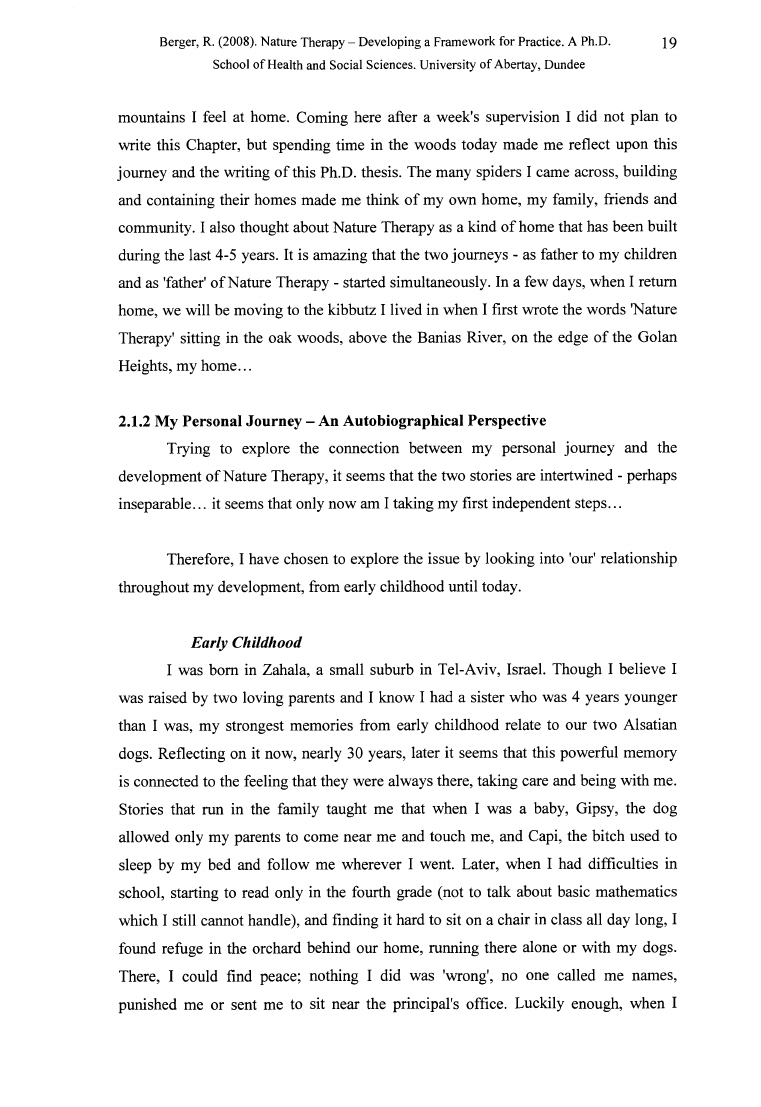
Berger, R. (2008). Nature Therapy - Developing a Framework for Practice. A Ph.D.
19
School o f Health and Social Sciences. University o f Abertay, Dundee
mountains I feel at home. Coming here after a week's supervision I did not plan to
write this Chapter, but spending time in the woods today made me reflect upon this
journey and the writing of this Ph.D. thesis. The many spiders I came across, building
and containing their homes made me think of my own home, my family, friends and
community. I also thought about Nature Therapy as a kind of home that has been built
during the last 4-5 years. It is amazing that the two journeys - as father to my children
and as 'father' of Nature Therapy - started simultaneously. In a few days, when I return
home, we will be moving to the kibbutz I lived in when I first wrote the words 'Nature
Therapy' sitting in the oak woods, above the Banias River, on the edge of the Golan
Heights, my home...
2.1.2 My Personal Journey - An Autobiographical Perspective
Trying to explore the connection between my personal journey and the
development of Nature Therapy, it seems that the two stories are intertwined - perhaps
inseparable... it seems that only now am I taking my first independent steps...
Therefore, I have chosen to explore the issue by looking into 'our' relationship
throughout my development, from early childhood until today.
Early Childhood
I was bom in Zahala, a small suburb in Tel-Aviv, Israel. Though I believe I
was raised by two loving parents and I know I had a sister who was 4 years younger
than I was, my strongest memories from early childhood relate to our two Alsatian
dogs. Reflecting on it now, nearly 30 years, later it seems that this powerful memory
is connected to the feeling that they were always there, taking care and being with me.
Stories that run in the family taught me that when I was a baby, Gipsy, the dog
allowed only my parents to come near me and touch me, and Capi, the bitch used to
sleep by my bed and follow me wherever I went. Later, when I had difficulties in
school, starting to read only in the fourth grade (not to talk about basic mathematics
which I still cannot handle), and finding it hard to sit on a chair in class all day long, I
found refuge in the orchard behind our home, running there alone or with my dogs.
There, I could find peace; nothing I did was 'wrong', no one called me names,
punished me or sent me to sit near the principal's office. Luckily enough, when I
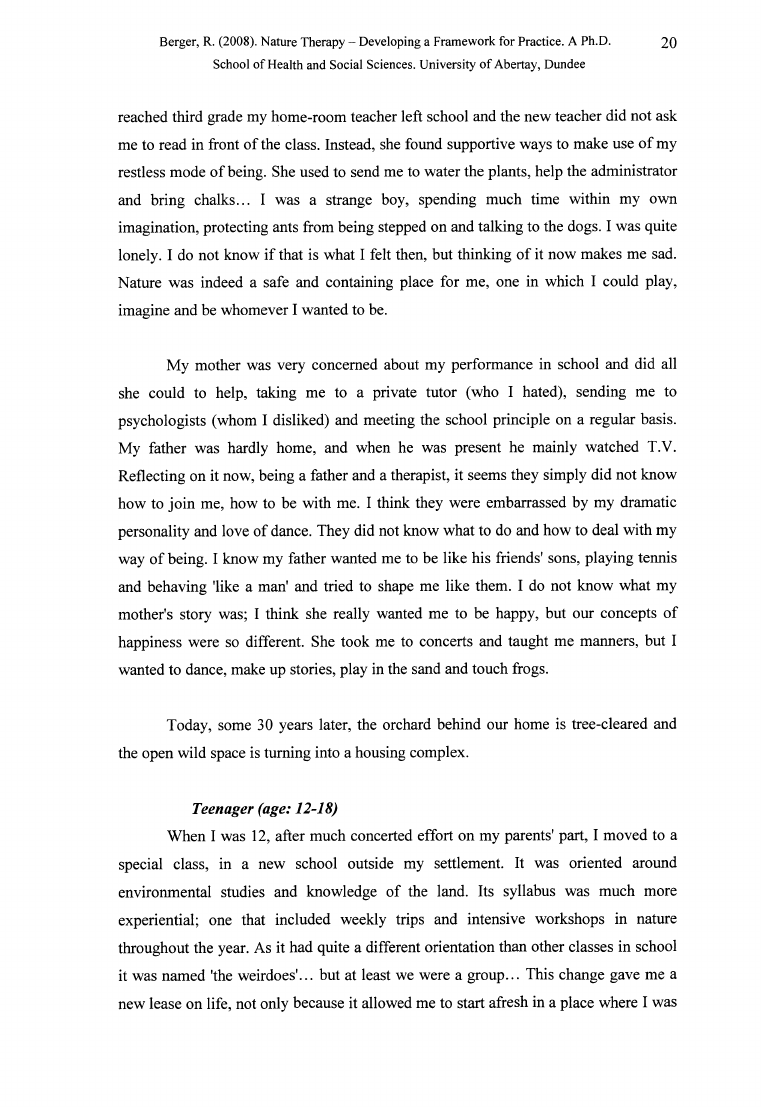
Berger, R. (2008). Nature Therapy - Developing a Framework for Practice. A Ph.D.
20
School o f Health and Social Sciences. University o f Abertay, Dundee
reached third grade my home-room teacher left school and the new teacher did not ask
me to read in front of the class. Instead, she found supportive ways to make use of my
restless mode of being. She used to send me to water the plants, help the administrator
and bring chalks... I was a strange boy, spending much time within my own
imagination, protecting ants from being stepped on and talking to the dogs. I was quite
lonely. I do not know if that is what I felt then, but thinking of it now makes me sad.
Nature was indeed a safe and containing place for me, one in which I could play,
imagine and be whomever I wanted to be.
My mother was very concerned about my performance in school and did all
she could to help, taking me to a private tutor (who I hated), sending me to
psychologists (whom I disliked) and meeting the school principle on a regular basis.
My father was hardly home, and when he was present he mainly watched T.V.
Reflecting on it now, being a father and a therapist, it seems they simply did not know
how to join me, how to be with me. I think they were embarrassed by my dramatic
personality and love of dance. They did not know what to do and how to deal with my
way of being. I know my father wanted me to be like his friends' sons, playing tennis
and behaving 'like a man' and tried to shape me like them. I do not know what my
mother's story was; I think she really wanted me to be happy, but our concepts of
happiness were so different. She took me to concerts and taught me manners, but I
wanted to dance, make up stories, play in the sand and touch frogs.
Today, some 30 years later, the orchard behind our home is tree-cleared and
the open wild space is turning into a housing complex.
Teenager (age: 12-18)
When I was 12, after much concerted effort on my parents' part, I moved to a
special class, in a new school outside my settlement. It was oriented around
environmental studies and knowledge of the land. Its syllabus was much more
experiential; one that included weekly trips and intensive workshops in nature
throughout the year. As it had quite a different orientation than other classes in school
it was named 'the weirdoes'... but at least we were a group... This change gave me a
new lease on life, not only because it allowed me to start afresh in a place where I was
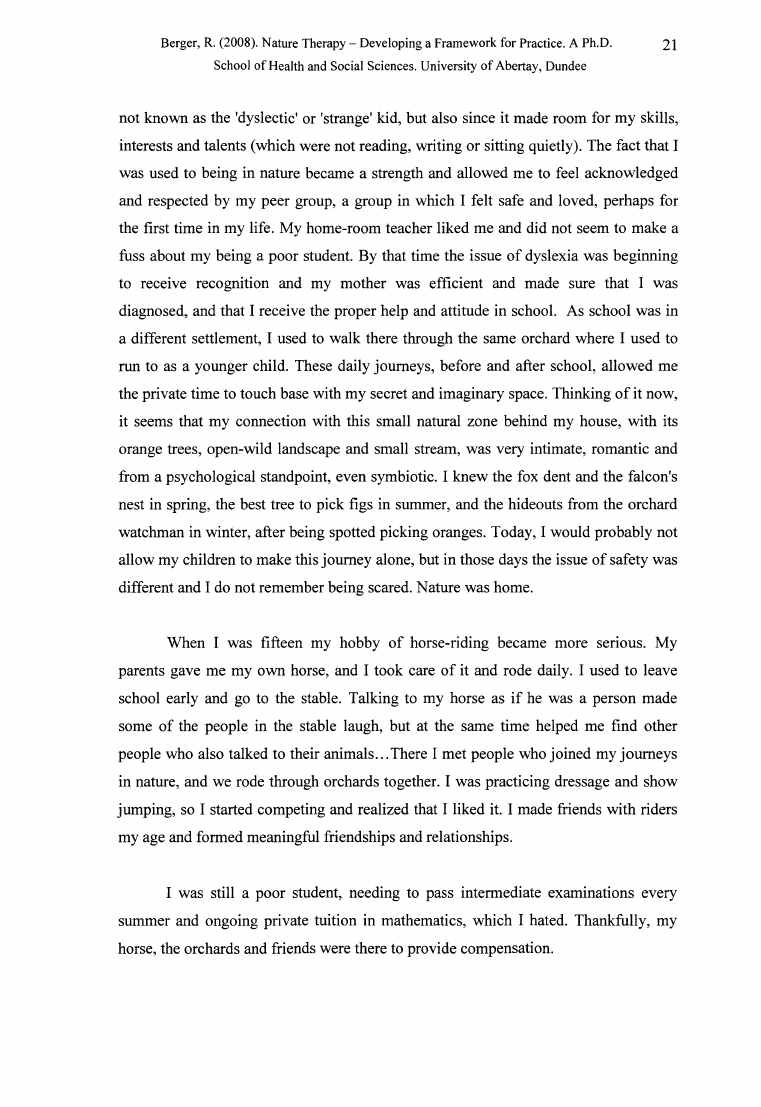
Berger, R. (2008). Nature Therapy - Developing a Framework for Practice. A Ph.D.
21
School o f Health and Social Sciences. University o f Abertay, Dundee
not known as the 'dyslectic' or 'strange' kid, but also since it made room for my skills,
interests and talents (which were not reading, writing or sitting quietly). The fact that I
was used to being in nature became a strength and allowed me to feel acknowledged
and respected by my peer group, a group in which I felt safe and loved, perhaps for
the first time in my life. My home-room teacher liked me and did not seem to make a
fuss about my being a poor student. By that time the issue of dyslexia was beginning
to receive recognition and my mother was efficient and made sure that I was
diagnosed, and that I receive the proper help and attitude in school. As school was in
a different settlement, I used to walk there through the same orchard where I used to
run to as a younger child. These daily journeys, before and after school, allowed me
the private time to touch base with my secret and imaginary space. Thinking of it now,
it seems that my connection with this small natural zone behind my house, with its
orange trees, open-wild landscape and small stream, was very intimate, romantic and
from a psychological standpoint, even symbiotic. I knew the fox dent and the falcon's
nest in spring, the best tree to pick figs in summer, and the hideouts from the orchard
watchman in winter, after being spotted picking oranges. Today, I would probably not
allow my children to make this journey alone, but in those days the issue of safety was
different and I do not remember being scared. Nature was home.
When I was fifteen my hobby of horse-riding became more serious. My
parents gave me my own horse, and I took care of it and rode daily. I used to leave
school early and go to the stable. Talking to my horse as if he was a person made
some of the people in the stable laugh, but at the same time helped me find other
people who also talked to their animals...There I met people who joined my journeys
in nature, and we rode through orchards together. I was practicing dressage and show
jumping, so I started competing and realized that I liked it. I made friends with riders
my age and formed meaningful friendships and relationships.
I was still a poor student, needing to pass intermediate examinations every
summer and ongoing private tuition in mathematics, which I hated. Thankfully, my
horse, the orchards and friends were there to provide compensation.
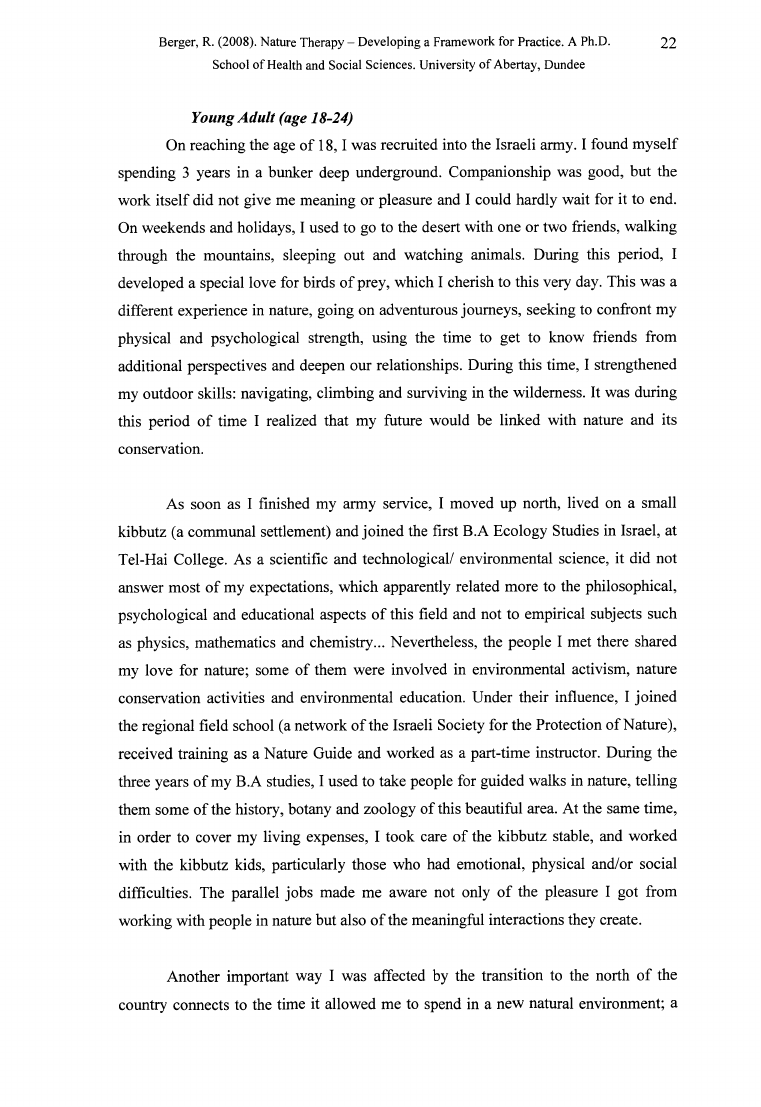
Berger, R. (2008). Nature Therapy - Developing a Framework for Practice. A Ph.D.
22
School o f Health and Social Sciences. University o f Abertay, Dundee
Young A dult (age 18-24)
On reaching the age of 18,1was recruited into the Israeli army. I found myself
spending 3 years in a bunker deep underground. Companionship was good, but the
work itself did not give me meaning or pleasure and I could hardly wait for it to end.
On weekends and holidays, I used to go to the desert with one or two friends, walking
through the mountains, sleeping out and watching animals. During this period, I
developed a special love for birds of prey, which I cherish to this very day. This was a
different experience in nature, going on adventurous journeys, seeking to confront my
physical and psychological strength, using the time to get to know friends from
additional perspectives and deepen our relationships. During this time, I strengthened
my outdoor skills: navigating, climbing and surviving in the wilderness. It was during
this period of time I realized that my future would be linked with nature and its
conservation.
As soon as I finished my army service, I moved up north, lived on a small
kibbutz (a communal settlement) and joined the first B.A Ecology Studies in Israel, at
Tel-Hai College. As a scientific and technological/ environmental science, it did not
answer most of my expectations, which apparently related more to the philosophical,
psychological and educational aspects of this field and not to empirical subjects such
as physics, mathematics and chemistry... Nevertheless, the people I met there shared
my love for nature; some of them were involved in environmental activism, nature
conservation activities and environmental education. Under their influence, I joined
the regional field school (a network of the Israeli Society for the Protection of Nature),
received training as a Nature Guide and worked as a part-time instructor. During the
three years of my B.A studies, I used to take people for guided walks in nature, telling
them some of the history, botany and zoology of this beautiful area. At the same time,
in order to cover my living expenses, I took care of the kibbutz stable, and worked
with the kibbutz kids, particularly those who had emotional, physical and/or social
difficulties. The parallel jobs made me aware not only of the pleasure I got from
working with people in nature but also of the meaningful interactions they create.
Another important way I was affected by the transition to the north of the
country connects to the time it allowed me to spend in a new natural environment; a
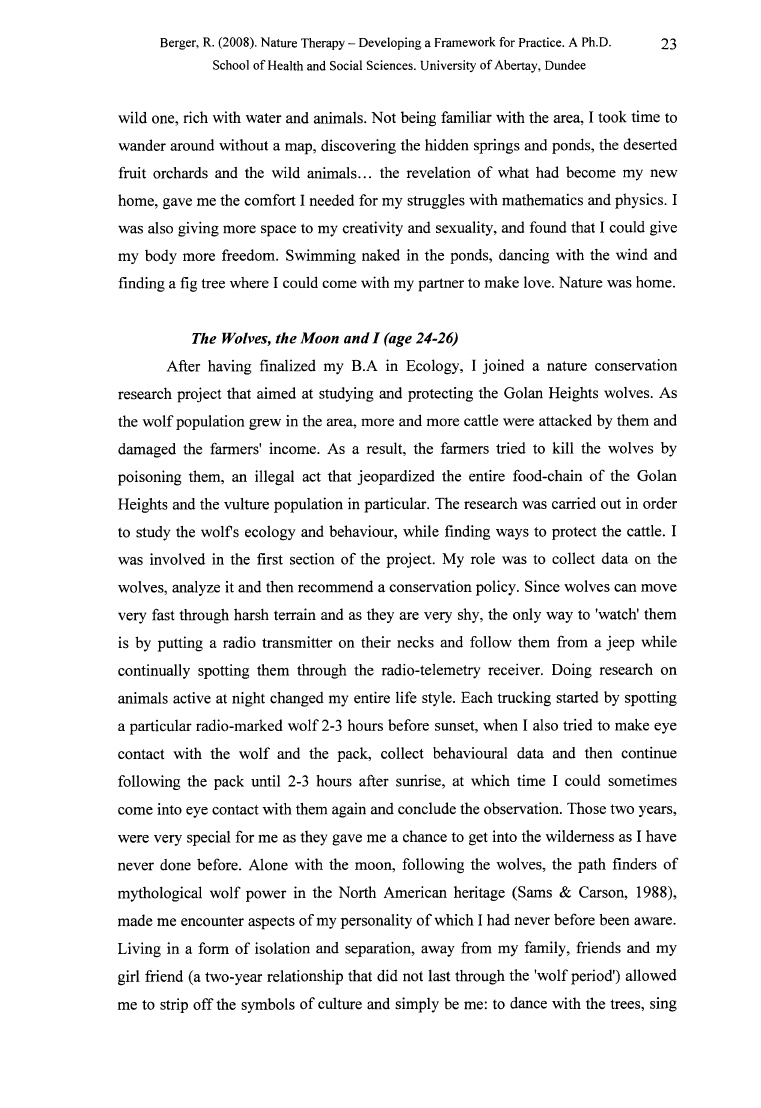
Berger, R. (2008). Nature Therapy - Developing a Framework for Practice. A Ph.D.
23
School o f Health and Social Sciences. University o f Abertay, Dundee
wild one, rich with water and animals. Not being familiar with the area, I took time to
wander around without a map, discovering the hidden springs and ponds, the deserted
fruit orchards and the wild animals... the revelation of what had become my new
home, gave me the comfort I needed for my struggles with mathematics and physics. I
was also giving more space to my creativity and sexuality, and found that I could give
my body more freedom. Swimming naked in the ponds, dancing with the wind and
finding a fig tree where I could come with my partner to make love. Nature was home.
The Wolves, the M oon and I (age 24-26)
After having finalized my B.A in Ecology, I joined a nature conservation
research project that aimed at studying and protecting the Golan Heights wolves. As
the wolf population grew in the area, more and more cattle were attacked by them and
damaged the farmers' income. As a result, the farmers tried to kill the wolves by
poisoning them, an illegal act that jeopardized the entire food-chain of the Golan
Heights and the vulture population in particular. The research was carried out in order
to study the wolfs ecology and behaviour, while finding ways to protect the cattle. I
was involved in the first section of the project. My role was to collect data on the
wolves, analyze it and then recommend a conservation policy. Since wolves can move
very fast through harsh terrain and as they are very shy, the only way to 'watch' them
is by putting a radio transmitter on their necks and follow them from a jeep while
continually spotting them through the radio-telemetry receiver. Doing research on
animals active at night changed my entire life style. Each trucking started by spotting
a particular radio-marked wolf 2-3 hours before sunset, when I also tried to make eye
contact with the wolf and the pack, collect behavioural data and then continue
following the pack until 2-3 hours after sunrise, at which time I could sometimes
come into eye contact with them again and conclude the observation. Those two years,
were very special for me as they gave me a chance to get into the wilderness as I have
never done before. Alone with the moon, following the wolves, the path finders of
mythological wolf power in the North American heritage (Sams & Carson, 1988),
made me encounter aspects of my personality of which I had never before been aware.
Living in a form of isolation and separation, away from my family, friends and my
girl friend (a two-year relationship that did not last through the 'wolf period') allowed
me to strip off the symbols of culture and simply be me: to dance with the trees, sing
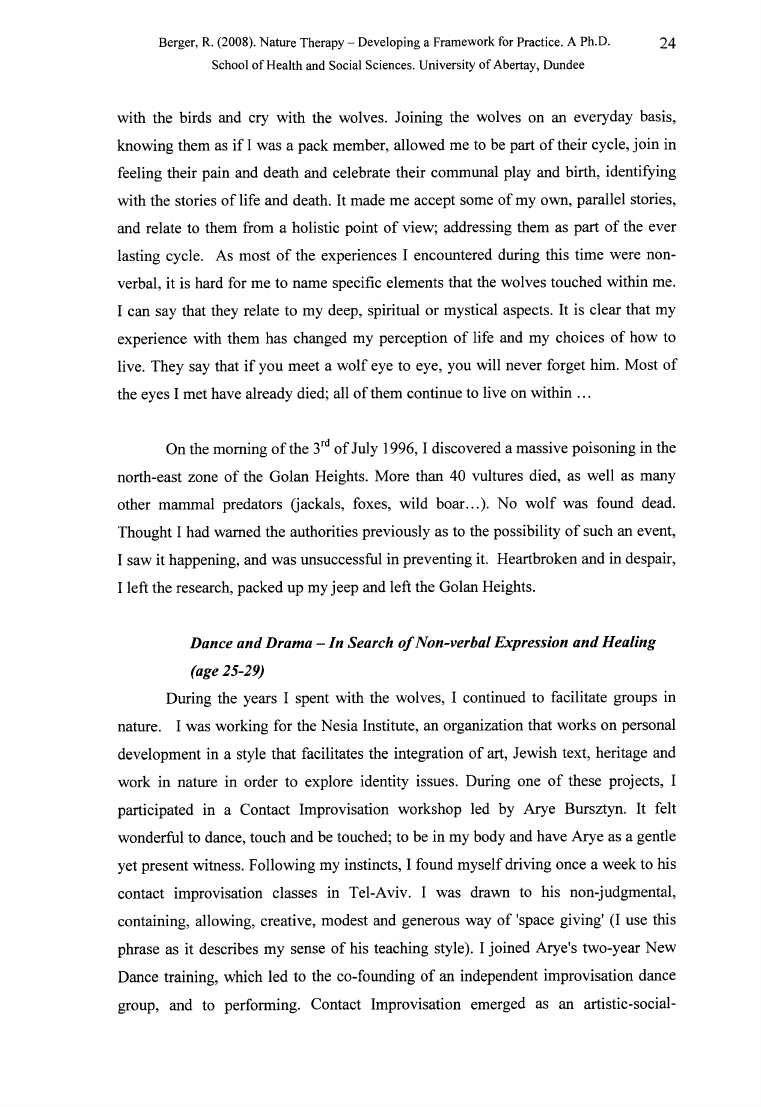
Berger, R. (2008). Nature Therapy - Developing a Framework for Practice. A Ph.D.
24
School o f Health and Social Sciences. University o f Abertay, Dundee
with the birds and cry with the wolves. Joining the wolves on an everyday basis,
knowing them as if I was a pack member, allowed me to be part of their cycle, join in
feeling their pain and death and celebrate their communal play and birth, identifying
with the stories of life and death. It made me accept some of my own, parallel stories,
and relate to them from a holistic point of view; addressing them as part of the ever
lasting cycle. As most of the experiences I encountered during this time were non
verbal, it is hard for me to name specific elements that the wolves touched within me.
I can say that they relate to my deep, spiritual or mystical aspects. It is clear that my
experience with them has changed my perception of life and my choices of how to
live. They say that if you meet a wolf eye to eye, you will never forget him. Most of
the eyes I met have already died; all of them continue to live on within ...
On the morning of the 3rd of July 1996,1discovered a massive poisoning in the
north-east zone of the Golan Heights. More than 40 vultures died, as well as many
other mammal predators (jackals, foxes, wild boar...). No wolf was found dead.
Thought I had warned the authorities previously as to the possibility of such an event,
I saw it happening, and was unsuccessful in preventing it. Heartbroken and in despair,
I left the research, packed up my jeep and left the Golan Heights.
Dance and Drama - In Search o f Non-verbal Expression and Healing
(age 25-29)
During the years I spent with the wolves, I continued to facilitate groups in
nature. I was working for the Nesia Institute, an organization that works on personal
development in a style that facilitates the integration of art, Jewish text, heritage and
work in nature in order to explore identity issues. During one of these projects, I
participated in a Contact Improvisation workshop led by Arye Bursztyn. It felt
wonderful to dance, touch and be touched; to be in my body and have Arye as a gentle
yet present witness. Following my instincts, I found myself driving once a week to his
contact improvisation classes in Tel-Aviv. I was drawn to his non-judgmental,
containing, allowing, creative, modest and generous way of 'space giving' (I use this
phrase as it describes my sense of his teaching style). I joined Arye's two-year New
Dance training, which led to the co-founding of an independent improvisation dance
group, and to performing. Contact Improvisation emerged as an artistic-social-
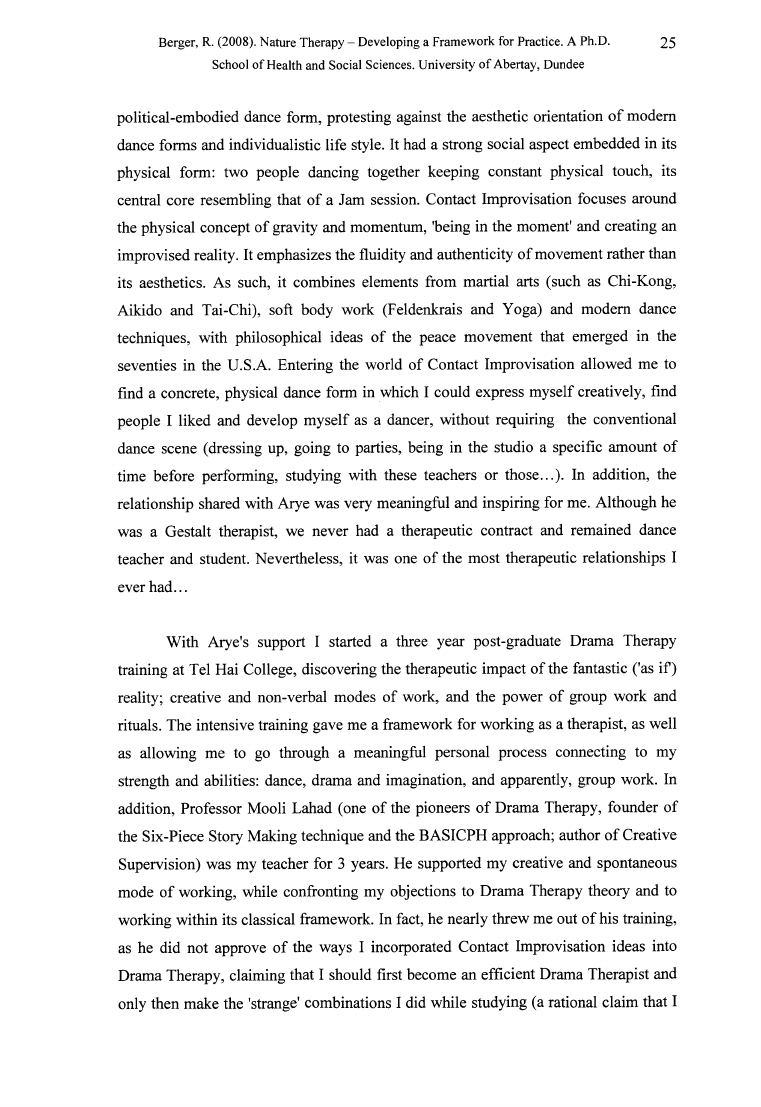
Berger, R. (2008). Nature Therapy - Developing a Framework for Practice. A Ph.D.
25
School o f Health and Social Sciences. University o f Abertay, Dundee
political-embodied dance form, protesting against the aesthetic orientation of modem
dance forms and individualistic life style. It had a strong social aspect embedded in its
physical form: two people dancing together keeping constant physical touch, its
central core resembling that of a Jam session. Contact Improvisation focuses around
the physical concept of gravity and momentum, 'being in the moment' and creating an
improvised reality. It emphasizes the fluidity and authenticity of movement rather than
its aesthetics. As such, it combines elements from martial arts (such as Chi-Kong,
Aikido and Tai-Chi), soft body work (Feldenkrais and Yoga) and modem dance
techniques, with philosophical ideas of the peace movement that emerged in the
seventies in the U.S.A. Entering the world of Contact Improvisation allowed me to
find a concrete, physical dance form in which I could express myself creatively, find
people I liked and develop myself as a dancer, without requiring the conventional
dance scene (dressing up, going to parties, being in the studio a specific amount of
time before performing, studying with these teachers or those...). In addition, the
relationship shared with Arye was very meaningful and inspiring for me. Although he
was a Gestalt therapist, we never had a therapeutic contract and remained dance
teacher and student. Nevertheless, it was one of the most therapeutic relationships I
ever had...
With Arye's support I started a three year post-graduate Drama Therapy
training at Tel Hai College, discovering the therapeutic impact of the fantastic ('as if)
reality; creative and non-verbal modes of work, and the power of group work and
rituals. The intensive training gave me a framework for working as a therapist, as well
as allowing me to go through a meaningful personal process connecting to my
strength and abilities: dance, drama and imagination, and apparently, group work. In
addition, Professor Mooli Lahad (one of the pioneers of Drama Therapy, founder of
the Six-Piece Story Making technique and the BASICPH approach; author of Creative
Supervision) was my teacher for 3 years. He supported my creative and spontaneous
mode of working, while confronting my objections to Drama Therapy theory and to
working within its classical framework. In fact, he nearly threw me out of his training,
as he did not approve of the ways I incorporated Contact Improvisation ideas into
Drama Therapy, claiming that I should first become an efficient Drama Therapist and
only then make the 'strange' combinations I did while studying (a rational claim that I
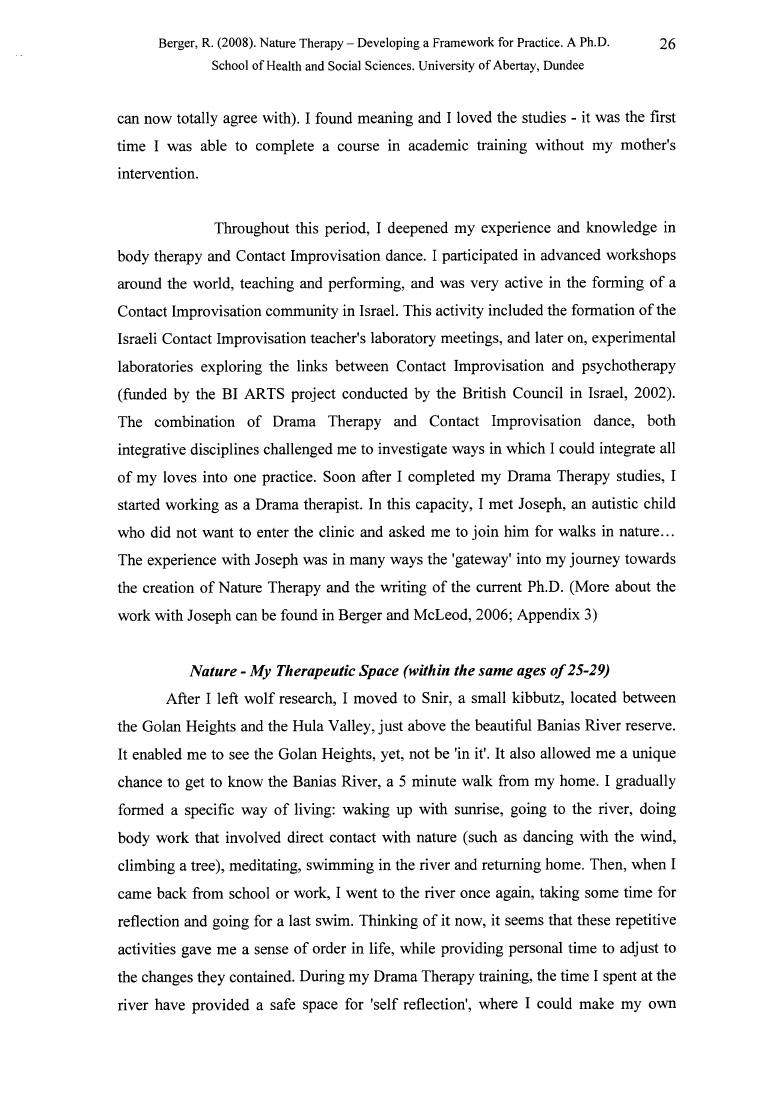
Berger, R. (2008). Nature Therapy - Developing a Framework for Practice. A Ph.D.
26
School o f Health and Social Sciences. University o f Abertay, Dundee
can now totally agree with). I found meaning and I loved the studies - it was the first
time I was able to complete a course in academic training without my mother's
intervention.
Throughout this period, I deepened my experience and knowledge in
body therapy and Contact Improvisation dance. I participated in advanced workshops
around the world, teaching and performing, and was very active in the forming of a
Contact Improvisation community in Israel. This activity included the formation of the
Israeli Contact Improvisation teacher's laboratory meetings, and later on, experimental
laboratories exploring the links between Contact Improvisation and psychotherapy
(funded by the BI ARTS project conducted by the British Council in Israel, 2002).
The combination of Drama Therapy and Contact Improvisation dance, both
integrative disciplines challenged me to investigate ways in which I could integrate all
of my loves into one practice. Soon after I completed my Drama Therapy studies, I
started working as a Drama therapist. In this capacity, I met Joseph, an autistic child
who did not want to enter the clinic and asked me to join him for walks in nature...
The experience with Joseph was in many ways the 'gateway' into my journey towards
the creation of Nature Therapy and the writing of the current Ph.D. (More about the
work with Joseph can be found in Berger and McLeod, 2006; Appendix 3)
Nature - M y Therapeutic Space (within the sam e ages o f 25-29)
After I left wolf research, I moved to Snir, a small kibbutz, located between
the Golan Heights and the Hula Valley, just above the beautiful Banias River reserve.
It enabled me to see the Golan Heights, yet, not be 'in it'. It also allowed me a unique
chance to get to know the Banias River, a 5 minute walk from my home. I gradually
formed a specific way of living: waking up with sunrise, going to the river, doing
body work that involved direct contact with nature (such as dancing with the wind,
climbing a tree), meditating, swimming in the river and returning home. Then, when I
came back from school or work, I went to the river once again, taking some time for
reflection and going for a last swim. Thinking of it now, it seems that these repetitive
activities gave me a sense of order in life, while providing personal time to adjust to
the changes they contained. During my Drama Therapy training, the time I spent at the
river have provided a safe space for 'self reflection', where I could make my own
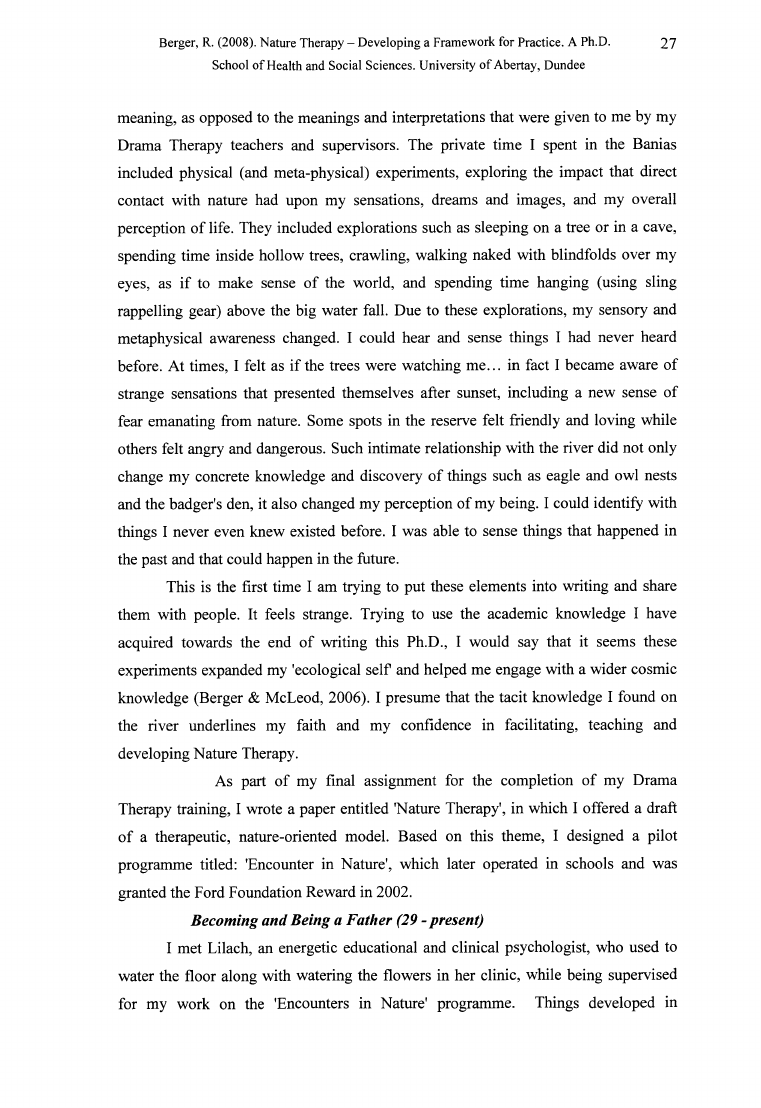
Berger, R. (2008). Nature Therapy - Developing a Framework for Practice. A Ph.D.
27
School o f Health and Social Sciences. University o f Abertay, Dundee
meaning, as opposed to the meanings and interpretations that were given to me by my
Drama Therapy teachers and supervisors. The private time I spent in the Banias
included physical (and meta-physical) experiments, exploring the impact that direct
contact with nature had upon my sensations, dreams and images, and my overall
perception of life. They included explorations such as sleeping on a tree or in a cave,
spending time inside hollow trees, crawling, walking naked with blindfolds over my
eyes, as if to make sense of the world, and spending time hanging (using sling
rappelling gear) above the big water fall. Due to these explorations, my sensory and
metaphysical awareness changed. I could hear and sense things I had never heard
before. At times, I felt as if the trees were watching me... in fact I became aware of
strange sensations that presented themselves after sunset, including a new sense of
fear emanating from nature. Some spots in the reserve felt friendly and loving while
others felt angry and dangerous. Such intimate relationship with the river did not only
change my concrete knowledge and discovery of things such as eagle and owl nests
and the badger's den, it also changed my perception of my being. I could identify with
things I never even knew existed before. I was able to sense things that happened in
the past and that could happen in the future.
This is the first time I am trying to put these elements into writing and share
them with people. It feels strange. Trying to use the academic knowledge I have
acquired towards the end of writing this Ph.D., I would say that it seems these
experiments expanded my 'ecological self and helped me engage with a wider cosmic
knowledge (Berger & McLeod, 2006). I presume that the tacit knowledge I found on
the river underlines my faith and my confidence in facilitating, teaching and
developing Nature Therapy.
As part of my final assignment for the completion of my Drama
Therapy training, I wrote a paper entitled 'Nature Therapy', in which I offered a draft
of a therapeutic, nature-oriented model. Based on this theme, I designed a pilot
programme titled: 'Encounter in Nature', which later operated in schools and was
granted the Ford Foundation Reward in 2002.
Becoming and Being a Father (29 - present)
I met Lilach, an energetic educational and clinical psychologist, who used to
water the floor along with watering the flowers in her clinic, while being supervised
for my work on the 'Encounters in Nature' programme. Things developed in
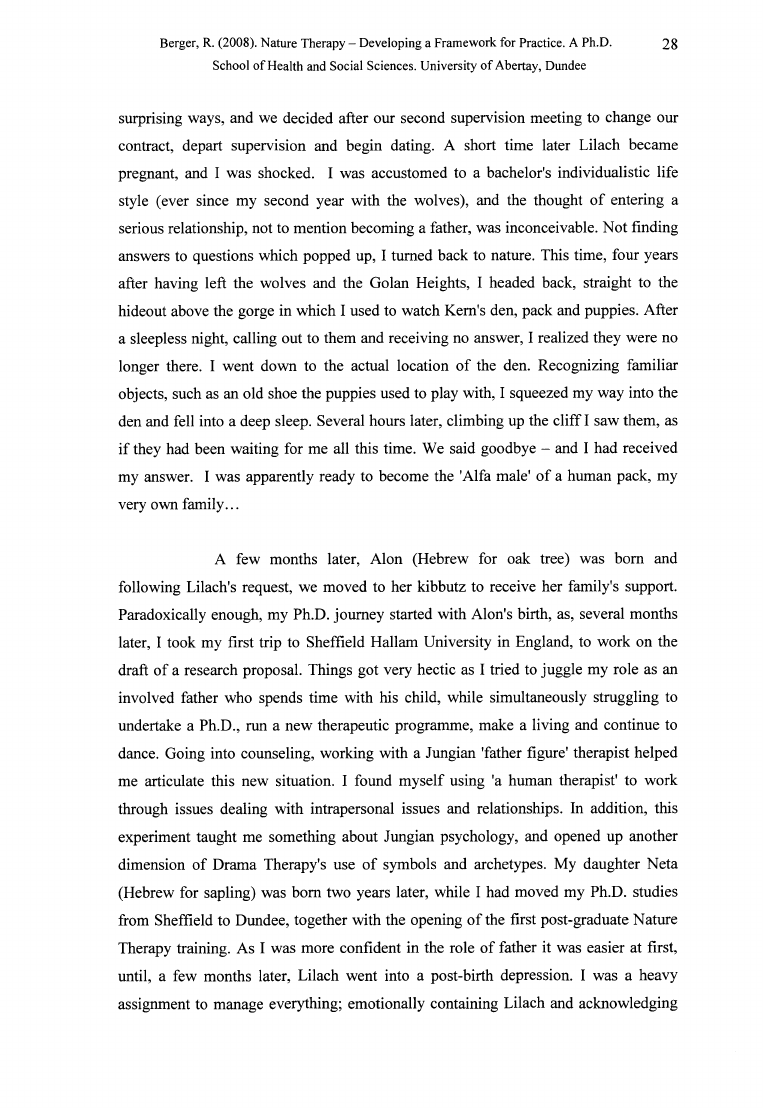
Berger, R. (2008). Nature Therapy - Developing a Framework for Practice. A Ph.D.
28
School o f Health and Social Sciences. University o f Abertay, Dundee
surprising ways, and we decided after our second supervision meeting to change our
contract, depart supervision and begin dating. A short time later Lilach became
pregnant, and I was shocked. I was accustomed to a bachelor's individualistic life
style (ever since my second year with the wolves), and the thought of entering a
serious relationship, not to mention becoming a father, was inconceivable. Not finding
answers to questions which popped up, I turned back to nature. This time, four years
after having left the wolves and the Golan Heights, I headed back, straight to the
hideout above the gorge in which I used to watch Kern's den, pack and puppies. After
a sleepless night, calling out to them and receiving no answer, I realized they were no
longer there. I went down to the actual location of the den. Recognizing familiar
objects, such as an old shoe the puppies used to play with, I squeezed my way into the
den and fell into a deep sleep. Several hours later, climbing up the cliff I saw them, as
if they had been waiting for me all this time. We said goodbye - and I had received
my answer. I was apparently ready to become the 'Alfa male' of a human pack, my
very own family...
A few months later, Alon (Hebrew for oak tree) was bom and
following Lilach's request, we moved to her kibbutz to receive her family's support.
Paradoxically enough, my Ph.D. journey started with Alon's birth, as, several months
later, I took my first trip to Sheffield Hallam University in England, to work on the
draft of a research proposal. Things got very hectic as I tried to juggle my role as an
involved father who spends time with his child, while simultaneously stmggling to
undertake a Ph.D., run a new therapeutic programme, make a living and continue to
dance. Going into counseling, working with a Jungian 'father figure' therapist helped
me articulate this new situation. I found myself using 'a human therapist' to work
through issues dealing with intrapersonal issues and relationships. In addition, this
experiment taught me something about Jungian psychology, and opened up another
dimension of Drama Therapy's use of symbols and archetypes. My daughter Neta
(Hebrew for sapling) was bom two years later, while I had moved my Ph.D. studies
from Sheffield to Dundee, together with the opening of the first post-graduate Nature
Therapy training. As I was more confident in the role of father it was easier at first,
until, a few months later, Lilach went into a post-birth depression. I was a heavy
assignment to manage everything; emotionally containing Lilach and acknowledging
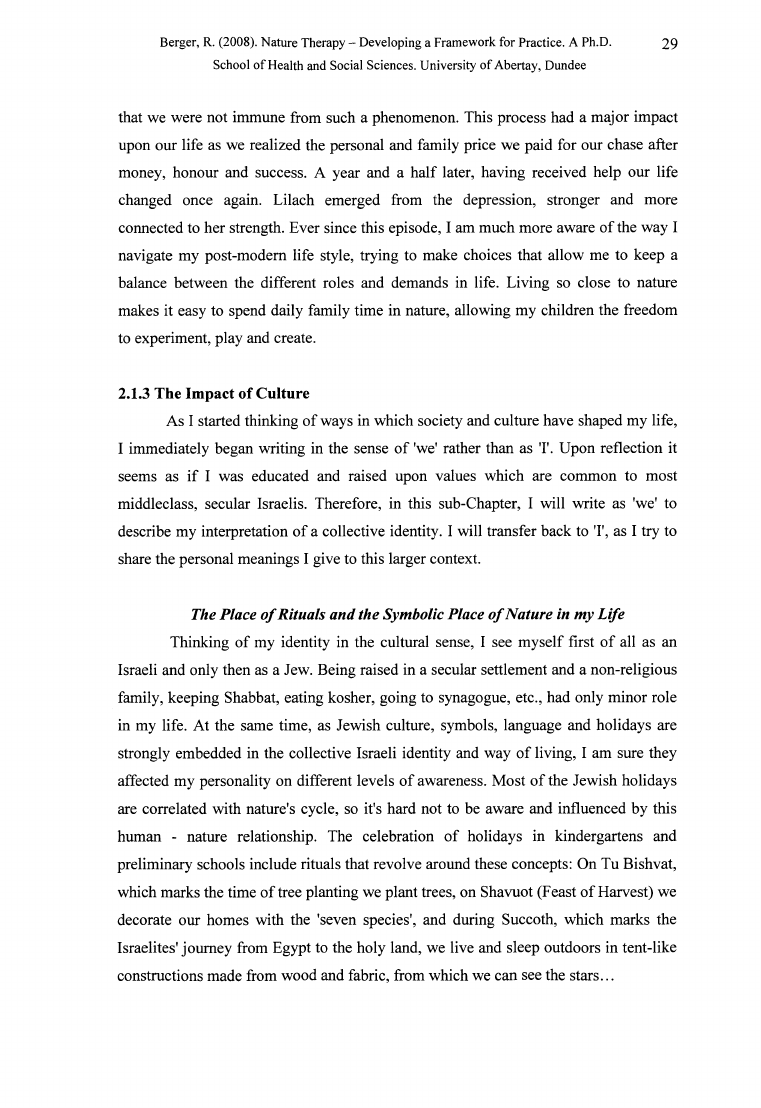
Berger, R. (2008). Nature Therapy - Developing a Framework for Practice. A Ph.D.
29
School o f Health and Social Sciences. University o f Abertay, Dundee
that we were not immune from such a phenomenon. This process had a major impact
upon our life as we realized the personal and family price we paid for our chase after
money, honour and success. A year and a half later, having received help our life
changed once again. Lilach emerged from the depression, stronger and more
connected to her strength. Ever since this episode, I am much more aware of the way I
navigate my post-modern life style, trying to make choices that allow me to keep a
balance between the different roles and demands in life. Living so close to nature
makes it easy to spend daily family time in nature, allowing my children the freedom
to experiment, play and create.
2.1.3 The Impact of Culture
As I started thinking of ways in which society and culture have shaped my life,
I immediately began writing in the sense of 'we' rather than as 'I'. Upon reflection it
seems as if I was educated and raised upon values which are common to most
middleclass, secular Israelis. Therefore, in this sub-Chapter, I will write as 'we' to
describe my interpretation of a collective identity. I will transfer back to 'I', as I try to
share the personal meanings I give to this larger context.
The Place o f Rituals and the Symbolic Place o f N ature in m y Life
Thinking of my identity in the cultural sense, I see myself first of all as an
Israeli and only then as a Jew. Being raised in a secular settlement and a non-religious
family, keeping Shabbat, eating kosher, going to synagogue, etc., had only minor role
in my life. At the same time, as Jewish culture, symbols, language and holidays are
strongly embedded in the collective Israeli identity and way of living, I am sure they
affected my personality on different levels of awareness. Most of the Jewish holidays
are correlated with nature's cycle, so it's hard not to be aware and influenced by this
human - nature relationship. The celebration of holidays in kindergartens and
preliminary schools include rituals that revolve around these concepts: On Tu Bishvat,
which marks the time of tree planting we plant trees, on Shavuot (Feast of Harvest) we
decorate our homes with the 'seven species', and during Succoth, which marks the
Israelites' journey from Egypt to the holy land, we live and sleep outdoors in tent-like
constructions made from wood and fabric, from which we can see the stars...
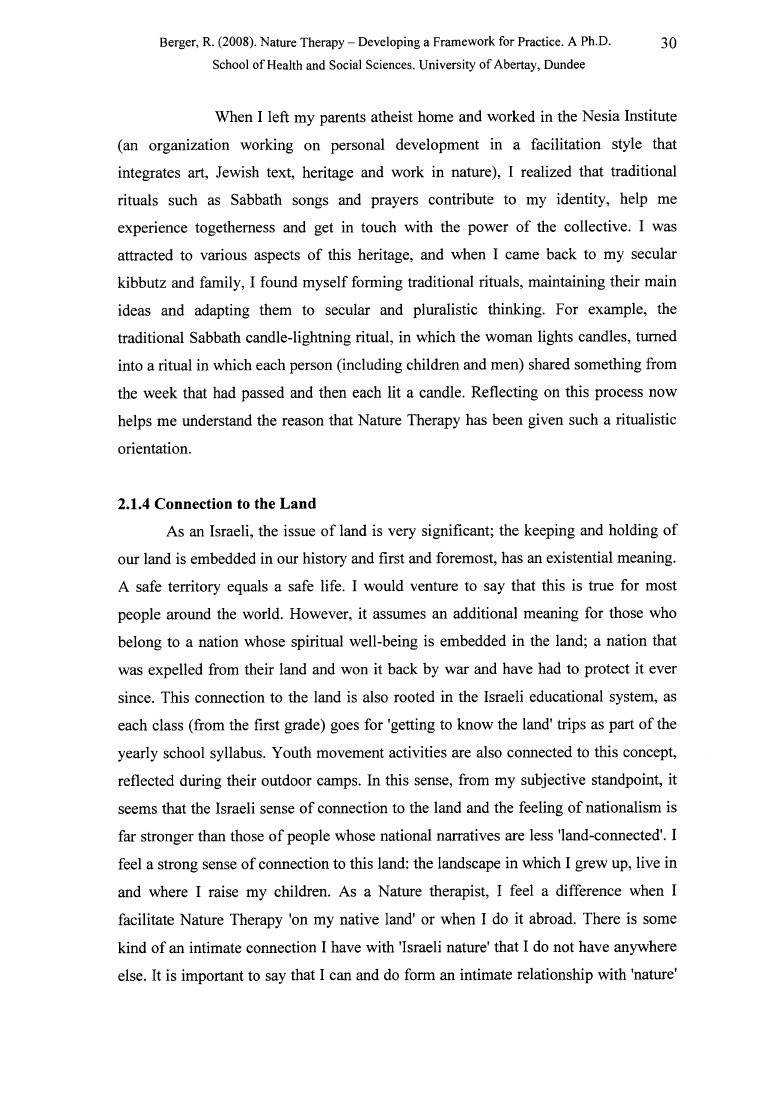
Berger, R. (2008). Nature Therapy - Developing a Framework for Practice. A Ph.D.
30
School o f Health and Social Sciences. University o f Abertay, Dundee
When I left my parents atheist home and worked in the Nesia Institute
(an organization working on personal development in a facilitation style that
integrates art, Jewish text, heritage and work in nature), I realized that traditional
rituals such as Sabbath songs and prayers contribute to my identity, help me
experience togetherness and get in touch with the power of the collective. I was
attracted to various aspects of this heritage, and when I came back to my secular
kibbutz and family, I found myself forming traditional rituals, maintaining their main
ideas and adapting them to secular and pluralistic thinking. For example, the
traditional Sabbath candle-lightning ritual, in which the woman lights candles, turned
into a ritual in which each person (including children and men) shared something from
the week that had passed and then each lit a candle. Reflecting on this process now
helps me understand the reason that Nature Therapy has been given such a ritualistic
orientation.
2.1.4 Connection to the Land
As an Israeli, the issue of land is very significant; the keeping and holding of
our land is embedded in our history and first and foremost, has an existential meaning.
A safe territory equals a safe life. I would venture to say that this is true for most
people around the world. However, it assumes an additional meaning for those who
belong to a nation whose spiritual well-being is embedded in the land; a nation that
was expelled from their land and won it back by war and have had to protect it ever
since. This connection to the land is also rooted in the Israeli educational system, as
each class (from the first grade) goes for 'getting to know the land' trips as part of the
yearly school syllabus. Youth movement activities are also connected to this concept,
reflected during their outdoor camps. In this sense, from my subjective standpoint, it
seems that the Israeli sense of connection to the land and the feeling of nationalism is
far stronger than those of people whose national narratives are less 'land-connected'. I
feel a strong sense of connection to this land: the landscape in which I grew up, live in
and where I raise my children. As a Nature therapist, I feel a difference when I
facilitate Nature Therapy 'on my native land' or when I do it abroad. There is some
kind of an intimate connection I have with 'Israeli nature' that I do not have anywhere
else. It is important to say that I can and do form an intimate relationship with 'nature'
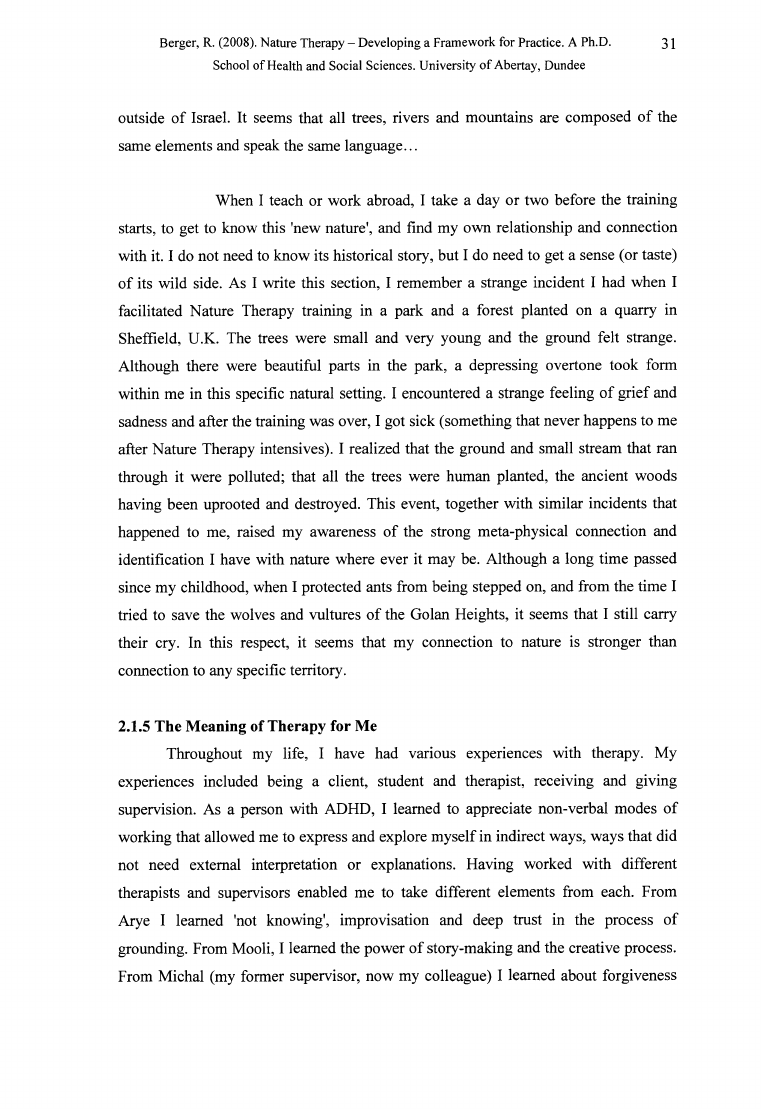
Berger, R. (2008). Nature Therapy - Developing a Framework for Practice. A Ph.D.
31
School o f Health and Social Sciences. University o f Abertay, Dundee
outside of Israel. It seems that all trees, rivers and mountains are composed of the
same elements and speak the same language...
When I teach or work abroad, I take a day or two before the training
starts, to get to know this 'new nature', and find my own relationship and connection
with it. I do not need to know its historical story, but I do need to get a sense (or taste)
of its wild side. As I write this section, I remember a strange incident I had when I
facilitated Nature Therapy training in a park and a forest planted on a quarry in
Sheffield, U.K. The trees were small and very young and the ground felt strange.
Although there were beautiful parts in the park, a depressing overtone took form
within me in this specific natural setting. I encountered a strange feeling of grief and
sadness and after the training was over, I got sick (something that never happens to me
after Nature Therapy intensives). I realized that the ground and small stream that ran
through it were polluted; that all the trees were human planted, the ancient woods
having been uprooted and destroyed. This event, together with similar incidents that
happened to me, raised my awareness of the strong meta-physical connection and
identification I have with nature where ever it may be. Although a long time passed
since my childhood, when I protected ants from being stepped on, and from the time I
tried to save the wolves and vultures of the Golan Heights, it seems that I still carry
their cry. In this respect, it seems that my connection to nature is stronger than
connection to any specific territory.
2.1.5 The Meaning of Therapy for Me
Throughout my life, I have had various experiences with therapy. My
experiences included being a client, student and therapist, receiving and giving
supervision. As a person with ADHD, I learned to appreciate non-verbal modes of
working that allowed me to express and explore myself in indirect ways, ways that did
not need external interpretation or explanations. Having worked with different
therapists and supervisors enabled me to take different elements from each. From
Arye I learned 'not knowing', improvisation and deep trust in the process of
grounding. From Mooli, I learned the power of story-making and the creative process.
From Michal (my former supervisor, now my colleague) I learned about forgiveness
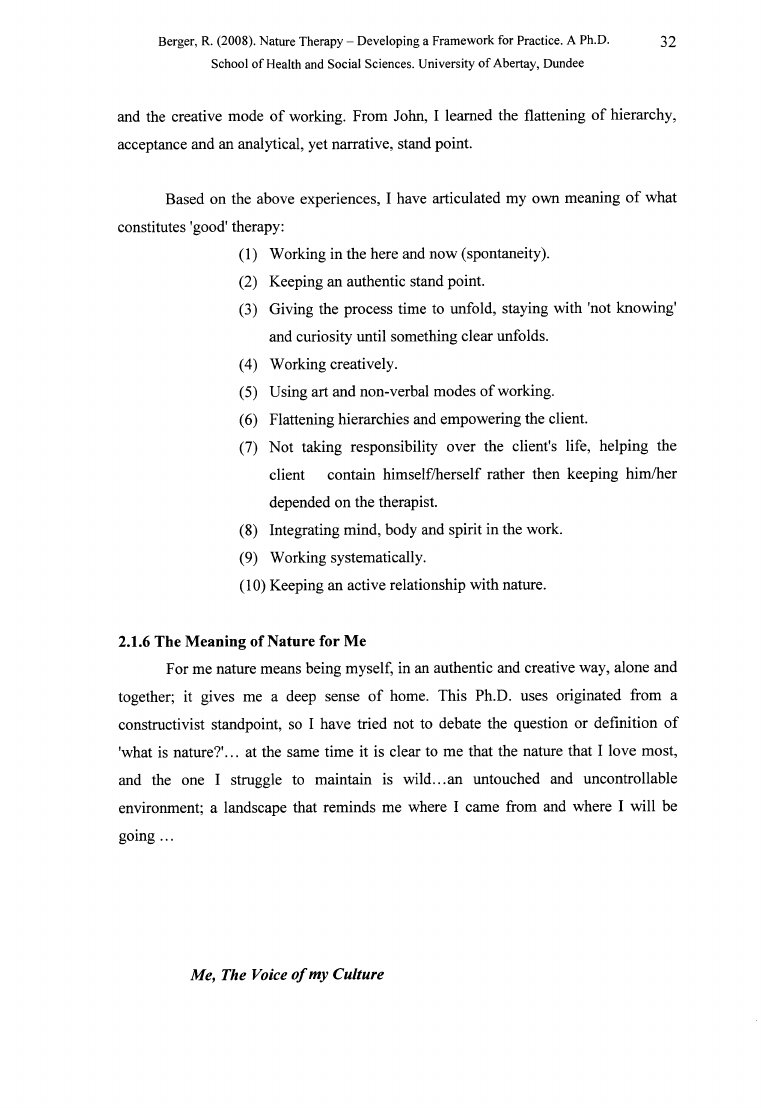
Berger, R. (2008). Nature Therapy - Developing a Framework for Practice. A Ph.D.
32
School o f Health and Social Sciences. University o f Abertay, Dundee
and the creative mode of working. From John, I learned the flattening of hierarchy,
acceptance and an analytical, yet narrative, stand point.
Based on the above experiences, I have articulated my own meaning of what
constitutes 'good' therapy:
(1) Working in the here and now (spontaneity).
(2) Keeping an authentic stand point.
(3) Giving the process time to unfold, staying with 'not knowing'
and curiosity until something clear unfolds.
(4) Working creatively.
(5) Using art and non-verbal modes of working.
(6) Flattening hierarchies and empowering the client.
(7) Not taking responsibility over the client's life, helping the
client contain himself/herself rather then keeping him/her
depended on the therapist.
(8) Integrating mind, body and spirit in the work.
(9) Working systematically.
(10) Keeping an active relationship with nature.
2.1.6 The Meaning of Nature for Me
For me nature means being myself, in an authentic and creative way, alone and
together; it gives me a deep sense of home. This Ph.D. uses originated from a
constructivist standpoint, so I have tried not to debate the question or definition of
'what is nature?'... at the same time it is clear to me that the nature that I love most,
and the one I struggle to maintain is wild...an untouched and uncontrollable
environment; a landscape that reminds me where I came from and where I will be
going ...
Me, The Voice o f my Culture
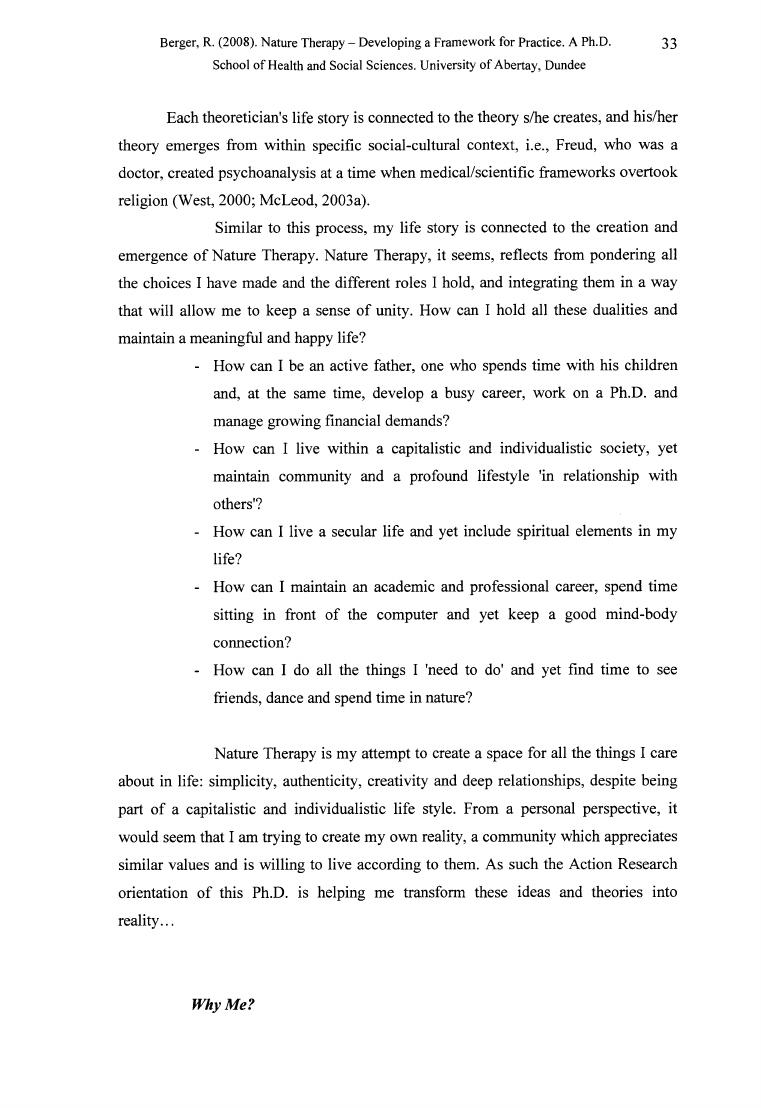
Berger, R. (2008). Nature Therapy - Developing a Framework for Practice. A Ph.D.
33
School o f Health and Social Sciences. University o f Abertay, Dundee
Each theoretician's life story is connected to the theory s/he creates, and his/her
theory emerges from within specific social-cultural context, i.e., Freud, who was a
doctor, created psychoanalysis at a time when medical/scientific frameworks overtook
religion (West, 2000; McLeod, 2003a).
Similar to this process, my life story is connected to the creation and
emergence of Nature Therapy. Nature Therapy, it seems, reflects from pondering all
the choices I have made and the different roles I hold, and integrating them in a way
that will allow me to keep a sense of unity. How can I hold all these dualities and
maintain a meaningful and happy life?
- How can I be an active father, one who spends time with his children
and, at the same time, develop a busy career, work on a Ph.D. and
manage growing financial demands?
- How can I live within a capitalistic and individualistic society, yet
maintain community and a profound lifestyle 'in relationship with
others'?
- How can I live a secular life and yet include spiritual elements in my
life?
- How can I maintain an academic and professional career, spend time
sitting in front of the computer and yet keep a good mind-body
connection?
- How can I do all the things I 'need to do' and yet find time to see
friends, dance and spend time in nature?
Nature Therapy is my attempt to create a space for all the things I care
about in life: simplicity, authenticity, creativity and deep relationships, despite being
part of a capitalistic and individualistic life style. From a personal perspective, it
would seem that I am trying to create my own reality, a community which appreciates
similar values and is willing to live according to them. As such the Action Research
orientation of this Ph.D. is helping me transform these ideas and theories into
reality...
Why Me?
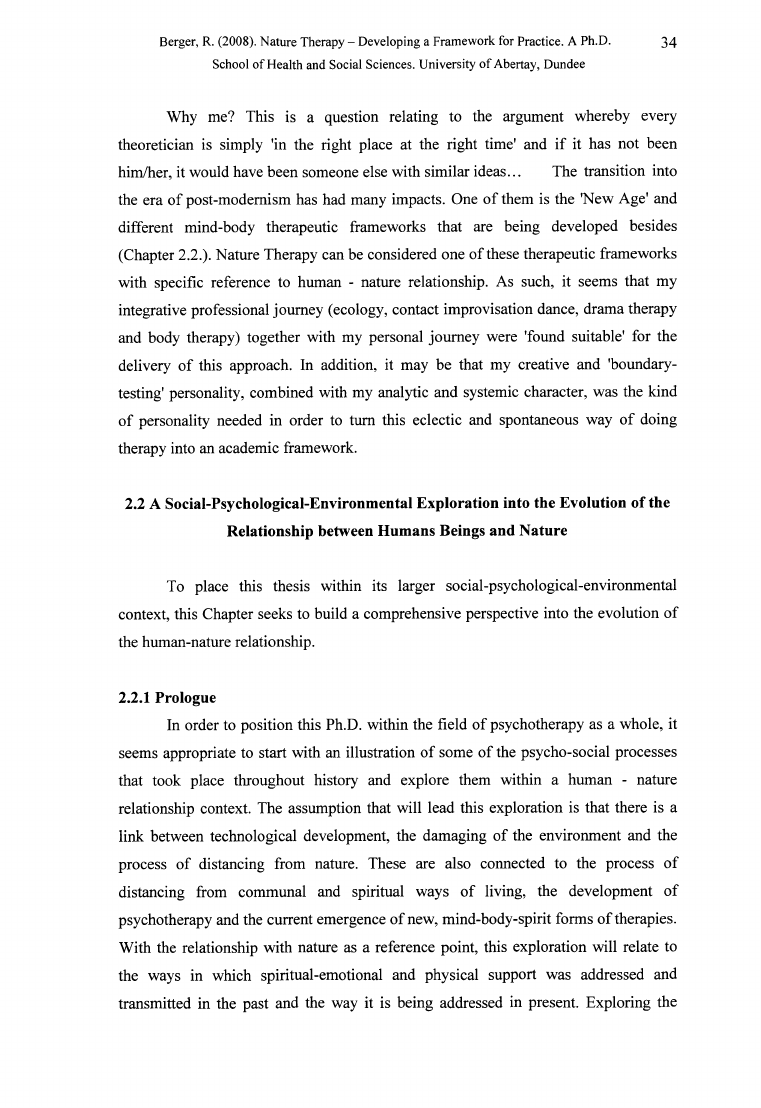
Berger, R. (2008). Nature Therapy - Developing a Framework for Practice. A Ph.D.
34
School o f Health and Social Sciences. University o f Abertay, Dundee
Why me? This is a question relating to the argument whereby every
theoretician is simply 'in the right place at the right time' and if it has not been
him/her, it would have been someone else with similar ideas... The transition into
the era of post-modernism has had many impacts. One of them is the 'New Age' and
different mind-body therapeutic frameworks that are being developed besides
(Chapter 2.2.). Nature Therapy can be considered one of these therapeutic frameworks
with specific reference to human - nature relationship. As such, it seems that my
integrative professional journey (ecology, contact improvisation dance, drama therapy
and body therapy) together with my personal journey were 'found suitable' for the
delivery of this approach. In addition, it may be that my creative and 'boundary
testing' personality, combined with my analytic and systemic character, was the kind
of personality needed in order to turn this eclectic and spontaneous way of doing
therapy into an academic framework.
2.2 A Social-Psychological-Environmental Exploration into the Evolution of the
Relationship between Humans Beings and Nature
To place this thesis within its larger social-psychological-environmental
context, this Chapter seeks to build a comprehensive perspective into the evolution of
the human-nature relationship.
2.2.1 Prologue
In order to position this Ph.D. within the field of psychotherapy as a whole, it
seems appropriate to start with an illustration of some of the psycho-social processes
that took place throughout history and explore them within a human - nature
relationship context. The assumption that will lead this exploration is that there is a
link between technological development, the damaging of the environment and the
process of distancing from nature. These are also connected to the process of
distancing from communal and spiritual ways of living, the development of
psychotherapy and the current emergence of new, mind-body-spirit forms of therapies.
With the relationship with nature as a reference point, this exploration will relate to
the ways in which spiritual-emotional and physical support was addressed and
transmitted in the past and the way it is being addressed in present. Exploring the
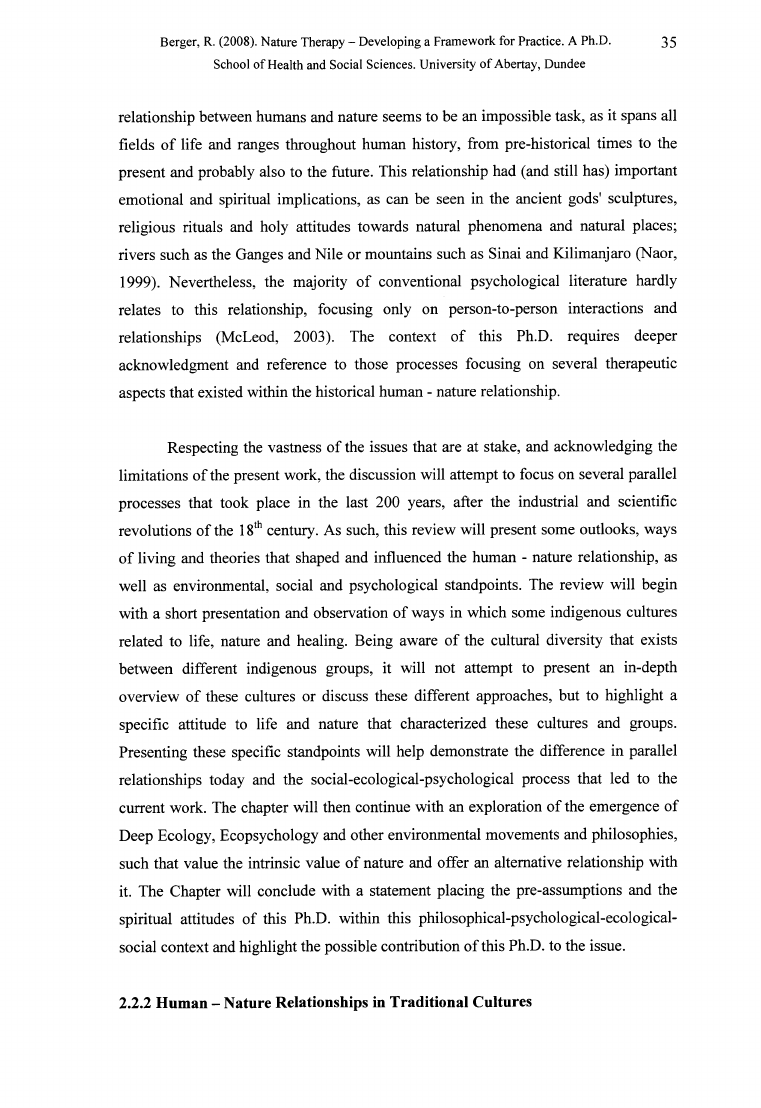
Berger, R. (2008). Nature Therapy - Developing a Framework for Practice. A Ph.D.
35
School o f Health and Social Sciences. University o f Abertay, Dundee
relationship between humans and nature seems to be an impossible task, as it spans all
fields of life and ranges throughout human history, from pre-historical times to the
present and probably also to the future. This relationship had (and still has) important
emotional and spiritual implications, as can be seen in the ancient gods' sculptures,
religious rituals and holy attitudes towards natural phenomena and natural places;
rivers such as the Ganges and Nile or mountains such as Sinai and Kilimanjaro (Naor,
1999). Nevertheless, the majority of conventional psychological literature hardly
relates to this relationship, focusing only on person-to-person interactions and
relationships (McLeod, 2003). The context of this Ph.D. requires deeper
acknowledgment and reference to those processes focusing on several therapeutic
aspects that existed within the historical human - nature relationship.
Respecting the vastness of the issues that are at stake, and acknowledging the
limitations of the present work, the discussion will attempt to focus on several parallel
processes that took place in the last 200 years, after the industrial and scientific
revolutions of the 18th century. As such, this review will present some outlooks, ways
of living and theories that shaped and influenced the human - nature relationship, as
well as environmental, social and psychological standpoints. The review will begin
with a short presentation and observation of ways in which some indigenous cultures
related to life, nature and healing. Being aware of the cultural diversity that exists
between different indigenous groups, it will not attempt to present an in-depth
overview of these cultures or discuss these different approaches, but to highlight a
specific attitude to life and nature that characterized these cultures and groups.
Presenting these specific standpoints will help demonstrate the difference in parallel
relationships today and the social-ecological-psychological process that led to the
current work. The chapter will then continue with an exploration of the emergence of
Deep Ecology, Ecopsychology and other environmental movements and philosophies,
such that value the intrinsic value of nature and offer an alternative relationship with
it. The Chapter will conclude with a statement placing the pre-assumptions and the
spiritual attitudes of this Ph.D. within this philosophical-psychological-ecological-
social context and highlight the possible contribution of this Ph.D. to the issue.
2.2.2 Human - Nature Relationships in Traditional Cultures
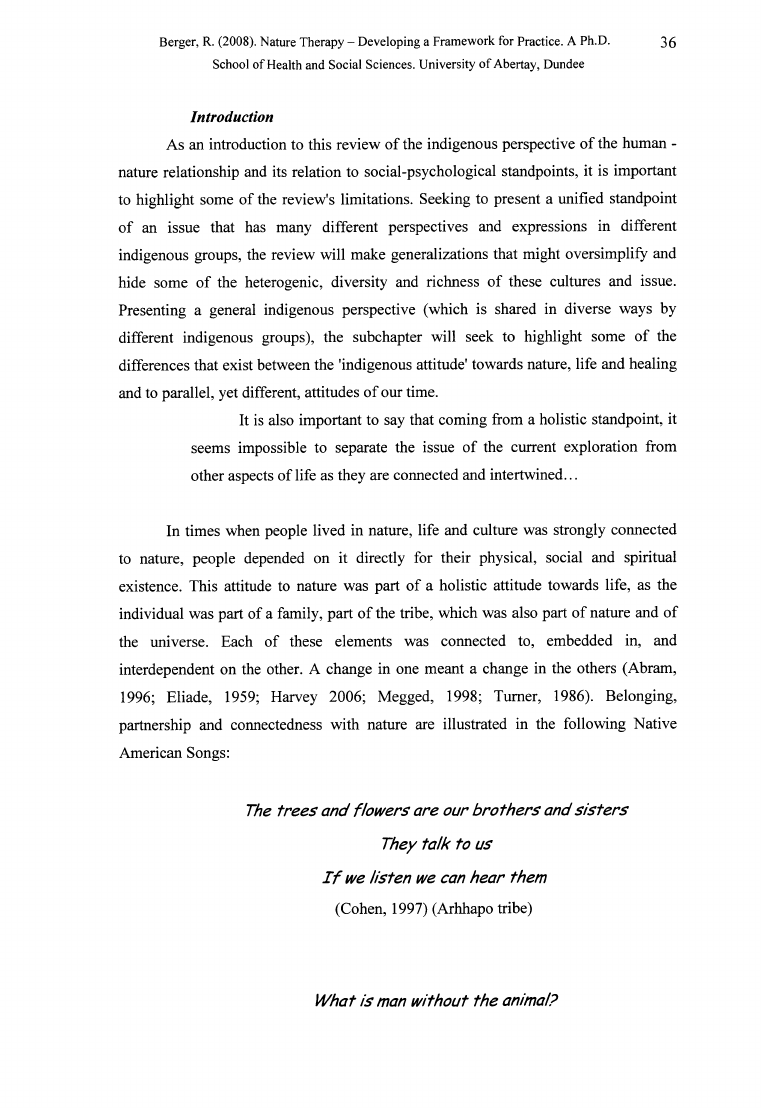
Berger, R. (2008). Nature Therapy - Developing a Framework for Practice. A Ph.D.
36
School o f Health and Social Sciences. University o f Abertay, Dundee
Introduction
As an introduction to this review of the indigenous perspective of the human -
nature relationship and its relation to social-psychological standpoints, it is important
to highlight some of the review's limitations. Seeking to present a unified standpoint
of an issue that has many different perspectives and expressions in different
indigenous groups, the review will make generalizations that might oversimplify and
hide some of the heterogenic, diversity and richness of these cultures and issue.
Presenting a general indigenous perspective (which is shared in diverse ways by
different indigenous groups), the subchapter will seek to highlight some of the
differences that exist between the 'indigenous attitude' towards nature, life and healing
and to parallel, yet different, attitudes of our time.
It is also important to say that coming from a holistic standpoint, it
seems impossible to separate the issue of the current exploration from
other aspects of life as they are connected and intertwined...
In times when people lived in nature, life and culture was strongly connected
to nature, people depended on it directly for their physical, social and spiritual
existence. This attitude to nature was part of a holistic attitude towards life, as the
individual was part of a family, part of the tribe, which was also part of nature and of
the universe. Each of these elements was connected to, embedded in, and
interdependent on the other. A change in one meant a change in the others (Abram,
1996; Eliade, 1959; Harvey 2006; Megged, 1998; Turner, 1986). Belonging,
partnership and connectedness with nature are illustrated in the following Native
American Songs:
The trees and flow ers are our bro th ers and siste rs
They talk to us
I f we listen we can hear them
(Cohen, 1997) (Arhhapo tribe)
W hat is man without the animal?
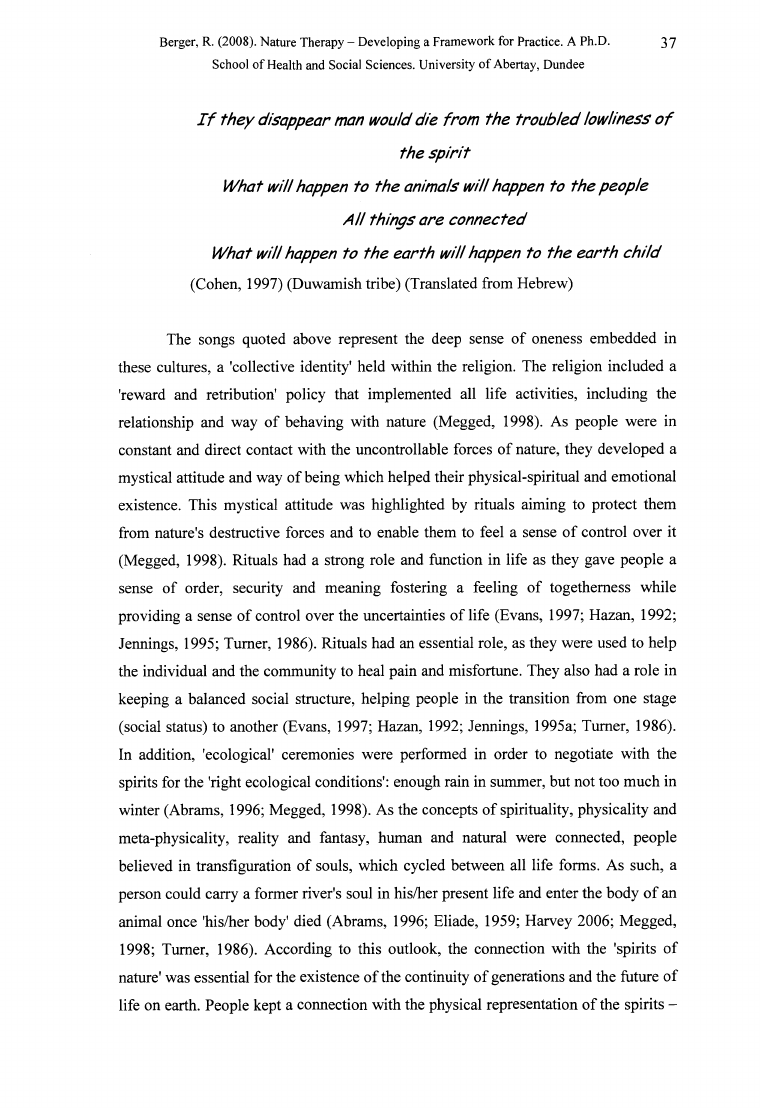
Berger, R. (2008). Nature Therapy - Developing a Framework for Practice. A Ph.D.
37
School o f Health and Social Sciences. University o f Abertay, Dundee
I f they disappear man would die from the troubled lowliness o f
the sp irit
W hat will happen to the animals will happen to the people
A ll things are connected
W hat will happen to the earth will happen to the earth ch ild
(Cohen, 1997) (Duwamish tribe) (Translated from Hebrew)
The songs quoted above represent the deep sense of oneness embedded in
these cultures, a 'collective identity' held within the religion. The religion included a
'reward and retribution' policy that implemented all life activities, including the
relationship and way of behaving with nature (Megged, 1998). As people were in
constant and direct contact with the uncontrollable forces of nature, they developed a
mystical attitude and way of being which helped their physical-spiritual and emotional
existence. This mystical attitude was highlighted by rituals aiming to protect them
from nature's destructive forces and to enable them to feel a sense of control over it
(Megged, 1998). Rituals had a strong role and function in life as they gave people a
sense of order, security and meaning fostering a feeling of togetherness while
providing a sense of control over the uncertainties of life (Evans, 1997; Hazan, 1992;
Jennings, 1995; Turner, 1986). Rituals had an essential role, as they were used to help
the individual and the community to heal pain and misfortune. They also had a role in
keeping a balanced social structure, helping people in the transition from one stage
(social status) to another (Evans, 1997; Hazan, 1992; Jennings, 1995a; Turner, 1986).
In addition, 'ecological' ceremonies were performed in order to negotiate with the
spirits for the 'right ecological conditions': enough rain in summer, but not too much in
winter (Abrams, 1996; Megged, 1998). As the concepts of spirituality, physicality and
meta-physicality, reality and fantasy, human and natural were connected, people
believed in transfiguration of souls, which cycled between all life forms. As such, a
person could carry a former river's soul in his/her present life and enter the body of an
animal once 'his/her body' died (Abrams, 1996; Eliade, 1959; Harvey 2006; Megged,
1998; Turner, 1986). According to this outlook, the connection with the 'spirits of
nature' was essential for the existence of the continuity of generations and the future of
life on earth. People kept a connection with the physical representation of the spirits -
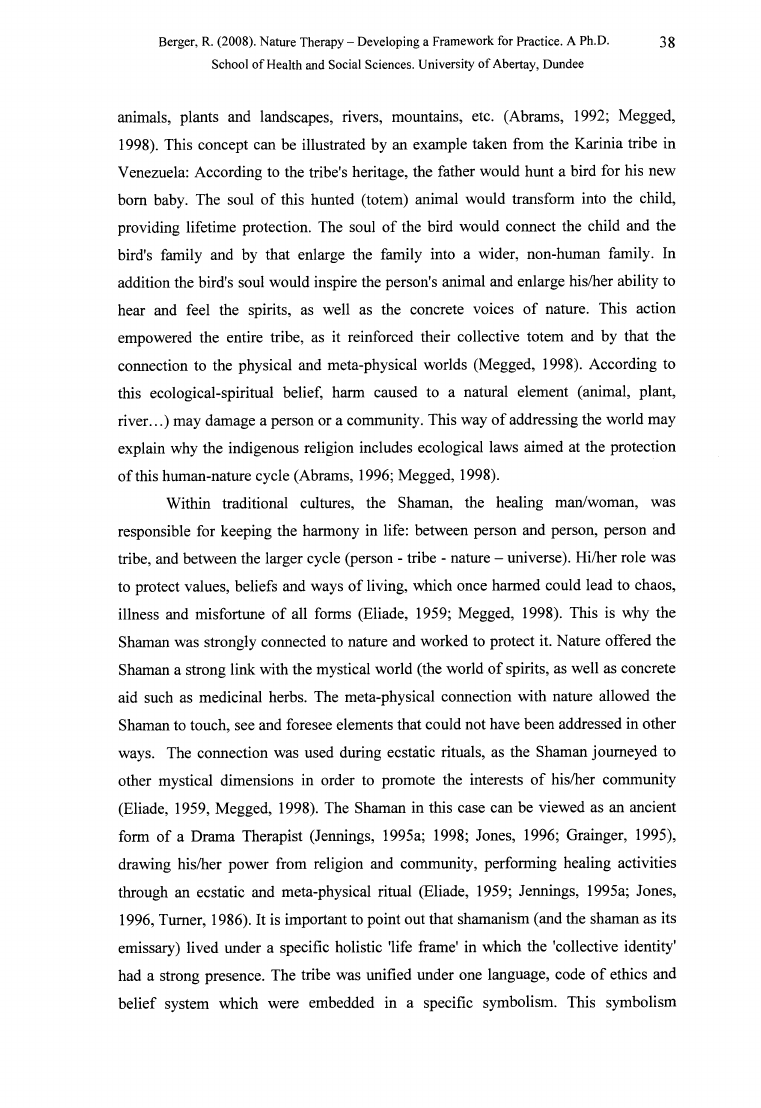
Berger, R. (2008). Nature Therapy - Developing a Framework for Practice. A Ph.D.
38
School o f Health and Social Sciences. University o f Abertay, Dundee
animals, plants and landscapes, rivers, mountains, etc. (Abrams, 1992; Megged,
1998). This concept can be illustrated by an example taken from the Karinia tribe in
Venezuela: According to the tribe's heritage, the father would hunt a bird for his new
bom baby. The soul of this hunted (totem) animal would transform into the child,
providing lifetime protection. The soul of the bird would connect the child and the
bird's family and by that enlarge the family into a wider, non-human family. In
addition the bird's soul would inspire the person's animal and enlarge his/her ability to
hear and feel the spirits, as well as the concrete voices of nature. This action
empowered the entire tribe, as it reinforced their collective totem and by that the
connection to the physical and meta-physical worlds (Megged, 1998). According to
this ecological-spiritual belief, harm caused to a natural element (animal, plant,
river...) may damage a person or a community. This way of addressing the world may
explain why the indigenous religion includes ecological laws aimed at the protection
of this human-nature cycle (Abrams, 1996; Megged, 1998).
Within traditional cultures, the Shaman, the healing man/woman, was
responsible for keeping the harmony in life: between person and person, person and
tribe, and between the larger cycle (person - tribe - nature - universe). Hi/her role was
to protect values, beliefs and ways of living, which once harmed could lead to chaos,
illness and misfortune of all forms (Eliade, 1959; Megged, 1998). This is why the
Shaman was strongly connected to nature and worked to protect it. Nature offered the
Shaman a strong link with the mystical world (the world of spirits, as well as concrete
aid such as medicinal herbs. The meta-physical connection with nature allowed the
Shaman to touch, see and foresee elements that could not have been addressed in other
ways. The connection was used during ecstatic rituals, as the Shaman journeyed to
other mystical dimensions in order to promote the interests of his/her community
(Eliade, 1959, Megged, 1998). The Shaman in this case can be viewed as an ancient
form of a Drama Therapist (Jennings, 1995a; 1998; Jones, 1996; Grainger, 1995),
drawing his/her power from religion and community, performing healing activities
through an ecstatic and meta-physical ritual (Eliade, 1959; Jennings, 1995a; Jones,
1996, Turner, 1986). It is important to point out that shamanism (and the shaman as its
emissary) lived under a specific holistic 'life frame' in which the 'collective identity'
had a strong presence. The tribe was unified under one language, code of ethics and
belief system which were embedded in a specific symbolism. This symbolism
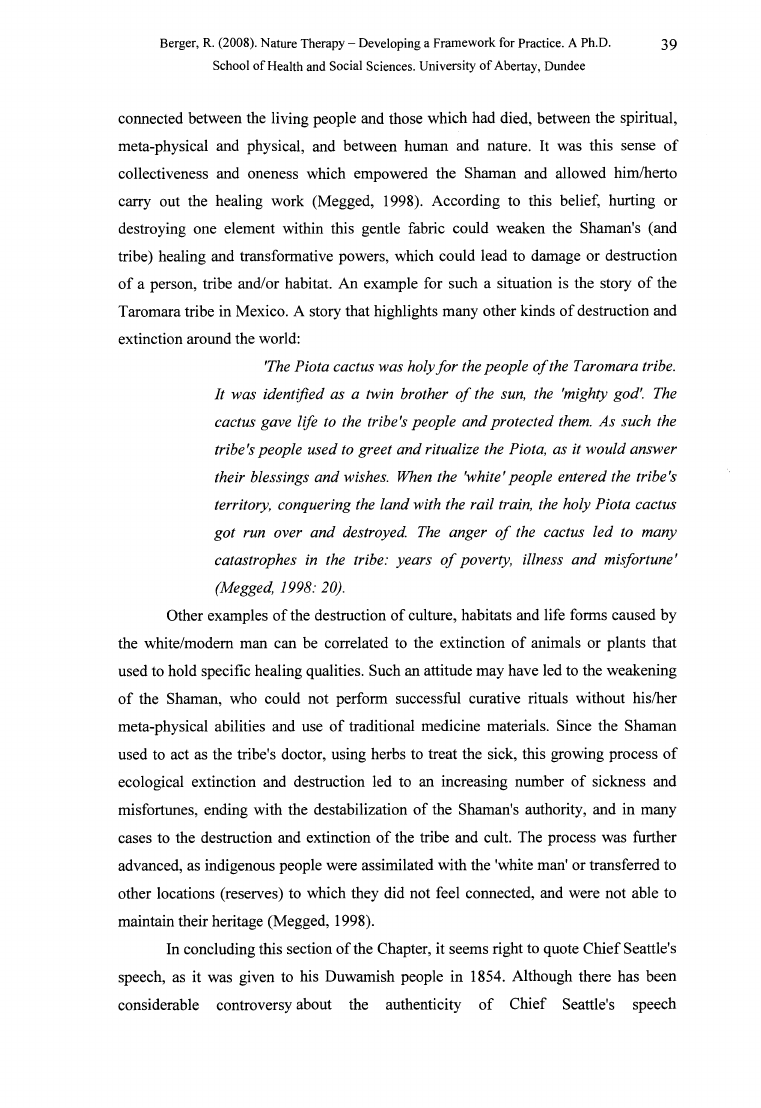
Berger, R. (2008). Nature Therapy - Developing a Framework for Practice. A Ph.D.
39
School o f Health and Social Sciences. University o f Abertay, Dundee
connected between the living people and those which had died, between the spiritual,
meta-physical and physical, and between human and nature. It was this sense of
collectiveness and oneness which empowered the Shaman and allowed him/herto
carry out the healing work (Megged, 1998). According to this belief, hurting or
destroying one element within this gentle fabric could weaken the Shaman's (and
tribe) healing and transformative powers, which could lead to damage or destruction
of a person, tribe and/or habitat. An example for such a situation is the story of the
Taromara tribe in Mexico. A story that highlights many other kinds of destruction and
extinction around the world:
'The Piota cactus was holyfor the people o f the Taromara tribe.
It was identified as a twin brother o f the sun, the 'mighty god'. The
cactus gave life to the tribe's people and protected them. As such the
tribe's people used to greet and ritualize the Piota, as it would answer
their blessings and wishes. When the 'white'people entered the tribe's
territory, conquering the land with the rail train, the holy Piota cactus
got run over and destroyed. The anger o f the cactus led to many
catastrophes in the tribe: years o f poverty, illness and misfortune'
(Megged, 1998: 20).
Other examples of the destruction of culture, habitats and life forms caused by
the white/modem man can be correlated to the extinction of animals or plants that
used to hold specific healing qualities. Such an attitude may have led to the weakening
of the Shaman, who could not perform successful curative rituals without his/her
meta-physical abilities and use of traditional medicine materials. Since the Shaman
used to act as the tribe's doctor, using herbs to treat the sick, this growing process of
ecological extinction and destruction led to an increasing number of sickness and
misfortunes, ending with the destabilization of the Shaman's authority, and in many
cases to the destruction and extinction of the tribe and cult. The process was further
advanced, as indigenous people were assimilated with the 'white man' or transferred to
other locations (reserves) to which they did not feel connected, and were not able to
maintain their heritage (Megged, 1998).
In concluding this section of the Chapter, it seems right to quote Chief Seattle's
speech, as it was given to his Duwamish people in 1854. Although there has been
considerable controversy about the authenticity of Chief Seattle's speech
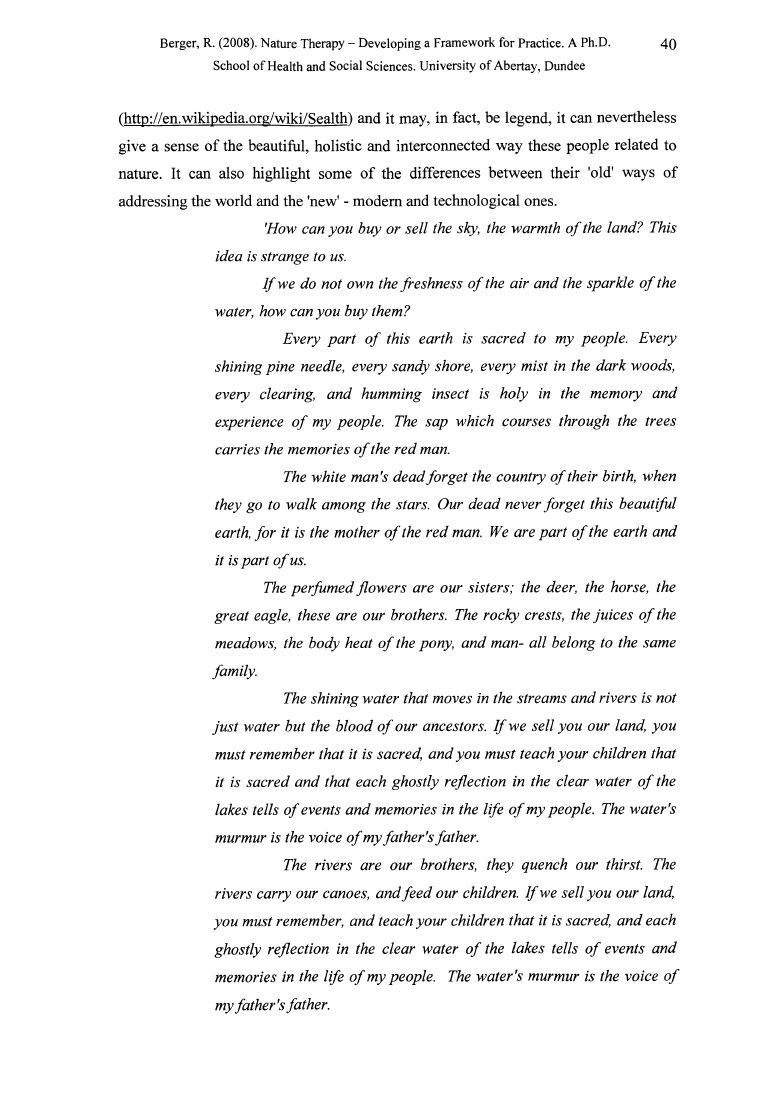
Berger, R. (2008). Nature Therapy - Developing a Framework for Practice. A Ph.D.
40
School o f Health and Social Sciences. University o f Abertay, Dundee
(http://en.wikipedia.org/wiki/Sealth) and it may, in fact, be legend, it can nevertheless
give a sense of the beautiful, holistic and interconnected way these people related to
nature. It can also highlight some of the differences between their 'old' ways of
addressing the world and the 'new' - modem and technological ones.
'How can you buy or sell the sky, the warmth o f the land? This
idea is strange to us.
I f we do not own the freshness o f the air and the sparkle o f the
water, how can you buy them?
Every part o f this earth is sacred to my people. Every
shining pine needle, every sandy shore, every mist in the dark woods,
every clearing, and humming insect is holy in the memory and
experience o f my people. The sap which courses through the trees
carries the memories o f the red man.
The white man's deadforget the country o f their birth, when
they go to walk among the stars. Our dead never forget this beautiful
earth, for it is the mother o f the red man. We are part o f the earth and
it is part o f us.
The perfumed flowers are our sisters; the deer, the horse, the
great eagle, these are our brothers. The rocky crests, the juices o f the
meadows, the body heat o f the pony, and man- all belong to the same
family.
The shining water that moves in the streams and rivers is not
just water but the blood o f our ancestors. I f we sell you our land, you
must remember that it is sacred, and you must teach your children that
it is sacred and that each ghostly reflection in the clear water o f the
lakes tells o f events and memories in the life o f my people. The water’s
murmur is the voice o f myfather'sfather.
The rivers are our brothers, they quench our thirst. The
rivers carry our canoes, andfeed our children. I f we sell you our land,
you must remember, and teach your children that it is sacred, and each
ghostly reflection in the clear water o f the lakes tells o f events and
memories in the life o f my people. The water's murmur is the voice o f
my fa th e r ’s father.
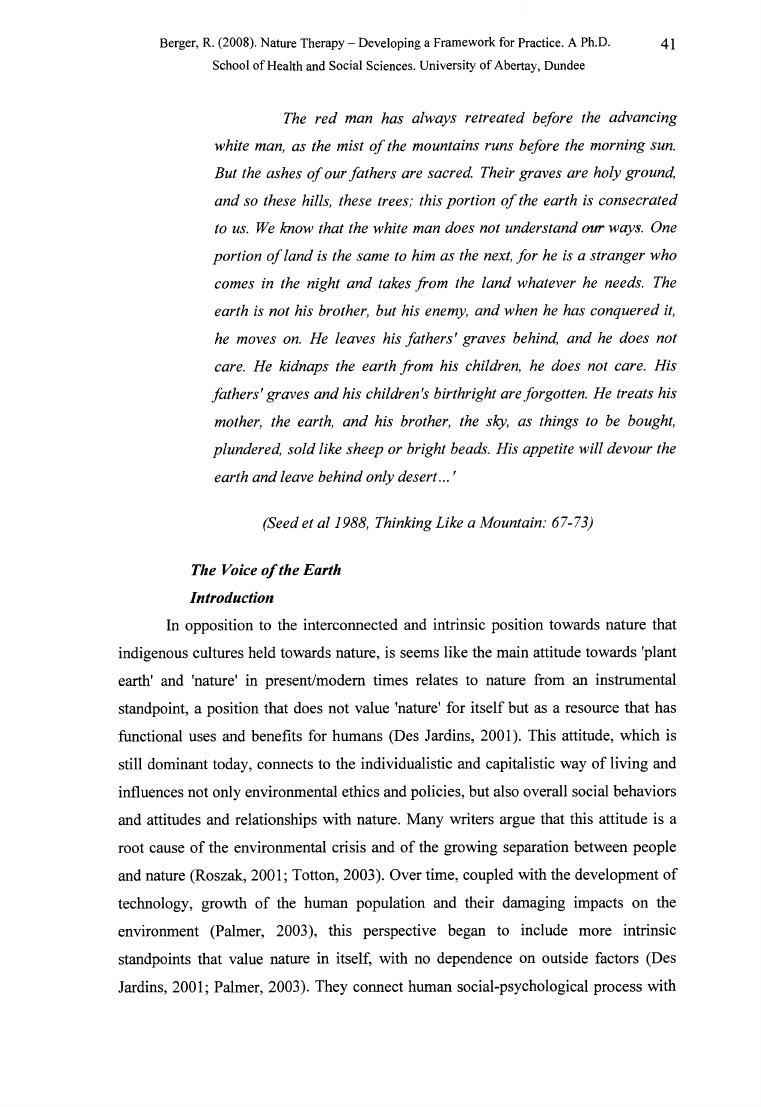
Berger, R. (2008). Nature Therapy - Developing a Framework for Practice. A Ph.D.
41
School o f Health and Social Sciences. University o f Abertay, Dundee
The red man has always retreated before the advancing
white man, as the mist o f the mountains runs before the morning sun.
But the ashes o f our fathers are sacred. Their graves are holy ground,
and so these hills, these trees; this portion o f the earth is consecrated
to us. We know that the white man does not understand our ways. One
portion o f land is the same to him as the next, for he is a stranger who
comes in the night and takes from the land whatever he needs. The
earth is not his brother, but his enemy, and when he has conquered it,
he moves on. He leaves his fathers' graves behind, and he does not
care. He kidnaps the earth from his children, he does not care. His
fathers' graves and his children's birthright are forgotten. He treats his
mother, the earth, and his brother, the sky, as things to be bought,
plundered, sold like sheep or bright beads. His appetite will devour the
earth and leave behind only desert...'
(Seed et al 1988, Thinking Like a Mountain: 67-73)
The Voice o f the Earth
Introduction
In opposition to the interconnected and intrinsic position towards nature that
indigenous cultures held towards nature, is seems like the main attitude towards 'plant
earth' and 'nature' in present/modem times relates to nature from an instrumental
standpoint, a position that does not value 'nature' for itself but as a resource that has
functional uses and benefits for humans (Des Jardins, 2001). This attitude, which is
still dominant today, connects to the individualistic and capitalistic way of living and
influences not only environmental ethics and policies, but also overall social behaviors
and attitudes and relationships with nature. Many writers argue that this attitude is a
root cause of the environmental crisis and of the growing separation between people
and nature (Roszak, 2001; Totton, 2003). Over time, coupled with the development of
technology, growth of the human population and their damaging impacts on the
environment (Palmer, 2003), this perspective began to include more intrinsic
standpoints that value nature in itself, with no dependence on outside factors (Des
Jardins, 2001; Palmer, 2003). They connect human social-psychological process with
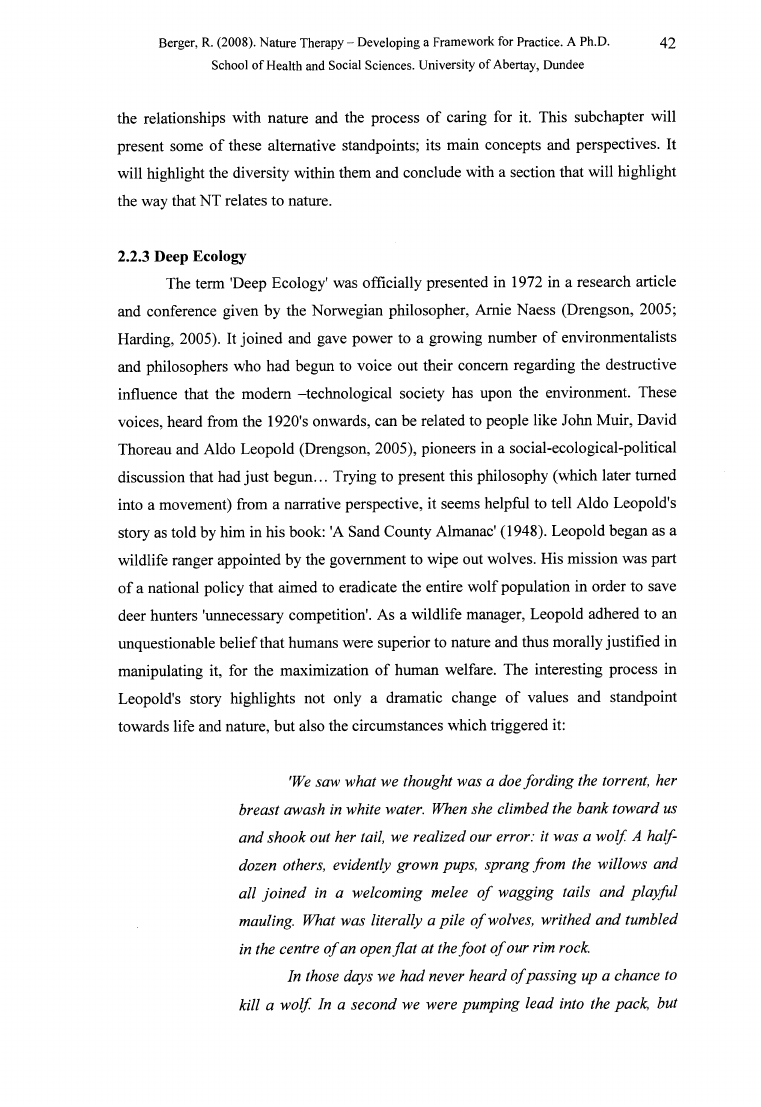
Berger, R. (2008). Nature Therapy - Developing a Framework for Practice. A Ph.D.
42
School o f Health and Social Sciences. University o f Abertay, Dundee
the relationships with nature and the process of caring for it. This subchapter will
present some of these alternative standpoints; its main concepts and perspectives. It
will highlight the diversity within them and conclude with a section that will highlight
the way that NT relates to nature.
2.2.3 Deep Ecology
The term 'Deep Ecology' was officially presented in 1972 in a research article
and conference given by the Norwegian philosopher, Amie Naess (Drengson, 2005;
Harding, 2005). It joined and gave power to a growing number of environmentalists
and philosophers who had begun to voice out their concern regarding the destructive
influence that the modem -technological society has upon the environment. These
voices, heard from the 1920's onwards, can be related to people like John Muir, David
Thoreau and Aldo Leopold (Drengson, 2005), pioneers in a social-ecological-political
discussion that had just begun... Trying to present this philosophy (which later turned
into a movement) from a narrative perspective, it seems helpful to tell Aldo Leopold's
story as told by him in his book: 'A Sand County Almanac' (1948). Leopold began as a
wildlife ranger appointed by the government to wipe out wolves. His mission was part
of a national policy that aimed to eradicate the entire wolf population in order to save
deer hunters 'unnecessary competition'. As a wildlife manager, Leopold adhered to an
unquestionable belief that humans were superior to nature and thus morally justified in
manipulating it, for the maximization of human welfare. The interesting process in
Leopold's story highlights not only a dramatic change of values and standpoint
towards life and nature, but also the circumstances which triggered it:
'We saw what we thought was a doe fording the torrent, her
breast awash in white water. When she climbed the bank toward us
and shook out her tail, we realized our error: it was a wolf A half-
dozen others, evidently grown pups, sprang from the willows and
all joined in a welcoming melee o f wagging tails and playful
mauling. What was literally a pile o f wolves, writhed and tumbled
in the centre o f an openflat at thefoot o f our rim rock.
In those days we had never heard o fpassing up a chance to
kill a wolf. In a second we were pumping lead into the pack, but
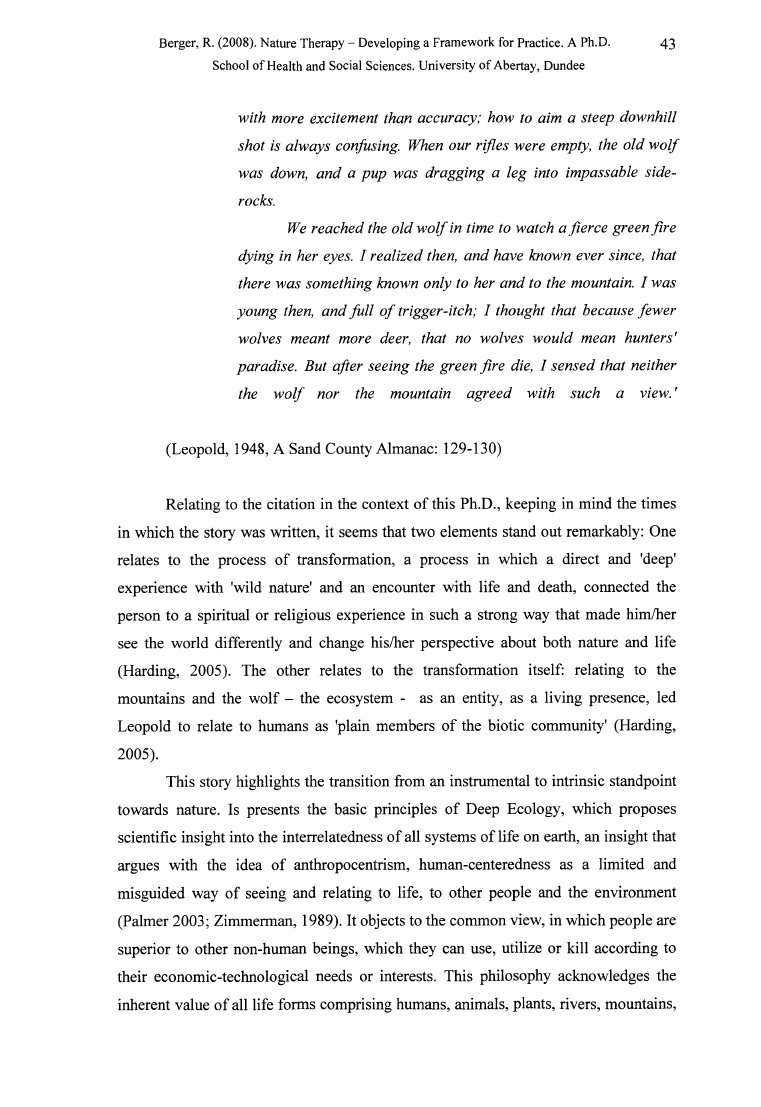
Berger, R. (2008). Nature Therapy - Developing a Framework for Practice. A Ph.D.
43
School o f Health and Social Sciences. University o f Abertay, Dundee
with more excitement than accuracy; how to aim a steep downhill
shot is always confusing. When our rifles were empty, the old wolf
was down, and a pup was dragging a leg into impassable side-
rocks.
We reached the old wolf in time to watch afierce green fire
dying in her eyes. I realized then, and have known ever since, that
there was something known only to her and to the mountain. I was
young then, and full o f trigger-itch; I thought that because fewer
wolves meant more deer, that no wolves would mean hunters'
paradise. But after seeing the green fire die, I sensed that neither
the wolf nor the mountain agreed with such a view.'
(Leopold, 1948, A Sand County Almanac: 129-130)
Relating to the citation in the context of this Ph.D., keeping in mind the times
in which the story was written, it seems that two elements stand out remarkably: One
relates to the process of transformation, a process in which a direct and 'deep'
experience with 'wild nature' and an encounter with life and death, connected the
person to a spiritual or religious experience in such a strong way that made him/her
see the world differently and change his/her perspective about both nature and life
(Harding, 2005). The other relates to the transformation itself: relating to the
mountains and the wolf - the ecosystem - as an entity, as a living presence, led
Leopold to relate to humans as 'plain members of the biotic community' (Harding,
2005).
This story highlights the transition from an instrumental to intrinsic standpoint
towards nature. Is presents the basic principles of Deep Ecology, which proposes
scientific insight into the interrelatedness of all systems of life on earth, an insight that
argues with the idea of anthropocentrism, human-centeredness as a limited and
misguided way of seeing and relating to life, to other people and the environment
(Palmer 2003; Zimmerman, 1989). It objects to the common view, in which people are
superior to other non-human beings, which they can use, utilize or kill according to
their economic-technological needs or interests. This philosophy acknowledges the
inherent value of all life forms comprising humans, animals, plants, rivers, mountains,
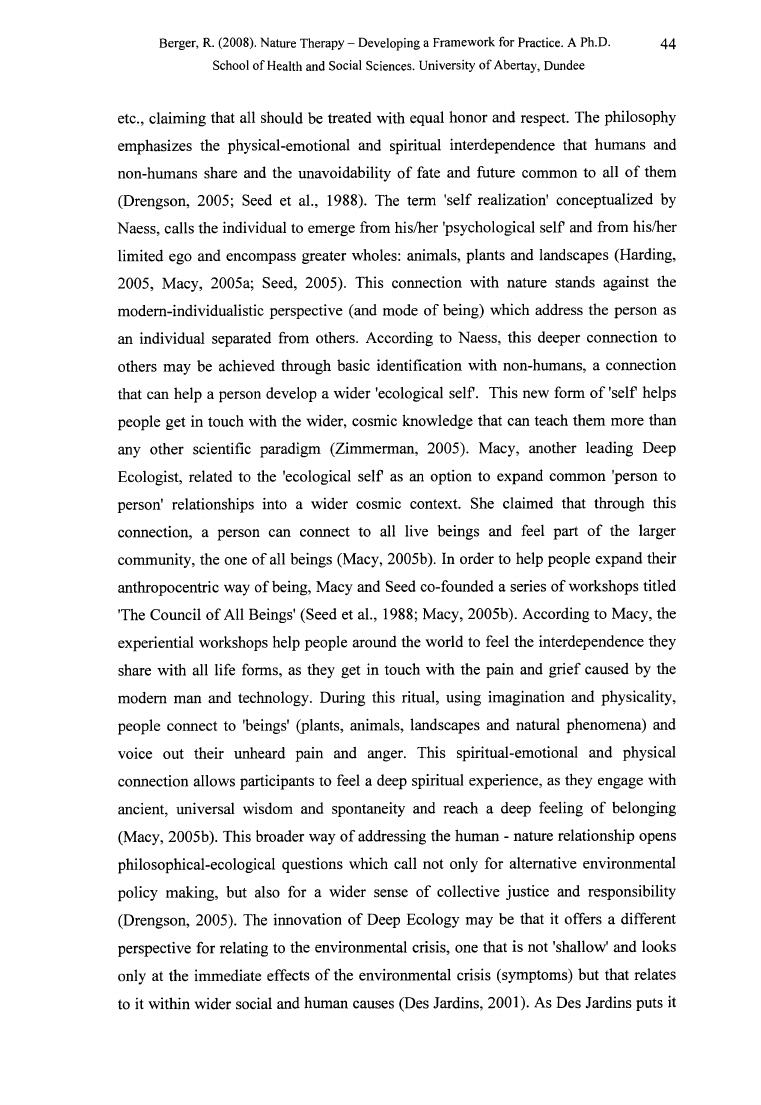
Berger, R. (2008). Nature Therapy - Developing a Framework for Practice. A Ph.D.
44
School o f Health and Social Sciences. University o f Abertay, Dundee
etc., claiming that all should be treated with equal honor and respect. The philosophy
emphasizes the physical-emotional and spiritual interdependence that humans and
non-humans share and the unavoidability of fate and future common to all of them
(Drengson, 2005; Seed et al., 1988). The term 'self realization' conceptualized by
Naess, calls the individual to emerge from his/her 'psychological self and from his/her
limited ego and encompass greater wholes: animals, plants and landscapes (Harding,
2005, Macy, 2005a; Seed, 2005). This connection with nature stands against the
modem-individualistic perspective (and mode of being) which address the person as
an individual separated from others. According to Naess, this deeper connection to
others may be achieved through basic identification with non-humans, a connection
that can help a person develop a wider 'ecological self. This new form of 'self helps
people get in touch with the wider, cosmic knowledge that can teach them more than
any other scientific paradigm (Zimmerman, 2005). Macy, another leading Deep
Ecologist, related to the 'ecological self as an option to expand common 'person to
person' relationships into a wider cosmic context. She claimed that through this
connection, a person can connect to all live beings and feel part of the larger
community, the one of all beings (Macy, 2005b). In order to help people expand their
anthropocentric way of being, Macy and Seed co-founded a series of workshops titled
'The Council of All Beings' (Seed et al., 1988; Macy, 2005b). According to Macy, the
experiential workshops help people around the world to feel the interdependence they
share with all life forms, as they get in touch with the pain and grief caused by the
modem man and technology. During this ritual, using imagination and physicality,
people connect to 'beings' (plants, animals, landscapes and natural phenomena) and
voice out their unheard pain and anger. This spiritual-emotional and physical
connection allows participants to feel a deep spiritual experience, as they engage with
ancient, universal wisdom and spontaneity and reach a deep feeling of belonging
(Macy, 2005b). This broader way of addressing the human - nature relationship opens
philosophical-ecological questions which call not only for alternative environmental
policy making, but also for a wider sense of collective justice and responsibility
(Drengson, 2005). The innovation of Deep Ecology may be that it offers a different
perspective for relating to the environmental crisis, one that is not 'shallow' and looks
only at the immediate effects of the environmental crisis (symptoms) but that relates
to it within wider social and human causes (Des Jardins, 2001). As Des Jardins puts it
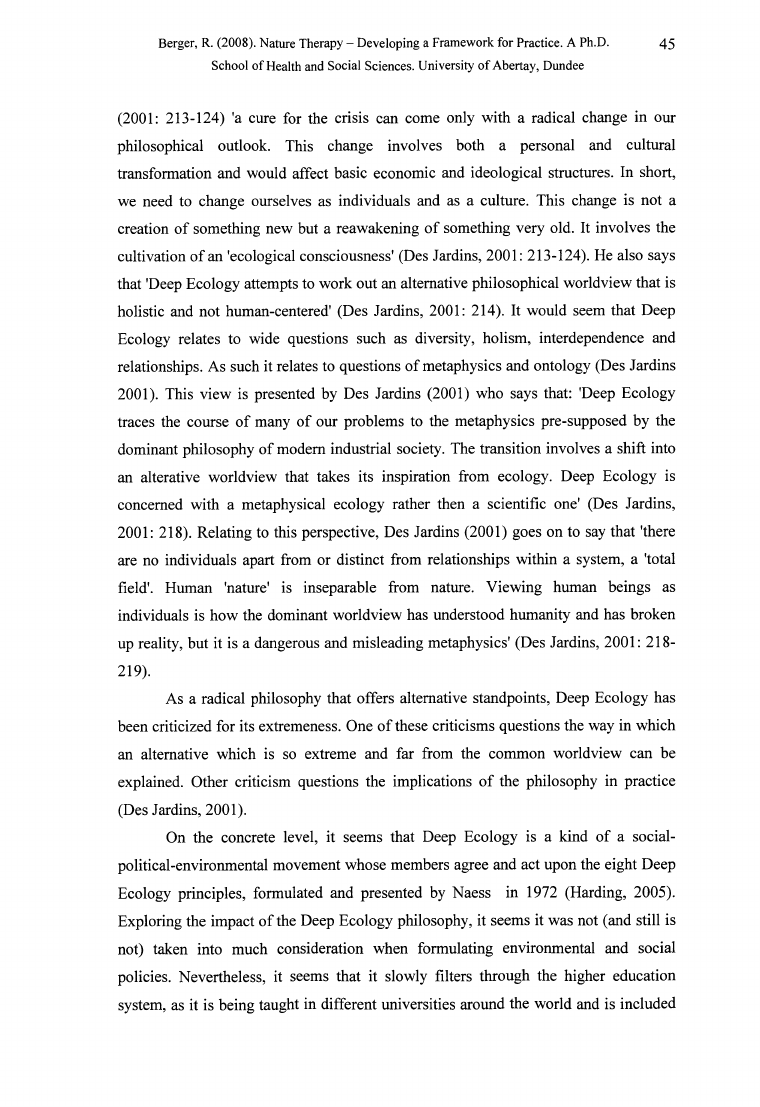
Berger, R. (2008). Nature Therapy - Developing a Framework for Practice. A Ph.D.
45
School o f Health and Social Sciences. University o f Abertay, Dundee
(2001: 213-124) 'a cure for the crisis can come only with a radical change in our
philosophical outlook. This change involves both a personal and cultural
transformation and would affect basic economic and ideological structures. In short,
we need to change ourselves as individuals and as a culture. This change is not a
creation of something new but a reawakening of something very old. It involves the
cultivation of an 'ecological consciousness' (Des Jardins, 2001: 213-124). He also says
that 'Deep Ecology attempts to work out an alternative philosophical worldview that is
holistic and not human-centered' (Des Jardins, 2001: 214). It would seem that Deep
Ecology relates to wide questions such as diversity, holism, interdependence and
relationships. As such it relates to questions of metaphysics and ontology (Des Jardins
2001). This view is presented by Des Jardins (2001) who says that: 'Deep Ecology
traces the course of many of our problems to the metaphysics pre-supposed by the
dominant philosophy of modem industrial society. The transition involves a shift into
an alterative worldview that takes its inspiration from ecology. Deep Ecology is
concerned with a metaphysical ecology rather then a scientific one' (Des Jardins,
2001: 218). Relating to this perspective, Des Jardins (2001) goes on to say that 'there
are no individuals apart from or distinct from relationships within a system, a 'total
field'. Human 'nature' is inseparable from nature. Viewing human beings as
individuals is how the dominant worldview has understood humanity and has broken
up reality, but it is a dangerous and misleading metaphysics' (Des Jardins, 2001: 218-
219).
As a radical philosophy that offers alternative standpoints, Deep Ecology has
been criticized for its extremeness. One of these criticisms questions the way in which
an alternative which is so extreme and far from the common worldview can be
explained. Other criticism questions the implications of the philosophy in practice
(Des Jardins, 2001).
On the concrete level, it seems that Deep Ecology is a kind of a social-
political-environmental movement whose members agree and act upon the eight Deep
Ecology principles, formulated and presented by Naess in 1972 (Harding, 2005).
Exploring the impact of the Deep Ecology philosophy, it seems it was not (and still is
not) taken into much consideration when formulating environmental and social
policies. Nevertheless, it seems that it slowly filters through the higher education
system, as it is being taught in different universities around the world and is included
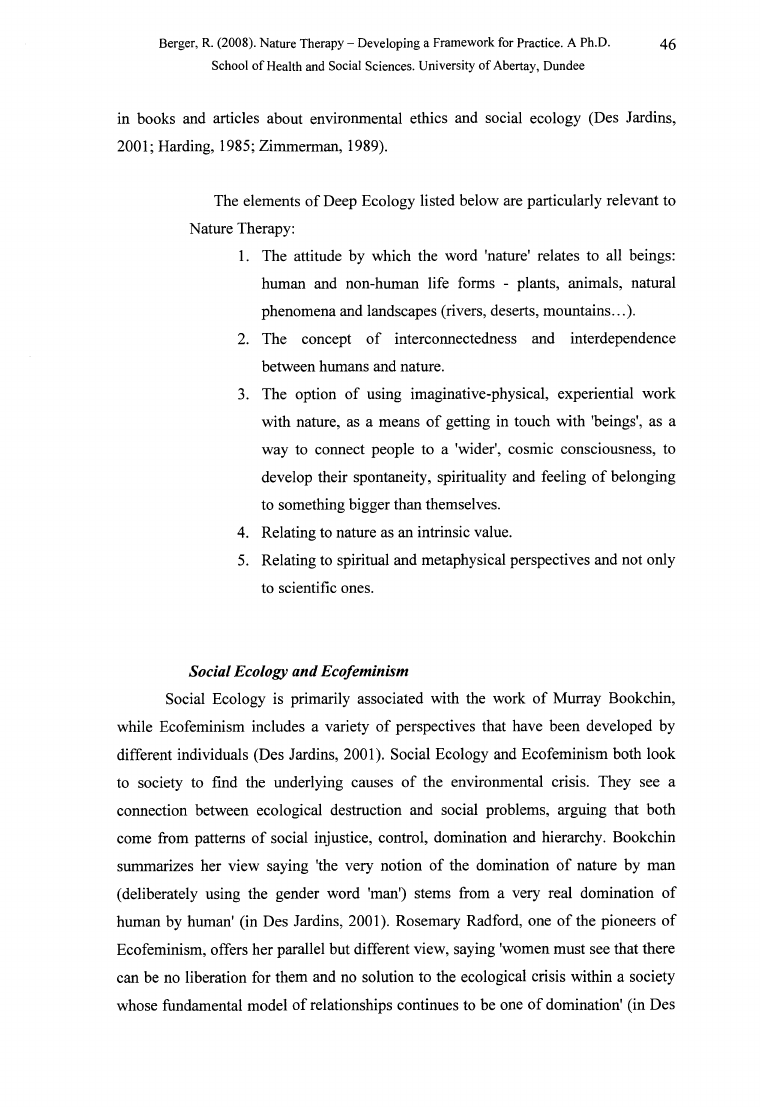
Berger, R. (2008). Nature Therapy - Developing a Framework for Practice. A Ph.D.
46
School o f Health and Social Sciences. University o f Abertay, Dundee
in books and articles about environmental ethics and social ecology (Des Jardins,
2001; Harding, 1985; Zimmerman, 1989).
The elements of Deep Ecology listed below are particularly relevant to
Nature Therapy:
1. The attitude by which the word 'nature' relates to all beings:
human and non-human life forms - plants, animals, natural
phenomena and landscapes (rivers, deserts, mountains...).
2. The concept of interconnectedness and interdependence
between humans and nature.
3. The option of using imaginative-physical, experiential work
with nature, as a means of getting in touch with 'beings', as a
way to connect people to a 'wider', cosmic consciousness, to
develop their spontaneity, spirituality and feeling of belonging
to something bigger than themselves.
4. Relating to nature as an intrinsic value.
5. Relating to spiritual and metaphysical perspectives and not only
to scientific ones.
Social Ecology and Ecofeminism
Social Ecology is primarily associated with the work of Murray Bookchin,
while Ecofeminism includes a variety of perspectives that have been developed by
different individuals (Des Jardins, 2001). Social Ecology and Ecofeminism both look
to society to find the underlying causes of the environmental crisis. They see a
connection between ecological destruction and social problems, arguing that both
come from patterns of social injustice, control, domination and hierarchy. Bookchin
summarizes her view saying 'the very notion of the domination of nature by man
(deliberately using the gender word 'man') stems from a very real domination of
human by human' (in Des Jardins, 2001). Rosemary Radford, one of the pioneers of
Ecofeminism, offers her parallel but different view, saying 'women must see that there
can be no liberation for them and no solution to the ecological crisis within a society
whose fundamental model of relationships continues to be one of domination' (in Des
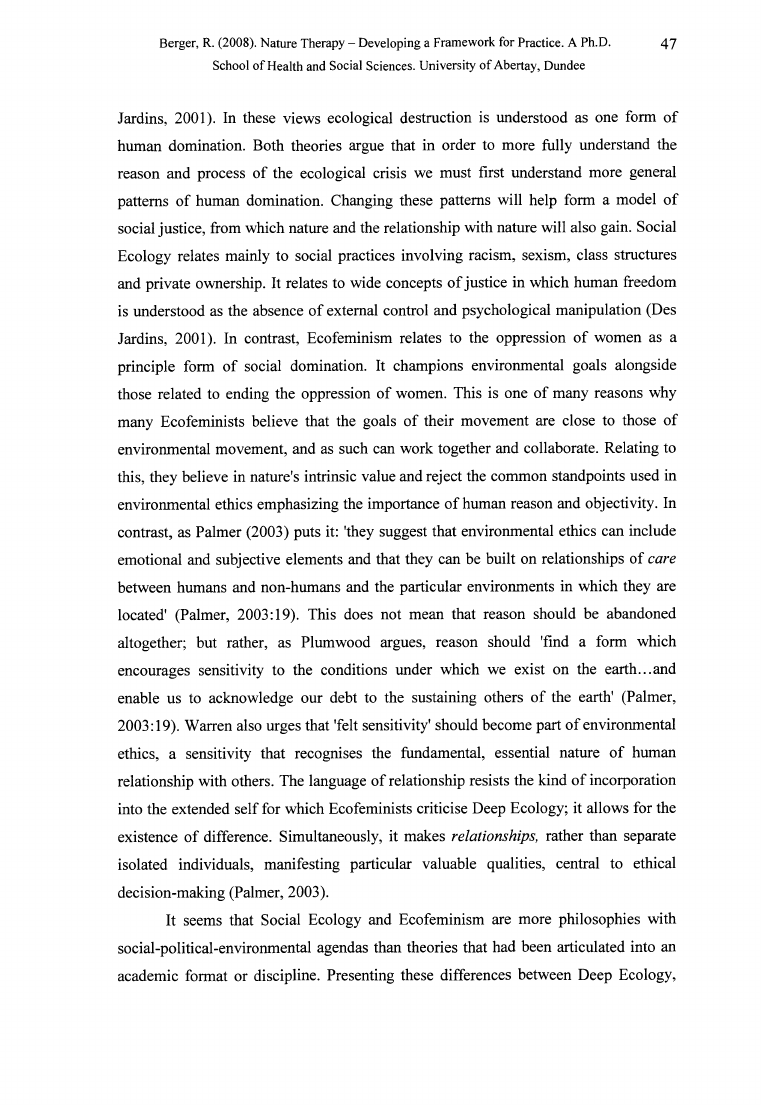
Berger, R. (2008). Nature Therapy - Developing a Framework for Practice. A Ph.D.
47
School o f Health and Social Sciences. University o f Abertay, Dundee
Jardins, 2001). In these views ecological destruction is understood as one form of
human domination. Both theories argue that in order to more fully understand the
reason and process of the ecological crisis we must first understand more general
patterns of human domination. Changing these patterns will help form a model of
social justice, from which nature and the relationship with nature will also gain. Social
Ecology relates mainly to social practices involving racism, sexism, class structures
and private ownership. It relates to wide concepts of justice in which human freedom
is understood as the absence of external control and psychological manipulation (Des
Jardins, 2001). In contrast, Ecofeminism relates to the oppression of women as a
principle form of social domination. It champions environmental goals alongside
those related to ending the oppression of women. This is one of many reasons why
many Ecofeminists believe that the goals of their movement are close to those of
environmental movement, and as such can work together and collaborate. Relating to
this, they believe in nature's intrinsic value and reject the common standpoints used in
environmental ethics emphasizing the importance of human reason and objectivity. In
contrast, as Palmer (2003) puts it: 'they suggest that environmental ethics can include
emotional and subjective elements and that they can be built on relationships of care
between humans and non-humans and the particular environments in which they are
located' (Palmer, 2003:19). This does not mean that reason should be abandoned
altogether; but rather, as Plumwood argues, reason should 'find a form which
encourages sensitivity to the conditions under which we exist on the earth...and
enable us to acknowledge our debt to the sustaining others of the earth' (Palmer,
2003:19). Warren also urges that 'felt sensitivity' should become part of environmental
ethics, a sensitivity that recognises the fundamental, essential nature of human
relationship with others. The language of relationship resists the kind of incorporation
into the extended self for which Ecofeminists criticise Deep Ecology; it allows for the
existence of difference. Simultaneously, it makes relationships, rather than separate
isolated individuals, manifesting particular valuable qualities, central to ethical
decision-making (Palmer, 2003).
It seems that Social Ecology and Ecofeminism are more philosophies with
social-political-environmental agendas than theories that had been articulated into an
academic format or discipline. Presenting these differences between Deep Ecology,
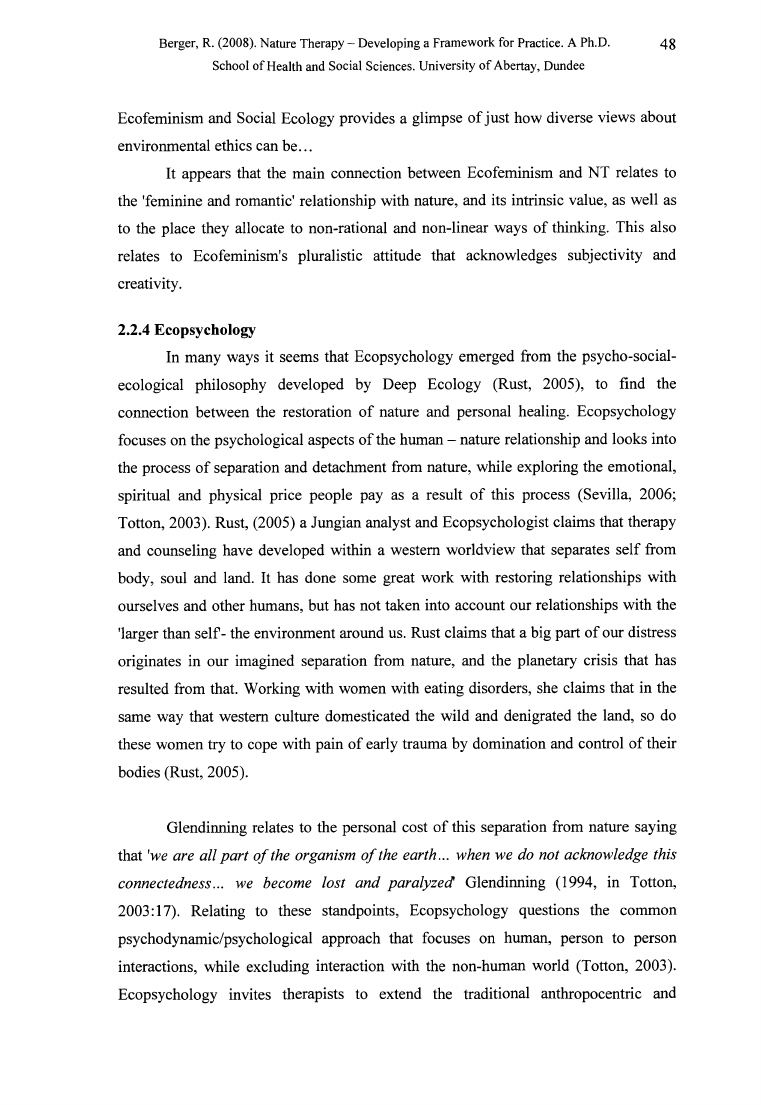
Berger, R. (2008). Nature Therapy - Developing a Framework for Practice. A Ph.D.
48
School of Health and Social Sciences. University of Abertay, Dundee
Ecofeminism and Social Ecology provides a glimpse of just how diverse views about
environmental ethics can be...
It appears that the main connection between Ecofeminism and NT relates to
the 'feminine and romantic' relationship with nature, and its intrinsic value, as well as
to the place they allocate to non-rational and non-linear ways of thinking. This also
relates to Ecofeminism's pluralistic attitude that acknowledges subjectivity and
creativity.
2.2.4 Ecopsychology
In many ways it seems that Ecopsychology emerged from the psycho-social-
ecological philosophy developed by Deep Ecology (Rust, 2005), to find the
connection between the restoration of nature and personal healing. Ecopsychology
focuses on the psychological aspects of the human - nature relationship and looks into
the process of separation and detachment from nature, while exploring the emotional,
spiritual and physical price people pay as a result of this process (Sevilla, 2006;
Totton, 2003). Rust, (2005) a Jungian analyst and Ecopsychologist claims that therapy
and counseling have developed within a western worldview that separates self from
body, soul and land. It has done some great work with restoring relationships with
ourselves and other humans, but has not taken into account our relationships with the
'larger than self- the environment around us. Rust claims that a big part of our distress
originates in our imagined separation from nature, and the planetary crisis that has
resulted from that. Working with women with eating disorders, she claims that in the
same way that western culture domesticated the wild and denigrated the land, so do
these women try to cope with pain of early trauma by domination and control of their
bodies (Rust, 2005).
Glendinning relates to the personal cost of this separation from nature saying
th a t'we are all part o f the organism o f the earth... when we do not acknowledge this
connectedness... we become lost and paralyzed Glendinning (1994, in Totton,
2003:17). Relating to these standpoints, Ecopsychology questions the common
psychodynamic/psychological approach that focuses on human, person to person
interactions, while excluding interaction with the non-human world (Totton, 2003).
Ecopsychology invites therapists to extend the traditional anthropocentric and
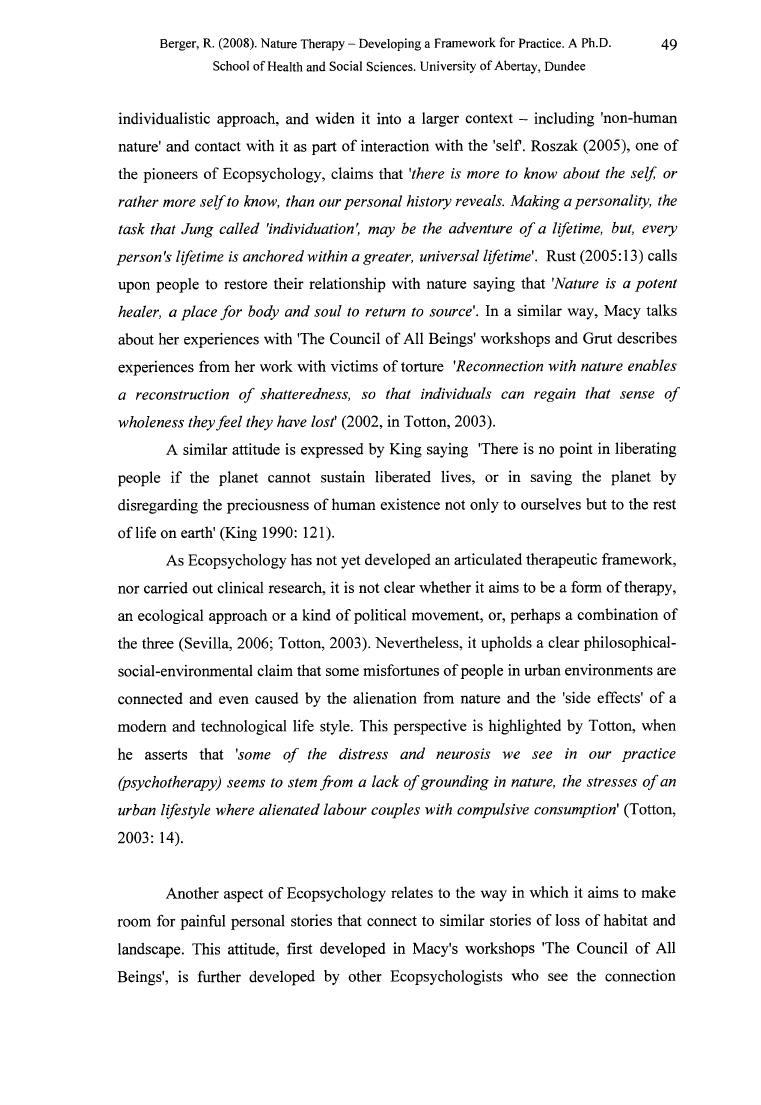
Berger, R. (2008). Nature Therapy - Developing a Framework for Practice. A Ph.D.
49
School of Health and Social Sciences. University of Abertay, Dundee
individualistic approach, and widen it into a larger context - including 'non-human
nature' and contact with it as part of interaction with the 'self. Roszak (2005), one of
the pioneers of Ecopsychology, claims that 'there is more to know about the self, or
rather more self to know, than our personal history reveals. Making a personality, the
task that Jung called ’individuation', may be the adventure o f a lifetime, but, every
person's lifetime is anchored within a greater, universal lifetime'. Rust (2005:13) calls
upon people to restore their relationship with nature saying that 'Nature is a potent
healer, a place for body and soul to return to source'. In a similar way, Macy talks
about her experiences with 'The Council of All Beings' workshops and Grut describes
experiences from her work with victims of torture 'Reconnection with nature enables
a reconstruction o f shatteredness, so that individuals can regain that sense o f
wholeness theyfeel they have lost' (2002, in Totton, 2003).
A similar attitude is expressed by King saying 'There is no point in liberating
people if the planet cannot sustain liberated lives, or in saving the planet by
disregarding the preciousness of human existence not only to ourselves but to the rest
of life on earth' (King 1990: 121).
As Ecopsychology has not yet developed an articulated therapeutic framework,
nor carried out clinical research, it is not clear whether it aims to be a form of therapy,
an ecological approach or a kind of political movement, or, perhaps a combination of
the three (Sevilla, 2006; Totton, 2003). Nevertheless, it upholds a clear philosophical-
social-environmental claim that some misfortunes of people in urban environments are
connected and even caused by the alienation from nature and the 'side effects' of a
modem and technological life style. This perspective is highlighted by Totton, when
he asserts that 'some o f the distress and neurosis we see in our practice
(psychotherapy) seems to stem from a lack o f grounding in nature, the stresses o f an
urban lifestyle where alienated labour couples with compulsive consumption' (Totton,
2003: 14).
Another aspect of Ecopsychology relates to the way in which it aims to make
room for painful personal stories that connect to similar stories of loss of habitat and
landscape. This attitude, first developed in Macy's workshops 'The Council of All
Beings', is further developed by other Ecopsychologists who see the connection
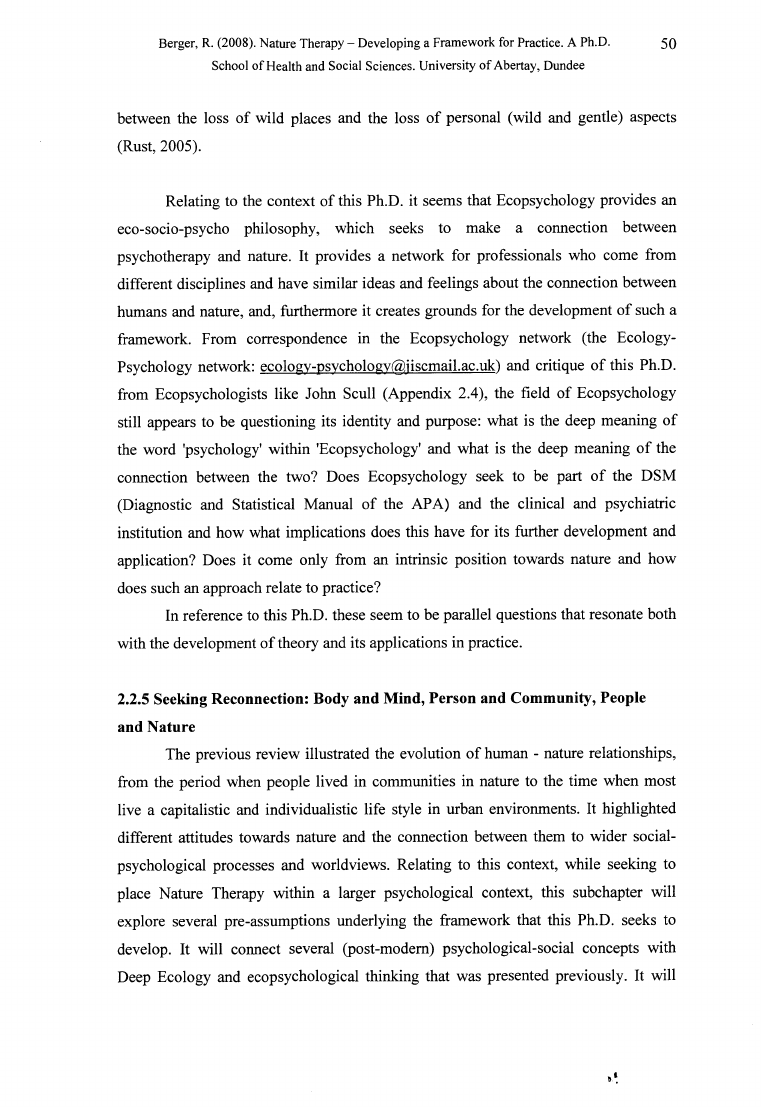
Berger, R. (2008). Nature Therapy - Developing a Framework for Practice. A Ph.D.
50
School of Health and Social Sciences. University of Abertay, Dundee
between the loss of wild places and the loss of personal (wild and gentle) aspects
(Rust, 2005).
Relating to the context of this Ph.D. it seems that Ecopsychology provides an
eco-socio-psycho philosophy, which seeks to make a connection between
psychotherapy and nature. It provides a network for professionals who come from
different disciplines and have similar ideas and feelings about the connection between
humans and nature, and, furthermore it creates grounds for the development of such a
framework. From correspondence in the Ecopsychology network (the Ecology-
Psychology network: ecologv-psvchology@iiscmail.ac.uk) and critique of this Ph.D.
from Ecopsychologists like John Scull (Appendix 2.4), the field of Ecopsychology
still appears to be questioning its identity and purpose: what is the deep meaning of
the word 'psychology' within 'Ecopsychology' and what is the deep meaning of the
connection between the two? Does Ecopsychology seek to be part of the DSM
(Diagnostic and Statistical Manual of the APA) and the clinical and psychiatric
institution and how what implications does this have for its further development and
application? Does it come only from an intrinsic position towards nature and how
does such an approach relate to practice?
In reference to this Ph.D. these seem to be parallel questions that resonate both
with the development of theory and its applications in practice.
2.2.5 Seeking Reconnection: Body and Mind, Person and Community, People
and Nature
The previous review illustrated the evolution of human - nature relationships,
from the period when people lived in communities in nature to the time when most
live a capitalistic and individualistic life style in urban environments. It highlighted
different attitudes towards nature and the connection between them to wider social-
psychological processes and worldviews. Relating to this context, while seeking to
place Nature Therapy within a larger psychological context, this subchapter will
explore several pre-assumptions underlying the framework that this Ph.D. seeks to
develop. It will connect several (post-modem) psychological-social concepts with
Deep Ecology and ecopsychological thinking that was presented previously. It will
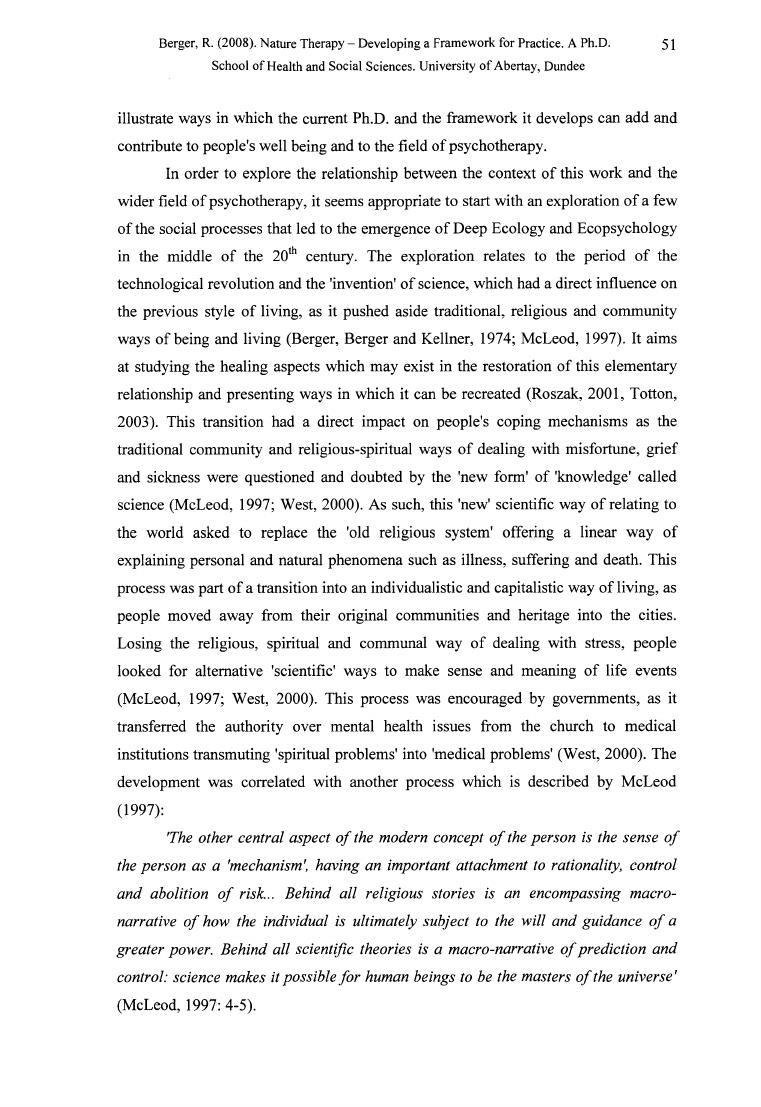
Berger, R. (2008). Nature Therapy - Developing a Framework for Practice. A Ph.D.
51
School of Health and Social Sciences. University of Abertay, Dundee
illustrate ways in which the current Ph.D. and the framework it develops can add and
contribute to people's well being and to the field of psychotherapy.
In order to explore the relationship between the context of this work and the
wider field of psychotherapy, it seems appropriate to start with an exploration of a few
of the social processes that led to the emergence of Deep Ecology and Ecopsychology
in the middle of the 20th century. The exploration relates to the period of the
technological revolution and the 'invention' of science, which had a direct influence on
the previous style of living, as it pushed aside traditional, religious and community
ways of being and living (Berger, Berger and Kellner, 1974; McLeod, 1997). It aims
at studying the healing aspects which may exist in the restoration of this elementary
relationship and presenting ways in which it can be recreated (Roszak, 2001, Totton,
2003). This transition had a direct impact on people's coping mechanisms as the
traditional community and religious-spiritual ways of dealing with misfortune, grief
and sickness were questioned and doubted by the 'new form' of 'knowledge' called
science (McLeod, 1997; West, 2000). As such, this 'new' scientific way of relating to
the world asked to replace the 'old religious system' offering a linear way of
explaining personal and natural phenomena such as illness, suffering and death. This
process was part of a transition into an individualistic and capitalistic way of living, as
people moved away from their original communities and heritage into the cities.
Losing the religious, spiritual and communal way of dealing with stress, people
looked for alternative 'scientific' ways to make sense and meaning of life events
(McLeod, 1997; West, 2000). This process was encouraged by governments, as it
transferred the authority over mental health issues from the church to medical
institutions transmuting 'spiritual problems' into 'medical problems' (West, 2000). The
development was correlated with another process which is described by McLeod
(1997):
'The other central aspect o f the modern concept o f the person is the sense o f
the person as a 'mechanism', having an important attachment to rationality, control
and abolition o f risk... Behind all religious stories is an encompassing macro
narrative o f how the individual is ultimately subject to the will and guidance o f a
greater power. Behind all scientific theories is a macro-narrative o f prediction and
control: science makes it possible for human beings to be the masters o f the universe'
(McLeod, 1997: 4-5).
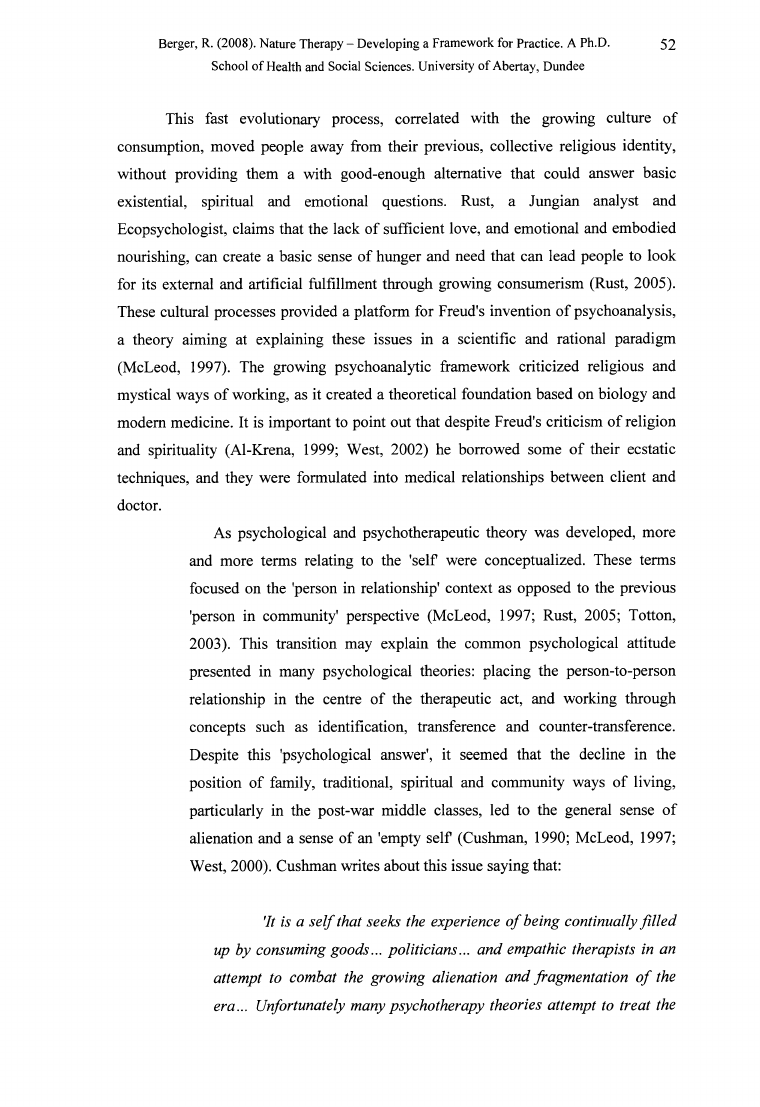
Berger, R. (2008). Nature Therapy - Developing a Framework for Practice. A Ph.D.
52
School of Health and Social Sciences. University of Abertay, Dundee
This fast evolutionary process, correlated with the growing culture of
consumption, moved people away from their previous, collective religious identity,
without providing them a with good-enough alternative that could answer basic
existential, spiritual and emotional questions. Rust, a Jungian analyst and
Ecopsychologist, claims that the lack of sufficient love, and emotional and embodied
nourishing, can create a basic sense of hunger and need that can lead people to look
for its external and artificial fulfillment through growing consumerism (Rust, 2005).
These cultural processes provided a platform for Freud's invention of psychoanalysis,
a theory aiming at explaining these issues in a scientific and rational paradigm
(McLeod, 1997). The growing psychoanalytic framework criticized religious and
mystical ways of working, as it created a theoretical foundation based on biology and
modem medicine. It is important to point out that despite Freud's criticism of religion
and spirituality (Al-Krena, 1999; West, 2002) he borrowed some of their ecstatic
techniques, and they were formulated into medical relationships between client and
doctor.
As psychological and psychotherapeutic theory was developed, more
and more terms relating to the 'self were conceptualized. These terms
focused on the 'person in relationship' context as opposed to the previous
'person in community' perspective (McLeod, 1997; Rust, 2005; Totton,
2003). This transition may explain the common psychological attitude
presented in many psychological theories: placing the person-to-person
relationship in the centre of the therapeutic act, and working through
concepts such as identification, transference and counter-transference.
Despite this 'psychological answer', it seemed that the decline in the
position of family, traditional, spiritual and community ways of living,
particularly in the post-war middle classes, led to the general sense of
alienation and a sense of an 'empty self (Cushman, 1990; McLeod, 1997;
West, 2000). Cushman writes about this issue saying that:
'It is a self that seeks the experience o f being continually filled
up by consuming goods... politicians... and empathic therapists in an
attempt to combat the growing alienation and fragmentation o f the
era... Unfortunately many psychotherapy theories attempt to treat the
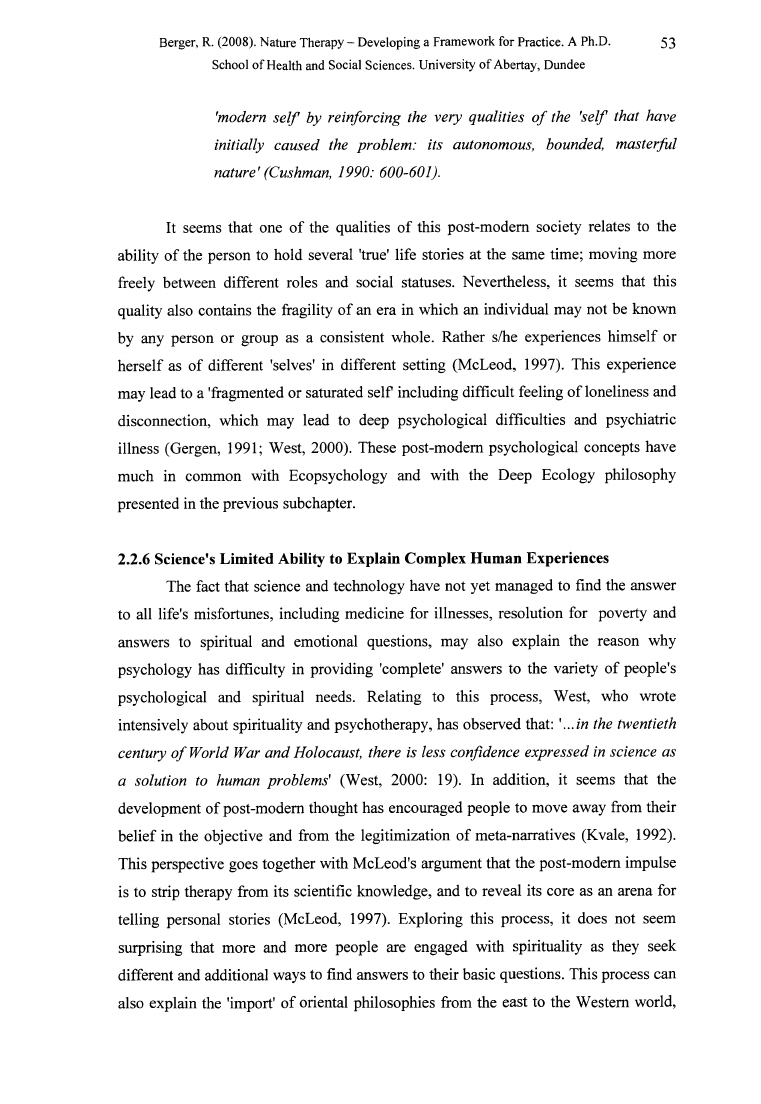
Berger, R. (2008). Nature Therapy - Developing a Framework for Practice. A Ph.D.
53
School of Health and Social Sciences. University of Abertay, Dundee
'modern self by reinforcing the very qualities o f the 'self that have
initially caused the problem: its autonomous, bounded, masterful
nature' (Cushman, 1990: 600-601).
It seems that one of the qualities of this post-modern society relates to the
ability of the person to hold several 'true' life stories at the same time; moving more
freely between different roles and social statuses. Nevertheless, it seems that this
quality also contains the fragility of an era in which an individual may not be known
by any person or group as a consistent whole. Rather s/he experiences himself or
herself as of different 'selves' in different setting (McLeod, 1997). This experience
may lead to a 'fragmented or saturated self including difficult feeling of loneliness and
disconnection, which may lead to deep psychological difficulties and psychiatric
illness (Gergen, 1991; West, 2000). These post-modern psychological concepts have
much in common with Ecopsychology and with the Deep Ecology philosophy
presented in the previous subchapter.
2.2.6 Science’s Limited Ability to Explain Complex Human Experiences
The fact that science and technology have not yet managed to find the answer
to all life's misfortunes, including medicine for illnesses, resolution for poverty and
answers to spiritual and emotional questions, may also explain the reason why
psychology has difficulty in providing 'complete' answers to the variety of people's
psychological and spiritual needs. Relating to this process, West, who wrote
intensively about spirituality and psychotherapy, has observed that: '...in the twentieth
century o f World War and Holocaust, there is less confidence expressed in science as
a solution to human problems' (West, 2000: 19). In addition, it seems that the
development of post-modern thought has encouraged people to move away from their
belief in the objective and from the legitimization of meta-narratives (Kvale, 1992).
This perspective goes together with McLeod's argument that the post-modern impulse
is to strip therapy from its scientific knowledge, and to reveal its core as an arena for
telling personal stories (McLeod, 1997). Exploring this process, it does not seem
surprising that more and more people are engaged with spirituality as they seek
different and additional ways to find answers to their basic questions. This process can
also explain the 'import' of oriental philosophies from the east to the Western world,
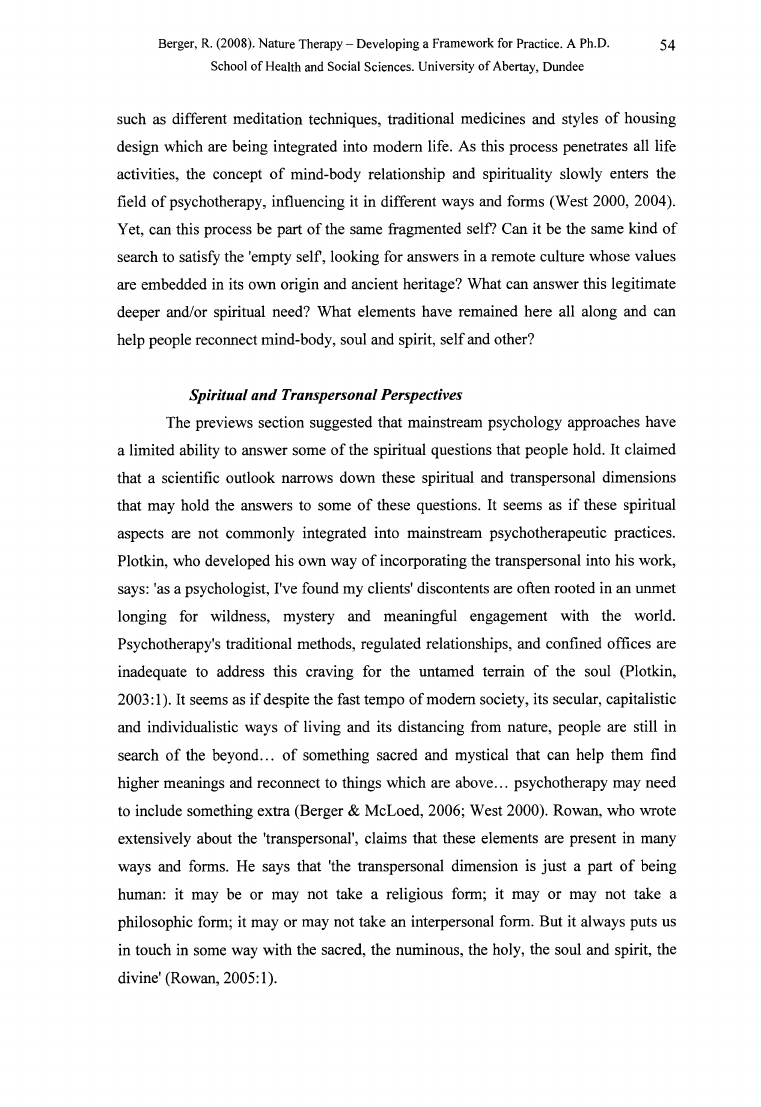
Berger, R. (2008). Nature Therapy - Developing a Framework for Practice. A Ph.D.
54
School of Health and Social Sciences. University of Abertay, Dundee
such as different meditation techniques, traditional medicines and styles of housing
design which are being integrated into modem life. As this process penetrates all life
activities, the concept of mind-body relationship and spirituality slowly enters the
field of psychotherapy, influencing it in different ways and forms (West 2000, 2004).
Yet, can this process be part of the same fragmented self? Can it be the same kind of
search to satisfy the 'empty self, looking for answers in a remote culture whose values
are embedded in its own origin and ancient heritage? What can answer this legitimate
deeper and/or spiritual need? What elements have remained here all along and can
help people reconnect mind-body, soul and spirit, self and other?
Spiritual and Transpersonal Perspectives
The previews section suggested that mainstream psychology approaches have
a limited ability to answer some of the spiritual questions that people hold. It claimed
that a scientific outlook narrows down these spiritual and transpersonal dimensions
that may hold the answers to some of these questions. It seems as if these spiritual
aspects are not commonly integrated into mainstream psychotherapeutic practices.
Plotkin, who developed his own way of incorporating the transpersonal into his work,
says: 'as a psychologist, I've found my clients' discontents are often rooted in an unmet
longing for wildness, mystery and meaningful engagement with the world.
Psychotherapy's traditional methods, regulated relationships, and confined offices are
inadequate to address this craving for the untamed terrain of the soul (Plotkin,
2003:1). It seems as if despite the fast tempo of modem society, its secular, capitalistic
and individualistic ways of living and its distancing from nature, people are still in
search of the beyond... of something sacred and mystical that can help them find
higher meanings and reconnect to things which are above... psychotherapy may need
to include something extra (Berger & McLoed, 2006; West 2000). Rowan, who wrote
extensively about the 'transpersonal', claims that these elements are present in many
ways and forms. He says that 'the transpersonal dimension is just a part of being
human: it may be or may not take a religious form; it may or may not take a
philosophic form; it may or may not take an interpersonal form. But it always puts us
in touch in some way with the sacred, the numinous, the holy, the soul and spirit, the
divine' (Rowan, 2005:1).
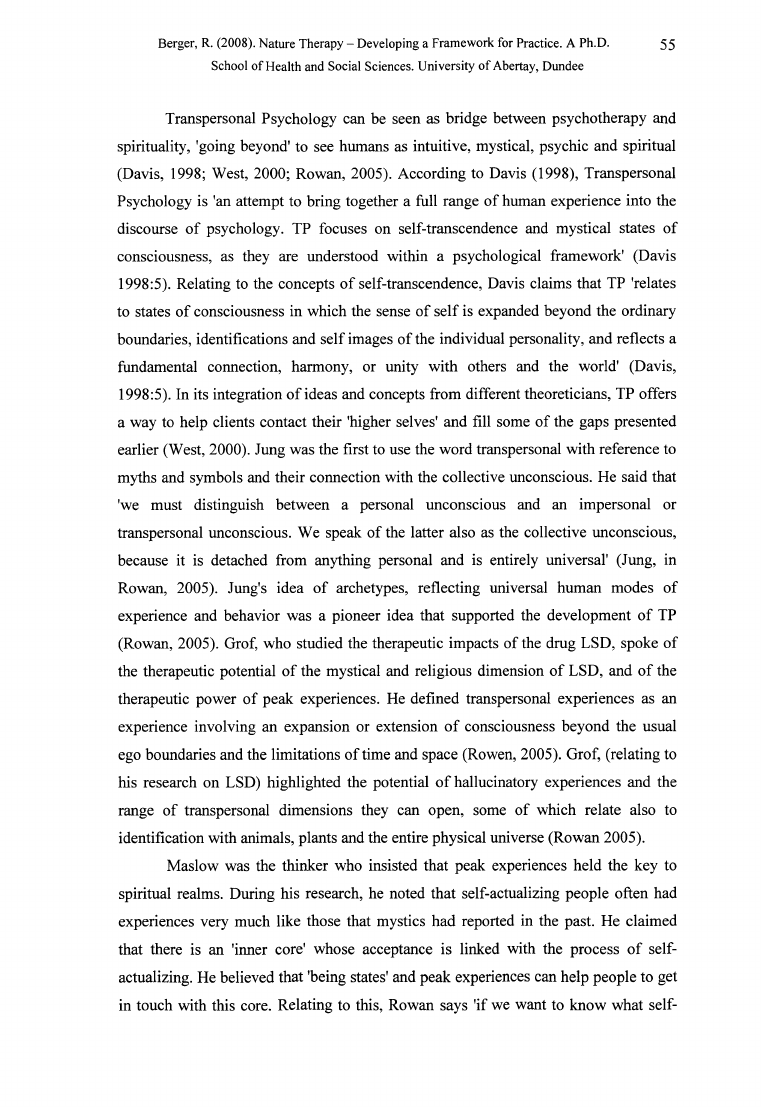
Berger, R. (2008). Nature Therapy - Developing a Framework for Practice. A Ph.D.
55
School of Health and Social Sciences. University of Abertay, Dundee
Transpersonal Psychology can be seen as bridge between psychotherapy and
spirituality, 'going beyond' to see humans as intuitive, mystical, psychic and spiritual
(Davis, 1998; West, 2000; Rowan, 2005). According to Davis (1998), Transpersonal
Psychology is 'an attempt to bring together a full range of human experience into the
discourse of psychology. TP focuses on self-transcendence and mystical states of
consciousness, as they are understood within a psychological framework' (Davis
1998:5). Relating to the concepts of self-transcendence, Davis claims that TP 'relates
to states of consciousness in which the sense of self is expanded beyond the ordinary
boundaries, identifications and self images of the individual personality, and reflects a
fundamental connection, harmony, or unity with others and the world' (Davis,
1998:5). In its integration of ideas and concepts from different theoreticians, TP offers
a way to help clients contact their 'higher selves' and fill some of the gaps presented
earlier (West, 2000). Jung was the first to use the word transpersonal with reference to
myths and symbols and their connection with the collective unconscious. He said that
'we must distinguish between a personal unconscious and an impersonal or
transpersonal unconscious. We speak of the latter also as the collective unconscious,
because it is detached from anything personal and is entirely universal' (Jung, in
Rowan, 2005). Jung's idea of archetypes, reflecting universal human modes of
experience and behavior was a pioneer idea that supported the development of TP
(Rowan, 2005). Grof, who studied the therapeutic impacts of the drug LSD, spoke of
the therapeutic potential of the mystical and religious dimension of LSD, and of the
therapeutic power of peak experiences. He defined transpersonal experiences as an
experience involving an expansion or extension of consciousness beyond the usual
ego boundaries and the limitations of time and space (Rowen, 2005). Grof, (relating to
his research on LSD) highlighted the potential of hallucinatory experiences and the
range of transpersonal dimensions they can open, some of which relate also to
identification with animals, plants and the entire physical universe (Rowan 2005).
Maslow was the thinker who insisted that peak experiences held the key to
spiritual realms. During his research, he noted that self-actualizing people often had
experiences very much like those that mystics had reported in the past. He claimed
that there is an 'inner core' whose acceptance is linked with the process of self-
actualizing. He believed that 'being states' and peak experiences can help people to get
in touch with this core. Relating to this, Rowan says 'if we want to know what self-
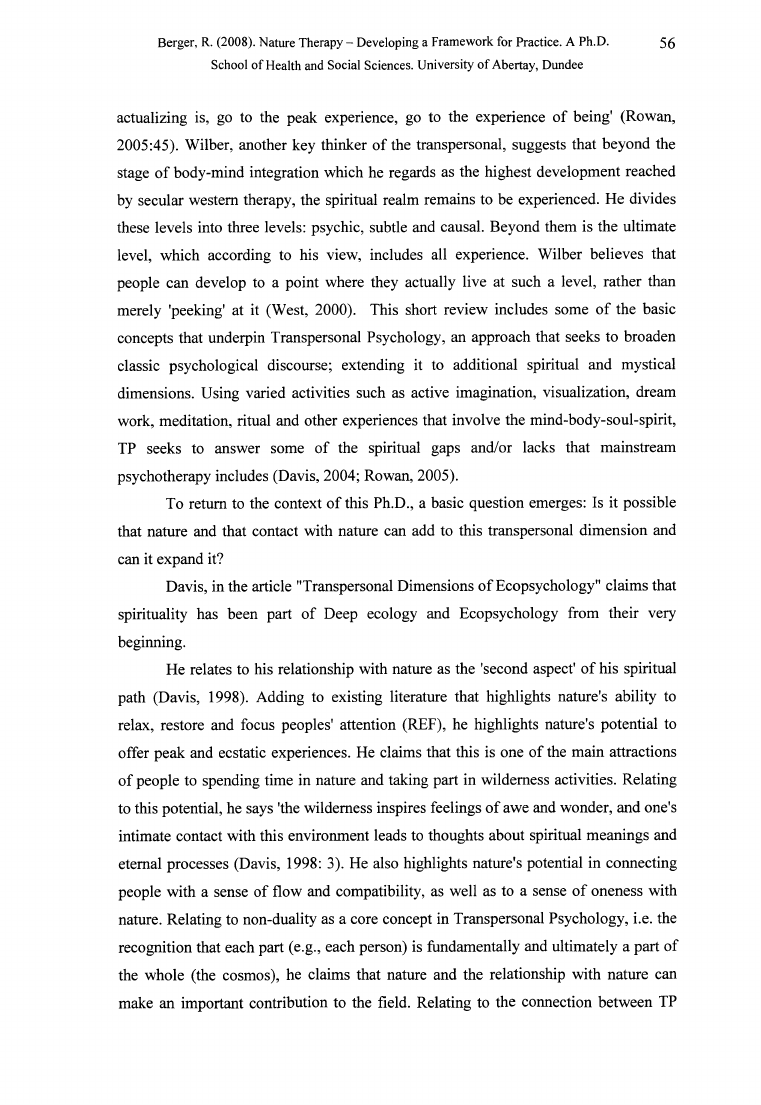
Berger, R. (2008). Nature Therapy - Developing a Framework for Practice. A Ph.D.
56
School of Health and Social Sciences. University of Abertay, Dundee
actualizing is, go to the peak experience, go to the experience of being' (Rowan,
2005:45). Wilber, another key thinker of the transpersonal, suggests that beyond the
stage of body-mind integration which he regards as the highest development reached
by secular western therapy, the spiritual realm remains to be experienced. He divides
these levels into three levels: psychic, subtle and causal. Beyond them is the ultimate
level, which according to his view, includes all experience. Wilber believes that
people can develop to a point where they actually live at such a level, rather than
merely 'peeking' at it (West, 2000). This short review includes some of the basic
concepts that underpin Transpersonal Psychology, an approach that seeks to broaden
classic psychological discourse; extending it to additional spiritual and mystical
dimensions. Using varied activities such as active imagination, visualization, dream
work, meditation, ritual and other experiences that involve the mind-body-soul-spirit,
TP seeks to answer some of the spiritual gaps and/or lacks that mainstream
psychotherapy includes (Davis, 2004; Rowan, 2005).
To return to the context of this Ph.D., a basic question emerges: Is it possible
that nature and that contact with nature can add to this transpersonal dimension and
can it expand it?
Davis, in the article "Transpersonal Dimensions of Ecopsychology" claims that
spirituality has been part of Deep ecology and Ecopsychology from their very
beginning.
He relates to his relationship with nature as the 'second aspect' of his spiritual
path (Davis, 1998). Adding to existing literature that highlights nature's ability to
relax, restore and focus peoples' attention (REF), he highlights nature's potential to
offer peak and ecstatic experiences. He claims that this is one of the main attractions
of people to spending time in nature and taking part in wilderness activities. Relating
to this potential, he says 'the wilderness inspires feelings of awe and wonder, and one's
intimate contact with this environment leads to thoughts about spiritual meanings and
eternal processes (Davis, 1998: 3). He also highlights nature's potential in connecting
people with a sense of flow and compatibility, as well as to a sense of oneness with
nature. Relating to non-duality as a core concept in Transpersonal Psychology, i.e. the
recognition that each part (e.g., each person) is fundamentally and ultimately a part of
the whole (the cosmos), he claims that nature and the relationship with nature can
make an important contribution to the field. Relating to the connection between TP
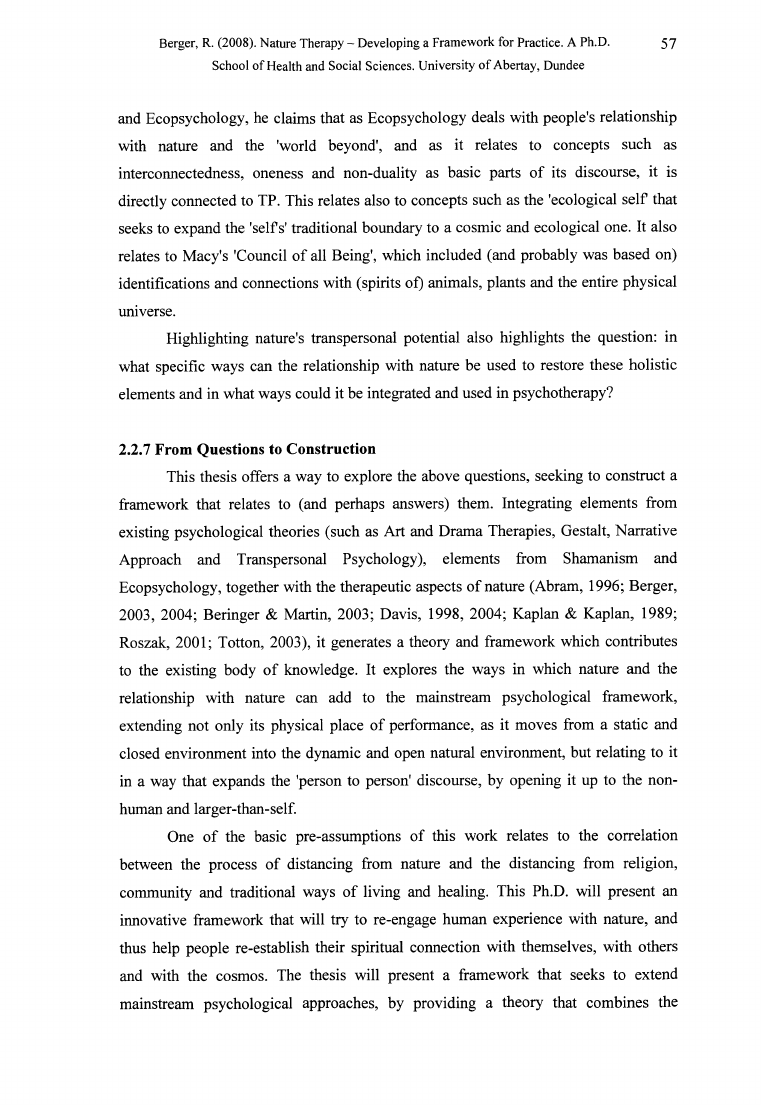
Berger, R. (2008). Nature Therapy - Developing a Framework for Practice. A Ph.D.
57
School of Health and Social Sciences. University of Abertay, Dundee
and Ecopsychology, he claims that as Ecopsychology deals with people's relationship
with nature and the 'world beyond', and as it relates to concepts such as
interconnectedness, oneness and non-duality as basic parts of its discourse, it is
directly connected to TP. This relates also to concepts such as the 'ecological self that
seeks to expand the 'seifs' traditional boundary to a cosmic and ecological one. It also
relates to Macy's 'Council of all Being', which included (and probably was based on)
identifications and connections with (spirits of) animals, plants and the entire physical
universe.
Highlighting nature's transpersonal potential also highlights the question: in
what specific ways can the relationship with nature be used to restore these holistic
elements and in what ways could it be integrated and used in psychotherapy?
2.2.7 From Questions to Construction
This thesis offers a way to explore the above questions, seeking to construct a
framework that relates to (and perhaps answers) them. Integrating elements from
existing psychological theories (such as Art and Drama Therapies, Gestalt, Narrative
Approach and Transpersonal Psychology), elements from Shamanism and
Ecopsychology, together with the therapeutic aspects of nature (Abram, 1996; Berger,
2003, 2004; Beringer & Martin, 2003; Davis, 1998, 2004; Kaplan & Kaplan, 1989;
Roszak, 2001; Totton, 2003), it generates a theory and framework which contributes
to the existing body of knowledge. It explores the ways in which nature and the
relationship with nature can add to the mainstream psychological framework,
extending not only its physical place of performance, as it moves from a static and
closed environment into the dynamic and open natural environment, but relating to it
in a way that expands the 'person to person' discourse, by opening it up to the non
human and larger-than-self.
One of the basic pre-assumptions of this work relates to the correlation
between the process of distancing from nature and the distancing from religion,
community and traditional ways of living and healing. This Ph.D. will present an
innovative framework that will try to re-engage human experience with nature, and
thus help people re-establish their spiritual connection with themselves, with others
and with the cosmos. The thesis will present a framework that seeks to extend
mainstream psychological approaches, by providing a theory that combines the
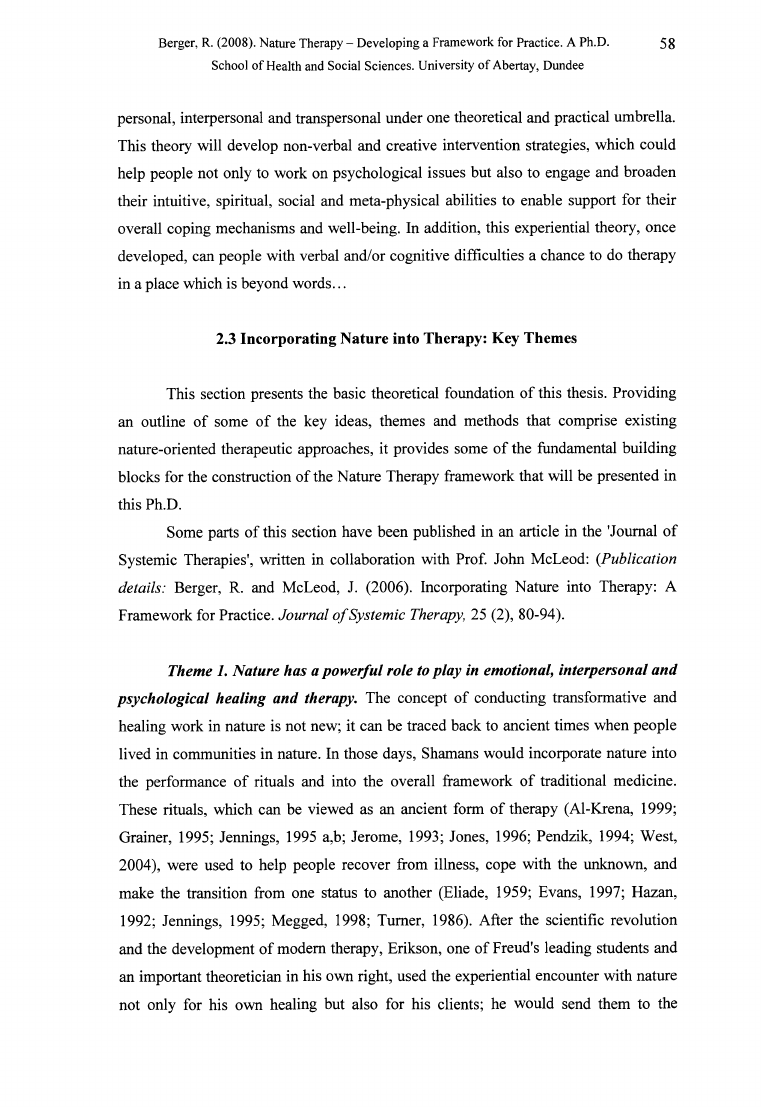
Berger, R. (2008). Nature Therapy - Developing a Framework for Practice. A Ph.D.
58
School of Health and Social Sciences. University of Abertay, Dundee
personal, interpersonal and transpersonal under one theoretical and practical umbrella.
This theory will develop non-verbal and creative intervention strategies, which could
help people not only to work on psychological issues but also to engage and broaden
their intuitive, spiritual, social and meta-physical abilities to enable support for their
overall coping mechanisms and well-being. In addition, this experiential theory, once
developed, can people with verbal and/or cognitive difficulties a chance to do therapy
in a place which is beyond words...
2.3 Incorporating Nature into Therapy: Key Themes
This section presents the basic theoretical foundation of this thesis. Providing
an outline of some of the key ideas, themes and methods that comprise existing
nature-oriented therapeutic approaches, it provides some of the fundamental building
blocks for the construction of the Nature Therapy framework that will be presented in
this Ph.D.
Some parts of this section have been published in an article in the 'Journal of
Systemic Therapies', written in collaboration with Prof. John McLeod: {Publication
details: Berger, R. and McLeod, J. (2006). Incorporating Nature into Therapy: A
Framework for Practice. Journal o f Systemic Therapy, 25 (2), 80-94).
Theme L N ature has a pow erful role to play in emotional, interpersonal and
psychological healing and therapy. The concept of conducting transformative and
healing work in nature is not new; it can be traced back to ancient times when people
lived in communities in nature. In those days, Shamans would incorporate nature into
the performance of rituals and into the overall framework of traditional medicine.
These rituals, which can be viewed as an ancient form of therapy (Al-Krena, 1999;
Grainer, 1995; Jennings, 1995 a,b; Jerome, 1993; Jones, 1996; Pendzik, 1994; West,
2004), were used to help people recover from illness, cope with the unknown, and
make the transition from one status to another (Eliade, 1959; Evans, 1997; Hazan,
1992; Jennings, 1995; Megged, 1998; Turner, 1986). After the scientific revolution
and the development of modem therapy, Erikson, one of Freud's leading students and
an important theoretician in his own right, used the experiential encounter with nature
not only for his own healing but also for his clients; he would send them to the
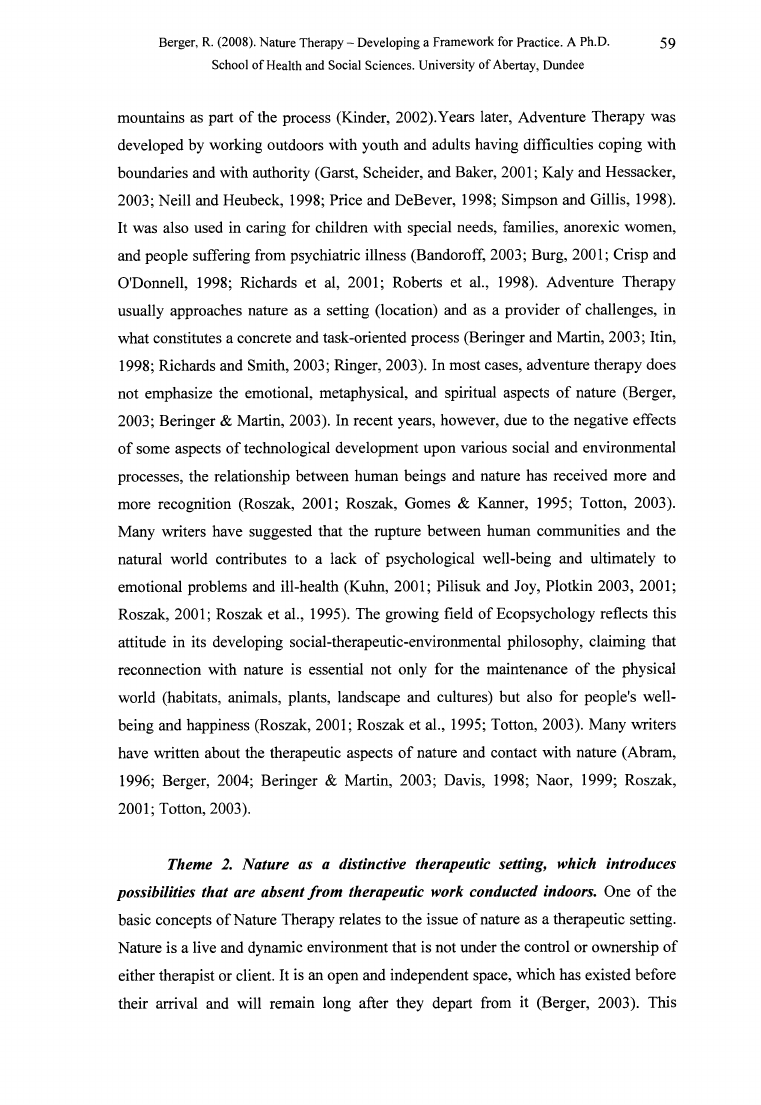
Berger, R. (2008). Nature Therapy - Developing a Framework for Practice. A Ph.D.
59
School of Health and Social Sciences. University of Abertay, Dundee
mountains as part of the process (Kinder, 2002).Years later, Adventure Therapy was
developed by working outdoors with youth and adults having difficulties coping with
boundaries and with authority (Garst, Scheider, and Baker, 2001; Kaly and Hessacker,
2003; Neill and Heubeck, 1998; Price and DeBever, 1998; Simpson and Gillis, 1998).
It was also used in caring for children with special needs, families, anorexic women,
and people suffering from psychiatric illness (Bandoroff, 2003; Burg, 2001; Crisp and
O'Donnell, 1998; Richards et al, 2001; Roberts et al., 1998). Adventure Therapy
usually approaches nature as a setting (location) and as a provider of challenges, in
what constitutes a concrete and task-oriented process (Beringer and Martin, 2003; Itin,
1998; Richards and Smith, 2003; Ringer, 2003). In most cases, adventure therapy does
not emphasize the emotional, metaphysical, and spiritual aspects of nature (Berger,
2003; Beringer & Martin, 2003). In recent years, however, due to the negative effects
of some aspects of technological development upon various social and environmental
processes, the relationship between human beings and nature has received more and
more recognition (Roszak, 2001; Roszak, Gomes & Kanner, 1995; Totton, 2003).
Many writers have suggested that the rupture between human communities and the
natural world contributes to a lack of psychological well-being and ultimately to
emotional problems and ill-health (Kuhn, 2001; Pilisuk and Joy, Plotkin 2003, 2001;
Roszak, 2001; Roszak et al., 1995). The growing field of Ecopsychology reflects this
attitude in its developing social-therapeutic-environmental philosophy, claiming that
reconnection with nature is essential not only for the maintenance of the physical
world (habitats, animals, plants, landscape and cultures) but also for people's well
being and happiness (Roszak, 2001; Roszak et al., 1995; Totton, 2003). Many writers
have written about the therapeutic aspects of nature and contact with nature (Abram,
1996; Berger, 2004; Beringer & Martin, 2003; Davis, 1998; Naor, 1999; Roszak,
2001; Totton, 2003).
Them e 2. N ature as a distinctive therapeutic setting, which introduces
possibilities that are absent fro m therapeutic work conducted indoors. One of the
basic concepts of Nature Therapy relates to the issue of nature as a therapeutic setting.
Nature is a live and dynamic environment that is not under the control or ownership of
either therapist or client. It is an open and independent space, which has existed before
their arrival and will remain long after they depart from it (Berger, 2003). This
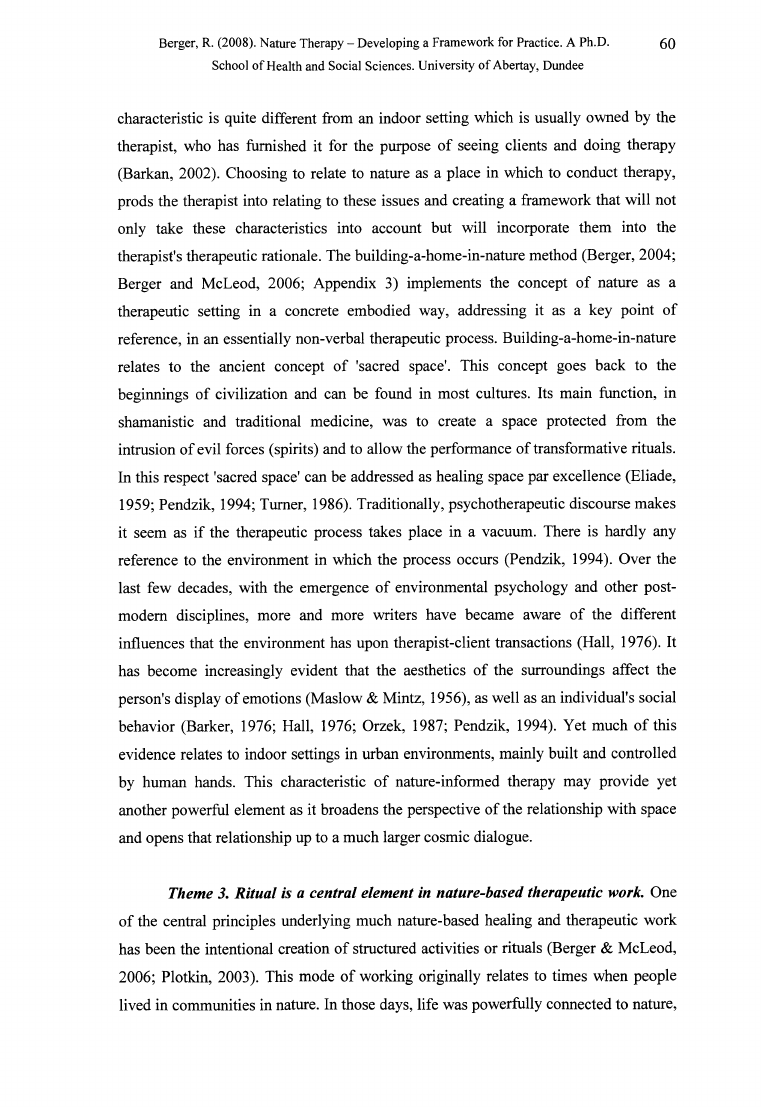
Berger, R. (2008). Nature Therapy - Developing a Framework for Practice. A Ph.D.
60
School of Health and Social Sciences. University of Abertay, Dundee
characteristic is quite different from an indoor setting which is usually owned by the
therapist, who has furnished it for the purpose of seeing clients and doing therapy
(Barkan, 2002). Choosing to relate to nature as a place in which to conduct therapy,
prods the therapist into relating to these issues and creating a framework that will not
only take these characteristics into account but will incorporate them into the
therapist's therapeutic rationale. The building-a-home-in-nature method (Berger, 2004;
Berger and McLeod, 2006; Appendix 3) implements the concept of nature as a
therapeutic setting in a concrete embodied way, addressing it as a key point of
reference, in an essentially non-verbal therapeutic process. Building-a-home-in-nature
relates to the ancient concept of 'sacred space'. This concept goes back to the
beginnings of civilization and can be found in most cultures. Its main function, in
shamanistic and traditional medicine, was to create a space protected from the
intrusion of evil forces (spirits) and to allow the performance of transformative rituals.
In this respect 'sacred space' can be addressed as healing space par excellence (Eliade,
1959; Pendzik, 1994; Turner, 1986). Traditionally, psychotherapeutic discourse makes
it seem as if the therapeutic process takes place in a vacuum. There is hardly any
reference to the environment in which the process occurs (Pendzik, 1994). Over the
last few decades, with the emergence of environmental psychology and other post
modern disciplines, more and more writers have became aware of the different
influences that the environment has upon therapist-client transactions (Hall, 1976). It
has become increasingly evident that the aesthetics of the surroundings affect the
person's display of emotions (Maslow & Mintz, 1956), as well as an individual's social
behavior (Barker, 1976; Hall, 1976; Orzek, 1987; Pendzik, 1994). Yet much of this
evidence relates to indoor settings in urban environments, mainly built and controlled
by human hands. This characteristic of nature-informed therapy may provide yet
another powerful element as it broadens the perspective of the relationship with space
and opens that relationship up to a much larger cosmic dialogue.
Theme 3. Ritual is a central element in nature-based therapeutic work. One
of the central principles underlying much nature-based healing and therapeutic work
has been the intentional creation of structured activities or rituals (Berger & McLeod,
2006; Plotkin, 2003). This mode of working originally relates to times when people
lived in communities in nature. In those days, life was powerfully connected to nature,
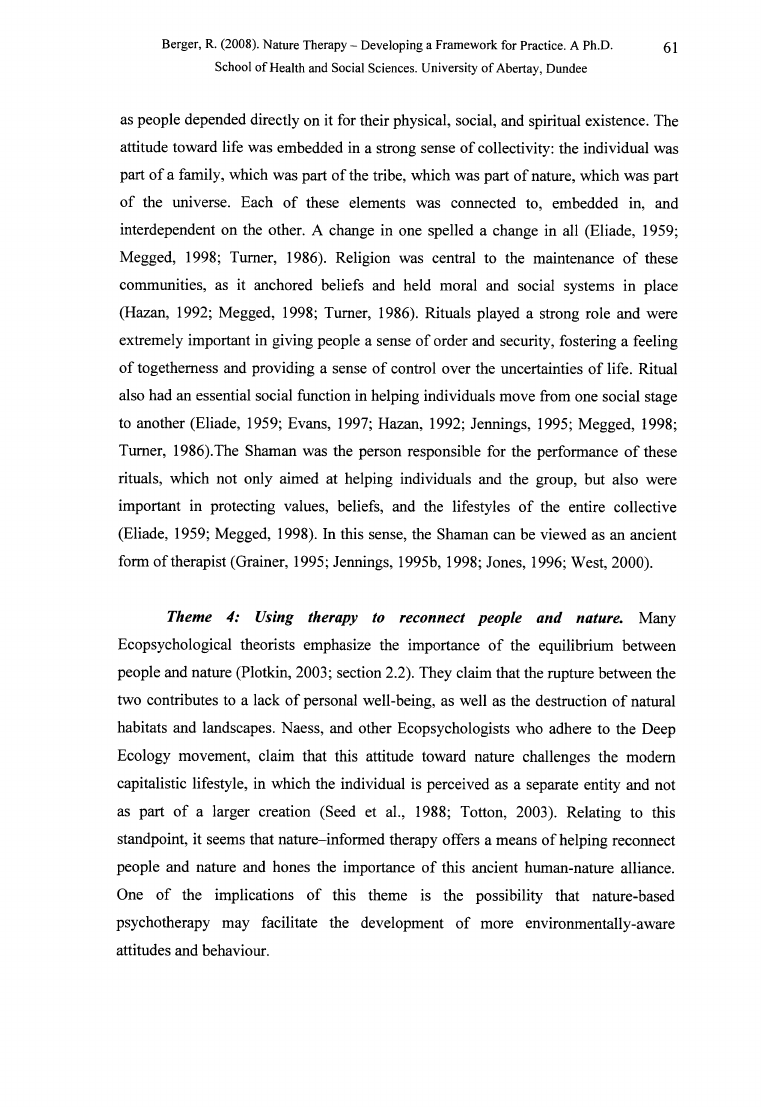
Berger, R. (2008). Nature Therapy - Developing a Framework for Practice. A Ph.D.
61
School of Health and Social Sciences. University of Abertay, Dundee
as people depended directly on it for their physical, social, and spiritual existence. The
attitude toward life was embedded in a strong sense of collectivity: the individual was
part of a family, which was part of the tribe, which was part of nature, which was part
of the universe. Each of these elements was connected to, embedded in, and
interdependent on the other. A change in one spelled a change in all (Eliade, 1959;
Megged, 1998; Turner, 1986). Religion was central to the maintenance of these
communities, as it anchored beliefs and held moral and social systems in place
(Hazan, 1992; Megged, 1998; Turner, 1986). Rituals played a strong role and were
extremely important in giving people a sense of order and security, fostering a feeling
of togetherness and providing a sense of control over the uncertainties of life. Ritual
also had an essential social function in helping individuals move from one social stage
to another (Eliade, 1959; Evans, 1997; Hazan, 1992; Jennings, 1995; Megged, 1998;
Turner, 1986).The Shaman was the person responsible for the performance of these
rituals, which not only aimed at helping individuals and the group, but also were
important in protecting values, beliefs, and the lifestyles of the entire collective
(Eliade, 1959; Megged, 1998). In this sense, the Shaman can be viewed as an ancient
form of therapist (Grainer, 1995; Jennings, 1995b, 1998; Jones, 1996; West, 2000).
Theme 4: Using therapy to reconnect people and nature. Many
Ecopsychological theorists emphasize the importance of the equilibrium between
people and nature (Plotkin, 2003; section 2.2). They claim that the rupture between the
two contributes to a lack of personal well-being, as well as the destruction of natural
habitats and landscapes. Naess, and other Ecopsychologists who adhere to the Deep
Ecology movement, claim that this attitude toward nature challenges the modem
capitalistic lifestyle, in which the individual is perceived as a separate entity and not
as part of a larger creation (Seed et al., 1988; Totton, 2003). Relating to this
standpoint, it seems that nature-informed therapy offers a means of helping reconnect
people and nature and hones the importance of this ancient human-nature alliance.
One of the implications of this theme is the possibility that nature-based
psychotherapy may facilitate the development of more environmentally-aware
attitudes and behaviour.
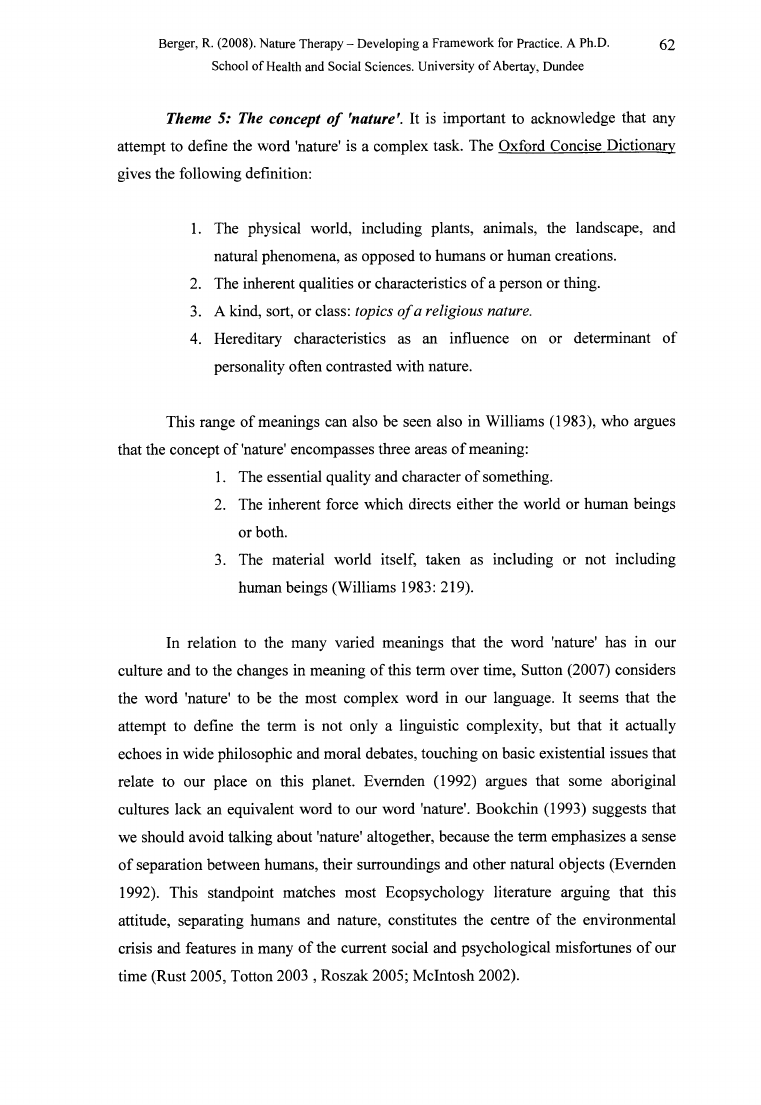
Berger, R. (2008). Nature Therapy - Developing a Framework for Practice. A Ph.D.
62
School of Health and Social Sciences. University of Abertay, Dundee
Them e 5: The concept o f 'nature'. It is important to acknowledge that any
attempt to define the word 'nature' is a complex task. The Oxford Concise Dictionary
gives the following definition:
1. The physical world, including plants, animals, the landscape, and
natural phenomena, as opposed to humans or human creations.
2. The inherent qualities or characteristics of a person or thing.
3. A kind, sort, or class: topics o f a religious nature.
4. Hereditary characteristics as an influence on or determinant of
personality often contrasted with nature.
This range of meanings can also be seen also in Williams (1983), who argues
that the concept of 'nature' encompasses three areas of meaning:
1. The essential quality and character of something.
2. The inherent force which directs either the world or human beings
or both.
3. The material world itself, taken as including or not including
human beings (Williams 1983: 219).
In relation to the many varied meanings that the word 'nature' has in our
culture and to the changes in meaning of this term over time, Sutton (2007) considers
the word 'nature' to be the most complex word in our language. It seems that the
attempt to define the term is not only a linguistic complexity, but that it actually
echoes in wide philosophic and moral debates, touching on basic existential issues that
relate to our place on this planet. Evemden (1992) argues that some aboriginal
cultures lack an equivalent word to our word 'nature'. Bookchin (1993) suggests that
we should avoid talking about 'nature' altogether, because the term emphasizes a sense
of separation between humans, their surroundings and other natural objects (Evemden
1992). This standpoint matches most Ecopsychology literature arguing that this
attitude, separating humans and nature, constitutes the centre of the environmental
crisis and features in many of the current social and psychological misfortunes of our
time (Rust 2005, Totton 2003 , Roszak 2005; McIntosh 2002).
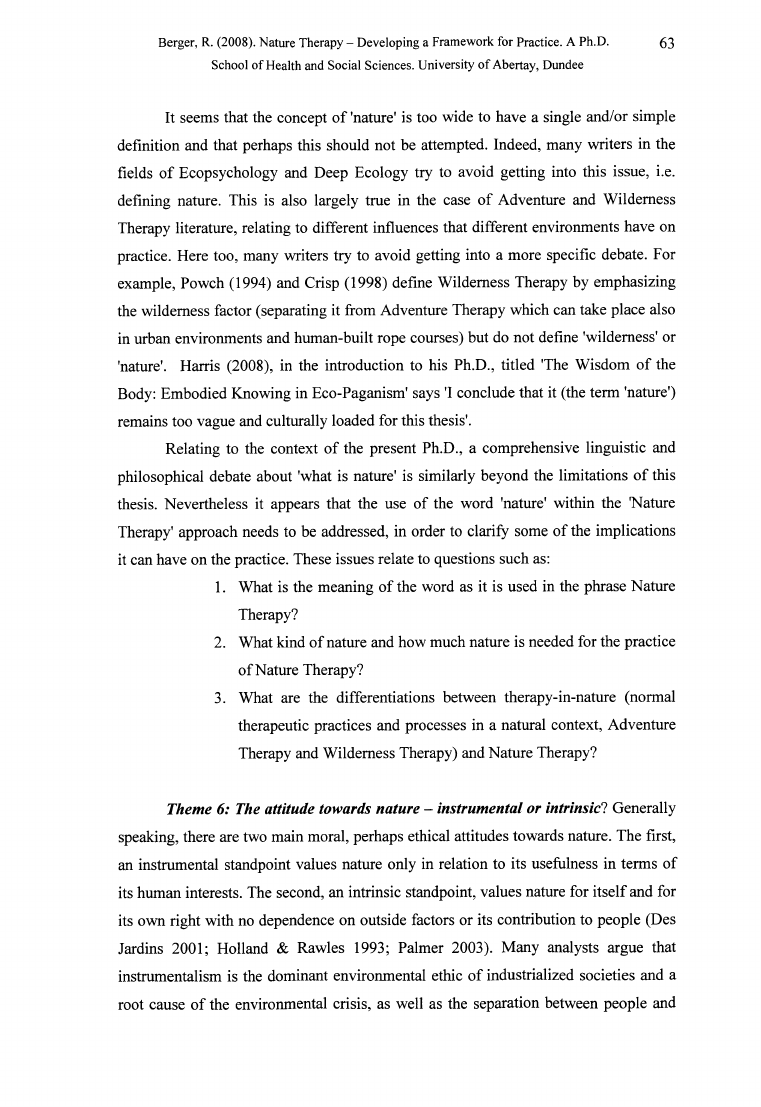
Berger, R. (2008). Nature Therapy - Developing a Framework for Practice. A Ph.D.
63
School of Health and Social Sciences. University of Abertay, Dundee
It seems that the concept of'nature' is too wide to have a single and/or simple
definition and that perhaps this should not be attempted. Indeed, many writers in the
fields of Ecopsychology and Deep Ecology try to avoid getting into this issue, i.e.
defining nature. This is also largely true in the case of Adventure and Wilderness
Therapy literature, relating to different influences that different environments have on
practice. Here too, many writers try to avoid getting into a more specific debate. For
example, Powch (1994) and Crisp (1998) define Wilderness Therapy by emphasizing
the wilderness factor (separating it from Adventure Therapy which can take place also
in urban environments and human-built rope courses) but do not define 'wilderness' or
'nature'. Harris (2008), in the introduction to his Ph.D., titled 'The Wisdom of the
Body: Embodied Knowing in Eco-Paganism' says 'I conclude that it (the term 'nature')
remains too vague and culturally loaded for this thesis'.
Relating to the context of the present Ph.D., a comprehensive linguistic and
philosophical debate about 'what is nature' is similarly beyond the limitations of this
thesis. Nevertheless it appears that the use of the word 'nature' within the Nature
Therapy’ approach needs to be addressed, in order to clarify some of the implications
it can have on the practice. These issues relate to questions such as:
1. What is the meaning of the word as it is used in the phrase Nature
Therapy?
2. What kind of nature and how much nature is needed for the practice
of Nature Therapy?
3. What are the differentiations between therapy-in-nature (normal
therapeutic practices and processes in a natural context, Adventure
Therapy and Wilderness Therapy) and Nature Therapy?
Theme 6: The attitude towards nature - instrumental or intrinsic? Generally
speaking, there are two main moral, perhaps ethical attitudes towards nature. The first,
an instrumental standpoint values nature only in relation to its usefulness in terms of
its human interests. The second, an intrinsic standpoint, values nature for itself and for
its own right with no dependence on outside factors or its contribution to people (Des
Jardins 2001; Holland & Rawles 1993; Palmer 2003). Many analysts argue that
instrumentalism is the dominant environmental ethic of industrialized societies and a
root cause of the environmental crisis, as well as the separation between people and
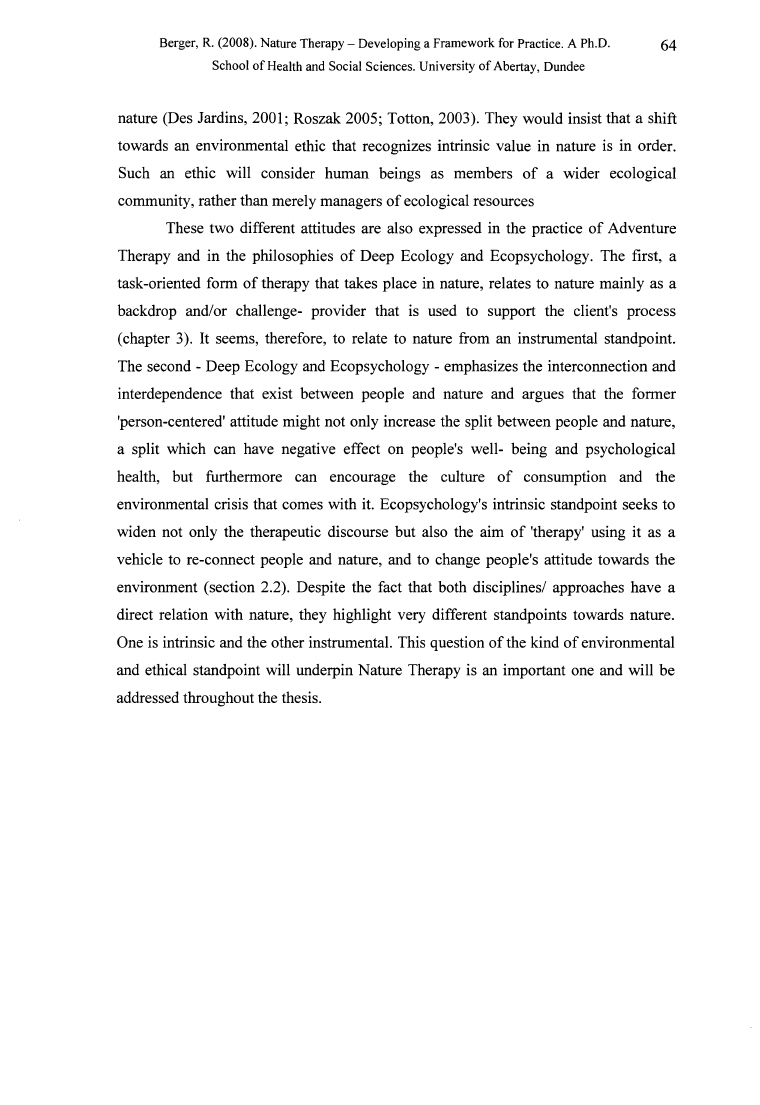
Berger, R. (2008). Nature Therapy - Developing a Framework for Practice. A Ph.D.
64
School of Health and Social Sciences. University of Abertay, Dundee
nature (Des Jardins, 2001; Roszak 2005; Totton, 2003). They would insist that a shift
towards an environmental ethic that recognizes intrinsic value in nature is in order.
Such an ethic will consider human beings as members of a wider ecological
community, rather than merely managers of ecological resources
These two different attitudes are also expressed in the practice of Adventure
Therapy and in the philosophies of Deep Ecology and Ecopsychology. The first, a
task-oriented form of therapy that takes place in nature, relates to nature mainly as a
backdrop and/or challenge- provider that is used to support the client's process
(chapter 3). It seems, therefore, to relate to nature from an instrumental standpoint.
The second - Deep Ecology and Ecopsychology - emphasizes the interconnection and
interdependence that exist between people and nature and argues that the former
'person-centered' attitude might not only increase the split between people and nature,
a split which can have negative effect on people's well- being and psychological
health, but furthermore can encourage the culture of consumption and the
environmental crisis that comes with it. Ecopsychology's intrinsic standpoint seeks to
widen not only the therapeutic discourse but also the aim of 'therapy' using it as a
vehicle to re-connect people and nature, and to change people's attitude towards the
environment (section 2.2). Despite the fact that both disciplines/ approaches have a
direct relation with nature, they highlight very different standpoints towards nature.
One is intrinsic and the other instrumental. This question of the kind of environmental
and ethical standpoint will underpin Nature Therapy is an important one and will be
addressed throughout the thesis.
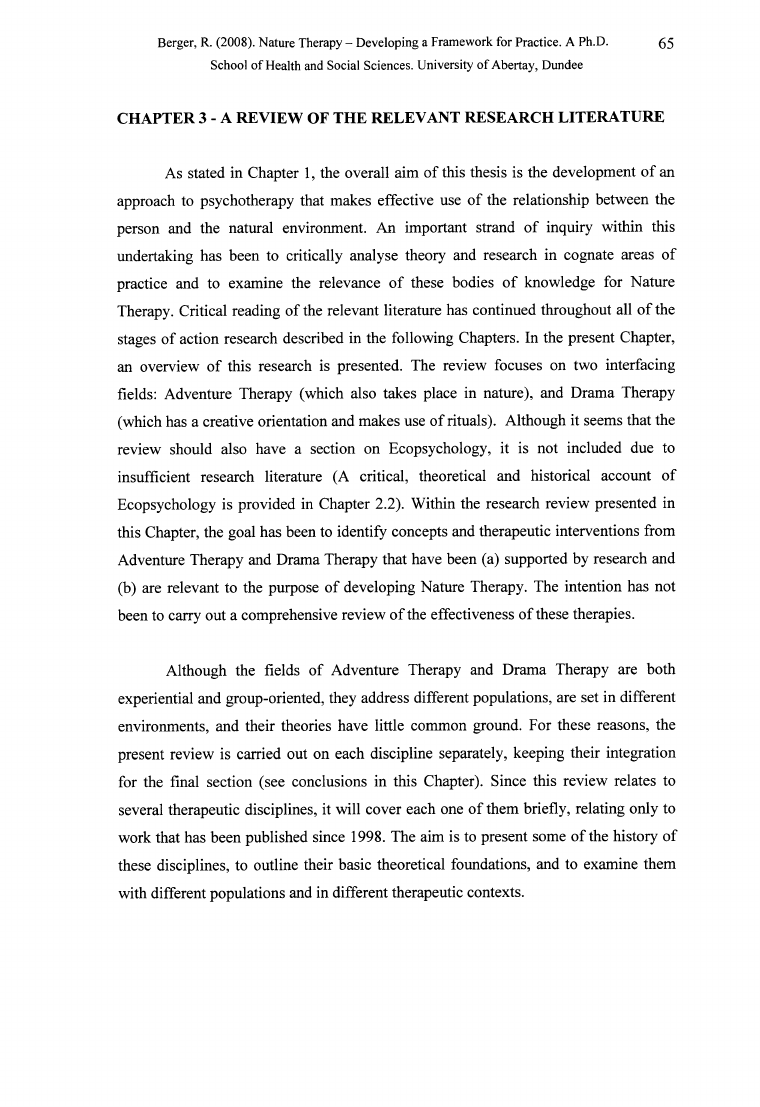
Berger, R. (2008). Nature Therapy - Developing a Framework for Practice. A Ph.D.
65
School of Health and Social Sciences. University of Abertay, Dundee
CHAPTER 3 - A REVIEW OF THE RELEVANT RESEARCH LITERATURE
As stated in Chapter 1, the overall aim of this thesis is the development of an
approach to psychotherapy that makes effective use of the relationship between the
person and the natural environment. An important strand of inquiry within this
undertaking has been to critically analyse theory and research in cognate areas of
practice and to examine the relevance of these bodies of knowledge for Nature
Therapy. Critical reading of the relevant literature has continued throughout all of the
stages of action research described in the following Chapters. In the present Chapter,
an overview of this research is presented. The review focuses on two interfacing
fields: Adventure Therapy (which also takes place in nature), and Drama Therapy
(which has a creative orientation and makes use of rituals). Although it seems that the
review should also have a section on Ecopsychology, it is not included due to
insufficient research literature (A critical, theoretical and historical account of
Ecopsychology is provided in Chapter 2.2). Within the research review presented in
this Chapter, the goal has been to identify concepts and therapeutic interventions from
Adventure Therapy and Drama Therapy that have been (a) supported by research and
(b) are relevant to the purpose of developing Nature Therapy. The intention has not
been to carry out a comprehensive review of the effectiveness of these therapies.
Although the fields of Adventure Therapy and Drama Therapy are both
experiential and group-oriented, they address different populations, are set in different
environments, and their theories have little common ground. For these reasons, the
present review is carried out on each discipline separately, keeping their integration
for the final section (see conclusions in this Chapter). Since this review relates to
several therapeutic disciplines, it will cover each one of them briefly, relating only to
work that has been published since 1998. The aim is to present some of the history of
these disciplines, to outline their basic theoretical foundations, and to examine them
with different populations and in different therapeutic contexts.
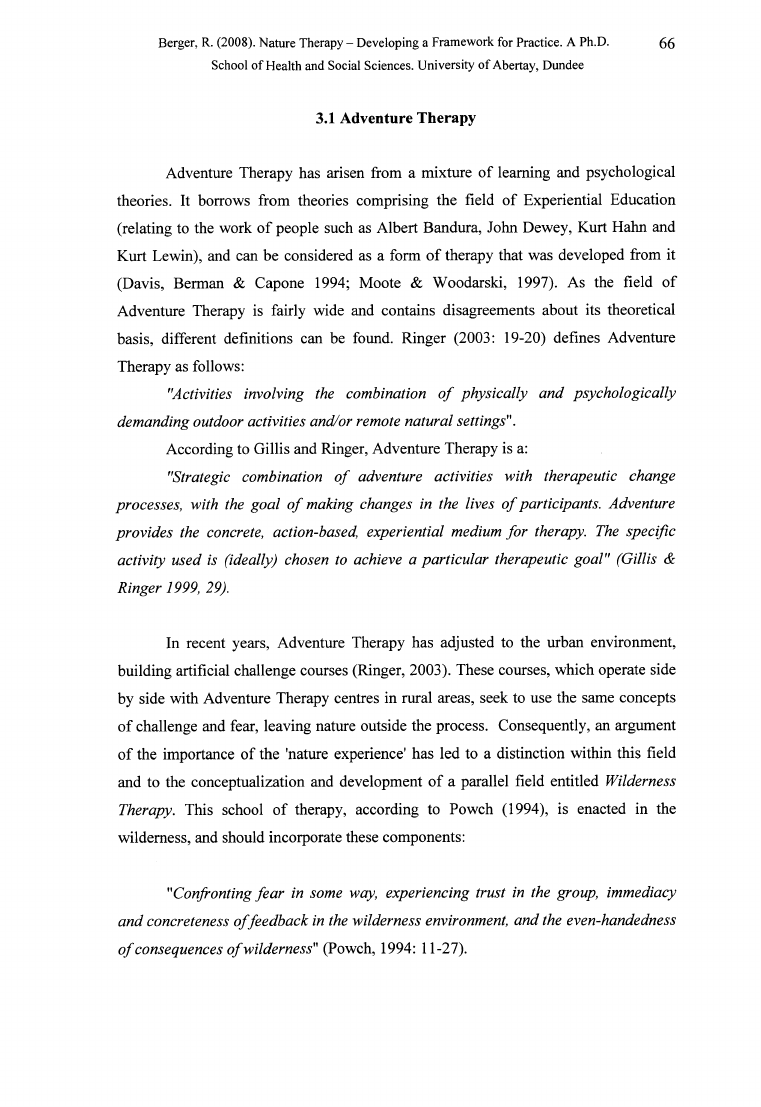
Berger, R. (2008). Nature Therapy - Developing a Framework for Practice. A Ph.D.
66
School of Health and Social Sciences. University of Abertay, Dundee
3.1 Adventure Therapy
Adventure Therapy has arisen from a mixture of learning and psychological
theories. It borrows from theories comprising the field of Experiential Education
(relating to the work of people such as Albert Bandura, John Dewey, Kurt Hahn and
Kurt Lewin), and can be considered as a form of therapy that was developed from it
(Davis, Berman & Capone 1994; Moote & Woodarski, 1997). As the field of
Adventure Therapy is fairly wide and contains disagreements about its theoretical
basis, different definitions can be found. Ringer (2003: 19-20) defines Adventure
Therapy as follows:
"Activities involving the combination o f physically and psychologically
demanding outdoor activities and/or remote natural settings".
According to Gillis and Ringer, Adventure Therapy is a:
"Strategic combination o f adventure activities with therapeutic change
processes, with the goal o f making changes in the lives o f participants. Adventure
provides the concrete, action-based, experiential medium for therapy. The specific
activity used is (ideally) chosen to achieve a particular therapeutic goal" (Gillis &
Ringer 1999, 29).
In recent years, Adventure Therapy has adjusted to the urban environment,
building artificial challenge courses (Ringer, 2003). These courses, which operate side
by side with Adventure Therapy centres in rural areas, seek to use the same concepts
of challenge and fear, leaving nature outside the process. Consequently, an argument
of the importance of the 'nature experience' has led to a distinction within this field
and to the conceptualization and development of a parallel field entitled Wilderness
Therapy. This school of therapy, according to Powch (1994), is enacted in the
wilderness, and should incorporate these components:
"Confronting fear in some way, experiencing trust in the group, immediacy
and concreteness o ffeedback in the wilderness environment, and the even-handedness
o f consequences o f wilderness" (Powch, 1994: 11-27).
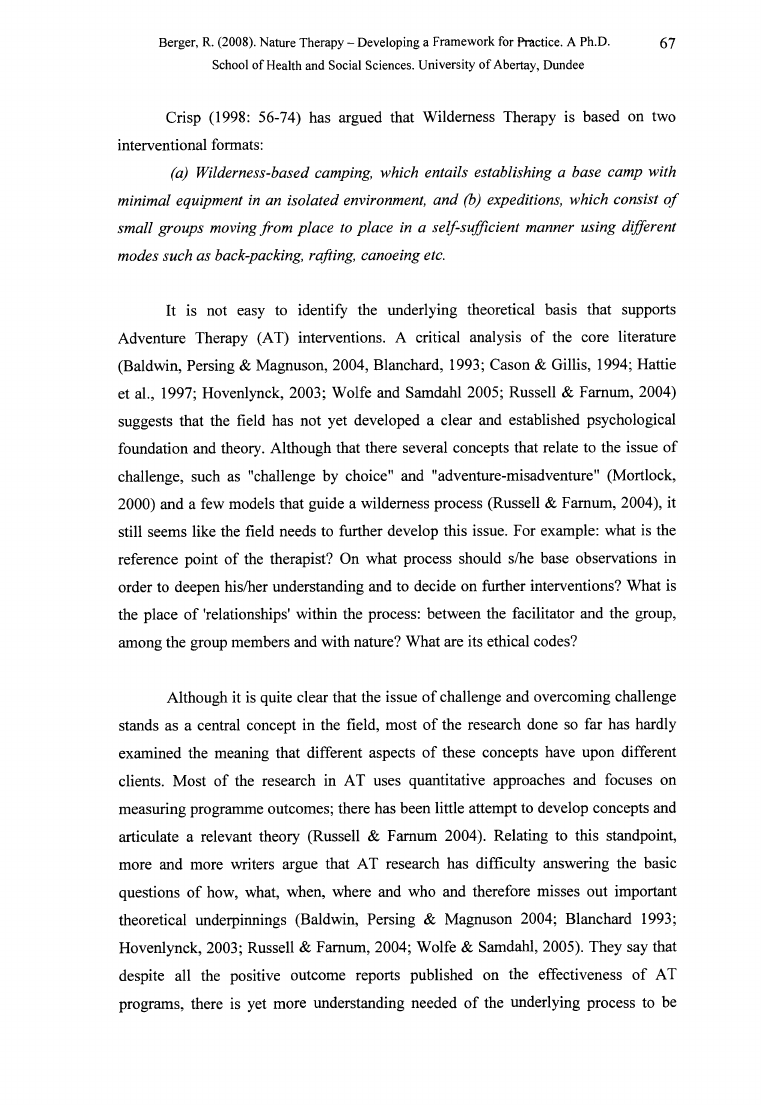
Berger, R. (2008). Nature Therapy - Developing a Framework for Practice. A Ph.D.
67
School of Health and Social Sciences. University of Abertay, Dundee
Crisp (1998: 56-74) has argued that Wilderness Therapy is based on two
interventional formats:
(a) Wilderness-based camping, which entails establishing a base camp with
minimal equipment in an isolated environment, and (b) expeditions, which consist o f
small groups moving from place to place in a self-sufficient manner using different
modes such as back-packing, rafting, canoeing etc.
It is not easy to identify the underlying theoretical basis that supports
Adventure Therapy (AT) interventions. A critical analysis of the core literature
(Baldwin, Persing & Magnuson, 2004, Blanchard, 1993; Cason & Gillis, 1994; Hattie
et ah, 1997; Hovenlynck, 2003; Wolfe and Samdahl 2005; Russell & Famum, 2004)
suggests that the field has not yet developed a clear and established psychological
foundation and theory. Although that there several concepts that relate to the issue of
challenge, such as "challenge by choice" and "adventure-misadventure" (Mortlock,
2000) and a few models that guide a wilderness process (Russell & Famum, 2004), it
still seems like the field needs to further develop this issue. For example: what is the
reference point of the therapist? On what process should s/he base observations in
order to deepen his/her understanding and to decide on further interventions? What is
the place of 'relationships' within the process: between the facilitator and the group,
among the group members and with nature? What are its ethical codes?
Although it is quite clear that the issue of challenge and overcoming challenge
stands as a central concept in the field, most of the research done so far has hardly
examined the meaning that different aspects of these concepts have upon different
clients. Most of the research in AT uses quantitative approaches and focuses on
measuring programme outcomes; there has been little attempt to develop concepts and
articulate a relevant theory (Russell & Famum 2004). Relating to this standpoint,
more and more writers argue that AT research has difficulty answering the basic
questions of how, what, when, where and who and therefore misses out important
theoretical underpinnings (Baldwin, Persing & Magnuson 2004; Blanchard 1993;
Hovenlynck, 2003; Russell & Famum, 2004; Wolfe & Samdahl, 2005). They say that
despite all the positive outcome reports published on the effectiveness of AT
programs, there is yet more understanding needed of the underlying process to be
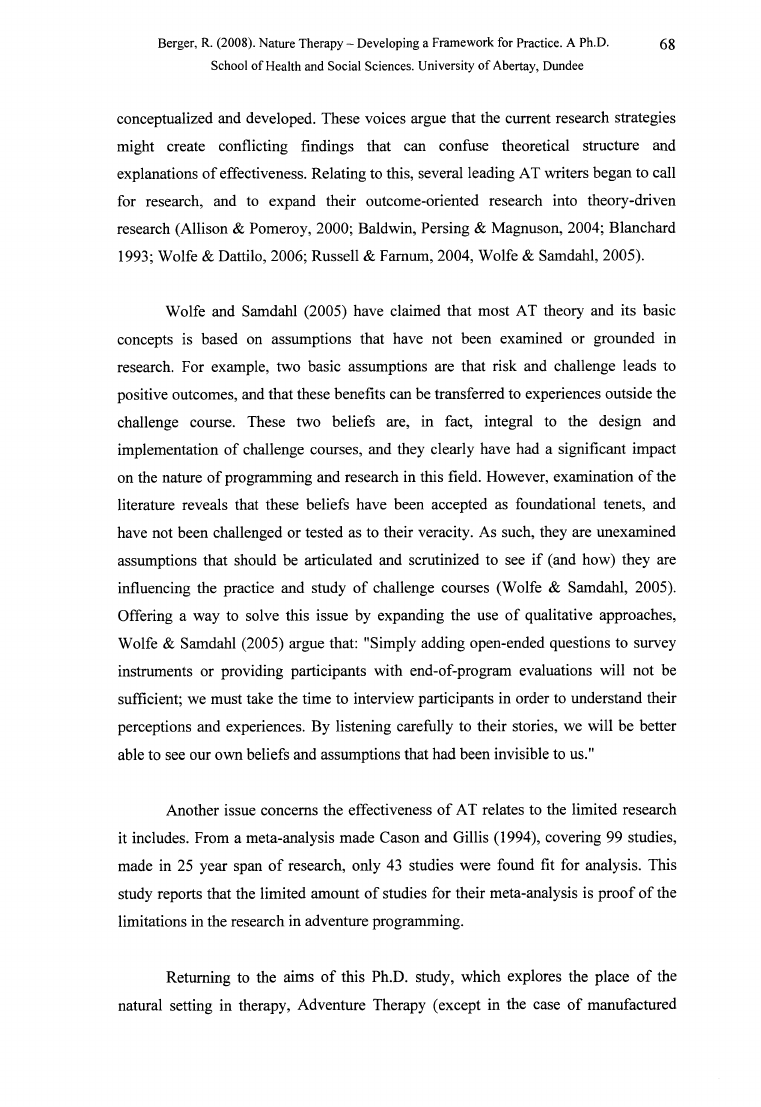
Berger, R. (2008). Nature Therapy - Developing a Framework for Practice. A Ph.D.
68
School of Health and Social Sciences. University of Abertay, Dundee
conceptualized and developed. These voices argue that the current research strategies
might create conflicting findings that can confuse theoretical structure and
explanations of effectiveness. Relating to this, several leading AT writers began to call
for research, and to expand their outcome-oriented research into theory-driven
research (Allison & Pomeroy, 2000; Baldwin, Persing & Magnuson, 2004; Blanchard
1993; Wolfe & Dattilo, 2006; Russell & Famum, 2004, Wolfe & Samdahl, 2005).
Wolfe and Samdahl (2005) have claimed that most AT theory and its basic
concepts is based on assumptions that have not been examined or grounded in
research. For example, two basic assumptions are that risk and challenge leads to
positive outcomes, and that these benefits can be transferred to experiences outside the
challenge course. These two beliefs are, in fact, integral to the design and
implementation of challenge courses, and they clearly have had a significant impact
on the nature of programming and research in this field. However, examination of the
literature reveals that these beliefs have been accepted as foundational tenets, and
have not been challenged or tested as to their veracity. As such, they are unexamined
assumptions that should be articulated and scrutinized to see if (and how) they are
influencing the practice and study of challenge courses (Wolfe & Samdahl, 2005).
Offering a way to solve this issue by expanding the use of qualitative approaches,
Wolfe & Samdahl (2005) argue that: "Simply adding open-ended questions to survey
instruments or providing participants with end-of-program evaluations will not be
sufficient; we must take the time to interview participants in order to understand their
perceptions and experiences. By listening carefully to their stories, we will be better
able to see our own beliefs and assumptions that had been invisible to us."
Another issue concerns the effectiveness of AT relates to the limited research
it includes. From a meta-analysis made Cason and Gillis (1994), covering 99 studies,
made in 25 year span of research, only 43 studies were found fit for analysis. This
study reports that the limited amount of studies for their meta-analysis is proof of the
limitations in the research in adventure programming.
Returning to the aims of this Ph.D. study, which explores the place of the
natural setting in therapy, Adventure Therapy (except in the case of manufactured
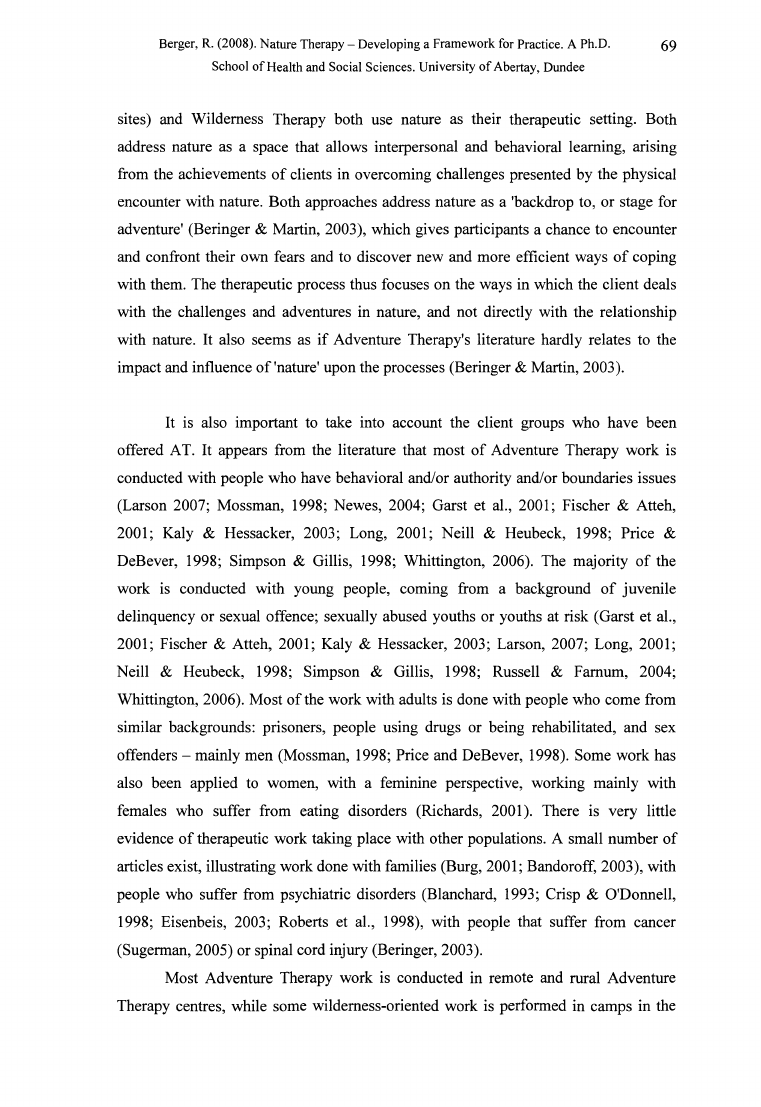
Berger, R. (2008). Nature Therapy - Developing a Framework for Practice. A Ph.D.
69
School of Health and Social Sciences. University of Abertay, Dundee
sites) and Wilderness Therapy both use nature as their therapeutic setting. Both
address nature as a space that allows interpersonal and behavioral learning, arising
from the achievements of clients in overcoming challenges presented by the physical
encounter with nature. Both approaches address nature as a 'backdrop to, or stage for
adventure' (Beringer & Martin, 2003), which gives participants a chance to encounter
and confront their own fears and to discover new and more efficient ways of coping
with them. The therapeutic process thus focuses on the ways in which the client deals
with the challenges and adventures in nature, and not directly with the relationship
with nature. It also seems as if Adventure Therapy's literature hardly relates to the
impact and influence of'nature' upon the processes (Beringer & Martin, 2003).
It is also important to take into account the client groups who have been
offered AT. It appears from the literature that most of Adventure Therapy work is
conducted with people who have behavioral and/or authority and/or boundaries issues
(Larson 2007; Mossman, 1998; Newes, 2004; Garst et al., 2001; Fischer & Atteh,
2001; Kaly & Hessacker, 2003; Long, 2001; Neill & Heubeck, 1998; Price &
DeBever, 1998; Simpson & Gillis, 1998; Whittington, 2006). The majority of the
work is conducted with young people, coming from a background of juvenile
delinquency or sexual offence; sexually abused youths or youths at risk (Garst et al.,
2001; Fischer & Atteh, 2001; Kaly & Hessacker, 2003; Larson, 2007; Long, 2001;
Neill & Heubeck, 1998; Simpson & Gillis, 1998; Russell & Famum, 2004;
Whittington, 2006). Most of the work with adults is done with people who come from
similar backgrounds: prisoners, people using drugs or being rehabilitated, and sex
offenders - mainly men (Mossman, 1998; Price and DeBever, 1998). Some work has
also been applied to women, with a feminine perspective, working mainly with
females who suffer from eating disorders (Richards, 2001). There is very little
evidence of therapeutic work taking place with other populations. A small number of
articles exist, illustrating work done with families (Burg, 2001; Bandoroff, 2003), with
people who suffer from psychiatric disorders (Blanchard, 1993; Crisp & O'Donnell,
1998; Eisenbeis, 2003; Roberts et al., 1998), with people that suffer from cancer
(Sugerman, 2005) or spinal cord injury (Beringer, 2003).
Most Adventure Therapy work is conducted in remote and rural Adventure
Therapy centres, while some wilderness-oriented work is performed in camps in the
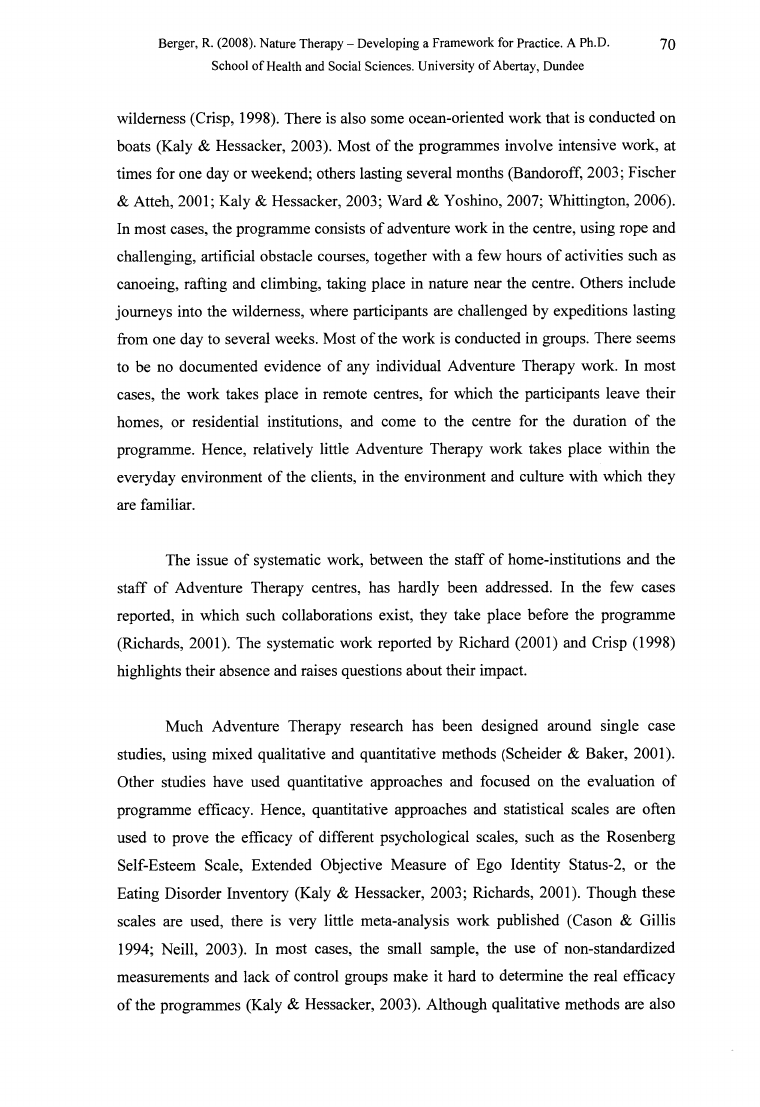
Berger, R. (2008). Nature Therapy - Developing a Framework for Practice. A Ph.D.
70
School of Health and Social Sciences. University of Abertay, Dundee
wilderness (Crisp, 1998). There is also some ocean-oriented work that is conducted on
boats (Kaly & Hessacker, 2003). Most of the programmes involve intensive work, at
times for one day or weekend; others lasting several months (Bandoroff, 2003; Fischer
& Atteh, 2001; Kaly & Hessacker, 2003; Ward & Yoshino, 2007; Whittington, 2006).
In most cases, the programme consists of adventure work in the centre, using rope and
challenging, artificial obstacle courses, together with a few hours of activities such as
canoeing, rafting and climbing, taking place in nature near the centre. Others include
journeys into the wilderness, where participants are challenged by expeditions lasting
from one day to several weeks. Most of the work is conducted in groups. There seems
to be no documented evidence of any individual Adventure Therapy work. In most
cases, the work takes place in remote centres, for which the participants leave their
homes, or residential institutions, and come to the centre for the duration of the
programme. Hence, relatively little Adventure Therapy work takes place within the
everyday environment of the clients, in the environment and culture with which they
are familiar.
The issue of systematic work, between the staff of home-institutions and the
staff of Adventure Therapy centres, has hardly been addressed. In the few cases
reported, in which such collaborations exist, they take place before the programme
(Richards, 2001). The systematic work reported by Richard (2001) and Crisp (1998)
highlights their absence and raises questions about their impact.
Much Adventure Therapy research has been designed around single case
studies, using mixed qualitative and quantitative methods (Scheider & Baker, 2001).
Other studies have used quantitative approaches and focused on the evaluation of
programme efficacy. Hence, quantitative approaches and statistical scales are often
used to prove the efficacy of different psychological scales, such as the Rosenberg
Self-Esteem Scale, Extended Objective Measure of Ego Identity Status-2, or the
Eating Disorder Inventory (Kaly & Hessacker, 2003; Richards, 2001). Though these
scales are used, there is very little meta-analysis work published (Cason & Gillis
1994; Neill, 2003). In most cases, the small sample, the use of non-standardized
measurements and lack of control groups make it hard to determine the real efficacy
of the programmes (Kaly & Hessacker, 2003). Although qualitative methods are also
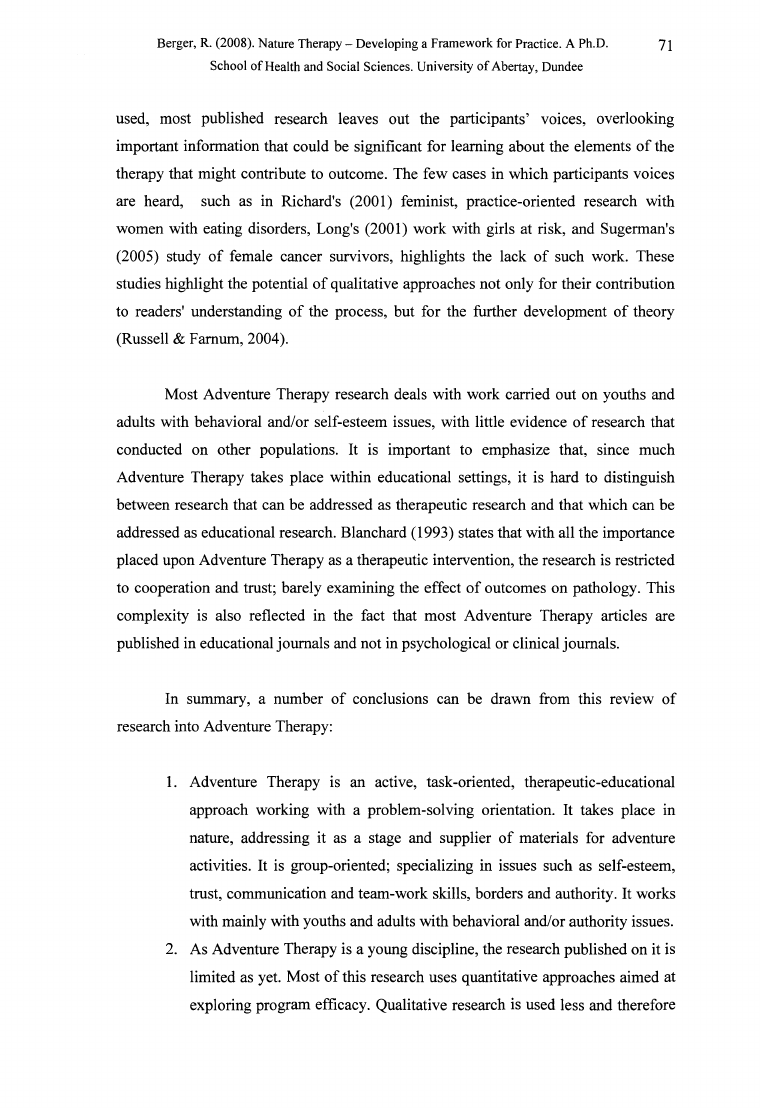
Berger, R. (2008). Nature Therapy - Developing a Framework for Practice. A Ph.D.
71
School of Health and Social Sciences. University of Abertay, Dundee
used, most published research leaves out the participants’ voices, overlooking
important information that could be significant for learning about the elements of the
therapy that might contribute to outcome. The few cases in which participants voices
are heard, such as in Richard's (2001) feminist, practice-oriented research with
women with eating disorders, Long's (2001) work with girls at risk, and Sugerman's
(2005) study of female cancer survivors, highlights the lack of such work. These
studies highlight the potential of qualitative approaches not only for their contribution
to readers' understanding of the process, but for the further development of theory
(Russell & Famum, 2004).
Most Adventure Therapy research deals with work carried out on youths and
adults with behavioral and/or self-esteem issues, with little evidence of research that
conducted on other populations. It is important to emphasize that, since much
Adventure Therapy takes place within educational settings, it is hard to distinguish
between research that can be addressed as therapeutic research and that which can be
addressed as educational research. Blanchard (1993) states that with all the importance
placed upon Adventure Therapy as a therapeutic intervention, the research is restricted
to cooperation and trust; barely examining the effect of outcomes on pathology. This
complexity is also reflected in the fact that most Adventure Therapy articles are
published in educational journals and not in psychological or clinical journals.
In summary, a number of conclusions can be drawn from this review of
research into Adventure Therapy:
1. Adventure Therapy is an active, task-oriented, therapeutic-educational
approach working with a problem-solving orientation. It takes place in
nature, addressing it as a stage and supplier of materials for adventure
activities. It is group-oriented; specializing in issues such as self-esteem,
trust, communication and team-work skills, borders and authority. It works
with mainly with youths and adults with behavioral and/or authority issues.
2. As Adventure Therapy is a young discipline, the research published on it is
limited as yet. Most of this research uses quantitative approaches aimed at
exploring program efficacy. Qualitative research is used less and therefore
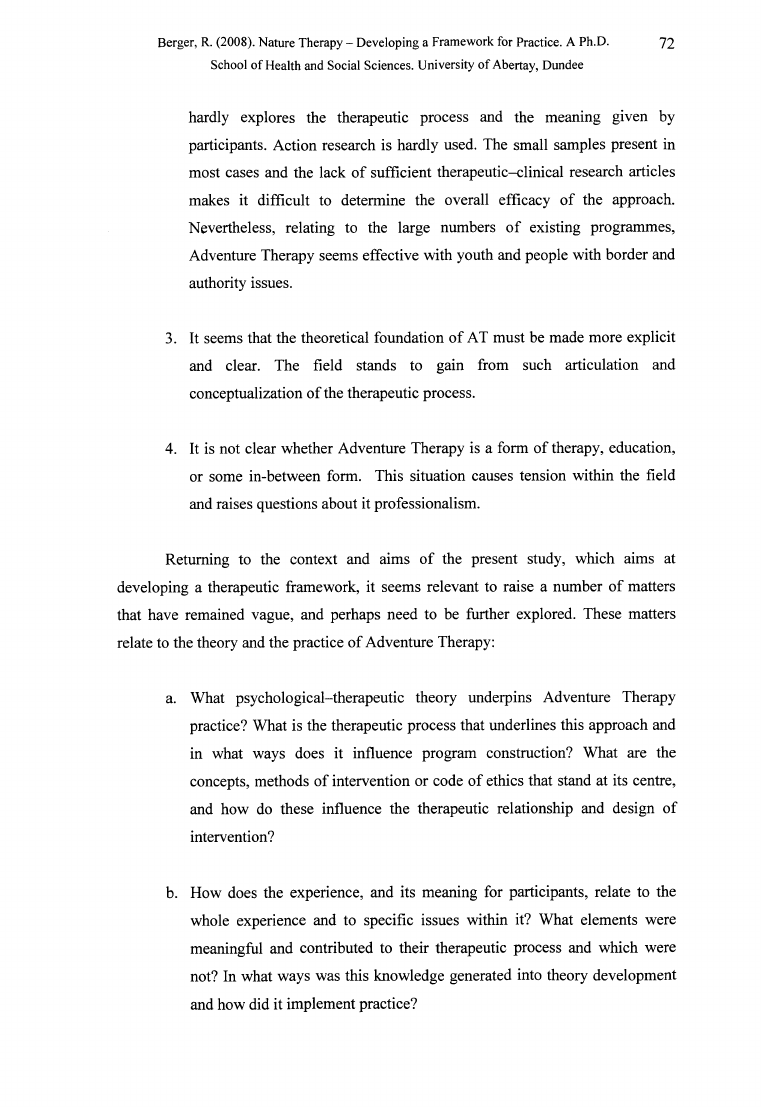
Berger, R. (2008). Nature Therapy - Developing a Framework for Practice. A Ph.D.
72
School of Health and Social Sciences. University of Abertay, Dundee
hardly explores the therapeutic process and the meaning given by
participants. Action research is hardly used. The small samples present in
most cases and the lack of sufficient therapeutic-clinical research articles
makes it difficult to determine the overall efficacy of the approach.
Nevertheless, relating to the large numbers of existing programmes,
Adventure Therapy seems effective with youth and people with border and
authority issues.
3. It seems that the theoretical foundation of AT must be made more explicit
and clear. The field stands to gain from such articulation and
conceptualization of the therapeutic process.
4. It is not clear whether Adventure Therapy is a form of therapy, education,
or some in-between form. This situation causes tension within the field
and raises questions about it professionalism.
Returning to the context and aims of the present study, which aims at
developing a therapeutic framework, it seems relevant to raise a number of matters
that have remained vague, and perhaps need to be further explored. These matters
relate to the theory and the practice of Adventure Therapy:
a. What psychological-therapeutic theory underpins Adventure Therapy
practice? What is the therapeutic process that underlines this approach and
in what ways does it influence program construction? What are the
concepts, methods of intervention or code of ethics that stand at its centre,
and how do these influence the therapeutic relationship and design of
intervention?
b. How does the experience, and its meaning for participants, relate to the
whole experience and to specific issues within it? What elements were
meaningful and contributed to their therapeutic process and which were
not? In what ways was this knowledge generated into theory development
and how did it implement practice?
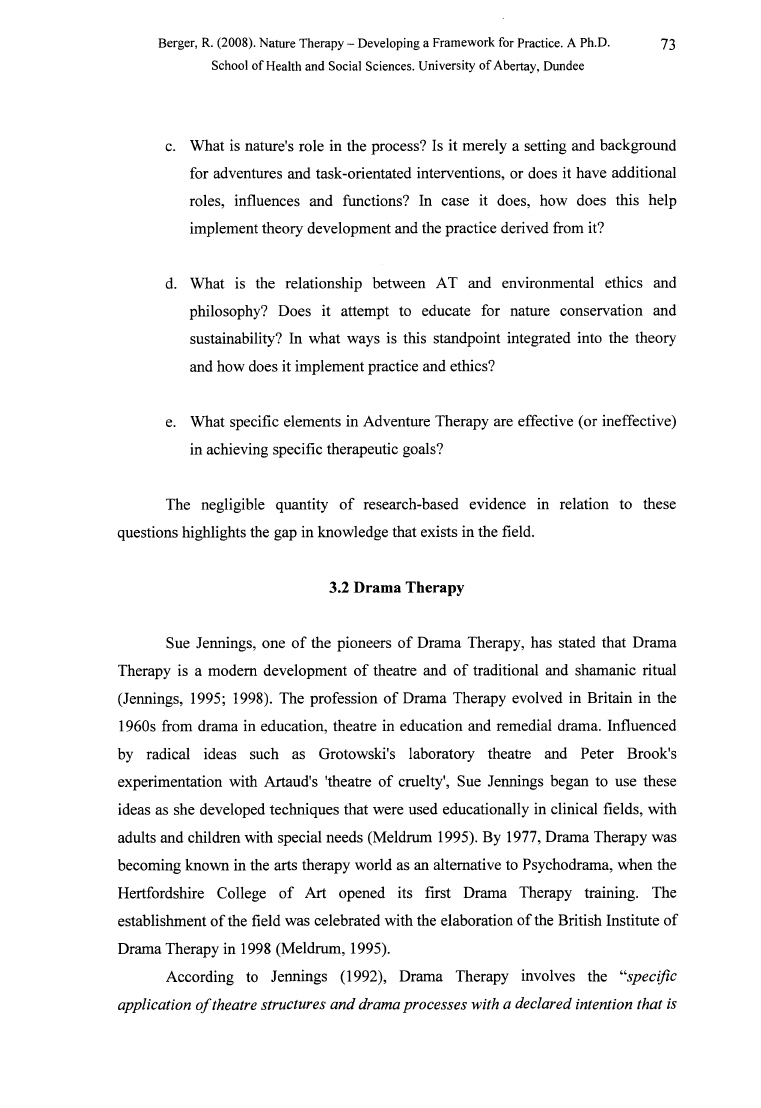
Berger, R. (2008). Nature Therapy - Developing a Framework for Practice. A Ph.D.
73
School of Health and Social Sciences. University of Abertay, Dundee
c. What is nature's role in the process? Is it merely a setting and background
for adventures and task-orientated interventions, or does it have additional
roles, influences and functions? In case it does, how does this help
implement theory development and the practice derived from it?
d. What is the relationship between AT and environmental ethics and
philosophy? Does it attempt to educate for nature conservation and
sustainability? In what ways is this standpoint integrated into the theory
and how does it implement practice and ethics?
e. What specific elements in Adventure Therapy are effective (or ineffective)
in achieving specific therapeutic goals?
The negligible quantity of research-based evidence in relation to these
questions highlights the gap in knowledge that exists in the field.
3.2 Drama Therapy
Sue Jennings, one of the pioneers of Drama Therapy, has stated that Drama
Therapy is a modem development of theatre and of traditional and shamanic ritual
(Jennings, 1995; 1998). The profession of Drama Therapy evolved in Britain in the
1960s from drama in education, theatre in education and remedial drama. Influenced
by radical ideas such as Grotowski's laboratory theatre and Peter Brook's
experimentation with Artaud's 'theatre of cruelty', Sue Jennings began to use these
ideas as she developed techniques that were used educationally in clinical fields, with
adults and children with special needs (Meldrum 1995). By 1977, Drama Therapy was
becoming known in the arts therapy world as an alternative to Psychodrama, when the
Hertfordshire College of Art opened its first Drama Therapy training. The
establishment of the field was celebrated with the elaboration of the British Institute of
Drama Therapy in 1998 (Meldrum, 1995).
According to Jennings (1992), Drama Therapy involves the “specific
application o f theatre structures and drama processes with a declared intention that is
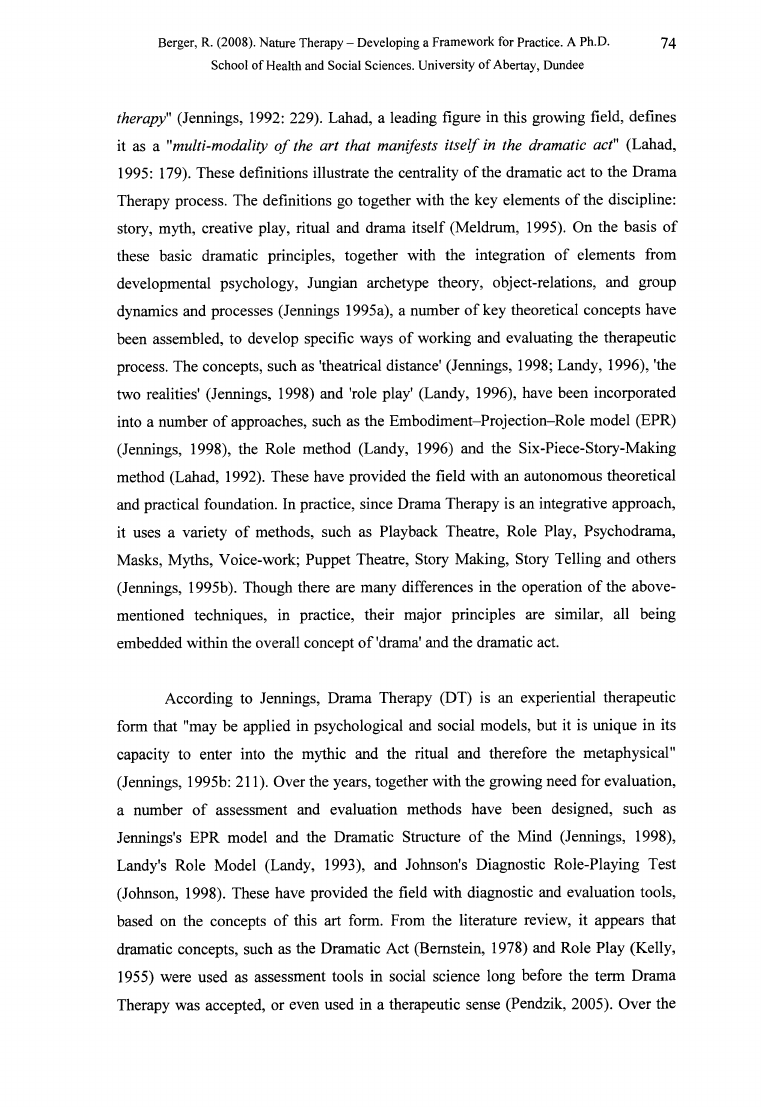
Berger, R. (2008). Nature Therapy - Developing a Framework for Practice. A Ph.D.
74
School of Health and Social Sciences. University of Abertay, Dundee
therapy" (Jennings, 1992: 229). Lahad, a leading figure in this growing field, defines
it as a "multi-modality o f the art that manifests itself in the dramatic act" (Lahad,
1995: 179). These definitions illustrate the centrality of the dramatic act to the Drama
Therapy process. The definitions go together with the key elements of the discipline:
story, myth, creative play, ritual and drama itself (Meldrum, 1995). On the basis of
these basic dramatic principles, together with the integration of elements from
developmental psychology, Jungian archetype theory, object-relations, and group
dynamics and processes (Jennings 1995a), a number of key theoretical concepts have
been assembled, to develop specific ways of working and evaluating the therapeutic
process. The concepts, such as 'theatrical distance' (Jennings, 1998; Landy, 1996), 'the
two realities' (Jennings, 1998) and 'role play' (Landy, 1996), have been incorporated
into a number of approaches, such as the Embodiment-Projection-Role model (EPR)
(Jennings, 1998), the Role method (Landy, 1996) and the Six-Piece-Story-Making
method (Lahad, 1992). These have provided the field with an autonomous theoretical
and practical foundation. In practice, since Drama Therapy is an integrative approach,
it uses a variety of methods, such as Playback Theatre, Role Play, Psychodrama,
Masks, Myths, Voice-work; Puppet Theatre, Story Making, Story Telling and others
(Jennings, 1995b). Though there are many differences in the operation of the above-
mentioned techniques, in practice, their major principles are similar, all being
embedded within the overall concept of 'drama' and the dramatic act.
According to Jennings, Drama Therapy (DT) is an experiential therapeutic
form that "may be applied in psychological and social models, but it is unique in its
capacity to enter into the mythic and the ritual and therefore the metaphysical"
(Jennings, 1995b: 211). Over the years, together with the growing need for evaluation,
a number of assessment and evaluation methods have been designed, such as
Jennings's EPR model and the Dramatic Structure of the Mind (Jennings, 1998),
Landy's Role Model (Landy, 1993), and Johnson's Diagnostic Role-Playing Test
(Johnson, 1998). These have provided the field with diagnostic and evaluation tools,
based on the concepts of this art form. From the literature review, it appears that
dramatic concepts, such as the Dramatic Act (Bernstein, 1978) and Role Play (Kelly,
1955) were used as assessment tools in social science long before the term Drama
Therapy was accepted, or even used in a therapeutic sense (Pendzik, 2005). Over the
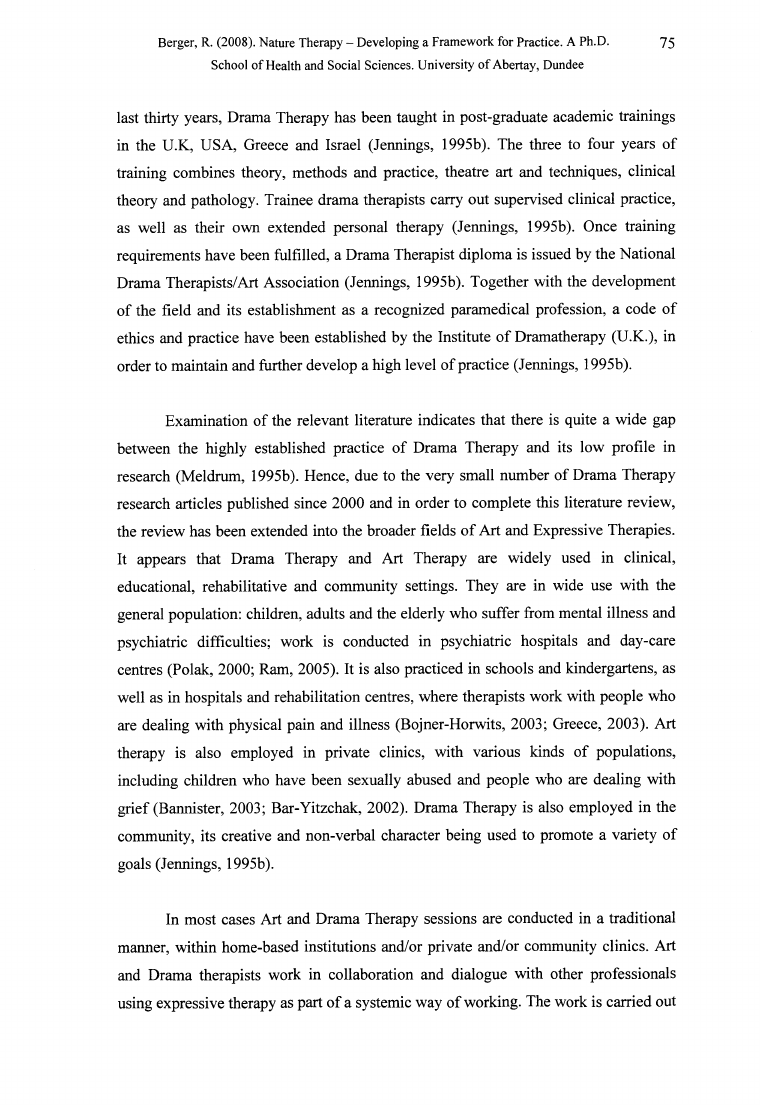
Berger, R. (2008). Nature Therapy - Developing a Framework for Practice. A Ph.D.
75
School of Health and Social Sciences. University of Abertay, Dundee
last thirty years, Drama Therapy has been taught in post-graduate academic trainings
in the U.K, USA, Greece and Israel (Jennings, 1995b). The three to four years of
training combines theory, methods and practice, theatre art and techniques, clinical
theory and pathology. Trainee drama therapists carry out supervised clinical practice,
as well as their own extended personal therapy (Jennings, 1995b). Once training
requirements have been fulfilled, a Drama Therapist diploma is issued by the National
Drama Therapists/Art Association (Jennings, 1995b). Together with the development
of the field and its establishment as a recognized paramedical profession, a code of
ethics and practice have been established by the Institute of Dramatherapy (U.K.), in
order to maintain and further develop a high level of practice (Jennings, 1995b).
Examination of the relevant literature indicates that there is quite a wide gap
between the highly established practice of Drama Therapy and its low profile in
research (Meldrum, 1995b). Hence, due to the very small number of Drama Therapy
research articles published since 2000 and in order to complete this literature review,
the review has been extended into the broader fields of Art and Expressive Therapies.
It appears that Drama Therapy and Art Therapy are widely used in clinical,
educational, rehabilitative and community settings. They are in wide use with the
general population: children, adults and the elderly who suffer from mental illness and
psychiatric difficulties; work is conducted in psychiatric hospitals and day-care
centres (Polak, 2000; Ram, 2005). It is also practiced in schools and kindergartens, as
well as in hospitals and rehabilitation centres, where therapists work with people who
are dealing with physical pain and illness (Bojner-Horwits, 2003; Greece, 2003). Art
therapy is also employed in private clinics, with various kinds of populations,
including children who have been sexually abused and people who are dealing with
grief (Bannister, 2003; Bar-Yitzchak, 2002). Drama Therapy is also employed in the
community, its creative and non-verbal character being used to promote a variety of
goals (Jennings, 1995b).
In most cases Art and Drama Therapy sessions are conducted in a traditional
manner, within home-based institutions and/or private and/or community clinics. Art
and Drama therapists work in collaboration and dialogue with other professionals
using expressive therapy as part of a systemic way of working. The work is carried out
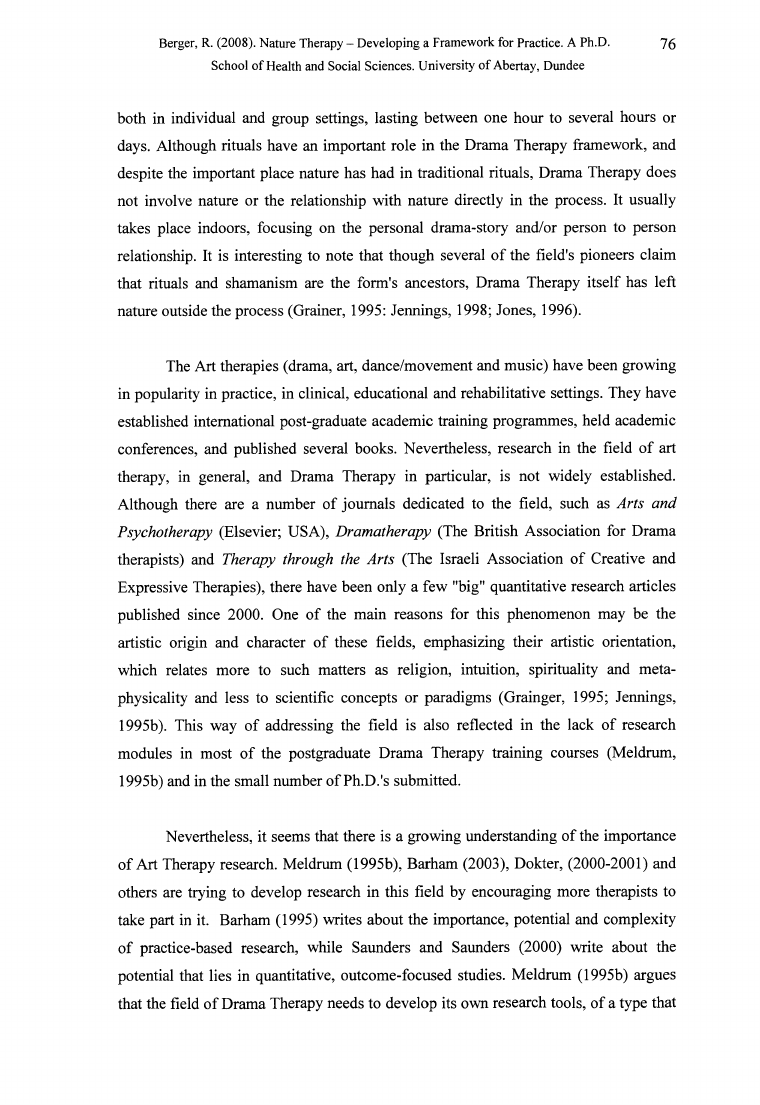
Berger, R. (2008). Nature Therapy - Developing a Framework for Practice. A Ph.D.
76
School of Health and Social Sciences. University of Abertay, Dundee
both in individual and group settings, lasting between one hour to several hours or
days. Although rituals have an important role in the Drama Therapy framework, and
despite the important place nature has had in traditional rituals, Drama Therapy does
not involve nature or the relationship with nature directly in the process. It usually
takes place indoors, focusing on the personal drama-story and/or person to person
relationship. It is interesting to note that though several of the field's pioneers claim
that rituals and shamanism are the form's ancestors, Drama Therapy itself has left
nature outside the process (Grainer, 1995: Jennings, 1998; Jones, 1996).
The Art therapies (drama, art, dance/movement and music) have been growing
in popularity in practice, in clinical, educational and rehabilitative settings. They have
established international post-graduate academic training programmes, held academic
conferences, and published several books. Nevertheless, research in the field of art
therapy, in general, and Drama Therapy in particular, is not widely established.
Although there are a number of journals dedicated to the field, such as Arts and
Psychotherapy (Elsevier; USA), Dramatherapy (The British Association for Drama
therapists) and Therapy through the Arts (The Israeli Association of Creative and
Expressive Therapies), there have been only a few "big" quantitative research articles
published since 2000. One of the main reasons for this phenomenon may be the
artistic origin and character of these fields, emphasizing their artistic orientation,
which relates more to such matters as religion, intuition, spirituality and meta-
physicality and less to scientific concepts or paradigms (Grainger, 1995; Jennings,
1995b). This way of addressing the field is also reflected in the lack of research
modules in most of the postgraduate Drama Therapy training courses (Meldrum,
1995b) and in the small number of Ph.D.'s submitted.
Nevertheless, it seems that there is a growing understanding of the importance
of Art Therapy research. Meldrum (1995b), Barham (2003), Dokter, (2000-2001) and
others are trying to develop research in this field by encouraging more therapists to
take part in it. Barham (1995) writes about the importance, potential and complexity
of practice-based research, while Saunders and Saunders (2000) write about the
potential that lies in quantitative, outcome-focused studies. Meldrum (1995b) argues
that the field of Drama Therapy needs to develop its own research tools, of a type that
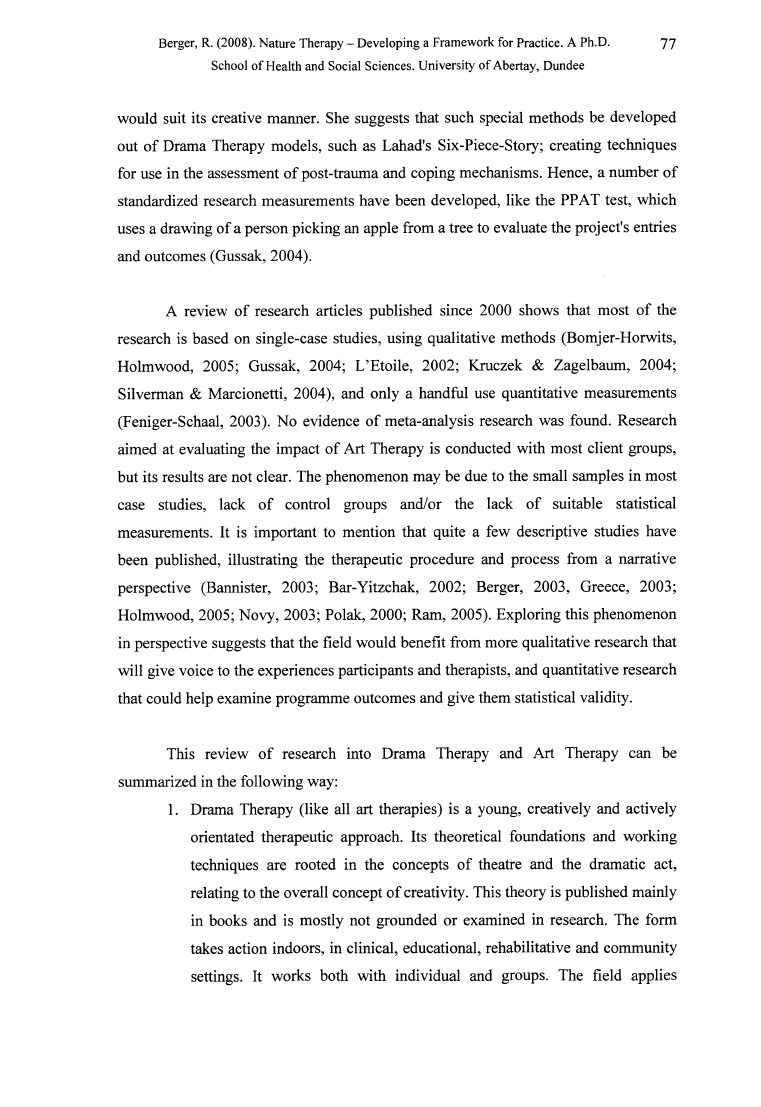
Berger, R. (2008). Nature Therapy - Developing a Framework for Practice. A Ph.D.
77
School of Health and Social Sciences. University of Abertay, Dundee
would suit its creative manner. She suggests that such special methods be developed
out of Drama Therapy models, such as Lahad's Six-Piece-Story; creating techniques
for use in the assessment of post-trauma and coping mechanisms. Hence, a number of
standardized research measurements have been developed, like the PPAT test, which
uses a drawing of a person picking an apple from a tree to evaluate the project's entries
and outcomes (Gussak, 2004).
A review of research articles published since 2000 shows that most of the
research is based on single-case studies, using qualitative methods (Bomjer-Horwits,
Holmwood, 2005; Gussak, 2004; L’Etoile, 2002; Kruczek & Zagelbaum, 2004;
Silverman & Marcionetti, 2004), and only a handful use quantitative measurements
(Feniger-Schaal, 2003). No evidence of meta-analysis research was found. Research
aimed at evaluating the impact of Art Therapy is conducted with most client groups,
but its results are not clear. The phenomenon may be due to the small samples in most
case studies, lack of control groups and/or the lack of suitable statistical
measurements. It is important to mention that quite a few descriptive studies have
been published, illustrating the therapeutic procedure and process from a narrative
perspective (Bannister, 2003; Bar-Yitzchak, 2002; Berger, 2003, Greece, 2003;
Holmwood, 2005; Novy, 2003; Polak, 2000; Ram, 2005). Exploring this phenomenon
in perspective suggests that the field would benefit from more qualitative research that
will give voice to the experiences participants and therapists, and quantitative research
that could help examine programme outcomes and give them statistical validity.
This review of research into Drama Therapy and Art Therapy can be
summarized in the following way:
1. Drama Therapy (like all art therapies) is a young, creatively and actively
orientated therapeutic approach. Its theoretical foundations and working
techniques are rooted in the concepts of theatre and the dramatic act,
relating to the overall concept of creativity. This theory is published mainly
in books and is mostly not grounded or examined in research. The form
takes action indoors, in clinical, educational, rehabilitative and community
settings. It works both with individual and groups. The field applies
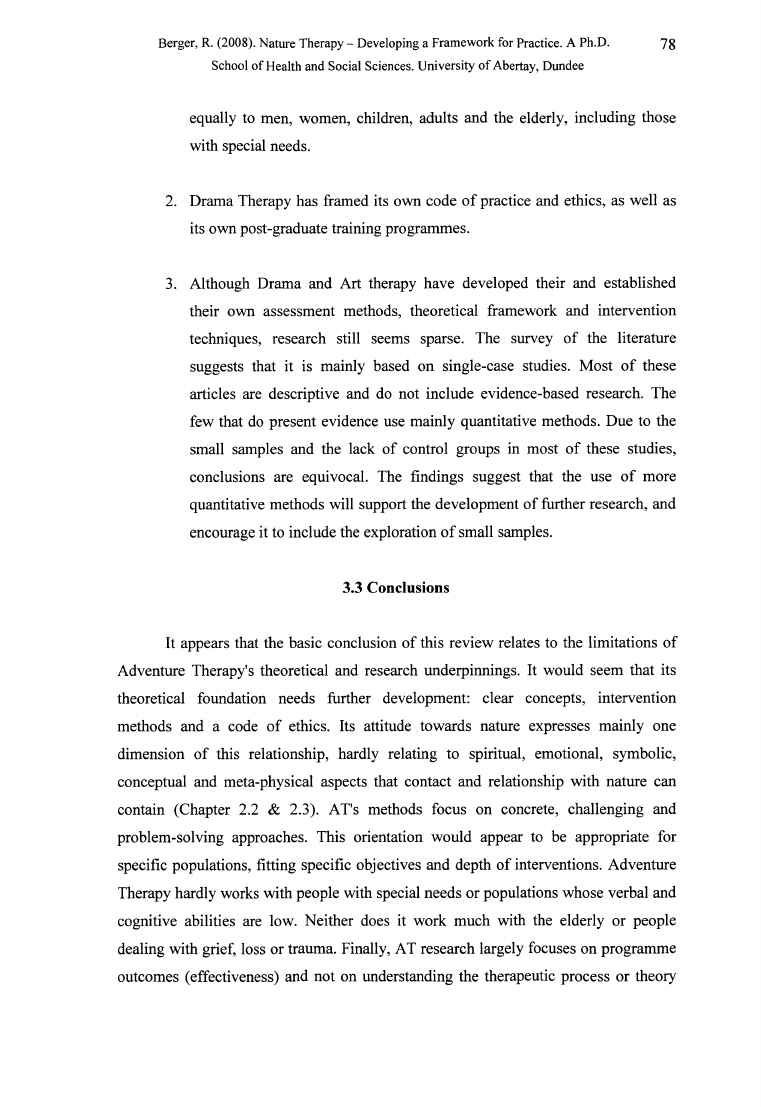
Berger, R. (2008). Nature Therapy - Developing a Framework for Practice. A Ph.D.
78
School of Health and Social Sciences. University of Abertay, Dundee
equally to men, women, children, adults and the elderly, including those
with special needs.
2. Drama Therapy has framed its own code of practice and ethics, as well as
its own post-graduate training programmes.
3. Although Drama and Art therapy have developed their and established
their own assessment methods, theoretical framework and intervention
techniques, research still seems sparse. The survey of the literature
suggests that it is mainly based on single-case studies. Most of these
articles are descriptive and do not include evidence-based research. The
few that do present evidence use mainly quantitative methods. Due to the
small samples and the lack of control groups in most of these studies,
conclusions are equivocal. The findings suggest that the use of more
quantitative methods will support the development of further research, and
encourage it to include the exploration of small samples.
3.3 Conclusions
It appears that the basic conclusion of this review relates to the limitations of
Adventure Therapy's theoretical and research underpinnings. It would seem that its
theoretical foundation needs further development: clear concepts, intervention
methods and a code of ethics. Its attitude towards nature expresses mainly one
dimension of this relationship, hardly relating to spiritual, emotional, symbolic,
conceptual and meta-physical aspects that contact and relationship with nature can
contain (Chapter 2.2 & 2.3). AT's methods focus on concrete, challenging and
problem-solving approaches. This orientation would appear to be appropriate for
specific populations, fitting specific objectives and depth of interventions. Adventure
Therapy hardly works with people with special needs or populations whose verbal and
cognitive abilities are low. Neither does it work much with the elderly or people
dealing with grief, loss or trauma. Finally, AT research largely focuses on programme
outcomes (effectiveness) and not on understanding the therapeutic process or theory
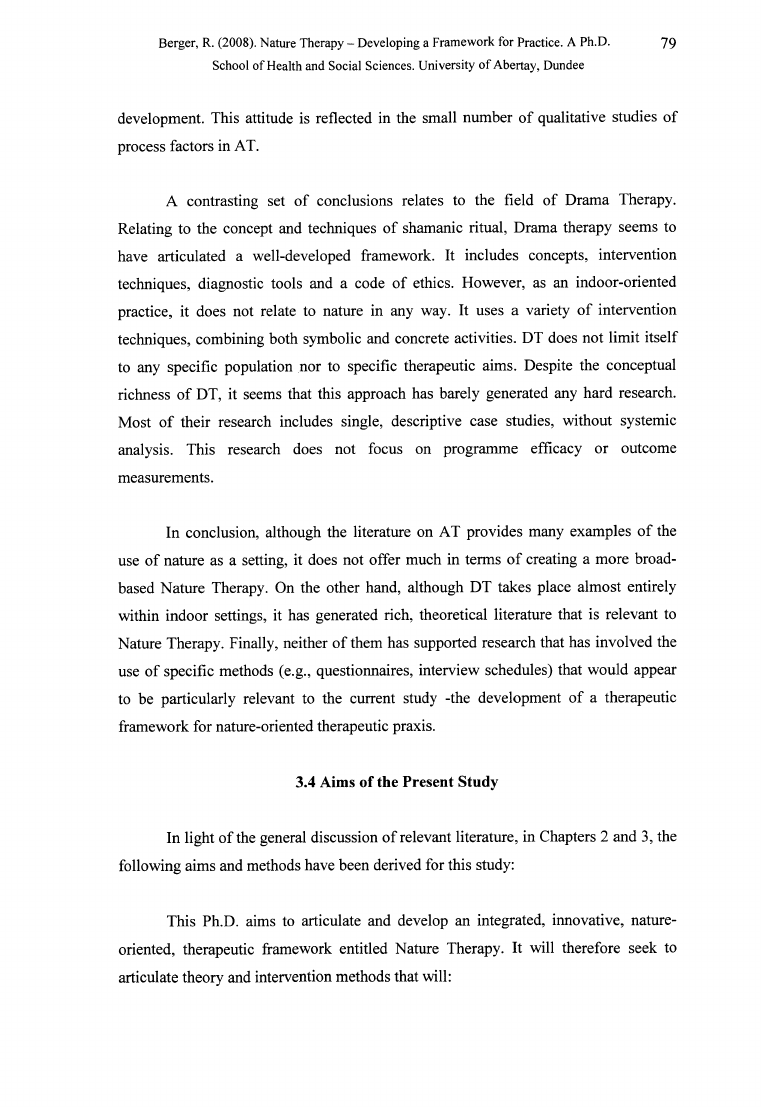
Berger, R. (2008). Nature Therapy - Developing a Framework for Practice. A Ph.D.
79
School of Health and Social Sciences. University of Abertay, Dundee
development. This attitude is reflected in the small number of qualitative studies of
process factors in AT.
A contrasting set of conclusions relates to the field of Drama Therapy.
Relating to the concept and techniques of shamanic ritual, Drama therapy seems to
have articulated a well-developed framework. It includes concepts, intervention
techniques, diagnostic tools and a code of ethics. However, as an indoor-oriented
practice, it does not relate to nature in any way. It uses a variety of intervention
techniques, combining both symbolic and concrete activities. DT does not limit itself
to any specific population nor to specific therapeutic aims. Despite the conceptual
richness of DT, it seems that this approach has barely generated any hard research.
Most of their research includes single, descriptive case studies, without systemic
analysis. This research does not focus on programme efficacy or outcome
measurements.
In conclusion, although the literature on AT provides many examples of the
use of nature as a setting, it does not offer much in terms of creating a more broad-
based Nature Therapy. On the other hand, although DT takes place almost entirely
within indoor settings, it has generated rich, theoretical literature that is relevant to
Nature Therapy. Finally, neither of them has supported research that has involved the
use of specific methods (e.g., questionnaires, interview schedules) that would appear
to be particularly relevant to the current study -the development of a therapeutic
framework for nature-oriented therapeutic praxis.
3.4 Aims of the Present Study
In light of the general discussion of relevant literature, in Chapters 2 and 3, the
following aims and methods have been derived for this study:
This Ph.D. aims to articulate and develop an integrated, innovative, nature-
oriented, therapeutic framework entitled Nature Therapy. It will therefore seek to
articulate theory and intervention methods that will:
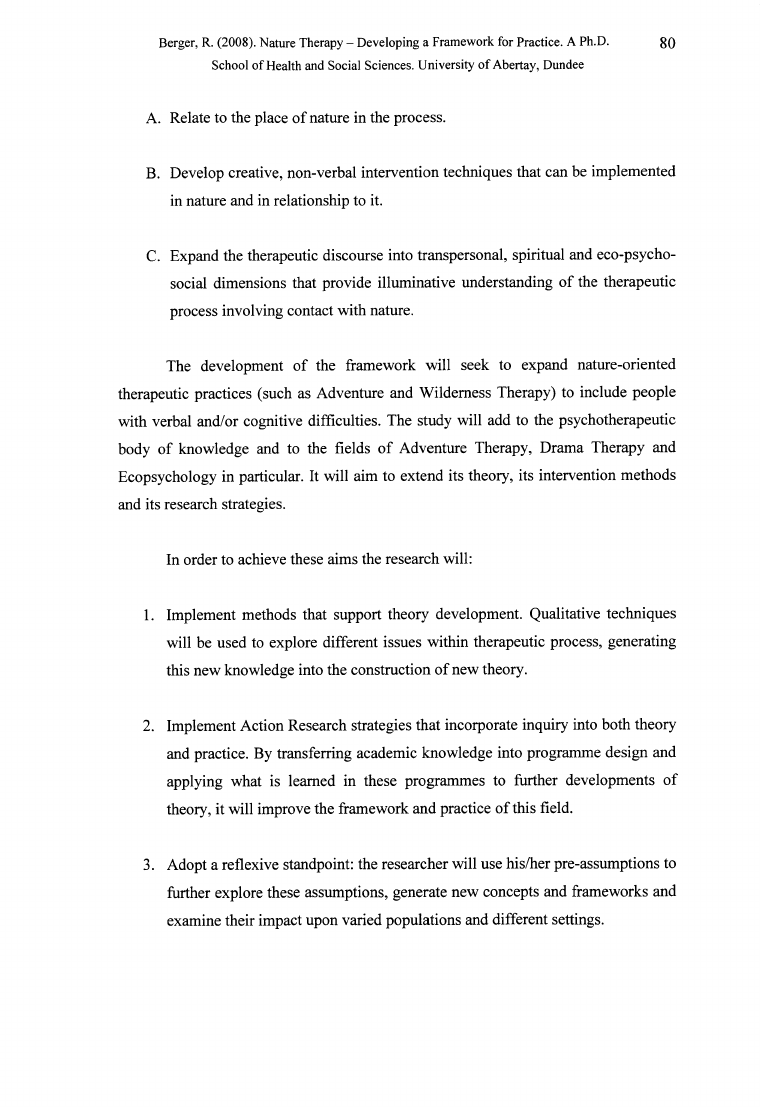
Berger, R. (2008). Nature Therapy - Developing a Framework for Practice. A Ph.D.
80
School of Health and Social Sciences. University of Abertay, Dundee
A. Relate to the place of nature in the process.
B. Develop creative, non-verbal intervention techniques that can be implemented
in nature and in relationship to it.
C. Expand the therapeutic discourse into transpersonal, spiritual and eco-psycho-
social dimensions that provide illuminative understanding of the therapeutic
process involving contact with nature.
The development of the framework will seek to expand nature-oriented
therapeutic practices (such as Adventure and Wilderness Therapy) to include people
with verbal and/or cognitive difficulties. The study will add to the psychotherapeutic
body of knowledge and to the fields of Adventure Therapy, Drama Therapy and
Ecopsychology in particular. It will aim to extend its theory, its intervention methods
and its research strategies.
In order to achieve these aims the research will:
1. Implement methods that support theory development. Qualitative techniques
will be used to explore different issues within therapeutic process, generating
this new knowledge into the construction of new theory.
2. Implement Action Research strategies that incorporate inquiry into both theory
and practice. By transferring academic knowledge into programme design and
applying what is learned in these programmes to further developments of
theory, it will improve the framework and practice of this field.
3. Adopt a reflexive standpoint: the researcher will use his/her pre-assumptions to
further explore these assumptions, generate new concepts and frameworks and
examine their impact upon varied populations and different settings.
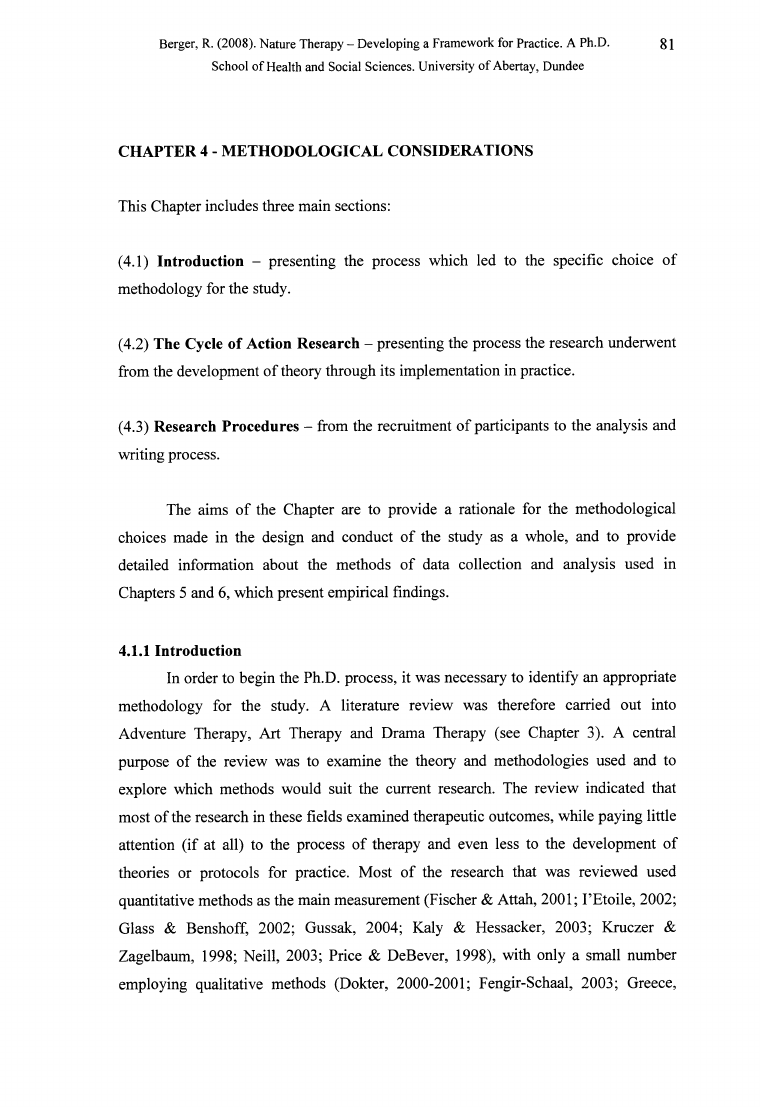
Berger, R. (2008). Nature Therapy - Developing a Framework for Practice. A Ph.D.
81
School of Health and Social Sciences. University of Abertay, Dundee
CHAPTER 4 - METHODOLOGICAL CONSIDERATIONS
This Chapter includes three main sections:
(4.1) Introduction - presenting the process which led to the specific choice of
methodology for the study.
(4.2) The Cycle of Action Research - presenting the process the research underwent
from the development of theory through its implementation in practice.
(4.3) Research Procedures - from the recruitment of participants to the analysis and
writing process.
The aims of the Chapter are to provide a rationale for the methodological
choices made in the design and conduct of the study as a whole, and to provide
detailed information about the methods of data collection and analysis used in
Chapters 5 and 6, which present empirical findings.
4.1.1 Introduction
In order to begin the Ph.D. process, it was necessary to identify an appropriate
methodology for the study. A literature review was therefore carried out into
Adventure Therapy, Art Therapy and Drama Therapy (see Chapter 3). A central
purpose of the review was to examine the theory and methodologies used and to
explore which methods would suit the current research. The review indicated that
most of the research in these fields examined therapeutic outcomes, while paying little
attention (if at all) to the process of therapy and even less to the development of
theories or protocols for practice. Most of the research that was reviewed used
quantitative methods as the main measurement (Fischer & Attah, 2001; I’Etoile, 2002;
Glass & Benshoff, 2002; Gussak, 2004; Kaly & Hessacker, 2003; Kruczer &
Zagelbaum, 1998; Neill, 2003; Price & DeBever, 1998), with only a small number
employing qualitative methods (Dokter, 2000-2001; Fengir-Schaal, 2003; Greece,
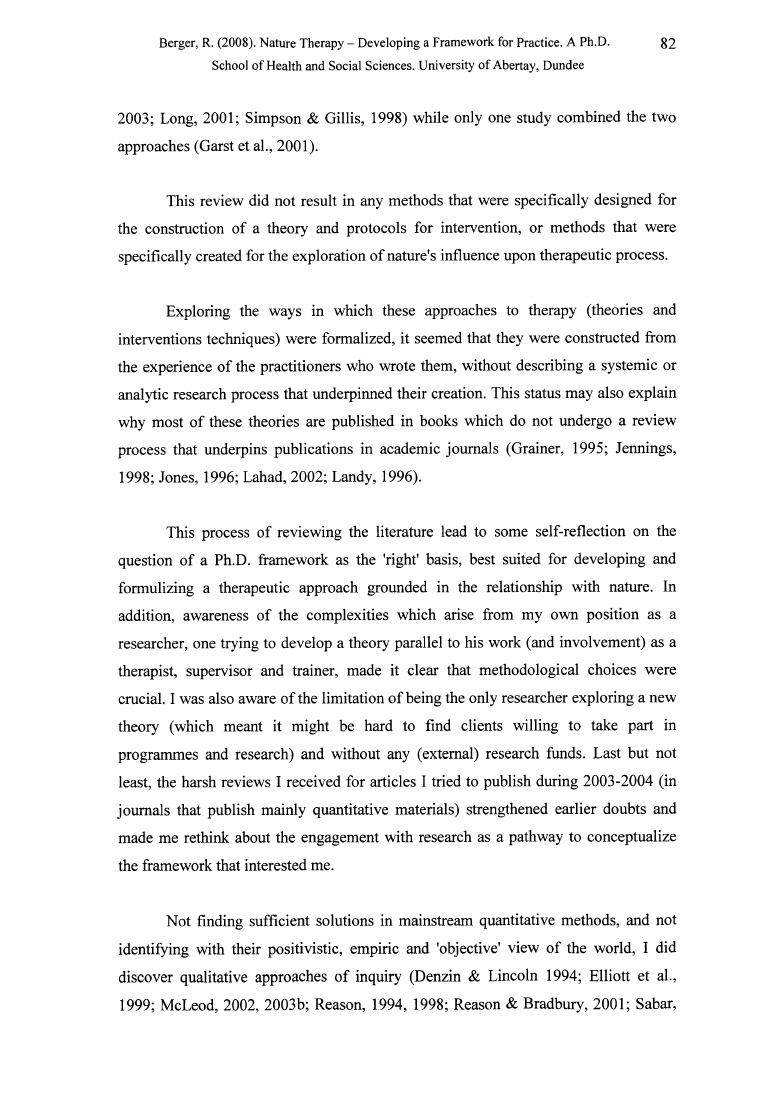
Berger, R. (2008). Nature Therapy - Developing a Framework for Practice. A Ph.D.
82
School of Health and Social Sciences. University of Abertay, Dundee
2003; Long, 2001; Simpson & Gillis, 1998) while only one study combined the two
approaches (Garst et al., 2001).
This review did not result in any methods that were specifically designed for
the construction of a theory and protocols for intervention, or methods that were
specifically created for the exploration of nature's influence upon therapeutic process.
Exploring the ways in which these approaches to therapy (theories and
interventions techniques) were formalized, it seemed that they were constructed from
the experience of the practitioners who wrote them, without describing a systemic or
analytic research process that underpinned their creation. This status may also explain
why most of these theories are published in books which do not undergo a review
process that underpins publications in academic journals (Grainer, 1995; Jennings,
1998; Jones, 1996; Lahad, 2002; Landy, 1996).
This process of reviewing the literature lead to some self-reflection on the
question of a Ph.D. framework as the 'right' basis, best suited for developing and
formulizing a therapeutic approach grounded in the relationship with nature. In
addition, awareness of the complexities which arise from my own position as a
researcher, one trying to develop a theory parallel to his work (and involvement) as a
therapist, supervisor and trainer, made it clear that methodological choices were
crucial. I was also aware of the limitation of being the only researcher exploring a new
theory (which meant it might be hard to find clients willing to take part in
programmes and research) and without any (external) research funds. Last but not
least, the harsh reviews I received for articles I tried to publish during 2003-2004 (in
journals that publish mainly quantitative materials) strengthened earlier doubts and
made me rethink about the engagement with research as a pathway to conceptualize
the framework that interested me.
Not finding sufficient solutions in mainstream quantitative methods, and not
identifying with their positivistic, empiric and 'objective' view of the world, I did
discover qualitative approaches of inquiry (Denzin & Lincoln 1994; Elliott et al.,
1999; McLeod, 2002, 2003b; Reason, 1994, 1998; Reason & Bradbury, 2001; Sabar,
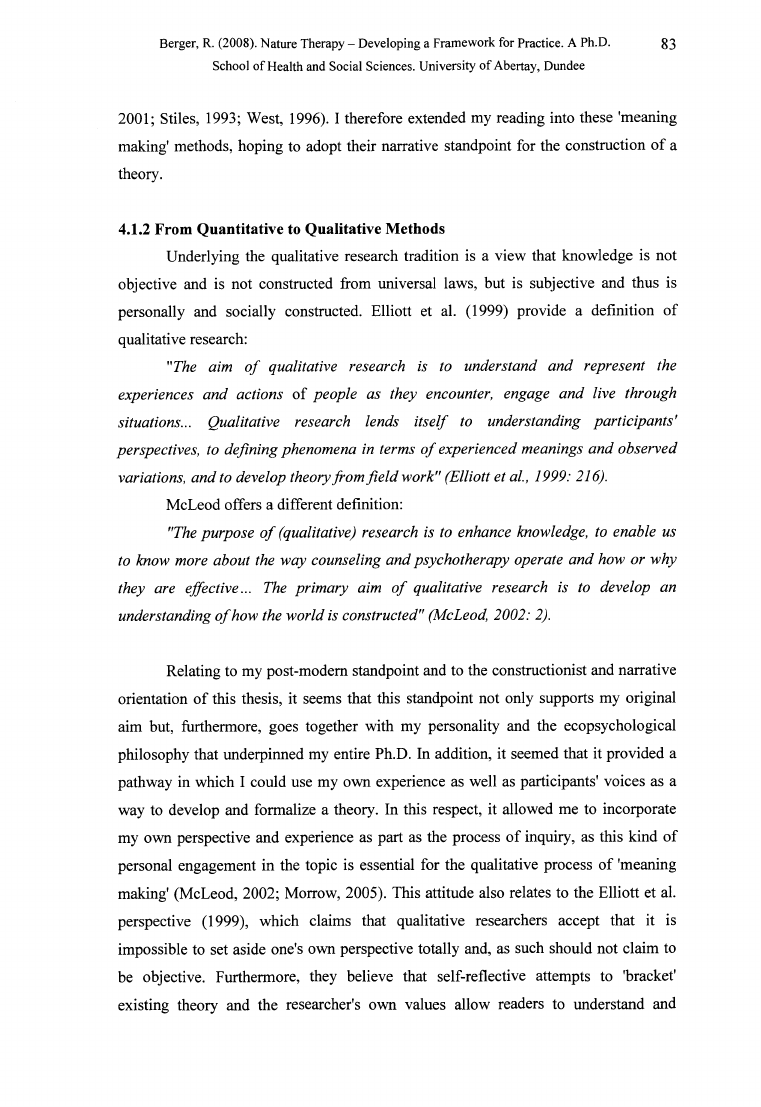
Berger, R. (2008). Nature Therapy - Developing a Framework for Practice. A Ph.D.
83
School of Health and Social Sciences. University of Abertay, Dundee
2001; Stiles, 1993; West, 1996). I therefore extended my reading into these 'meaning
making' methods, hoping to adopt their narrative standpoint for the construction of a
theory.
4.1.2 From Quantitative to Qualitative Methods
Underlying the qualitative research tradition is a view that knowledge is not
objective and is not constructed from universal laws, but is subjective and thus is
personally and socially constructed. Elliott et al. (1999) provide a definition of
qualitative research:
"T he a im o f q u a lita tiv e r e s e a r c h is to u n d e r s ta n d a n d r e p r e s e n t th e
experiences a n d action s of p e o p le as they encounter, engage a n d live through
situations... Q u alitative research lends itse lf to understanding p a rticip a n ts'
p e rsp e c tiv e s, to d efin in g ph en o m en a in term s o f e x p e rie n c ed m ean in gs a n d o b se rv e d
variation s, a n d to d e v elo p th eory fro m f ie ld w ork" (E llio tt e t al., 1999: 216).
McLeod offers a different definition:
"The p u rp o se o f (qu alitative) research is to enhance know ledge, to en able us
to know m ore abou t the w a y counseling a n d p sych o th era p y operate a n d how o r w h y
they are effective... The p rim a ry aim o f qu alitative research is to d evelop an
u n derstan din g o f how the w o rld is con stru cted" (M cL eod, 2002: 2).
Relating to my post-modern standpoint and to the constructionist and narrative
orientation of this thesis, it seems that this standpoint not only supports my original
aim but, furthermore, goes together with my personality and the ecopsychological
philosophy that underpinned my entire Ph.D. In addition, it seemed that it provided a
pathway in which I could use my own experience as well as participants' voices as a
way to develop and formalize a theory. In this respect, it allowed me to incorporate
my own perspective and experience as part as the process of inquiry, as this kind of
personal engagement in the topic is essential for the qualitative process of 'meaning
making' (McLeod, 2002; Morrow, 2005). This attitude also relates to the Elliott et al.
perspective (1999), which claims that qualitative researchers accept that it is
impossible to set aside one's own perspective totally and, as such should not claim to
be objective. Furthermore, they believe that self-reflective attempts to 'bracket'
existing theory and the researcher's own values allow readers to understand and
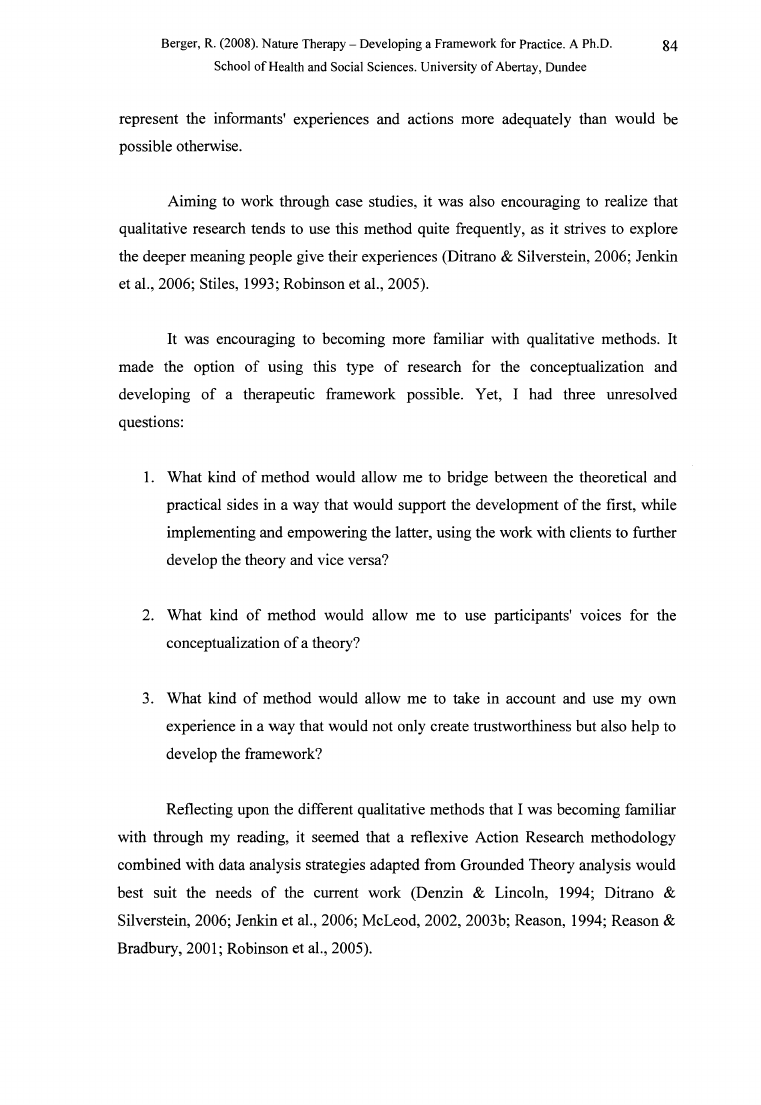
Berger, R. (2008). Nature Therapy - Developing a Framework for Practice. A Ph.D.
84
School of Health and Social Sciences. University of Abertay, Dundee
represent the informants' experiences and actions more adequately than would be
possible otherwise.
Aiming to work through case studies, it was also encouraging to realize that
qualitative research tends to use this method quite frequently, as it strives to explore
the deeper meaning people give their experiences (Ditrano & Silverstein, 2006; Jenkin
et ah, 2006; Stiles, 1993; Robinson et al., 2005).
It was encouraging to becoming more familiar with qualitative methods. It
made the option of using this type of research for the conceptualization and
developing of a therapeutic framework possible. Yet, I had three unresolved
questions:
1. What kind of method would allow me to bridge between the theoretical and
practical sides in a way that would support the development of the first, while
implementing and empowering the latter, using the work with clients to further
develop the theory and vice versa?
2. What kind of method would allow me to use participants' voices for the
conceptualization of a theory?
3. What kind of method would allow me to take in account and use my own
experience in a way that would not only create trustworthiness but also help to
develop the framework?
Reflecting upon the different qualitative methods that I was becoming familiar
with through my reading, it seemed that a reflexive Action Research methodology
combined with data analysis strategies adapted from Grounded Theory analysis would
best suit the needs of the current work (Denzin & Lincoln, 1994; Ditrano &
Silverstein, 2006; Jenkin et al., 2006; McLeod, 2002, 2003b; Reason, 1994; Reason &
Bradbury, 2001; Robinson et al., 2005).
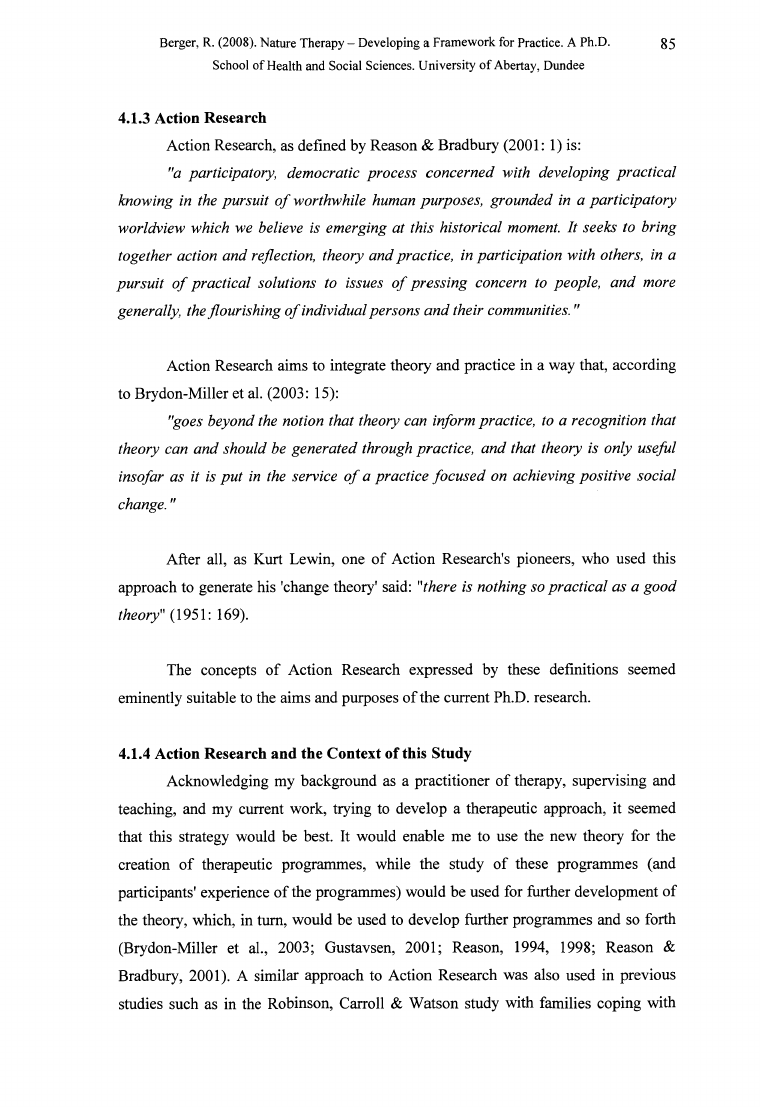
Berger, R. (2008). Nature Therapy - Developing a Framework for Practice. A Ph.D.
85
School of Health and Social Sciences. University of Abertay, Dundee
4.1.3 Action Research
Action Research, as defined by Reason & Bradbury (2001: 1) is:
"a p a r tic ip a to r y , d e m o c r a tic p r o c e s s c o n c e r n e d w ith d e v e lo p in g p r a c ti c a l
kn ow in g in the p u rsu it o f w o rth w h ile hum an p u rp o se s, g ro u n d ed in a p a rtic ip a to ry
w o rld view w hich w e believe is em ergin g a t th is h isto rica l m om ent. It seeks to brin g
to g eth er a ctio n a n d reflection , th eo ry a n d p ra c tic e , in p a rtic ip a tio n w ith others, in a
p u rsu it o f p ra c tic a l solutions to issues o f p re ssin g concern to people, a n d m ore
generally, the flo u rish in g o f in dividu al p erso n s a n d th eir com m u n ities."
Action Research aims to integrate theory and practice in a way that, according
to Brydon-Miller et al. (2003: 15):
"goes beyo n d the notion th at th eory can inform p ra ctice, to a recogn ition that
th eory can a n d sh ou ld be g en era ted through p ra ctice, a n d that th eory is only useful
in so fa r a s it is p u t in the se rv ic e o f a p r a c tic e fo c u s e d on a ch ievin g p o s itiv e so c ia l
c h a n g e ."
After all, as Kurt Lewin, one of Action Research's pioneers, who used this
approach to generate his 'change theory' said: "th e re is n o th in g so p r a c tic a l a s a g o o d
th e o ry " (1951: 169).
The concepts of Action Research expressed by these definitions seemed
eminently suitable to the aims and purposes of the current Ph.D. research.
4.1.4 Action Research and the Context of this Study
Acknowledging my background as a practitioner of therapy, supervising and
teaching, and my current work, trying to develop a therapeutic approach, it seemed
that this strategy would be best. It would enable me to use the new theory for the
creation of therapeutic programmes, while the study of these programmes (and
participants' experience of the programmes) would be used for further development of
the theory, which, in turn, would be used to develop further programmes and so forth
(Brydon-Miller et al., 2003; Gustavsen, 2001; Reason, 1994, 1998; Reason &
Bradbury, 2001). A similar approach to Action Research was also used in previous
studies such as in the Robinson, Carroll & Watson study with families coping with
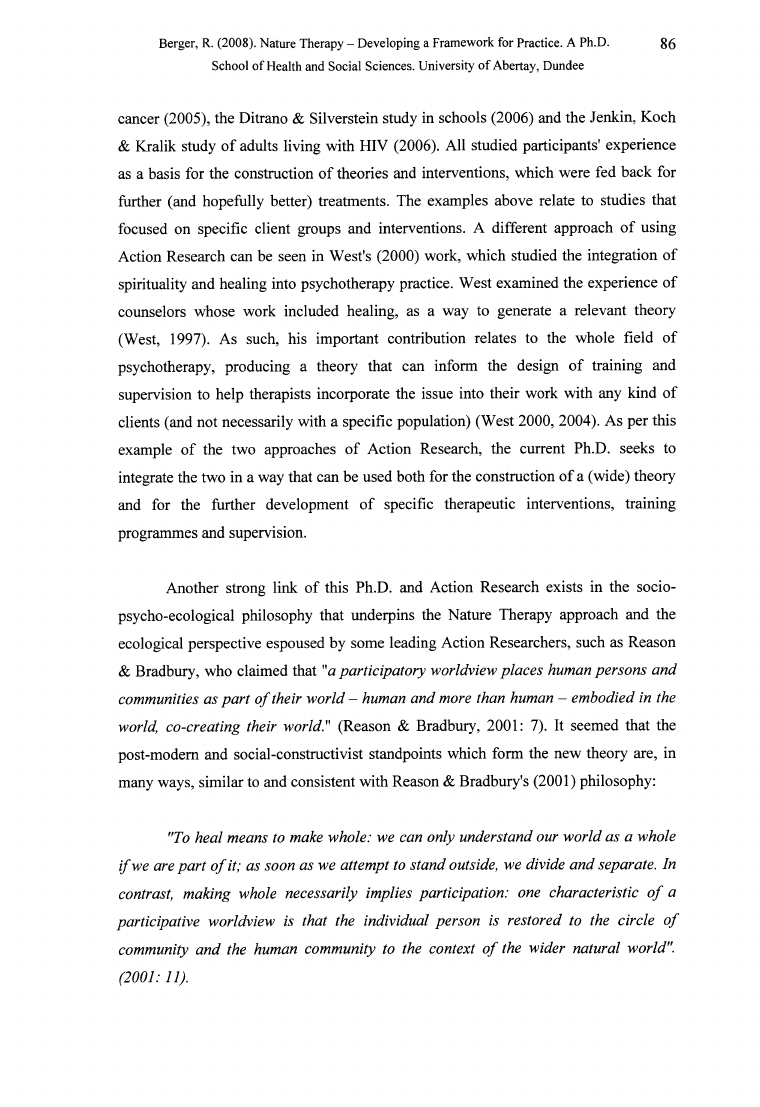
Berger, R. (2008). Nature Therapy - Developing a Framework for Practice. A Ph.D.
86
School of Health and Social Sciences. University of Abertay, Dundee
cancer (2005), the Ditrano & Silverstein study in schools (2006) and the Jenkin, Koch
& Kralik study of adults living with HIV (2006). All studied participants' experience
as a basis for the construction of theories and interventions, which were fed back for
further (and hopefully better) treatments. The examples above relate to studies that
focused on specific client groups and interventions. A different approach of using
Action Research can be seen in West's (2000) work, which studied the integration of
spirituality and healing into psychotherapy practice. West examined the experience of
counselors whose work included healing, as a way to generate a relevant theory
(West, 1997). As such, his important contribution relates to the whole field of
psychotherapy, producing a theory that can inform the design of training and
supervision to help therapists incorporate the issue into their work with any kind of
clients (and not necessarily with a specific population) (West 2000, 2004). As per this
example of the two approaches of Action Research, the current Ph.D. seeks to
integrate the two in a way that can be used both for the construction of a (wide) theory
and for the further development of specific therapeutic interventions, training
programmes and supervision.
Another strong link of this Ph.D. and Action Research exists in the socio
psycho-ecological philosophy that underpins the Nature Therapy approach and the
ecological perspective espoused by some leading Action Researchers, such as Reason
& Bradbury, who claimed that "a p a r tic ip a to r y w o r ld v ie w p la c e s h u m an p e r s o n s a n d
com m unities a s p a r t o f th eir w o r ld - hum an a n d m ore than hum an - e m b o d ie d in the
w o rld , c o -c r e a tin g th e ir w o rld ." (Reason & Bradbury, 2001: 7). It seemed that the
post-modern and social-constructivist standpoints which form the new theory are, in
many ways, similar to and consistent with Reason & Bradbury's (2001) philosophy:
"To h e a l m ean s to m ake w h o le: w e can on ly u n d ersta n d ou r w o r ld a s a w h o le
i f w e are p a r t o f it; as soon a s w e a tte m p t to sta n d outside, w e d ivid e a n d sep a ra te. In
contrast, m aking w hole n ecessarily im plies participation : one ch aracteristic o f a
p a rtic ip a tiv e w o rld view is th at the in dividu al p erso n is re sto re d to the circle o f
c o m m u n ity a n d th e h u m a n c o m m u n ity to th e c o n te x t o f th e w id e r n a tu r a l w o r l d ”.
(2001: 11).
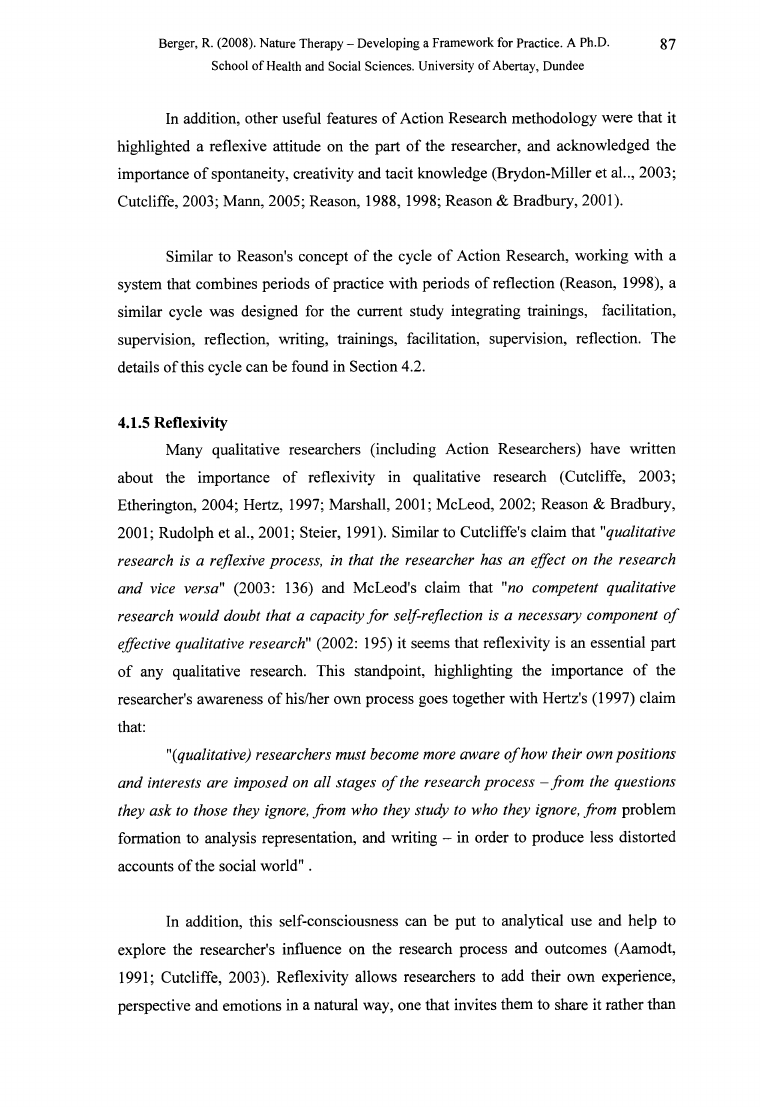
Berger, R. (2008). Nature Therapy - Developing a Framework for Practice. A Ph.D.
87
School of Health and Social Sciences. University of Abertay, Dundee
In addition, other useful features of Action Research methodology were that it
highlighted a reflexive attitude on the part of the researcher, and acknowledged the
importance of spontaneity, creativity and tacit knowledge (Brydon-Miller et aL, 2003;
Cutcliffe, 2003; Mann, 2005; Reason, 1988, 1998; Reason & Bradbury, 2001).
Similar to Reason's concept of the cycle of Action Research, working with a
system that combines periods of practice with periods of reflection (Reason, 1998), a
similar cycle was designed for the current study integrating trainings, facilitation,
supervision, reflection, writing, trainings, facilitation, supervision, reflection. The
details of this cycle can be found in Section 4.2.
4.1.5 Reflexivity
Many qualitative researchers (including Action Researchers) have written
about the importance of reflexivity in qualitative research (Cutcliffe, 2003;
Etherington, 2004; Hertz, 1997; Marshall, 2001; McLeod, 2002; Reason & Bradbury,
2001; Rudolph et al., 2001; Steier, 1991). Similar to Cutcliffe's claim th a t"q u a lita tiv e
resea rch is a reflexive p ro c ess, in th a t the resea rch er has an effect on the resea rch
a n d v ic e v e r s a " (2003: 136) and McLeod's claim that "no c o m p e te n t q u a lita tiv e
research w o u ld dou bt th at a ca p a city f o r self-reflection is a n ecessary com pon en t o f
effe c tive q u a lita tiv e r e s e a r c h " (2002: 195) it seems that reflexivity is an essential part
of any qualitative research. This standpoint, highlighting the importance of the
researcher's awareness of his/her own process goes together with Hertz's (1997) claim
that:
"{qualitative) research ers m ust becom e m ore aw are o f how th eir ow n p o sitio n s
a n d in terests are im p o sed on a ll sta g es o f the research p ro c e ss - fro m the qu estion s
th e y a s k to th o s e th e y ig n o re, f r o m w h o th e y s tu d y to w h o th e y ig n o re , f r o m problem
formation to analysis representation, and writing - in order to produce less distorted
accounts of the social w orld".
In addition, this self-consciousness can be put to analytical use and help to
explore the researcher's influence on the research process and outcomes (Aamodt,
1991; Cutcliffe, 2003). Reflexivity allows researchers to add their own experience,
perspective and emotions in a natural way, one that invites them to share it rather than
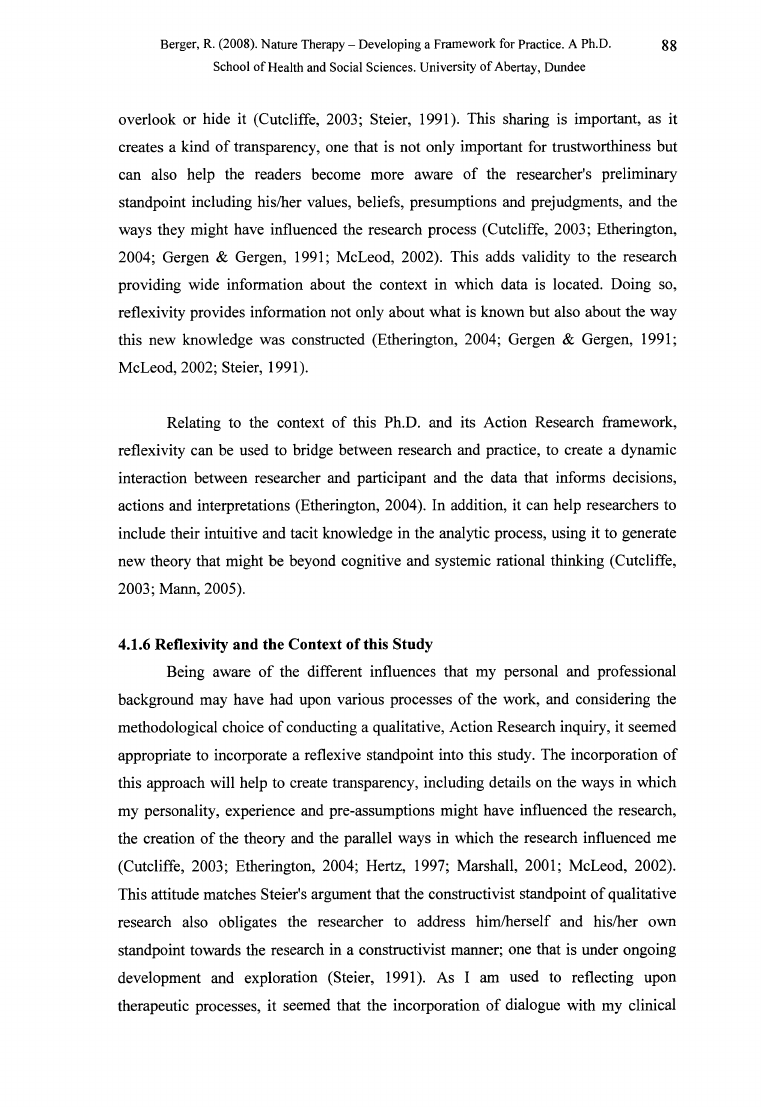
Berger, R. (2008). Nature Therapy - Developing a Framework for Practice. A Ph.D.
88
School of Health and Social Sciences. University of Abertay, Dundee
overlook or hide it (Cutcliffe, 2003; Steier, 1991). This sharing is important, as it
creates a kind of transparency, one that is not only important for trustworthiness but
can also help the readers become more aware of the researcher's preliminary
standpoint including his/her values, beliefs, presumptions and prejudgments, and the
ways they might have influenced the research process (Cutcliffe, 2003; Etherington,
2004; Gergen & Gergen, 1991; McLeod, 2002). This adds validity to the research
providing wide information about the context in which data is located. Doing so,
reflexivity provides information not only about what is known but also about the way
this new knowledge was constructed (Etherington, 2004; Gergen & Gergen, 1991;
McLeod, 2002; Steier, 1991).
Relating to the context of this Ph.D. and its Action Research framework,
reflexivity can be used to bridge between research and practice, to create a dynamic
interaction between researcher and participant and the data that informs decisions,
actions and interpretations (Etherington, 2004). In addition, it can help researchers to
include their intuitive and tacit knowledge in the analytic process, using it to generate
new theory that might be beyond cognitive and systemic rational thinking (Cutcliffe,
2003; Mann, 2005).
4.1.6 Reflexivity and the Context of this Study
Being aware of the different influences that my personal and professional
background may have had upon various processes of the work, and considering the
methodological choice of conducting a qualitative, Action Research inquiry, it seemed
appropriate to incorporate a reflexive standpoint into this study. The incorporation of
this approach will help to create transparency, including details on the ways in which
my personality, experience and pre-assumptions might have influenced the research,
the creation of the theory and the parallel ways in which the research influenced me
(Cutcliffe, 2003; Etherington, 2004; Hertz, 1997; Marshall, 2001; McLeod, 2002).
This attitude matches Steier's argument that the constructivist standpoint of qualitative
research also obligates the researcher to address him/herself and his/her own
standpoint towards the research in a constructivist manner; one that is under ongoing
development and exploration (Steier, 1991). As I am used to reflecting upon
therapeutic processes, it seemed that the incorporation of dialogue with my clinical
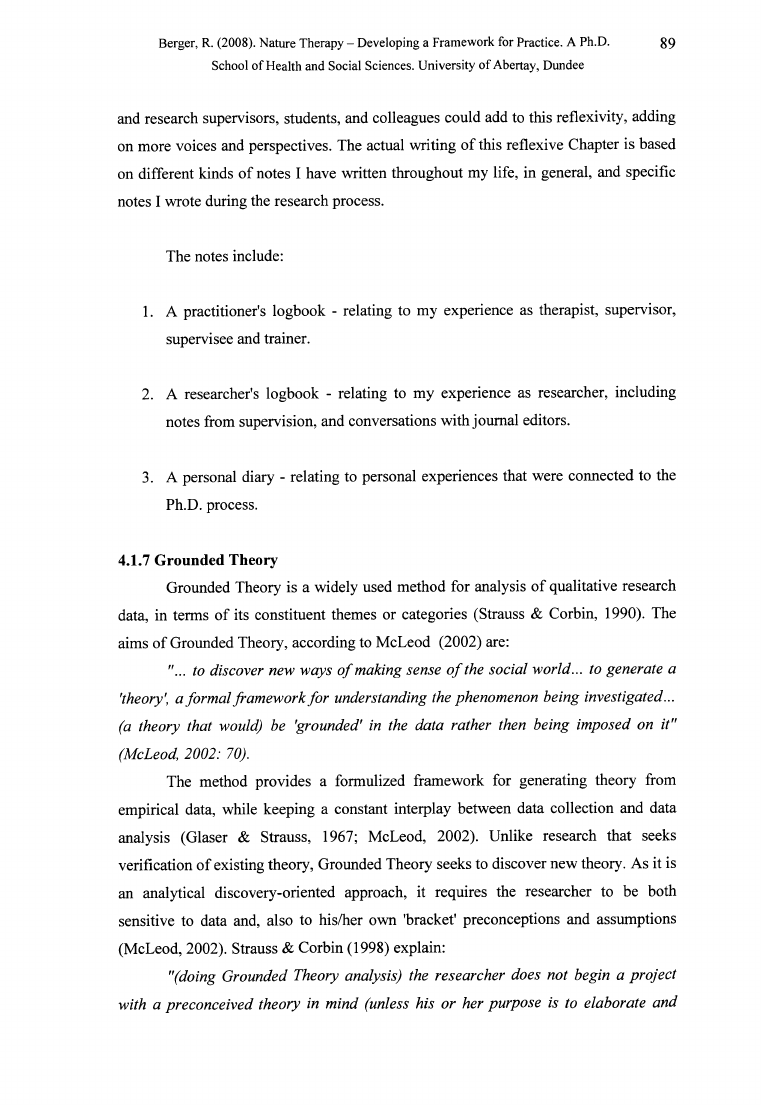
Berger, R. (2008). Nature Therapy - Developing a Framework for Practice. A Ph.D.
89
School of Health and Social Sciences. University of Abertay, Dundee
and research supervisors, students, and colleagues could add to this reflexivity, adding
on more voices and perspectives. The actual writing of this reflexive Chapter is based
on different kinds of notes I have written throughout my life, in general, and specific
notes I wrote during the research process.
The notes include:
1. A practitioner's logbook - relating to my experience as therapist, supervisor,
supervisee and trainer.
2. A researcher's logbook - relating to my experience as researcher, including
notes from supervision, and conversations with journal editors.
3. A personal diary - relating to personal experiences that were connected to the
Ph.D. process.
4.1.7 Grounded Theory
Grounded Theory is a widely used method for analysis of qualitative research
data, in terms of its constituent themes or categories (Strauss & Corbin, 1990). The
aims of Grounded Theory, according to McLeod (2002) are:
"... to d is c o v e r n e w w a y s o f m a k in g s e n s e o f th e s o c ia l w o r ld ... to g e n e r a te a
'theory', a fo rm a l fra m e w o rk f o r u n derstan din g the ph en om en on b ein g in v estig a te d ...
(a th e o ry th a t w ou ld) be 'grou nded' in the d a ta ra th er then b ein g im p o se d on it"
(M cL eod, 2 002: 70).
The method provides a formulized framework for generating theory from
empirical data, while keeping a constant interplay between data collection and data
analysis (Glaser & Strauss, 1967; McLeod, 2002). Unlike research that seeks
verification of existing theory, Grounded Theory seeks to discover new theory. As it is
an analytical discovery-oriented approach, it requires the researcher to be both
sensitive to data and, also to his/her own 'bracket' preconceptions and assumptions
(McLeod, 2002). Strauss & Corbin (1998) explain:
"(doing G ro u n d ed T heory analysis) the resea rch er d o es n o t begin a p ro je c t
w ith a p r e c o n c e iv e d th eo ry in m in d (unless his o r h er p u rp o se is to ela b o ra te a n d
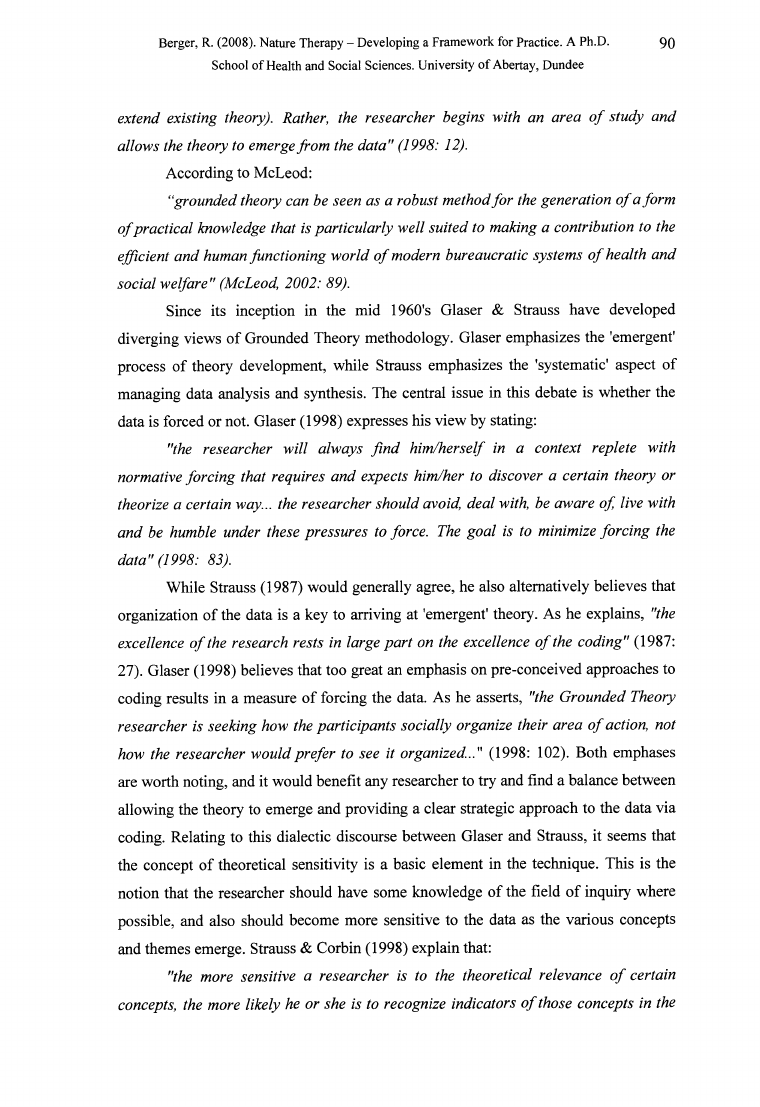
Berger, R. (2008). Nature Therapy - Developing a Framework for Practice. A Ph.D.
90
School of Health and Social Sciences. University of Abertay, Dundee
exten d existin g theory). Rather, the resea rch er begin s w ith an a rea o f stu d y a n d
a llo w s the th eory to em erge fro m the data" (1998: 12).
According to McLeod:
“g r o u n d e d th e o r y c a n b e s e e n a s a r o b u s t m e th o d f o r th e g e n e r a tio n o f a f o r m
o f p ra c tic a l kn ow ledge th at is p a rtic u la rly w ell su ited to m aking a con tribu tion to the
efficient an d hum an fu n ction in g w o rld o f m odern bureaucratic system s o f health an d
so cia l w elfare " (M cLeod, 2002: 89).
Since its inception in the mid 1960's Glaser & Strauss have developed
diverging views of Grounded Theory methodology. Glaser emphasizes the 'emergent'
process of theory development, while Strauss emphasizes the 'systematic' aspect of
managing data analysis and synthesis. The central issue in this debate is whether the
data is forced or not. Glaser (1998) expresses his view by stating:
"the re se a rc h e r w ill a lw a y s f in d h im /h e r s e lf in a co n tex t re p le te w ith
norm ative fo rc in g that requires an d expects him /her to discover a certain theory or
th e o rize a certa in w ay... the re se a rc h e r sh o u ld a void, d e a l w ith, be a w a re of, liv e w ith
a n d be hum ble under these p ressu res to fo rce. The g o a l is to m inim ize fo rc in g the
data" (1998: 83).
While Strauss (1987) would generally agree, he also alternatively believes that
organization of the data is a key to arriving at 'emergent' theory. As he explains, "the
e x c e lle n c e o f th e r e s e a r c h r e s ts in la r g e p a r t o n th e e x c e lle n c e o f th e c o d in g " (1987:
27). Glaser (1998) believes that too great an emphasis on pre-conceived approaches to
coding results in a measure of forcing the data. As he asserts, "the G r o u n d e d T h eo ry
research er is seekin g how the p a rticip a n ts so cia lly organ ize their a rea o f action, not
h o w th e r e s e a r c h e r w o u ld p r e f e r to s e e it o rg a n ize d ..." (1998: 102). Both emphases
are worth noting, and it would benefit any researcher to try and find a balance between
allowing the theory to emerge and providing a clear strategic approach to the data via
coding. Relating to this dialectic discourse between Glaser and Strauss, it seems that
the concept of theoretical sensitivity is a basic element in the technique. This is the
notion that the researcher should have some knowledge of the field of inquiry where
possible, and also should become more sensitive to the data as the various concepts
and themes emerge. Strauss & Corbin (1998) explain that:
"the m o re se n sitiv e a re se a rc h e r is to th e th e o re tic a l re le v a n c e o f c e rta in
concepts, the m ore likely he o r she is to recogn ize in dicators o f those co n cep ts in the
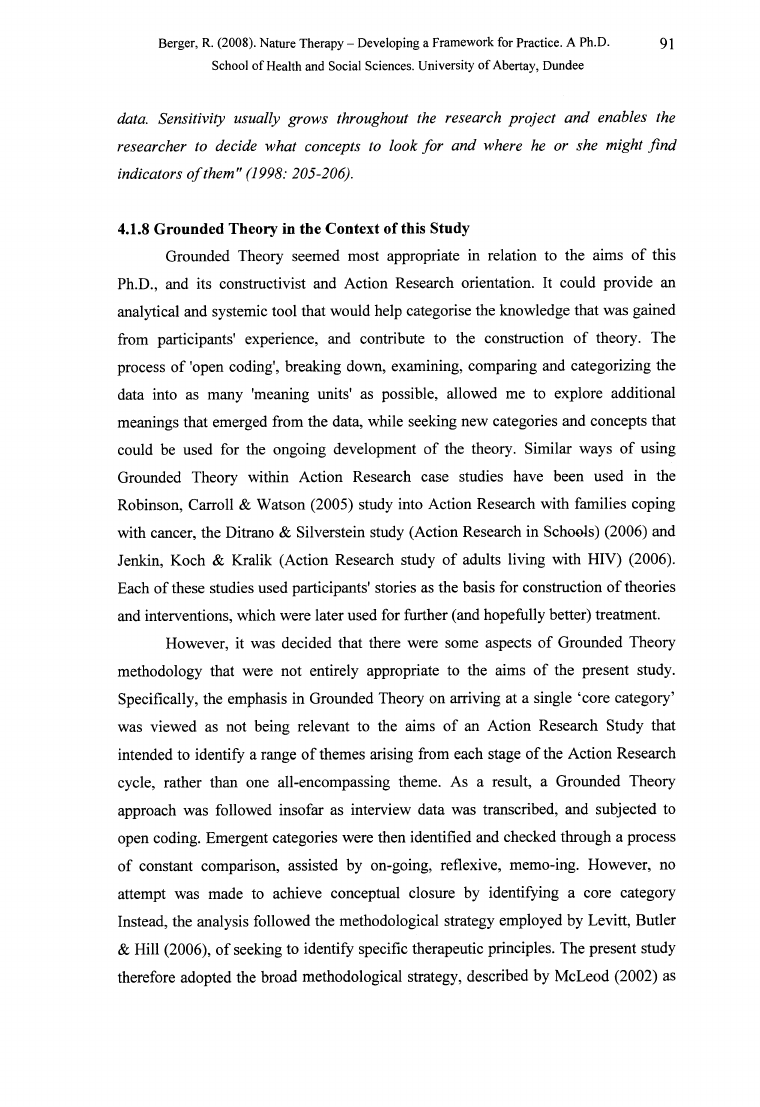
Berger, R. (2008). Nature Therapy - Developing a Framework for Practice. A Ph.D.
91
School of Health and Social Sciences. University of Abertay, Dundee
data. S en sitivity usually g ro w s throughout the research p r o je c t a n d en ables the
research er to decide w h at concepts to look fo r an d w here he or she m ight fin d
in dicators o f them " (1998: 205-206).
4.1.8 Grounded Theory in the Context of this Study
Grounded Theory seemed most appropriate in relation to the aims of this
Ph.D., and its constructivist and Action Research orientation. It could provide an
analytical and systemic tool that would help categorise the knowledge that was gained
from participants' experience, and contribute to the construction of theory. The
process of 'open coding', breaking down, examining, comparing and categorizing the
data into as many 'meaning units' as possible, allowed me to explore additional
meanings that emerged from the data, while seeking new categories and concepts that
could be used for the ongoing development of the theory. Similar ways of using
Grounded Theory within Action Research case studies have been used in the
Robinson, Carroll & Watson (2005) study into Action Research with families coping
with cancer, the Ditrano & Silverstein study (Action Research in Schools) (2006) and
Jenkin, Koch & Kralik (Action Research study of adults living with HIV) (2006).
Each of these studies used participants' stories as the basis for construction of theories
and interventions, which were later used for further (and hopefully better) treatment.
However, it was decided that there were some aspects of Grounded Theory
methodology that were not entirely appropriate to the aims of the present study.
Specifically, the emphasis in Grounded Theory on arriving at a single ‘core category’
was viewed as not being relevant to the aims of an Action Research Study that
intended to identify a range of themes arising from each stage of the Action Research
cycle, rather than one all-encompassing theme. As a result, a Grounded Theory
approach was followed insofar as interview data was transcribed, and subjected to
open coding. Emergent categories were then identified and checked through a process
of constant comparison, assisted by on-going, reflexive, memo-ing. However, no
attempt was made to achieve conceptual closure by identifying a core category
Instead, the analysis followed the methodological strategy employed by Levitt, Butler
& Hill (2006), of seeking to identify specific therapeutic principles. The present study
therefore adopted the broad methodological strategy, described by McLeod (2002) as
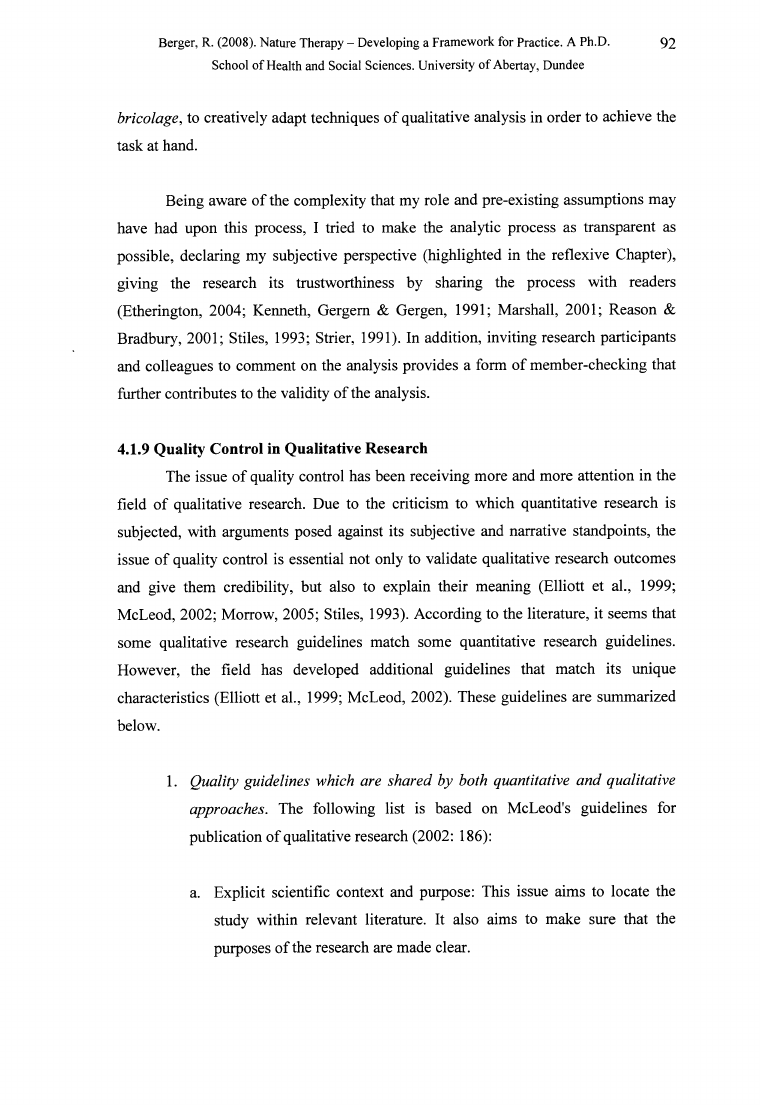
Berger, R. (2008). Nature Therapy - Developing a Framework for Practice. A Ph.D.
92
School of Health and Social Sciences. University of Abertay, Dundee
b r ic o la g e , to creatively adapt techniques of qualitative analysis in order to achieve the
task at hand.
Being aware of the complexity that my role and pre-existing assumptions may
have had upon this process, I tried to make the analytic process as transparent as
possible, declaring my subjective perspective (highlighted in the reflexive Chapter),
giving the research its trustworthiness by sharing the process with readers
(Etherington, 2004; Kenneth, Gergem & Gergen, 1991; Marshall, 2001; Reason &
Bradbury, 2001; Stiles, 1993; Strier, 1991). In addition, inviting research participants
and colleagues to comment on the analysis provides a form of member-checking that
further contributes to the validity of the analysis.
4.1.9 Quality Control in Qualitative Research
The issue of quality control has been receiving more and more attention in the
field of qualitative research. Due to the criticism to which quantitative research is
subjected, with arguments posed against its subjective and narrative standpoints, the
issue of quality control is essential not only to validate qualitative research outcomes
and give them credibility, but also to explain their meaning (Elliott et ah, 1999;
McLeod, 2002; Morrow, 2005; Stiles, 1993). According to the literature, it seems that
some qualitative research guidelines match some quantitative research guidelines.
However, the field has developed additional guidelines that match its unique
characteristics (Elliott et ah, 1999; McLeod, 2002). These guidelines are summarized
below.
1. Q u a lity g u id e lin e s w h ic h a r e s h a r e d b y b o th q u a n tita tiv e a n d q u a lita tiv e
a p p ro a c h e s. The following list is based on McLeod's guidelines for
publication of qualitative research (2002: 186):
a. Explicit scientific context and purpose: This issue aims to locate the
study within relevant literature. It also aims to make sure that the
purposes of the research are made clear.
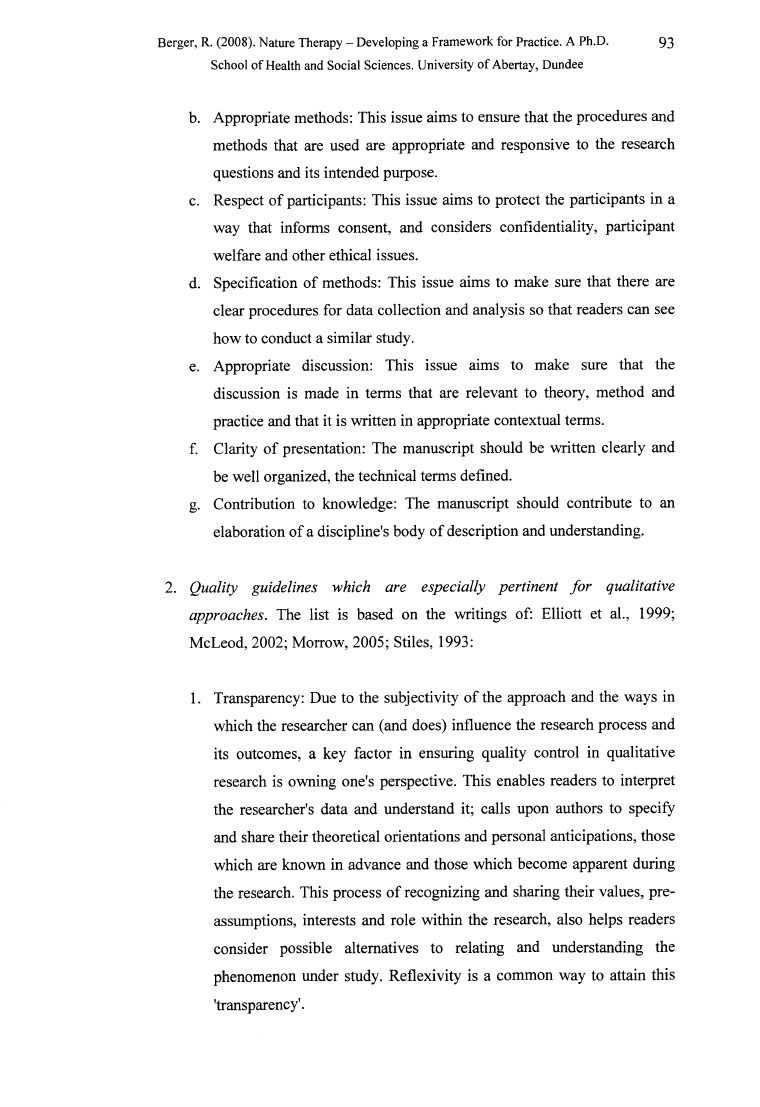
Berger, R. (2008). Nature Therapy - Developing a Framework for Practice. A Ph.D.
93
School of Health and Social Sciences. University of Abertay, Dundee
b. Appropriate methods: This issue aims to ensure that the procedures and
methods that are used are appropriate and responsive to the research
questions and its intended purpose.
c. Respect of participants: This issue aims to protect the participants in a
way that informs consent, and considers confidentiality, participant
welfare and other ethical issues.
d. Specification of methods: This issue aims to make sure that there are
clear procedures for data collection and analysis so that readers can see
how to conduct a similar study.
e. Appropriate discussion: This issue aims to make sure that the
discussion is made in terms that are relevant to theory, method and
practice and that it is written in appropriate contextual terms.
f. Clarity of presentation: The manuscript should be written clearly and
be well organized, the technical terms defined.
g. Contribution to knowledge: The manuscript should contribute to an
elaboration of a discipline's body of description and understanding.
2. Q u a lity g u id e lin e s w h ic h a r e e s p e c ia lly p e r tin e n t f o r q u a lita tiv e
a p p ro a c h e s. The list is based on the writings of: Elliott et al., 1999;
McLeod, 2002; Morrow, 2005; Stiles, 1993:
1. Transparency: Due to the subjectivity of the approach and the ways in
which the researcher can (and does) influence the research process and
its outcomes, a key factor in ensuring quality control in qualitative
research is owning one's perspective. This enables readers to interpret
the researcher's data and understand it; calls upon authors to specify
and share their theoretical orientations and personal anticipations, those
which are known in advance and those which become apparent during
the research. This process of recognizing and sharing their values, pre
assumptions, interests and role within the research, also helps readers
consider possible alternatives to relating and understanding the
phenomenon under study. Reflexivity is a common way to attain this
'transparency'.
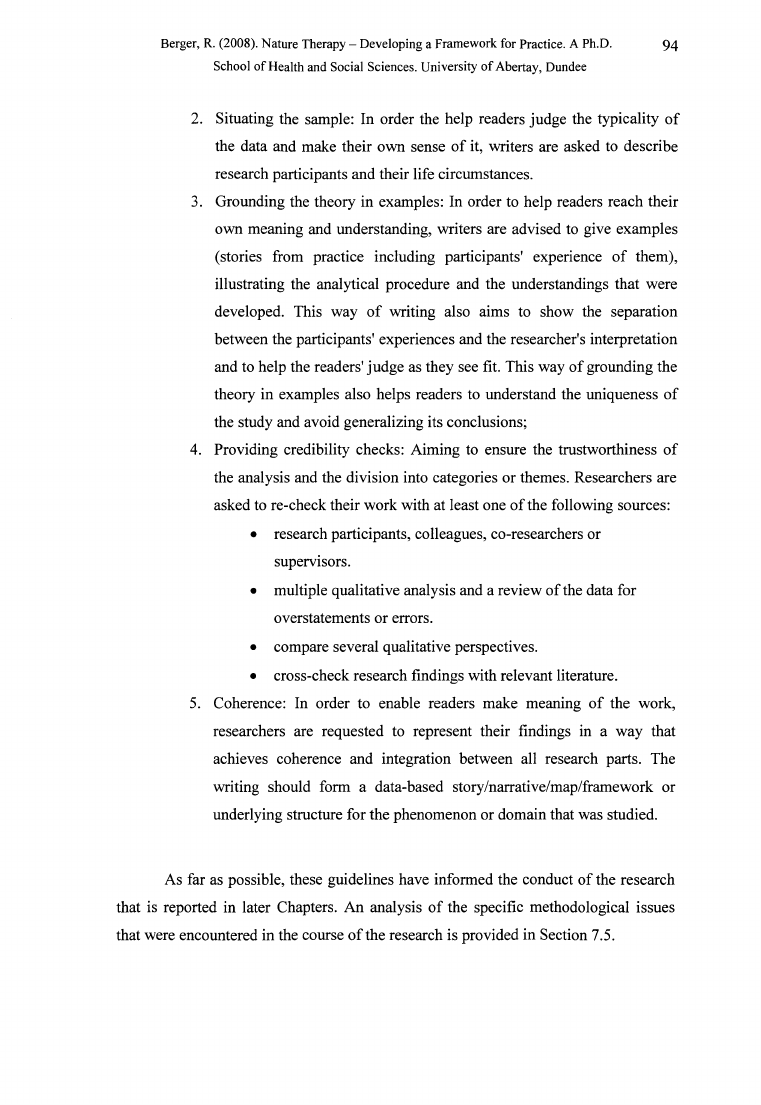
Berger, R. (2008). Nature Therapy - Developing a Framework for Practice. A Ph.D.
94
School of Health and Social Sciences. University of Abertay, Dundee
2. Situating the sample: In order the help readers judge the typicality of
the data and make their own sense of it, writers are asked to describe
research participants and their life circumstances.
3. Grounding the theory in examples: In order to help readers reach their
own meaning and understanding, writers are advised to give examples
(stories from practice including participants' experience of them),
illustrating the analytical procedure and the understandings that were
developed. This way of writing also aims to show the separation
between the participants' experiences and the researcher's interpretation
and to help the readers' judge as they see fit. This way of grounding the
theory in examples also helps readers to understand the uniqueness of
the study and avoid generalizing its conclusions;
4. Providing credibility checks: Aiming to ensure the trustworthiness of
the analysis and the division into categories or themes. Researchers are
asked to re-check their work with at least one of the following sources:
• research participants, colleagues, co-researchers or
supervisors.
• multiple qualitative analysis and a review of the data for
overstatements or errors.
• compare several qualitative perspectives.
• cross-check research findings with relevant literature.
5. Coherence: In order to enable readers make meaning of the work,
researchers are requested to represent their findings in a way that
achieves coherence and integration between all research parts. The
writing should form a data-based story/narrative/map/framework or
underlying structure for the phenomenon or domain that was studied.
As far as possible, these guidelines have informed the conduct of the research
that is reported in later Chapters. An analysis of the specific methodological issues
that were encountered in the course of the research is provided in Section 7.5.
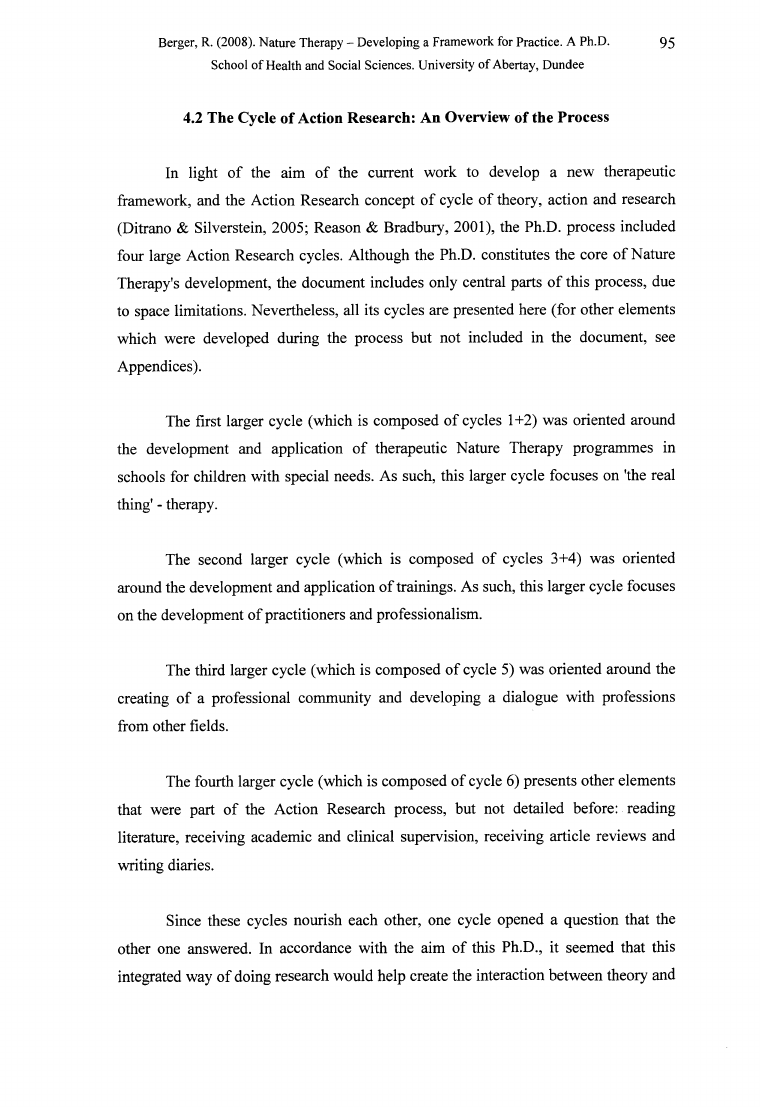
Berger, R. (2008). Nature Therapy - Developing a Framework for Practice. A Ph.D.
95
School of Health and Social Sciences. University of Abertay, Dundee
4.2 The Cycle of Action Research: An Overview of the Process
In light of the aim of the current work to develop a new therapeutic
framework, and the Action Research concept of cycle of theory, action and research
(Ditrano & Silverstein, 2005; Reason & Bradbury, 2001), the Ph.D. process included
four large Action Research cycles. Although the Ph.D. constitutes the core of Nature
Therapy's development, the document includes only central parts of this process, due
to space limitations. Nevertheless, all its cycles are presented here (for other elements
which were developed during the process but not included in the document, see
Appendices).
The first larger cycle (which is composed of cycles 1+2) was oriented around
the development and application of therapeutic Nature Therapy programmes in
schools for children with special needs. As such, this larger cycle focuses on 'the real
thing' - therapy.
The second larger cycle (which is composed of cycles 3+4) was oriented
around the development and application of trainings. As such, this larger cycle focuses
on the development of practitioners and professionalism.
The third larger cycle (which is composed of cycle 5) was oriented around the
creating of a professional community and developing a dialogue with professions
from other fields.
The fourth larger cycle (which is composed of cycle 6) presents other elements
that were part of the Action Research process, but not detailed before: reading
literature, receiving academic and clinical supervision, receiving article reviews and
writing diaries.
Since these cycles nourish each other, one cycle opened a question that the
other one answered. In accordance with the aim of this Ph.D., it seemed that this
integrated way of doing research would help create the interaction between theory and
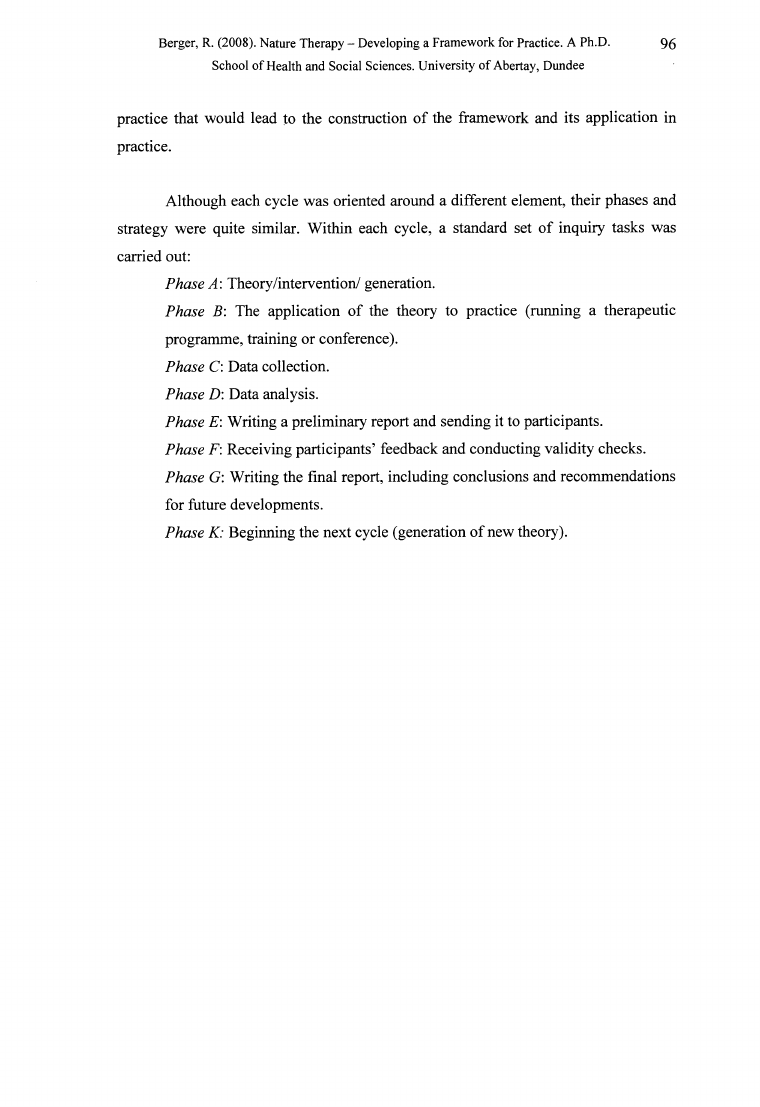
Berger, R. (2008). Nature Therapy - Developing a Framework for Practice. A Ph.D.
96
School of Health and Social Sciences. University of Abertay, Dundee
practice that would lead to the construction of the framework and its application in
practice.
Although each cycle was oriented around a different element, their phases and
strategy were quite similar. Within each cycle, a standard set of inquiry tasks was
carried out:
Phase A: Theory/intervention/ generation.
Phase B: The application of the theory to practice (running a therapeutic
programme, training or conference).
Phase C: Data collection.
Phase D: Data analysis.
Phase E: Writing a preliminary report and sending it to participants.
Phase F: Receiving participants’ feedback and conducting validity checks.
Phase G: Writing the final report, including conclusions and recommendations
for future developments.
Phase K: Beginning the next cycle (generation of new theory).
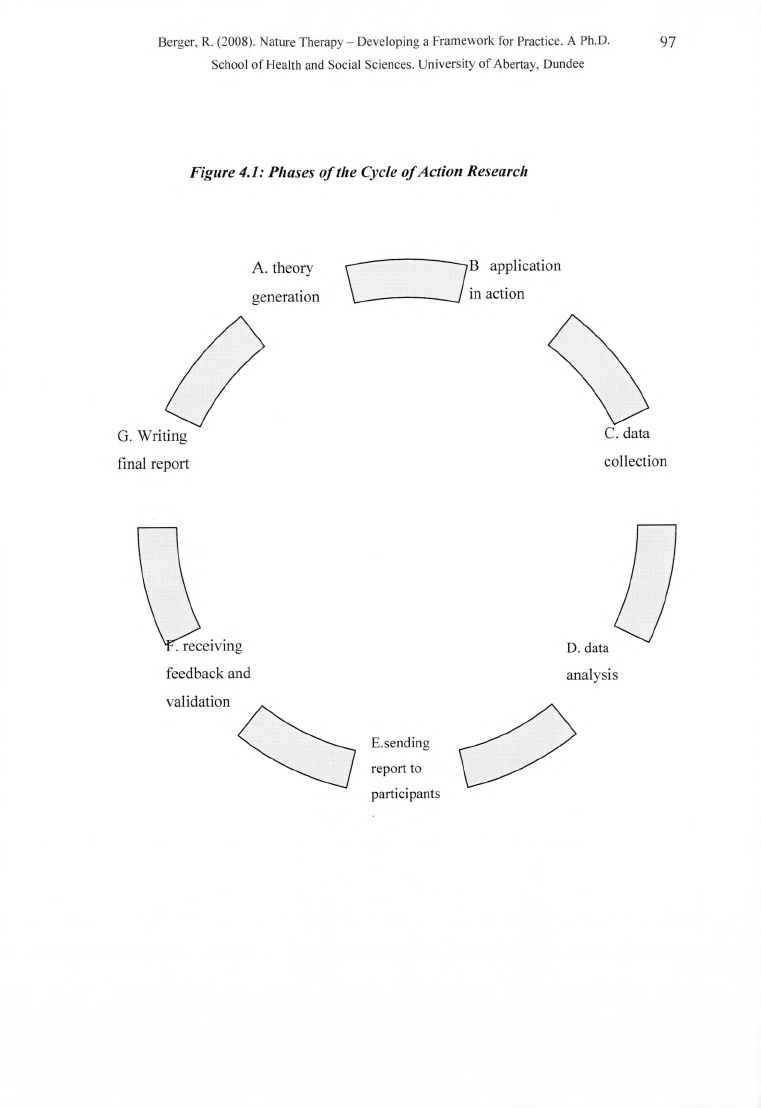
Berger, R. (2008). Nature Therapy - Developing a Framework for Practice. A Ph.D.
97
School of Health and Social Sciences. University of Abertay, Dundee
F igu re 4.1: P h a ses o f the C ycle o f A ctio n R esearch
A. theory
generation
B application
in action
G. Writing
final report
validation
E.sending
report to
participants
analysis
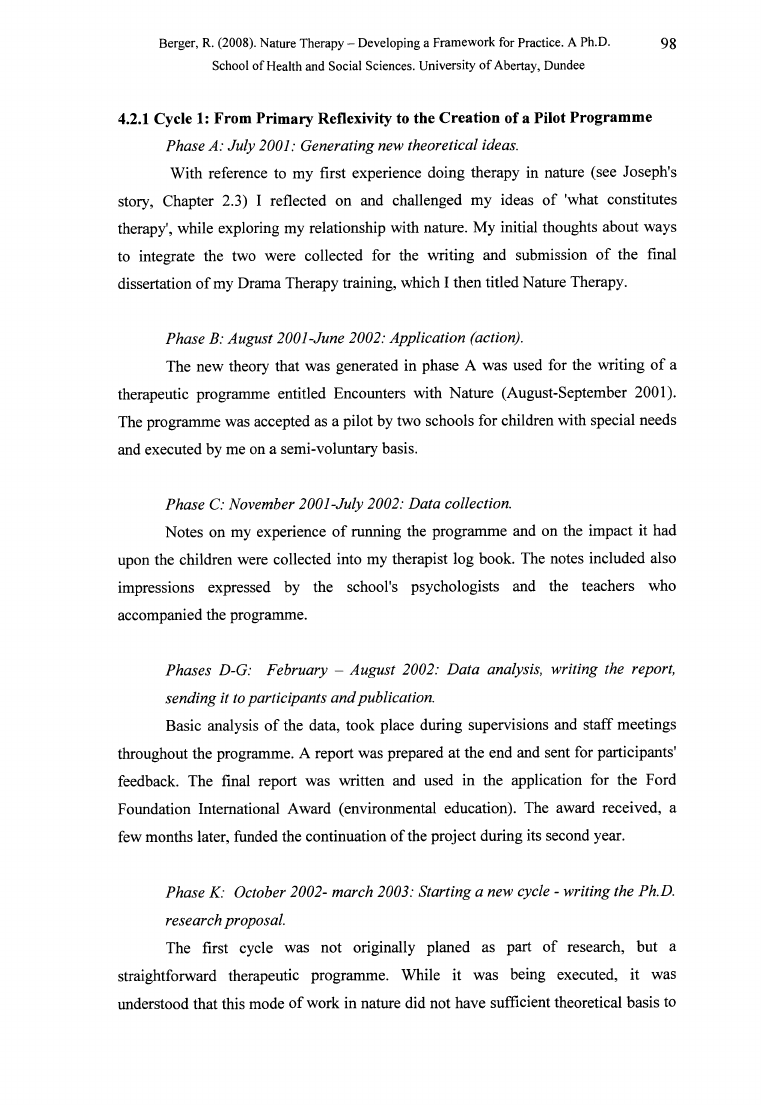
Berger, R. (2008). Nature Therapy - Developing a Framework for Practice. A Ph.D.
98
School of Health and Social Sciences. University of Abertay, Dundee
4.2.1 Cycle 1: From Primary Reflexivity to the Creation of a Pilot Programme
P hase A: July 2001: G enerating new theoretical ideas.
With reference to my first experience doing therapy in nature (see Joseph's
story, Chapter 2.3) I reflected on and challenged my ideas of 'what constitutes
therapy', while exploring my relationship with nature. My initial thoughts about ways
to integrate the two were collected for the writing and submission of the final
dissertation of my Drama Therapy training, which I then titled Nature Therapy.
P hase B: A ugust 2001-June 2002: A pplication (action).
The new theory that was generated in phase A was used for the writing of a
therapeutic programme entitled Encounters with Nature (August-September 2001).
The programme was accepted as a pilot by two schools for children with special needs
and executed by me on a semi-voluntary basis.
P hase C: N ovem ber 200 1 -July 2002: D ata collection.
Notes on my experience of running the programme and on the impact it had
upon the children were collected into my therapist log book. The notes included also
impressions expressed by the school's psychologists and the teachers who
accompanied the programme.
P h a ses D -G : F ebru ary - A u gu st 2002: D a ta analysis, w ritin g the report,
sendin g it to p articipan ts a n d publication.
Basic analysis of the data, took place during supervisions and staff meetings
throughout the programme. A report was prepared at the end and sent for participants'
feedback. The final report was written and used in the application for the Ford
Foundation International Award (environmental education). The award received, a
few months later, funded the continuation of the project during its second year.
P h ase K : O ctober 2 0 0 2 - m arch 2003: S ta rtin g a new cycle - w ritin g the P h.D .
research proposal.
The first cycle was not originally planed as part of research, but a
straightforward therapeutic programme. While it was being executed, it was
understood that this mode of work in nature did not have sufficient theoretical basis to
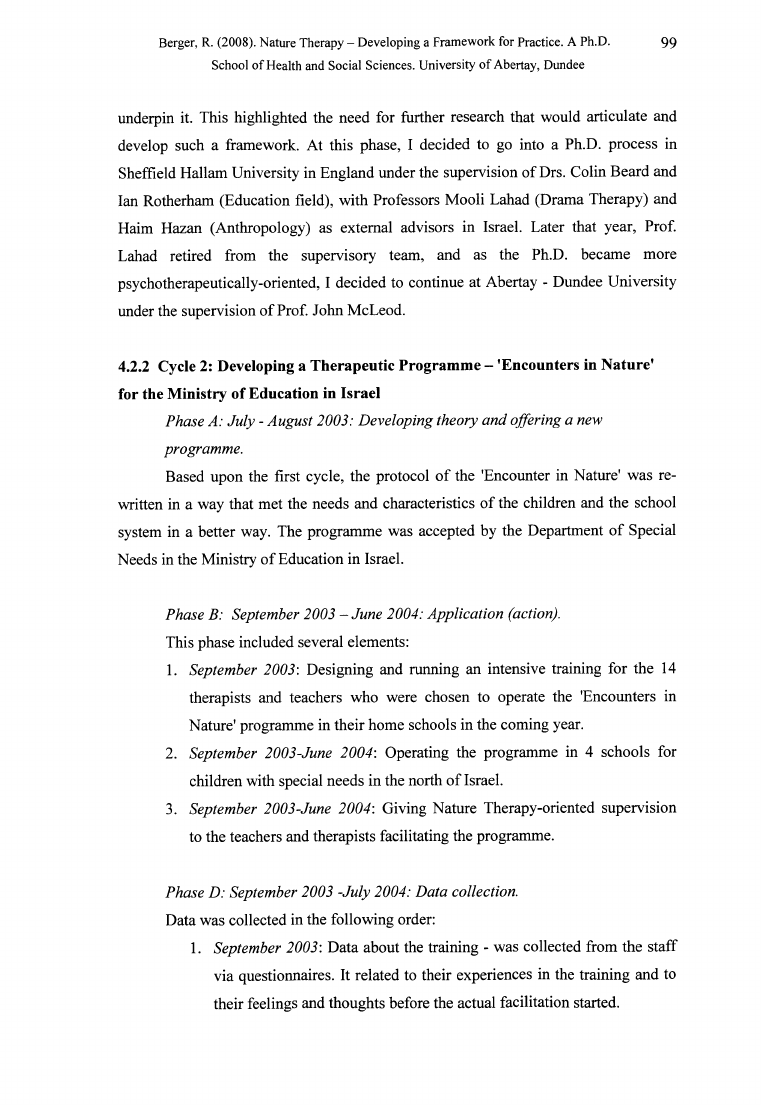
Berger, R. (2008). Nature Therapy - Developing a Framework for Practice. A Ph.D.
99
School of Health and Social Sciences. University of Abertay, Dundee
underpin it. This highlighted the need for further research that would articulate and
develop such a framework. At this phase, I decided to go into a Ph.D. process in
Sheffield Hallam University in England under the supervision of Drs. Colin Beard and
Ian Rotherham (Education field), with Professors Mooli Lahad (Drama Therapy) and
Haim Hazan (Anthropology) as external advisors in Israel. Later that year, Prof.
Lahad retired from the supervisory team, and as the Ph.D. became more
psychotherapeutically-oriented, I decided to continue at Abertay - Dundee University
under the supervision of Prof. John McLeod.
4.2.2 Cycle 2: Developing a Therapeutic Programme - ’Encounters in Nature’
for the Ministry of Education in Israel
P hase A: July - A ugust 2003: D evelopin g th eory an d offering a new
program m e.
Based upon the first cycle, the protocol of the 'Encounter in Nature' was re
written in a way that met the needs and characteristics of the children and the school
system in a better way. The programme was accepted by the Department of Special
Needs in the Ministry of Education in Israel.
P hase B: Septem ber 2003 - June 2004: A p p lica tio n (action).
This phase included several elements:
1. S e p te m b e r 2 0 0 3 : Designing and running an intensive training for the 14
therapists and teachers who were chosen to operate the 'Encounters in
Nature' programme in their home schools in the coming year.
2. S e p te m b e r 2 0 0 3 -June 2 0 0 4 : Operating the programme in 4 schools for
children with special needs in the north of Israel.
3. S e p te m b e r 2 0 0 3 -June 2 0 0 4 : Giving Nature Therapy-oriented supervision
to the teachers and therapists facilitating the programme.
P hase D : Septem ber 2003 -July 2004: D ata collection.
Data was collected in the following order:
1. S e p te m b e r 2 0 0 3 : Data about the training - was collected from the staff
via questionnaires. It related to their experiences in the training and to
their feelings and thoughts before the actual facilitation started.
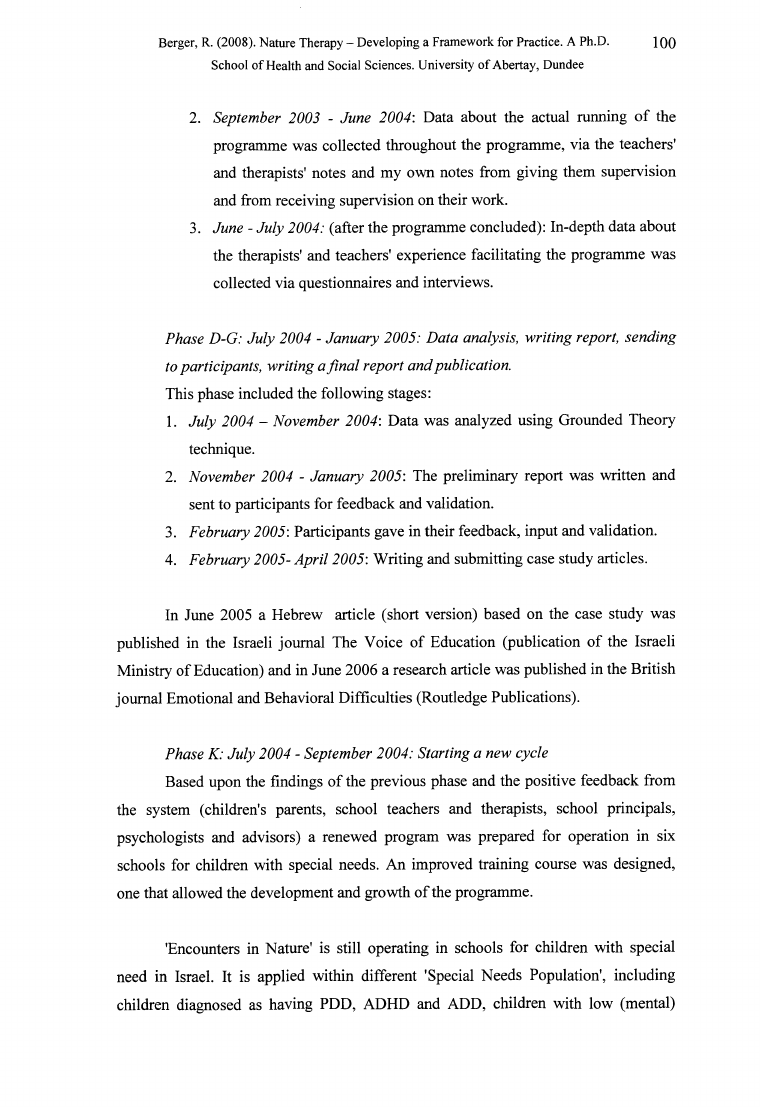
Berger, R. (2008). Nature Therapy - Developing a Framework for Practice. A Ph.D.
100
School of Health and Social Sciences. University of Abertay, Dundee
2. S e p te m b e r 2 0 0 3 - Ju n e 2 0 0 4 : Data about the actual running of the
programme was collected throughout the programme, via the teachers'
and therapists' notes and my own notes from giving them supervision
and from receiving supervision on their work.
3. Ju n e - J u ly 2 0 0 4 : (after the programme concluded): In-depth data about
the therapists' and teachers' experience facilitating the programme was
collected via questionnaires and interviews.
Phase D -G : July 2004 - January 2005: D ata analysis, w ritin g report, sen din g
to participan ts, w ritin g a fin a l rep o rt a n d publication.
This phase included the following stages:
1. J u ly 2 0 0 4 - N o v e m b e r 2 0 0 4 : Data was analyzed using Grounded Theory
technique.
2. N o v e m b e r 2 0 0 4 - J a n u a ry 2 0 0 5 : The preliminary report was written and
sent to participants for feedback and validation.
3. F e b ru a ry 2 0 0 5 : Participants gave in their feedback, input and validation.
4. F e b r u a r y 2 0 0 5 - A p r il 2 0 0 5 : Writing and submitting case study articles.
In June 2005 a Hebrew article (short version) based on the case study was
published in the Israeli journal The Voice of Education (publication of the Israeli
Ministry of Education) and in June 2006 a research article was published in the British
journal Emotional and Behavioral Difficulties (Routledge Publications).
Phase K: July 2004 - Septem ber 2004: Starting a new cycle
Based upon the findings of the previous phase and the positive feedback from
the system (children's parents, school teachers and therapists, school principals,
psychologists and advisors) a renewed program was prepared for operation in six
schools for children with special needs. An improved training course was designed,
one that allowed the development and growth of the programme.
'Encounters in Nature' is still operating in schools for children with special
need in Israel. It is applied within different 'Special Needs Population', including
children diagnosed as having PDD, ADHD and ADD, children with low (mental)
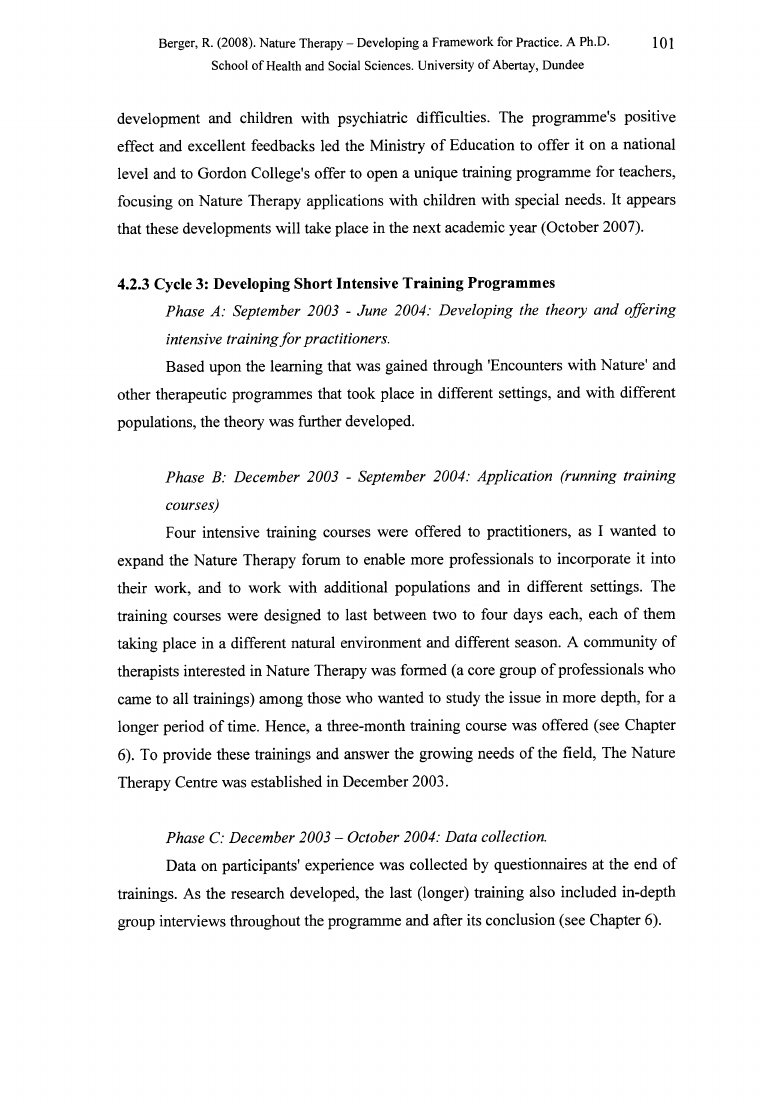
Berger, R. (2008). Nature Therapy - Developing a Framework for Practice. A Ph.D.
101
School of Health and Social Sciences. University of Abertay, Dundee
development and children with psychiatric difficulties. The programme's positive
effect and excellent feedbacks led the Ministry of Education to offer it on a national
level and to Gordon College's offer to open a unique training programme for teachers,
focusing on Nature Therapy applications with children with special needs. It appears
that these developments will take place in the next academic year (October 2007).
4.2.3 Cycle 3: Developing Short Intensive Training Programmes
P hase A: Septem ber 2003 -June 2004: D evelo p in g the th eory a n d offering
intensive training fo r practition ers.
Based upon the learning that was gained through 'Encounters with Nature' and
other therapeutic programmes that took place in different settings, and with different
populations, the theory was further developed.
P hase B: D ecem ber 2003 - Septem ber 2004: A pplication (running training
courses)
Four intensive training courses were offered to practitioners, as I wanted to
expand the Nature Therapy forum to enable more professionals to incorporate it into
their work, and to work with additional populations and in different settings. The
training courses were designed to last between two to four days each, each of them
taking place in a different natural environment and different season. A community of
therapists interested in Nature Therapy was formed (a core group of professionals who
came to all trainings) among those who wanted to study the issue in more depth, for a
longer period of time. Hence, a three-month training course was offered (see Chapter
6). To provide these trainings and answer the growing needs of the field, The Nature
Therapy Centre was established in December 2003.
P hase C: D ecem ber 2003 — O ctober 2004: D ata collection.
Data on participants' experience was collected by questionnaires at the end of
trainings. As the research developed, the last (longer) training also included in-depth
group interviews throughout the programme and after its conclusion (see Chapter 6).
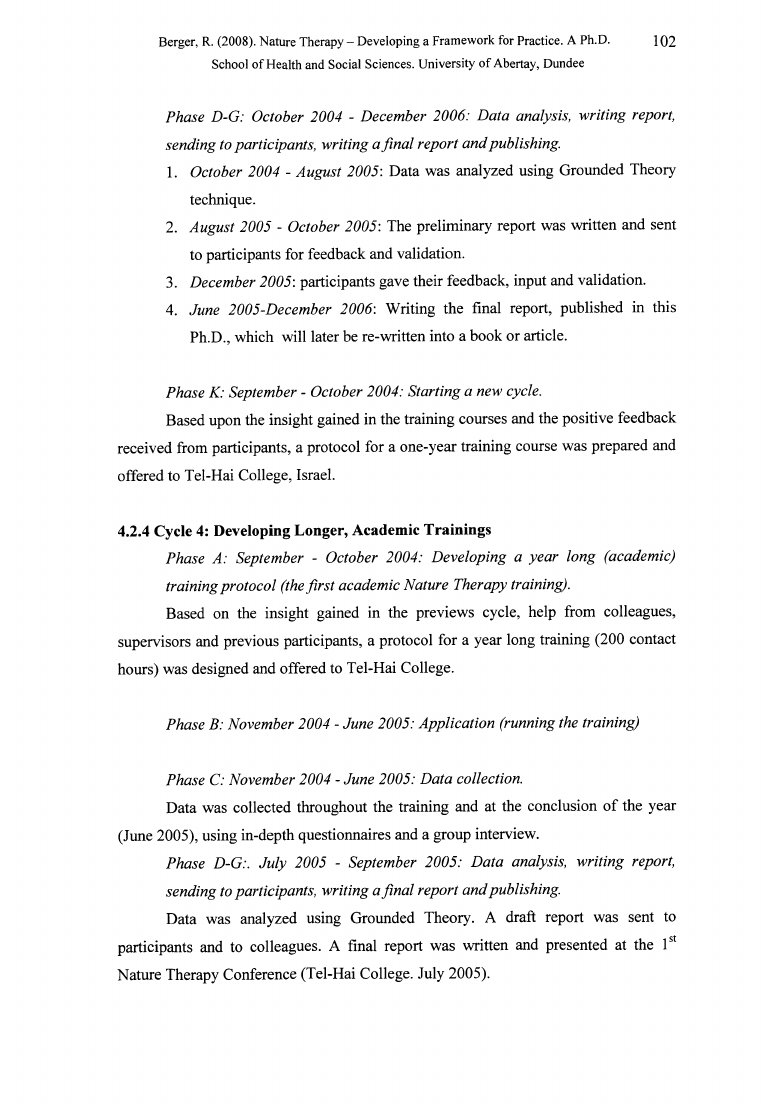
Berger, R. (2008). Nature Therapy —Developing a Framework for Practice. A Ph.D.
102
School of Health and Social Sciences. University of Abertay, Dundee
P hase D -G : O ctober 2004 - D ecem ber 2006: D ata analysis, w ritin g report,
sen din g to p articipan ts, w ritin g a fin a l rep o rt a n d publishing.
1. O c to b e r 2 0 0 4 - A u g u st 2 0 0 5 : Data was analyzed using Grounded Theory
technique.
2. A u g u st 2 0 0 5 - O c to b e r 2 0 0 5 : The preliminary report was written and sent
to participants for feedback and validation.
3. D e c e m b e r 2 0 0 5 : participants gave their feedback, input and validation.
4. J u n e 2 0 0 5 -D e c e m b e r 2 0 0 6 : Writing the final report, published in this
Ph.D., which will later be re-written into a book or article.
P hase K : Septem ber - O ctober 2004: S tartin g a new cycle.
Based upon the insight gained in the training courses and the positive feedback
received from participants, a protocol for a one-year training course was prepared and
offered to Tel-Hai College, Israel.
4.2.4 Cycle 4: Developing Longer, Academic Trainings
P hase A: Septem ber - O ctober 2004: D evelopin g a ye a r long (academ ic)
train in g p r o to c o l (the f ir s t a ca d em ic N atu re T herapy training).
Based on the insight gained in the previews cycle, help from colleagues,
supervisors and previous participants, a protocol for a year long training (200 contact
hours) was designed and offered to Tel-Hai College.
P hase B: N ovem ber 20 0 4 - June 2005: A pp lica tio n (running the training)
P hase C: N ovem ber 2004 - June 2005: D a ta collection.
Data was collected throughout the training and at the conclusion of the year
(June 2005), using in-depth questionnaires and a group interview.
P hase D -G :. July 2005 - Septem ber 2005: D a ta analysis, w ritin g report,
sen din g to participan ts, w ritin g a fin a l rep o rt a n d publishing.
Data was analyzed using Grounded Theory. A draft report was sent to
participants and to colleagues. A final report was written and presented at the 1st
Nature Therapy Conference (Tel-Hai College. July 2005).
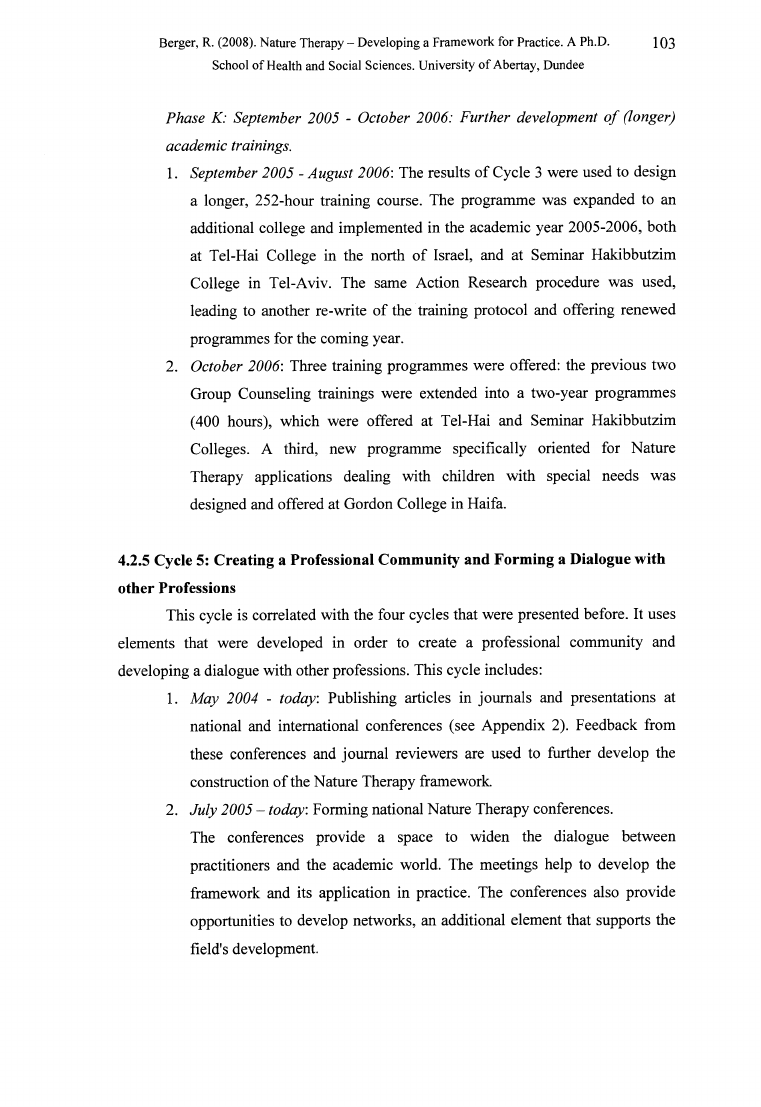
Berger, R. (2008). Nature Therapy - Developing a Framework for Practice. A Ph.D.
103
School of Health and Social Sciences. University of Abertay, Dundee
P hase K : Septem ber 2005 - O ctober 2006: F urther developm ent o f (longer)
academ ic trainings.
1. S e p te m b e r 2 0 0 5 - A u g u st 2 0 0 6 : The results of Cycle 3 were used to design
a longer, 252-hour training course. The programme was expanded to an
additional college and implemented in the academic year 2005-2006, both
at Tel-Hai College in the north of Israel, and at Seminar Hakibbutzim
College in Tel-Aviv. The same Action Research procedure was used,
leading to another re-write of the training protocol and offering renewed
programmes for the coming year.
2. O c to b e r 20 0 6 : Three training programmes were offered: the previous two
Group Counseling trainings were extended into a two-year programmes
(400 hours), which were offered at Tel-Hai and Seminar Hakibbutzim
Colleges. A third, new programme specifically oriented for Nature
Therapy applications dealing with children with special needs was
designed and offered at Gordon College in Haifa.
4.2.5 Cycle 5: Creating a Professional Community and Forming a Dialogue with
other Professions
This cycle is correlated with the four cycles that were presented before. It uses
elements that were developed in order to create a professional community and
developing a dialogue with other professions. This cycle includes:
1. M a y 2 0 0 4 - to d a y: Publishing articles in journals and presentations at
national and international conferences (see Appendix 2). Feedback from
these conferences and journal reviewers are used to further develop the
construction of the Nature Therapy framework
2. J u ly 2 0 0 5 - to d a y: Forming national Nature Therapy conferences.
The conferences provide a space to widen the dialogue between
practitioners and the academic world. The meetings help to develop the
framework and its application in practice. The conferences also provide
opportunities to develop networks, an additional element that supports the
field's development.
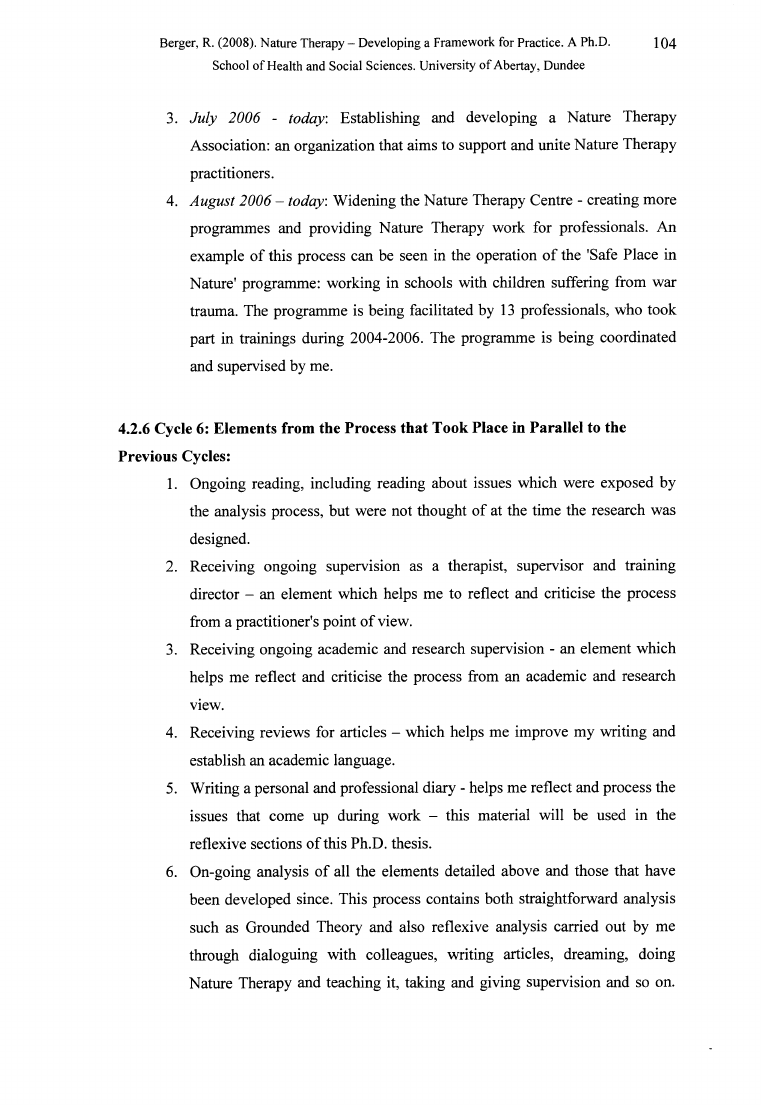
Berger, R. (2008). Nature Therapy - Developing a Framework for Practice. A Ph.D.
104
School of Health and Social Sciences. University of Abertay, Dundee
3. J u ly 2006 - to d a y : Establishing and developing a Nature Therapy
Association: an organization that aims to support and unite Nature Therapy
practitioners.
4. A u g u st 2006 - to d a y : Widening the Nature Therapy Centre - creating more
programmes and providing Nature Therapy work for professionals. An
example of this process can be seen in the operation of the 'Safe Place in
Nature' programme: working in schools with children suffering from war
trauma. The programme is being facilitated by 13 professionals, who took
part in trainings during 2004-2006. The programme is being coordinated
and supervised by me.
4.2.6 Cycle 6: Elements from the Process that Took Place in Parallel to the
Previous Cycles:
1. Ongoing reading, including reading about issues which were exposed by
the analysis process, but were not thought of at the time the research was
designed.
2. Receiving ongoing supervision as a therapist, supervisor and training
director - an element which helps me to reflect and criticise the process
from a practitioner's point of view.
3. Receiving ongoing academic and research supervision - an element which
helps me reflect and criticise the process from an academic and research
view.
4. Receiving reviews for articles - which helps me improve my writing and
establish an academic language.
5. Writing a personal and professional diary - helps me reflect and process the
issues that come up during work - this material will be used in the
reflexive sections of this Ph.D. thesis.
6. On-going analysis of all the elements detailed above and those that have
been developed since. This process contains both straightforward analysis
such as Grounded Theory and also reflexive analysis carried out by me
through dialoguing with colleagues, writing articles, dreaming, doing
Nature Therapy and teaching it, taking and giving supervision and so on.
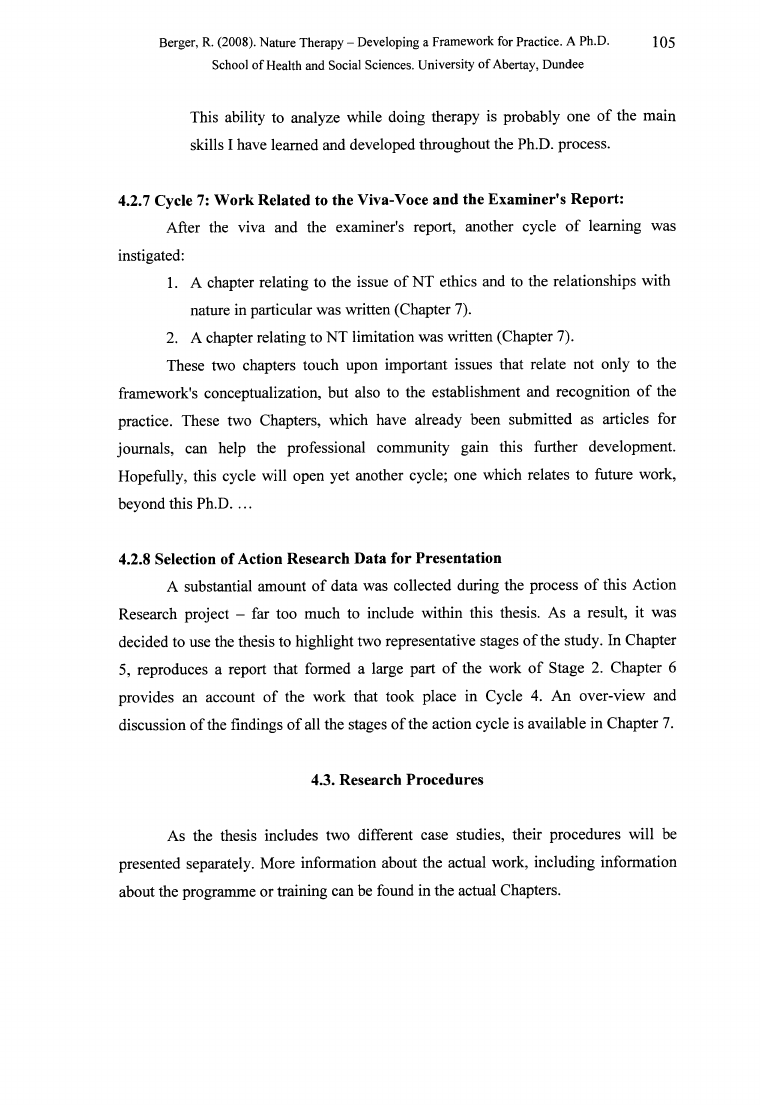
Berger, R. (2008). Nature Therapy - Developing a Framework for Practice. A Ph.D.
105
School of Health and Social Sciences. University of Abertay, Dundee
This ability to analyze while doing therapy is probably one of the main
skills I have learned and developed throughout the Ph.D. process.
4.2.7 Cycle 7: Work Related to the Viva-Voce and the Examiner’s Report:
After the viva and the examiner's report, another cycle of learning was
instigated:
1. A chapter relating to the issue of NT ethics and to the relationships with
nature in particular was written (Chapter 7).
2. A chapter relating to NT limitation was written (Chapter 7).
These two chapters touch upon important issues that relate not only to the
framework's conceptualization, but also to the establishment and recognition of the
practice. These two Chapters, which have already been submitted as articles for
journals, can help the professional community gain this further development.
Hopefully, this cycle will open yet another cycle; one which relates to future work,
beyond this Ph.D. ...
4.2.8 Selection of Action Research Data for Presentation
A substantial amount of data was collected during the process of this Action
Research project - far too much to include within this thesis. As a result, it was
decided to use the thesis to highlight two representative stages of the study. In Chapter
5, reproduces a report that formed a large part of the work of Stage 2. Chapter 6
provides an account of the work that took place in Cycle 4. An over-view and
discussion of the findings of all the stages of the action cycle is available in Chapter 7.
4.3. Research Procedures
As the thesis includes two different case studies, their procedures will be
presented separately. More information about the actual work, including information
about the programme or training can be found in the actual Chapters.
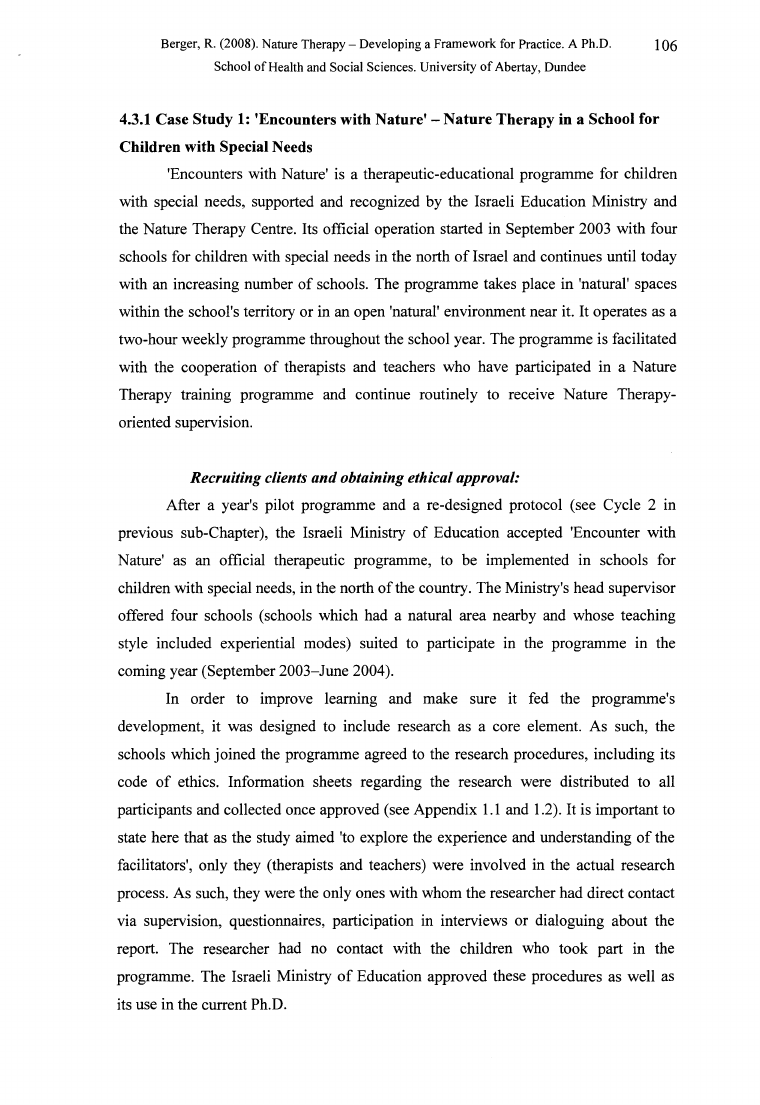
Berger, R. (2008). Nature Therapy - Developing a Framework for Practice. A Ph.D.
106
School of Health and Social Sciences. University of Abertay, Dundee
4.3.1 Case Study 1: ’Encounters with Nature’ - Nature Therapy in a School for
Children with Special Needs
'Encounters with Nature' is a therapeutic-educational programme for children
with special needs, supported and recognized by the Israeli Education Ministry and
the Nature Therapy Centre. Its official operation started in September 2003 with four
schools for children with special needs in the north of Israel and continues until today
with an increasing number of schools. The programme takes place in 'natural' spaces
within the school's territory or in an open 'natural' environment near it. It operates as a
two-hour weekly programme throughout the school year. The programme is facilitated
with the cooperation of therapists and teachers who have participated in a Nature
Therapy training programme and continue routinely to receive Nature Therapy-
oriented supervision.
Recruiting clients and obtaining ethical approval:
After a year's pilot programme and a re-designed protocol (see Cycle 2 in
previous sub-Chapter), the Israeli Ministry of Education accepted 'Encounter with
Nature' as an official therapeutic programme, to be implemented in schools for
children with special needs, in the north of the country. The Ministry's head supervisor
offered four schools (schools which had a natural area nearby and whose teaching
style included experiential modes) suited to participate in the programme in the
coming year (September 2003-June 2004).
In order to improve learning and make sure it fed the programme's
development, it was designed to include research as a core element. As such, the
schools which joined the programme agreed to the research procedures, including its
code of ethics. Information sheets regarding the research were distributed to all
participants and collected once approved (see Appendix 1.1 and 1.2). It is important to
state here that as the study aimed 'to explore the experience and understanding of the
facilitators', only they (therapists and teachers) were involved in the actual research
process. As such, they were the only ones with whom the researcher had direct contact
via supervision, questionnaires, participation in interviews or dialoguing about the
report. The researcher had no contact with the children who took part in the
programme. The Israeli Ministry of Education approved these procedures as well as
its use in the current Ph.D.
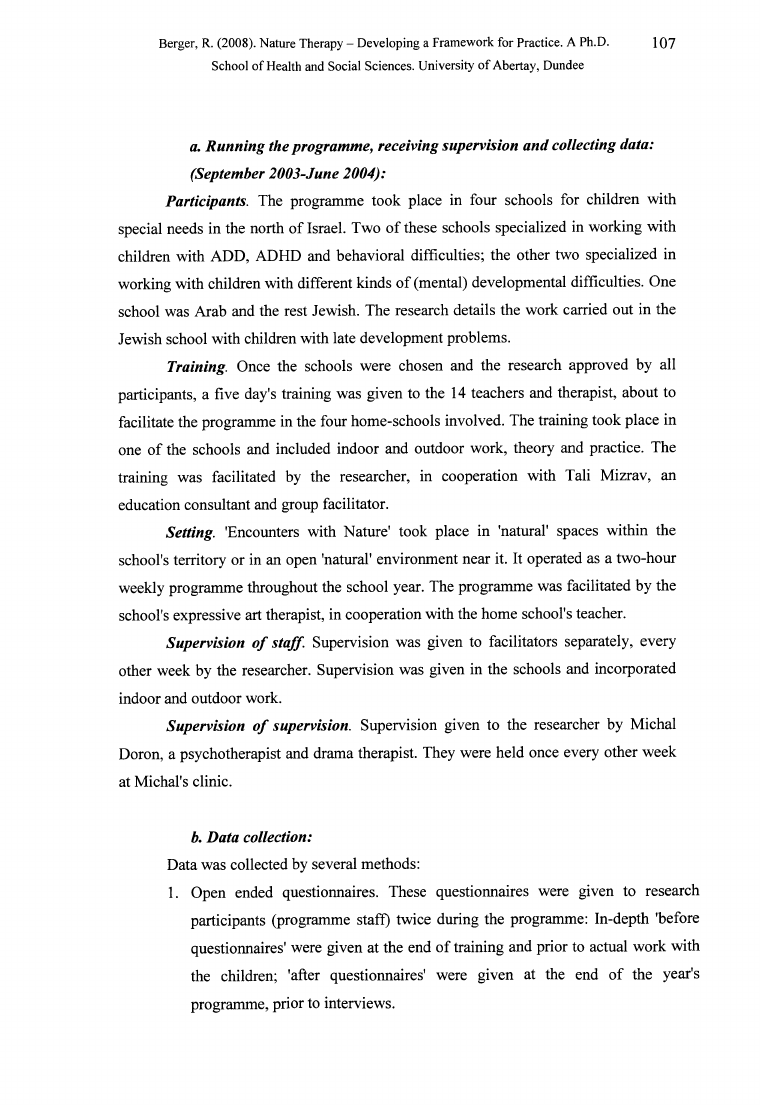
Berger, R. (2008). Nature Therapy - Developing a Framework for Practice. A Ph.D.
107
School of Health and Social Sciences. University of Abertay, Dundee
a. Running the programme, receiving supervision and collecting data:
(September 2003-June 2004):
Participants. The programme took place in four schools for children with
special needs in the north of Israel. Two of these schools specialized in working with
children with ADD, ADHD and behavioral difficulties; the other two specialized in
working with children with different kinds of (mental) developmental difficulties. One
school was Arab and the rest Jewish. The research details the work carried out in the
Jewish school with children with late development problems.
Training. Once the schools were chosen and the research approved by all
participants, a five day's training was given to the 14 teachers and therapist, about to
facilitate the programme in the four home-schools involved. The training took place in
one of the schools and included indoor and outdoor work, theory and practice. The
training was facilitated by the researcher, in cooperation with Tali Mizrav, an
education consultant and group facilitator.
Setting. 'Encounters with Nature' took place in 'natural' spaces within the
school's territory or in an open 'natural' environment near it. It operated as a two-hour
weekly programme throughout the school year. The programme was facilitated by the
school's expressive art therapist, in cooperation with the home school's teacher.
Supervision of staff. Supervision was given to facilitators separately, every
other week by the researcher. Supervision was given in the schools and incorporated
indoor and outdoor work.
Supervision of supervision. Supervision given to the researcher by Michal
Doron, a psychotherapist and drama therapist. They were held once every other week
at Michal's clinic.
b. Data collection:
Data was collected by several methods:
1. Open ended questionnaires. These questionnaires were given to research
participants (programme staff) twice during the programme: In-depth 'before
questionnaires' were given at the end of training and prior to actual work with
the children; 'after questionnaires' were given at the end of the year's
programme, prior to interviews.
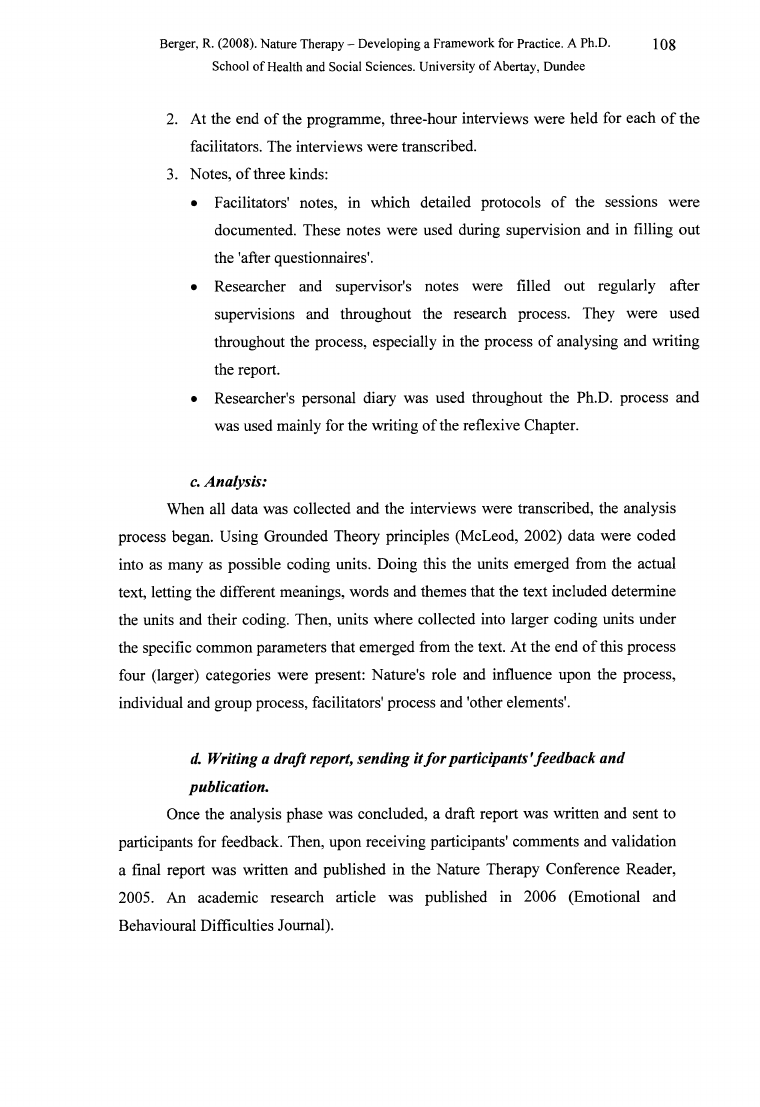
Berger, R. (2008). Nature Therapy - Developing a Framework for Practice. A Ph.D.
108
School of Health and Social Sciences. University of Abertay, Dundee
2. At the end of the programme, three-hour interviews were held for each of the
facilitators. The interviews were transcribed.
3. Notes, of three kinds:
• Facilitators' notes, in which detailed protocols of the sessions were
documented. These notes were used during supervision and in filling out
the 'after questionnaires'.
• Researcher and supervisor's notes were filled out regularly after
supervisions and throughout the research process. They were used
throughout the process, especially in the process of analysing and writing
the report.
• Researcher's personal diary was used throughout the Ph.D. process and
was used mainly for the writing of the reflexive Chapter.
c. Analysis:
When all data was collected and the interviews were transcribed, the analysis
process began. Using Grounded Theory principles (McLeod, 2002) data were coded
into as many as possible coding units. Doing this the units emerged from the actual
text, letting the different meanings, words and themes that the text included determine
the units and their coding. Then, units where collected into larger coding units under
the specific common parameters that emerged from the text. At the end of this process
four (larger) categories were present: Nature's role and influence upon the process,
individual and group process, facilitators' process and 'other elements'.
d. Writing a draft report, sending itfor participants 'feedback and
publication.
Once the analysis phase was concluded, a draft report was written and sent to
participants for feedback. Then, upon receiving participants' comments and validation
a final report was written and published in the Nature Therapy Conference Reader,
2005. An academic research article was published in 2006 (Emotional and
Behavioural Difficulties Journal).
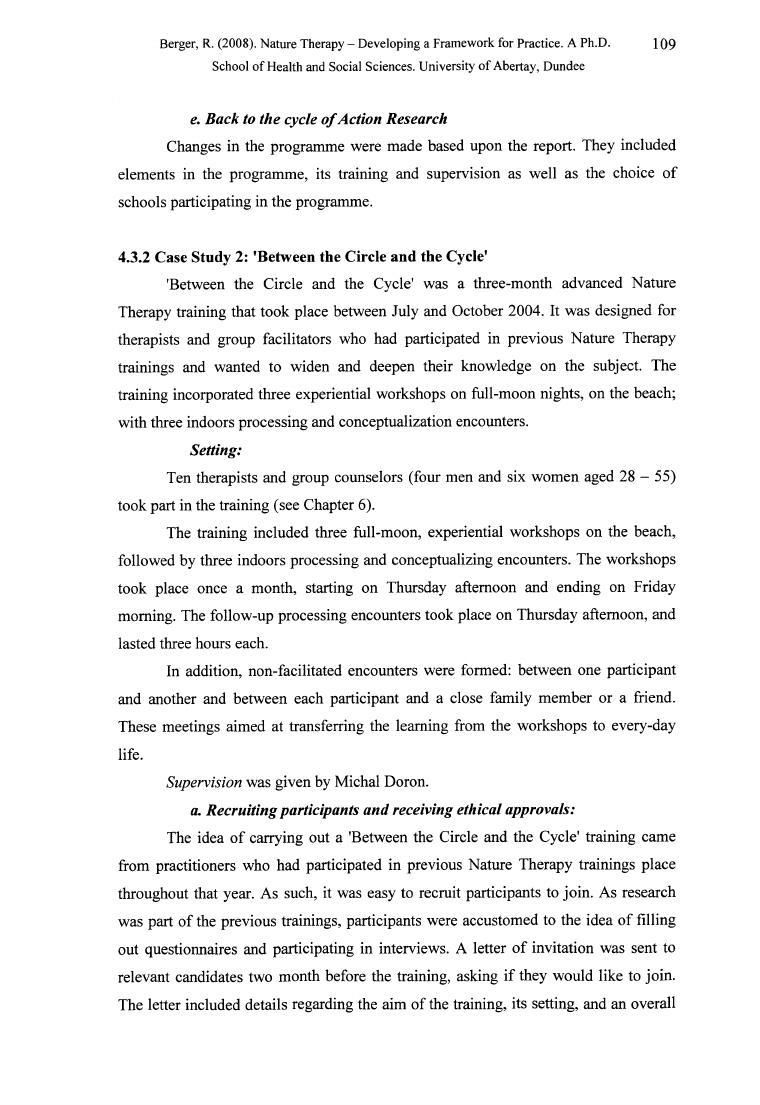
Berger, R. (2008). Nature Therapy - Developing a Framework for Practice. A Ph.D.
109
School of Health and Social Sciences. University of Abertay, Dundee
e. Back to the cycle o fAction Research
Changes in the programme were made based upon the report. They included
elements in the programme, its training and supervision as well as the choice of
schools participating in the programme.
4.3.2 Case Study 2: ’Between the Circle and the Cycle’
'Between the Circle and the Cycle' was a three-month advanced Nature
Therapy training that took place between July and October 2004. It was designed for
therapists and group facilitators who had participated in previous Nature Therapy
trainings and wanted to widen and deepen their knowledge on the subject. The
training incorporated three experiential workshops on full-moon nights, on the beach;
with three indoors processing and conceptualization encounters.
Setting:
Ten therapists and group counselors (four men and six women aged 28 - 55)
took part in the training (see Chapter 6).
The training included three full-moon, experiential workshops on the beach,
followed by three indoors processing and conceptualizing encounters. The workshops
took place once a month, starting on Thursday afternoon and ending on Friday
morning. The follow-up processing encounters took place on Thursday afternoon, and
lasted three hours each.
In addition, non-facilitated encounters were formed: between one participant
and another and between each participant and a close family member or a friend.
These meetings aimed at transferring the learning from the workshops to every-day
life.
Supervision was given by Michal Doron.
a. Recruiting participants and receiving ethical approvals:
The idea of carrying out a 'Between the Circle and the Cycle' training came
from practitioners who had participated in previous Nature Therapy trainings place
throughout that year. As such, it was easy to recruit participants to join. As research
was part of the previous trainings, participants were accustomed to the idea of filling
out questionnaires and participating in interviews. A letter of invitation was sent to
relevant candidates two month before the training, asking if they would like to join.
The letter included details regarding the aim of the training, its setting, and an overall
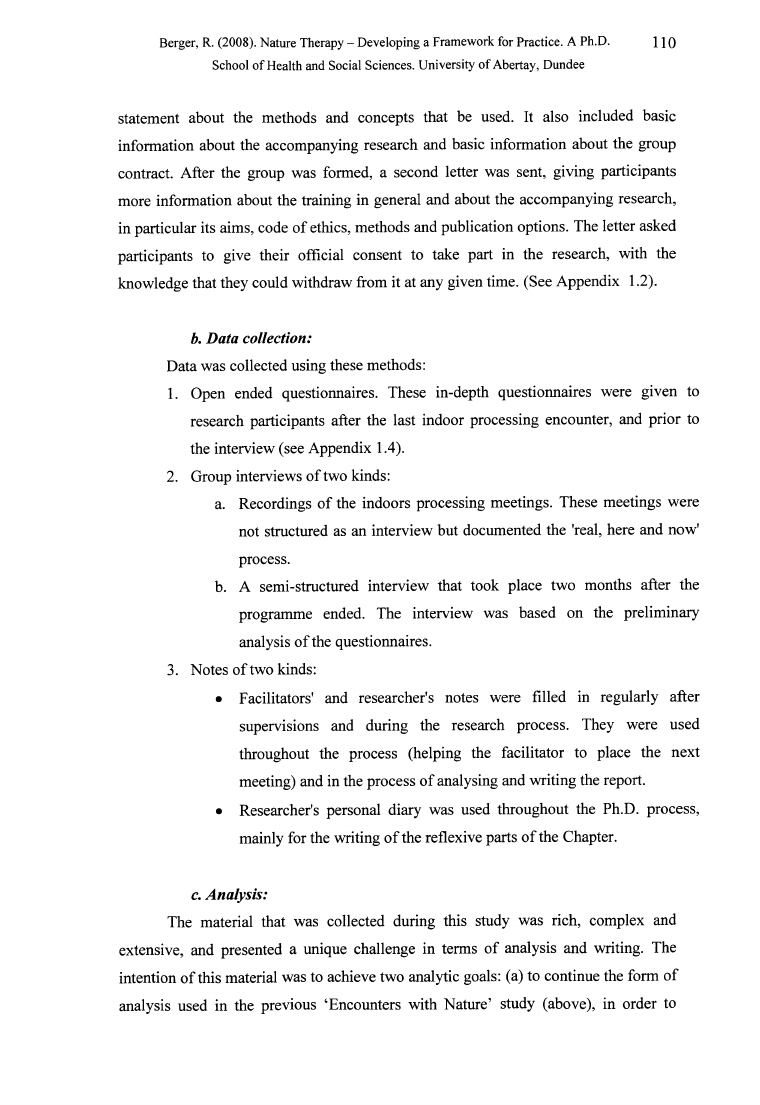
Berger, R. (2008). Nature Therapy - Developing a Framework for Practice. A Ph.D.
110
School of Health and Social Sciences. University of Abertay, Dundee
statement about the methods and concepts that be used. It also included basic
information about the accompanying research and basic information about the group
contract. After the group was formed, a second letter was sent, giving participants
more information about the training in general and about the accompanying research,
in particular its aims, code of ethics, methods and publication options. The letter asked
participants to give their official consent to take part in the research, with the
knowledge that they could withdraw from it at any given time. (See Appendix 1.2).
b. Data collection:
Data was collected using these methods:
1. Open ended questionnaires. These in-depth questionnaires were given to
research participants after the last indoor processing encounter, and prior to
the interview (see Appendix 1.4).
2. Group interviews of two kinds:
a. Recordings of the indoors processing meetings. These meetings were
not structured as an interview but documented the 'real, here and now'
process.
b. A semi-structured interview that took place two months after the
programme ended. The interview was based on the preliminary
analysis of the questionnaires.
3. Notes of two kinds:
• Facilitators' and researcher's notes were filled in regularly after
supervisions and during the research process. They were used
throughout the process (helping the facilitator to place the next
meeting) and in the process of analysing and writing the report.
• Researcher's personal diary was used throughout the Ph.D. process,
mainly for the writing of the reflexive parts of the Chapter.
c. Analysis:
The material that was collected during this study was rich, complex and
extensive, and presented a unique challenge in terms of analysis and writing. The
intention of this material was to achieve two analytic goals: (a) to continue the form of
analysis used in the previous ‘Encounters with Nature’ study (above), in order to
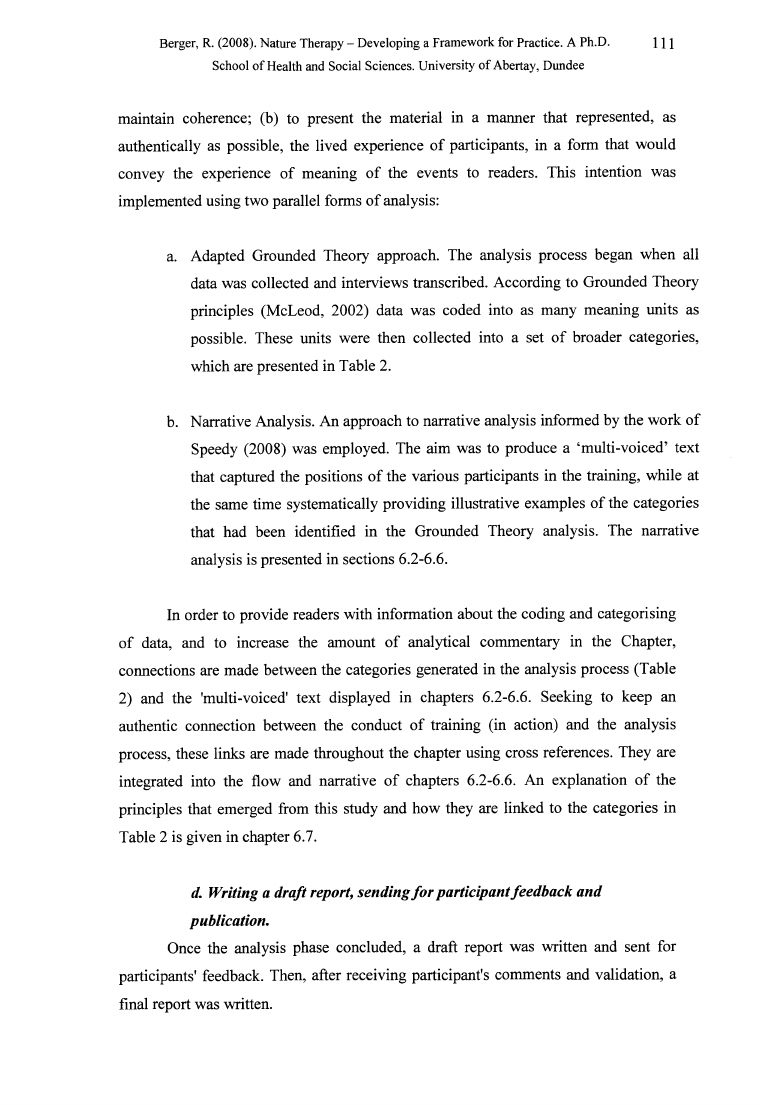
Berger, R. (2008). Nature Therapy - Developing a Framework for Practice. A Ph.D.
Ill
School of Health and Social Sciences. University of Abertay, Dundee
maintain coherence; (b) to present the material in a manner that represented, as
authentically as possible, the lived experience of participants, in a form that would
convey the experience of meaning of the events to readers. This intention was
implemented using two parallel forms of analysis:
a. Adapted Grounded Theory approach. The analysis process began when all
data was collected and interviews transcribed. According to Grounded Theory
principles (McLeod, 2002) data was coded into as many meaning units as
possible. These units were then collected into a set of broader categories,
which are presented in Table 2.
b. Narrative Analysis. An approach to narrative analysis informed by the work of
Speedy (2008) was employed. The aim was to produce a ‘multi-voiced’ text
that captured the positions of the various participants in the training, while at
the same time systematically providing illustrative examples of the categories
that had been identified in the Grounded Theory analysis. The narrative
analysis is presented in sections 6.2-6.6.
In order to provide readers with information about the coding and categorising
of data, and to increase the amount of analytical commentary in the Chapter,
connections are made between the categories generated in the analysis process (Table
2) and the 'multi-voiced' text displayed in chapters 6.2-6.6. Seeking to keep an
authentic connection between the conduct of training (in action) and the analysis
process, these links are made throughout the chapter using cross references. They are
integrated into the flow and narrative of chapters 6.2-6.6. An explanation of the
principles that emerged from this study and how they are linked to the categories in
Table 2 is given in chapter 6.7.
d. Writing a draft report, sendingfor participantfeedback and
publication.
Once the analysis phase concluded, a draft report was written and sent for
participants' feedback. Then, after receiving participant's comments and validation, a
final report was written.
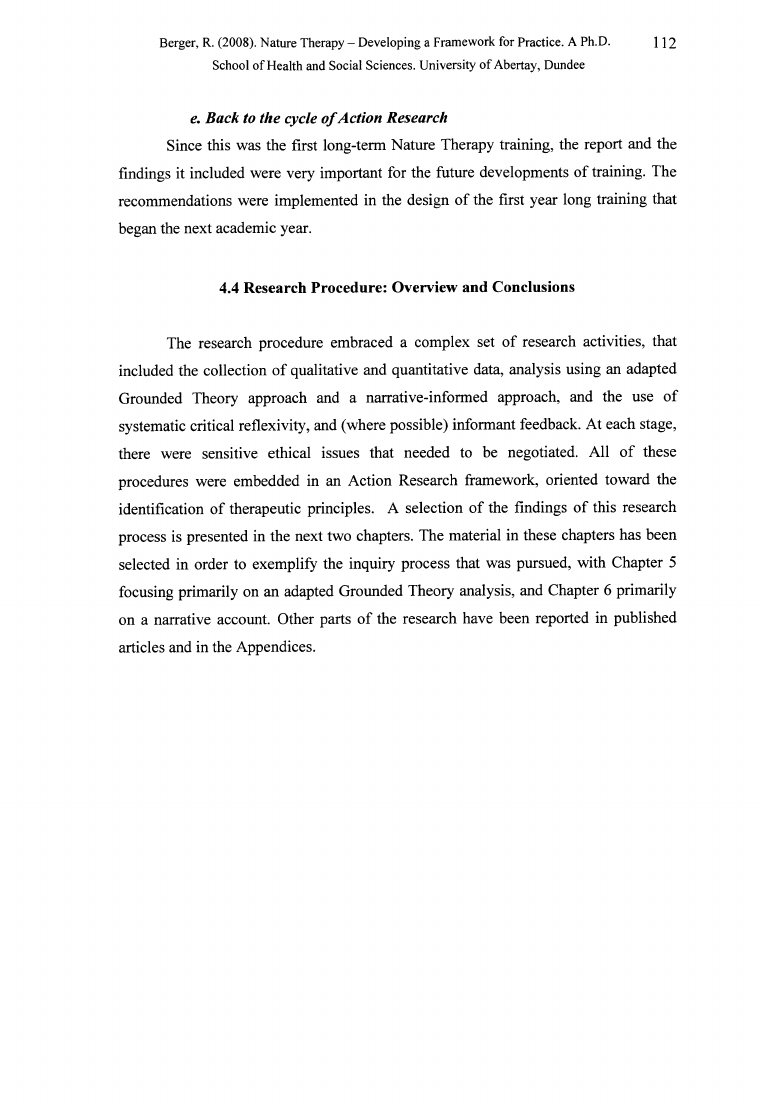
Berger, R. (2008). Nature Therapy - Developing a Framework for Practice. A Ph.D.
112
School of Health and Social Sciences. University of Abertay, Dundee
e. B ack to the cycle o f A ction Research
Since this was the first long-term Nature Therapy training, the report and the
findings it included were very important for the future developments of training. The
recommendations were implemented in the design of the first year long training that
began the next academic year.
4.4 Research Procedure: Overview and Conclusions
The research procedure embraced a complex set of research activities, that
included the collection of qualitative and quantitative data, analysis using an adapted
Grounded Theory approach and a narrative-informed approach, and the use of
systematic critical reflexivity, and (where possible) informant feedback. At each stage,
there were sensitive ethical issues that needed to be negotiated. All of these
procedures were embedded in an Action Research framework, oriented toward the
identification of therapeutic principles. A selection of the findings of this research
process is presented in the next two chapters. The material in these chapters has been
selected in order to exemplify the inquiry process that was pursued, with Chapter 5
focusing primarily on an adapted Grounded Theory analysis, and Chapter 6 primarily
on a narrative account. Other parts of the research have been reported in published
articles and in the Appendices.
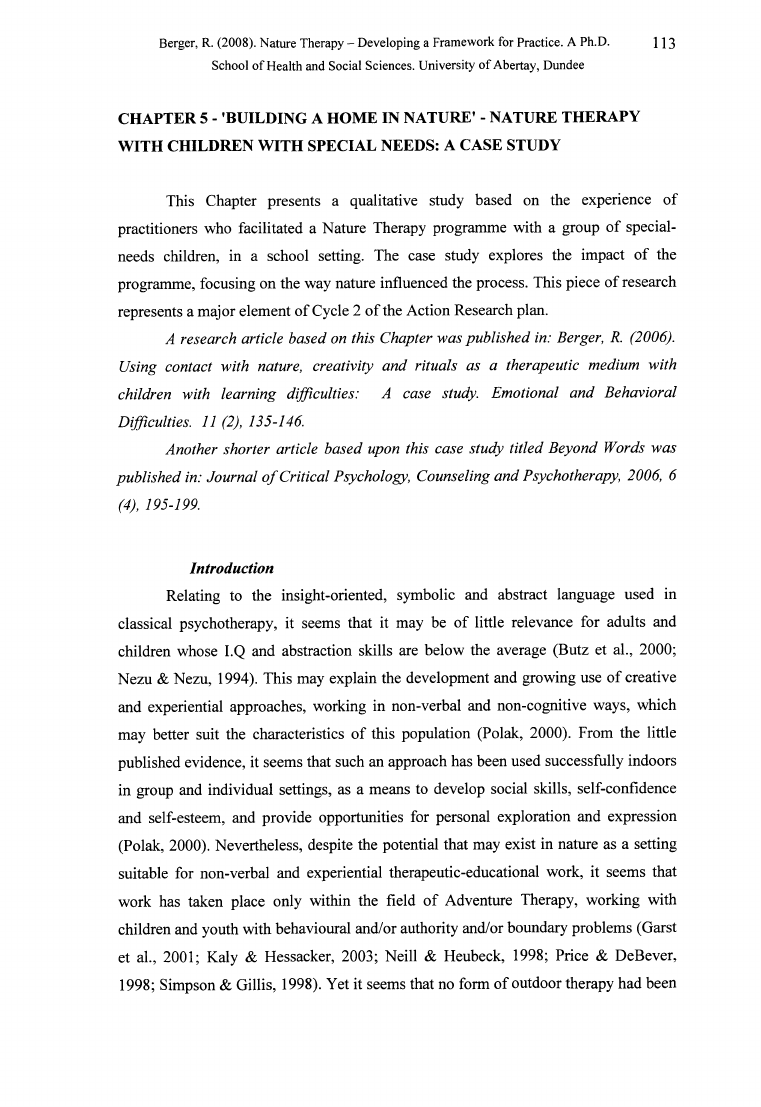
Berger, R. (2008). Nature Therapy - Developing a Framework for Practice. A Ph.D.
113
School of Health and Social Sciences. University of Abertay, Dundee
CHAPTER 5 - 'BUILDING A HOME IN NATURE’ - NATURE THERAPY
WITH CHILDREN WITH SPECIAL NEEDS: A CASE STUDY
This Chapter presents a qualitative study based on the experience of
practitioners who facilitated a Nature Therapy programme with a group of special-
needs children, in a school setting. The case study explores the impact of the
programme, focusing on the way nature influenced the process. This piece of research
represents a major element of Cycle 2 of the Action Research plan.
A resea rch a rticle b a se d on th is C h a p ter w a s p u b lish e d in: B erger, R. (2006).
U sing con tact w ith nature, crea tivity a n d ritu als as a th erapeu tic m edium w ith
children w ith learn in g difficulties: A case study. E m otional a n d B eh avioral
D ifficulties. 11 (2), 135-146.
A n other sh orter article b a sed upon this case stu dy title d B eyo n d W ords w a s
p u b lis h e d in: J o u rn a l o f C ritic a l P sych o lo g y, C o u n selin g a n d P sych o th era p y, 2006, 6
(4), 195-199.
Introduction
Relating to the insight-oriented, symbolic and abstract language used in
classical psychotherapy, it seems that it may be of little relevance for adults and
children whose I.Q and abstraction skills are below the average (Butz et al., 2000;
Nezu & Nezu, 1994). This may explain the development and growing use of creative
and experiential approaches, working in non-verbal and non-cognitive ways, which
may better suit the characteristics of this population (Polak, 2000). From the little
published evidence, it seems that such an approach has been used successfully indoors
in group and individual settings, as a means to develop social skills, self-confidence
and self-esteem, and provide opportunities for personal exploration and expression
(Polak, 2000). Nevertheless, despite the potential that may exist in nature as a setting
suitable for non-verbal and experiential therapeutic-educational work, it seems that
work has taken place only within the field of Adventure Therapy, working with
children and youth with behavioural and/or authority and/or boundary problems (Garst
et al., 2001; Kaly & Hessacker, 2003; Neill & Heubeck, 1998; Price & DeBever,
1998; Simpson & Gillis, 1998). Yet it seems that no form of outdoor therapy had been
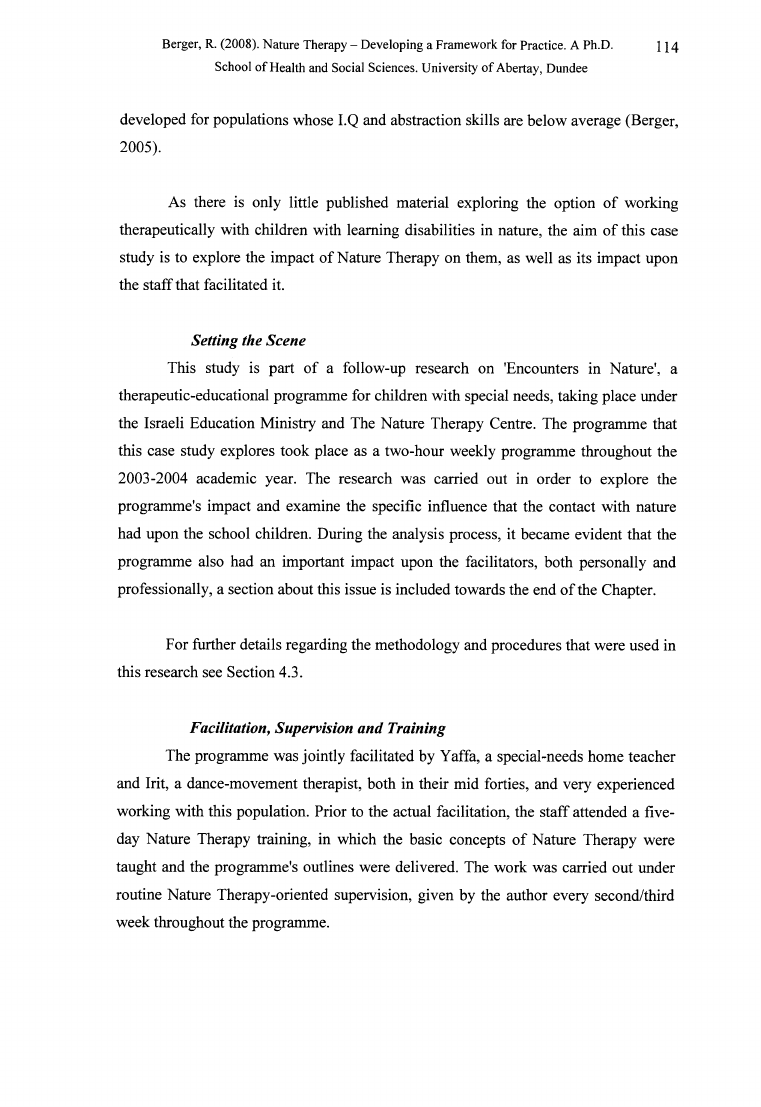
Berger, R. (2008). Nature Therapy - Developing a Framework for Practice. A Ph.D.
114
School of Health and Social Sciences. University of Abertay, Dundee
developed for populations whose I.Q and abstraction skills are below average (Berger,
2005).
As there is only little published material exploring the option of working
therapeutically with children with learning disabilities in nature, the aim of this case
study is to explore the impact of Nature Therapy on them, as well as its impact upon
the staff that facilitated it.
Setting the Scene
This study is part of a follow-up research on 'Encounters in Nature', a
therapeutic-educational programme for children with special needs, taking place under
the Israeli Education Ministry and The Nature Therapy Centre. The programme that
this case study explores took place as a two-hour weekly programme throughout the
2003-2004 academic year. The research was carried out in order to explore the
programme's impact and examine the specific influence that the contact with nature
had upon the school children. During the analysis process, it became evident that the
programme also had an important impact upon the facilitators, both personally and
professionally, a section about this issue is included towards the end of the Chapter.
For further details regarding the methodology and procedures that were used in
this research see Section 4.3.
Facilitation, Supervision and Training
The programme was jointly facilitated by Yaffa, a special-needs home teacher
and Irit, a dance-movement therapist, both in their mid forties, and very experienced
working with this population. Prior to the actual facilitation, the staff attended a five-
day Nature Therapy training, in which the basic concepts of Nature Therapy were
taught and the programme's outlines were delivered. The work was carried out under
routine Nature Therapy-oriented supervision, given by the author every second/third
week throughout the programme.
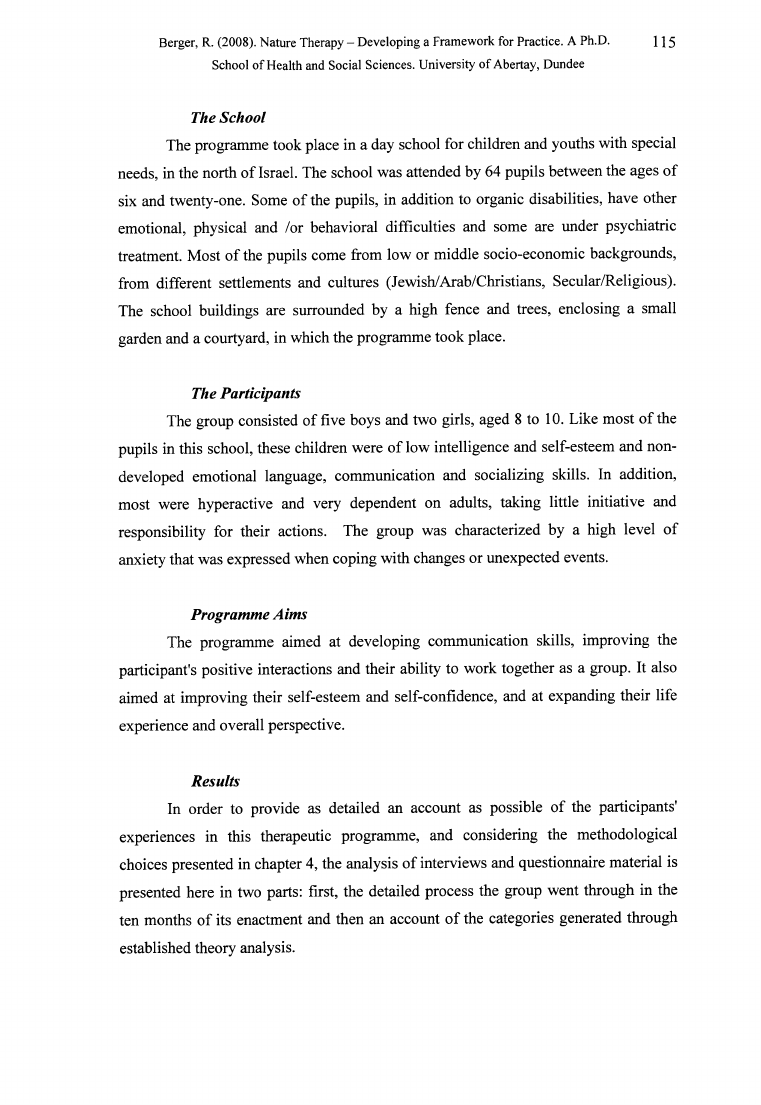
Berger, R. (2008). Nature Therapy - Developing a Framework for Practice. A Ph.D.
115
School of Health and Social Sciences. University of Abertay, Dundee
The School
The programme took place in a day school for children and youths with special
needs, in the north of Israel. The school was attended by 64 pupils between the ages of
six and twenty-one. Some of the pupils, in addition to organic disabilities, have other
emotional, physical and /or behavioral difficulties and some are under psychiatric
treatment. Most of the pupils come from low or middle socio-economic backgrounds,
from different settlements and cultures (Jewish/Arab/Christians, Secular/Religious).
The school buildings are surrounded by a high fence and trees, enclosing a small
garden and a courtyard, in which the programme took place.
The Participants
The group consisted of five boys and two girls, aged 8 to 10. Like most of the
pupils in this school, these children were of low intelligence and self-esteem and non-
developed emotional language, communication and socializing skills. In addition,
most were hyperactive and very dependent on adults, taking little initiative and
responsibility for their actions. The group was characterized by a high level of
anxiety that was expressed when coping with changes or unexpected events.
Programme Aims
The programme aimed at developing communication skills, improving the
participant's positive interactions and their ability to work together as a group. It also
aimed at improving their self-esteem and self-confidence, and at expanding their life
experience and overall perspective.
Results
In order to provide as detailed an account as possible of the participants'
experiences in this therapeutic programme, and considering the methodological
choices presented in chapter 4, the analysis of interviews and questionnaire material is
presented here in two parts: first, the detailed process the group went through in the
ten months of its enactment and then an account of the categories generated through
established theory analysis.
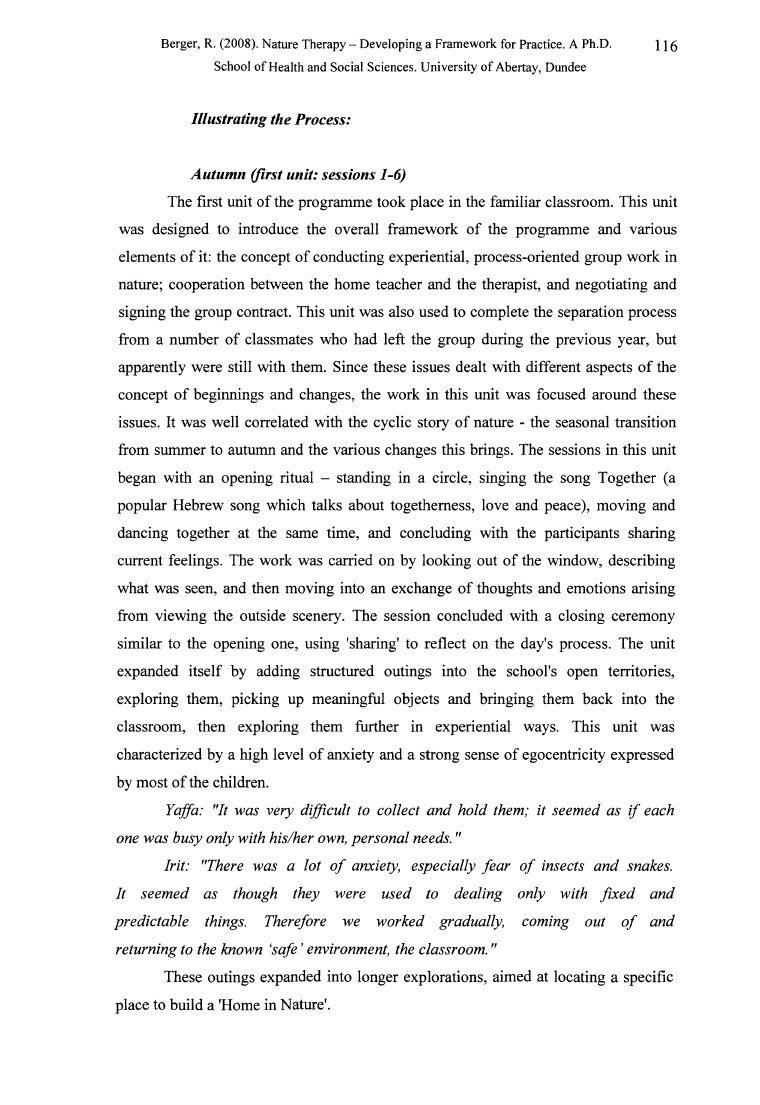
Berger, R. (2008). Nature Therapy - Developing a Framework for Practice. A Ph.D.
116
School of Health and Social Sciences. University of Abertay, Dundee
Illustrating the Process:
Autum n (first unit: sessions 1-6)
The first unit of the programme took place in the familiar classroom. This unit
was designed to introduce the overall framework of the programme and various
elements of it: the concept of conducting experiential, process-oriented group work in
nature; cooperation between the home teacher and the therapist, and negotiating and
signing the group contract. This unit was also used to complete the separation process
from a number of classmates who had left the group during the previous year, but
apparently were still with them. Since these issues dealt with different aspects of the
concept of beginnings and changes, the work in this unit was focused around these
issues. It was well correlated with the cyclic story of nature - the seasonal transition
from summer to autumn and the various changes this brings. The sessions in this unit
began with an opening ritual - standing in a circle, singing the song Together (a
popular Hebrew song which talks about togetherness, love and peace), moving and
dancing together at the same time, and concluding with the participants sharing
current feelings. The work was carried on by looking out of the window, describing
what was seen, and then moving into an exchange of thoughts and emotions arising
from viewing the outside scenery. The session concluded with a closing ceremony
similar to the opening one, using 'sharing' to reflect on the day's process. The unit
expanded itself by adding structured outings into the school's open territories,
exploring them, picking up meaningful objects and bringing them back into the
classroom, then exploring them further in experiential ways. This unit was
characterized by a high level of anxiety and a strong sense of egocentricity expressed
by most of the children.
Y affa: "It w a s v e r y d iff ic u lt to c o lle c t a n d h o ld th em ; it s e e m e d a s i f e a c h
one w as busy only w ith his/her own, p e rso n a l n eed s."
Irit: "There w as a lo t o f anxiety, esp ecia lly fe a r o f insects a n d snakes.
It seem ed as though they w ere u sed to dealin g only w ith fix e d a n d
p re d ic ta b le things. Therefore w e w o rk ed gradu ally, com ing o u t o f a n d
r e tu r n in g to th e k n o w n ‘s a fe ’ e n v ir o n m e n t, th e c la s s r o o m ."
These outings expanded into longer explorations, aimed at locating a specific
place to build a 'Home in Nature'.
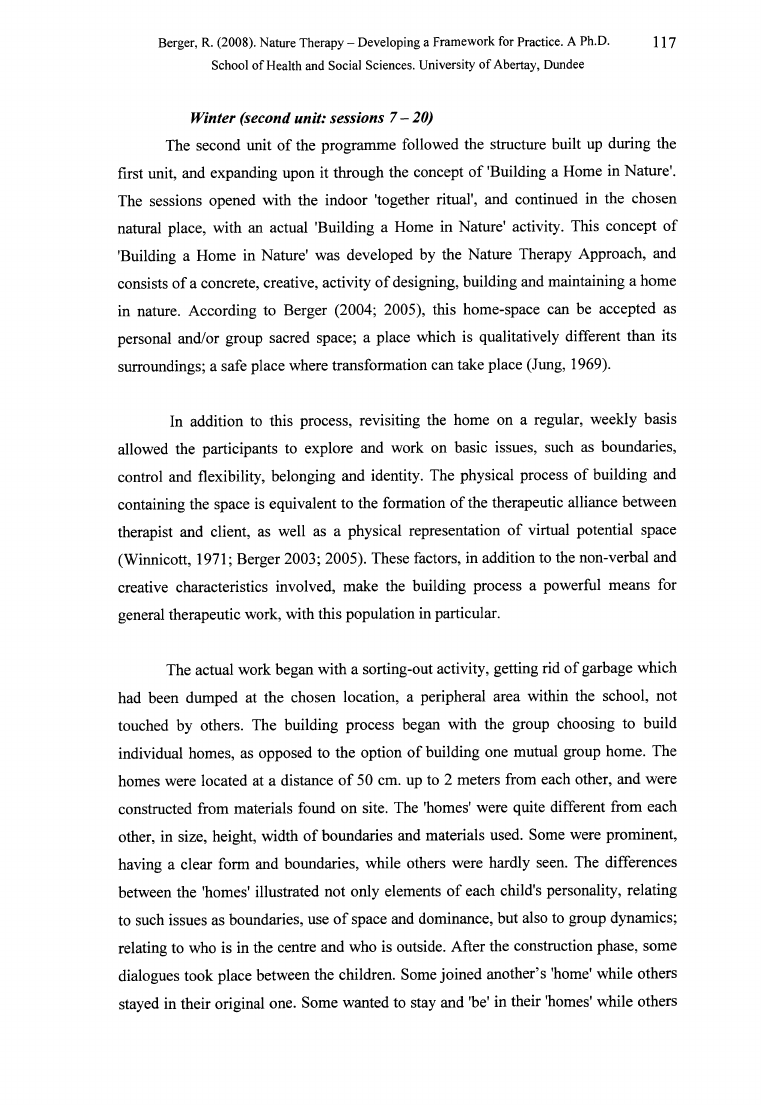
Berger, R. (2008). Nature Therapy - Developing a Framework for Practice. A Ph.D.
117
School of Health and Social Sciences. University of Abertay, Dundee
Winter (second unit: sessions 7 - 20)
The second unit of the programme followed the structure built up during the
first unit, and expanding upon it through the concept of 'Building a Home in Nature'.
The sessions opened with the indoor 'together ritual', and continued in the chosen
natural place, with an actual 'Building a Home in Nature' activity. This concept of
'Building a Home in Nature' was developed by the Nature Therapy Approach, and
consists of a concrete, creative, activity of designing, building and maintaining a home
in nature. According to Berger (2004; 2005), this home-space can be accepted as
personal and/or group sacred space; a place which is qualitatively different than its
surroundings; a safe place where transformation can take place (Jung, 1969).
In addition to this process, revisiting the home on a regular, weekly basis
allowed the participants to explore and work on basic issues, such as boundaries,
control and flexibility, belonging and identity. The physical process of building and
containing the space is equivalent to the formation of the therapeutic alliance between
therapist and client, as well as a physical representation of virtual potential space
(Winnicott, 1971; Berger 2003; 2005). These factors, in addition to the non-verbal and
creative characteristics involved, make the building process a powerful means for
general therapeutic work, with this population in particular.
The actual work began with a sorting-out activity, getting rid of garbage which
had been dumped at the chosen location, a peripheral area within the school, not
touched by others. The building process began with the group choosing to build
individual homes, as opposed to the option of building one mutual group home. The
homes were located at a distance of 50 cm. up to 2 meters from each other, and were
constructed from materials found on site. The 'homes' were quite different from each
other, in size, height, width of boundaries and materials used. Some were prominent,
having a clear form and boundaries, while others were hardly seen. The differences
between the 'homes' illustrated not only elements of each child's personality, relating
to such issues as boundaries, use of space and dominance, but also to group dynamics;
relating to who is in the centre and who is outside. After the construction phase, some
dialogues took place between the children. Some joined another’s 'home' while others
stayed in their original one. Some wanted to stay and 'be' in their 'homes' while others
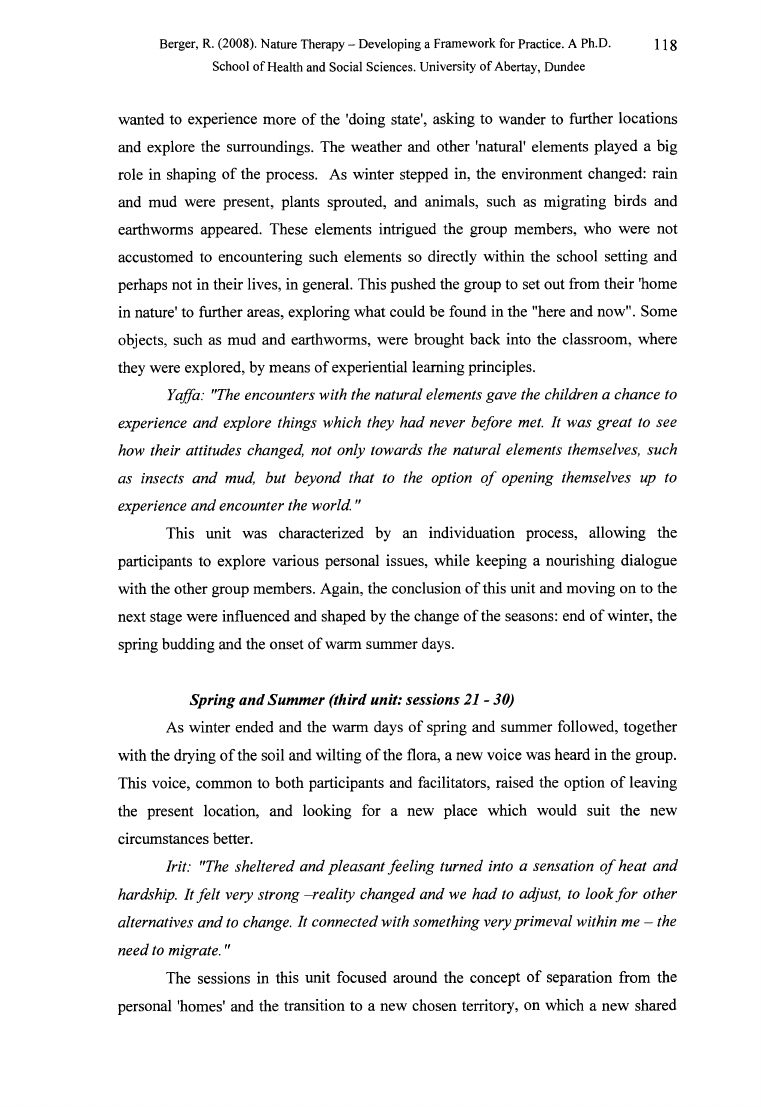
Berger, R. (2008). Nature Therapy - Developing a Framework for Practice. A Ph.D.
118
School of Health and Social Sciences. University of Abertay, Dundee
wanted to experience more of the 'doing state', asking to wander to further locations
and explore the surroundings. The weather and other 'natural' elements played a big
role in shaping of the process. As winter stepped in, the environment changed: rain
and mud were present, plants sprouted, and animals, such as migrating birds and
earthworms appeared. These elements intrigued the group members, who were not
accustomed to encountering such elements so directly within the school setting and
perhaps not in their lives, in general. This pushed the group to set out from their 'home
in nature' to further areas, exploring what could be found in the "here and now". Some
objects, such as mud and earthworms, were brought back into the classroom, where
they were explored, by means of experiential learning principles.
Yaffa: "The en cou n ters w ith the n a tu ra l elem en ts g a v e the ch ildren a ch an ce to
experien ce a n d explore thin gs w hich th ey h a d n ever before met. It w a s g re a t to see
how their attitu des changed, n ot on ly tow ards the n atu ral elem en ts them selves, such
a s insects a n d mud, but b eyo n d th at to the option o f opening them selves up to
experience a n d encounter the w o rld ."
This unit was characterized by an individuation process, allowing the
participants to explore various personal issues, while keeping a nourishing dialogue
with the other group members. Again, the conclusion of this unit and moving on to the
next stage were influenced and shaped by the change of the seasons: end of winter, the
spring budding and the onset of warm summer days.
Spring and Summer (third unit: sessions 21 - 30)
As winter ended and the warm days of spring and summer followed, together
with the drying of the soil and wilting of the flora, a new voice was heard in the group.
This voice, common to both participants and facilitators, raised the option of leaving
the present location, and looking for a new place which would suit the new
circumstances better.
Irit: "The sh e lte red a n d p le a sa n t fe e lin g tu rn ed into a sen sation o f h ea t a n d
hardship. It fe lt very stro n g -re a lity ch an ged a n d w e h a d to adjust, to look f o r other
a ltern atives a n d to change. It co n n ected w ith som eth in g very p rim e v a l w ithin m e - the
n eed to m ig ra te."
The sessions in this unit focused around the concept of separation from the
personal 'homes' and the transition to a new chosen territory, on which a new shared
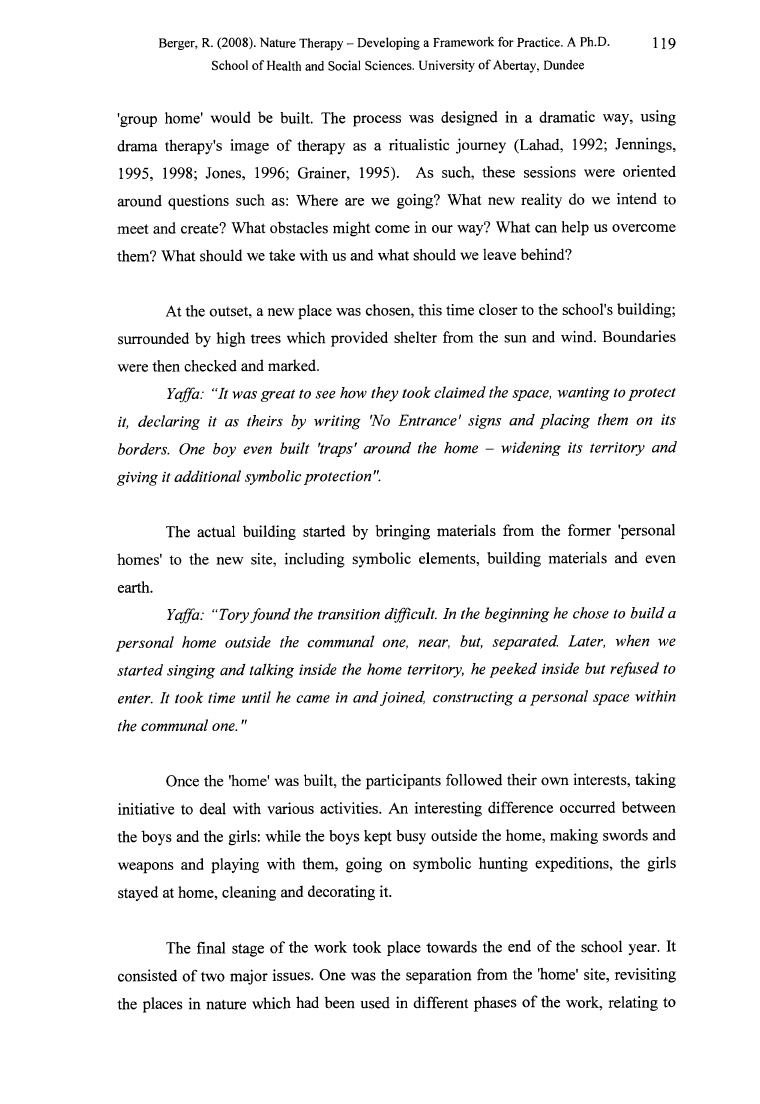
Berger, R. (2008). Nature Therapy - Developing a Framework for Practice. A Ph.D.
119
School of Health and Social Sciences. University of Abertay, Dundee
'group home' would be built. The process was designed in a dramatic way, using
drama therapy's image of therapy as a ritualistic journey (Lahad, 1992; Jennings,
1995, 1998; Jones, 1996; Grainer, 1995). As such, these sessions were oriented
around questions such as: Where are we going? What new reality do we intend to
meet and create? What obstacles might come in our way? What can help us overcome
them? What should we take with us and what should we leave behind?
At the outset, a new place was chosen, this time closer to the school's building;
surrounded by high trees which provided shelter from the sun and wind. Boundaries
were then checked and marked.
Y affa: “I t w a s g r e a t to s e e h o w th e y to o k c la im e d th e s p a c e , w a n tin g to p r o t e c t
it, d e c la r in g it a s th e irs b y w r itin g 'No E n tra n c e ' s ig n s a n d p la c in g th em o n its
borders. O ne b o y even bu ilt 'traps' a rou n d the hom e - w iden in g its territo ry a n d
givin g it addition al sym bolic protection".
The actual building started by bringing materials from the former 'personal
homes' to the new site, including symbolic elements, building materials and even
earth.
Yaffa: “T ory fo u n d the tran sition difficult. In the begin nin g he chose to b u ild a
p e rso n a l hom e ou tside the com m u n al one, near, but, sep a ra ted . L ater, w h en w e
sta rte d sin gin g a n d talking inside the hom e territory, he p e e k e d inside but refu sed to
enter. It to o k tim e until he cam e in a n d jo in e d , co n stru ctin g a p e rso n a l sp a ce w ith in
the com m unal o n e ."
Once the 'home' was built, the participants followed their own interests, taking
initiative to deal with various activities. An interesting difference occurred between
the boys and the girls: while the boys kept busy outside the home, making swords and
weapons and playing with them, going on symbolic hunting expeditions, the girls
stayed at home, cleaning and decorating it.
The final stage of the work took place towards the end of the school year. It
consisted of two major issues. One was the separation from the 'home' site, revisiting
the places in nature which had been used in different phases of the work, relating to
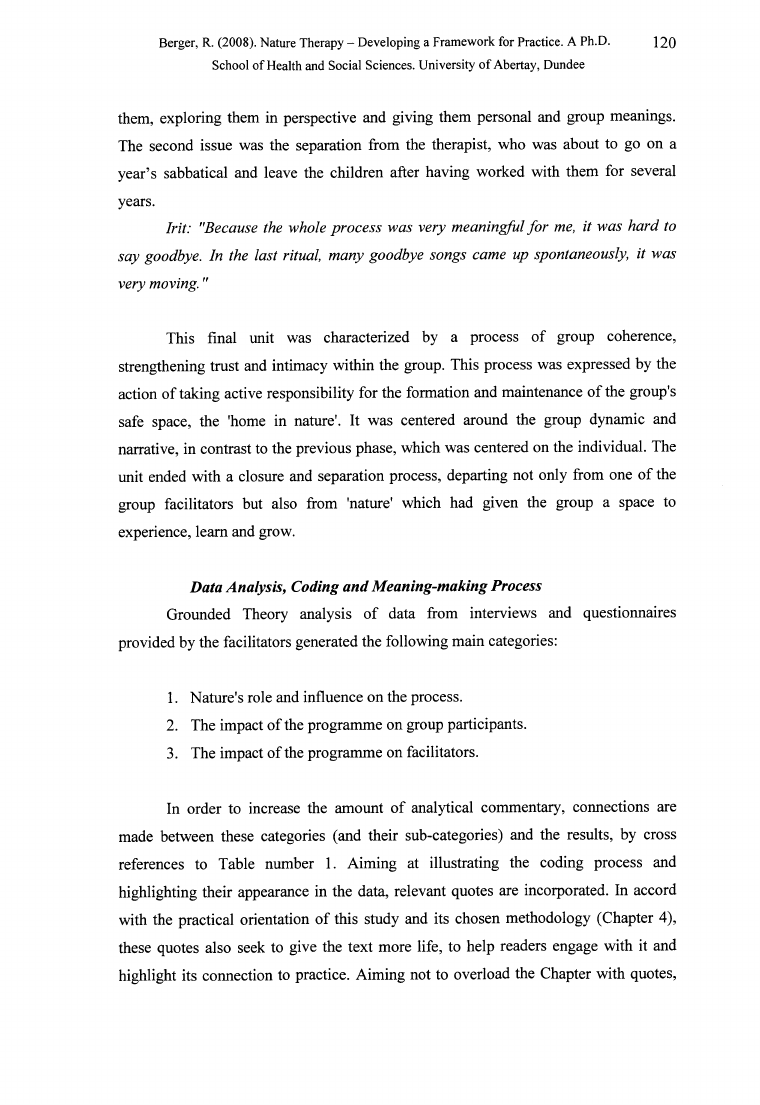
Berger, R. (2008). Nature Therapy - Developing a Framework for Practice. A Ph.D.
120
School of Health and Social Sciences. University of Abertay, Dundee
them, exploring them in perspective and giving them personal and group meanings.
The second issue was the separation from the therapist, who was about to go on a
year’s sabbatical and leave the children after having worked with them for several
years.
Irit: "Because the w h ole p r o c e ss w a s very m eaningful f o r me, it w a s h a rd to
sa y goodbye. In the la st ritual, m an y g o o d b ye son gs cam e up spontaneously, it w a s
very m ovin g."
This final unit was characterized by a process of group coherence,
strengthening trust and intimacy within the group. This process was expressed by the
action of taking active responsibility for the formation and maintenance of the group's
safe space, the 'home in nature'. It was centered around the group dynamic and
narrative, in contrast to the previous phase, which was centered on the individual. The
unit ended with a closure and separation process, departing not only from one of the
group facilitators but also from 'nature' which had given the group a space to
experience, learn and grow.
Data Analysis, Coding and M eaning-making Process
Grounded Theory analysis of data from interviews and questionnaires
provided by the facilitators generated the following main categories:
1. Nature's role and influence on the process.
2. The impact of the programme on group participants.
3. The impact of the programme on facilitators.
In order to increase the amount of analytical commentary, connections are
made between these categories (and their sub-categories) and the results, by cross
references to Table number 1. Aiming at illustrating the coding process and
highlighting their appearance in the data, relevant quotes are incorporated. In accord
with the practical orientation of this study and its chosen methodology (Chapter 4),
these quotes also seek to give the text more life, to help readers engage with it and
highlight its connection to practice. Aiming not to overload the Chapter with quotes,
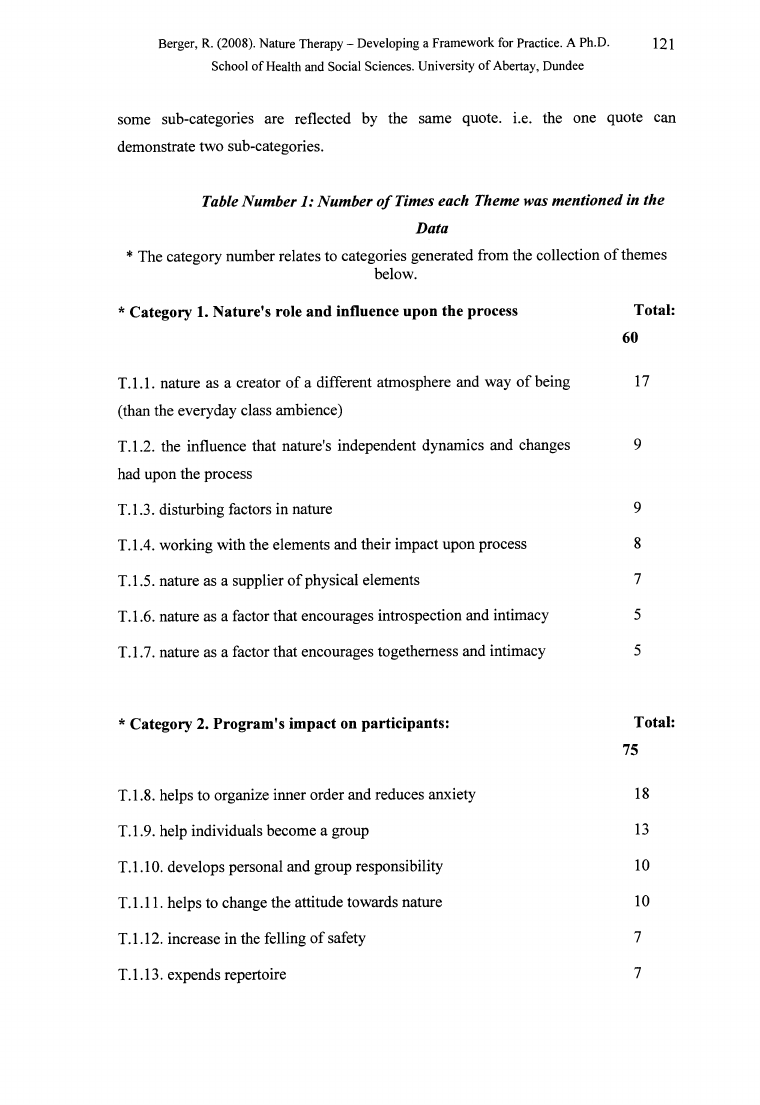
Berger, R. (2008). Nature Therapy - Developing a Framework for Practice. A Ph.D.
121
School of Health and Social Sciences. University of Abertay, Dundee
some sub-categories are reflected by the same quote, i.e. the one qcuote can
demonstrate two sub-categories.
Table N um ber 1: N um ber o f Times each Theme was m entioned in the
D ata
* The category number relates to categories generated from the collection of themes
below.
* Category 1. Nature’s role and influence upon the process
Total:
60
T.1.1. nature as a creator of a different atmosphere and way of being
17
(than the everyday class ambience)
T.1.2. the influence that nature's independent dynamics and changes
9
had upon the process
T. 1.3. disturbing factors in nature
9
T. 1.4. working with the elements and their impact upon process
8
T.l .5. nature as a supplier of physical elements
7
T. 1.6. nature as a factor that encourages introspection and intimacy
5
T. 1.7. nature as a factor that encourages togetherness and intimacy
5
* Category 2. Program’s impact on participants:
T. 1.8. helps to organize inner order and reduces anxiety
T. 1.9. help individuals become a group
T. 1.10. develops personal and group responsibility
T. 1.11. helps to change the attitude towards nature
T. 1.12. increase in the felling of safety
T. 1.13. expends repertoire
Total:
75
18
13
10
10
7
7
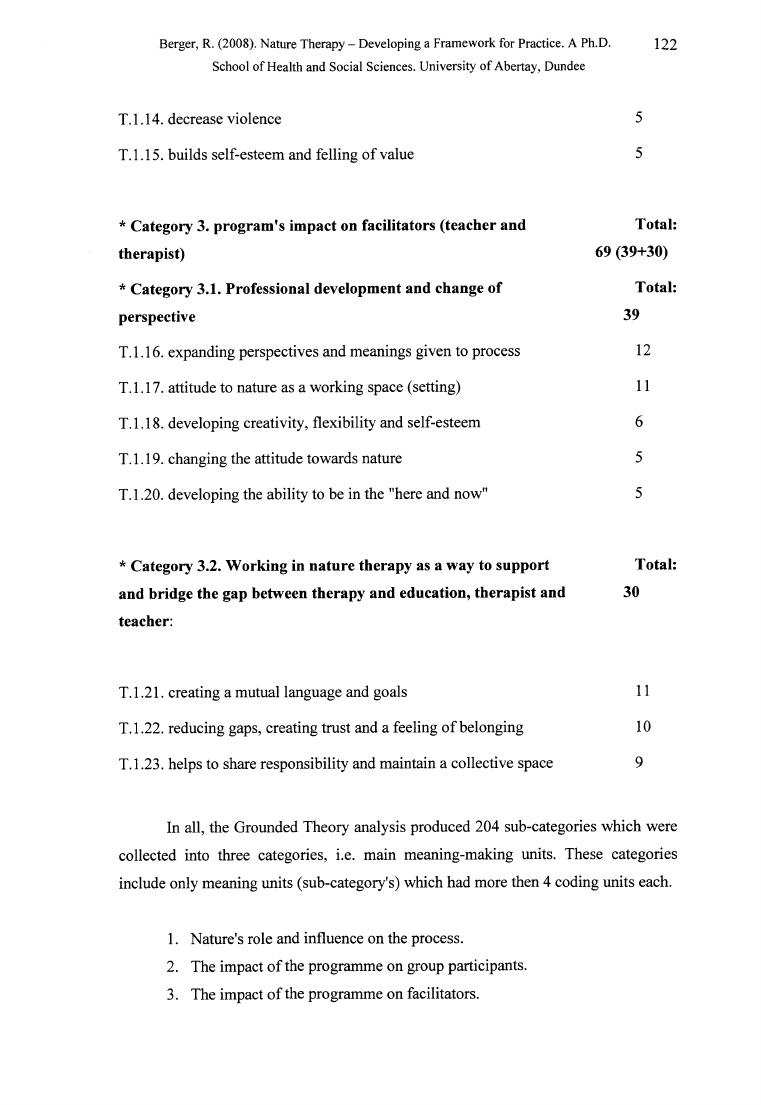
Berger, R. (2008). Nature Therapy - Developing a Framework for Practice. A Ph.D.
122
School of Health and Social Sciences. University of Abertay, Dundee
T.1.14. decrease violence
5
T. 1.15. builds self-esteem and felling of value
5
* Category 3. program’s impact on facilitators (teacher and
therapist)
* Category 3.1. Professional development and change of
perspective
T. 1.16. expanding perspectives and meanings given to process
T. 1.17. attitude to nature as a working space (setting)
T. 1.18. developing creativity, flexibility and self-esteem
T. 1.19. changing the attitude towards nature
T. 1.20. developing the ability to be in the "here and now"
Total:
69 (39+30)
Total:
39
12
11
6
5
5
* Category 3.2. Working in nature therapy as a way to support
and bridge the gap between therapy and education, therapist and
teacher:
Total:
30
T. 1.21. creating a mutual language and goals
11
T. 1.22. reducing gaps, creating trust and a feeling of belonging
10
T.l .23. helps to share responsibility and maintain a collective space
9
In all, the Grounded Theory analysis produced 204 sub-categories which were
collected into three categories, i.e. main meaning-making units. These categories
include only meaning units (sub-category's) which had more then 4 coding units each.
1. Nature's role and influence on the process.
2. The impact of the programme on group participants.
3. The impact of the programme on facilitators.
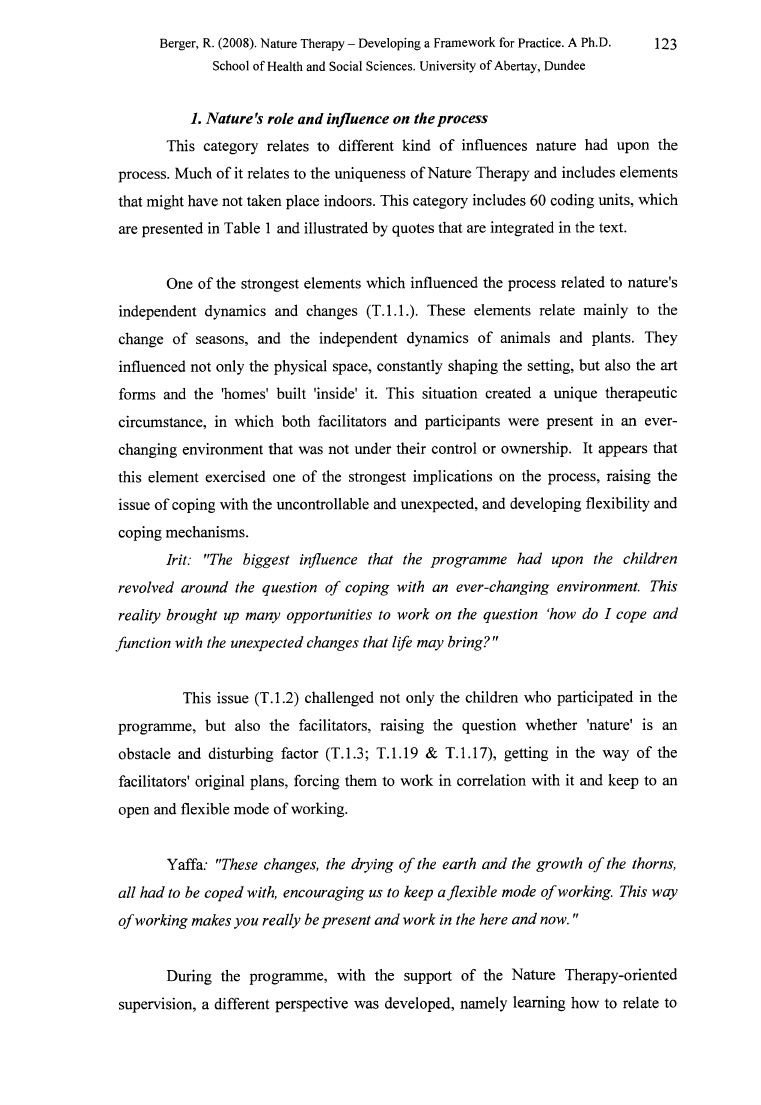
Berger, R. (2008). Nature Therapy - Developing a Framework for Practice. A Ph.D.
123
School of Health and Social Sciences. University of Abertay, Dundee
1. N ature's role and influence on the process
This category relates to different kind of influences nature had upon the
process. Much of it relates to the uniqueness of Nature Therapy and includes elements
that might have not taken place indoors. This category includes 60 coding units, which
are presented in Table 1 and illustrated by quotes that are integrated in the text.
One of the strongest elements which influenced the process related to nature's
independent dynamics and changes (T.I.I.). These elements relate mainly to the
change of seasons, and the independent dynamics of animals and plants. They
influenced not only the physical space, constantly shaping the setting, but also the art
forms and the 'homes' built 'inside' it. This situation created a unique therapeutic
circumstance, in which both facilitators and participants were present in an ever-
changing environment that was not under their control or ownership. It appears that
this element exercised one of the strongest implications on the process, raising the
issue of coping with the uncontrollable and unexpected, and developing flexibility and
coping mechanisms.
Irit: "The b ig g est influence th a t the p ro g ra m m e h a d upon the ch ildren
revo lved a rou n d the qu estion o f co p in g w ith an ever-ch an gin g environm ent. This
r e a li ty b r o u g h t u p m a n y o p p o r tu n itie s to w o r k o n th e q u e s tio n ‘h o w d o I c o p e a n d
fu n ction w ith the u n expected changes th at life m ay brin g?"
This issue (T.1.2) challenged not only the children who participated in the
programme, but also the facilitators, raising the question whether 'nature' is an
obstacle and disturbing factor (T.1.3; T.1.19 & T.1.17), getting in the way of the
facilitators' original plans, forcing them to work in correlation with it and keep to an
open and flexible mode of working.
Yaffa: "These c h a n g e s, th e d r y in g o f th e e a r th a n d th e g r o w th o f th e th o rn s,
a ll h a d to be co p ed with, encou ragin g us to keep a flex ib le m ode o f w orking. This w a y
o f w o rk in g m akes y o u re a lly be p re se n t a n d w o rk in the h ere a n d n o w ."
During the programme, with the support of the Nature Therapy-oriented
supervision, a different perspective was developed, namely learning how to relate to
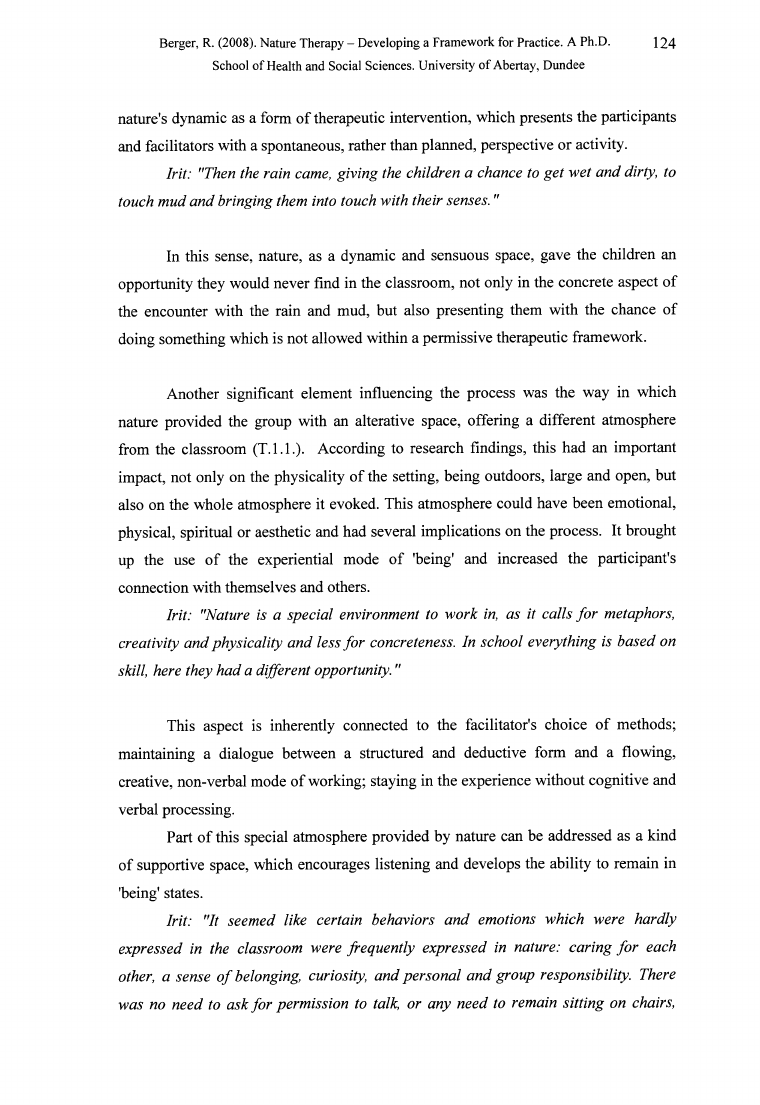
Berger, R. (2008). Nature Therapy - Developing a Framework for Practice. A Ph.D.
124
School of Health and Social Sciences. University of Abertay, Dundee
nature's dynamic as a form of therapeutic intervention, which presents the participants
and facilitators with a spontaneous, rather than planned, perspective or activity.
Irit: "Then the rain cam e, g ivin g the children a chance to g e t w e t a n d dirty, to
touch m u d a n d brin ging them into touch w ith th eir senses. "
In this sense, nature, as a dynamic and sensuous space, gave the children an
opportunity they would never find in the classroom, not only in the concrete aspect of
the encounter with the rain and mud, but also presenting them with the chance of
doing something which is not allowed within a permissive therapeutic framework.
Another significant element influencing the process was the way in which
nature provided the group with an alterative space, offering a different atmosphere
from the classroom (T.I.I.). According to research findings, this had an important
impact, not only on the physicality of the setting, being outdoors, large and open, but
also on the whole atmosphere it evoked. This atmosphere could have been emotional,
physical, spiritual or aesthetic and had several implications on the process. It brought
up the use of the experiential mode of 'being' and increased the participant's
connection with themselves and others.
Irit: "N ature is a s p e c ia l e n v iro n m e n t to w o r k in, a s it c a lls f o r m eta p h o rs,
crea tivity a n d p h ysica lity a n d less f o r concreteness. In sch o o l everyth in g is b a se d on
skill, here th ey h a d a differen t o p p o rtu n ity."
This aspect is inherently connected to the facilitator's choice of methods;
maintaining a dialogue between a structured and deductive form and a flowing,
creative, non-verbal mode of working; staying in the experience without cognitive and
verbal processing.
Part of this special atmosphere provided by nature can be addressed as a kind
of supportive space, which encourages listening and develops the ability to remain in
'being' states.
I r it: "It s e e m e d lik e c e r ta in b e h a v io r s a n d e m o tio n s w h ic h w e r e h a r d ly
e x p resse d in the cla ssro o m w ere fre q u e n tly e x p resse d in nature: ca rin g f o r each
other, a sense o f belonging, curiosity, a n d p e rso n a l a n d grou p respon sibility. There
w a s no n eed to a sk f o r p e rm issio n to talk, o r an y n e e d to rem ain sittin g on chairs,
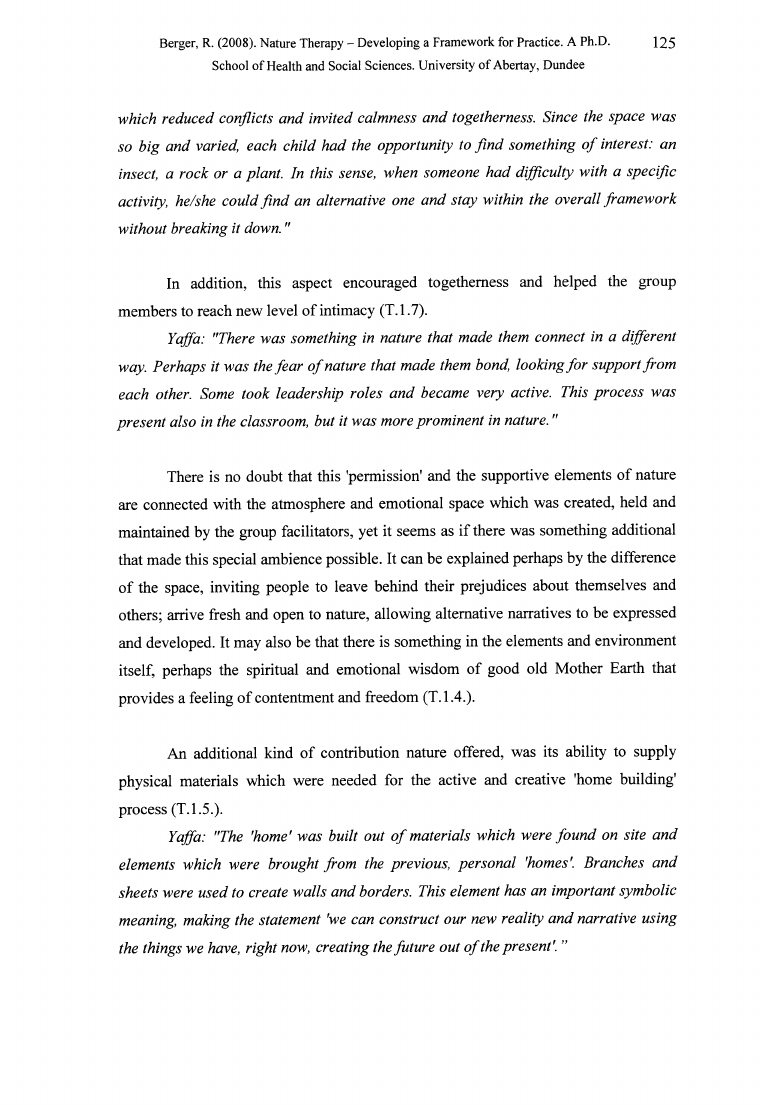
Berger, R. (2008). Nature Therapy - Developing a Framework for Practice. A Ph.D.
125
School of Health and Social Sciences. University of Abertay, Dundee
w hich red u ced conflicts a n d in vited calm n ess a n d togetherness. Since the sp a ce w a s
so b ig an d varied, each ch ild h a d the opportu n ity to fin d som eth in g o f interest: an
insect, a rock or a plan t. In this sense, w hen som eone h a d difficulty w ith a specific
activity, he/she co u ld fin d an altern ative one a n d sta y w ithin the o vera ll fra m ew o rk
w ithout breaking it d o w n ."
In addition, this aspect encouraged togetherness and helped the group
members to reach new level of intimacy (T.l .7).
Yaffa: "There w a s som eth in g in nature th a t m ade them co n n ect in a differen t
w ay. P erh aps it w a s the fe a r o f nature th at m ade them bond, lookin g f o r su p port fro m
each other. Som e took leadersh ip ro les a n d becam e very active. This p ro c e ss w a s
p r e s e n t a lso in the cla ssro o m , b u t it w a s m ore p ro m in e n t in n a tu re ."
There is no doubt that this 'permission' and the supportive elements of nature
are connected with the atmosphere and emotional space which was created, held and
maintained by the group facilitators, yet it seems as if there was something additional
that made this special ambience possible. It can be explained perhaps by the difference
of the space, inviting people to leave behind their prejudices about themselves and
others; arrive fresh and open to nature, allowing alternative narratives to be expressed
and developed. It may also be that there is something in the elements and environment
itself, perhaps the spiritual and emotional wisdom of good old Mother Earth that
provides a feeling of contentment and freedom (T.l.4.).
An additional kind of contribution nature offered, was its ability to supply
physical materials which were needed for the active and creative 'home building’
process (T.l.5.).
Yaffa: "The 'home' w a s bu ilt ou t o f m a teria ls w hich w ere fo u n d on site a n d
e le m e n ts w h ic h w e r e b r o u g h t f r o m th e p r e v io u s , p e r s o n a l ’h o m es'. B r a n c h e s a n d
sh eets w ere u sed to create w a lls a n d borders. This elem en t has an im portan t sym bolic
m eaning, m akin g the sta te m e n t 'we can co n stru ct ou r n ew re a lity a n d n a rra tive u sin g
th e th in g s w e h a ve, r ig h t n o w , c r e a tin g th e f u tu r e o u t o f th e p r e s e n t ’. ”
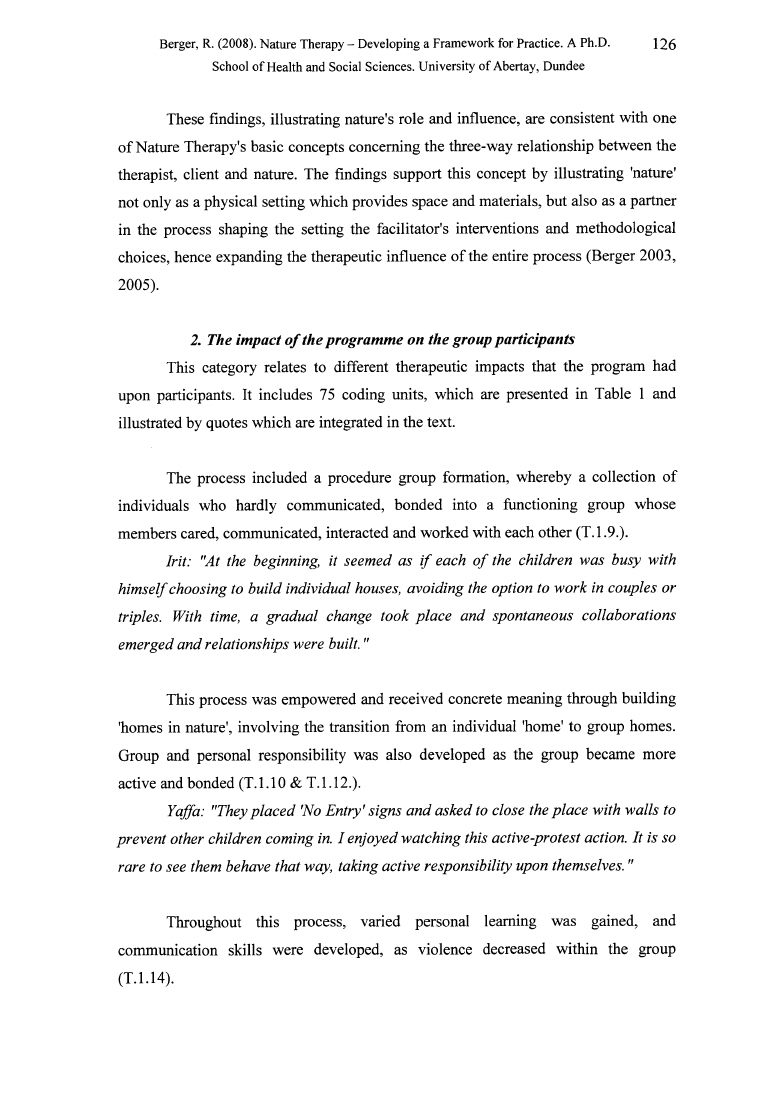
Berger, R. (2008). Nature Therapy - Developing a Framework for Practice. A Ph.D.
126
School of Health and Social Sciences. University of Abertay, Dundee
These findings, illustrating nature's role and influence, are consistent with one
of Nature Therapy's basic concepts concerning the three-way relationship between the
therapist, client and nature. The findings support this concept by illustrating 'nature'
not only as a physical setting which provides space and materials, but also as a partner
in the process shaping the setting the facilitator's interventions and methodological
choices, hence expanding the therapeutic influence of the entire process (Berger 2003,
2005).
2. The im pact o f the program m e on the group participants
This category relates to different therapeutic impacts that the program had
upon participants. It includes 75 coding units, which are presented in Table 1 and
illustrated by quotes which are integrated in the text.
The process included a procedure group formation, whereby a collection of
individuals who hardly communicated, bonded into a functioning group whose
members cared, communicated, interacted and worked with each other (T.I.9.).
Irit: "At the beginning, it se e m e d a s i f each o f the ch ild ren w a s bu sy w ith
h im se lf ch o o sin g to b u ild in d ivid u a l houses, a vo id in g the o p tion to w o rk in co u p les o r
triples. W ith tim e, a g ra d u a l change to o k p la c e a n d sp o n ta n eo u s c o lla b o ra tio n s
em erged and relationships w ere bu ilt."
This process was empowered and received concrete meaning through building
'homes in nature', involving the transition from an individual 'home' to group homes.
Group and personal responsibility was also developed as the group became more
active and bonded (T. 1.10 & T. 1.12.).
Yaffa: "They p la c e d 'No E n try' sig n s a n d a sk e d to clo se the p la c e w ith w a lls to
p r e v e n t o th e r c h ild re n c o m in g in. I e n jo y e d w a tc h in g th is a c tiv e -p r o te s t a ctio n . I t is so
rare to see them behave th at way, taking active resp o n sib ility upon th em selves."
Throughout this process, varied personal learning was gained, and
communication skills were developed, as violence decreased within the group
(T. 1.14).
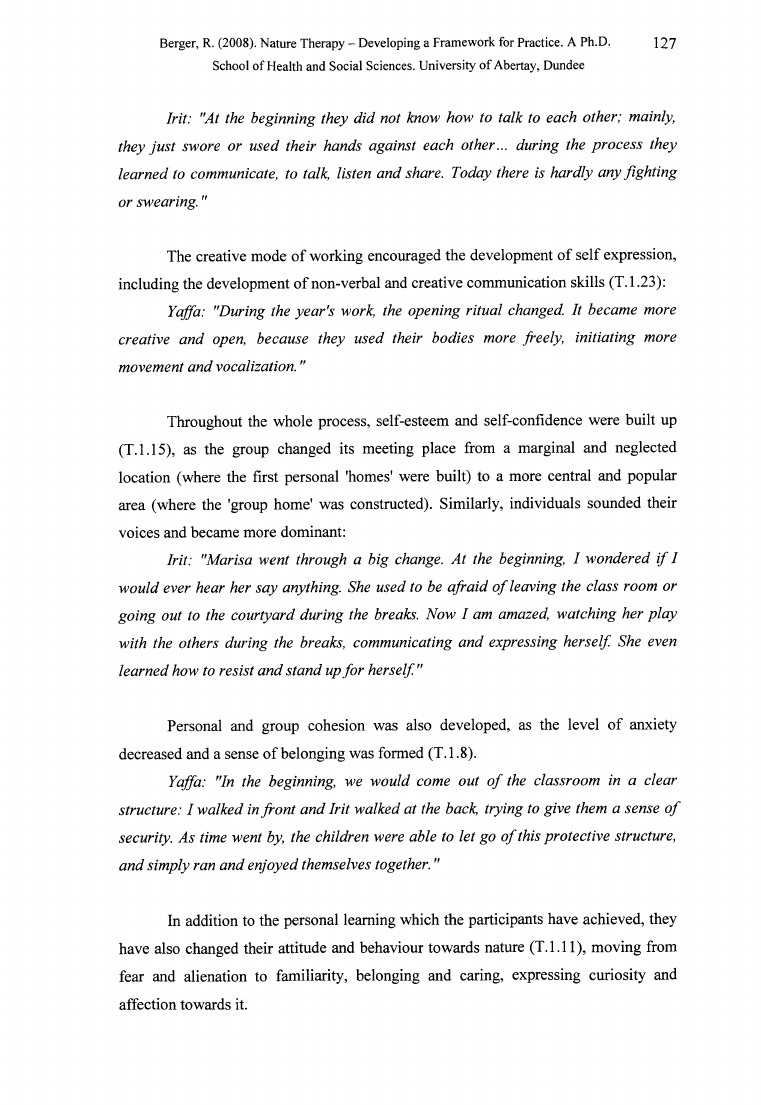
Berger, R. (2008). Nature Therapy - Developing a Framework for Practice. A Ph.D.
127
School of Health and Social Sciences. University of Abertay, Dundee
Irit: "At the b eg in n in g th ey d id n o t kn ow h o w to ta lk to ea ch oth er; m ainly,
they ju s t sw ore or used their hands against each other... during the p ro c e ss they
lea rn ed to com m unicate, to talk, listen a n d share. T oday there is h a rd ly an y fig h tin g
or sw earin g."
The creative mode of working encouraged the development of self expression,
including the development of non-verbal and creative communication skills (T.1.23):
Y affa: " D u rin g th e y e a r ’s w o rk , th e o p e n in g r itu a l c h a n g e d . I t b e c a m e m o re
creative an d open, because they used their bodies m ore freely, in itiatin g m ore
m ovem ent and vocalization ."
Throughout the whole process, self-esteem and self-confidence were built up
(T.1.15), as the group changed its meeting place from a marginal and neglected
location (where the first personal 'homes' were built) to a more central and popular
area (where the 'group home' was constructed). Similarly, individuals sounded their
voices and became more dominant:
Irit: "M arisa w en t through a b ig change. A t the beginning, I w o n d ere d i f I
w o u ld ever hear her sa y anything. She u sed to be a fra id o f leavin g the cla ss room or
g o in g ou t to the co u rtya rd du rin g the breaks. N o w I am am azed, w a tch in g her p la y
w ith the oth ers du rin g the breaks, com m unicating a n d expressin g herself. She even
lea rn ed how to resist a n d sta n d up f o r herself."
Personal and group cohesion was also developed, as the level of anxiety
decreased and a sense of belonging was formed (T.1.8).
Y affa: "In th e b e g in n in g , w e w o u ld c o m e o u t o f th e c la s s r o o m in a c le a r
stru ctu re: I w a lk e d in f r o n t a n d Irit w a lk e d a t the back, tryin g to g iv e them a sen se o f
security. A s tim e w en t by, the children w ere able to let g o o f this p ro te c tiv e structure,
an d sim ply ran an d en joyed them selves togeth er."
In addition to the personal learning which the participants have achieved, they
have also changed their attitude and behaviour towards nature (T. 1.11), moving from
fear and alienation to familiarity, belonging and caring, expressing curiosity and
affection towards it.
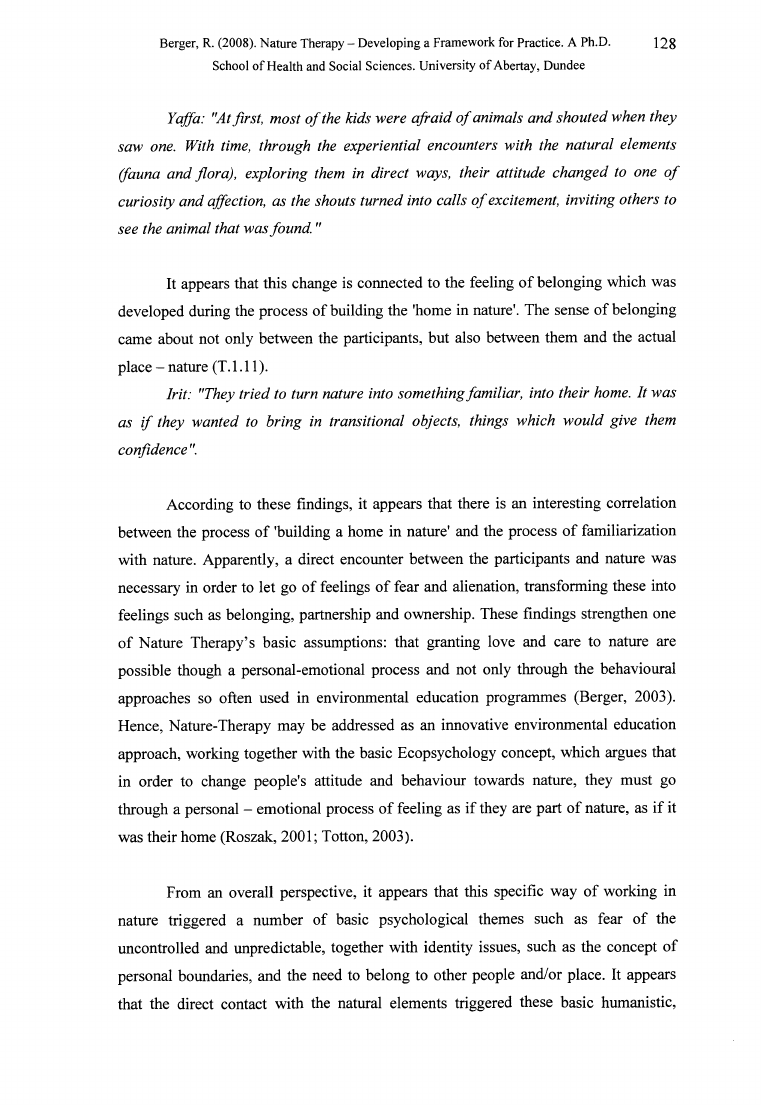
Berger, R. (2008). Nature Therapy - Developing a Framework for Practice. A Ph.D.
128
School of Health and Social Sciences. University of Abertay, Dundee
Yaffa: "Atfirst, m o st o f the kids w e re a fra id o f an im als a n d sh o u te d w h en th ey
sa w one. W ith tim e, th ro u g h the ex p erien tia l en cou n ters w ith the n a tu ra l elem en ts
(fauna a n d flo ra ), ex p lo rin g them in d ire c t w ays, th eir a ttitu d e ch a n g e d to one o f
cu riosity a n d affection, as the shouts tu rn ed into calls o f excitem ent, in vitin g oth ers to
see the anim al that w as fou n d. "
It appears that this change is connected to the feeling of belonging which was
developed during the process of building the 'home in nature'. The sense of belonging
came about not only between the participants, but also between them and the actual
place - nature (T. 1.11).
Irit: "They trie d to turn nature into som eth in g fam iliar, into th eir home. It w a s
a s i f th ey w a n te d to b rin g in tra n sitio n a l objects, th in gs w h ich w o u ld g iv e them
c o n fid e n c e ".
According to these findings, it appears that there is an interesting correlation
between the process of 'building a home in nature' and the process of familiarization
with nature. Apparently, a direct encounter between the participants and nature was
necessary in order to let go of feelings of fear and alienation, transforming these into
feelings such as belonging, partnership and ownership. These findings strengthen one
of Nature Therapy’s basic assumptions: that granting love and care to nature are
possible though a personal-emotional process and not only through the behavioural
approaches so often used in environmental education programmes (Berger, 2003).
Hence, Nature-Therapy may be addressed as an innovative environmental education
approach, working together with the basic Ecopsychology concept, which argues that
in order to change people's attitude and behaviour towards nature, they must go
through a personal - emotional process of feeling as if they are part of nature, as if it
was their home (Roszak, 2001; Totton, 2003).
From an overall perspective, it appears that this specific way of working in
nature triggered a number of basic psychological themes such as fear of the
uncontrolled and unpredictable, together with identity issues, such as the concept of
personal boundaries, and the need to belong to other people and/or place. It appears
that the direct contact with the natural elements triggered these basic humanistic,
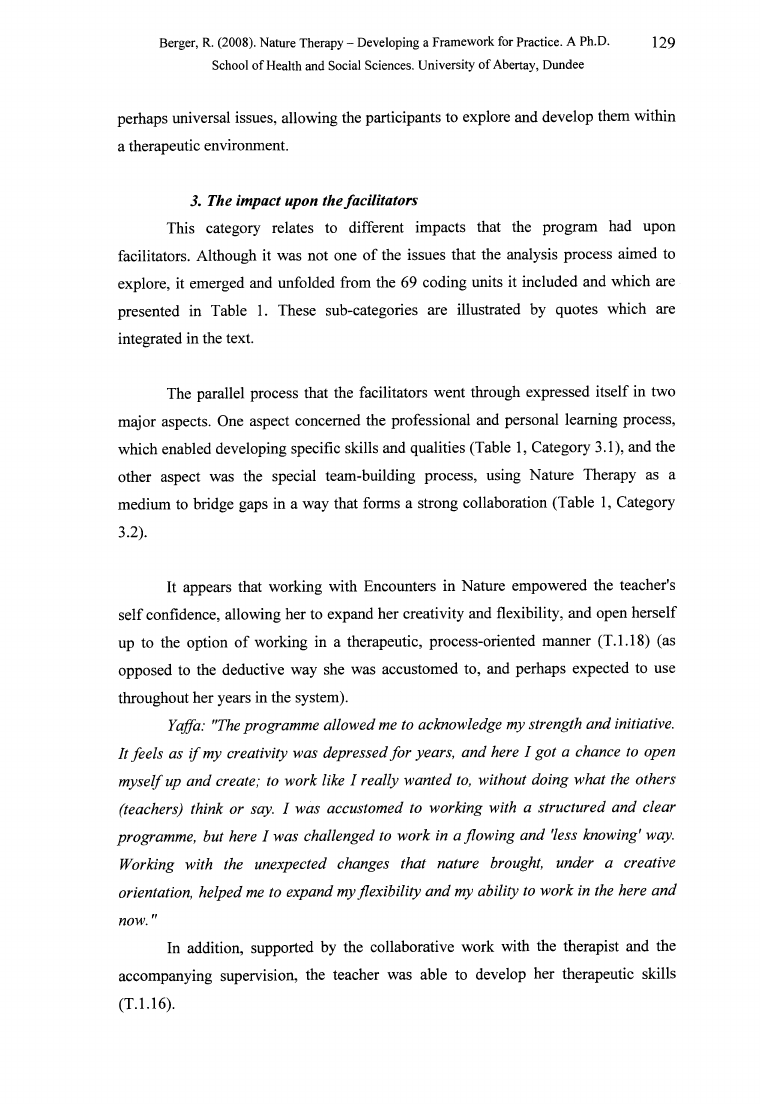
Berger, R. (2008). Nature Therapy - Developing a Framework for Practice. A Ph.D.
129
School of Health and Social Sciences. University of Abertay, Dundee
perhaps universal issues, allowing the participants to explore and develop them within
a therapeutic environment.
3. The impact upon thefacilitators
This category relates to different impacts that the program had upon
facilitators. Although it was not one of the issues that the analysis process aimed to
explore, it emerged and unfolded from the 69 coding units it included and which are
presented in Table 1. These sub-categories are illustrated by quotes which are
integrated in the text.
The parallel process that the facilitators went through expressed itself in two
major aspects. One aspect concerned the professional and personal learning process,
which enabled developing specific skills and qualities (Table 1, Category 3.1), and the
other aspect was the special team-building process, using Nature Therapy as a
medium to bridge gaps in a way that forms a strong collaboration (Table 1, Category
3.2).
It appears that working with Encounters in Nature empowered the teacher's
self confidence, allowing her to expand her creativity and flexibility, and open herself
up to the option of working in a therapeutic, process-oriented manner (T. 1.18) (as
opposed to the deductive way she was accustomed to, and perhaps expected to use
throughout her years in the system).
Y affa: "The p r o g r a m m e a l l o w e d m e to a c k n o w le d g e m y s tr e n g th a n d in itia tiv e .
It fe e ls as if m y creativity w as dep ressed fo r years, an d here I g o t a chance to open
m y s e lf up a n d c rea te ; to w o rk like I re a lly w a n te d to, w ith ou t d o in g w h a t the o th ers
(teachers) think o r say. I w as accu stom ed to w orkin g w ith a stru ctu red a n d clear
p ro g ra m m e, bu t here I w a s ch a llen g ed to w o rk in a flo w in g a n d 'less kn ow in g' w ay.
W orking w ith the u n expected changes th at nature brought, under a creative
orien tation , h e lp e d m e to ex p a n d m y fle x ib ility a n d m y a b ility to w o rk in the here a n d
n ow ."
In addition, supported by the collaborative work with the therapist and the
accompanying supervision, the teacher was able to develop her therapeutic skills
(T.1.16).
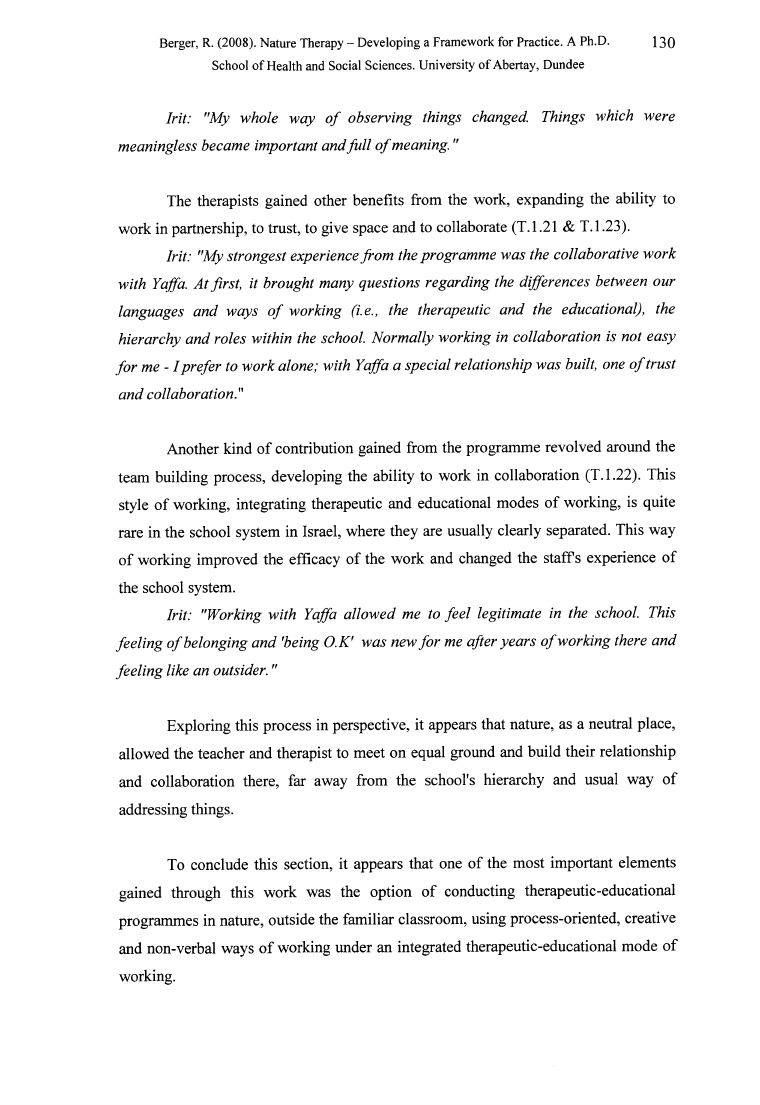
Berger, R. (2008). Nature Therapy - Developing a Framework for Practice. A Ph.D.
130
School of Health and Social Sciences. University of Abertay, Dundee
Irit: "My w h ole w a y o f o b servin g things changed. Things w hich w ere
m eaningless becam e im portant an dfu ll o f m ean ing."
The therapists gained other benefits from the work, expanding the ability to
work in partnership, to trust, to give space and to collaborate (T.1.21 & T.1.23).
Irit: "My stro n g est experience fro m the p rogram m e w a s the collaborative w o rk
w ith Yaffa. A t first, it b rou gh t m any q u estio n s re g a rd in g the differen ces b etw een ou r
lan gu ages a n d w a y s o f w orkin g (i.e., the th erapeu tic a n d the edu cation al), the
h iera rch y a n d ro le s w ith in the school. N o rm a lly w o rk in g in co lla b o ra tio n is n ot e a sy
f o r m e - I p re fe r to w o rk alone; w ith Yaffa a sp e cia l relation sh ip w a s built, one o f tru st
an d collaboration
Another kind of contribution gained from the programme revolved around the
team building process, developing the ability to work in collaboration (T.1.22). This
style of working, integrating therapeutic and educational modes of working, is quite
rare in the school system in Israel, where they are usually clearly separated. This way
of working improved the efficacy of the work and changed the staffs experience of
the school system.
Irit: "W orking w ith Yaffa a llo w e d m e to f e e l leg itim a te in the school. This
f e e l i n g o f b e lo n g in g a n d 'b e in g O .K ' w a s n e w f o r m e a fte r y e a r s o f w o r k in g th e re a n d
fe e lin g like an o u tsid e r."
Exploring this process in perspective, it appears that nature, as a neutral place,
allowed the teacher and therapist to meet on equal ground and build their relationship
and collaboration there, far away from the school's hierarchy and usual way of
addressing things.
To conclude this section, it appears that one of the most important elements
gained through this work was the option of conducting therapeutic-educational
programmes in nature, outside the familiar classroom, using process-oriented, creative
and non-verbal ways of working under an integrated therapeutic-educational mode of
working.
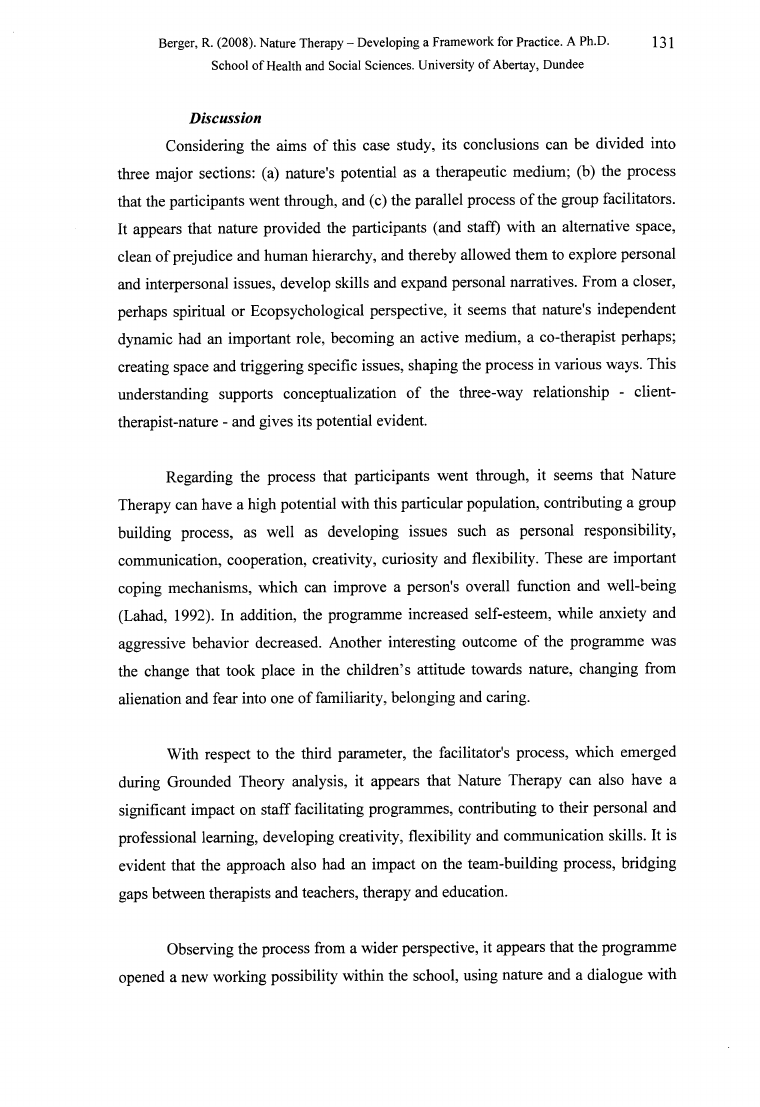
Berger, R. (2008). Nature Therapy - Developing a Framework for Practice. A Ph.D.
131
School of Health and Social Sciences. University of Abertay, Dundee
Discussion
Considering the aims of this case study, its conclusions can be divided into
three major sections: (a) nature's potential as a therapeutic medium; (b) the process
that the participants went through, and (c) the parallel process of the group facilitators.
It appears that nature provided the participants (and staff) with an alternative space,
clean of prejudice and human hierarchy, and thereby allowed them to explore personal
and interpersonal issues, develop skills and expand personal narratives. From a closer,
perhaps spiritual or Ecopsychological perspective, it seems that nature's independent
dynamic had an important role, becoming an active medium, a co-therapist perhaps;
creating space and triggering specific issues, shaping the process in various ways. This
understanding supports conceptualization of the three-way relationship - client-
therapist-nature - and gives its potential evident.
Regarding the process that participants went through, it seems that Nature
Therapy can have a high potential with this particular population, contributing a group
building process, as well as developing issues such as personal responsibility,
communication, cooperation, creativity, curiosity and flexibility. These are important
coping mechanisms, which can improve a person's overall function and well-being
(Lahad, 1992). In addition, the programme increased self-esteem, while anxiety and
aggressive behavior decreased. Another interesting outcome of the programme was
the change that took place in the children’s attitude towards nature, changing from
alienation and fear into one of familiarity, belonging and caring.
With respect to the third parameter, the facilitator's process, which emerged
during Grounded Theory analysis, it appears that Nature Therapy can also have a
significant impact on staff facilitating programmes, contributing to their personal and
professional learning, developing creativity, flexibility and communication skills. It is
evident that the approach also had an impact on the team-building process, bridging
gaps between therapists and teachers, therapy and education.
Observing the process from a wider perspective, it appears that the programme
opened a new working possibility within the school, using nature and a dialogue with
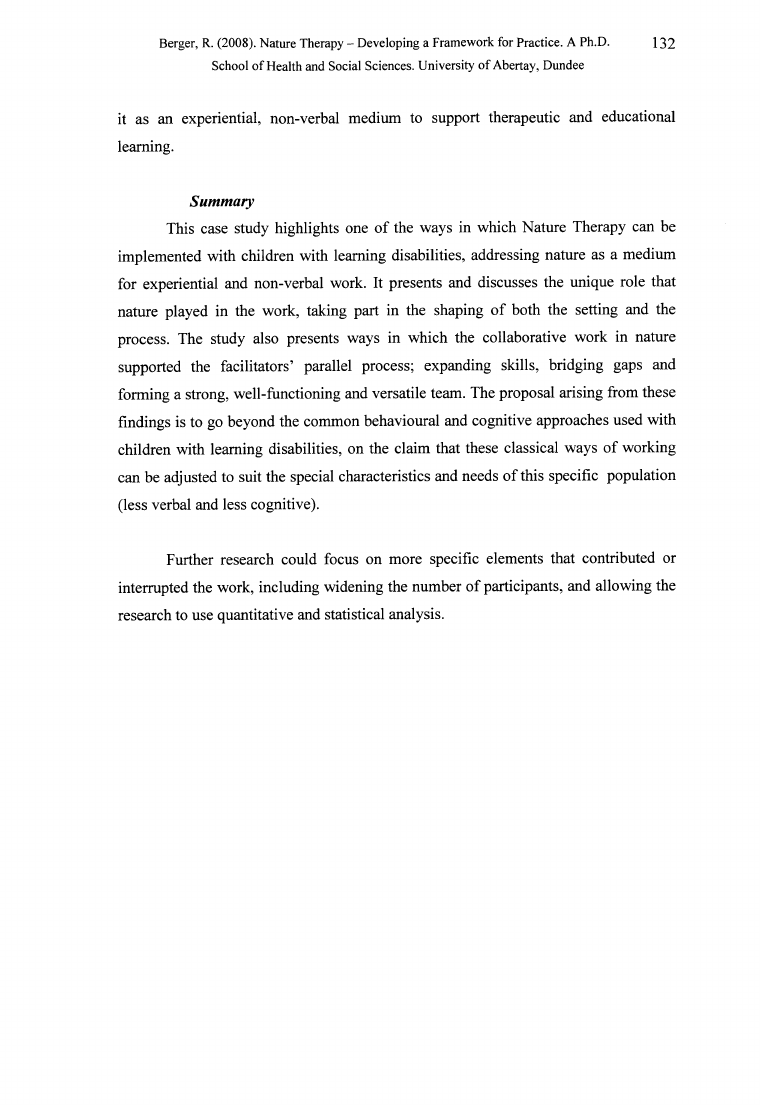
Berger, R. (2008). Nature Therapy - Developing a Framework for Practice. A Ph.D.
132
School of Health and Social Sciences. University of Abertay, Dundee
it as an experiential, non-verbal medium to support therapeutic and educational
learning.
Summary
This case study highlights one of the ways in which Nature Therapy can be
implemented with children with learning disabilities, addressing nature as a medium
for experiential and non-verbal work. It presents and discusses the unique role that
nature played in the work, taking part in the shaping of both the setting and the
process. The study also presents ways in which the collaborative work in nature
supported the facilitators’ parallel process; expanding skills, bridging gaps and
forming a strong, well-functioning and versatile team. The proposal arising from these
findings is to go beyond the common behavioural and cognitive approaches used with
children with learning disabilities, on the claim that these classical ways of working
can be adjusted to suit the special characteristics and needs of this specific population
(less verbal and less cognitive).
Further research could focus on more specific elements that contributed or
interrupted the work, including widening the number of participants, and allowing the
research to use quantitative and statistical analysis.
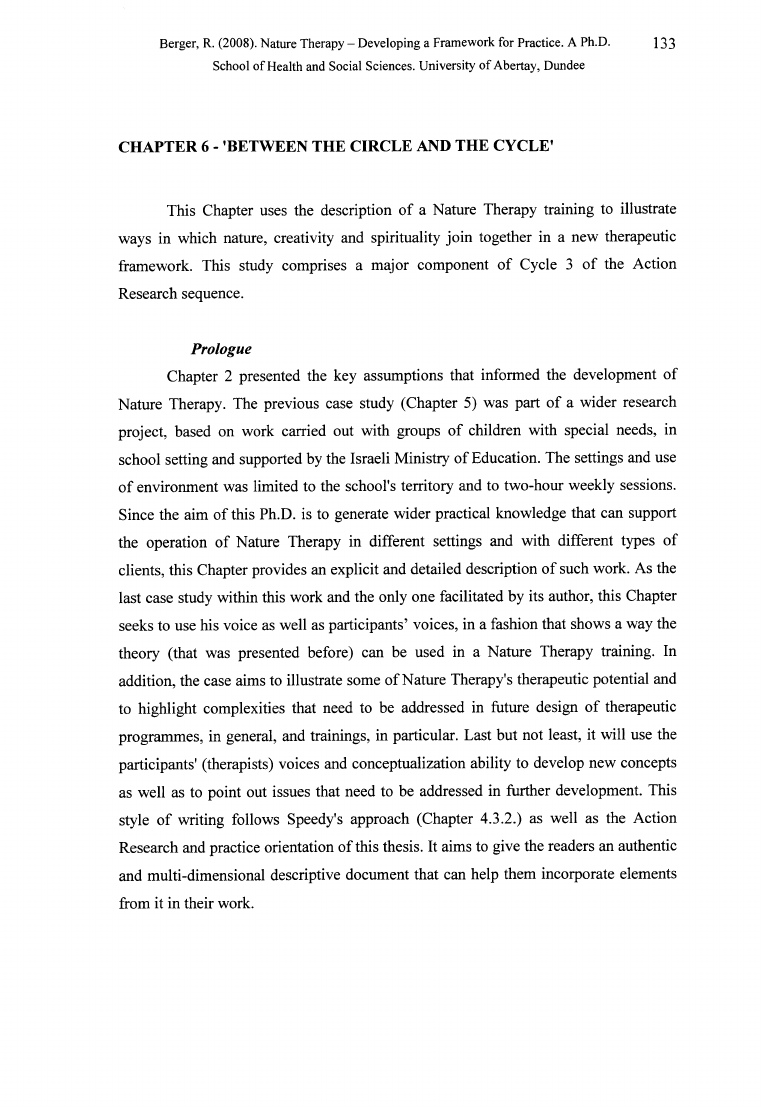
Berger, R. (2008). Nature Therapy - Developing a Framework for Practice. A Ph.D.
133
School of Health and Social Sciences. University of Abertay, Dundee
CHAPTER 6 - ’BETWEEN THE CIRCLE AND THE CYCLE’
This Chapter uses the description of a Nature Therapy training to illustrate
ways in which nature, creativity and spirituality join together in a new therapeutic
framework. This study comprises a major component of Cycle 3 of the Action
Research sequence.
Prologue
Chapter 2 presented the key assumptions that informed the development of
Nature Therapy. The previous case study (Chapter 5) was part of a wider research
project, based on work carried out with groups of children with special needs, in
school setting and supported by the Israeli Ministry of Education. The settings and use
of environment was limited to the school's territory and to two-hour weekly sessions.
Since the aim of this Ph.D. is to generate wider practical knowledge that can support
the operation of Nature Therapy in different settings and with different types of
clients, this Chapter provides an explicit and detailed description of such work. As the
last case study within this work and the only one facilitated by its author, this Chapter
seeks to use his voice as well as participants’ voices, in a fashion that shows a way the
theory (that was presented before) can be used in a Nature Therapy training. In
addition, the case aims to illustrate some of Nature Therapy's therapeutic potential and
to highlight complexities that need to be addressed in future design of therapeutic
programmes, in general, and trainings, in particular. Last but not least, it will use the
participants' (therapists) voices and conceptualization ability to develop new concepts
as well as to point out issues that need to be addressed in further development. This
style of writing follows Speedy's approach (Chapter 4.3.2.) as well as the Action
Research and practice orientation of this thesis. It aims to give the readers an authentic
and multi-dimensional descriptive document that can help them incorporate elements
from it in their work.
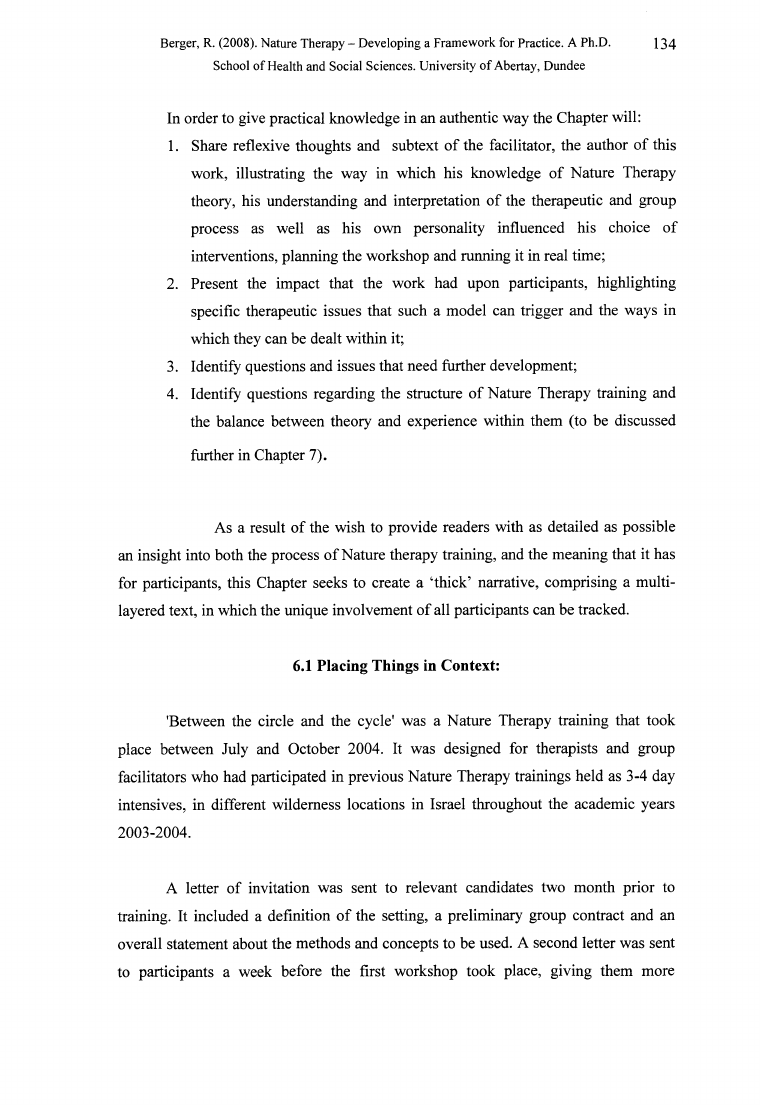
Berger, R. (2008). Nature Therapy - Developing a Framework for Practice. A Ph.D.
134
School of Health and Social Sciences. University of Abertay, Dundee
In order to give practical knowledge in an authentic way the Chapter will:
1. Share reflexive thoughts and subtext of the facilitator, the author of this
work, illustrating the way in which his knowledge of Nature Therapy
theory, his understanding and interpretation of the therapeutic and group
process as well as his own personality influenced his choice of
interventions, planning the workshop and running it in real time;
2. Present the impact that the work had upon participants, highlighting
specific therapeutic issues that such a model can trigger and the ways in
which they can be dealt within it;
3. Identify questions and issues that need further development;
4. Identify questions regarding the structure of Nature Therapy training and
the balance between theory and experience within them (to be discussed
further in Chapter 7).
As a result of the wish to provide readers with as detailed as possible
an insight into both the process of Nature therapy training, and the meaning that it has
for participants, this Chapter seeks to create a ‘thick’ narrative, comprising a multi
layered text, in which the unique involvement of all participants can be tracked.
6.1 Placing Things in Context:
'Between the circle and the cycle' was a Nature Therapy training that took
place between July and October 2004. It was designed for therapists and group
facilitators who had participated in previous Nature Therapy trainings held as 3-4 day
intensives, in different wilderness locations in Israel throughout the academic years
2003-2004.
A letter of invitation was sent to relevant candidates two month prior to
training. It included a definition of the setting, a preliminary group contract and an
overall statement about the methods and concepts to be used. A second letter was sent
to participants a week before the first workshop took place, giving them more
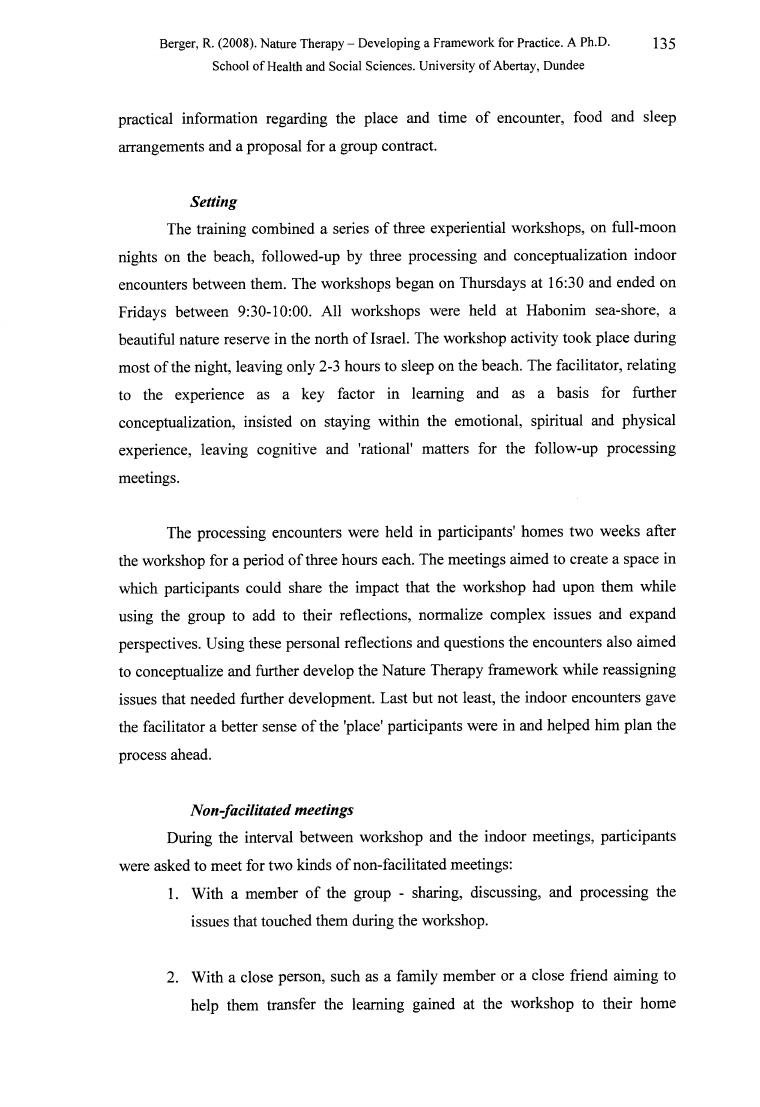
Berger, R. (2008). Nature Therapy - Developing a Framework for Practice. A Ph.D.
135
School of Health and Social Sciences. University of Abertay, Dundee
practical information regarding the place and time of encounter, food and sleep
arrangements and a proposal for a group contract.
Setting
The training combined a series of three experiential workshops, on full-moon
nights on the beach, followed-up by three processing and conceptualization indoor
encounters between them. The workshops began on Thursdays at 16:30 and ended on
Fridays between 9:30-10:00. All workshops were held at Habonim sea-shore, a
beautiful nature reserve in the north of Israel. The workshop activity took place during
most of the night, leaving only 2-3 hours to sleep on the beach. The facilitator, relating
to the experience as a key factor in learning and as a basis for further
conceptualization, insisted on staying within the emotional, spiritual and physical
experience, leaving cognitive and 'rational' matters for the follow-up processing
meetings.
The processing encounters were held in participants' homes two weeks after
the workshop for a period of three hours each. The meetings aimed to create a space in
which participants could share the impact that the workshop had upon them while
using the group to add to their reflections, normalize complex issues and expand
perspectives. Using these personal reflections and questions the encounters also aimed
to conceptualize and further develop the Nature Therapy framework while reassigning
issues that needed further development. Last but not least, the indoor encounters gave
the facilitator a better sense of the 'place' participants were in and helped him plan the
process ahead.
Non-facilitated meetings
During the interval between workshop and the indoor meetings, participants
were asked to meet for two kinds of non-facilitated meetings:
1. With a member of the group - sharing, discussing, and processing the
issues that touched them during the workshop.
2. With a close person, such as a family member or a close friend aiming to
help them transfer the learning gained at the workshop to their home
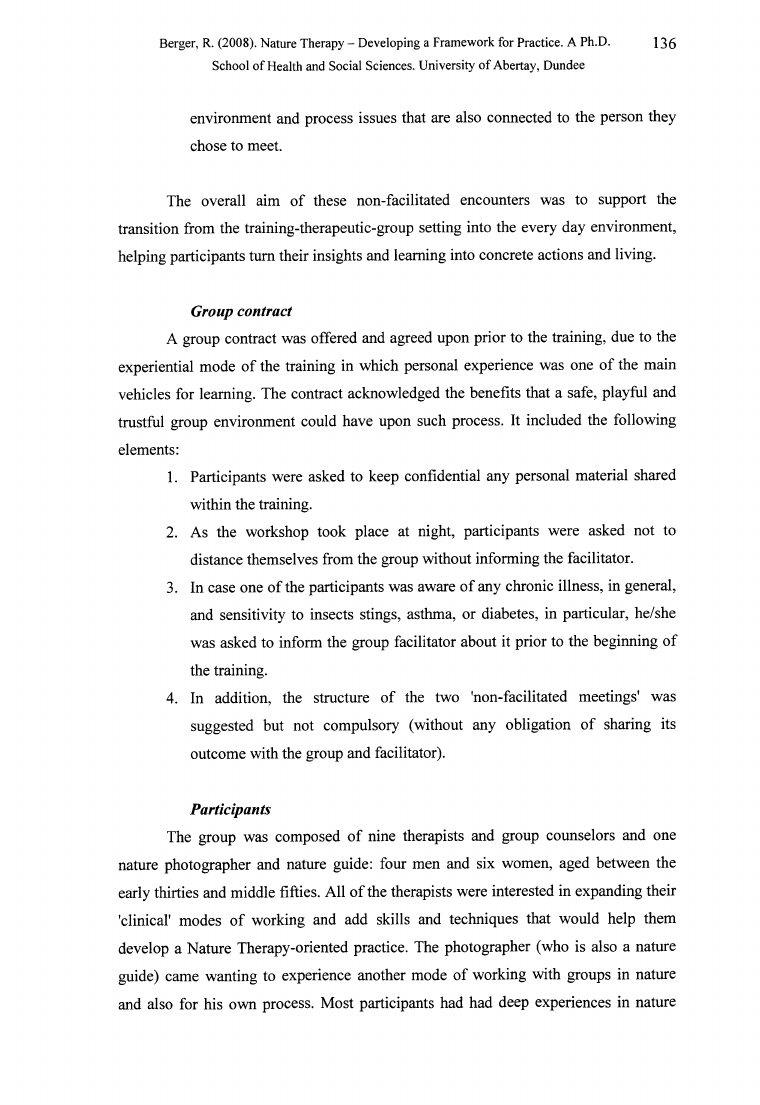
Berger, R. (2008). Nature Therapy - Developing a Framework for Practice. A Ph.D.
136
School of Health and Social Sciences. University of Abertay, Dundee
environment and process issues that are also connected to the person they
chose to meet.
The overall aim of these non-facilitated encounters was to support the
transition from the training-therapeutic-group setting into the every day environment,
helping participants turn their insights and learning into concrete actions and living.
Group contract
A group contract was offered and agreed upon prior to the training, due to the
experiential mode of the training in which personal experience was one of the main
vehicles for learning. The contract acknowledged the benefits that a safe, playful and
trustful group environment could have upon such process. It included the following
elements:
1. Participants were asked to keep confidential any personal material shared
within the training.
2. As the workshop took place at night, participants were asked not to
distance themselves from the group without informing the facilitator.
3. In case one of the participants was aware of any chronic illness, in general,
and sensitivity to insects stings, asthma, or diabetes, in particular, he/she
was asked to inform the group facilitator about it prior to the beginning of
the training.
4. In addition, the structure of the two 'non-facilitated meetings' was
suggested but not compulsory (without any obligation of sharing its
outcome with the group and facilitator).
Participants
The group was composed of nine therapists and group counselors and one
nature photographer and nature guide: four men and six women, aged between the
early thirties and middle fifties. All of the therapists were interested in expanding their
'clinical' modes of working and add skills and techniques that would help them
develop a Nature Therapy-oriented practice. The photographer (who is also a nature
guide) came wanting to experience another mode of working with groups in nature
and also for his own process. Most participants had had deep experiences in nature

Berger, R. (2008). Nature Therapy - Developing a Framework for Practice. A Ph.D.
137
School of Health and Social Sciences. University of Abertay, Dundee
prior to the training, and a strong personal and/or professional connection with it. All
participants except one (Miriam) had taken part in previous Nature Therapy trainings
during the academic year 2003-2004.
The participants - som e personal information (false names)
Abram: A child psychologist and former nature guide; works in hospitals and
health institutions, a bachelor in his early thirties.
Nil: A social worker and group counselor; works with families at risk and
violent men in a government Welfare Centre; in his late twenties, newly married and
father to a baby.
Miriam: A psychotherapist and family therapist, unmarried with an adopted
son, in her forties.
Rachel: A social worker and a family therapist; works with families in a
regional clinic and also has a private clinic at home; in her mid fifties, mother to four
children.
Zara: An art therapist and former nature guide; works in a school and in a
private clinic; in her mid forties, married and a mother of two children.
Tina: A school and group counselor; works in the private and organization
sectors; married and a mother to three children, in her mid forties
Telma: An art therapist; works in a school and in a private clinic; in her mid
forties, married and a mother of two children.
Epos: A nature photographer and nature guide; works for the National
Geographic Magazine and for the private sector; in his mid forties, married and father
of two children.
Sara: A social worker; works in a health maintenance organization; in her
mid forties, married and mother of three children.
Shay: A group facilitator and educator; works in a youth movement; a
bachelor in his early thirties.
Facilitation and supervision
The training was facilitated by Ronen Berger, the author of this Ph.D. and head
of the Nature Therapy Centre, aged 34, a Drama and Body therapist, Ecologist and
dancer. The work was supervised by Michal Doron, a Drama therapist,
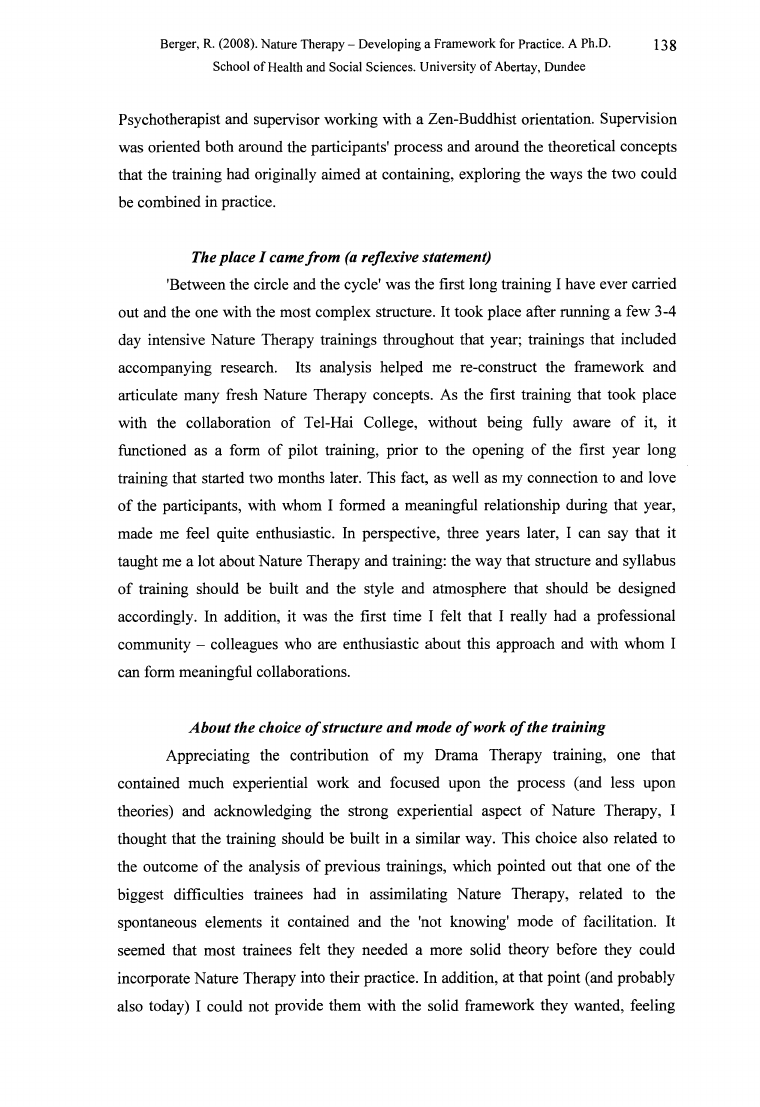
Berger, R. (2008). Nature Therapy - Developing a Framework for Practice. A Ph.D.
138
School of Health and Social Sciences. University of Abertay, Dundee
Psychotherapist and supervisor working with a Zen-Buddhist orientation. Supervision
was oriented both around the participants' process and around the theoretical concepts
that the training had originally aimed at containing, exploring the ways the two could
be combined in practice.
The place I came fro m (a reflexive statement)
'Between the circle and the cycle' was the first long training I have ever carried
out and the one with the most complex structure. It took place after running a few 3-4
day intensive Nature Therapy trainings throughout that year; trainings that included
accompanying research. Its analysis helped me re-construct the framework and
articulate many fresh Nature Therapy concepts. As the first training that took place
with the collaboration of Tel-Hai College, without being fully aware of it, it
functioned as a form of pilot training, prior to the opening of the first year long
training that started two months later. This fact, as well as my connection to and love
of the participants, with whom I formed a meaningful relationship during that year,
made me feel quite enthusiastic. In perspective, three years later, I can say that it
taught me a lot about Nature Therapy and training: the way that structure and syllabus
of training should be built and the style and atmosphere that should be designed
accordingly. In addition, it was the first time I felt that I really had a professional
community - colleagues who are enthusiastic about this approach and with whom I
can form meaningful collaborations.
A bout the choice o f structure and mode o f work o f the training
Appreciating the contribution of my Drama Therapy training, one that
contained much experiential work and focused upon the process (and less upon
theories) and acknowledging the strong experiential aspect of Nature Therapy, I
thought that the training should be built in a similar way. This choice also related to
the outcome of the analysis of previous trainings, which pointed out that one of the
biggest difficulties trainees had in assimilating Nature Therapy, related to the
spontaneous elements it contained and the 'not knowing' mode of facilitation. It
seemed that most trainees felt they needed a more solid theory before they could
incorporate Nature Therapy into their practice. In addition, at that point (and probably
also today) I could not provide them with the solid framework they wanted, feeling
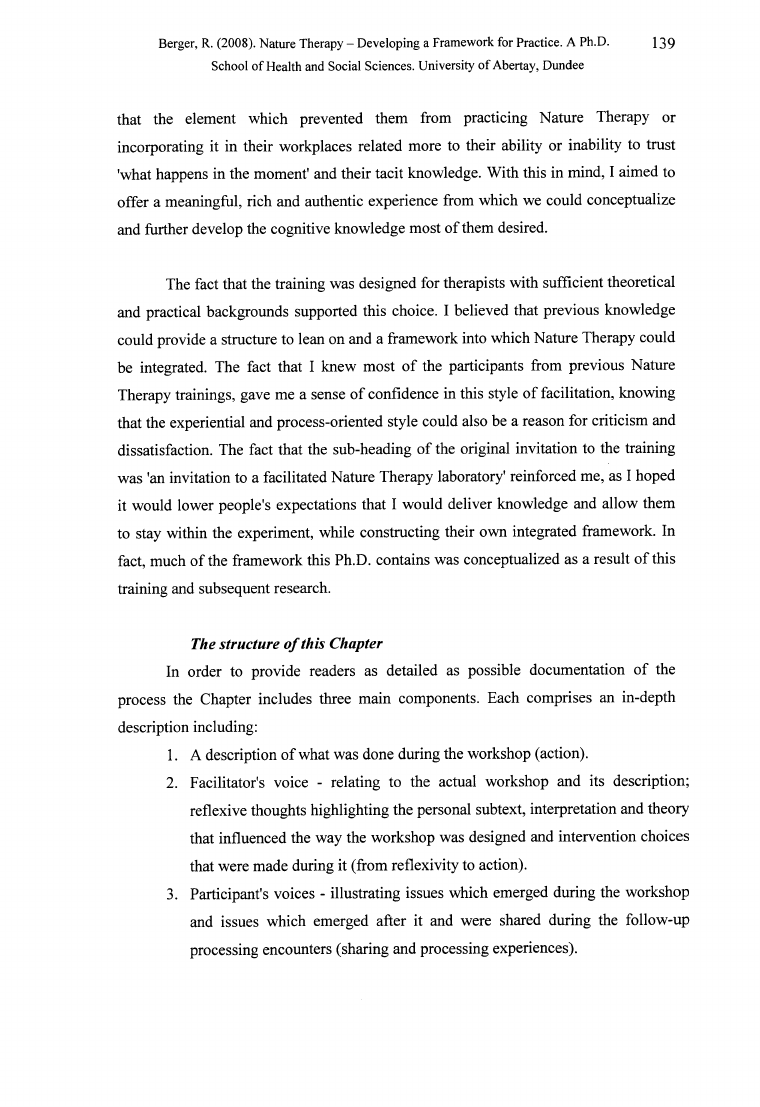
Berger, R. (2008). Nature Therapy - Developing a Framework for Practice. A Ph.D.
139
School of Health and Social Sciences. University of Abertay, Dundee
that the element which prevented them from practicing Nature Therapy or
incorporating it in their workplaces related more to their ability or inability to trust
'what happens in the moment' and their tacit knowledge. With this in mind, I aimed to
offer a meaningful, rich and authentic experience from which we could conceptualize
and further develop the cognitive knowledge most of them desired.
The fact that the training was designed for therapists with sufficient theoretical
and practical backgrounds supported this choice. I believed that previous knowledge
could provide a structure to lean on and a framework into which Nature Therapy could
be integrated. The fact that I knew most of the participants from previous Nature
Therapy trainings, gave me a sense of confidence in this style of facilitation, knowing
that the experiential and process-oriented style could also be a reason for criticism and
dissatisfaction. The fact that the sub-heading of the original invitation to the training
was 'an invitation to a facilitated Nature Therapy laboratory' reinforced me, as I hoped
it would lower people's expectations that I would deliver knowledge and allow them
to stay within the experiment, while constructing their own integrated framework. In
fact, much of the framework this Ph.D. contains was conceptualized as a result of this
training and subsequent research.
The structure o f this Chapter
In order to provide readers as detailed as possible documentation of the
process the Chapter includes three main components. Each comprises an in-depth
description including:
1. A description of what was done during the workshop (action).
2. Facilitator's voice - relating to the actual workshop and its description;
reflexive thoughts highlighting the personal subtext, interpretation and theory
that influenced the way the workshop was designed and intervention choices
that were made during it (from reflexivity to action).
3. Participant's voices - illustrating issues which emerged during the workshop
and issues which emerged after it and were shared during the follow-up
processing encounters (sharing and processing experiences).
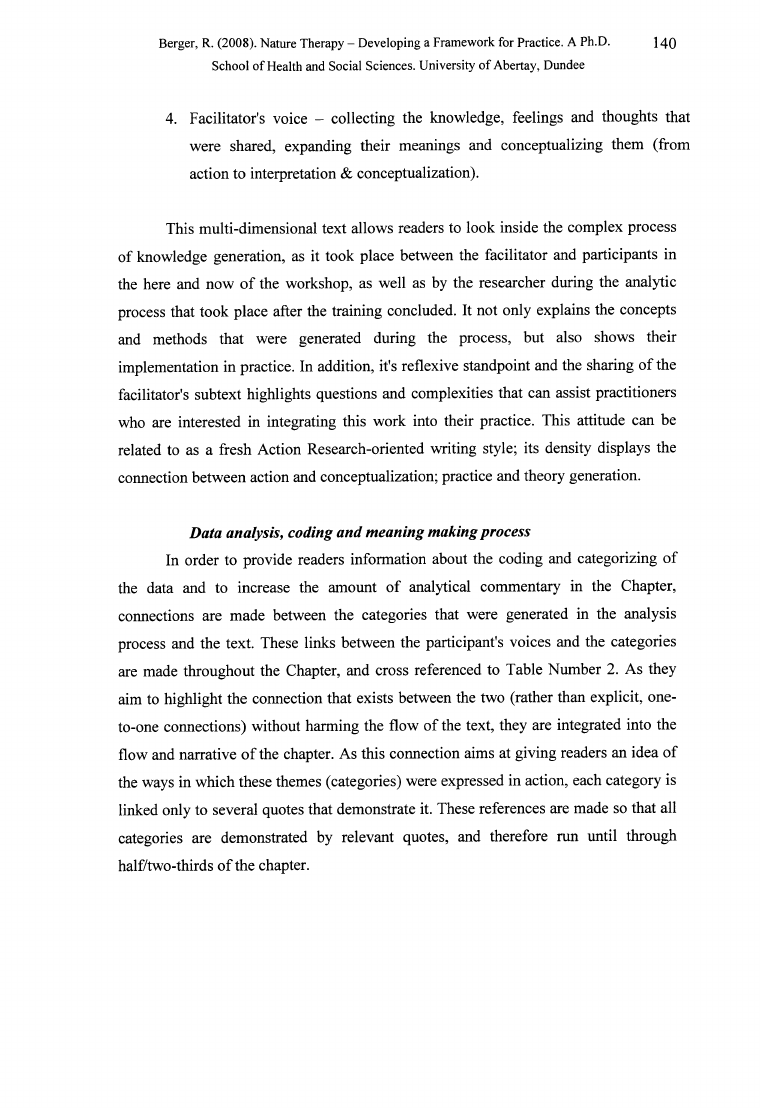
Berger, R. (2008). Nature Therapy - Developing a Framework for Practice. A Ph.D.
140
School of Health and Social Sciences. University of Abertay, Dundee
4. Facilitator's voice - collecting the knowledge, feelings and thoughts that
were shared, expanding their meanings and conceptualizing them (from
action to interpretation & conceptualization).
This multi-dimensional text allows readers to look inside the complex process
of knowledge generation, as it took place between the facilitator and participants in
the here and now of the workshop, as well as by the researcher during the analytic
process that took place after the training concluded. It not only explains the concepts
and methods that were generated during the process, but also shows their
implementation in practice. In addition, it's reflexive standpoint and the sharing of the
facilitator's subtext highlights questions and complexities that can assist practitioners
who are interested in integrating this work into their practice. This attitude can be
related to as a fresh Action Research-oriented writing style; its density displays the
connection between action and conceptualization; practice and theory generation.
Data analysis, coding and meaning making process
In order to provide readers information about the coding and categorizing of
the data and to increase the amount of analytical commentary in the Chapter,
connections are made between the categories that were generated in the analysis
process and the text. These links between the participant's voices and the categories
are made throughout the Chapter, and cross referenced to Table Number 2. As they
aim to highlight the connection that exists between the two (rather than explicit, one-
to-one connections) without harming the flow of the text, they are integrated into the
flow and narrative of the chapter. As this connection aims at giving readers an idea of
the ways in which these themes (categories) were expressed in action, each category is
linked only to several quotes that demonstrate it. These references are made so that all
categories are demonstrated by relevant quotes, and therefore run until through
half/two-thirds of the chapter.
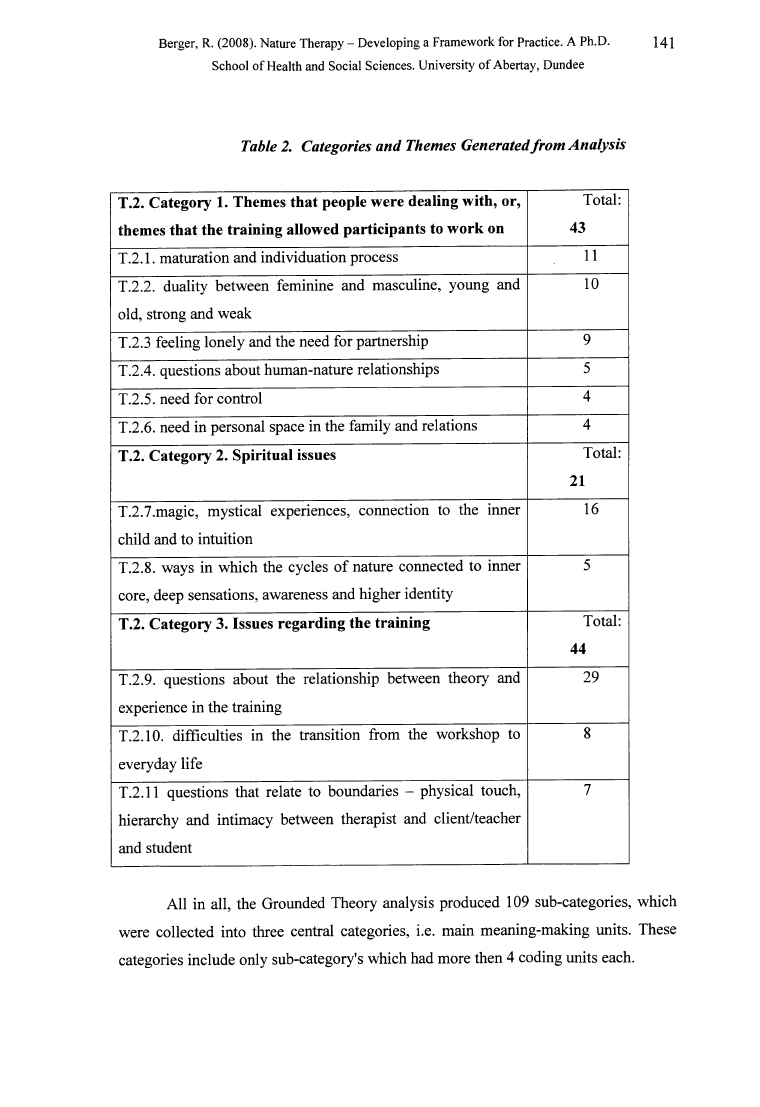
Berger, R. (2008). Nature Therapy - Developing a Framework for Practice. A Ph.D.
141
School of Health and Social Sciences. University of Abertay, Dundee
Table 2, Categories and Themes Generatedfro m A nalysis
T.2. Category 1. Themes that people were dealing with, or,
themes that the training allowed participants to work on
T.2.1. maturation and individuation process
T.2.2. duality between feminine and masculine, young and
old, strong and weak
T.2.3 feeling lonely and the need for partnership
T.2.4. questions about human-nature relationships
T.2.5. need for control
T.2.6. need in personal space in the family and relations
T.2. Category 2. Spiritual issues
T.2.7.magic, mystical experiences, connection to the inner
child and to intuition
T.2.8. ways in which the cycles of nature connected to inner
core, deep sensations, awareness and higher identity
T.2. Category 3. Issues regarding the training
T.2.9. questions about the relationship between theory and
experience in the training
T.2.10. difficulties in the transition from the workshop to
everyday life
T.2.11 questions that relate to boundaries - physical touch,
hierarchy and intimacy between therapist and client/teacher
and student
Total:
43
11
10
9
5
4
4
Total:
21
16
5
Total:
44
29
8
7
All in all, the Grounded Theory analysis produced 109 sub-categories, which
were collected into three central categories, i.e. main meaning-making units. These
categories include only sub-category's which had more then 4 coding units each.
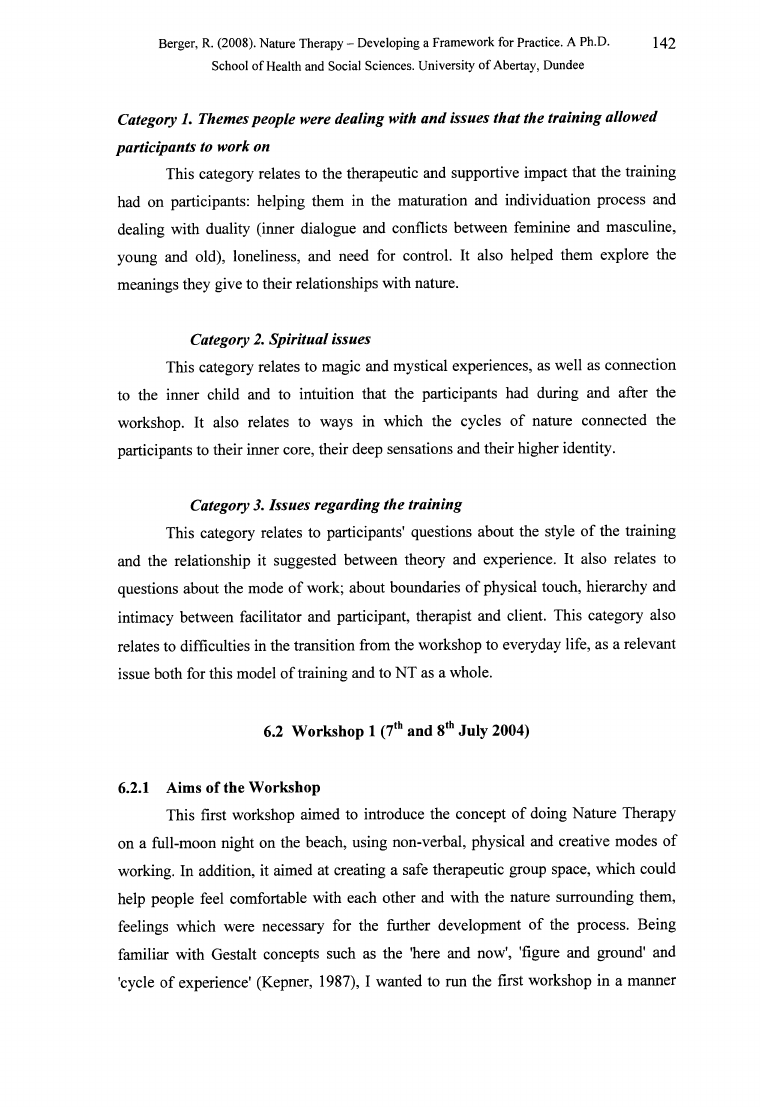
Berger, R. (2008). Nature Therapy - Developing a Framework for Practice. A Ph.D.
142
School of Health and Social Sciences. University of Abertay, Dundee
Category 1. Themes people w ere dealing with an d issues th at the training allow ed
participants to work on
This category relates to the therapeutic and supportive impact that the training
had on participants: helping them in the maturation and individuation process and
dealing with duality (inner dialogue and conflicts between feminine and masculine,
young and old), loneliness, and need for control. It also helped them explore the
meanings they give to their relationships with nature.
Category 2. Spiritu al issues
This category relates to magic and mystical experiences, as well as connection
to the inner child and to intuition that the participants had during and after the
workshop. It also relates to ways in which the cycles of nature connected the
participants to their inner core, their deep sensations and their higher identity.
Category 3. Issues regarding the training
This category relates to participants' questions about the style of the training
and the relationship it suggested between theory and experience. It also relates to
questions about the mode of work; about boundaries of physical touch, hierarchy and
intimacy between facilitator and participant, therapist and client. This category also
relates to difficulties in the transition from the workshop to everyday life, as a relevant
issue both for this model of training and to NT as a whole.
6.2 Workshop 1 (7thand 8thJuly 2004)
6.2.1 Aims of the Workshop
This first workshop aimed to introduce the concept of doing Nature Therapy
on a full-moon night on the beach, using non-verbal, physical and creative modes of
working. In addition, it aimed at creating a safe therapeutic group space, which could
help people feel comfortable with each other and with the nature surrounding them,
feelings which were necessary for the further development of the process. Being
familiar with Gestalt concepts such as the 'here and now', 'figure and ground' and
'cycle of experience' (Kepner, 1987), I wanted to run the first workshop in a manner
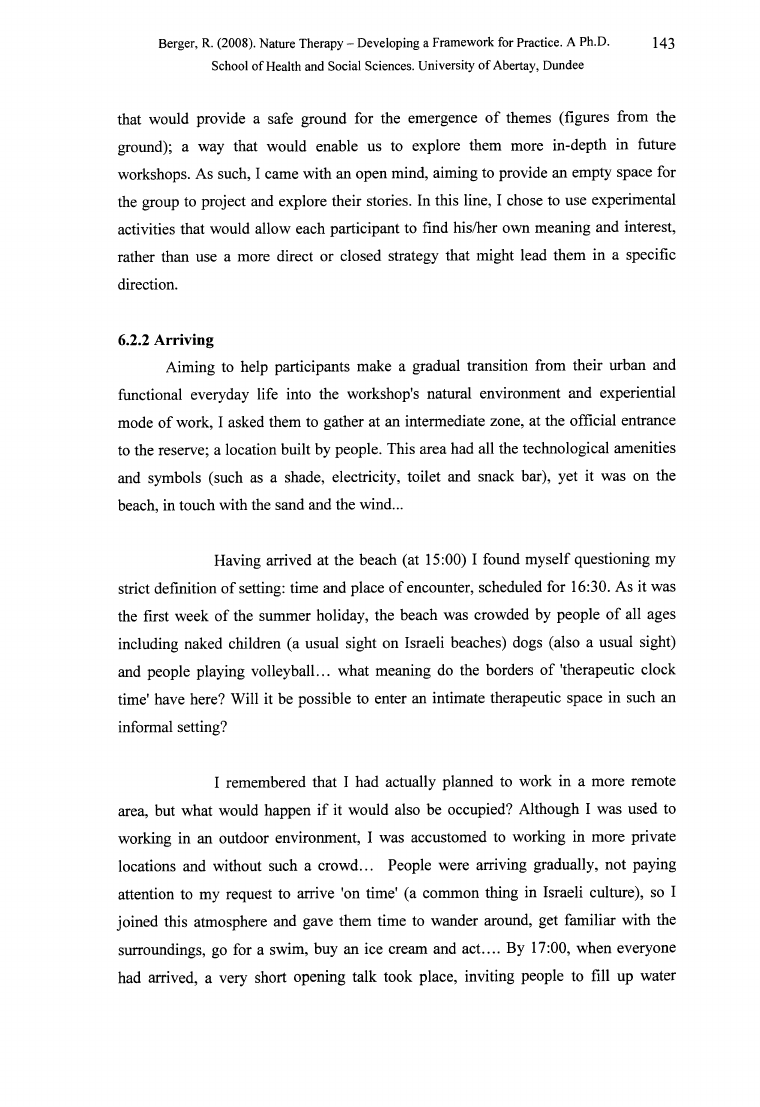
Berger, R. (2008). Nature Therapy - Developing a Framework for Practice. A Ph.D.
143
School of Health and Social Sciences. University of Abertay, Dundee
that would provide a safe ground for the emergence of themes (figures from the
ground); a way that would enable us to explore them more in-depth in future
workshops. As such, I came with an open mind, aiming to provide an empty space for
the group to project and explore their stories. In this line, I chose to use experimental
activities that would allow each participant to find his/her own meaning and interest,
rather than use a more direct or closed strategy that might lead them in a specific
direction.
6.2.2 Arriving
Aiming to help participants make a gradual transition from their urban and
functional everyday life into the workshop's natural environment and experiential
mode of work, I asked them to gather at an intermediate zone, at the official entrance
to the reserve; a location built by people. This area had all the technological amenities
and symbols (such as a shade, electricity, toilet and snack bar), yet it was on the
beach, in touch with the sand and the wind...
Having arrived at the beach (at 15:00) I found myself questioning my
strict definition of setting: time and place of encounter, scheduled for 16:30. As it was
the first week of the summer holiday, the beach was crowded by people of all ages
including naked children (a usual sight on Israeli beaches) dogs (also a usual sight)
and people playing volleyball... what meaning do the borders of 'therapeutic clock
time' have here? Will it be possible to enter an intimate therapeutic space in such an
informal setting?
I remembered that I had actually planned to work in a more remote
area, but what would happen if it would also be occupied? Although I was used to
working in an outdoor environment, I was accustomed to working in more private
locations and without such a crowd... People were arriving gradually, not paying
attention to my request to arrive 'on time' (a common thing in Israeli culture), so I
joined this atmosphere and gave them time to wander around, get familiar with the
surroundings, go for a swim, buy an ice cream and act.... By 17:00, when everyone
had arrived, a very short opening talk took place, inviting people to fill up water
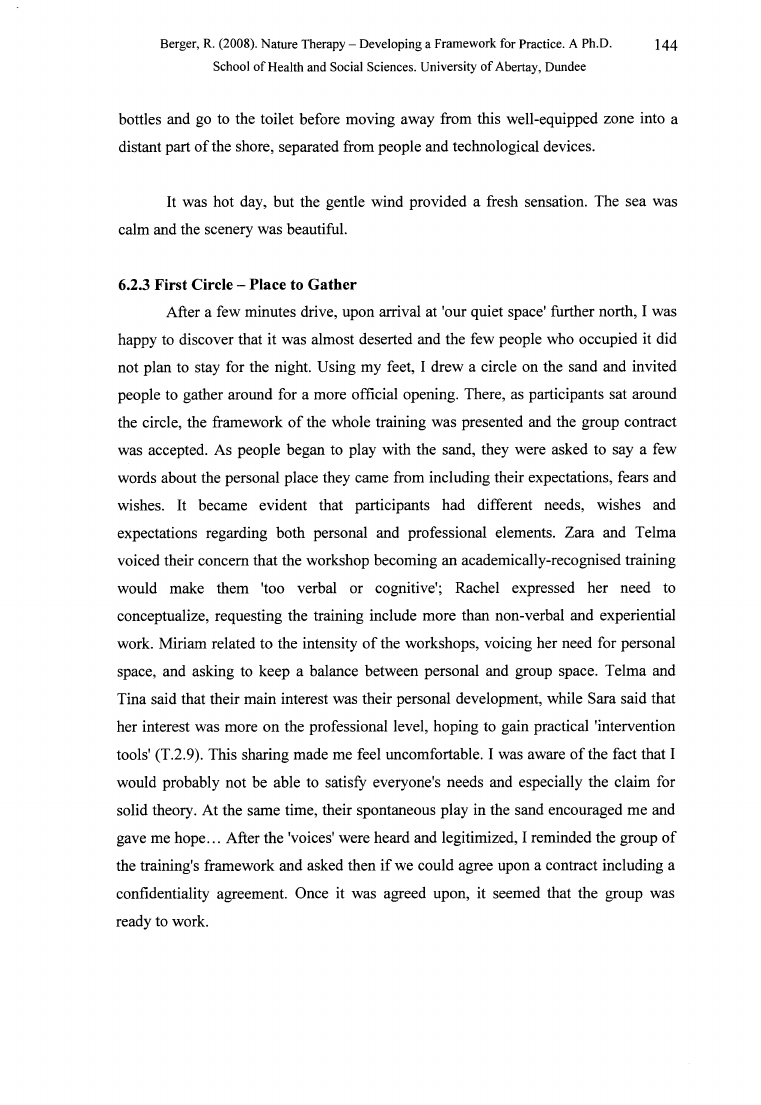
Berger, R. (2008). Nature Therapy - Developing a Framework for Practice. A Ph.D.
144
School of Health and Social Sciences. University of Abertay, Dundee
bottles and go to the toilet before moving away from this well-equipped zone into a
distant part o f the shore, separated from people and technological devices.
It was hot day, but the gentle wind provided a fresh sensation. The sea was
calm and the scenery was beautiful.
6.2.3 First Circle - Place to Gather
After a few minutes drive, upon arrival at 'our quiet space' further north, I was
happy to discover that it was almost deserted and the few people who occupied it did
not plan to stay for the night. Using my feet, I drew a circle on the sand and invited
people to gather around for a more official opening. There, as participants sat around
the circle, the framework o f the whole training was presented and the group contract
was accepted. As people began to play with the sand, they were asked to say a few
words about the personal place they came from including their expectations, fears and
wishes. It became evident that participants had different needs, wishes and
expectations regarding both personal and professional elements. Zara and Telma
voiced their concern that the workshop becoming an academically-recognised training
would make them 'too verbal or cognitive'; Rachel expressed her need to
conceptualize, requesting the training include more than non-verbal and experiential
work. Miriam related to the intensity o f the workshops, voicing her need for personal
space, and asking to keep a balance between personal and group space. Telma and
Tina said that their main interest was their personal development, while Sara said that
her interest was more on the professional level, hoping to gain practical 'intervention
tools' (T.2.9). This sharing made me feel uncomfortable. I was aware o f the fact that I
would probably not be able to satisfy everyone's needs and especially the claim for
solid theory. At the same time, their spontaneous play in the sand encouraged me and
gave me h op e... After the 'voices' were heard and legitimized, I reminded the group o f
the training's framework and asked then if we could agree upon a contract including a
confidentiality agreement. Once it was agreed upon, it seemed that the group was
ready to work.
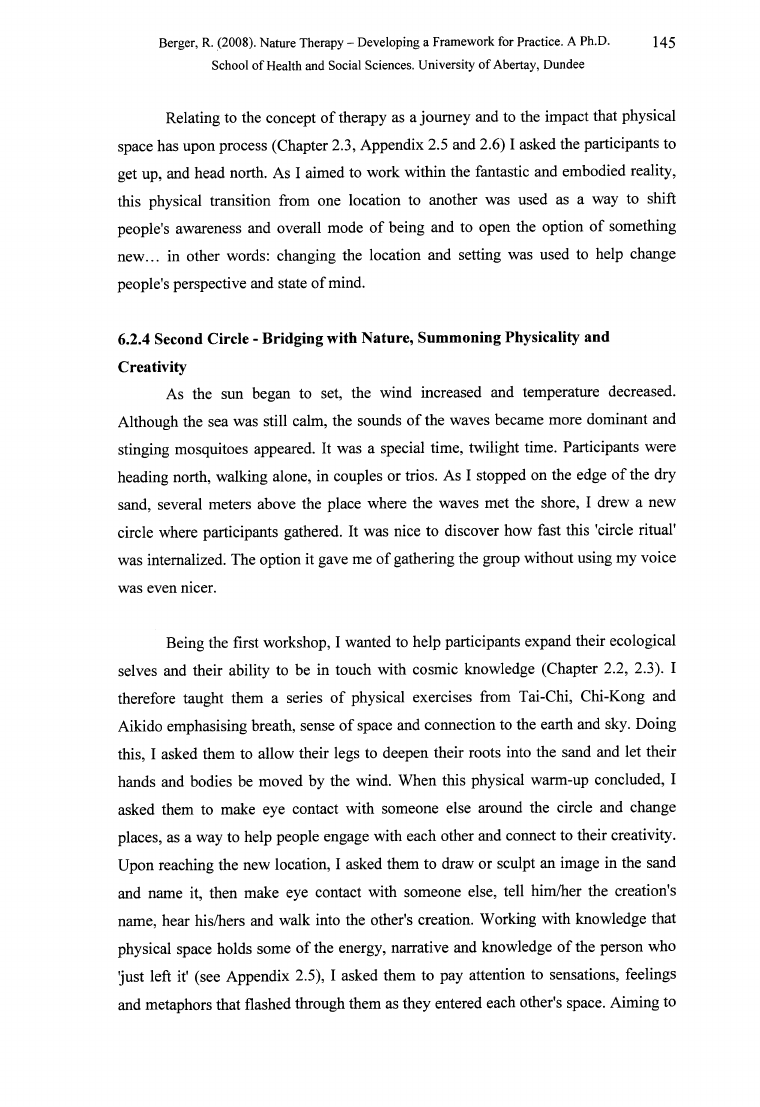
Berger, R. (2008). Nature Therapy - Developing a Framework for Practice. A Ph.D.
145
School of Health and Social Sciences. University of Abertay, Dundee
Relating to the concept o f therapy as a journey and to the impact that physical
space has upon process (Chapter 2.3, Appendix 2.5 and 2.6) I asked the participants to
get up, and head north. As I aimed to work within the fantastic and embodied reality,
this physical transition from one location to another was used as a way to shift
people's awareness and overall mode o f being and to open the option o f something
new ... in other words: changing the location and setting was used to help change
people's perspective and state o f mind.
6.2.4 Second Circle - Bridging with Nature, Summoning Physicality and
Creativity
As the sun began to set, the wind increased and temperature decreased.
Although the sea was still calm, the sounds o f the waves became more dominant and
stinging mosquitoes appeared. It was a special time, twilight time. Participants were
heading north, walking alone, in couples or trios. A s I stopped on the edge o f the dry
sand, several meters above the place where the waves met the shore, I drew a new
circle where participants gathered. It was nice to discover how fast this 'circle ritual'
was internalized. The option it gave me o f gathering the group without using my voice
was even nicer.
Being the first workshop, I wanted to help participants expand their ecological
selves and their ability to be in touch with cosmic knowledge (Chapter 2.2, 2.3). I
therefore taught them a series o f physical exercises from Tai-Chi, Chi-Kong and
Aikido emphasising breath, sense o f space and connection to the earth and sky. Doing
this, I asked them to allow their legs to deepen their roots into the sand and let their
hands and bodies be moved by the wind. When this physical warm-up concluded, I
asked them to make eye contact with someone else around the circle and change
places, as a way to help people engage with each other and connect to their creativity.
Upon reaching the new location, I asked them to draw or sculpt an image in the sand
and name it, then make eye contact with someone else, tell him/her the creation's
name, hear his/hers and walk into the other's creation. Working with knowledge that
physical space holds some o f the energy, narrative and knowledge o f the person who
'just left if (see Appendix 2.5), I asked them to pay attention to sensations, feelings
and metaphors that flashed through them as they entered each other's space. Aiming to
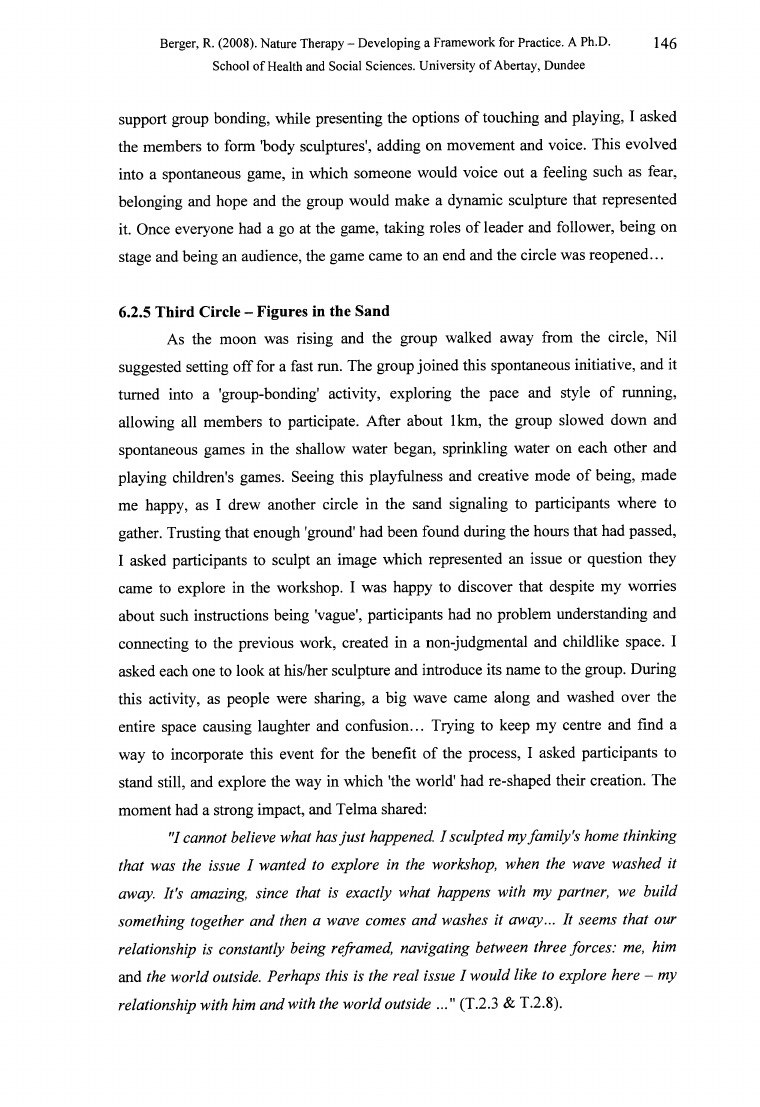
Berger, R. (2008). Nature Therapy - Developing a Framework for Practice. A Ph.D.
146
School of Health and Social Sciences. University of Abertay, Dundee
support group bonding, while presenting the options o f touching and playing, I asked
the members to form 'body sculptures', adding on movement and voice. This evolved
into a spontaneous game, in which someone would voice out a feeling such as fear,
belonging and hope and the group would make a dynamic sculpture that represented
it. Once everyone had a go at the game, taking roles o f leader and follower, being on
stage and being an audience, the game came to an end and the circle was reopened...
6.2.5 Third Circle - Figures in the Sand
As the moon was rising and the group walked away from the circle, N il
suggested setting o ff for a fast run. The group joined this spontaneous initiative, and it
turned into a 'group-bonding' activity, exploring the pace and style o f running,
allowing all members to participate. After about 1km, the group slowed down and
spontaneous games in the shallow water began, sprinkling water on each other and
playing children's games. Seeing this playfulness and creative mode o f being, made
me happy, as I drew another circle in the sand signaling to participants where to
gather. Trusting that enough 'ground' had been found during the hours that had passed,
I asked participants to sculpt an image which represented an issue or question they
came to explore in the workshop. I was happy to discover that despite my worries
about such instructions being 'vague', participants had no problem understanding and
connecting to the previous work, created in a non-judgmental and childlike space. I
asked each one to look at his/her sculpture and introduce its name to the group. During
this activity, as people were sharing, a big wave came along and washed over the
entire space causing laughter and confusion... Trying to keep my centre and find a
way to incorporate this event for the benefit o f the process, I asked participants to
stand still, and explore the way in which 'the world' had re-shaped their creation. The
moment had a strong impact, and Telma shared:
"I c a n n o t b e lie v e w h a t h a s j u s t h a p p e n e d . I s c u lp te d m y f a m ily 's h o m e th in k in g
th a t w a s the issue I w a n te d to exp lo re in the w orkshop, w h en the w a ve w a sh e d it
aw ay. It's am azing, sin ce th at is ex a ctly w h a t happens w ith m y partn er, w e b u ild
som eth in g togeth er a n d then a w a ve com es a n d w ash es it a w a y... It seem s th a t our
relation sh ip is con stan tly bein g refram ed, n avig a tin g betw een three fo rc e s: me, him
and th e w o r ld o u tsid e. P e r h a p s th is is th e r e a l issu e I w o u ld lik e to e x p lo re h e re - m y
r e la tio n s h ip w ith him a n d w ith th e w o r l d o u ts id e ..." (T.2.3 & T.2.8).
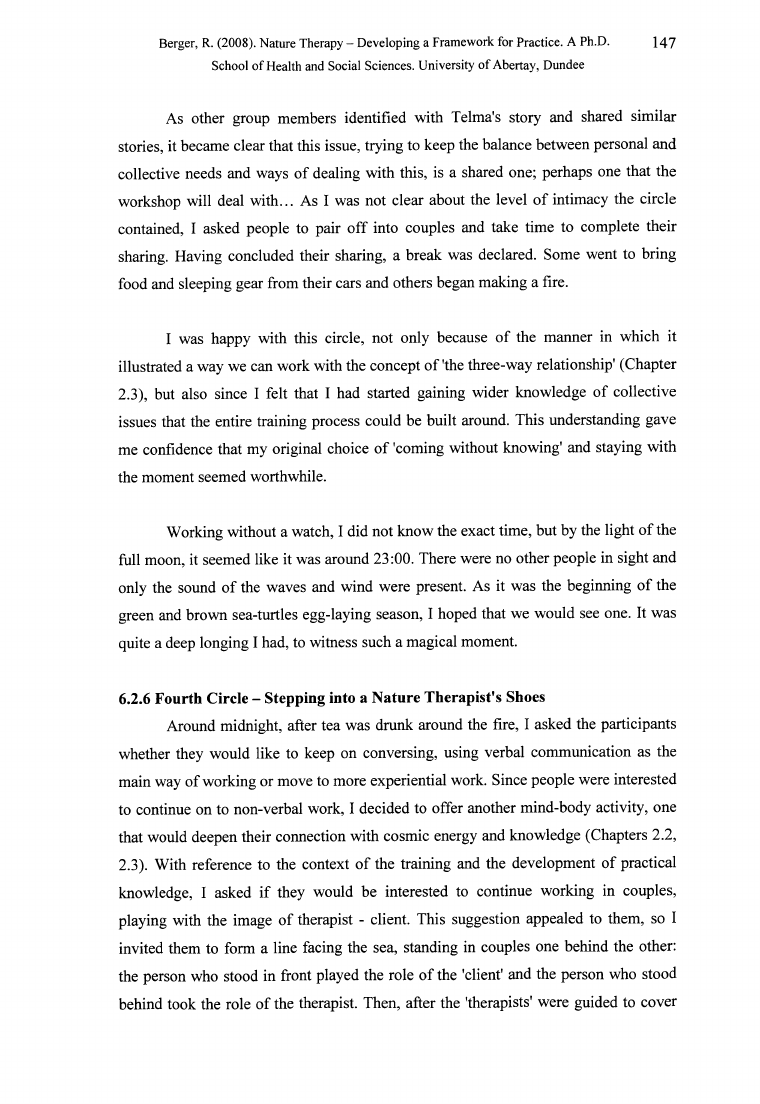
Berger, R. (2008). Nature Therapy - Developing a Framework for Practice. A Ph.D.
147
School of Health and Social Sciences. University of Abertay, Dundee
As other group members identified with Telma's story and shared similar
stories, it became clear that this issue, trying to keep the balance between personal and
collective needs and ways o f dealing with this, is a shared one; perhaps one that the
workshop will deal w ith... As I was not clear about the level o f intimacy the circle
contained, I asked people to pair o ff into couples and take time to complete their
sharing. Having concluded their sharing, a break was declared. Some went to bring
food and sleeping gear from their cars and others began making a fire.
I was happy with this circle, not only because o f the manner in which it
illustrated a way we can work with the concept o f 'the three-way relationship' (Chapter
2.3) , but also since I felt that I had started gaining wider knowledge o f collective
issues that the entire training process could be built around. This understanding gave
me confidence that my original choice o f 'coming without knowing' and staying with
the moment seemed worthwhile.
Working without a watch, I did not know the exact time, but by the light o f the
full moon, it seemed like it was around 23:00. There were no other people in sight and
only the sound o f the waves and wind were present. As it was the beginning o f the
green and brown sea-turtles egg-laying season, I hoped that we would see one. It was
quite a deep longing I had, to witness such a magical moment.
6.2.6 Fourth Circle - Stepping into a Nature Therapist's Shoes
Around midnight, after tea was drunk around the fire, I asked the participants
whether they would like to keep on conversing, using verbal communication as the
main way o f working or move to more experiential work. Since people were interested
to continue on to non-verbal work, I decided to offer another mind-body activity, one
that would deepen their connection with cosm ic energy and knowledge (Chapters 2.2,
2.3) . With reference to the context o f the training and the development o f practical
knowledge, I asked if they would be interested to continue working in couples,
playing with the image o f therapist - client. This suggestion appealed to them, so I
invited them to form a line facing the sea, standing in couples one behind the other:
the person who stood in front played the role o f the 'client' and the person who stood
behind took the role o f the therapist. Then, after the 'therapists' were guided to cover
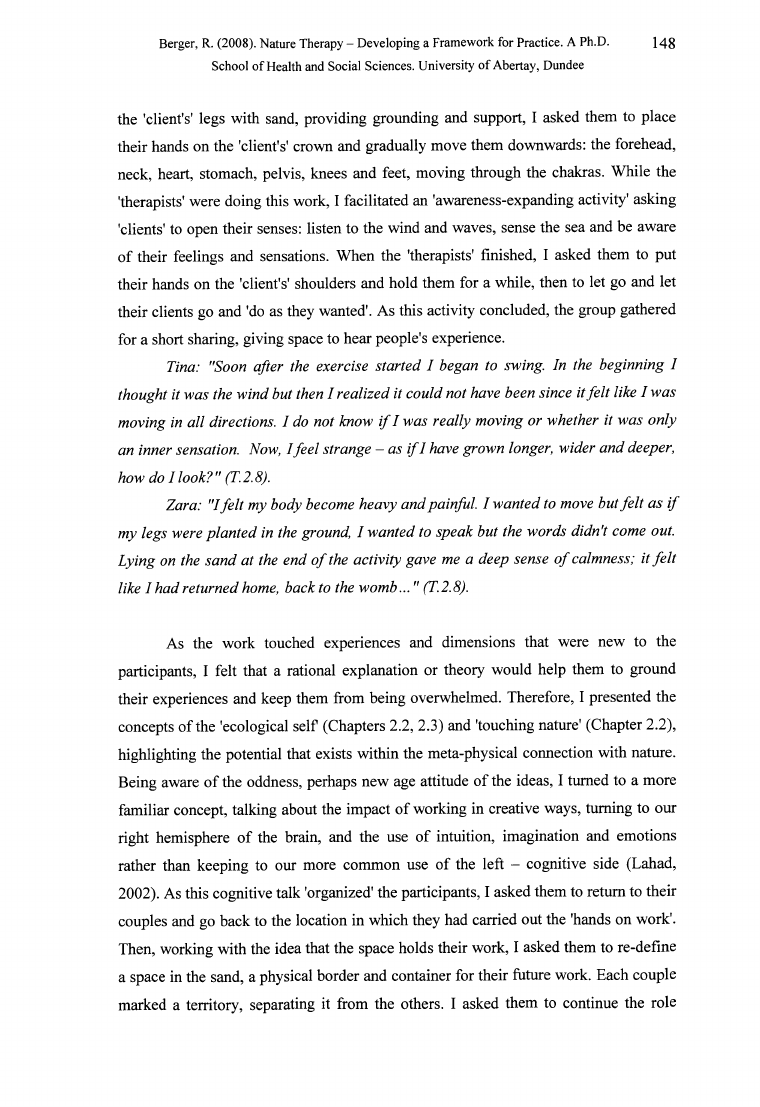
Berger, R. (2008). Nature Therapy - Developing a Framework for Practice. A Ph.D.
148
School of Health and Social Sciences. University of Abertay, Dundee
the 'client's' legs with sand, providing grounding and support, I asked them to place
their hands on the 'client's' crown and gradually move them downwards: the forehead,
neck, heart, stomach, pelvis, knees and feet, moving through the chakras. While the
'therapists' were doing this work, I facilitated an 'awareness-expanding activity' asking
'clients' to open their senses: listen to the wind and waves, sense the sea and be aware
o f their feelings and sensations. When the 'therapists' finished, I asked them to put
their hands on the 'client's' shoulders and hold them for a while, then to let go and let
their clients go and 'do as they wanted'. As this activity concluded, the group gathered
for a short sharing, giving space to hear people's experience.
Tina: "Soon after the exercise sta rte d I began to sw ing. In the begin n in g I
thought it w a s the w in d but then I re a lize d it co u ld n ot have been sin ce itf e lt like I w a s
m o vin g in a ll directio n s. I d o n o t kn ow i f I w a s re a lly m o vin g o r w h eth er it w a s o n ly
an inner sensation. N ow, I fe e l stran ge - a s i f I have grow n longer, w id er a n d deeper,
h o w d o I loo k ? " (T. 2.8).
Zara: " Ifelt m y body becom e h eavy an d painful. I w a n ted to m ove butf e lt as i f
m y leg s w ere p la n te d in the ground, I w a n te d to sp ea k bu t the w o rd s didn 't com e out.
L yin g on the sa n d a t the en d o f the a ctivity g a ve m e a d eep sen se o f calm ness; it f e lt
like I h a d retu rn ed home, back to the w o m b ..." (T.2.8).
As the work touched experiences and dimensions that were new to the
participants, I felt that a rational explanation or theory would help them to ground
their experiences and keep them from being overwhelmed. Therefore, I presented the
concepts o f the 'ecological self (Chapters 2.2, 2.3) and 'touching nature' (Chapter 2.2),
highlighting the potential that exists within the meta-physical connection with nature.
Being aware o f the oddness, perhaps new age attitude o f the ideas, I turned to a more
familiar concept, talking about the impact o f working in creative ways, turning to our
right hemisphere o f the brain, and the use o f intuition, imagination and emotions
rather than keeping to our more common use o f the left - cognitive side (Lahad,
2002). As this cognitive talk 'organized' the participants, I asked them to return to their
couples and go back to the location in which they had carried out the 'hands on work'.
Then, working with the idea that the space holds their work, I asked them to re-defme
a space in the sand, a physical border and container for their future work. Each couple
marked a territory, separating it from the others. I asked them to continue the role
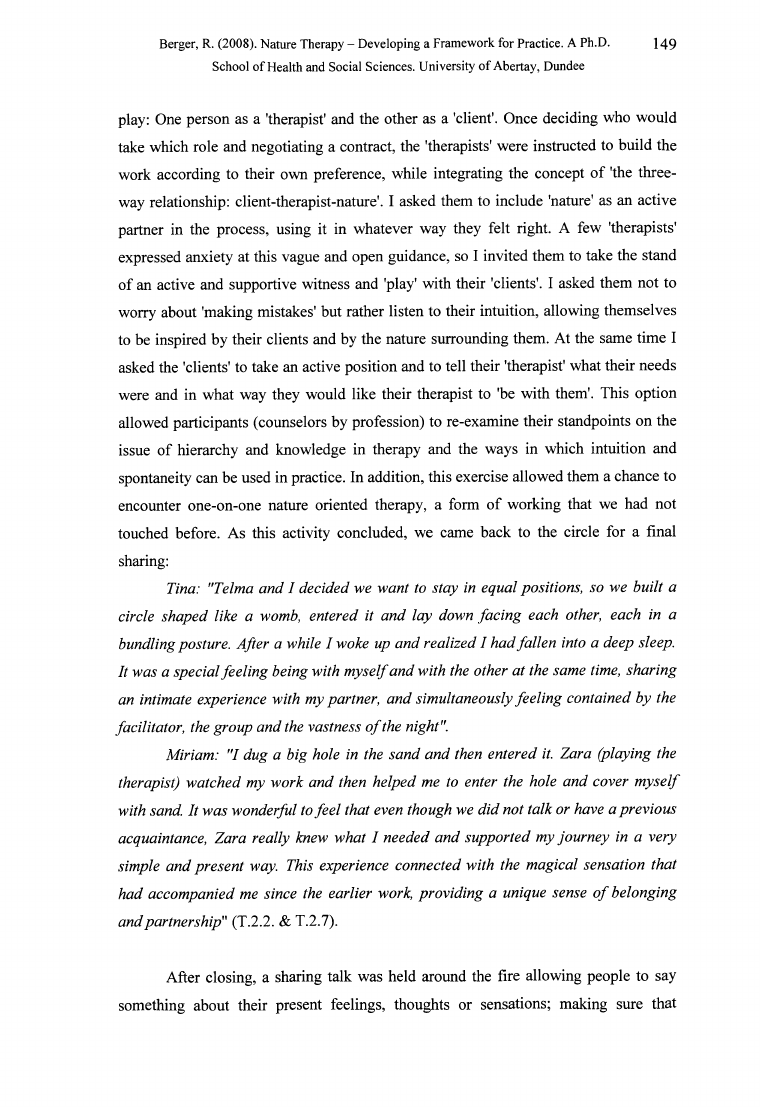
Berger, R. (2008). Nature Therapy - Developing a Framework for Practice. A Ph.D.
149
School of Health and Social Sciences. University of Abertay, Dundee
play: One person as a 'therapist' and the other as a 'client'. Once deciding who would
take which role and negotiating a contract, the 'therapists' were instructed to build the
work according to their own preference, while integrating the concept o f 'the three-
way relationship: client-therapist-nature'. I asked them to include 'nature' as an active
partner in the process, using it in whatever way they felt right. A few 'therapists'
expressed anxiety at this vague and open guidance, so I invited them to take the stand
o f an active and supportive witness and 'play' with their 'clients'. I asked them not to
worry about 'making mistakes' but rather listen to their intuition, allowing themselves
to be inspired by their clients and by the nature surrounding them. At the same time I
asked the 'clients' to take an active position and to tell their 'therapist' what their needs
were and in what way they would like their therapist to 'be with them'. This option
allowed participants (counselors by profession) to re-examine their standpoints on the
issue o f hierarchy and knowledge in therapy and the ways in which intuition and
spontaneity can be used in practice. In addition, this exercise allowed them a chance to
encounter one-on-one nature oriented therapy, a form o f working that we had not
touched before. As this activity concluded, we came back to the circle for a final
sharing:
Tina: "Telm a a n d I d e c id e d w e w a n t to sta y in eq u a l p o sitio n s, so w e b u ilt a
circle sh a p e d like a w om b, e n tere d it a n d la y dow n fa c in g each other, each in a
bundling p ostu re. A fter a w h ile I w oke up a n d re a lized I h a d fa lle n into a d eep sleep.
It w a s a sp e cia l fe e lin g bein g w ith m y se lf a n d w ith the oth er a t the sam e tim e, sh a rin g
an intim ate experience w ith m y partn er, a n d sim u ltan eou sly fee lin g con tain ed b y the
fa c ilita to r, the g ro u p a n d the va stn ess o f the night".
M iria m : "I d u g a b ig h o le in th e s a n d a n d th en e n te r e d it. Z a r a (p la y in g th e
therapist) w a tch ed m y w o rk a n d then h elp ed m e to enter the hole a n d co ver m y se lf
w ith sand. It w a s w onderful to fe e l that even though w e d id n ot talk or have a p revio u s
acquaintan ce, Z a ra rea lly knew w h a t I n e e d e d a n d su p p o rte d m y jo u rn e y in a v e ry
sim ple a n d p re se n t w ay. This experien ce co n n ected w ith the m a g ica l sen sa tio n th a t
h a d a ccom pan ied m e since the ea rlier work, p ro v id in g a unique sense o f belon gin g
a n d p a r tn e r s h ip " (T.2.2. & T.2.7).
After closing, a sharing talk was held around the fire allowing people to say
something about their present feelings, thoughts or sensations; making sure that
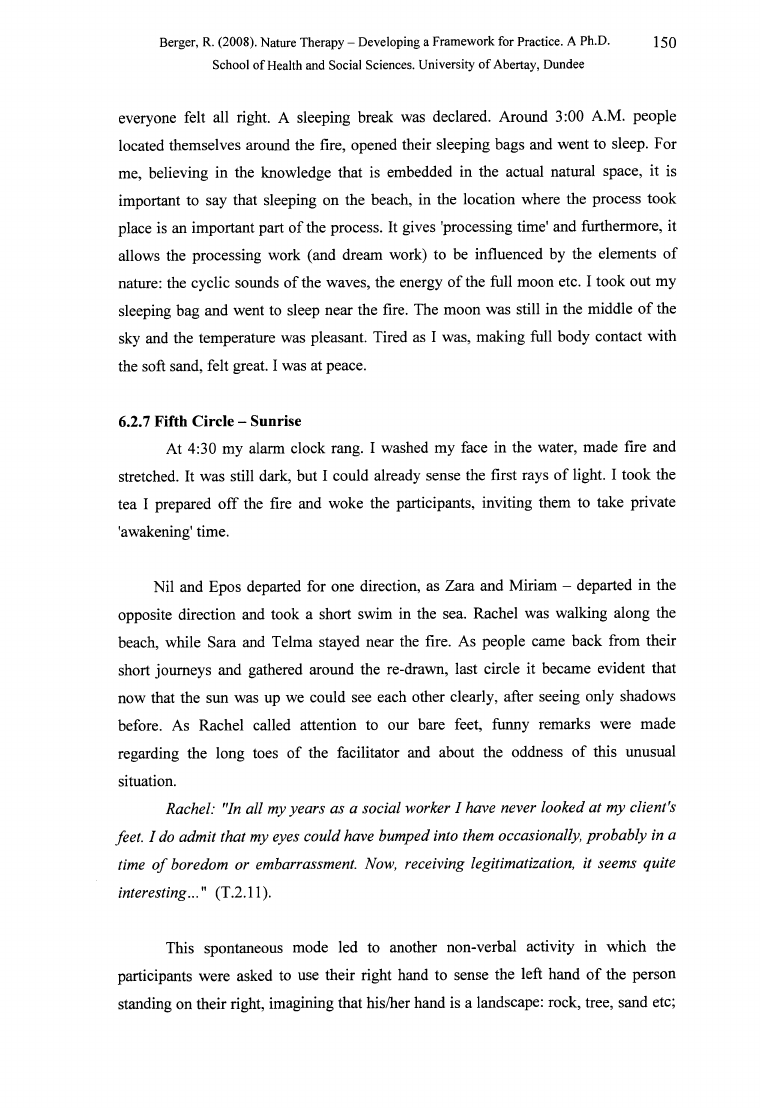
Berger, R. (2008). Nature Therapy - Developing a Framework for Practice. A Ph.D.
150
School of Health and Social Sciences. University of Abertay, Dundee
everyone felt all right. A sleeping break was declared. Around 3:00 A.M. people
located themselves around the fire, opened their sleeping bags and went to sleep. For
me, believing in the knowledge that is embedded in the actual natural space, it is
important to say that sleeping on the beach, in the location where the process took
place is an important part o f the process. It gives 'processing time' and furthermore, it
allows the processing work (and dream work) to be influenced by the elements o f
nature: the cyclic sounds o f the waves, the energy o f the full moon etc. I took out my
sleeping bag and went to sleep near the fire. The moon was still in the middle o f the
sky and the temperature was pleasant. Tired as I was, making full body contact with
the soft sand, felt great. I was at peace.
6.2.7 Fifth Circle - Sunrise
At 4:30 my alarm clock rang. I washed my face in the water, made fire and
stretched. It was still dark, but I could already sense the first rays o f light. I took the
tea I prepared o ff the fire and woke the participants, inviting them to take private
'awakening' time.
N il and Epos departed for one direction, as Zara and Miriam - departed in the
opposite direction and took a short swim in the sea. Rachel was walking along the
beach, while Sara and Telma stayed near the fire. As people came back from their
short journeys and gathered around the re-drawn, last circle it became evident that
now that the sun was up we could see each other clearly, after seeing only shadows
before. As Rachel called attention to our bare feet, funny remarks were made
regarding the long toes o f the facilitator and about the oddness o f this unusual
situation.
R a c h e l: "In a l l m y y e a r s a s a s o c ia l w o r k e r I h a v e n e v e r lo o k e d a t m y c lie n t's
feet. I do a d m it th a t m y eyes co u ld have bu m ped into them occasion ally, p r o b a b ly in a
tim e o f boredom or em barrassm ent. N ow , receivin g legitim atization, it seem s quite
in terestin g ..." (T.2.11).
This spontaneous mode led to another non-verbal activity in which the
participants were asked to use their right hand to sense the left hand o f the person
standing on their right, imagining that his/her hand is a landscape: rock, tree, sand etc;
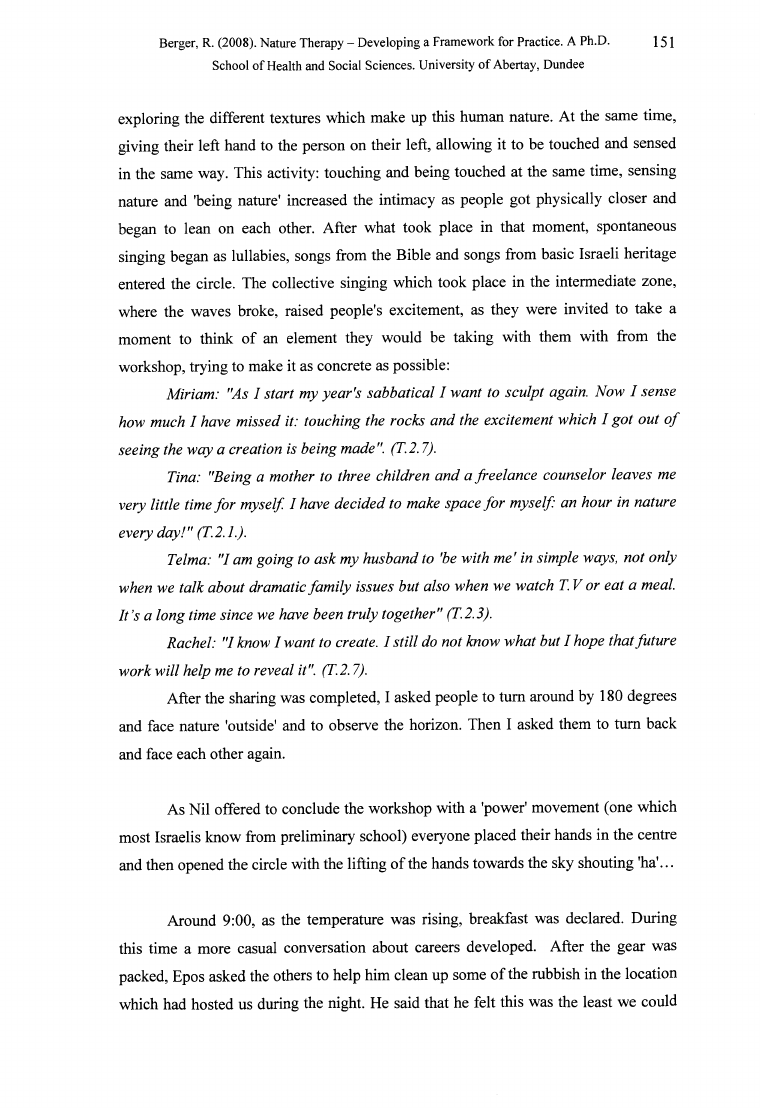
Berger, R. (2008). Nature Therapy - Developing a Framework for Practice. A Ph.D.
151
School of Health and Social Sciences. University of Abertay, Dundee
exploring the different textures which make up this human nature. At the same time,
giving their left hand to the person on their left, allowing it to be touched and sensed
in the same way. This activity: touching and being touched at the same time, sensing
nature and 'being nature' increased the intimacy as people got physically closer and
began to lean on each other. After what took place in that moment, spontaneous
singing began as lullabies, songs from the Bible and songs from basic Israeli heritage
entered the circle. The collective singing which took place in the intermediate zone,
where the waves broke, raised people's excitement, as they were invited to take a
moment to think o f an element they would be taking with them with from the
workshop, trying to make it as concrete as possible:
M iriam : "As 1 sta rt m y y e a r's sa b b a tic a l I w a n t to sc u lp t again. N o w I sen se
how m uch I h ave m isse d it: tou ch in g the rocks a n d the excitem en t w h ich 1 g o t o u t o f
s e e in g th e w a y a c r e a tio n is b e in g m ade" . ( T .2 .7).
Tina: "Being a m other to three children a n d a fre e la n c e cou n selor lea v e s m e
very little tim e f o r m yself. I have d e c id e d to m ake sp a ce f o r m yself: an hour in nature
e v e ry d a y!" (T .2 .1.).
Telm a: " Iam g o in g to a sk m y h u sb a n d to 'be w ith m e' in sim p le w ays, n o t o n ly
w h e n w e ta lk a b o u t d r a m a tic f a m i ly is s u e s b u t a ls o w h e n w e w a tc h T. V o r e a t a m ea l.
I t ’s a lo n g tim e s in c e w e h a v e b e e n tr u ly to g e th e r " (T .2 .3 ).
R a c h e l: "I k n o w I w a n t to c rea te . I s till d o n o t k n o w w h a t b u t I h o p e th a t fu tu r e
w o r k w i l l h e lp m e to r e v e a l it". ( T .2 .7).
After the sharing was completed, I asked people to turn around by 180 degrees
and face nature 'outside' and to observe the horizon. Then I asked them to turn back
and face each other again.
As N il offered to conclude the workshop with a 'power' movement (one which
most Israelis know from preliminary school) everyone placed their hands in the centre
and then opened the circle with the lifting o f the hands towards the sky shouting 'ha'...
Around 9:00, as the temperature was rising, breakfast was declared. During
this time a more casual conversation about careers developed. After the gear was
packed, Epos asked the others to help him clean up some o f the rubbish in the location
which had hosted us during the night. He said that he felt this was the least w e could
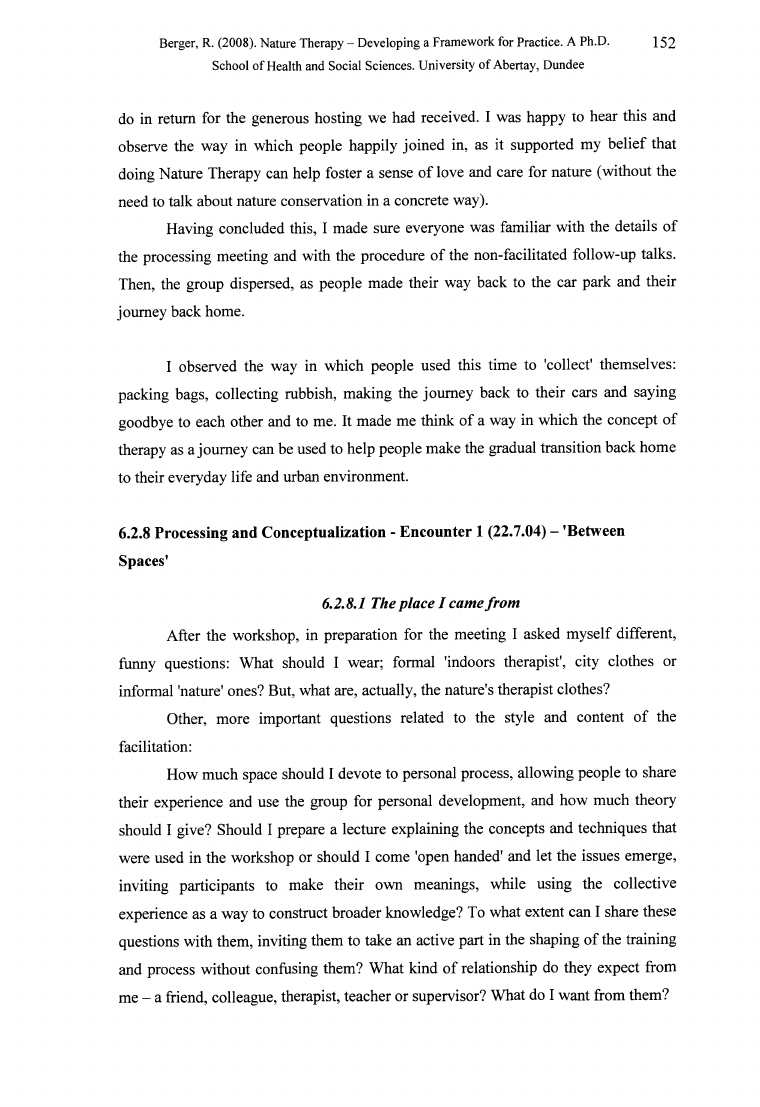
Berger, R. (2008). Nature Therapy - Developing a Framework for Practice. A Ph.D.
152
School of Health and Social Sciences. University of Abertay, Dundee
do in return for the generous hosting we had received. I was happy to hear this and
observe the way in which people happily joined in, as it supported my b elief that
doing Nature Therapy can help foster a sense o f love and care for nature (without the
need to talk about nature conservation in a concrete way).
Having concluded this, I made sure everyone was familiar with the details o f
the processing meeting and with the procedure o f the non-facilitated follow-up talks.
Then, the group dispersed, as people made their way back to the car park and their
journey back home.
I observed the way in which people used this time to 'collect' themselves:
packing bags, collecting rubbish, making the journey back to their cars and saying
goodbye to each other and to me. It made me think o f a way in which the concept o f
therapy as a journey can be used to help people make the gradual transition back home
to their everyday life and urban environment.
6.2.8 Processing and Conceptualization - Encounter 1 (22.7.04) —’Between
Spaces’
6 .2 .8 .1 T h e p la c e I c a m e f r o m
After the workshop, in preparation for the meeting I asked m yself different,
funny questions: What should I wear; formal 'indoors therapist', city clothes or
informal 'nature' ones? But, what are, actually, the nature's therapist clothes?
Other, more important questions related to the style and content o f the
facilitation:
How much space should I devote to personal process, allowing people to share
their experience and use the group for personal development, and how much theory
should I give? Should I prepare a lecture explaining the concepts and techniques that
were used in the workshop or should I come 'open handed' and let the issues emerge,
inviting participants to make their own meanings, while using the collective
experience as a way to construct broader knowledge? To what extent can I share these
questions with them, inviting them to take an active part in the shaping o f the training
and process without confusing them? What kind o f relationship do they expect from
me - a friend, colleague, therapist, teacher or supervisor? What do I want from them?
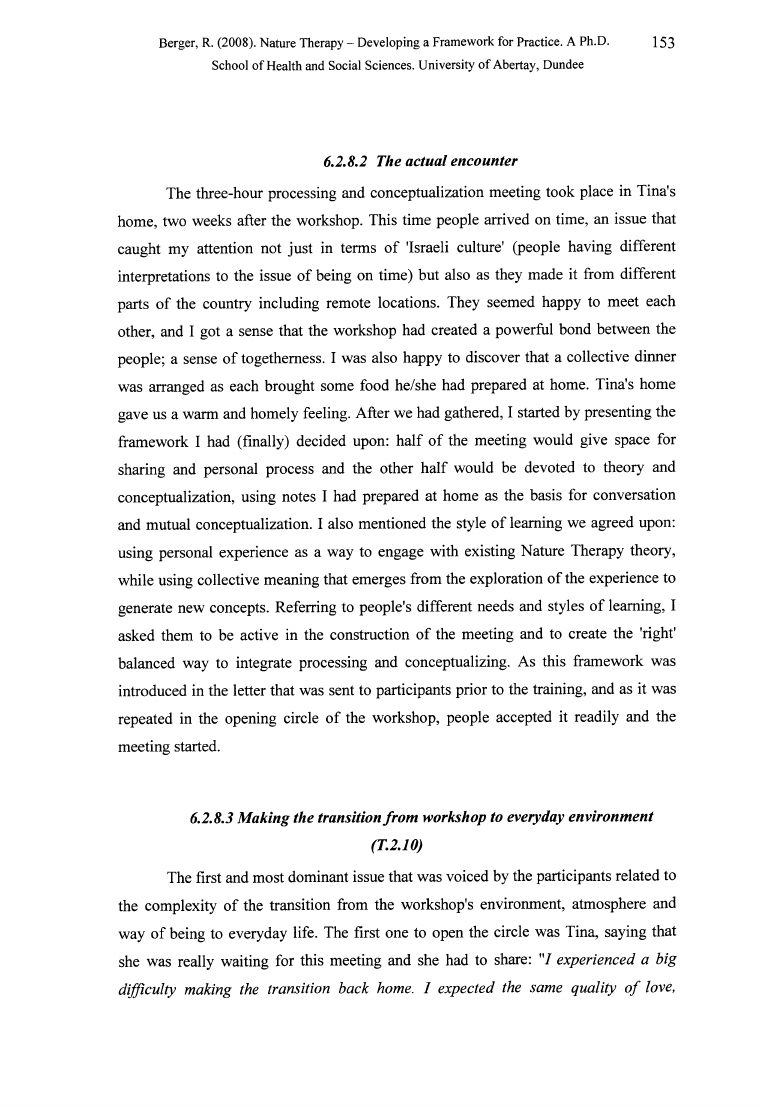
Berger, R. (2008). Nature Therapy - Developing a Framework for Practice. A Ph.D.
153
School of Health and Social Sciences. University of Abertay, Dundee
6 .2 .8 .2 T h e a c tu a l e n c o u n te r
The three-hour processing and conceptualization meeting took place in Tina's
home, two weeks after the workshop. This time people arrived on time, an issue that
caught my attention not just in terms o f 'Israeli culture' (people having different
interpretations to the issue o f being on time) but also as they made it from different
parts o f the country including remote locations. They seemed happy to meet each
other, and I got a sense that the workshop had created a powerful bond between the
people; a sense o f togetherness. I was also happy to discover that a collective dinner
was arranged as each brought some food he/she had prepared at home. Tina's home
gave us a warm and homely feeling. After we had gathered, I started by presenting the
framework I had (finally) decided upon: half o f the meeting would give space for
sharing and personal process and the other half would be devoted to theory and
conceptualization, using notes I had prepared at home as the basis for conversation
and mutual conceptualization. I also mentioned the style o f learning we agreed upon:
using personal experience as a way to engage with existing Nature Therapy theory,
while using collective meaning that emerges from the exploration o f the experience to
generate new concepts. Referring to people's different needs and styles o f learning, I
asked them to be active in the construction o f the meeting and to create the 'right'
balanced way to integrate processing and conceptualizing. As this framework was
introduced in the letter that was sent to participants prior to the training, and as it was
repeated in the opening circle o f the workshop, people accepted it readily and the
meeting started.
6 .2 .8 3 M a k in g th e tra n sitio n f r o m w o rk sh o p to e v e ry d a y e n v iro n m e n t
(T .2 .1 0 )
The first and most dominant issue that was voiced by the participants related to
the complexity o f the transition from the workshop's environment, atmosphere and
way o f being to everyday life. The first one to open the circle was Tina, saying that
she was really waiting for this meeting and she had to share: "/ e x p e r ie n c e d a b ig
difficu lty m aking the tran sition back hom e. I ex p ected the sam e q u a lity o f love,
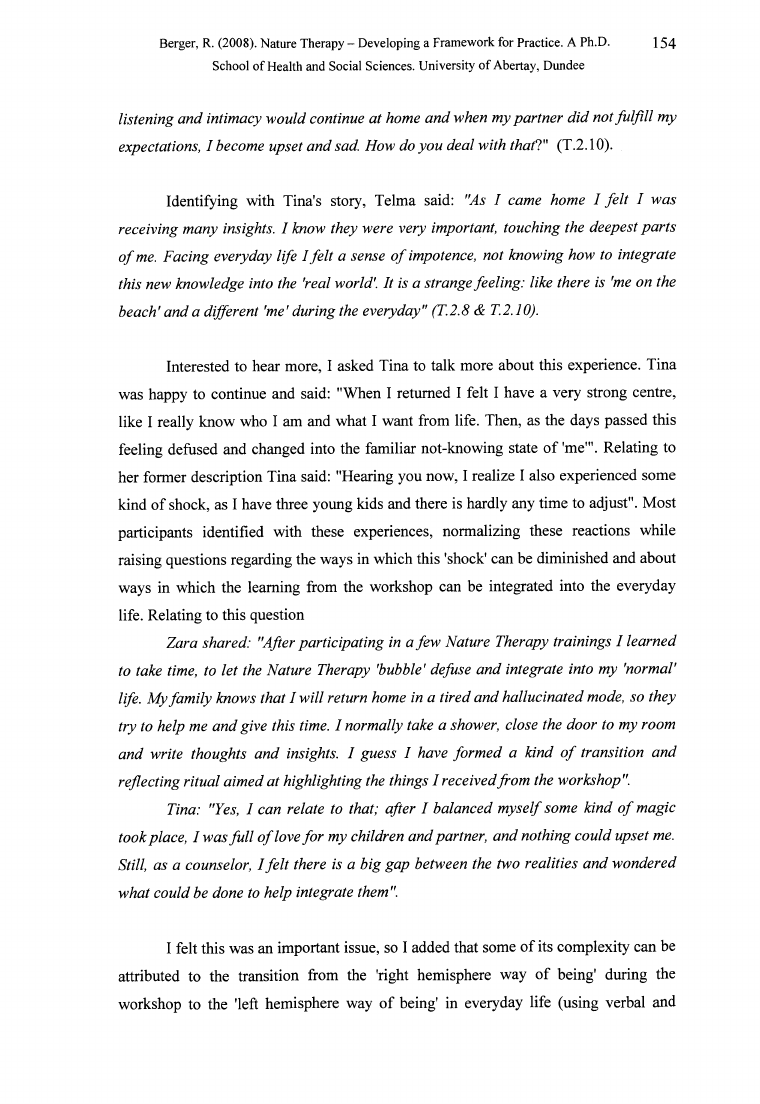
Berger, R. (2008). Nature Therapy - Developing a Framework for Practice. A Ph.D.
154
School of Health and Social Sciences. University of Abertay, Dundee
listen ing a n d intim acy w o u ld continue a t hom e a n d w hen m y p a rtn er d id n ot fu lfill m y
ex p ecta tio n s, I b e c o m e u p se t a n d sad. H o w d o y o u d e a l w ith th at!" (T.2.10).
Identifying with Tina's story, Telma said: "As I c a m e h o m e I f e l t I w a s
receivin g m any insights. I know th ey w ere very im portant, touchin g the d eep est p a r ts
o f me. F acin g everyd a y life I fe lt a sense o f im potence, n ot know ing how to in tegrate
th is n e w k n o w le d g e in to th e 'r e a l w o rld '. I t is a s tr a n g e f e e lin g : lik e th e r e is 'me o n th e
b ea ch ' a n d a d ifferen t 'me' d u rin g the everyd a y" (T .2.8 & T .2.10).
Interested to hear more, I asked Tina to talk more about this experience. Tina
was happy to continue and said: "When I returned I felt I have a very strong centre,
like I really know who I am and what I want from life. Then, as the days passed this
feeling defused and changed into the familiar not-knowing state o f 'me"'. Relating to
her former description Tina said: "Hearing you now, I realize I also experienced some
kind o f shock, as I have three young kids and there is hardly any time to adjust". Most
participants identified with these experiences, normalizing these reactions while
raising questions regarding the ways in which this 'shock' can be diminished and about
ways in which the learning from the workshop can be integrated into the everyday
life. Relating to this question
Z a ra sh a red : "After p a r tic ip a tin g in a f e w N atu re T h erapy tra in in g s I lea rn e d
to take tim e, to le t the N atu re T herapy 'bubble' defuse a n d in tegrate into m y 'norm al'
life. M y fa m ily know s th a t I w ill return hom e in a tir e d a n d h a llu cin a ted m ode, so th ey
try to help m e a n d give this tim e. I n orm ally take a show er, clo se the d o o r to m y room
a n d w rite thoughts a n d insights. I gu ess I have fo rm e d a kin d o f tran sition a n d
reflectin g ritu a l a im ed a t highlighting the things I re ce ive d fro m the workshop".
Tina: "Yes, I can re la te to th at; a fte r I b a la n c e d m y s e lf so m e k in d o f m a g ic
took place, I w as fu ll o f love fo r m y children an d partn er, a n d nothing co u ld upset me.
Still, as a counselor, I f e lt there is a b ig g a p b etw een the tw o rea lities a n d w o n d ered
w h a t c o u ld b e d o n e to h e lp in te g r a te th e m ”.
I felt this was an important issue, so I added that some o f its complexity can be
attributed to the transition from the 'right hemisphere way o f being' during the
workshop to the 'left hemisphere way o f being' in everyday life (using verbal and
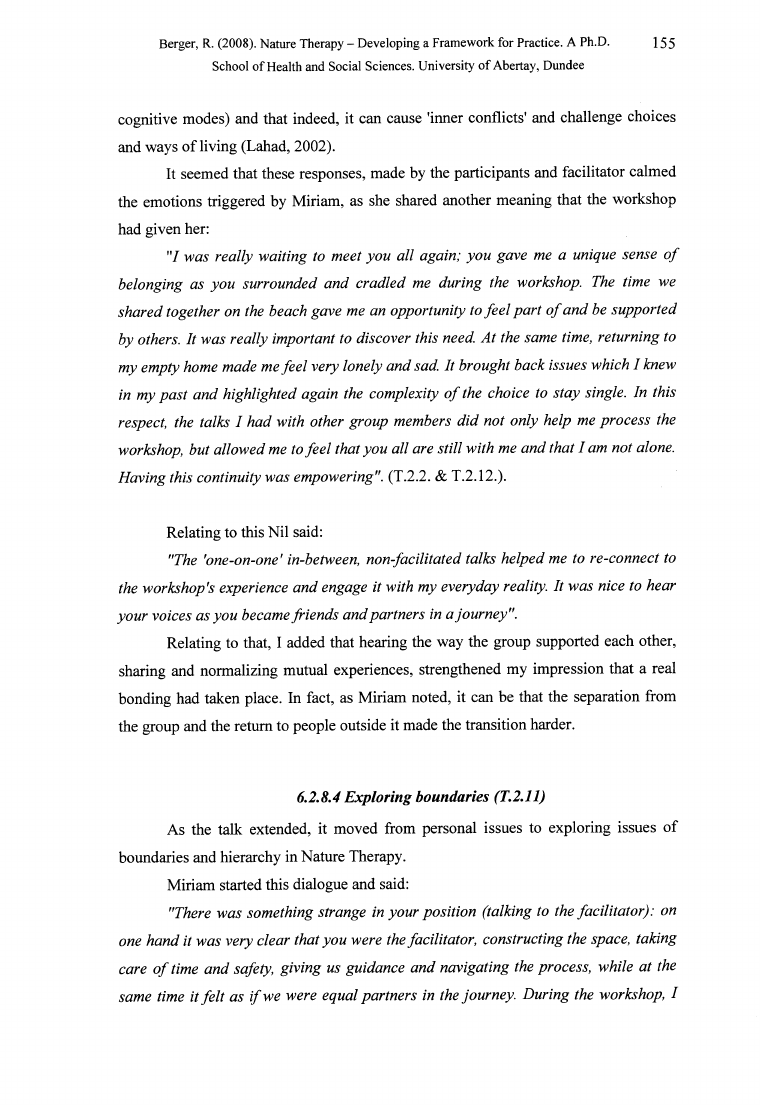
Berger, R. (2008). Nature Therapy - Developing a Framework for Practice. A Ph.D.
155
School of Health and Social Sciences. University of Abertay, Dundee
cognitive modes) and that indeed, it can cause 'inner conflicts' and challenge choices
and ways o f living (Lahad, 2002).
It seemed that these responses, made by the participants and facilitator calmed
the emotions triggered by Miriam, as she shared another meaning that the workshop
had given her:
"/ w a s r e a lly w a itin g to m e e t y o u a ll a g a in ; y o u g a v e m e a u n iq u e s e n s e o f
belon gin g as yo u su rrou n ded a n d cra d led me during the w orkshop. The tim e w e
sh a red togeth er on the beach g a ve m e an opportu n ity to fe e l p a r t o f a n d be su p p o rted
b y others. It w a s rea lly im portan t to d isco ver this need. A t the sam e tim e, retu rn in g to
m y em pty hom e m ade m e fe e l very lonely an d sad. It brought back issues w hich I knew
in m y p a s t a n d h igh ligh ted again the co m p lex ity o f the ch oice to s ta y sin gle. In th is
respect, the talks I h a d w ith oth er g ro u p m em bers d id n ot on ly help m e p ro c e ss the
w orkshop, but a llo w ed m e to fe e l th at yo u a ll are still w ith m e a n d th at I am not alone.
H a v in g th is co n tin u ity w a s em p o w erin g " . (T.2.2. & T.2.12.).
Relating to this N il said:
"The 'one-on-one' in-betw een, n o n -fa cilita ted talks h e lp ed m e to re-co n n ect to
the w orkshop's experience a n d engage it w ith m y everyd a y reality. It w a s nice to h ear
y o u r vo ic e s a s y o u becam e frie n d s a n d p a rtn e rs in a jo u rn ey" .
Relating to that, I added that hearing the way the group supported each other,
sharing and normalizing mutual experiences, strengthened my impression that a real
bonding had taken place. In fact, as Miriam noted, it can be that the separation from
the group and the return to people outside it made the transition harder.
6 .2 .8 .4 E x p lo r in g b o u n d a rie s (T .2 .1 1 )
As the talk extended, it moved from personal issues to exploring issues o f
boundaries and hierarchy in Nature Therapy.
Miriam started this dialogue and said:
"There w a s so m eth in g stra n g e in y o u r p o sitio n (talkin g to the fa c ilita to r): on
one h an d it w a s very clea r th at y o u w ere the fa cilita to r, con stru ctin g the space, takin g
care o f tim e a n d safety, g ivin g us gu idan ce a n d n a vig a tin g the p ro cess, w h ile a t the
sa m e tim e it f e lt a s i f w e w ere eq u a l p a rtn e rs in the jo u rn ey. D u rin g the w orksh op, I
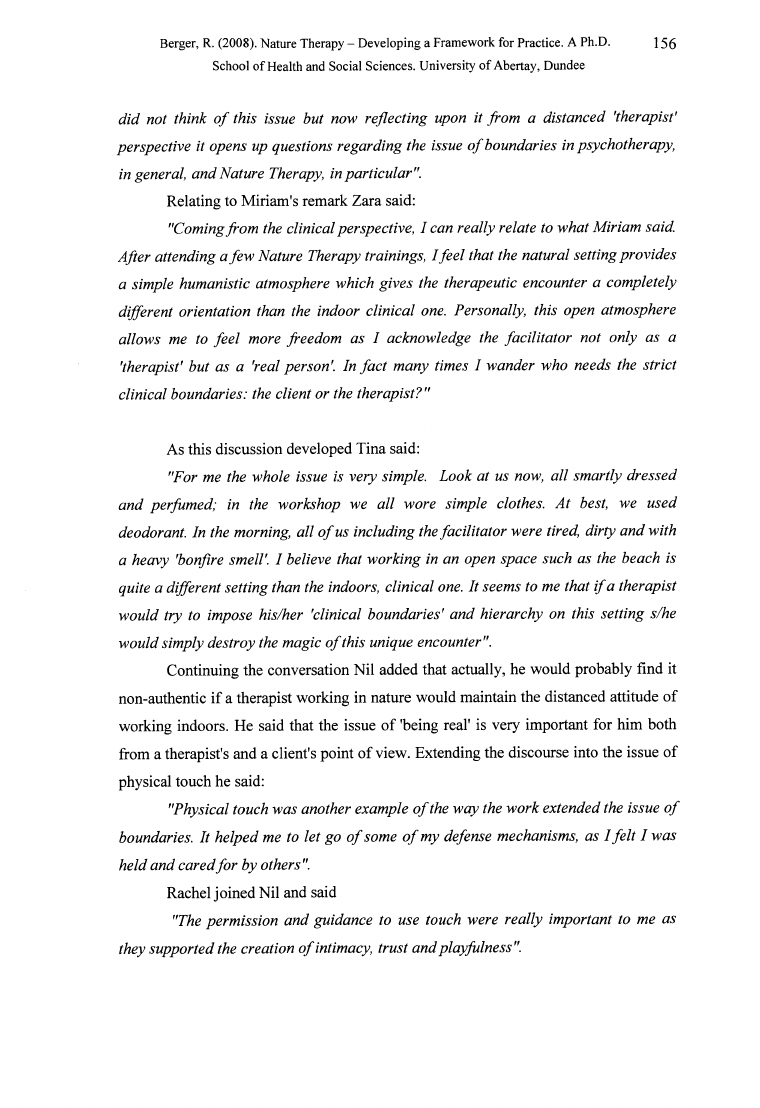
Berger, R. (2008). Nature Therapy - Developing a Framework for Practice. A Ph.D.
156
School of Health and Social Sciences. University of Abertay, Dundee
d id not think o f this issue but now reflectin g upon it fro m a d ista n ced 'therapist'
p e rsp e c tiv e it open s up qu estion s reg a rd in g the issue o f bou n daries in p sych o th era p y,
in gen eral, a n d N a tu re Therapy, in p a rticu la r" .
Relating to Miriam's remark Zara said:
"Com ing fro m the clin ical p ersp ective, I can rea lly rela te to w h a t M iriam said.
A fter atten din g a fe w N ature T herapy trainings, I fe e l th at the n atural settin g p ro v id e s
a sim ple hum anistic atm osphere w hich g ives the therapeutic encounter a com pletely
different orien tation than the in door clin ica l one. P erson ally, this open atm osph ere
a llo w s m e to fe e l m ore freed o m as I ackn ow ledge the fa c ilita to r n ot on ly a s a
'therapist' but as a 'real person '. In f a c t m an y tim es I w a n d er w ho n eeds the stric t
clin ical boundaries: the clien t o r the th erapist?"
As this discussion developed Tina said:
"For m e the w hole issue is very sim ple. L ook a t us now, a ll sm artly d re sse d
a n d perfu m ed; in the w o rk sh o p w e a ll w o re sim ple clothes. A t best, w e u sed
deodorant. In the m orning, a ll o f us in clu din g the fa c ilita to r w ere tired, dirty a n d w ith
a h eavy 'bonfire sm ell'. I b elieve th at w o rk in g in an open sp a ce such as the beach is
quite a different settin g than the indoors, clin ical one. It seem s to m e th at i f a th erapist
w o u ld try to im pose his/her 'clinical bou n daries' a n d h ierarch y on this settin g s/he
w o u ld sim ply d estro y the m agic o f this unique encounter".
Continuing the conversation N il added that actually, he would probably find it
non-authentic if a therapist working in nature would maintain the distanced attitude o f
working indoors. He said that the issue o f 'being real' is very important for him both
from a therapist's and a client's point o f view. Extending the discourse into the issue o f
physical touch he said:
"Physical touch w as another exam ple o f the w a y the w o rk exten ded the issue o f
boundaries. It h elp ed m e to let go o f som e o f m y defense m echanism s, as I fe lt I w a s
h eld a n d c a re d f o r b y others".
Rachel joined N il and said
"The p erm issio n a n d gu idan ce to use touch w ere re a lly im portan t to m e as
they su p p o rted the creation o f intim acy, tru st a n d playfulness".
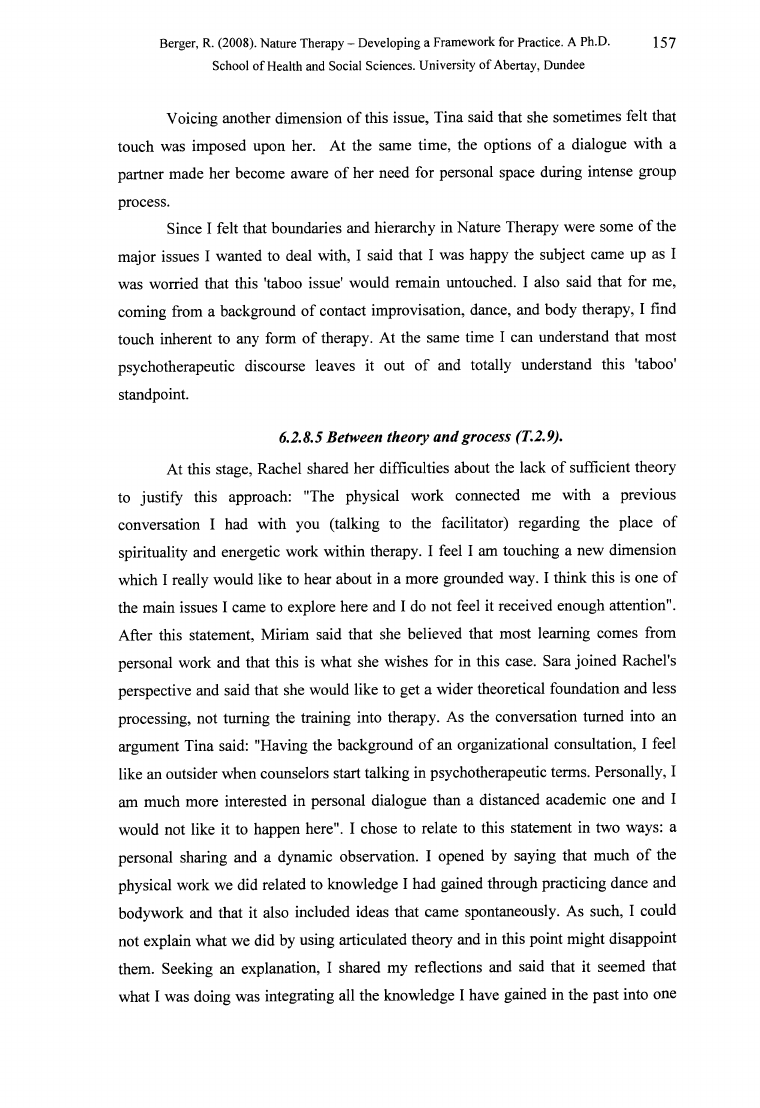
Berger, R. (2008). Nature Therapy - Developing a Framework for Practice. A Ph.D.
157
School of Health and Social Sciences. University of Abertay, Dundee
Voicing another dimension o f this issue, Tina said that she sometimes felt that
touch was imposed upon her. At the same time, the options o f a dialogue with a
partner made her become aware o f her need for personal space during intense group
process.
Since I felt that boundaries and hierarchy in Nature Therapy were some o f the
major issues I wanted to deal with, I said that I was happy the subject came up as I
was worried that this 'taboo issue' would remain untouched. I also said that for me,
coming from a background o f contact improvisation, dance, and body therapy, I find
touch inherent to any form o f therapy. At the same time I can understand that most
psychotherapeutic discourse leaves it out o f and totally understand this 'taboo'
standpoint.
6 .2 .8 .5 B e tw e e n th e o r y a n d g r o c e s s (T .2 .9 ).
At this stage, Rachel shared her difficulties about the lack o f sufficient theory
to justify this approach: "The physical work connected me with a previous
conversation I had with you (talking to the facilitator) regarding the place o f
spirituality and energetic work within therapy. I feel I am touching a new dimension
which I really would like to hear about in a more grounded way. I think this is one o f
the main issues I came to explore here and I do not feel it received enough attention".
After this statement, Miriam said that she believed that most learning comes from
personal work and that this is what she wishes for in this case. Sara joined Rachel's
perspective and said that she would like to get a wider theoretical foundation and less
processing, not turning the training into therapy. As the conversation turned into an
argument Tina said: "Having the background o f an organizational consultation, I feel
like an outsider when counselors start talking in psychotherapeutic terms. Personally, I
am much more interested in personal dialogue than a distanced academic one and I
would not like it to happen here". I chose to relate to this statement in two ways: a
personal sharing and a dynamic observation. I opened by saying that much o f the
physical work we did related to knowledge I had gained through practicing dance and
bodywork and that it also included ideas that came spontaneously. As such, I could
not explain what we did by using articulated theory and in this point might disappoint
them. Seeking an explanation, I shared my reflections and said that it seemed that
what I was doing was integrating all the knowledge I have gained in the past into one
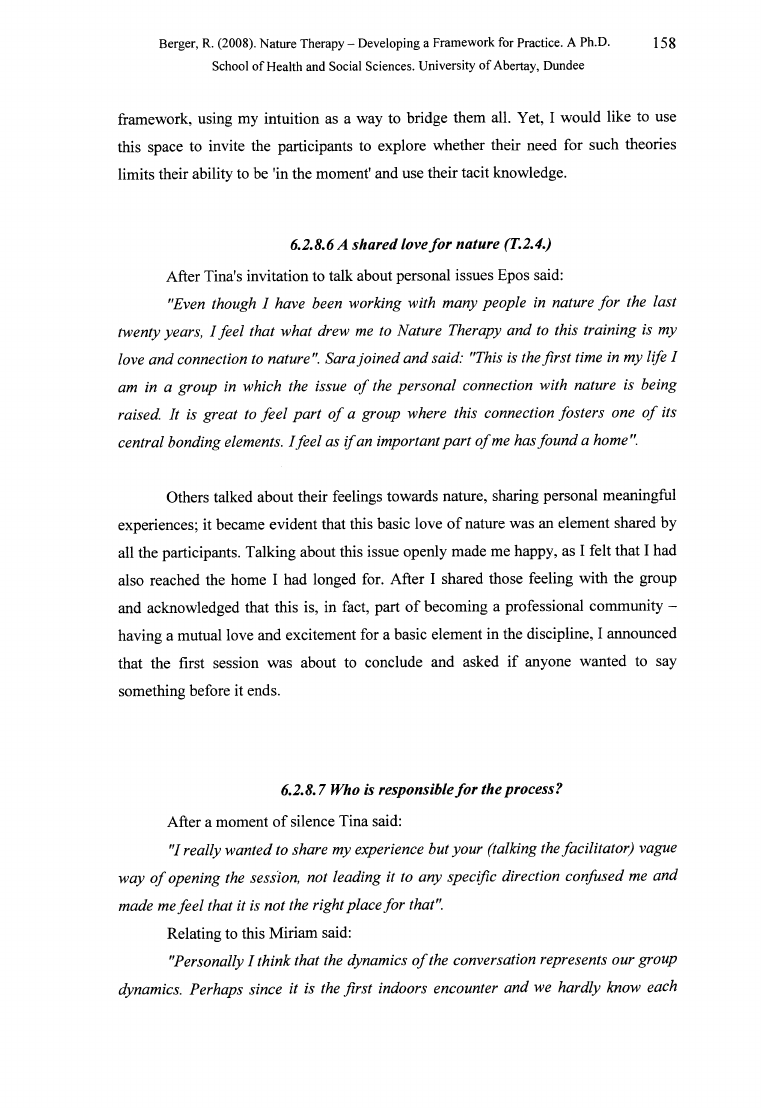
Berger, R. (2008). Nature Therapy - Developing a Framework for Practice. A Ph.D.
158
School of Health and Social Sciences. University of Abertay, Dundee
framework, using my intuition as a way to bridge them all. Yet, I would like to use
this space to invite the participants to explore whether their need for such theories
limits their ability to be 'in the moment' and use their tacit knowledge.
6 .2 .8 .6 A s h a r e d lo v e f o r n a tu re (T .2 .4 .)
After Tina's invitation to talk about personal issues Epos said:
"Even though I h ave been w o rk in g w ith m an y p e o p le in n atu re f o r the la st
tw enty years, I fe e l that w h at drew me to N ature Therapy an d to this train in g is m y
lo v e a n d c o n n e c tio n to n a tu r e ". S a r a j o i n e d a n d s a id : "This is th e f i r s t tim e in m y life I
am in a g ro u p in w h ich the issue o f the p e r s o n a l con n ection w ith n atu re is b ein g
raised. It is g rea t to f e e l p a r t o f a grou p w h ere this connection fo ste rs one o f its
cen tral bon din g elem ents. I fe e l as if an im portan t p a r t o f m e has fo u n d a home".
Others talked about their feelings towards nature, sharing personal meaningful
experiences; it became evident that this basic love o f nature was an element shared by
all the participants. Talking about this issue openly made me happy, as I felt that I had
also reached the home I had longed for. After I shared those feeling with the group
and acknowledged that this is, in fact, part o f becoming a professional community -
having a mutual love and excitement for a basic element in the discipline, I announced
that the first session was about to conclude and asked if anyone wanted to say
something before it ends.
6 .2 .8 .7 W h o is re sp o n sib le f o r th e p r o c e s s ?
After a moment o f silence Tina said:
"I r e a lly w a n te d to s h a r e m y e x p e rie n c e b u t y o u r (ta lk in g th e f a c ilita to r ) v a g u e
w a y o f open in g the session, n ot leadin g it to an y specific direction con fu sed m e a n d
m a d e m e f e e l th a t it is n o t the rig h t p la c e f o r that".
Relating to this Miriam said:
"Personally I think th at the dynam ics o f the con versation rep resen ts ou r grou p
dynam ics. P erh aps sin ce it is the fir s t in doors encounter a n d w e h a rd ly know each
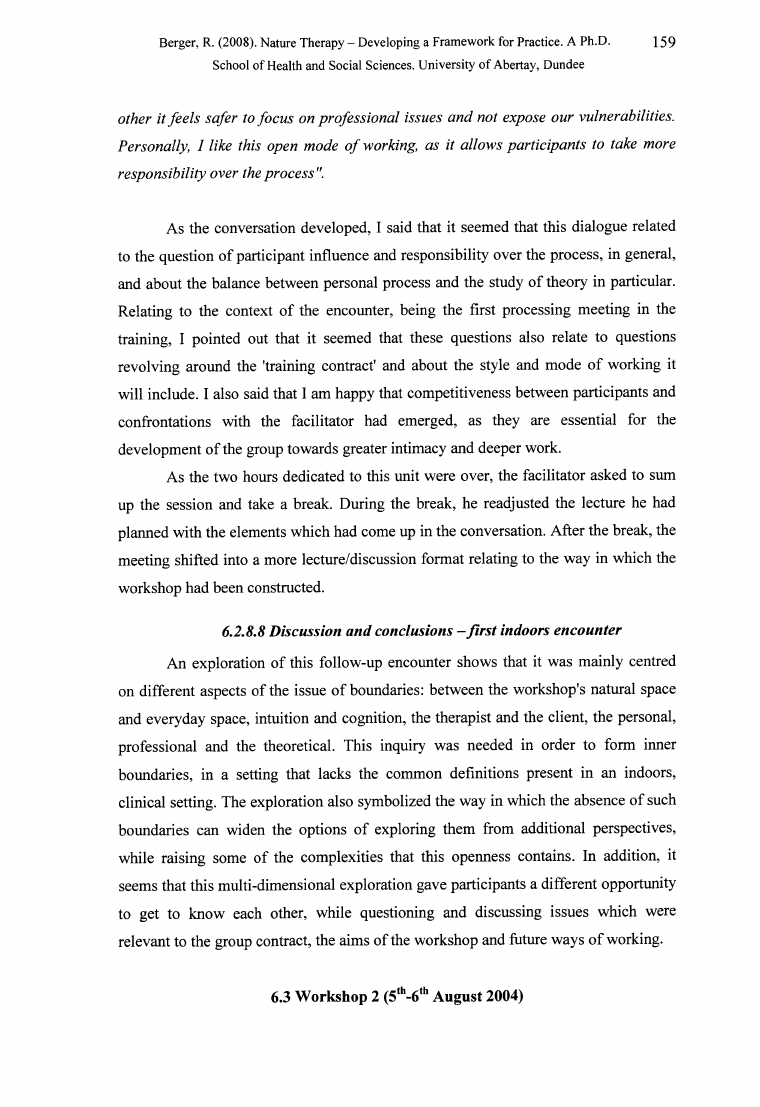
Berger, R. (2008). Nature Therapy - Developing a Framework for Practice. A Ph.D.
159
School of Health and Social Sciences. University of Abertay, Dundee
other it fe e ls safer to fo cu s on p ro fessio n a l issues a n d not expose our vulnerabilities.
P ersonally, I like this open m ode o f working, a s it a llo w s p a rticip a n ts to take m ore
resp o n sib ility o ver the process".
As the conversation developed, I said that it seemed that this dialogue related
to the question o f participant influence and responsibility over the process, in general,
and about the balance between personal process and the study o f theory in particular.
Relating to the context o f the encounter, being the first processing meeting in the
training, I pointed out that it seemed that these questions also relate to questions
revolving around the 'training contract' and about the style and mode o f working it
w ill include. I also said that I am happy that competitiveness between participants and
confrontations with the facilitator had emerged, as they are essential for the
development o f the group towards greater intimacy and deeper work.
A s the two hours dedicated to this unit were over, the facilitator asked to sum
up the session and take a break. During the break, he readjusted the lecture he had
planned with the elements which had come up in the conversation. After the break, the
meeting shifted into a more lecture/discussion format relating to the way in which the
workshop had been constructed.
6 .2 .8 .8 D isc u s sio n a n d c o n c lu sio n s - f ir s t in d o o rs e n c o u n te r
An exploration o f this follow-up encounter shows that it was mainly centred
on different aspects o f the issue o f boundaries: between the workshop's natural space
and everyday space, intuition and cognition, the therapist and the client, the personal,
professional and the theoretical. This inquiry was needed in order to form inner
boundaries, in a setting that lacks the common definitions present in an indoors,
clinical setting. The exploration also symbolized the way in which the absence o f such
boundaries can widen the options o f exploring them from additional perspectives,
while raising some o f the complexities that this openness contains. In addition, it
seems that this multi-dimensional exploration gave participants a different opportunity
to get to know each other, while questioning and discussing issues which were
relevant to the group contract, the aims o f the workshop and future ways o f working.
6.3 Workshop 2 (5th-6thAugust 2004)
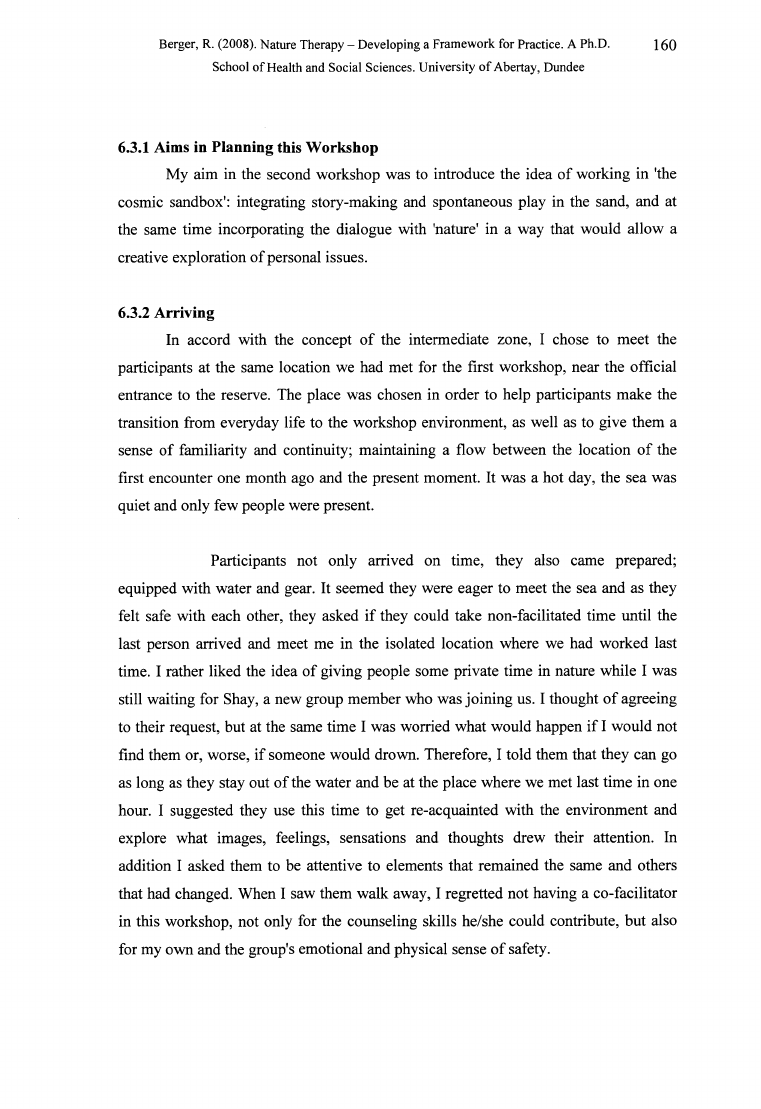
Berger, R. (2008). Nature Therapy - Developing a Framework for Practice. A Ph.D.
160
School of Health and Social Sciences. University of Abertay, Dundee
6.3.1 Aims in Planning this Workshop
My aim in the second workshop was to introduce the idea o f working in 'the
cosmic sandbox': integrating story-making and spontaneous play in the sand, and at
the same time incorporating the dialogue with 'nature' in a way that would allow a
creative exploration o f personal issues.
6.3.2 Arriving
In accord with the concept o f the intermediate zone, I chose to meet the
participants at the same location we had met for the first workshop, near the official
entrance to the reserve. The place was chosen in order to help participants make the
transition from everyday life to the workshop environment, as well as to give them a
sense o f familiarity and continuity; maintaining a flow between the location o f the
first encounter one month ago and the present moment. It was a hot day, the sea was
quiet and only few people were present.
Participants not only arrived on time, they also came prepared;
equipped with water and gear. It seemed they were eager to meet the sea and as they
felt safe with each other, they asked if they could take non-facilitated time until the
last person arrived and meet me in the isolated location where we had worked last
time. I rather liked the idea o f giving people some private time in nature while I was
still waiting for Shay, a new group member who was joining us. I thought o f agreeing
to their request, but at the same time I was worried what would happen if I would not
find them or, worse, if someone would drown. Therefore, I told them that they can go
as long as they stay out o f the water and be at the place where we met last time in one
hour. I suggested they use this time to get re-acquainted with the environment and
explore what images, feelings, sensations and thoughts drew their attention. In
addition I asked them to be attentive to elements that remained the same and others
that had changed. When I saw them walk away, I regretted not having a co-facilitator
in this workshop, not only for the counseling skills he/she could contribute, but also
for my own and the group's emotional and physical sense o f safety.
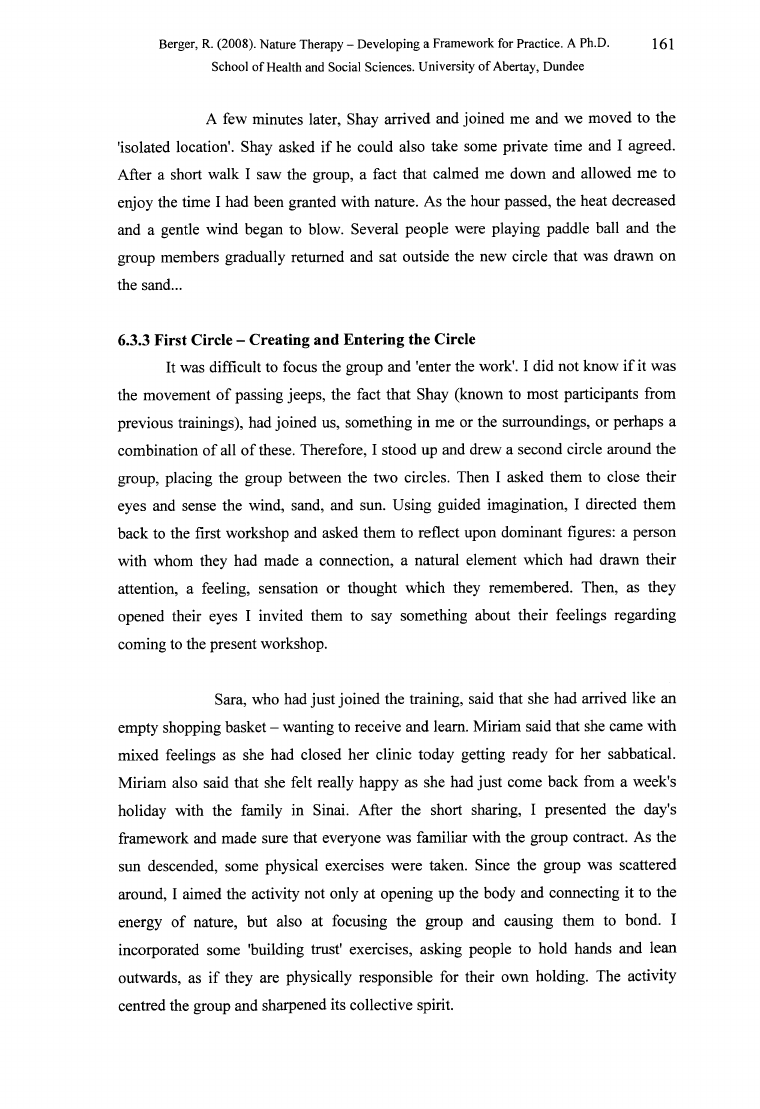
Berger, R. (2008). Nature Therapy - Developing a Framework for Practice. A Ph.D.
161
School of Health and Social Sciences. University of Abertay, Dundee
A few minutes later, Shay arrived and joined me and we moved to the
'isolated location'. Shay asked if he could also take some private time and I agreed.
After a short walk I saw the group, a fact that calmed me down and allowed me to
enjoy the time I had been granted with nature. A s the hour passed, the heat decreased
and a gentle wind began to blow. Several people were playing paddle ball and the
group members gradually returned and sat outside the new circle that was drawn on
the sand...
6.3.3 First Circle - Creating and Entering the Circle
It was difficult to focus the group and 'enter the work'. I did not know if it was
the movement o f passing jeeps, the fact that Shay (known to most participants from
previous trainings), had joined us, something in me or the surroundings, or perhaps a
combination o f all o f these. Therefore, I stood up and drew a second circle around the
group, placing the group between the two circles. Then I asked them to close their
eyes and sense the wind, sand, and sun. Using guided imagination, I directed them
back to the first workshop and asked them to reflect upon dominant figures: a person
with whom they had made a connection, a natural element which had drawn their
attention, a feeling, sensation or thought which they remembered. Then, as they
opened their eyes I invited them to say something about their feelings regarding
coming to the present workshop.
Sara, who had just joined the training, said that she had arrived like an
empty shopping basket - wanting to receive and learn. Miriam said that she came with
mixed feelings as she had closed her clinic today getting ready for her sabbatical.
Miriam also said that she felt really happy as she had just come back from a week's
holiday with the family in Sinai. After the short sharing, I presented the day's
framework and made sure that everyone was familiar with the group contract. As the
sun descended, some physical exercises were taken. Since the group was scattered
around, I aimed the activity not only at opening up the body and connecting it to the
energy o f nature, but also at focusing the group and causing them to bond. I
incorporated some 'building trust' exercises, asking people to hold hands and lean
outwards, as if they are physically responsible for their own holding. The activity
centred the group and sharpened its collective spirit.
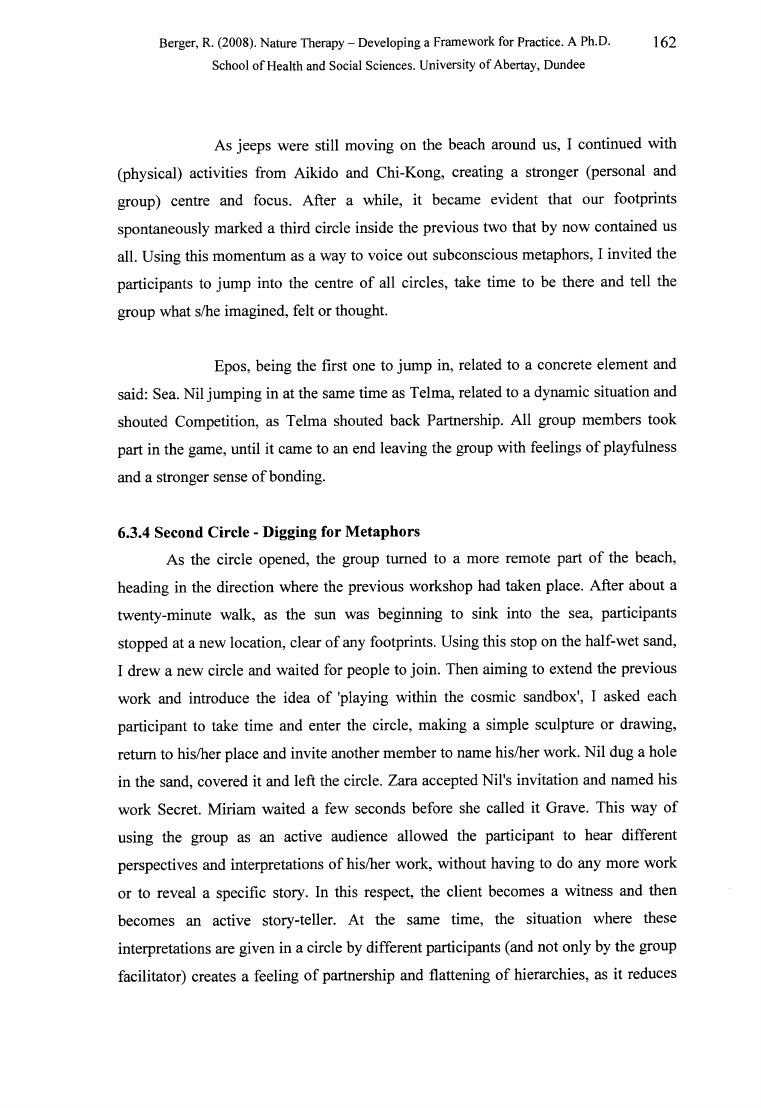
Berger, R. (2008). Nature Therapy - Developing a Framework for Practice. A Ph.D.
162
School of Health and Social Sciences. University of Abertay, Dundee
As jeeps were still moving on the beach around us, I continued with
(physical) activities from Aikido and Chi-Kong, creating a stronger (personal and
group) centre and focus. After a while, it became evident that our footprints
spontaneously marked a third circle inside the previous two that by now contained us
all. Using this momentum as a way to voice out subconscious metaphors, I invited the
participants to jump into the centre o f all circles, take time to be there and tell the
group what s/he imagined, felt or thought.
Epos, being the first one to jump in, related to a concrete element and
said: Sea. Nil jumping in at the same time as Telma, related to a dynamic situation and
shouted Competition, as Telma shouted back Partnership. A ll group members took
part in the game, until it came to an end leaving the group with feelings o f playfulness
and a stronger sense o f bonding.
6.3.4 Second Circle - Digging for Metaphors
A s the circle opened, the group turned to a more remote part o f the beach,
heading in the direction where the previous workshop had taken place. After about a
twenty-minute walk, as the sun was beginning to sink into the sea, participants
stopped at a new location, clear o f any footprints. Using this stop on the half-wet sand,
I drew a new circle and waited for people to join. Then aiming to extend the previous
work and introduce the idea o f 'playing within the cosmic sandbox', I asked each
participant to take time and enter the circle, making a simple sculpture or drawing,
return to his/her place and invite another member to name his/her work. N il dug a hole
in the sand, covered it and left the circle. Zara accepted Nil's invitation and named his
work Secret. Miriam waited a few seconds before she called it Grave. This way o f
using the group as an active audience allowed the participant to hear different
perspectives and interpretations o f his/her work, without having to do any more work
or to reveal a specific story. In this respect, the client becomes a witness and then
becomes an active story-teller. At the same time, the situation where these
interpretations are given in a circle by different participants (and not only by the group
facilitator) creates a feeling o f partnership and flattening o f hierarchies, as it reduces
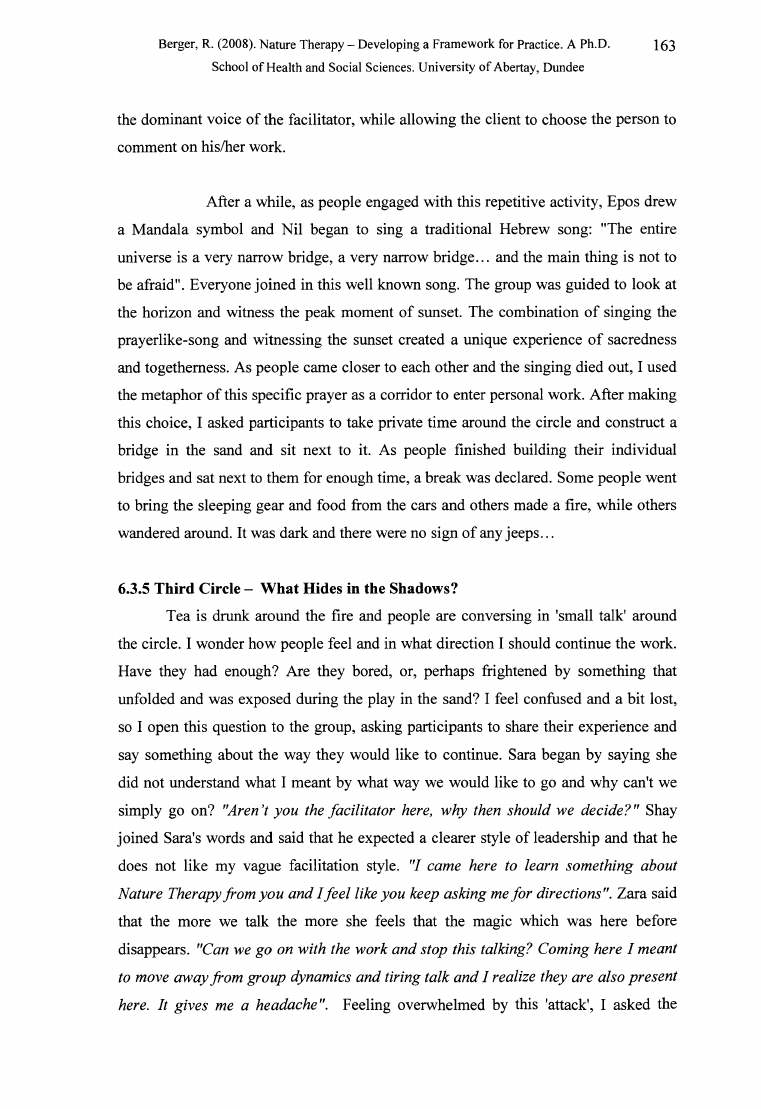
Berger, R. (2008). Nature Therapy - Developing a Framework for Practice. A Ph.D.
163
School of Health and Social Sciences. University of Abertay, Dundee
the dominant voice o f the facilitator, while allowing the client to choose the person to
comment on his/her work.
After a while, as people engaged with this repetitive activity, Epos drew
a Mandala symbol and N il began to sing a traditional Hebrew song: "The entire
universe is a very narrow bridge, a very narrow bridge... and the main thing is not to
be afraid". Everyone joined in this well known song. The group was guided to look at
the horizon and witness the peak moment o f sunset. The combination o f singing the
prayerlike-song and witnessing the sunset created a unique experience o f sacredness
and togetherness. As people came closer to each other and the singing died out, I used
the metaphor o f this specific prayer as a corridor to enter personal work. After making
this choice, I asked participants to take private time around the circle and construct a
bridge in the sand and sit next to it. As people finished building their individual
bridges and sat next to them for enough time, a break was declared. Some people went
to bring the sleeping gear and food from the cars and others made a fire, while others
wandered around. It was dark and there were no sign o f any jeep s...
6.3.5 Third Circle - What Hides in the Shadows?
Tea is drunk around the fire and people are conversing in 'small talk' around
the circle. I wonder how people feel and in what direction I should continue the work.
Have they had enough? Are they bored, or, perhaps frightened by something that
unfolded and was exposed during the play in the sand? I feel confused and a bit lost,
so I open this question to the group, asking participants to share their experience and
say something about the way they would like to continue. Sara began by saying she
did not understand what I meant by what way we would like to go and why can't we
simply go on? " A re n ’t y o u th e f a c i l it a to r h ere, w h y th en s h o u ld w e d e c id e ? " Shay
joined Sara's words and said that he expected a clearer style o f leadership and that he
does not like my vague facilitation style. "I c a m e h ere to le a rn so m e th in g a b o u t
N a tu r e T h e r a p y f r o m y o u a n d I f e e l lik e y o u k e e p a s k in g m e f o r d ir e c tio n s " . Zara said
that the more we talk the more she feels that the magic which was here before
disappears. "Can w e g o o n w ith th e w o r k a n d s to p th is ta lk in g ? C o m in g h e r e I m e a n t
to m ove a w a y fro m group dynam ics and tiring talk an d I realize they are also p resen t
h ere. I t g iv e s m e a h e a d a c h e " . Feeling overwhelmed by this 'attack', I asked the
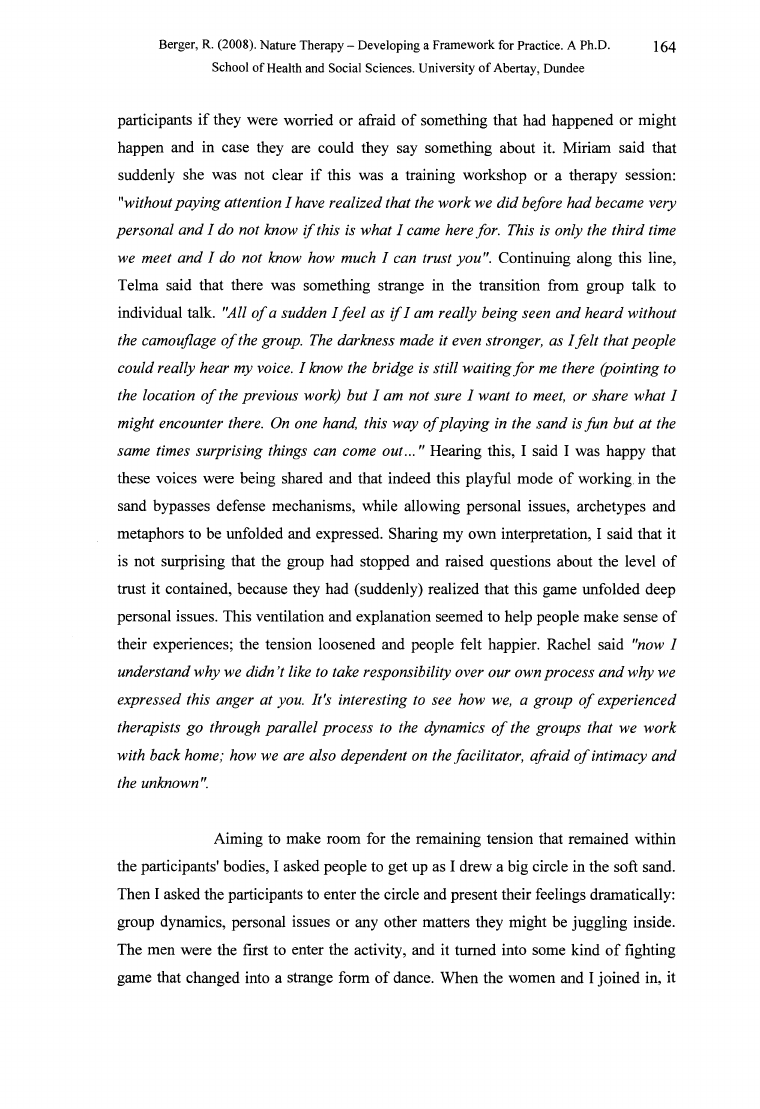
Berger, R. (2008). Nature Therapy - Developing a Framework for Practice. A Ph.D.
164
School of Health and Social Sciences. University of Abertay, Dundee
participants if they were worried or afraid o f something that had happened or might
happen and in case they are could they say something about it. Miriam said that
suddenly she was not clear if this was a training workshop or a therapy session:
"w ith o u t p a y i n g a tte n tio n I h a v e r e a li z e d th a t th e w o r k w e d i d b e fo r e h a d b e c a m e v e r y
p erso n a l a n d I do not know i f this is w h a t I cam e here fo r. This is on ly the th ird tim e
w e m e e t a n d I d o n o t k n o w h o w m u ch I can tru st yo u " . Continuing along this line,
Telma said that there was something strange in the transition from group talk to
individual talk. "All o f a s u d d e n I f e e l a s i f I a m r e a lly b e in g s e e n a n d h e a r d w ith o u t
the cam ouflage o f the group. The darkn ess m ade it even stronger, as I fe lt th at p e o p le
co u ld rea lly h ear m y voice. I know the bridge is still w a itin g f o r m e there (poin tin g to
the location o f the p revio u s w ork) bu t I am n ot sure I w a n t to m eet, or sh are w h at I
m igh t en cou n ter there. O n one hand, th is w a y o f p la y in g in the sa n d is fu n b u t a t the
s a m e tim e s s u r p r is in g th in g s c a n c o m e o u t . . . " Hearing this, I said I was happy that
these voices were being shared and that indeed this playful mode o f working in the
sand bypasses defense mechanisms, while allowing personal issues, archetypes and
metaphors to be unfolded and expressed. Sharing my own interpretation, I said that it
is not surprising that the group had stopped and raised questions about the level o f
trust it contained, because they had (suddenly) realized that this game unfolded deep
personal issues. This ventilation and explanation seemed to help people make sense o f
their experiences; the tension loosened and people felt happier. Rachel said "now I
u n d e r s ta n d w h y w e d id n ’t lik e to ta k e r e s p o n s ib ility o v e r o u r o w n p r o c e s s a n d w h y w e
ex p ressed th is an ger a t you. It's in terestin g to see h ow we, a gro u p o f ex p erien ced
th erapists g o through p a ra lle l p ro c e ss to the dyn am ics o f the gro u p s th at w e w o rk
w ith ba ck hom e; how w e are also depen den t on the fa cilita to r, a fra id o f in tim acy a n d
the unknown".
Aiming to make room for the remaining tension that remained within
the participants' bodies, I asked people to get up as I drew a big circle in the soft sand.
Then I asked the participants to enter the circle and present their feelings dramatically:
group dynamics, personal issues or any other matters they might be juggling inside.
The men were the first to enter the activity, and it turned into some kind o f fighting
game that changed into a strange form o f dance. When the women and I joined in, it
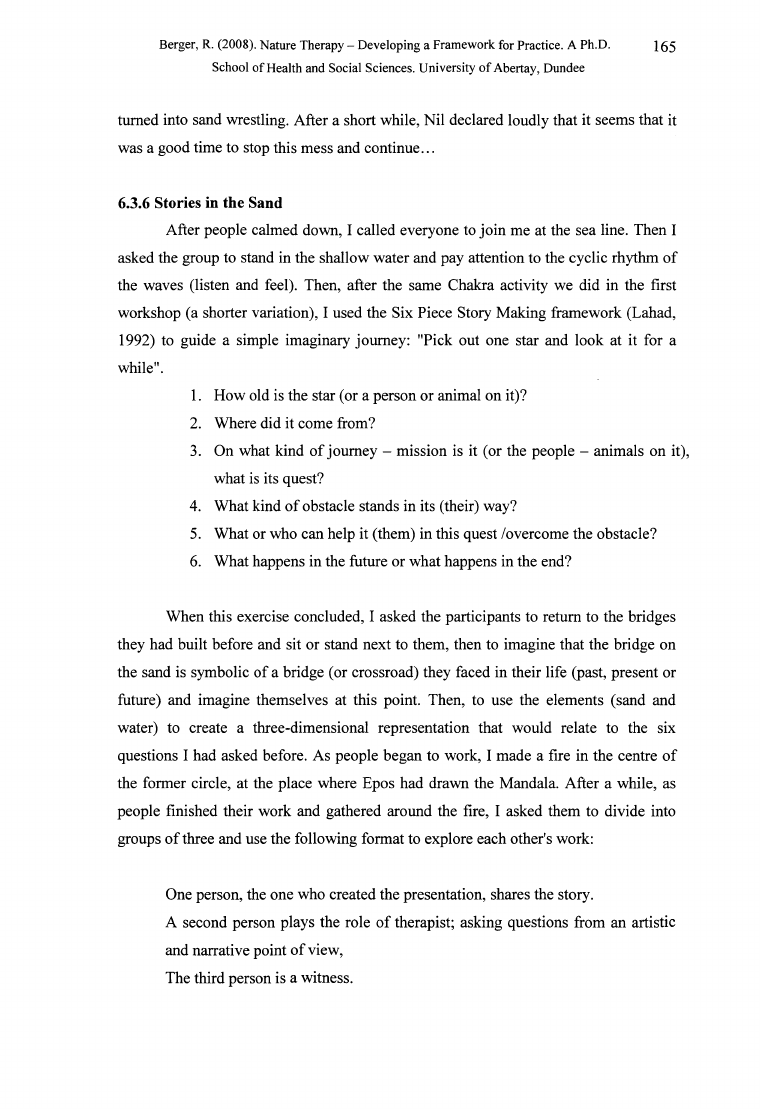
Berger, R. (2008). Nature Therapy - Developing a Framework for Practice. A Ph.D.
165
School of Health and Social Sciences. University of Abertay, Dundee
turned into sand wrestling. After a short while, N il declared loudly that it seems that it
was a good time to stop this mess and continue...
6.3.6 Stories in the Sand
After people calmed down, I called everyone to join me at the sea line. Then I
asked the group to stand in the shallow water and pay attention to the cyclic rhythm o f
the waves (listen and feel). Then, after the same Chakra activity we did in the first
workshop (a shorter variation), I used the Six Piece Story Making framework (Lahad,
1992) to guide a simple imaginary journey: "Pick out one star and look at it for a
while".
1. How old is the star (or a person or animal on it)?
2. Where did it come from?
3. On what kind o f journey - mission is it (or the people - animals on it),
what is its quest?
4. What kind o f obstacle stands in its (their) way?
5. What or who can help it (them) in this quest /overcome the obstacle?
6. What happens in the future or what happens in the end?
When this exercise concluded, I asked the participants to return to the bridges
they had built before and sit or stand next to them, then to imagine that the bridge on
the sand is symbolic o f a bridge (or crossroad) they faced in their life (past, present or
future) and imagine themselves at this point. Then, to use the elements (sand and
water) to create a three-dimensional representation that would relate to the six
questions I had asked before. As people began to work, I made a fire in the centre o f
the former circle, at the place where Epos had drawn the Mandala. After a while, as
people finished their work and gathered around the fire, I asked them to divide into
groups o f three and use the following format to explore each other's work:
One person, the one who created the presentation, shares the story.
A second person plays the role o f therapist; asking questions from an artistic
and narrative point o f view,
The third person is a witness.
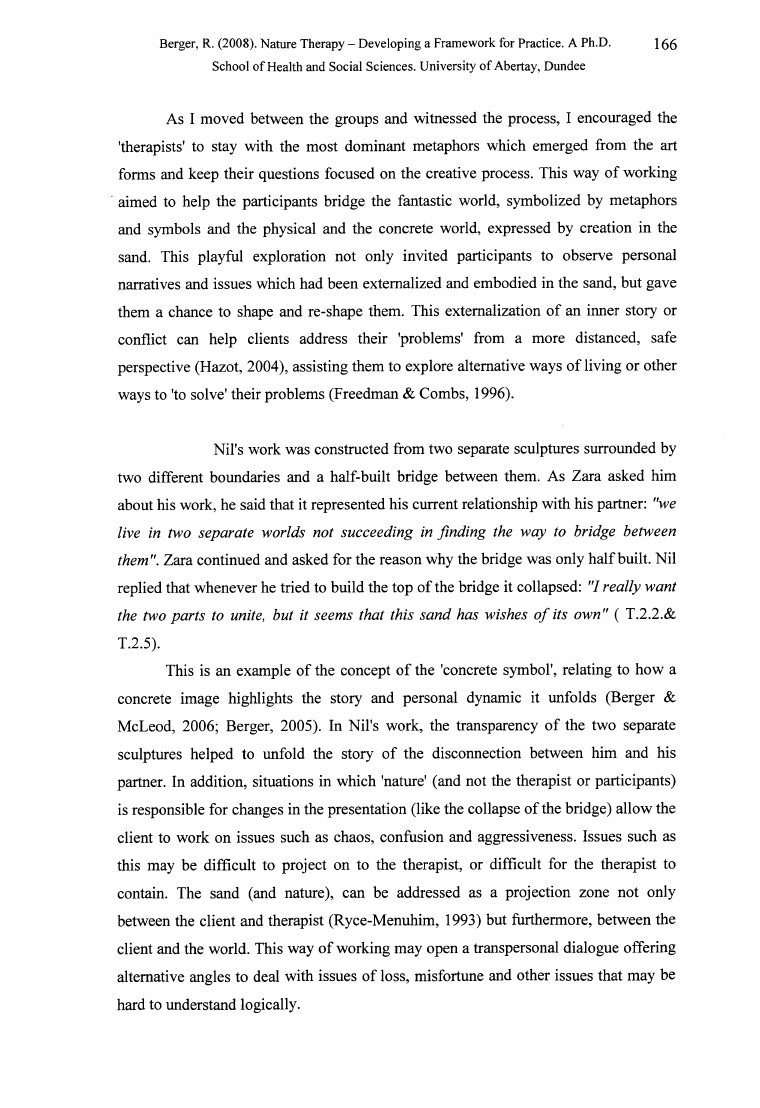
Berger, R. (2008). Nature Therapy - Developing a Framework for Practice. A Ph.D.
166
School of Health and Social Sciences. University of Abertay, Dundee
As I moved between the groups and witnessed the process, I encouraged the
'therapists' to stay with the most dominant metaphors which emerged from the art
forms and keep their questions focused on the creative process. This way o f working
aimed to help the participants bridge the fantastic world, symbolized by metaphors
and symbols and the physical and the concrete world, expressed by creation in the
sand. This playful exploration not only invited participants to observe personal
narratives and issues which had been externalized and embodied in the sand, but gave
them a chance to shape and re-shape them. This extemalization o f an inner story or
conflict can help clients address their 'problems' from a more distanced, safe
perspective (Hazot, 2004), assisting them to explore alternative ways o f living or other
ways to 'to solve' their problems (Freedman & Combs, 1996).
Nil's work was constructed from two separate sculptures surrounded by
two different boundaries and a half-built bridge between them. A s Zara asked him
about his work, he said that it represented his current relationship with his partner: "we
live in tw o se p a ra te w o rld s n ot su c c ee d in g in fin d in g the w a y to b rid g e b etw een
them ". Zara continued and asked for the reason why the bridge was only half built. N il
replied that whenever he tried to build the top o f the bridge it collapsed: "I r e a lly w a n t
th e tw o p a r ts to unite, b u t it se e m s th a t th is s a n d h a s w ish e s o f its ow n " ( T.2.2.&
T.2.5).
This is an example o f the concept o f the 'concrete symbol', relating to how a
concrete image highlights the story and personal dynamic it unfolds (Berger &
McLeod, 2006; Berger, 2005). In Nil's work, the transparency o f the two separate
sculptures helped to unfold the story o f the disconnection between him and his
partner. In addition, situations in which 'nature' (and not the therapist or participants)
is responsible for changes in the presentation (like the collapse o f the bridge) allow the
client to work on issues such as chaos, confusion and aggressiveness. Issues such as
this may be difficult to project on to the therapist, or difficult for the therapist to
contain. The sand (and nature), can be addressed as a projection zone not only
between the client and therapist (Ryce-Menuhim, 1993) but furthermore, between the
client and the world. This way o f working may open a transpersonal dialogue offering
alternative angles to deal with issues o f loss, misfortune and other issues that may be
hard to understand logically.
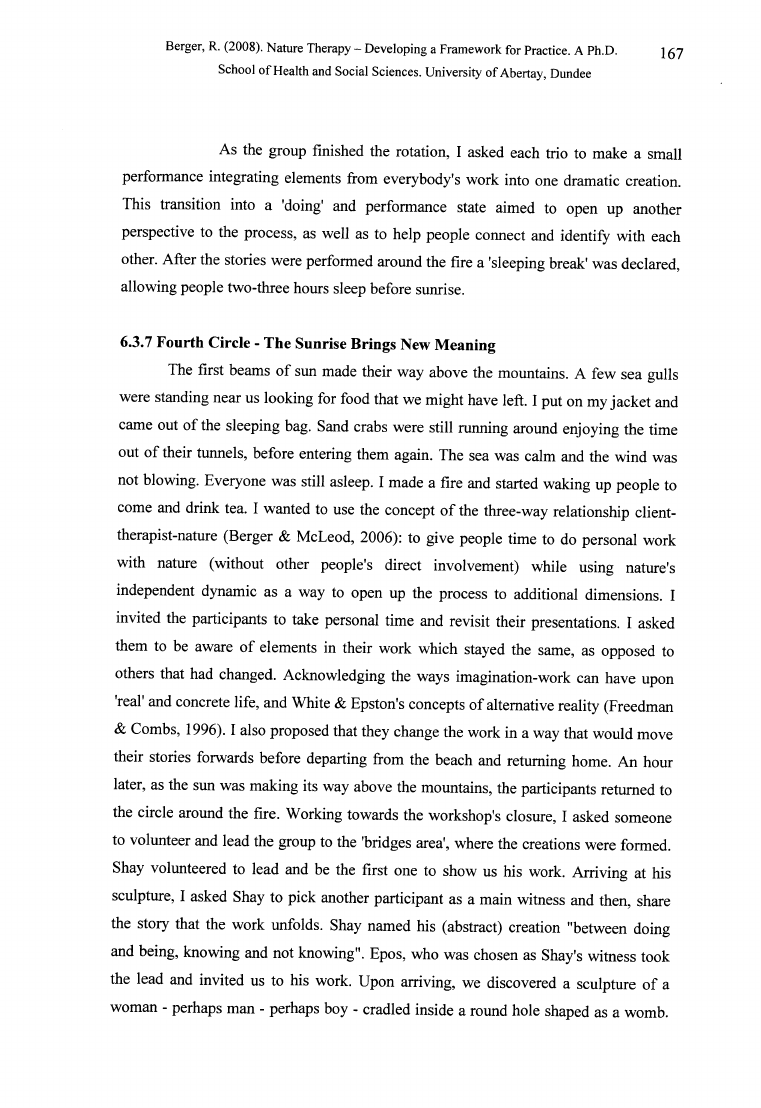
Berger, R. (2008). Nature Therapy - Developing a Framework for Practice. A Ph.D.
167
School of Health and Social Sciences. University of Abertay, Dundee
A s the group finished the rotation, I asked each trio to make a small
performance integrating elements from everybody's work into one dramatic creation.
This transition into a 'doing' and performance state aimed to open up another
perspective to the process, as well as to help people connect and identify with each
other. After the stories were performed around the fire a 'sleeping break' was declared,
allowing people two-three hours sleep before sunrise.
6.3.7 Fourth Circle - The Sunrise Brings New Meaning
The first beams o f sun made their way above the mountains. A few sea gulls
were standing near us looking for food that we might have left. I put on my jacket and
came out o f the sleeping bag. Sand crabs were still running around enjoying the time
out o f their tunnels, before entering them again. The sea was calm and the wind was
not blowing. Everyone was still asleep. I made a fire and started waking up people to
come and drink tea. I wanted to use the concept o f the three-way relationship client-
therapist-nature (Berger & McLeod, 2006): to give people time to do personal work
with nature (without other people's direct involvement) while using nature's
independent dynamic as a way to open up the process to additional dimensions. I
invited the participants to take personal time and revisit their presentations. I asked
them to be aware o f elements in their work which stayed the same, as opposed to
others that had changed. Acknowledging the ways imagination-work can have upon
'real' and concrete life, and White & Epston's concepts o f alternative reality (Freedman
& Combs, 1996). I also proposed that they change the work in a way that would move
their stories forwards before departing from the beach and returning home. An hour
later, as the sun was making its way above the mountains, the participants returned to
the circle around the fire. Working towards the workshop's closure, I asked someone
to volunteer and lead the group to the 'bridges area', where the creations were formed.
Shay volunteered to lead and be the first one to show us his work. Arriving at his
sculpture, I asked Shay to pick another participant as a main witness and then, share
the story that the work unfolds. Shay named his (abstract) creation "between doing
and being, knowing and not knowing". Epos, who was chosen as Shay's witness took
the lead and invited us to his work. Upon arriving, we discovered a sculpture o f a
woman - perhaps man - perhaps boy - cradled inside a round hole shaped as a womb.
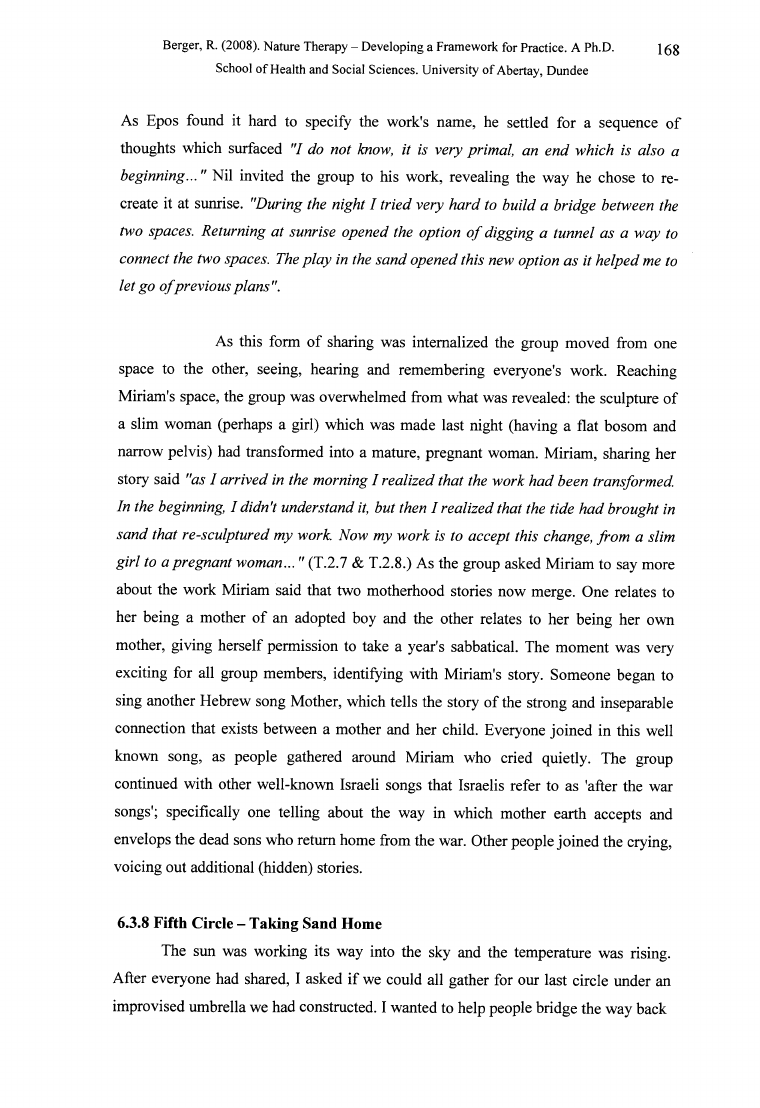
Berger, R. (2008). Nature Therapy - Developing a Framework for Practice. A Ph.D.
School of Health and Social Sciences. University of Abertay, Dundee
As Epos found it hard to specify the work’s name, he settled for a sequence o f
thoughts which surfaced "I d o n o t know , it is v e r y p rim a l, an e n d w h ic h is a lso a
b e g in n in g ..." Nil invited the group to his work, revealing the way he chose to re
create it at sunrise. " D u rin g th e n ig h t I t r i e d v e r y h a r d to b u ild a b r id g e b e tw e e n th e
tw o spaces. R eturning a t sunrise o pen ed the option o f diggin g a tunnel as a w a y to
co n n ect the tw o spaces. The p la y in the sa n d o p e n e d th is n ew o p tio n a s it h e lp e d m e to
let g o o fp revio u s plans".
As this form o f sharing was internalized the group moved from one
space to the other, seeing, hearing and remembering everyone's work. Reaching
Miriam's space, the group was overwhelmed from what was revealed: the sculpture o f
a slim woman (perhaps a girl) which was made last night (having a flat bosom and
narrow pelvis) had transformed into a mature, pregnant woman. Miriam, sharing her
story said "as 1 a r r iv e d in th e m o rn in g I r e a liz e d th a t th e w o r k h a d b e e n tra n sfo rm e d .
In th e b eg in n in g , I d id n 't u n d e r s ta n d it, b u t th en I r e a liz e d th a t th e tid e h a d b r o u g h t in
san d that re-scu lptu red m y work. N ow m y w ork is to accept this change, fro m a slim
g i r l to a p r e g n a n t w o m a n ..." (T.2.7 & T.2.8.) A s the group asked Miriam to say more
about the work Miriam said that two motherhood stories now merge. One relates to
her being a mother o f an adopted boy and the other relates to her being her own
mother, giving herself permission to take a year's sabbatical. The moment was very
exciting for all group members, identifying with Miriam's story. Someone began to
sing another Hebrew song Mother, which tells the story o f the strong and inseparable
connection that exists between a mother and her child. Everyone joined in this well
known song, as people gathered around Miriam who cried quietly. The group
continued with other well-known Israeli songs that Israelis refer to as 'after the war
songs'; specifically one telling about the way in which mother earth accepts and
envelops the dead sons who return home from the war. Other people joined the crying,
voicing out additional (hidden) stories.
6.3.8 Fifth Circle - Taking Sand Home
The sun was working its way into the sky and the temperature was rising.
After everyone had shared, I asked if we could all gather for our last circle under an
improvised umbrella we had constructed. I wanted to help people bridge the way back
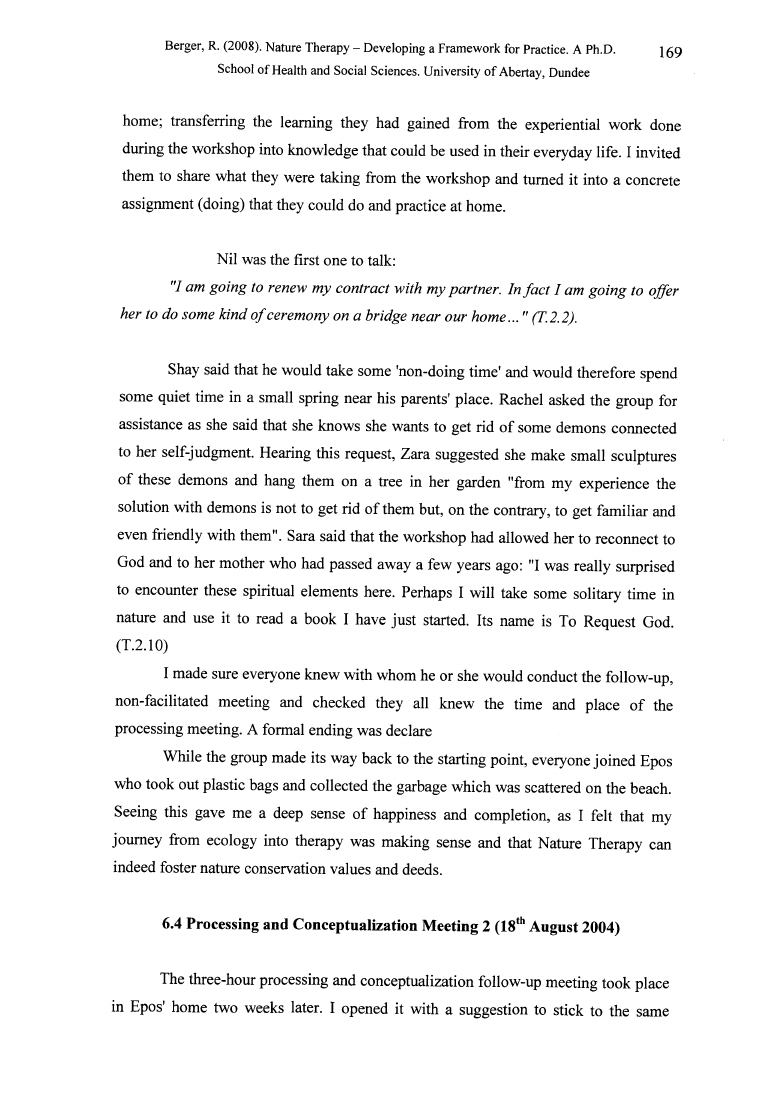
Berger, R. (2008). Nature Therapy - Developing a Framework for Practice. A Ph.D.
169
School of Health and Social Sciences. University of Abertay, Dundee
home; transferring the learning they had gained from the experiential work done
during the workshop into knowledge that could be used in their everyday life. I invited
them to share what they were taking from the workshop and turned it into a concrete
assignment (doing) that they could do and practice at home.
N il was the first one to talk:
"I a m g o in g to re n e w m y c o n tr a c t w ith m y p a r tn e r . In f a c t I a m g o in g to o ffer
her to do som e kin d o f cerem on y on a bridge n ear ou r hom e... " (T.2.2).
Shay said that he would take some 'non-doing time' and would therefore spend
some quiet time in a small spring near his parents' place. Rachel asked the group for
assistance as she said that she knows she wants to get rid o f some demons connected
to her self-judgment. Hearing this request, Zara suggested she make small sculptures
o f these demons and hang them on a tree in her garden "from my experience the
solution with demons is not to get rid o f them but, on the contrary, to get familiar and
even friendly with them". Sara said that the workshop had allowed her to reconnect to
God and to her mother who had passed away a few years ago: "I was really surprised
to encounter these spiritual elements here. Perhaps I w ill take some solitary time in
nature and use it to read a book I have just started. Its name is To Request God.
(T.2.10)
I made sure everyone knew with whom he or she would conduct the follow-up,
non-facilitated meeting and checked they all knew the time and place o f the
processing meeting. A formal ending was declare
While the group made its way back to the starting point, everyone joined Epos
who took out plastic bags and collected the garbage which was scattered on the beach.
Seeing this gave me a deep sense o f happiness and completion, as I felt that my
journey from ecology into therapy was making sense and that Nature Therapy can
indeed foster nature conservation values and deeds.
6.4 Processing and Conceptualization Meeting 2 (18thAugust 2004)
The three-hour processing and conceptualization follow-up meeting took place
in Epos' home two weeks later. I opened it with a suggestion to stick to the same
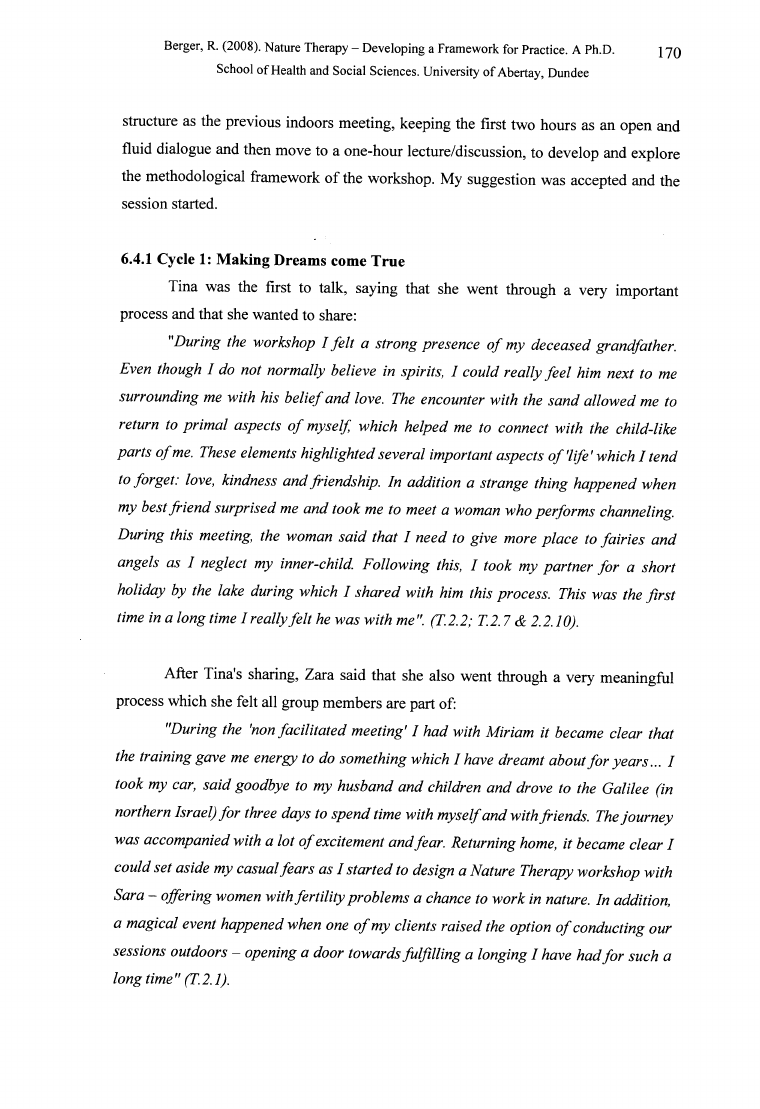
Berger, R. (2008). Nature Therapy - Developing a Framework for Practice. A Ph.D.
170
School of Health and Social Sciences. University of Abertay, Dundee
structure as the previous indoors meeting, keeping the first two hours as an open and
fluid dialogue and then move to a one-hour lecture/discussion, to develop and explore
the methodological framework o f the workshop. My suggestion was accepted and the
session started.
6.4.1 Cycle 1: Making Dreams come True
Tina was the first to talk, saying that she went through a very important
process and that she wanted to share:
"D u r in g th e w o r k s h o p I f e l t a s tr o n g p r e s e n c e o f m y d e c e a s e d g r a n d fa th e r .
E ven though I d o n ot n o rm a lly b elieve in spirits, I c o u ld re a lly f e e l him n ext to m e
surrounding m e w ith his b e lie f a n d love. The encounter w ith the sa n d a llo w ed m e to
return to p rim a l asp ects o f m y se lf w h ich h elp ed m e to con n ect w ith the ch ild-like
p a rts o f me. These elem ents h igh ligh ted severa l im portant asp ects o f'life'w h ich I ten d
to fo rg et: love, kindness a n d frien dsh ip. In addition a stran ge thing h appen ed w hen
m y b est fr ie n d su rp rised m e a n d to o k m e to m eet a w om an w h o p erfo rm s channeling.
D u rin g this m eeting, the w om an s a id th at I n eed to g ive m ore p la c e to fa irie s a n d
an g els a s I n eg lect m y inner-child. F o llo w in g this, I to o k m y p a r tn e r f o r a sh o rt
h oliday by the lake du rin g w hich I sh a re d w ith him this p ro cess. This w a s the f ir s t
tim e in a lo n g tim e I r e a lly f e l t h e w a s w ith m e ”. (T .2 .2 ; T .2 .7 & 2 .2 .1 0 ).
After Tina's sharing, Zara said that she also went through a very meaningful
process which she felt all group members are part of:
"D u r in g th e 'n on f a c i l i t a t e d m e e tin g ’ I h a d w ith M ir ia m it b e c a m e c le a r th a t
th e tra in in g g a v e m e en e rg y to d o so m e th in g w h ich I h a ve d re a m t a b o u t f o r y e a r s ... I
to o k m y car, s a id g o o d b ye to m y h u sb a n d a n d ch ildren a n d d ro ve to the G a lilee (in
northern Israel) fo r three days to sp en d tim e w ith m yself a n d w ith frien ds. The jo u rn e y
w as accom panied w ith a lo t o f excitem ent a n d fear. R eturning home, it becam e clear I
cou ld se t aside m y casualfe a rs as I sta rte d to design a N ature Therapy w orkshop w ith
S a ra - offerin g w om en w ith fe r tility p ro b le m s a chance to w o rk in nature. In addition,
a m agical even t h appen ed w hen one o f m y clients ra ise d the option o f conducting ou r
sessions outdoors - opening a door tow ards fulfilling a longing I have h ad fo r such a
lo n g tim e ” (T.2.1).
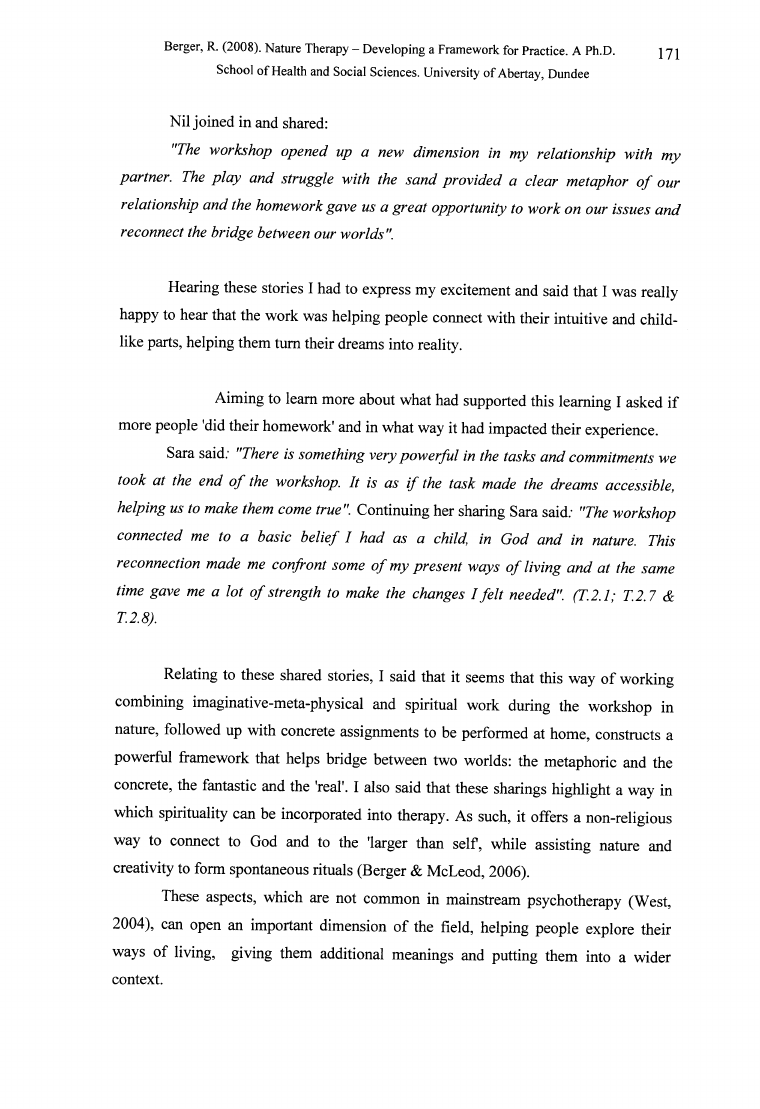
Berger, R. (2008). Nature Therapy - Developing a Framework for Practice. A Ph.D.
171
School of Health and Social Sciences. University of Abertay, Dundee
N il joined in and shared:
The w o rk sh o p o p en ed up a n ew dim en sion in m y rela tio n sh ip w ith m y
partn er. The p la y an d struggle w ith the sa n d p ro v id e d a clear m etaphor o f our
relation sh ip a n d the hom ew ork ga ve us a g re a t opportu nity to w ork on our issues a n d
recon n ect the b rid g e betw een our worlds".
Hearing these stories I had to express my excitement and said that I was really
happy to hear that the work was helping people connect with their intuitive and child
like parts, helping them turn their dreams into reality.
Aiming to learn more about what had supported this learning I asked if
more people did their homework' and in what way it had impacted their experience.
Sara said: "There is s o m e th in g v e r y p o w e r f u l in th e ta s k s a n d c o m m itm e n ts w e
to o k a t the en d o f the w orkshop. It is a s i f the task m ade the d ream s accessible,
h e lp in g us to m a k e th em c o m e true". Continuing her sharing Sara said: "The w o r k s h o p
co n n ected m e to a b a sic b e lie f I h a d a s a child, in G o d a n d in nature. This
recon n ection m ade m e confron t som e o f m y p re se n t w a ys o f livin g a n d a t the sam e
tim e g a v e m e a l o t o f s tr e n g th to m a k e th e c h a n g e s I f e l t n e e d e d ”. (T .2 .1 ; T .2 .7 &
T .2 .8 ).
Relating to these shared stories, I said that it seems that this way o f working
combining imaginative-meta-physical and spiritual work during the workshop in
nature, followed up with concrete assignments to be performed at home, constructs a
powerful framework that helps bridge between two worlds: the metaphoric and the
concrete, the fantastic and the 'real'. I also said that these sharings highlight a way in
which spirituality can be incorporated into therapy. As such, it offers a non-religious
way to connect to God and to the 'larger than self, while assisting nature and
creativity to form spontaneous rituals (Berger & McLeod, 2006).
These aspects, which are not common in mainstream psychotherapy (West,
2004), can open an important dimension o f the field, helping people explore their
ways o f living, giving them additional meanings and putting them into a wider
context.
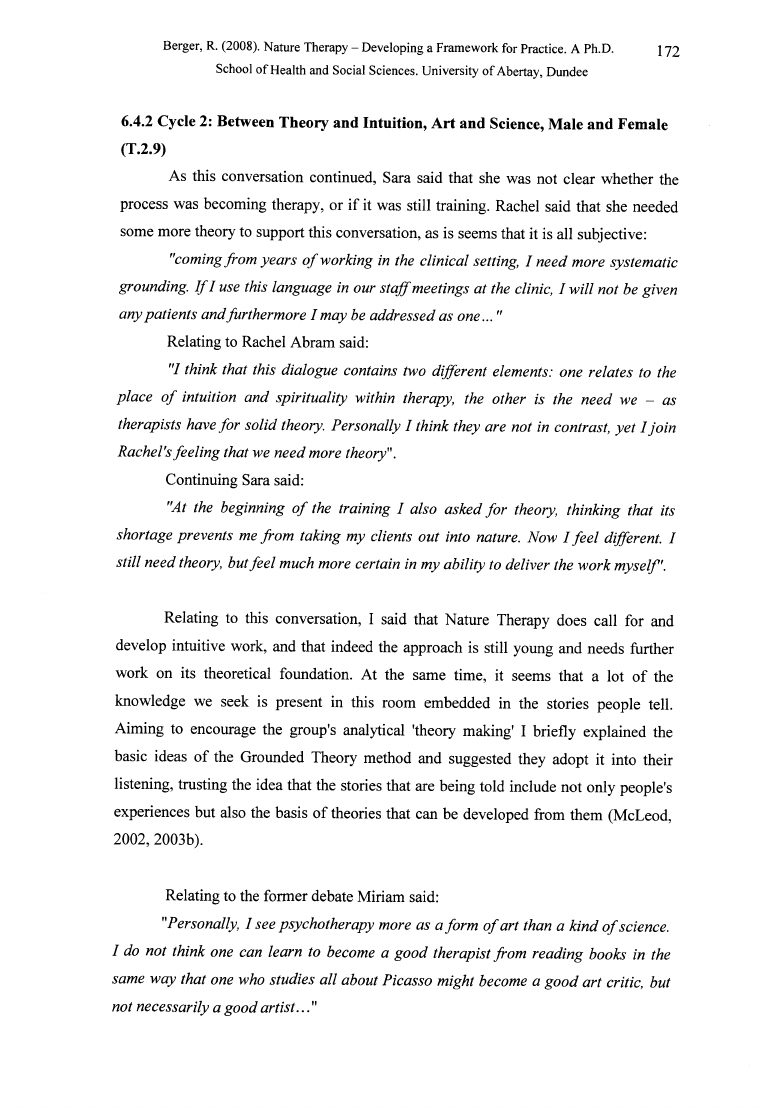
Berger, R. (2008). Nature Therapy - Developing a Framework for Practice. A Ph.D.
\\ 72
School of Health and Social Sciences. University of Abertay, Dundee
6.4.2 Cycle 2: Between Theory and Intuition, Art and Science, Male and Female
(T.2.9)
As this conversation continued, Sara said that she was not clear whether the
process was becoming therapy, or if it was still training. Rachel said that she needed
some more theory to support this conversation, as is seems that it is all subjective:
"com ing fro m y e a r s o f w o rk in g in the c lin ica l settin g, I n e e d m o re sy ste m a tic
grou n din g. I f I use this la n g u a g e in ou r s ta ff m eetin g s a t the clinic, I w ill n o t be g iven
any p a tien ts an dfu rth erm ore I m ay be add ressed as one... "
Relating to Rachel Abram said:
"I th in k th a t th is d ia lo g u e c o n ta in s tw o d iffe re n t e le m en ts: o n e r e la te s to th e
p la c e o f intuition a n d sp iritu a lity w ithin therapy, the other is the n eed w e - as
th era p ists have f o r s o lid theory. P erso n a lly I thin k th ey a re n o t in con trast, y e t I jo in
R a c h e l's f e e l in g th a t w e n e e d m o r e th e o r y ".
Continuing Sara said:
"At the begin n in g o f the train in g I also a sk e d f o r theory, th in kin g th a t its
sh ortage p reven ts m e fro m taking m y clients ou t into nature. N ow I f e e l different. I
still n e e d theory, bu tf e e l m uch m ore certain in m y a b ility to d e liv er the w o rk m y s e lf .
Relating to this conversation, I said that Nature Therapy does call for and
develop intuitive work, and that indeed the approach is still young and needs further
work on its theoretical foundation. At the same time, it seems that a lot o f the
knowledge we seek is present in this room embedded in the stories people tell.
Aiming to encourage the group's analytical 'theory making' I briefly explained the
basic ideas o f the Grounded Theory method and suggested they adopt it into their
listening, trusting the idea that the stories that are being told include not only people's
experiences but also the basis o f theories that can be developed from them (McLeod,
2002, 2003b).
Relating to the former debate Miriam said:
"P e r s o n a lly , I s e e p s y c h o th e r a p y m o re a s a f o r m o f a r t th a n a k in d o f sc ie n c e .
I do n o t thin k one can learn to becom e a g o o d th era p ist fro m re a d in g bo o k s in the
sam e w a y that one who stu dies a ll about P icasso m ight becom e a g o o d a rt critic, but
n o t n e c e s s a r ily a g o o d a r t i s t ..."
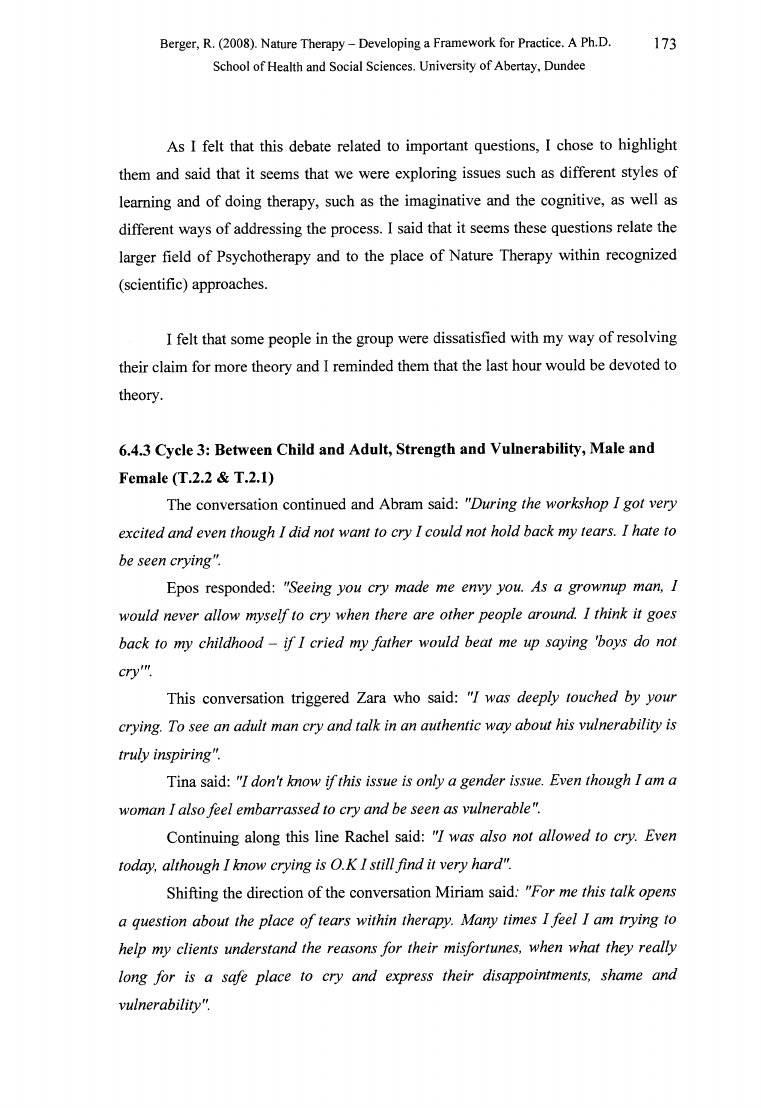
Berger, R. (2008). Nature Therapy - Developing a Framework for Practice. A Ph.D.
173
School of Health and Social Sciences. University of Abertay, Dundee
As I felt that this debate related to important questions, I chose to highlight
them and said that it seems that we were exploring issues such as different styles o f
learning and o f doing therapy, such as the imaginative and the cognitive, as w ell as
different ways o f addressing the process. I said that it seems these questions relate the
larger field o f Psychotherapy and to the place o f Nature Therapy within recognized
(scientific) approaches.
I felt that some people in the group were dissatisfied with my way o f resolving
their claim for more theory and I reminded them that the last hour would be devoted to
theory.
6.4.3 Cycle 3: Between Child and Adult, Strength and Vulnerability, Male and
Female (T.2.2 & T.2.1)
The conversation continued and Abram said: "D u r in g th e w o r k s h o p I g o t v e r y
excited a n d even though I d id n ot w an t to cry I co u ld n ot h o ld back m y tears. I hate to
be seen crying".
Epos responded: "Seeing y o u c r y m a d e m e e n v y y o u . A s a g r o w n u p m an, I
w o u ld never a llo w m yself to cry w hen there are oth er p e o p le around. I think it g o es
back to m y ch ildh ood - if I c rie d m y fa th e r w o u ld b ea t me up sa yin g 'boys do not
cry'".
This conversation triggered Zara who said: "I w a s d e e p ly to u c h e d b y y o u r
crying. To see an a d u lt m an c ry a n d ta lk in an au th en tic w a y a b o u t his vu ln era b ility is
tru ly inspiring".
Tina said: "I d o n 't k n o w i f th is iss u e is o n ly a g e n d e r issu e. E v e n th o u g h I a m a
w o m a n I a ls o f e e l e m b a r r a s s e d to c r y a n d b e s e e n a s v u ln e r a b le ".
Continuing along this line Rachel said: "I w a s a ls o n o t a llo w e d to cry. E v e n
today, although I know cryin g is O .K I stillfin d it very hard".
Shifting the direction o f the conversation Miriam said: "For m e th is ta lk o p e n s
a question ab o u t the p la c e o f tea rs w ithin therapy. M an y tim es I f e e l I am tryin g to
help m y clients u nderstan d the reason s f o r their m isfortunes, w hen w h at th ey rea lly
long fo r is a safe p la ce to cry a n d express th eir disappointm ents, sham e a n d
v u ln e ra b ility " .
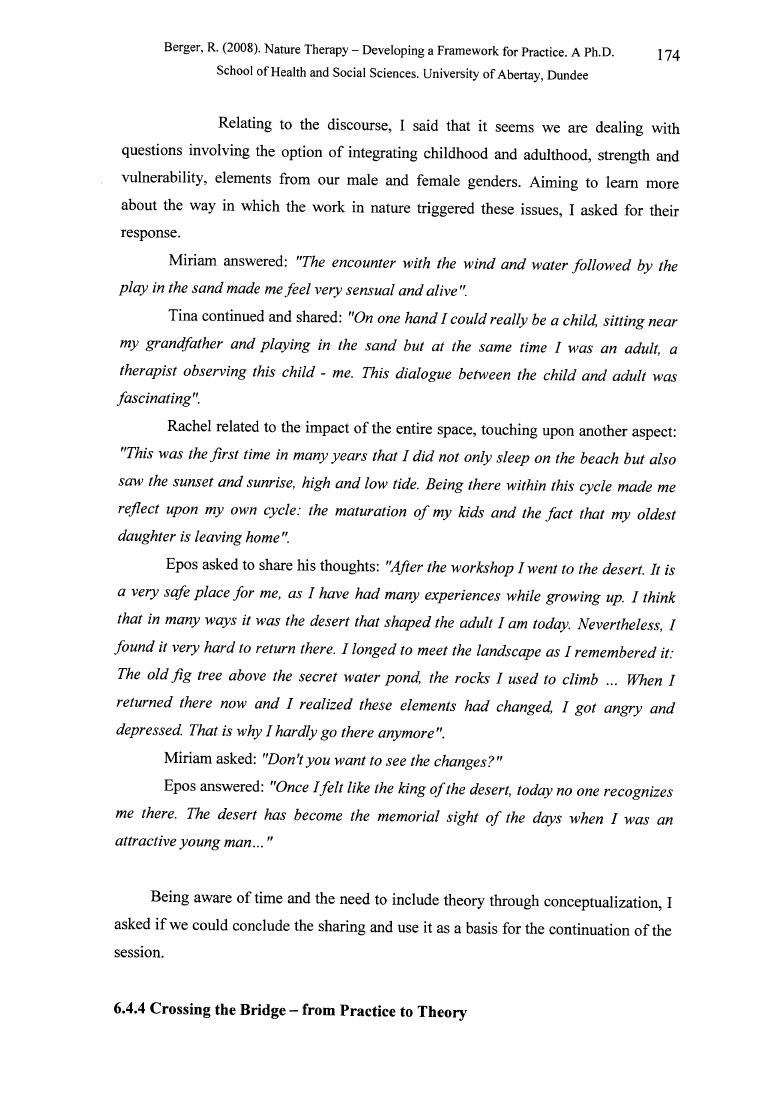
Berger, R. (2008). Nature Therapy - Developing a Framework for Practice. A Ph.D.
174
School of Health and Social Sciences. University of Abertay, Dundee
Relating to the discourse, I said that it seems we are dealing with
questions involving the option o f integrating childhood and adulthood, strength and
vulnerability, elements from our male and female genders. Aiming to learn more
about the way in which the work in nature triggered these issues, I asked for their
response.
Miriam answered: "The e n c o u n te r w ith th e w in d a n d w a te r f o l l o w e d b y th e
p l a y in th e s a n d m a d e m e f e e l v e r y s e n s u a l a n d a liv e ".
Tina continued and shared: "On o n e h a n d I c o u ld r e a lly b e a ch ild , s ittin g n e a r
m y g ra n d fa th er a n d p la y in g in the sa n d bu t a t the sam e tim e I w a s an adult, a
th erapist observin g this ch ild - me. This dialogu e betw een the ch ild a n d a d u lt w as
fa sc in a tin g " .
Rachel related to the impact o f the entire space, touching upon another aspect:
"This w a s the f ir s t tim e in m an y y e a r s th a t I d id n o t o n ly sle e p on the b ea ch b u t a lso
sa w the su n set a n d sunrise, high a n d low tide. B ein g there w ithin this cycle m ade m e
reflect upon m y ow n cycle: the m atu ration o f m y kids a n d the f a c t th at m y o ld est
d a u g h te r is le a v in g h o m e ".
Epos asked to share his thoughts: "After th e w o r k s h o p I w e n t to th e d e s e r t. I t is
a very safe p la c e fo r me, as I have h a d m any experien ces w h ile g ro w in g up. I think
th a t in m an y w a y s it w a s the d e se rt th at sh a p e d the a d u lt I am today. N everth eless, I
fo u n d it v e ry h a rd to retu rn there. I lo n g e d to m eet the la n d sca p e a s I re m e m b ere d it:
The o ld f i g tre e a b o v e the s e c r e t w a te r p o n d , the ro c k s I u se d to clim b ... W hen I
returned there now an d I rea lized these elem ents h ad changed, I g o t an gry an d
depressed. That is w hy I h ardly g o there anym ore".
Miriam asked: " D o n 'ty o u w a n t to s e e th e c h a n g e s ? "
Epos answered: "O nce I f e l t lik e th e k in g o f th e d e sert, to d a y n o o n e r e c o g n iz e s
m e there. The d esert has becom e the m em orial sig h t o f the days w hen I w a s an
attractive young m a n ..."
Being aware o f time and the need to include theory through conceptualization, I
asked if w e could conclude the sharing and use it as a basis for the continuation o f the
session.
6.4.4 Crossing the Bridge - from Practice to Theory
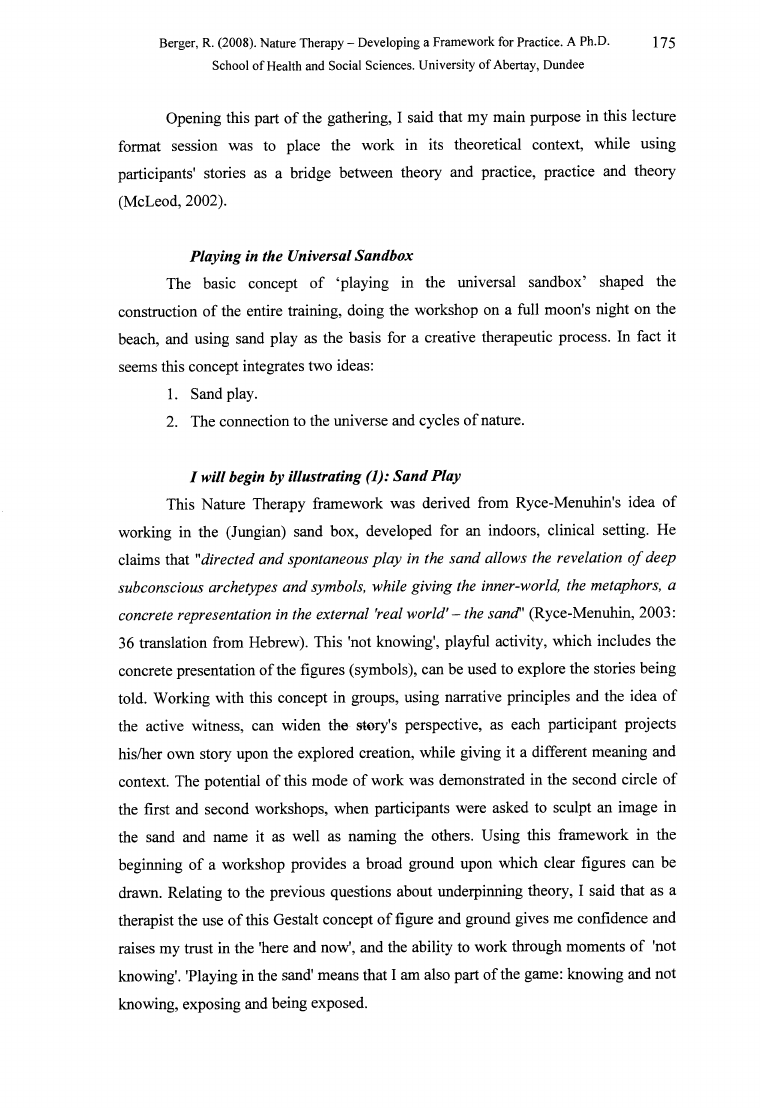
Berger, R. (2008). Nature Therapy - Developing a Framework for Practice. A Ph.D.
175
School of Health and Social Sciences. University of Abertay, Dundee
Opening this part o f the gathering, I said that my main purpose in this lecture
format session was to place the work in its theoretical context, while using
participants' stories as a bridge between theory and practice, practice and theory
(McLeod, 2002).
P la y in g in th e U n iv e r s a l S a n d b o x
The basic concept o f ‘playing in the universal sandbox’ shaped the
construction o f the entire training, doing the workshop on a full moon's night on the
beach, and using sand play as the basis for a creative therapeutic process. In fact it
seems this concept integrates two ideas:
1. Sand play.
2. The connection to the universe and cycles o f nature.
I w ill b eg in b y illu stra tin g (1 ): S a n d P la y
This Nature Therapy framework was derived from Ryce-Menuhin's idea o f
working in the (Jungian) sand box, developed for an indoors, clinical setting. He
claims that "d ir e c te d a n d s p o n ta n e o u s p l a y in th e s a n d a llo w s th e r e v e la tio n o f d e e p
su bcon sciou s arch etypes a n d sym bols, w h ile g ivin g the inner-w orld, the m etaphors, a
c o n crete re p re se n ta tio n in the e x te rn a l 'real w o r ld ' — the s a n d " (Ryce-Menuhin, 2003:
36 translation from Hebrew). This 'not knowing', playful activity, which includes the
concrete presentation o f the figures (symbols), can be used to explore the stories being
told. Working with this concept in groups, using narrative principles and the idea o f
the active witness, can widen the story's perspective, as each participant projects
his/her own story upon the explored creation, while giving it a different meaning and
context. The potential o f this mode o f work was demonstrated in the second circle o f
the first and second workshops, when participants were asked to sculpt an image in
the sand and name it as well as naming the others. Using this framework in the
beginning o f a workshop provides a broad ground upon which clear figures can be
drawn. Relating to the previous questions about underpinning theory, I said that as a
therapist the use o f this Gestalt concept o f figure and ground gives me confidence and
raises my trust in the 'here and now', and the ability to work through moments o f 'not
knowing'. 'Playing in the sand' means that I am also part o f the game: knowing and not
knowing, exposing and being exposed.
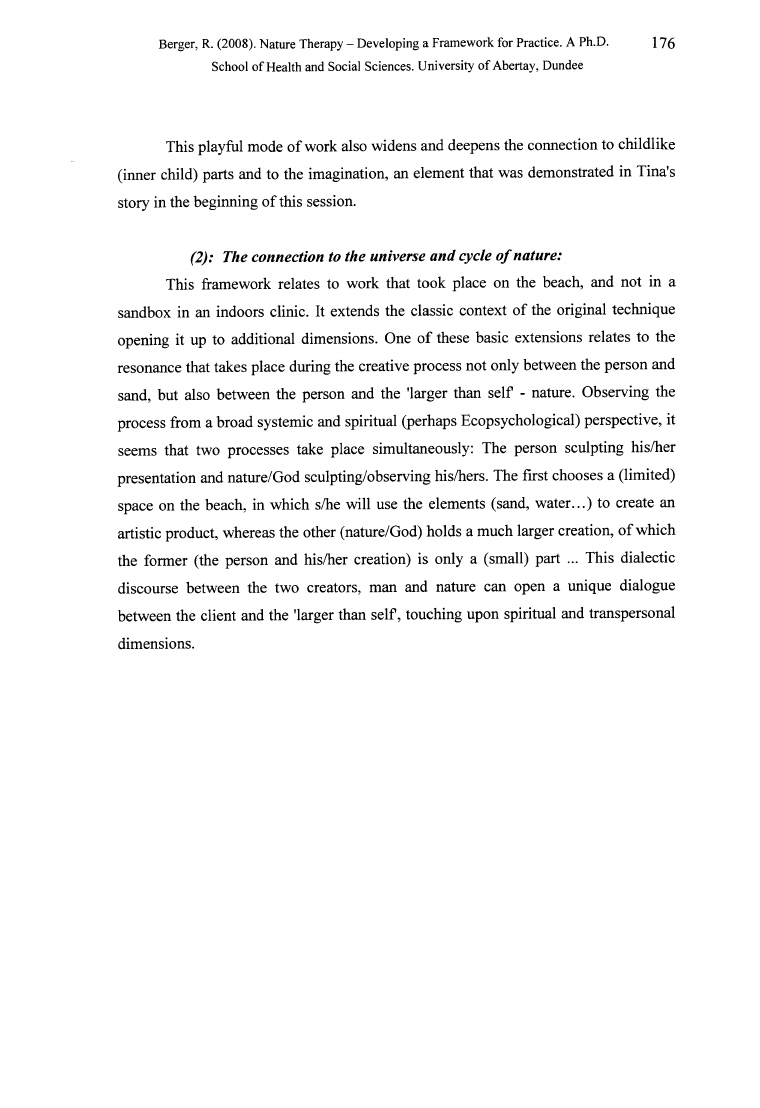
Berger, R. (2008). Nature Therapy - Developing a Framework for Practice. A Ph.D.
176
School of Health and Social Sciences. University of Abertay, Dundee
This playful mode of work also widens and deepens the connection to childlike
(inner child) parts and to the imagination, an element that was demonstrated in Tina's
story in the beginning of this session.
(2): The connection to the universe and cycle o f nature:
This framework relates to work that took place on the beach, and not in a
sandbox in an indoors clinic. It extends the classic context o f the original technique
opening it up to additional dimensions. One o f these basic extensions relates to the
resonance that takes place during the creative process not only between the person and
sand, but also between the person and the 'larger than self - nature. Observing the
process from a broad systemic and spiritual (perhaps Ecopsychological) perspective, it
seems that two processes take place simultaneously: The person sculpting his/her
presentation and nature/God sculpting/observing his/hers. The first chooses a (limited)
space on the beach, in which s/he will use the elements (sand, w ater...) to create an
artistic product, whereas the other (nature/God) holds a much larger creation, of which
the former (the person and his/her creation) is only a (small) part ... This dialectic
discourse between the two creators, man and nature can open a unique dialogue
between the client and the 'larger than self, touching upon spiritual and transpersonal
dimensions.
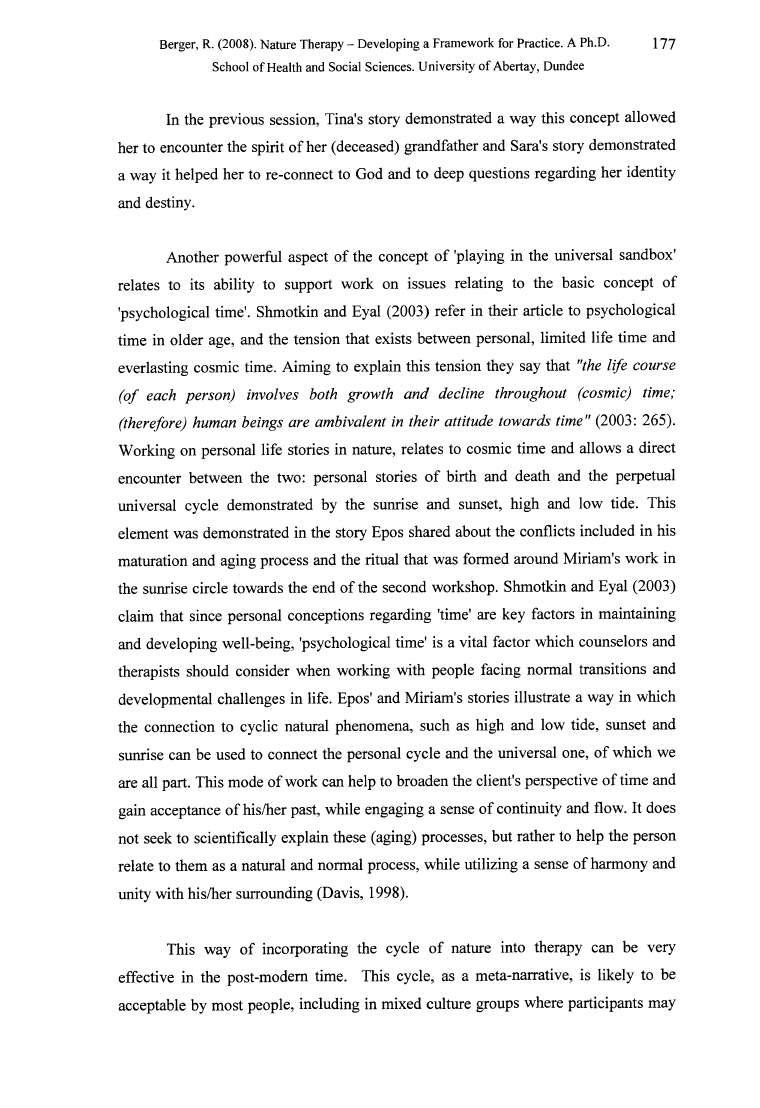
Berger, R. (2008). Nature Therapy - Developing a Framework for Practice. A Ph.D.
17 7
School of Health and Social Sciences. University of Abertay, Dundee
In the previous session, Tina's story demonstrated a way this concept allowed
her to encounter the spirit of her (deceased) grandfather and Sara's story demonstrated
a way it helped her to re-connect to God and to deep questions regarding her identity
and destiny.
Another powerful aspect of the concept o f 'playing in the universal sandbox'
relates to its ability to support work on issues relating to the basic concept of
'psychological time'. Shmotkin and Eyal (2003) refer in their article to psychological
time in older age, and the tension that exists between personal, limited life time and
everlasting cosmic time. Aiming to explain this tension they say that "the life co u rse
(o f each p erso n ) involves both grow th a n d decline throughout (cosm ic) tim e;
(th erefo re) h u m an b e in g s a re a m b iv a le n t in th e ir a ttitu d e to w a r d s tim e" (2003: 265).
Working on personal life stories in nature, relates to cosmic time and allows a direct
encounter between the two: personal stories o f birth and death and the perpetual
universal cycle demonstrated by the sunrise and sunset, high and low tide. This
element was demonstrated in the story Epos shared about the conflicts included in his
maturation and aging process and the ritual that was formed around Miriam's work in
the sunrise circle towards the end of the second workshop. Shmotkin and Eyal (2003)
claim that since personal conceptions regarding 'time' are key factors in maintaining
and developing well-being, 'psychological time' is a vital factor which counselors and
therapists should consider when working with people facing normal transitions and
developmental challenges in life. Epos' and Miriam's stories illustrate a way in which
the connection to cyclic natural phenomena, such as high and low tide, sunset and
sunrise can be used to connect the personal cycle and the universal one, of which we
are all part. This mode of work can help to broaden the client's perspective of time and
gain acceptance of his/her past, while engaging a sense of continuity and flow. It does
not seek to scientifically explain these (aging) processes, but rather to help the person
relate to them as a natural and normal process, while utilizing a sense o f harmony and
unity with his/her surrounding (Davis, 1998).
This way of incorporating the cycle of nature into therapy can be very
effective in the post-modern time. This cycle, as a meta-narrative, is likely to be
acceptable by most people, including in mixed culture groups where participants may
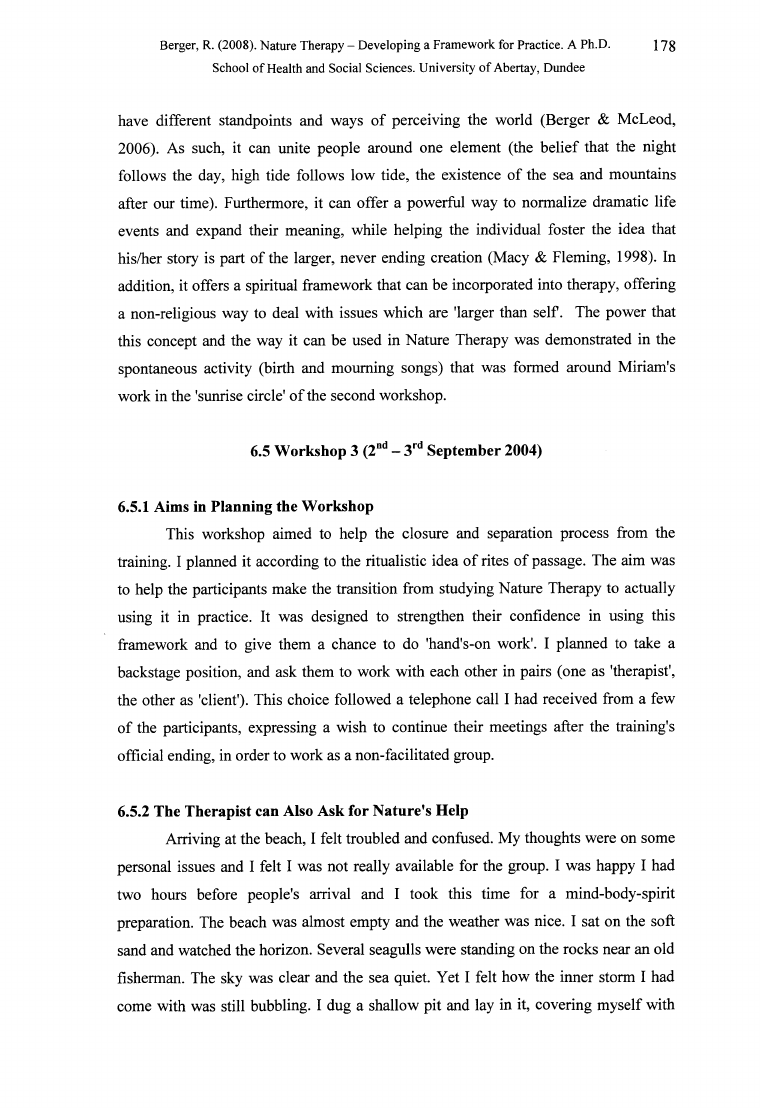
Berger, R. (2008). Nature Therapy - Developing a Framework for Practice. A Ph.D.
178
School of Health and Social Sciences. University of Abertay, Dundee
have different standpoints and ways of perceiving the world (Berger & McLeod,
2006). As such, it can unite people around one element (the belief that the night
follows the day, high tide follows low tide, the existence of the sea and mountains
after our time). Furthermore, it can offer a powerful way to normalize dramatic life
events and expand their meaning, while helping the individual foster the idea that
his/her story is part of the larger, never ending creation (Macy & Fleming, 1998). In
addition, it offers a spiritual framework that can be incorporated into therapy, offering
a non-religious way to deal with issues which are 'larger than self. The power that
this concept and the way it can be used in Nature Therapy was demonstrated in the
spontaneous activity (birth and mourning songs) that was formed around Miriam's
work in the 'sunrise circle' o f the second workshop.
6.5 Workshop 3 (2nd- 3rdSeptember 2004)
6.5.1 Aims in Planning the Workshop
This workshop aimed to help the closure and separation process from the
training. I planned it according to the ritualistic idea of rites of passage. The aim was
to help the participants make the transition from studying Nature Therapy to actually
using it in practice. It was designed to strengthen their confidence in using this
framework and to give them a chance to do 'hand's-on work'. I planned to take a
backstage position, and ask them to work with each other in pairs (one as 'therapist',
the other as 'client'). This choice followed a telephone call I had received from a few
of the participants, expressing a wish to continue their meetings after the training's
official ending, in order to work as a non-facilitated group.
6.5.2 The Therapist can Also Ask for Nature’s Help
Arriving at the beach, I felt troubled and confused. My thoughts were on some
personal issues and I felt I was not really available for the group. I was happy I had
two hours before people's arrival and I took this time for a mind-body-spirit
preparation. The beach was almost empty and the weather was nice. I sat on the soft
sand and watched the horizon. Several seagulls were standing on the rocks near an old
fisherman. The sky was clear and the sea quiet. Yet I felt how the inner storm I had
come with was still bubbling. I dug a shallow pit and lay in it, covering myself with
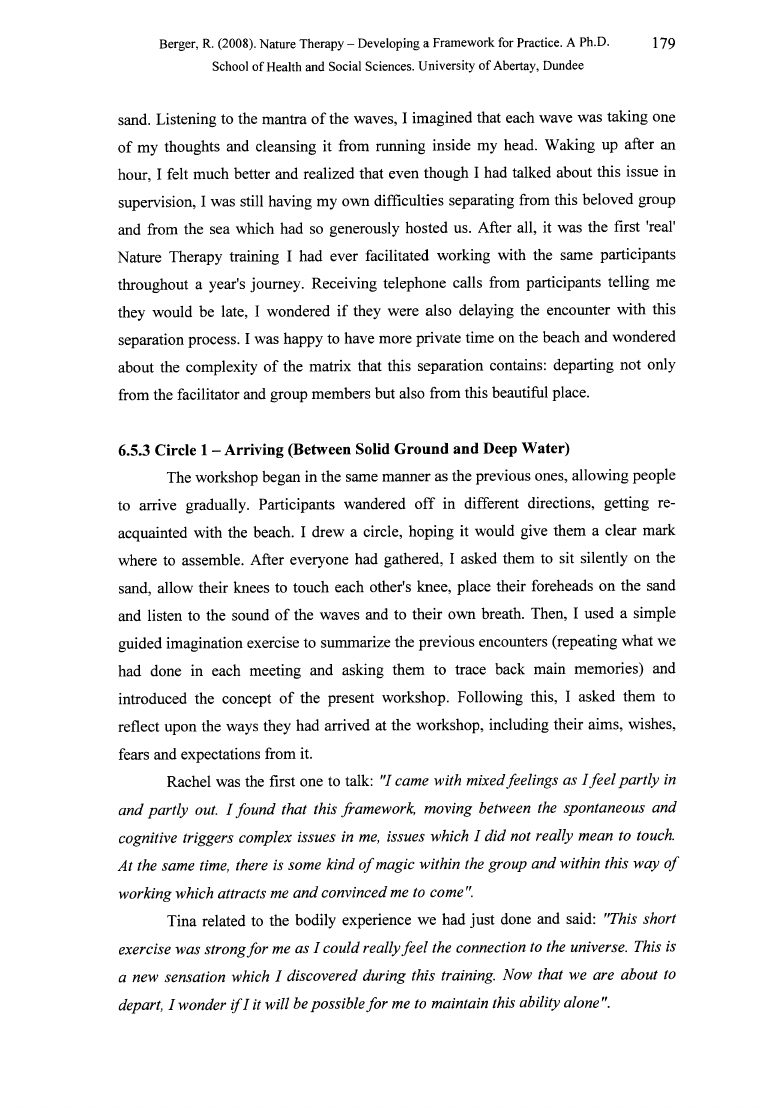
Berger, R. (2008). Nature Therapy - Developing a Framework for Practice. A Ph.D.
179
School of Health and Social Sciences. University of Abertay, Dundee
sand. Listening to the mantra of the waves, I imagined that each wave was taking one
of my thoughts and cleansing it from running inside my head. Waking up after an
hour, I felt much better and realized that even though I had talked about this issue in
supervision, I was still having my own difficulties separating from this beloved group
and from the sea which had so generously hosted us. After all, it was the first 'real'
Nature Therapy training I had ever facilitated working with the same participants
throughout a year's journey. Receiving telephone calls from participants telling me
they would be late, I wondered if they were also delaying the encounter with this
separation process. I was happy to have more private time on the beach and wondered
about the complexity of the matrix that this separation contains: departing not only
from the facilitator and group members but also from this beautiful place.
6.5.3 Circle 1 - Arriving (Between Solid Ground and Deep Water)
The workshop began in the same manner as the previous ones, allowing people
to arrive gradually. Participants wandered off in different directions, getting re
acquainted with the beach. I drew a circle, hoping it would give them a clear mark
where to assemble. After everyone had gathered, I asked them to sit silently on the
sand, allow their knees to touch each other's knee, place their foreheads on the sand
and listen to the sound of the waves and to their own breath. Then, I used a simple
guided imagination exercise to summarize the previous encounters (repeating what we
had done in each meeting and asking them to trace back main memories) and
introduced the concept o f the present workshop. Following this, I asked them to
reflect upon the ways they had arrived at the workshop, including their aims, wishes,
fears and expectations from it.
Rachel was the first one to talk: "I c a m e w ith m ix e d f e e lin g s a s I f e e l p a r t l y in
a n d p a r tly out. I fo u n d th a t th is fra m ew o rk , m o vin g b etw een the sp o n ta n eo u s a n d
co g n itive trig g e rs com plex issu es in me, issu es w h ich I d id n ot re a lly m ean to touch.
A t the sam e tim e, there is so m e k in d o f m a g ic w ith in the g ro u p a n d w ith in th is w a y o f
w o r k in g w h ic h a ttr a c ts m e a n d c o n v in c e d m e to c o m e ".
Tina related to the bodily experience we had just done and said: "This s h o r t
exercise w a s stro n g f o r m e as I co u ld rea lly f e e l the connection to the universe. This is
a new sen sation w hich I d isc o v e red du rin g this training. N ow th at w e are a b o u t to
depart, I w on der i f I it w ill be p o ssib le fo r m e to m aintain this ability alone".
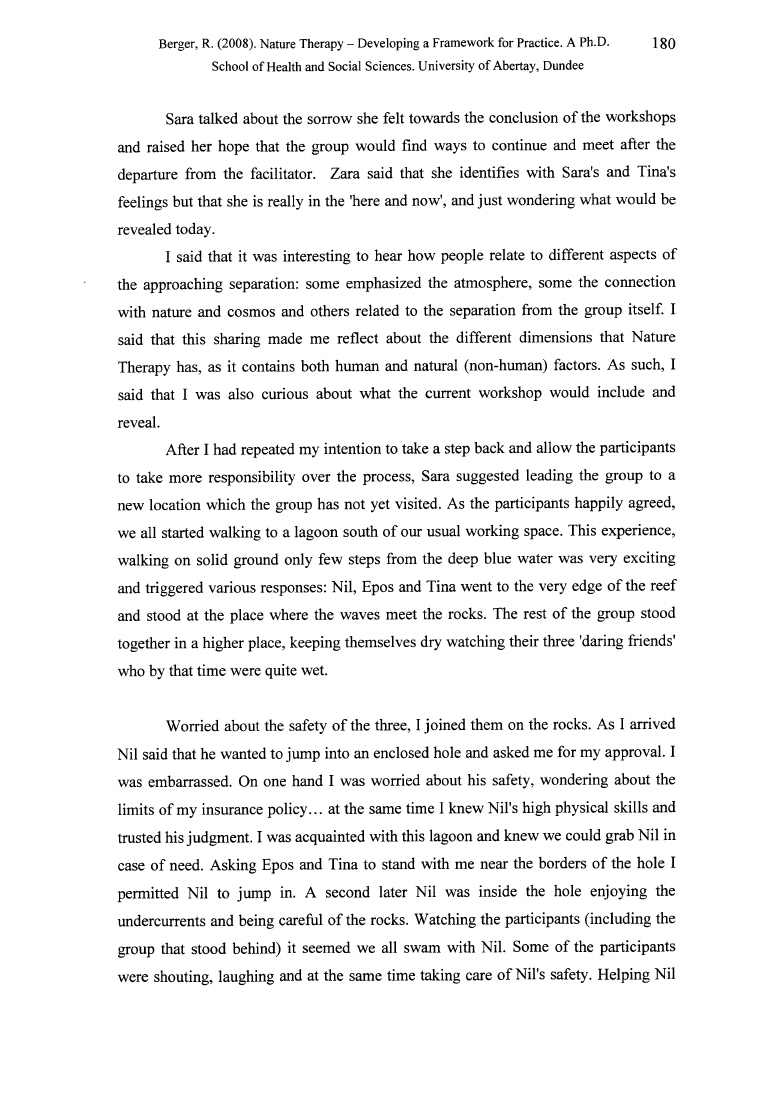
Berger, R. (2008). Nature Therapy - Developing a Framework for Practice. A Ph.D.
180
School of Health and Social Sciences. University of Abertay, Dundee
Sara talked about the sorrow she felt towards the conclusion of the workshops
and raised her hope that the group would find ways to continue and meet after the
departure from the facilitator. Zara said that she identifies with Sara's and Tina's
feelings but that she is really in the 'here and now', and just wondering what would be
revealed today.
I said that it was interesting to hear how people relate to different aspects of
the approaching separation: some emphasized the atmosphere, some the connection
with nature and cosmos and others related to the separation from the group itself. I
said that this sharing made me reflect about the different dimensions that Nature
Therapy has, as it contains both human and natural (non-human) factors. As such, I
said that I was also curious about what the current workshop would include and
reveal.
After I had repeated my intention to take a step back and allow the participants
to take more responsibility over the process, Sara suggested leading the group to a
new location which the group has not yet visited. As the participants happily agreed,
we all started walking to a lagoon south of our usual working space. This experience,
walking on solid ground only few steps from the deep blue water was very exciting
and triggered various responses: Nil, Epos and Tina went to the very edge o f the reef
and stood at the place where the waves meet the rocks. The rest of the group stood
together in a higher place, keeping themselves dry watching their three 'daring friends'
who by that time were quite wet.
Worried about the safety of the three, I joined them on the rocks. As I arrived
Nil said that he wanted to jump into an enclosed hole and asked me for my approval. I
was embarrassed. On one hand I was worried about his safety, wondering about the
limits of my insurance policy... at the same time I knew Nil's high physical skills and
trusted his judgment. I was acquainted with this lagoon and knew we could grab Nil in
case of need. Asking Epos and Tina to stand with me near the borders of the hole I
permitted Nil to jump in. A second later Nil was inside the hole enjoying the
undercurrents and being careful of the rocks. Watching the participants (including the
group that stood behind) it seemed we all swam with Nil. Some of the participants
were shouting, laughing and at the same time taking care o f Nil's safety. Helping Nil
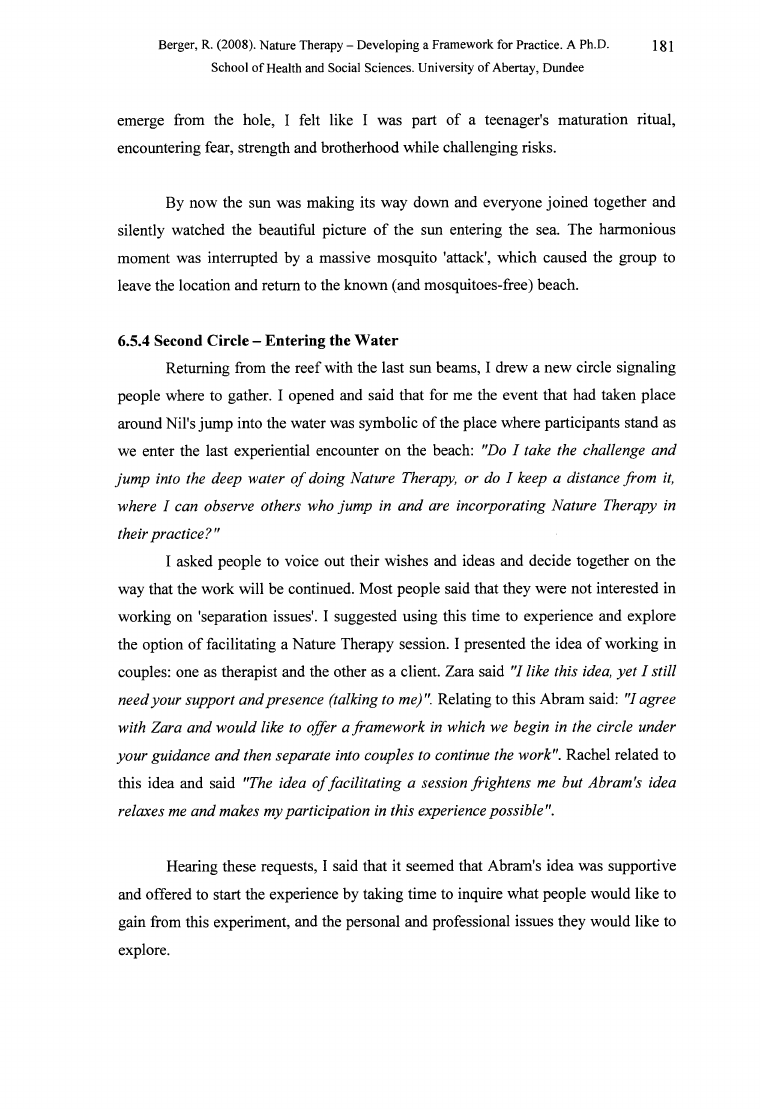
Berger, R. (2008). Nature Therapy - Developing a Framework for Practice. A Ph.D.
181
School of Health and Social Sciences. University of Abertay, Dundee
emerge from the hole, I felt like I was part of a teenager's maturation ritual,
encountering fear, strength and brotherhood while challenging risks.
By now the sun was making its way down and everyone joined together and
silently watched the beautiful picture o f the sun entering the sea. The harmonious
moment was interrupted by a massive mosquito 'attack', which caused the group to
leave the location and return to the known (and mosquitoes-free) beach.
6.5.4 Second Circle - Entering the Water
Returning from the reef with the last sun beams, I drew a new circle signaling
people where to gather. I opened and said that for me the event that had taken place
around Nil's jump into the water was symbolic of the place where participants stand as
we enter the last experiential encounter on the beach: "Do I take the ch a llen g e a n d
ju m p in to th e d e e p w a te r o f d o in g N a tu re T h era p y, o r d o I k e e p a d ista n c e f r o m it,
w h ere I can o b se rv e o th ers w ho ju m p in a n d are in co rp o ra tin g N atu re T h erapy in
their p ra ctice? "
I asked people to voice out their wishes and ideas and decide together on the
way that the work will be continued. Most people said that they were not interested in
working on 'separation issues'. I suggested using this time to experience and explore
the option of facilitating a Nature Therapy session. I presented the idea of working in
couples: one as therapist and the other as a client. Zara said "I like th is idea, y e t I s till
n e e d y o u r s u p p o r t a n d p r e s e n c e (ta lk in g to m e)". Relating to this Abram said: "I a g r e e
w ith Z a ra a n d w o u ld like to offer a fra m e w o rk in w h ich w e b egin in the circle u n der
y o u r g u id a n c e a n d th en s e p a r a te in to c o u p le s to co n tin u e th e w ork" . Rachel related to
this idea and said "The id e a o f fa c ilita tin g a se ssio n fr ig h te n s m e b u t A b ra m 's id e a
rela x es m e a n d m akes m y p a rtic ip a tio n in th is experien ce p o ssib le" .
Hearing these requests, I said that it seemed that Abram's idea was supportive
and offered to start the experience by taking time to inquire what people would like to
gain from this experiment, and the personal and professional issues they would like to
explore.
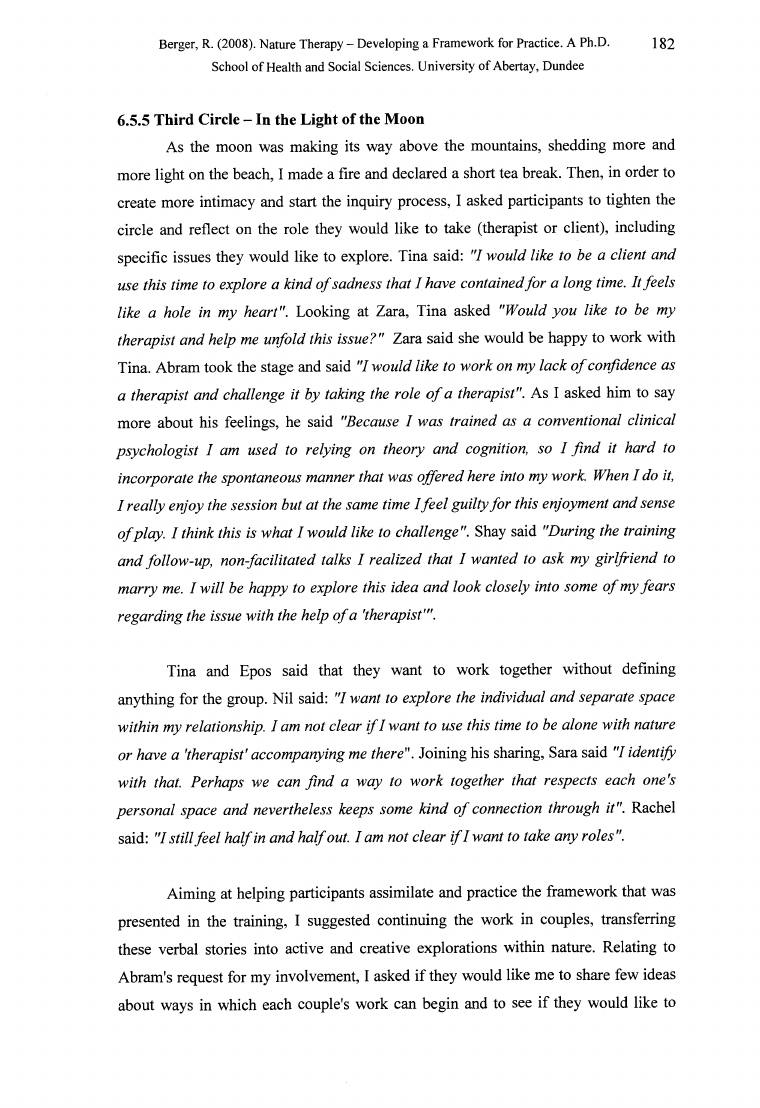
Berger, R. (2008). Nature Therapy - Developing a Framework for Practice. A Ph.D.
182
School of Health and Social Sciences. University of Abertay, Dundee
6.5.5 Third Circle - In the Light of the Moon
As the moon was making its way above the mountains, shedding more and
more light on the beach, I made a fire and declared a short tea break. Then, in order to
create more intimacy and start the inquiry process, I asked participants to tighten the
circle and reflect on the role they would like to take (therapist or client), including
specific issues they would like to explore. Tina said: "I w o u ld lik e to b e a c lie n t a n d
use this tim e to explore a kin d o f sad n ess th at I h ave co n ta in ed f o r a lo n g tim e. It fe e ls
like a hole in m y heart". Looking at Zara, Tina asked "W ould y o u like to be m y
th e ra p ist a n d h elp m e u n fold th is issu e?" Zara said she would be happy to work with
Tina. Abram took the stage and said "I w o u ld lik e to w o r k on m y la c k o f co n fid en ce a s
a th e r a p is t a n d c h a lle n g e it b y ta k in g th e r o le o f a th era p ist" . As I asked him to say
more about his feelings, he said "B ecause I w a s tra in e d a s a c o n v e n tio n a l c lin ic a l
p sy ch o lo g ist I am u sed to relyin g on th eory a n d cognition, so I fin d it h a rd to
in c o r p o r a te th e s p o n ta n e o u s m a n n e r th a t w a s o f f e r e d h e re in to m y w o rk . W hen I d o it,
I rea lly en joy the session bu t a t the sam e tim e I f e e l g u ilty f o r this en joym en t a n d sense
o f p la y . I th in k th is is w h a t I w o u ld like to ch a llen g e" . Shay said " D u ring th e tra in in g
a n d fo llo w -u p , n on -facilitated talks I rea lized th at I w a n ted to a sk m y girlfrien d to
m a rry me. I w ill be h a ppy to explore this id ea a n d lo o k clo sely into som e o f m y fe a rs
re g a rd in g the issue w ith the help o f a 'therapist'".
Tina and Epos said that they want to work together without defining
anything for the group. Nil said: "I w a n t to e x p lo r e th e in d iv id u a l a n d s e p a r a te s p a c e
w ithin m y relationship. I a m n ot clear i f I w an t to use this tim e to be alone w ith nature
o r h a ve a 'th erapist' a c c o m p a n y in g m e th ere" . Joining his sharing, Sara said "I id en tify
w ith that. P erh a p s w e can f in d a w a y to w o rk to g eth er th at re sp e c ts each one's
p e r s o n a l sp a c e a n d n e v e rth e less k eep s so m e k in d o f co n n ectio n th ro u g h it". Rachel
said: "I s till f e e l h a lf in a n d h a lf out. I a m n o t c le a r i f I w a n t to ta k e a n y ro les" .
Aiming at helping participants assimilate and practice the framework that was
presented in the training, I suggested continuing the work in couples, transferring
these verbal stories into active and creative explorations within nature. Relating to
Abram's request for my involvement, I asked if they would like me to share few ideas
about ways in which each couple's work can begin and to see if they would like to
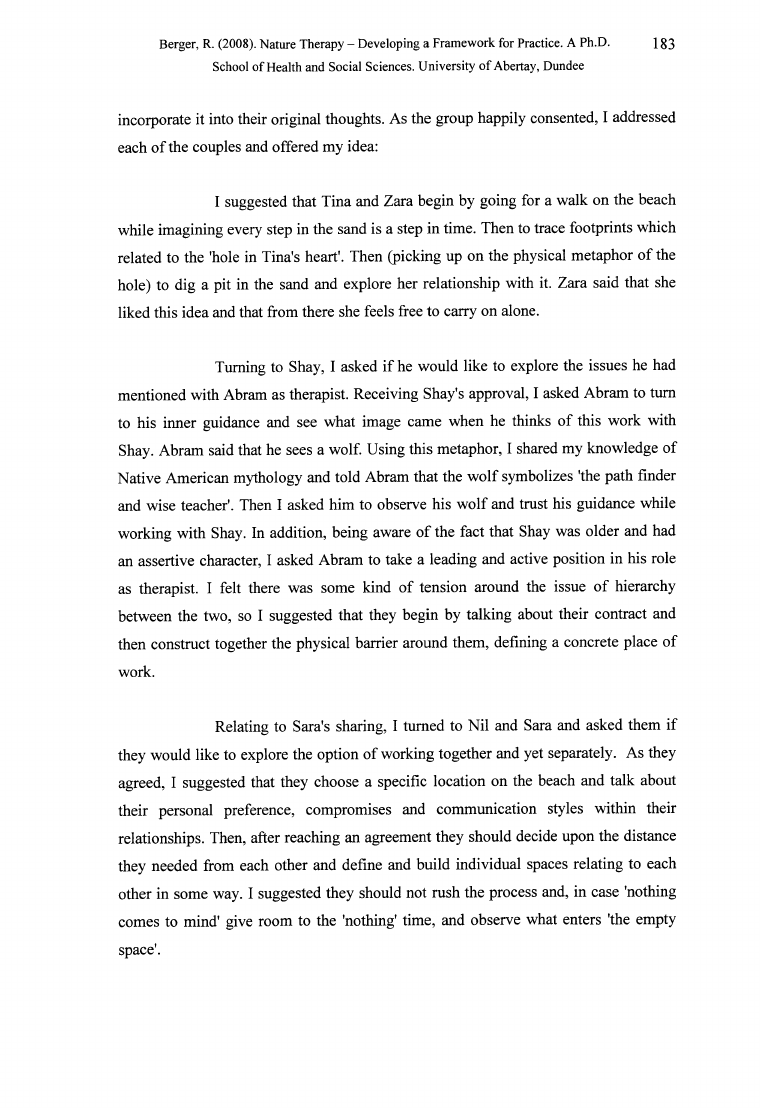
Berger, R. (2008). Nature Therapy - Developing a Framework for Practice. A Ph.D.
183
School of Health and Social Sciences. University of Abertay, Dundee
incorporate it into their original thoughts. As the group happily consented, I addressed
each o f the couples and offered my idea:
I suggested that Tina and Zara begin by going for a walk on the beach
while imagining every step in the sand is a step in time. Then to trace footprints which
related to the 'hole in Tina's heart'. Then (picking up on the physical metaphor o f the
hole) to dig a pit in the sand and explore her relationship with it. Zara said that she
liked this idea and that from there she feels free to carry on alone.
Turning to Shay, I asked if he would like to explore the issues he had
mentioned with Abram as therapist. Receiving Shay's approval, I asked Abram to turn
to his inner guidance and see what image came when he thinks of this work with
Shay. Abram said that he sees a wolf. Using this metaphor, I shared my knowledge of
Native American mythology and told Abram that the w olf symbolizes 'the path finder
and wise teacher'. Then I asked him to observe his wolf and trust his guidance while
working with Shay. In addition, being aware o f the fact that Shay was older and had
an assertive character, I asked Abram to take a leading and active position in his role
as therapist. I felt there was some kind of tension around the issue o f hierarchy
between the two, so I suggested that they begin by talking about their contract and
then construct together the physical barrier around them, defining a concrete place of
work.
Relating to Sara's sharing, I turned to Nil and Sara and asked them if
they would like to explore the option of working together and yet separately. As they
agreed, I suggested that they choose a specific location on the beach and talk about
their personal preference, compromises and communication styles within their
relationships. Then, after reaching an agreement they should decide upon the distance
they needed from each other and define and build individual spaces relating to each
other in some way. I suggested they should not rush the process and, in case 'nothing
comes to mind' give room to the 'nothing' time, and observe what enters 'the empty
space'.
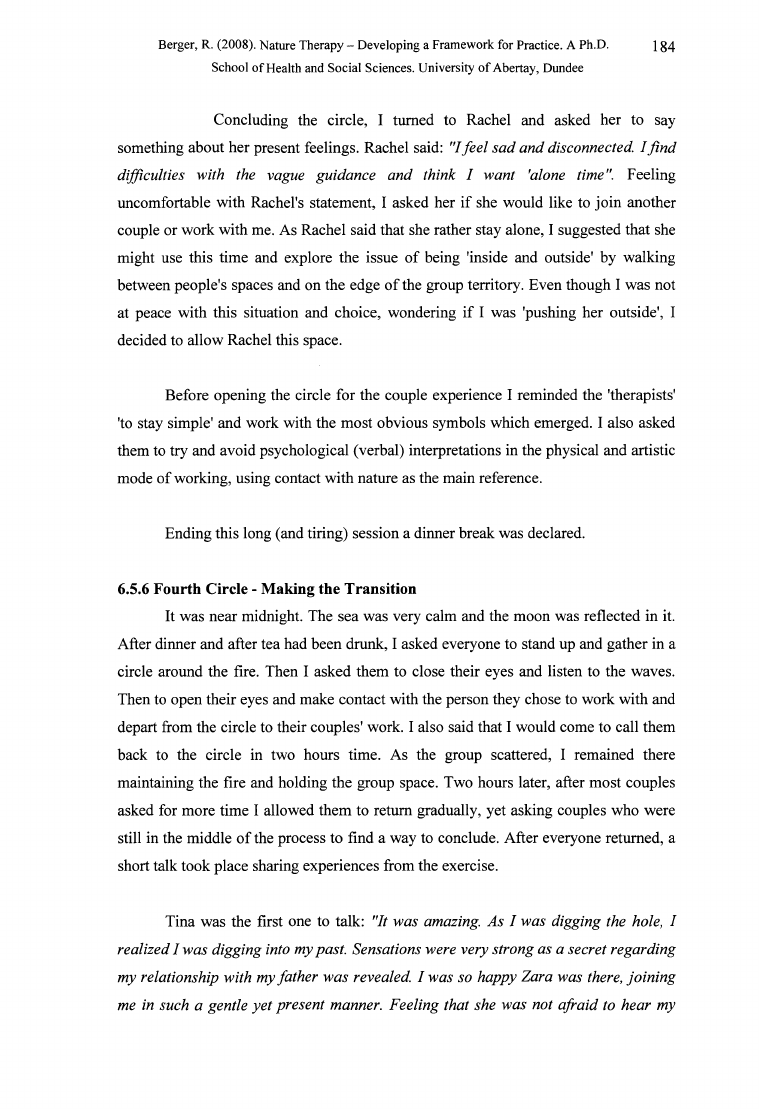
Berger, R. (2008). Nature Therapy - Developing a Framework for Practice. A Ph.D.
184
School of Health and Social Sciences. University of Abertay, Dundee
Concluding the circle, I turned to Rachel and asked her to say
something about her present feelings. Rachel said: "If e e l s a d a n d d isc o n n e c te d . I f i n d
d ifficu lties w ith the vagu e g u id a n c e a n d thin k I w a n t 'alone time". Feeling
uncomfortable with Rachel's statement, I asked her if she would like to join another
couple or work with me. As Rachel said that she rather stay alone, I suggested that she
might use this time and explore the issue of being 'inside and outside' by walking
between people's spaces and on the edge of the group territory. Even though I was not
at peace with this situation and choice, wondering if I was 'pushing her outside', I
decided to allow Rachel this space.
Before opening the circle for the couple experience I reminded the 'therapists'
'to stay simple' and work with the most obvious symbols which emerged. I also asked
them to try and avoid psychological (verbal) interpretations in the physical and artistic
mode of working, using contact with nature as the main reference.
Ending this long (and tiring) session a dinner break was declared.
6.5.6 Fourth Circle - Making the Transition
It was near midnight. The sea was very calm and the moon was reflected in it.
After dinner and after tea had been drunk, I asked everyone to stand up and gather in a
circle around the fire. Then I asked them to close their eyes and listen to the waves.
Then to open their eyes and make contact with the person they chose to work with and
depart from the circle to their couples' work. I also said that I would come to call them
back to the circle in two hours time. As the group scattered, I remained there
maintaining the fire and holding the group space. Two hours later, after most couples
asked for more time I allowed them to return gradually, yet asking couples who were
still in the middle of the process to find a way to conclude. After everyone returned, a
short talk took place sharing experiences from the exercise.
Tina was the first one to talk: "It w a s am azin g. A s I w a s d ig g in g th e hole, I
rea lized I w a s d ig g in g into m y p a st. S ensations w ere very stro n g a s a se cre t reg a rd in g
m y relatio n sh ip w ith m y fa th e r w a s revealed. I w a s so h a ppy Z ara w a s there, jo in in g
m e in such a g en tle y e t p re se n t m anner. F eelin g th a t she w a s n ot a fra id to h ea r m y
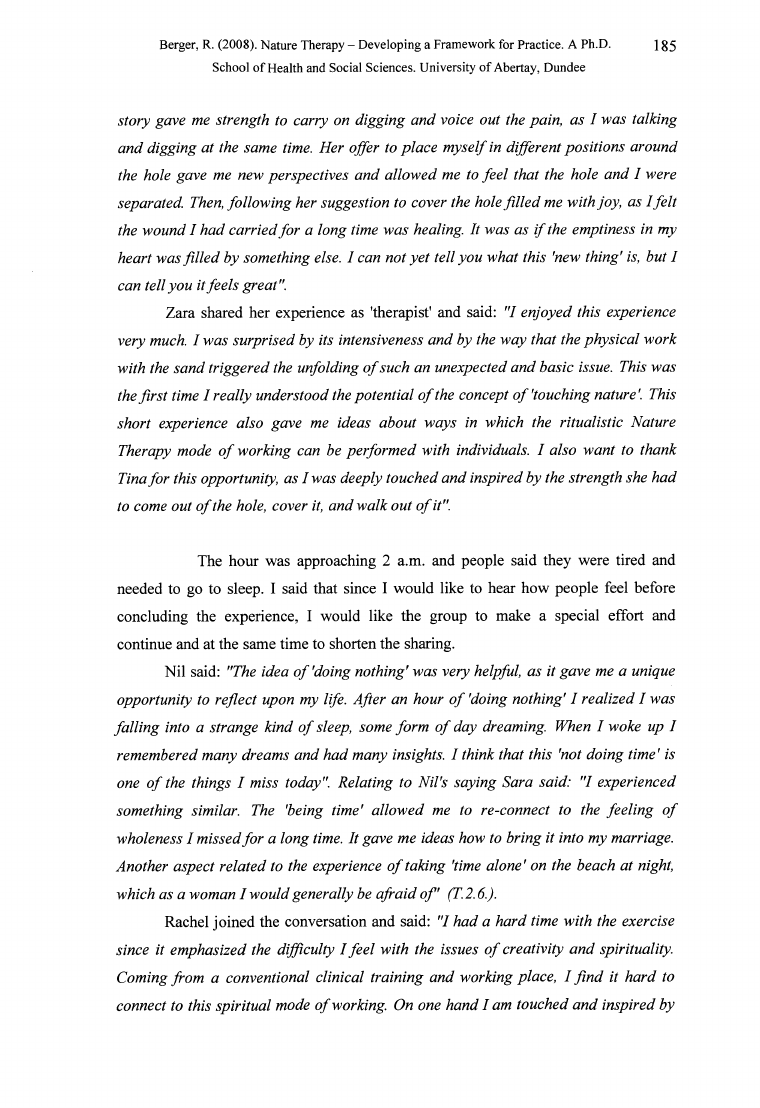
Berger, R. (2008). Nature Therapy - Developing a Framework for Practice. A Ph.D.
185
School of Health and Social Sciences. University of Abertay, Dundee
sto ry g a ve m e stren gth to carry on d ig g in g a n d voice out the pain , as I w as talking
a n d d ig g in g a t the sa m e tim e. H er offer to p la c e m y se lf in differen t p o s itio n s a ro u n d
the hole g a ve m e new p e rsp e c tiv e s a n d a llo w e d m e to fe e l th at the hole a n d I w ere
separated. Then, fo llo w in g her su ggestion to cover the hole fille d m e w ith jo y , as I fe lt
the w o u n d I h a d c a rrie d f o r a lo n g tim e w a s healing. It w a s a s i f the em p tin ess in m y
h e a rt w a s f ille d b y so m e th in g else. I can n o t y e t te ll y o u w h a t th is 'new th in g' is, b u t I
can tell yo u itfe e ls great".
Zara shared her experience as 'therapist' and said: "I e n jo y e d th is e x p e rie n c e
very much. I w a s su rp rised by its intensiven ess a n d by the w a y th at the p h y sic a l w o rk
w ith the sa n d trig g e red the unfolding o f such an u n expected a n d b a sic issue. This w a s
the fir s t tim e I re a lly u n d ersto o d the p o te n tia l o f the con cep t o f'to u c h in g nature'. This
sh o rt experien ce a lso g a v e m e id ea s a b o u t w a y s in w h ich the ritu a listic N atu re
T herapy m ode o f w orkin g can be p e rfo rm ed w ith individuals. I a lso w an t to thank
Tina f o r this opportunity, as I w as d eep ly tou ch ed a n d in spired b y the stren gth she h a d
to c o m e o u t o f th e h o le, c o v e r it, a n d w a lk o u t o f it".
The hour was approaching 2 a.m. and people said they were tired and
needed to go to sleep. I said that since I would like to hear how people feel before
concluding the experience, I would like the group to make a special effort and
continue and at the same time to shorten the sharing.
Nil said: "The id e a o f 'd o in g n o th in g ' w a s v e r y h elp fu l, a s it g a v e m e a u n iq u e
o p p o rtu n ity to re fle c t upon m y life. A fter an h ou r o f 'doing n oth in g' I r e a liz e d I w a s
fa llin g into a stran ge kin d o f sleep, som e fo rm o f d a y dream ing. W hen I w oke up I
rem em b ered m an y d rea m s a n d h a d m any insights. I think th at this 'not d o in g tim e' is
o n e o f th e th in g s I m is s to d a y" . R e la tin g to N il's s a y in g S a r a s a id : "1 e x p e r ie n c e d
som eth in g sim ilar. The 'being tim e' a llo w e d m e to re-con n ect to the fe e lin g o f
w h olen ess I m issed f o r a lo n g tim e. It g a ve m e ideas how to b rin g it into m y m arriage.
A n oth er a sp e c t r e la te d to the experien ce o f ta kin g 'time a lo n e' on the beach a t night,
w hich as a w om an I w o u ld g en era lly be a fra id o f (T.2.6.).
Rachel joined the conversation and said: "I h a d a h a r d tim e w ith th e e x e rc ise
sin ce it em p h a sized the difficulty I fe e l w ith the issues o f crea tivity a n d spiritu ality.
C om ing fro m a conventional clinical train in g an d w orking place, I fin d it h ard to
connect to this sp iritu a l m ode o f working. O n one hand I am tou ch ed a n d in spired by
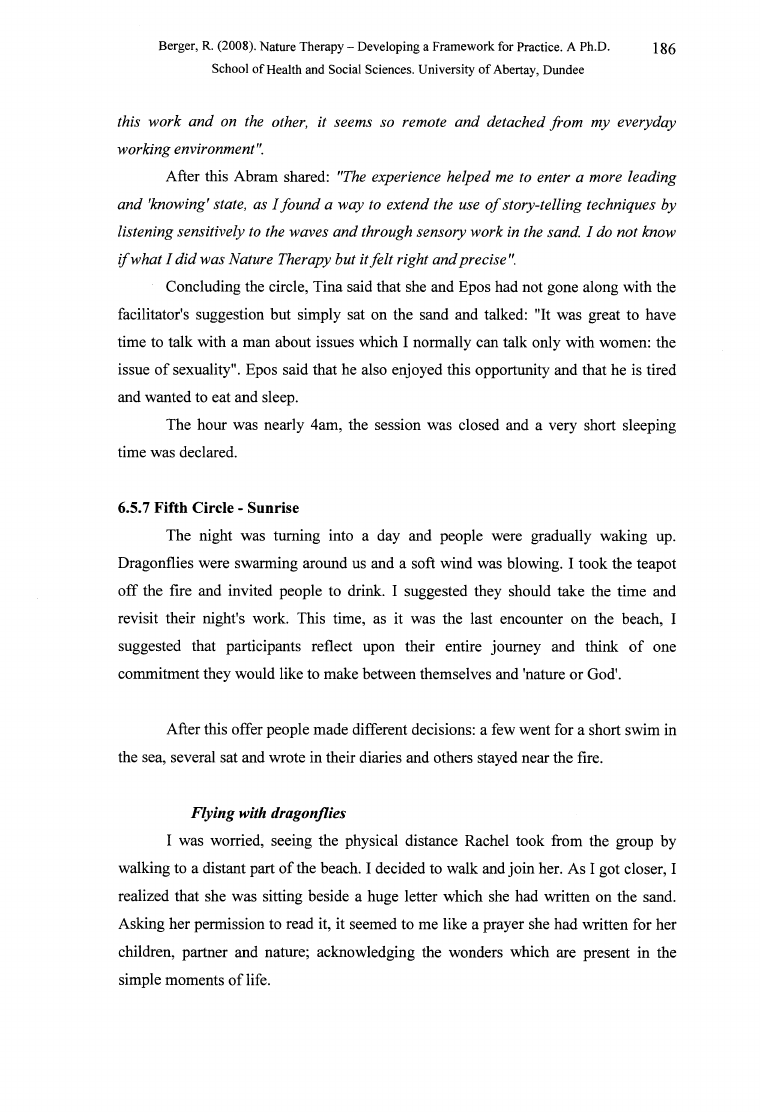
Berger, R. (2008). Nature Therapy - Developing a Framework for Practice. A Ph.D.
186
School of Health and Social Sciences. University of Abertay, Dundee
this w o rk a n d on the other, it seem s so rem ote a n d d eta ch ed fro m m y everyd a y
w orkin g environm ent".
After this Abram shared: "The ex p erien ce h e lp e d m e to e n te r a m o re le a d in g
a n d 'k n o w in g ' s ta te , a s I f o u n d a w a y to e x te n d th e u se o f s to r y - te llin g te c h n iq u e s b y
listen in g se n sitiv e ly to the w a v e s a n d through se n so ry w o rk in the sand. I do n o t know
i f w h a t I d i d w a s N a tu r e T h e r a p y b u t it f e l t r ig h t a n d p r e c i s e ".
Concluding the circle, Tina said that she and Epos had not gone along with the
facilitator's suggestion but simply sat on the sand and talked: "It was great to have
time to talk with a man about issues which I normally can talk only with women: the
issue o f sexuality". Epos said that he also enjoyed this opportunity and that he is tired
and wanted to eat and sleep.
The hour was nearly 4am, the session was closed and a very short sleeping
time was declared.
6.5.7 Fifth Circle - Sunrise
The night was turning into a day and people were gradually waking up.
Dragonflies were swarming around us and a soft wind was blowing. I took the teapot
off the fire and invited people to drink. I suggested they should take the time and
revisit their night's work. This time, as it was the last encounter on the beach, I
suggested that participants reflect upon their entire journey and think of one
commitment they would like to make between themselves and 'nature or God'.
After this offer people made different decisions: a few went for a short swim in
the sea, several sat and wrote in their diaries and others stayed near the fire.
Flying with dragonflies
I was worried, seeing the physical distance Rachel took from the group by
walking to a distant part of the beach. I decided to walk and join her. As I got closer, I
realized that she was sitting beside a huge letter which she had written on the sand.
Asking her permission to read it, it seemed to me like a prayer she had written for her
children, partner and nature; acknowledging the wonders which are present in the
simple moments o f life.
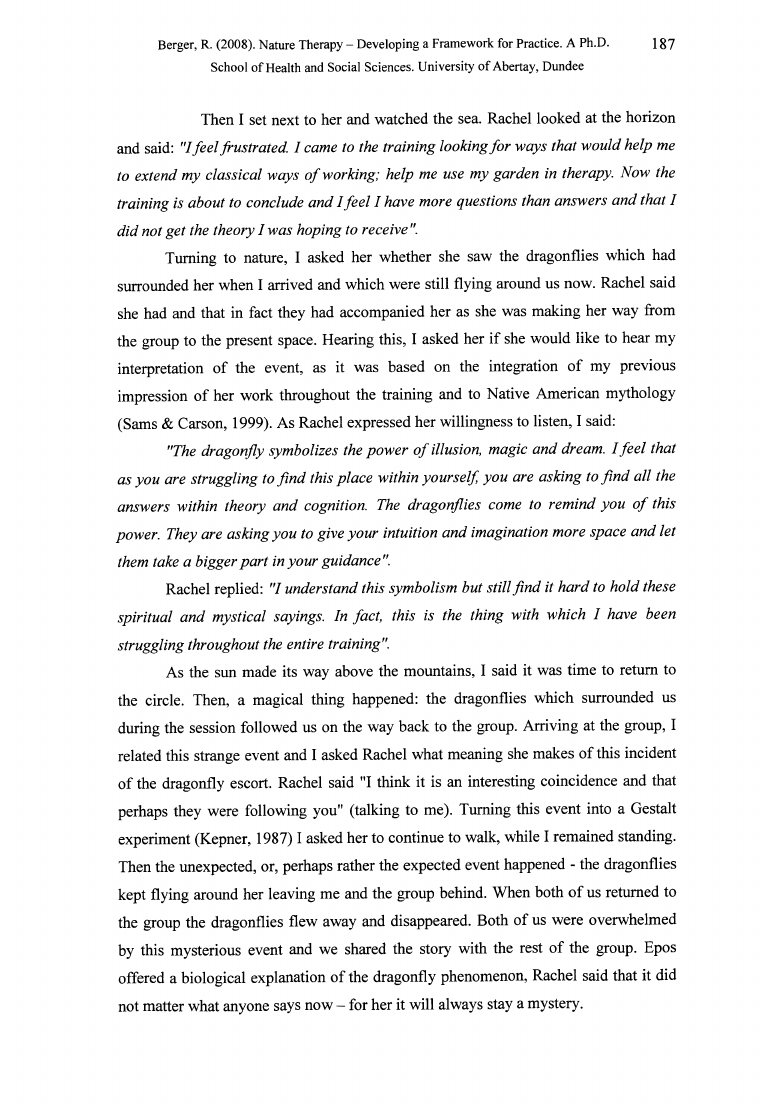
Berger, R. (2008). Nature Therapy - Developing a Framework for Practice. A Ph.D.
18 7
School of Health and Social Sciences. University of Abertay, Dundee
Then I set next to her and watched the sea. Rachel looked at the horizon
and said: "I f e e l f r u s tr a te d . I c a m e to th e tr a in in g lo o k in g f o r w a y s th a t w o u ld h e lp m e
to exten d m y c la ssic a l w a y s o f w orkin g; h elp m e use m y g a rd en in th erapy. N o w the
train in g is ab o u t to conclu de a n d I f e e l I have m ore qu estion s than an sw ers a n d th a t I
d i d n o t g e t th e th e o r y I w a s h o p in g to r e c e iv e ".
Turning to nature, I asked her whether she saw the dragonflies which had
surrounded her when I arrived and which were still flying around us now. Rachel said
she had and that in fact they had accompanied her as she was making her way from
the group to the present space. Hearing this, I asked her if she would like to hear my
interpretation of the event, as it was based on the integration o f my previous
impression of her work throughout the training and to Native American mythology
(Sams & Carson, 1999). As Rachel expressed her willingness to listen, I said:
"The d ra g o n fly sym b o lizes the p o w e r o f illusion, m a g ic a n d dream . I f e e l th a t
as yo u are stru gglin g to fin d this p la c e w ithin y o u r s e lf yo u are askin g to fin d a ll the
an sw ers w ithin th eory a n d cognition. The dragon flies com e to rem in d yo u o f this
pow er. They are asking yo u to give yo u r intuition an d im agination m ore space a n d let
th e m ta k e a b ig g e r p a r t in y o u r g u id a n c e ".
Rachel replied: "I u n d e r s ta n d th is s y m b o lis m b u t s till f in d it h a r d to h o ld th e se
spiritu al a n d m ystical sayings. In fa ct, this is the thing w ith w hich I have been
stru gglin g throughout the entire training".
As the sun made its way above the mountains, I said it was time to return to
the circle. Then, a magical thing happened: the dragonflies which surrounded us
during the session followed us on the way back to the group. Arriving at the group, I
related this strange event and I asked Rachel what meaning she makes of this incident
o f the dragonfly escort. Rachel said "I think it is an interesting coincidence and that
perhaps they were following you" (talking to me). Turning this event into a Gestalt
experiment (Kepner, 1987) I asked her to continue to walk, while I remained standing.
Then the unexpected, or, perhaps rather the expected event happened - the dragonflies
kept flying around her leaving me and the group behind. When both o f us returned to
the group the dragonflies flew away and disappeared. Both of us were overwhelmed
by this mysterious event and we shared the story with the rest of the group. Epos
offered a biological explanation of the dragonfly phenomenon, Rachel said that it did
not matter what anyone says now —for her it will always stay a mystery.
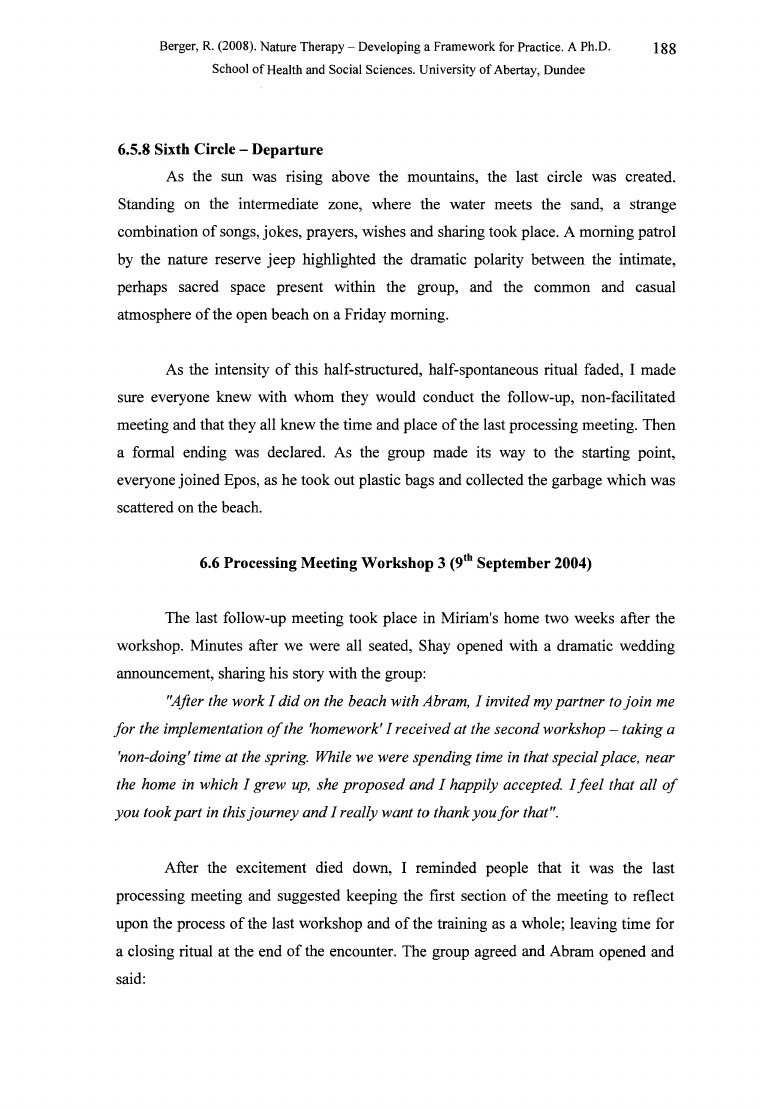
Berger, R. (2008). Nature Therapy - Developing a Framework for Practice. A Ph.D.
188
School of Health and Social Sciences. University of Abertay, Dundee
6.5.8 Sixth Circle - Departure
As the sun was rising above the mountains, the last circle was created.
Standing on the intermediate zone, where the water meets the sand, a strange
combination of songs, jokes, prayers, wishes and sharing took place. A morning patrol
by the nature reserve jeep highlighted the dramatic polarity between the intimate,
perhaps sacred space present within the group, and the common and casual
atmosphere of the open beach on a Friday morning.
As the intensity o f this half-structured, half-spontaneous ritual faded, I made
sure everyone knew with whom they would conduct the follow-up, non-facilitated
meeting and that they all knew the time and place of the last processing meeting. Then
a formal ending was declared. As the group made its way to the starting point,
everyone joined Epos, as he took out plastic bags and collected the garbage which was
scattered on the beach.
6.6 Processing Meeting Workshop 3 (9th September 2004)
The last follow-up meeting took place in Miriam's home two weeks after the
workshop. Minutes after we were all seated, Shay opened with a dramatic wedding
announcement, sharing his story with the group:
"After the w o rk I d id on the bea ch w ith A bram , I in v ited m y p a r tn e r to jo in m e
fo r the im plem entation o f the 'hom ew ork' I re ce ive d a t the seco n d w orkshop - takin g a
'non-doing' tim e a t the sprin g. W hile w e w ere sp e n d in g tim e in th at sp e c ia l p la c e , n ear
the hom e in w h ich I g re w up, sh e p r o p o s e d a n d I h a p p ily accepted. I f e e l th a t a ll o f
y o u to o k p a r t in th is jo u rn e y a n d I re a lly w a n t to thank y o u f o r that".
After the excitement died down, I reminded people that it was the last
processing meeting and suggested keeping the first section of the meeting to reflect
upon the process of the last workshop and of the training as a whole; leaving time for
a closing ritual at the end of the encounter. The group agreed and Abram opened and
said:
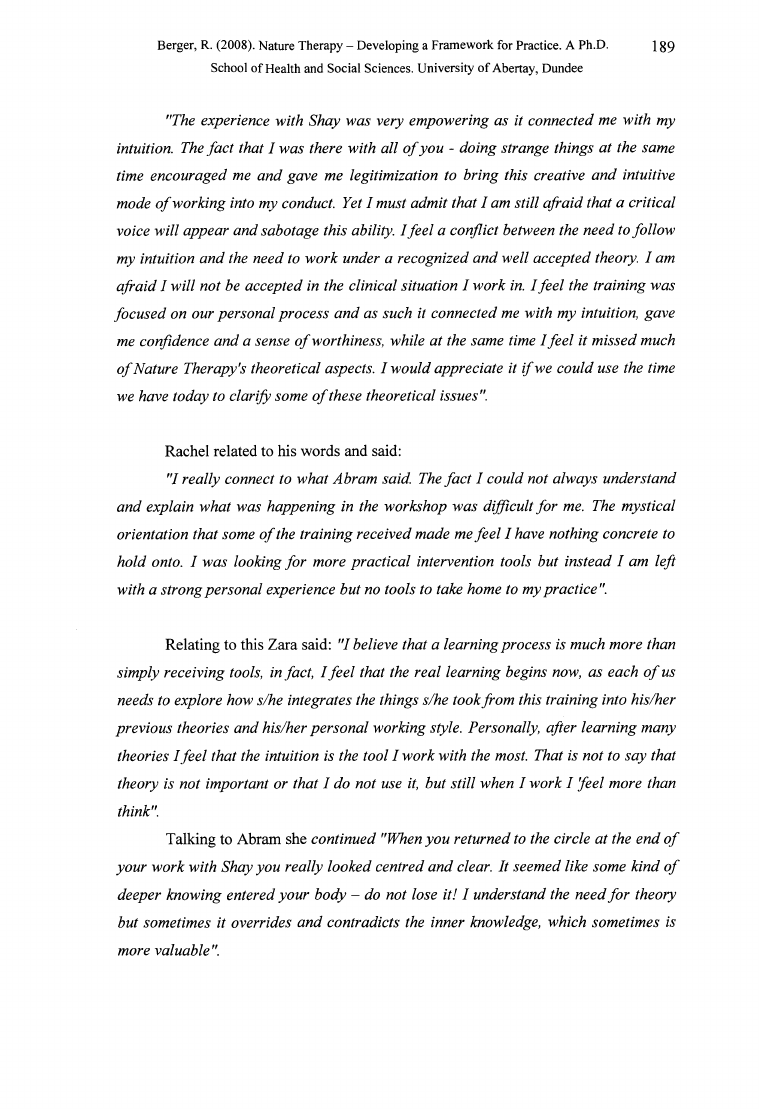
Berger, R. (2008). Nature Therapy - Developing a Framework for Practice. A Ph.D.
189
School of Health and Social Sciences. University of Abertay, Dundee
"The experience w ith Shay w a s very em p o w erin g as it co n n ected m e w ith m y
intuition. The f a c t th at I w a s th ere w ith a ll o f y o u - do in g stran ge things a t the sam e
tim e en cou raged m e a n d g a ve m e legitim ization to brin g this creative a n d intuitive
m ode o f w orkin g into m y conduct. Yet I m ust a d m it th at I am still a fra id th at a critica l
voice w ill a p p ea r a n d sab o ta g e this ability. I fe e l a con flict betw een the n eed to fo llo w
m y intuition a n d the n eed to w o rk under a reco g n ized a n d w ell a ccep ted theory. I am
a fr a id I w ill n o t b e a c c e p te d in th e c lin ic a l s itu a tio n I w o r k in. I f e e l th e tra in in g w a s
fo c u se d on ou r p e rso n a l p ro c e ss a n d as such it co n n ected m e w ith m y intuition, g a ve
m e confidence a n d a sense o f w orthiness, w h ile a t the sam e tim e I fe e l it m issed m uch
o f N ature Therapy's th eoretical aspects. 1 w o u ld a p p recia te it if w e co u ld use the tim e
w e have to d a y to clarify som e o f th ese th eoretical issues".
Rachel related to his words and said:
"I r e a lly c o n n e c t to w h a t A b r a m sa id . The f a c t I c o u ld n o t a lw a y s u n d e r s ta n d
a n d explain w h a t w as h a ppen in g in the w orksh op w a s difficult f o r me. The m ystica l
orientation th at som e o f the train in g received m ade m e fe e l I have nothing con crete to
h o ld onto. I w a s looking f o r m ore p ra c tic a l intervention to o ls but in stea d I am left
w ith a stron g p erso n a l experience but no tools to take hom e to m y practice".
Relating to this Zara said: "I b e lie v e th a t a le a r n in g p r o c e s s is m u ch m o r e th a n
sim p ly re ce ivin g tools, in fa ct, I f e e l th a t the re a l lea rn in g begin s now, a s each o f us
needs to explore how s/h e in tegrates the things s/he took fro m this train in g into his/her
p revio u s theories an d his/her p erso n a l w orking style. Personally, after learning m any
th eories I f e e l th at the intuition is the to o l I w o rk w ith the m ost. That is n ot to sa y that
th e o r y is n o t im p o r ta n t o r th a t I d o n o t u se it, b u t s ti l l w h e n I w o r k I f e e l m o r e th a n
think".
Talking to Abram she c o n tin u e d "When y o u r e tu r n e d to th e c irc le a t th e e n d o f
yo u r w o rk w ith Shay yo u rea lly lo o k ed cen tred a n d clear. It seem ed like som e kin d o f
d eep er kn ow in g en tered y o u r b o d y - do n ot lose it! I u n derstan d the n eed f o r th eory
but som etim es it overrid es a n d con tra d icts the inner know ledge, w hich so m etim es is
m ore valuable".
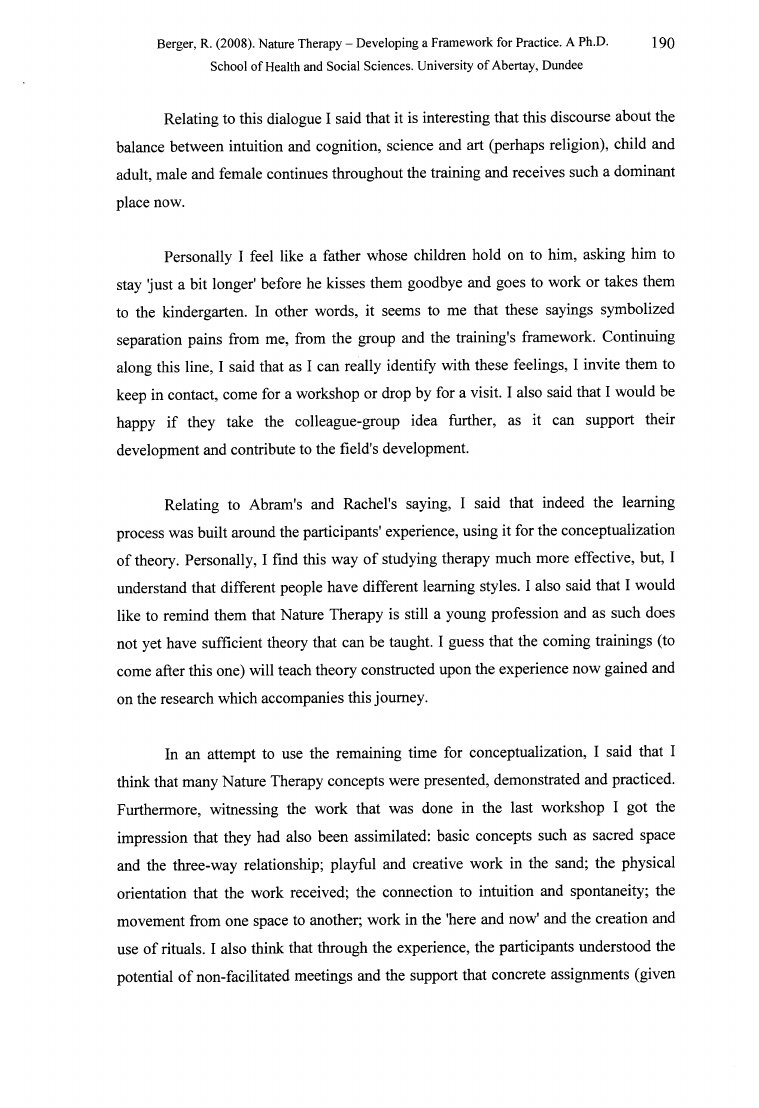
Berger, R. (2008). Nature Therapy - Developing a Framework for Practice. A Ph.D.
190
School of Health and Social Sciences. University of Abertay, Dundee
Relating to this dialogue I said that it is interesting that this discourse about the
balance between intuition and cognition, science and art (perhaps religion), child and
adult, male and female continues throughout the training and receives such a dominant
place now.
Personally I feel like a father whose children hold on to him, asking him to
stay 'just a bit longer' before he kisses them goodbye and goes to work or takes them
to the kindergarten. In other words, it seems to me that these sayings symbolized
separation pains from me, from the group and the training's framework. Continuing
along this line, I said that as I can really identify with these feelings, I invite them to
keep in contact, come for a workshop or drop by for a visit. I also said that I would be
happy if they take the colleague-group idea further, as it can support their
development and contribute to the field's development.
Relating to Abram's and Rachel's saying, I said that indeed the learning
process was built around the participants' experience, using it for the conceptualization
of theory. Personally, I find this way o f studying therapy much more effective, but, I
understand that different people have different learning styles. I also said that I would
like to remind them that Nature Therapy is still a young profession and as such does
not yet have sufficient theory that can be taught. I guess that the coming trainings (to
come after this one) will teach theory constructed upon the experience now gained and
on the research which accompanies this journey.
In an attempt to use the remaining time for conceptualization, I said that I
think that many Nature Therapy concepts were presented, demonstrated and practiced.
Furthermore, witnessing the work that was done in the last workshop I got the
impression that they had also been assimilated: basic concepts such as sacred space
and the three-way relationship; playful and creative work in the sand; the physical
orientation that the work received; the connection to intuition and spontaneity; the
movement from one space to another; work in the 'here and now' and the creation and
use of rituals. I also think that through the experience, the participants understood the
potential of non-facilitated meetings and the support that concrete assignments (given
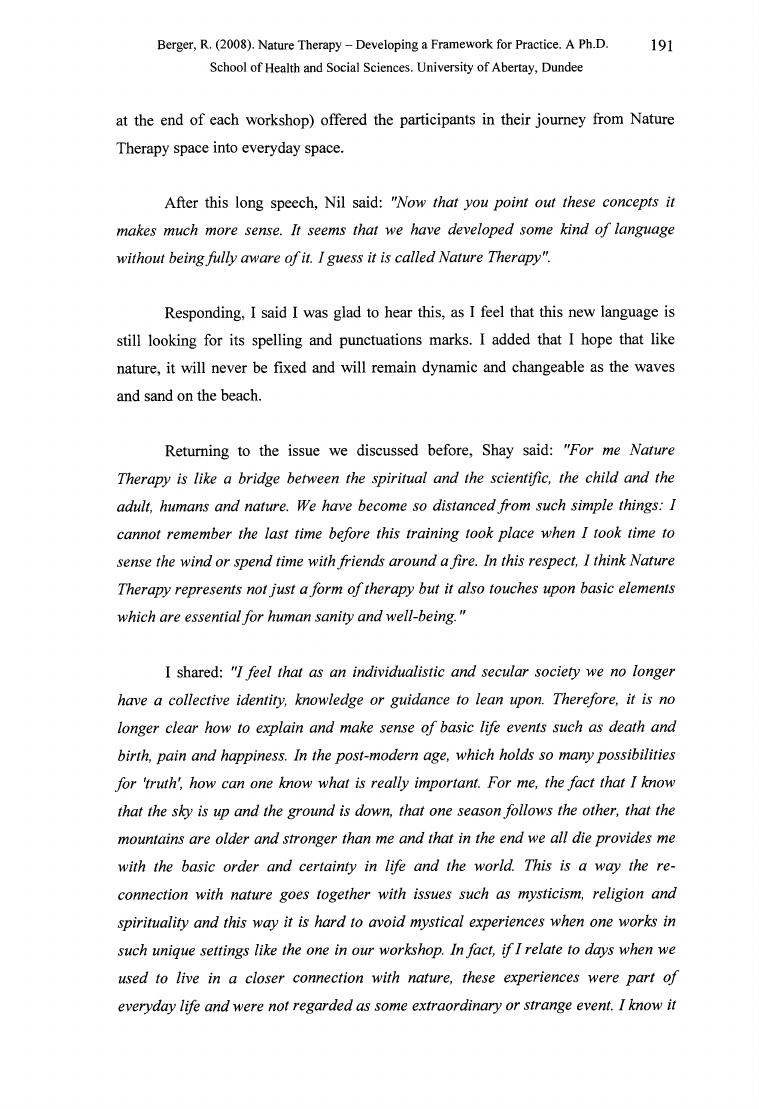
Berger, R. (2008). Nature Therapy - Developing a Framework for Practice. A Ph.D.
191
School of Health and Social Sciences. University of Abertay, Dundee
at the end of each workshop) offered the participants in their journey from Nature
Therapy space into everyday space.
After this long speech, Nil said: "N ow th a t y o u p o i n t o u t th e se c o n c e p ts it
m akes much m ore sense. It seem s that w e have developed som e kind o f language
w ith o u t b e in g f u lly a w a r e o f it. I g u e s s it is c a lle d N a tu re T herapy".
Responding, I said I was glad to hear this, as I feel that this new language is
still looking for its spelling and punctuations marks. I added that I hope that like
nature, it will never be fixed and will remain dynamic and changeable as the waves
and sand on the beach.
Returning to the issue we discussed before, Shay said: "For m e N a tu re
T herapy is like a bridge betw een the sp iritu a l a n d the scientific, the ch ild a n d the
adult, hum ans a n d nature. We have becom e so d ista n ced fro m such sim ple things: I
cannot rem em ber the la st tim e before this train in g took p la c e w hen I took tim e to
sense the w in d or sp en d tim e w ith frie n d s a rou n d a fire. In this respect, I think N ature
Therapy represents not ju s t a fo rm o f therapy but it also touches upon basic elem ents
w hich are essen tialfo r hum an san ity a n d w ell-b ein g ."
I shared: "I f e e l th a t a s a n in d iv id u a lis tic a n d s e c u la r s o c ie ty w e no lo n g e r
have a collective identity, know ledge o r gu idan ce to lean upon. Therefore, it is no
lon ger clea r how to explain a n d m ake sen se o f ba sic life even ts such as death a n d
birth, p a in a n d happiness. In the p o st-m o d ern age, w hich h olds so m any p o ssib ilitie s
f o r 'truth', h o w can on e kn ow w h a t is re a lly im p o rta n t. F o r me, the f a c t th a t I kn o w
th at the sky is up a n d the g ro u n d is dow n, th at one season fo llo w s the other, th at the
m ountains are o ld er a n d stro n g er than m e a n d th a t in the en d w e a ll die p r o v id e s m e
w ith the b a sic o rd er a n d certa in ty in life a n d the w orld. This is a w a y the re
connection w ith nature g o es togeth er w ith issues such as m ysticism , religion a n d
sp iritu a lity a n d th is w a y it is h a rd to a v o id m ystic a l exp erien ces w h en one w o rk s in
such unique settin g s like the one in ou r w orkshop. In fa ct, i f I rela te to d a ys w h en w e
u sed to live in a clo ser con n ection w ith nature, th ese exp erien ces w ere p a r t o f
everyd a y life a n d w ere n ot re g a rd e d as som e extraordin ary o r stran ge event. I know it
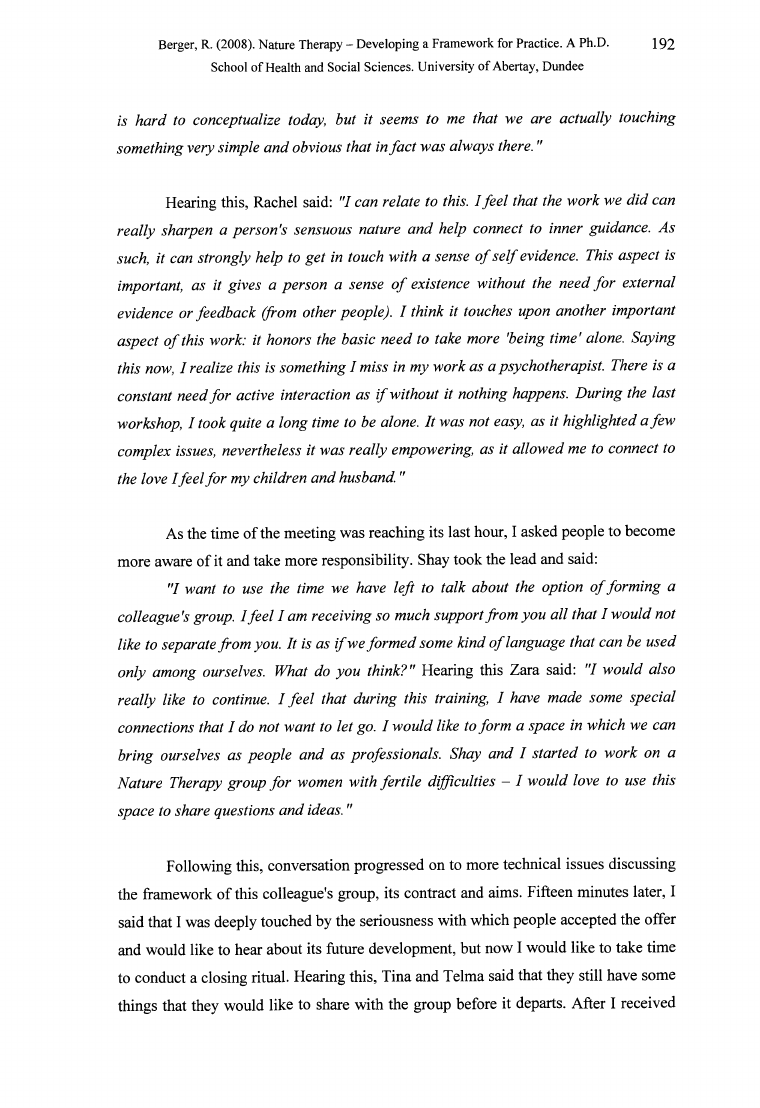
Berger, R. (2008). Nature Therapy - Developing a Framework for Practice. A Ph.D.
192
School of Health and Social Sciences. University of Abertay, Dundee
is h a rd to conceptualize today, but it seem s to m e that w e are actu ally touching
so m eth in g very sim p le a n d o b vio u s th a t in f a c t w a s a lw a ys th e re ."
Hearing this, Rachel said: "I c a n r e la te to this. I f e e l th a t th e w o r k w e d i d c a n
rea lly sharpen a person 's sensuous nature a n d help connect to inner guidance. A s
such, it can stro n g ly h elp to g e t in tou ch w ith a sen se o f s e lf eviden ce. This a sp e c t is
im portant, as it gives a p erso n a sense o f existence w ith ou t the n eed f o r external
evidence or feed b a ck (from other people). I think it touches upon another im portant
a sp e ct o f this w ork: it h onors the b a sic n eed to take m ore 'being tim e' alone. S ayin g
th is now, I rea lize this is som eth in g I m iss in m y w o rk a s a p sych o th era p ist. There is a
con stan t n eed fo r active interaction as i f w ith ou t it nothing happens. D u rin g the la st
w orkshop, I took quite a lon g tim e to be alone. It w as not easy, as it h igh ligh ted a fe w
com plex issues, n everth eless it w a s re a lly em pow ering, as it a llo w e d m e to con n ect to
the love I fe e l f o r m y children a n d h u sb a n d ."
As the time o f the meeting was reaching its last hour, I asked people to become
more aware o f it and take more responsibility. Shay took the lead and said:
"I w a n t to use th e tim e w e h a v e le ft to ta lk a b o u t th e o p tio n o f f o r m in g a
colleague's group. I fe e l I am receiving so m uch su pport fro m you all that I w ou ld not
like to separate fro m you. It is as i f w e fo rm e d som e kind o f language th at can be u sed
o n ly a m o n g o u rse lv e s. W h at d o y o u th in k ? " Hearing this Zara said: "I w o u ld a ls o
re a lly like to continue. I fe e l th at d u rin g this training, I have m ade som e sp ecia l
con n ection s th at I do n o t w a n t to let go. I w o u ld like to fo rm a sp a ce in w h ich w e can
brin g ourselves as p eo p le an d as profession als. Shay an d I sta rted to w ork on a
N ature T herapy grou p f o r w om en w ith fe rtile difficulties — I w o u ld love to use this
space to share questions an d id ea s."
Following this, conversation progressed on to more technical issues discussing
the framework of this colleague's group, its contract and aims. Fifteen minutes later, I
said that I was deeply touched by the seriousness with which people accepted the offer
and would like to hear about its future development, but now I would like to take time
to conduct a closing ritual. Hearing this, Tina and Telma said that they still have some
things that they would like to share with the group before it departs. After I received
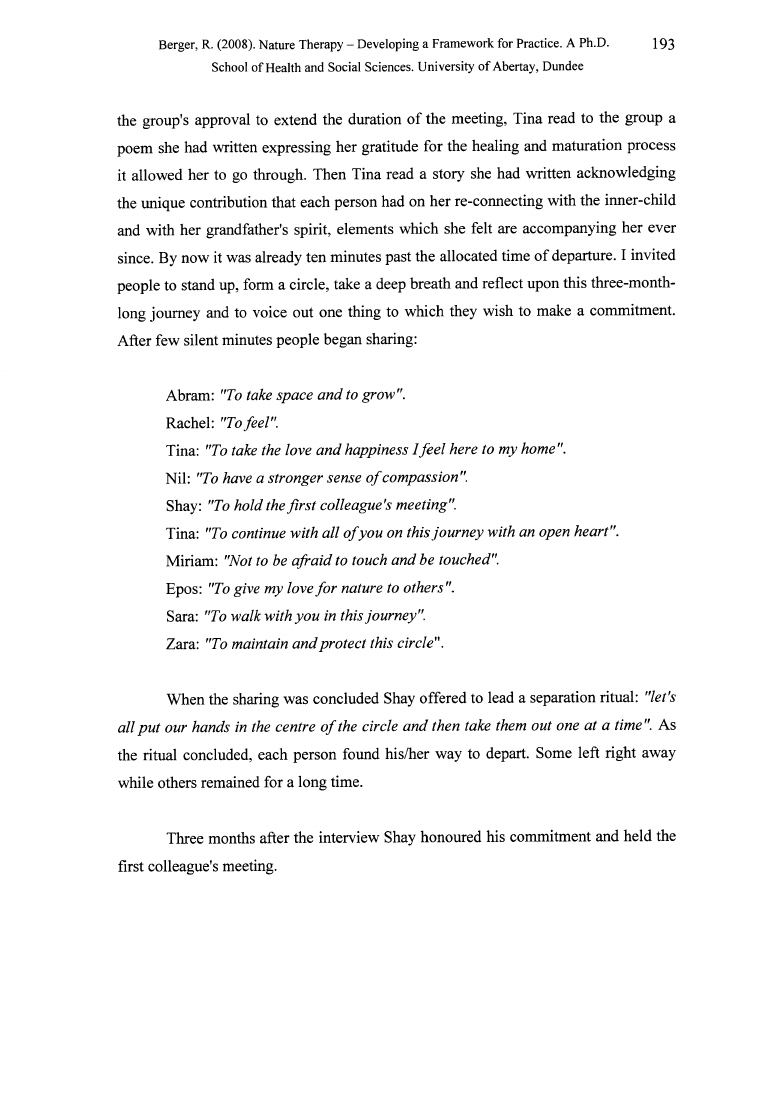
Berger, R. (2008). Nature Therapy - Developing a Framework for Practice. A Ph.D.
193
School of Health and Social Sciences. University of Abertay, Dundee
the group's approval to extend the duration of the meeting, Tina read to the group a
poem she had written expressing her gratitude for the healing and maturation process
it allowed her to go through. Then Tina read a story she had written acknowledging
the unique contribution that each person had on her re-connecting with the inner-child
and with her grandfather's spirit, elements which she felt are accompanying her ever
since. By now it was already ten minutes past the allocated time of departure. I invited
people to stand up, form a circle, take a deep breath and reflect upon this three-month
long journey and to voice out one thing to which they wish to make a commitment.
After few silent minutes people began sharing:
Abram: "To take sp a c e a n d to grow " .
Rachel: "To feel".
Tina: "To take th e lo v e a n d h a p p in e ss I f e e l h ere to m y hom e".
Nil: "To h ave a s tr o n g e r se n se o f com passion " .
Shay: "To h o ld th e f i r s t c o lle a g u e 's m eeting".
Tina: "To con tin u e w ith a ll o f y o u on th is jo u r n e y w ith an o p e n h eart" .
Miriam: "Not to b e a fr a id to tou ch a n d b e touched".
Epos: "To g ive m y lo v e f o r n atu re to others" .
Sara: "To w a lk w ith y o u in th is jo u rn ey" .
Zara: "To m a in ta in a n d p r o t e c t th is c ir c le ".
When the sharing was concluded Shay offered to lead a separation ritual: "let's
a ll p u t o u r h a n d s in th e c e n tr e o f th e c ir c le a n d th e n ta k e th em o u t o n e a t a tim e ". As
the ritual concluded, each person found his/her way to depart. Some left right away
while others remained for a long time.
Three months after the interview Shay honoured his commitment and held the
first colleague's meeting.
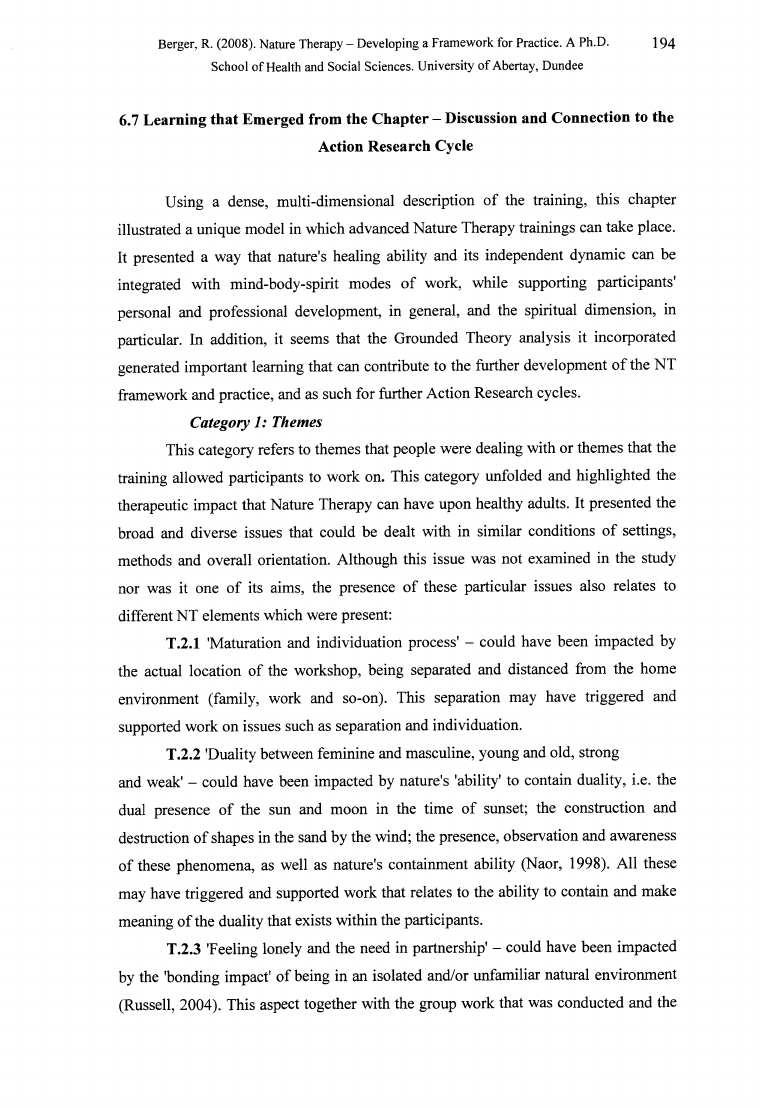
Berger, R. (2008). Nature Therapy - Developing a Framework for Practice. A Ph.D.
19 4
School of Health and Social Sciences. University of Abertay, Dundee
6.7 Learning that Emerged from the Chapter - Discussion and Connection to the
Action Research Cycle
Using a dense, multi-dimensional description of the training, this chapter
illustrated a unique model in which advanced Nature Therapy trainings can take place.
It presented a way that nature's healing ability and its independent dynamic can be
integrated with mind-body-spirit modes of work, while supporting participants'
personal and professional development, in general, and the spiritual dimension, in
particular. In addition, it seems that the Grounded Theory analysis it incorporated
generated important learning that can contribute to the further development o f the NT
framework and practice, and as such for further Action Research cycles.
Category 1: Themes
This category refers to themes that people were dealing with or themes that the
training allowed participants to work on. This category unfolded and highlighted the
therapeutic impact that Nature Therapy can have upon healthy adults. It presented the
broad and diverse issues that could be dealt with in similar conditions o f settings,
methods and overall orientation. Although this issue was not examined in the study
nor was it one o f its aims, the presence o f these particular issues also relates to
different NT elements which were present:
T.2.1 'Maturation and individuation process' - could have been impacted by
the actual location of the workshop, being separated and distanced from the home
environment (family, work and so-on). This separation may have triggered and
supported work on issues such as separation and individuation.
T.2.2 'Duality between feminine and masculine, young and old, strong
and weak' - could have been impacted by nature's 'ability' to contain duality, i.e. the
dual presence of the sun and moon in the time of sunset; the construction and
destruction o f shapes in the sand by the wind; the presence, observation and awareness
o f these phenomena, as well as nature's containment ability (Naor, 1998). All these
may have triggered and supported work that relates to the ability to contain and make
meaning o f the duality that exists within the participants.
T.2.3 'Feeling lonely and the need in partnership' - could have been impacted
by the 'bonding impact' of being in an isolated and/or unfamiliar natural environment
(Russell, 2004). This aspect together with the group work that was conducted and the
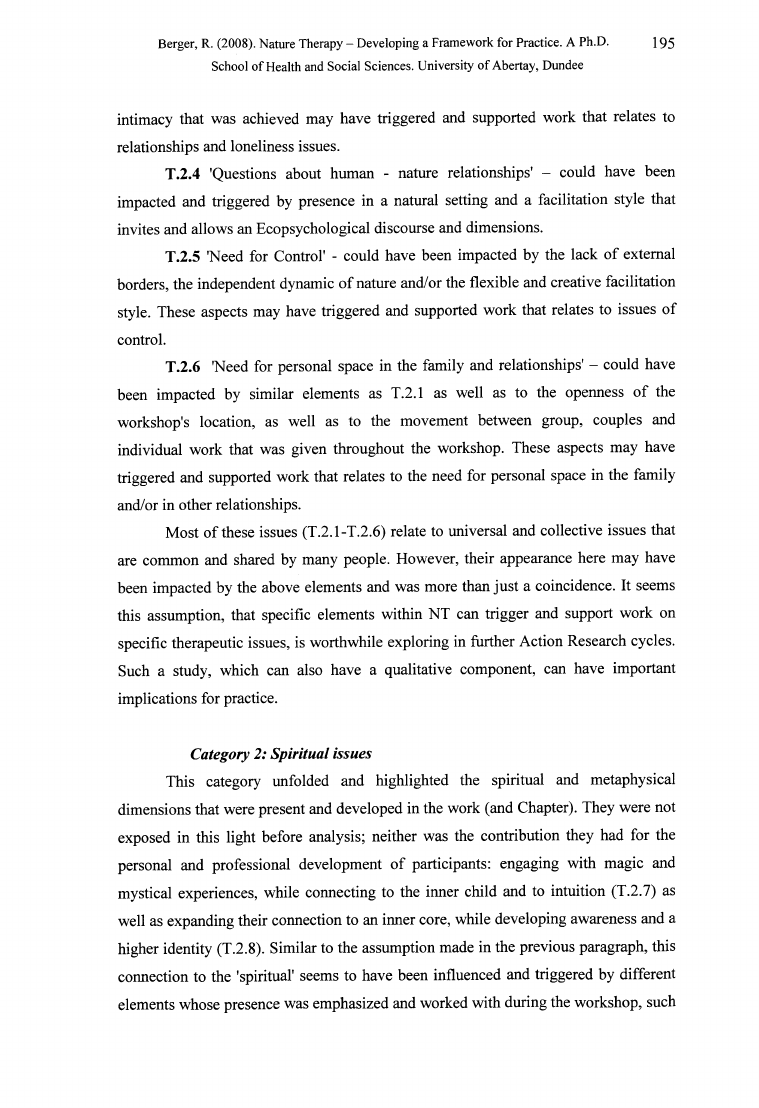
Berger, R. (2008). Nature Therapy - Developing a Framework for Practice. A Ph.D.
19 5
School of Health and Social Sciences. University of Abertay, Dundee
intimacy that was achieved may have triggered and supported work that relates to
relationships and loneliness issues.
T.2.4 'Questions about human - nature relationships' - could have been
impacted and triggered by presence in a natural setting and a facilitation style that
invites and allows an Ecopsychological discourse and dimensions.
T.2.5 'Need for Control' - could have been impacted by the lack o f external
borders, the independent dynamic o f nature and/or the flexible and creative facilitation
style. These aspects may have triggered and supported work that relates to issues o f
control.
T.2.6 'Need for personal space in the family and relationships' - could have
been impacted by similar elements as T.2.1 as well as to the openness o f the
workshop's location, as well as to the movement between group, couples and
individual work that was given throughout the workshop. These aspects may have
triggered and supported work that relates to the need for personal space in the family
and/or in other relationships.
Most of these issues (T.2.1-T.2.6) relate to universal and collective issues that
are common and shared by many people. However, their appearance here may have
been impacted by the above elements and was more than just a coincidence. It seems
this assumption, that specific elements within NT can trigger and support work on
specific therapeutic issues, is worthwhile exploring in further Action Research cycles.
Such a study, which can also have a qualitative component, can have important
implications for practice.
Category 2: Spiritual issues
This category unfolded and highlighted the spiritual and metaphysical
dimensions that were present and developed in the work (and Chapter). They were not
exposed in this light before analysis; neither was the contribution they had for the
personal and professional development of participants: engaging with magic and
mystical experiences, while connecting to the inner child and to intuition (T.2.7) as
well as expanding their connection to an inner core, while developing awareness and a
higher identity (T.2.8). Similar to the assumption made in the previous paragraph, this
connection to the 'spiritual' seems to have been influenced and triggered by different
elements whose presence was emphasized and worked with during the workshop, such
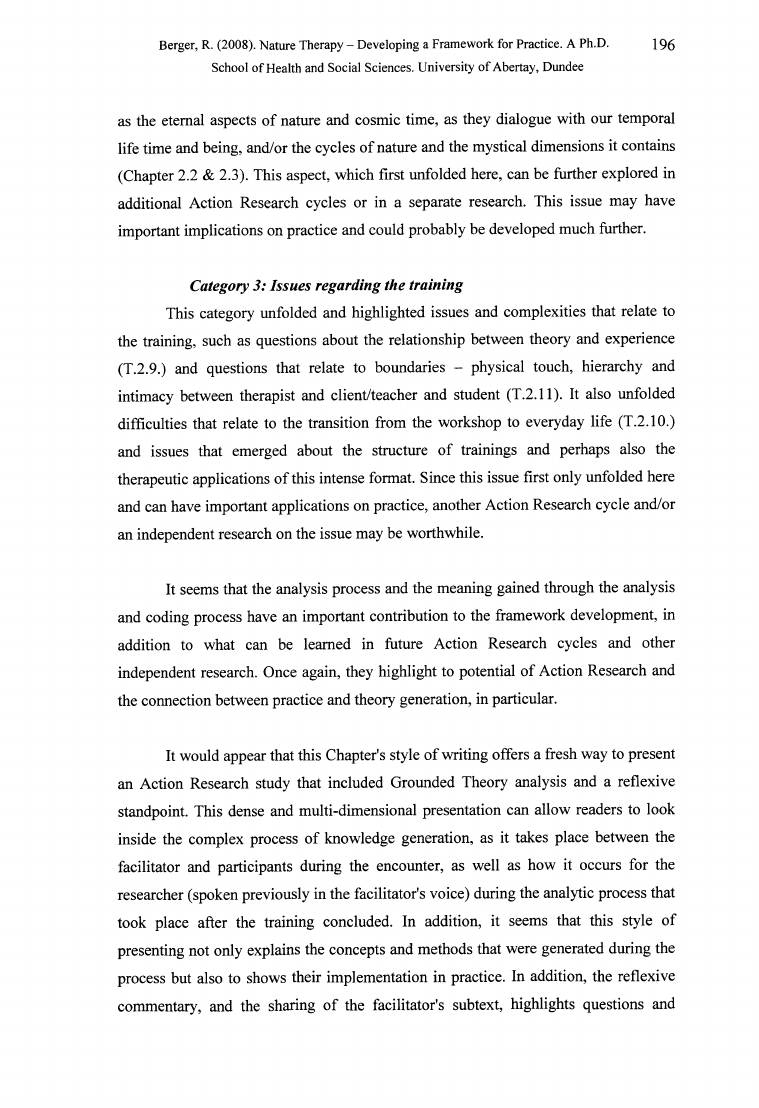
Berger, R. (2008). Nature Therapy - Developing a Framework for Practice. A Ph.D.
196
School of Health and Social Sciences. University of Abertay, Dundee
as the eternal aspects of nature and cosmic time, as they dialogue with our temporal
life time and being, and/or the cycles of nature and the mystical dimensions it contains
(Chapter 2.2 & 2.3). This aspect, which first unfolded here, can be further explored in
additional Action Research cycles or in a separate research. This issue may have
important implications on practice and could probably be developed much further.
Category 3: Issues regarding the training
This category unfolded and highlighted issues and complexities that relate to
the training, such as questions about the relationship between theory and experience
(T.2.9.) and questions that relate to boundaries - physical touch, hierarchy and
intimacy between therapist and client/teacher and student (T.2.11). It also unfolded
difficulties that relate to the transition from the workshop to everyday life (T.2.10.)
and issues that emerged about the structure of trainings and perhaps also the
therapeutic applications of this intense format. Since this issue first only unfolded here
and can have important applications on practice, another Action Research cycle and/or
an independent research on the issue may be worthwhile.
It seems that the analysis process and the meaning gained through the analysis
and coding process have an important contribution to the framework development, in
addition to what can be learned in future Action Research cycles and other
independent research. Once again, they highlight to potential of Action Research and
the connection between practice and theory generation, in particular.
It would appear that this Chapter's style o f writing offers a fresh way to present
an Action Research study that included Grounded Theory analysis and a reflexive
standpoint. This dense and multi-dimensional presentation can allow readers to look
inside the complex process of knowledge generation, as it takes place between the
facilitator and participants during the encounter, as well as how it occurs for the
researcher (spoken previously in the facilitator's voice) during the analytic process that
took place after the training concluded. In addition, it seems that this style of
presenting not only explains the concepts and methods that were generated during the
process but also to shows their implementation in practice. In addition, the reflexive
commentary, and the sharing o f the facilitator's subtext, highlights questions and
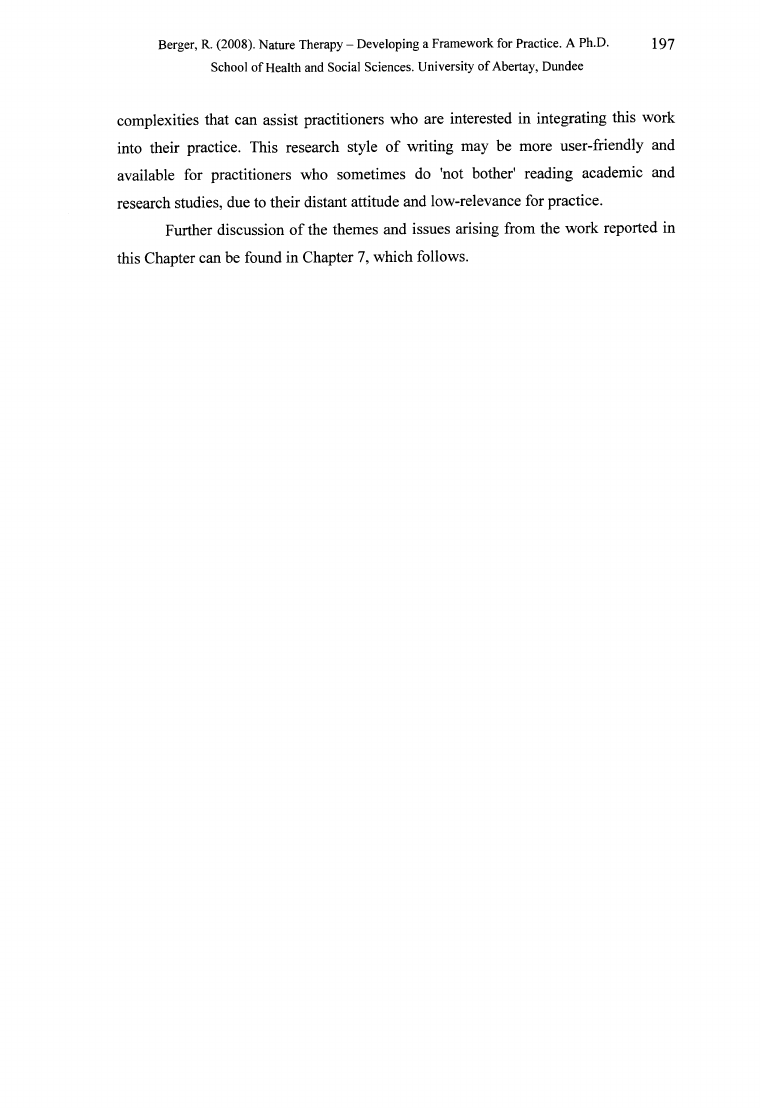
Berger, R. (2008). Nature Therapy - Developing a Framework for Practice. A Ph.D.
19 7
School of Health and Social Sciences. University of Abertay, Dundee
complexities that can assist practitioners who are interested in integrating this work
into their practice. This research style of writing may be more user-friendly and
available for practitioners who sometimes do 'not bother' reading academic and
research studies, due to their distant attitude and low-relevance for practice.
Further discussion o f the themes and issues arising from the work reported in
this Chapter can be found in Chapter 7, which follows.
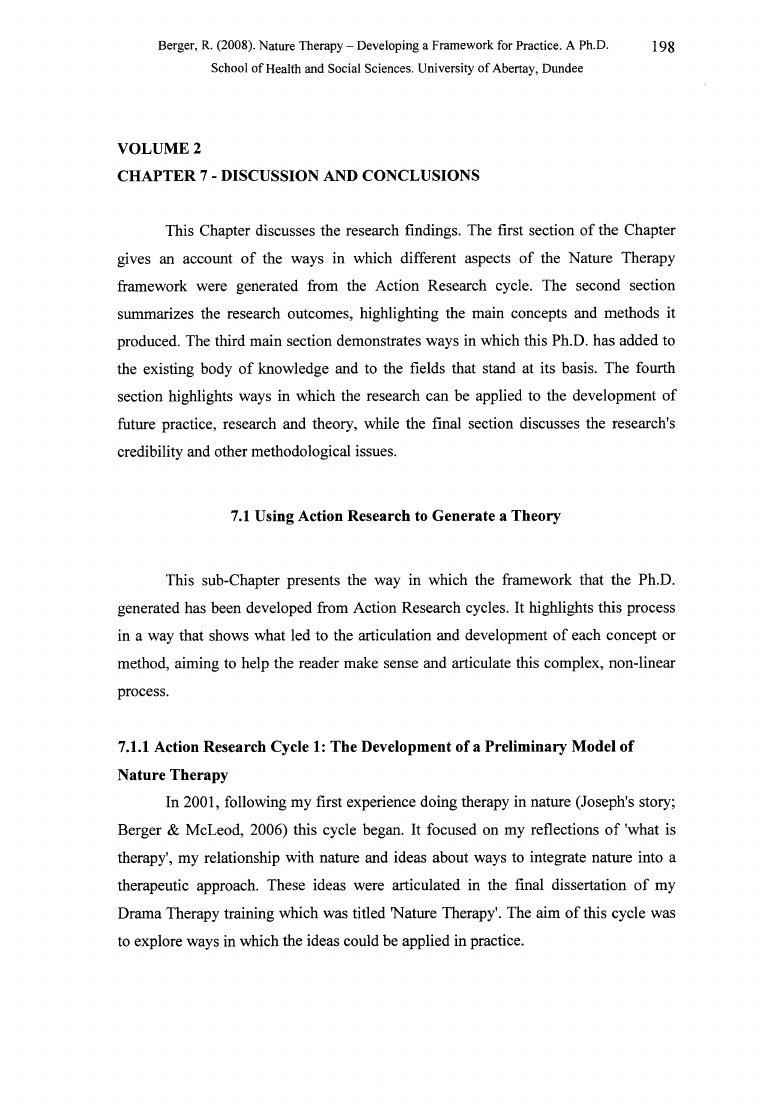
Berger, R. (2008). Nature Therapy - Developing a Framework for Practice. A Ph.D.
198
School of Health and Social Sciences. University of Abertay, Dundee
VOLUME 2
CHAPTER 7 - DISCUSSION AND CONCLUSIONS
This Chapter discusses the research findings. The first section of the Chapter
gives an account o f the ways in which different aspects of the Nature Therapy
framework were generated from the Action Research cycle. The second section
summarizes the research outcomes, highlighting the main concepts and methods it
produced. The third main section demonstrates ways in which this Ph.D. has added to
the existing body o f knowledge and to the fields that stand at its basis. The fourth
section highlights ways in which the research can be applied to the development of
future practice, research and theory, while the final section discusses the research's
credibility and other methodological issues.
7.1 Using Action Research to Generate a Theory
This sub-Chapter presents the way in which the framework that the Ph.D.
generated has been developed from Action Research cycles. It highlights this process
in a way that shows what led to the articulation and development of each concept or
method, aiming to help the reader make sense and articulate this complex, non-linear
process.
7.1.1 Action Research Cycle 1: The Development of a Preliminary Model of
Nature Therapy
In 2001, following my first experience doing therapy in nature (Joseph's story;
Berger & McLeod, 2006) this cycle began. It focused on my reflections o f 'what is
therapy', my relationship with nature and ideas about ways to integrate nature into a
therapeutic approach. These ideas were articulated in the final dissertation o f my
Drama Therapy training which was titled Nature Therapy'. The aim o f this cycle was
to explore ways in which the ideas could be applied in practice.
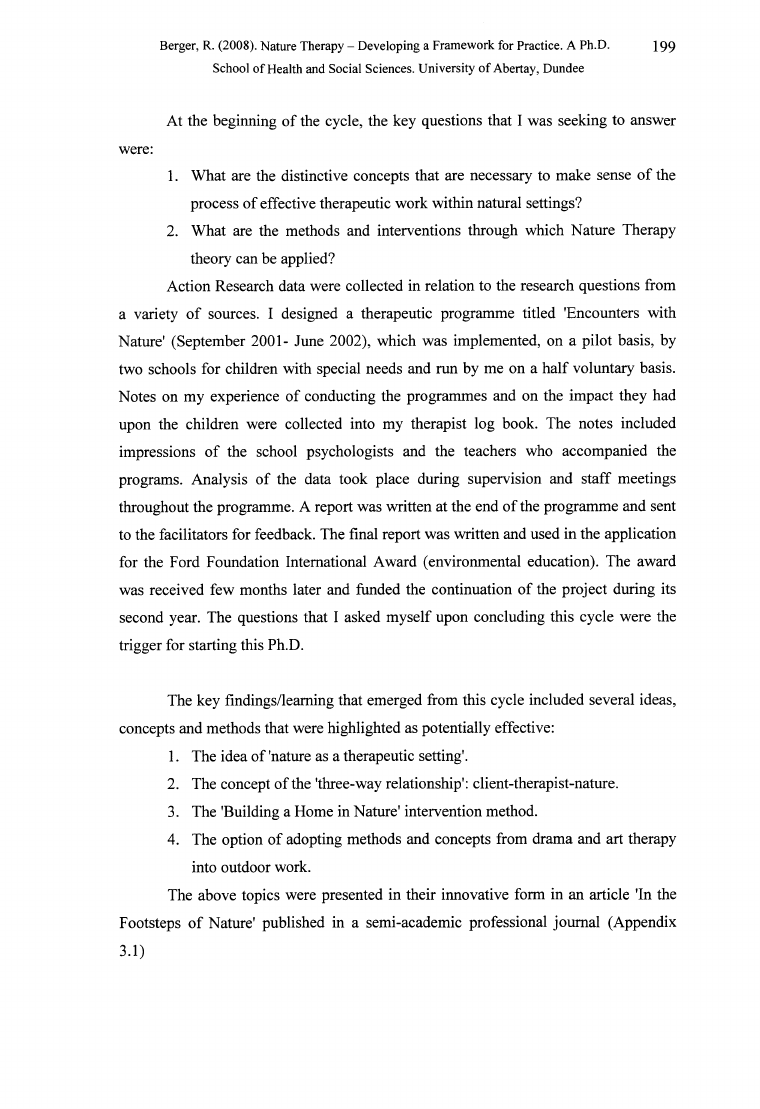
Berger, R. (2008). Nature Therapy - Developing a Framework for Practice. A Ph.D.
199
School of Health and Social Sciences. University of Abertay, Dundee
At the beginning of the cycle, the key questions that I was seeking to answer
were:
1. What are the distinctive concepts that are necessary to make sense o f the
process of effective therapeutic work within natural settings?
2. What are the methods and interventions through which Nature Therapy
theory can be applied?
Action Research data were collected in relation to the research questions from
a variety o f sources. I designed a therapeutic programme titled 'Encounters with
Nature' (September 2001- June 2002), which was implemented, on a pilot basis, by
two schools for children with special needs and run by me on a half voluntary basis.
Notes on my experience of conducting the programmes and on the impact they had
upon the children were collected into my therapist log book. The notes included
impressions of the school psychologists and the teachers who accompanied the
programs. Analysis of the data took place during supervision and staff meetings
throughout the programme. A report was written at the end of the programme and sent
to the facilitators for feedback. The final report was written and used in the application
for the Ford Foundation International Award (environmental education). The award
was received few months later and funded the continuation o f the project during its
second year. The questions that I asked myself upon concluding this cycle were the
trigger for starting this Ph.D.
The key findings/leaming that emerged from this cycle included several ideas,
concepts and methods that were highlighted as potentially effective:
1. The idea of 'nature as a therapeutic setting'.
2. The concept of the 'three-way relationship': client-therapist-nature.
3. The 'Building a Home in Nature' intervention method.
4. The option of adopting methods and concepts from drama and art therapy
into outdoor work.
The above topics were presented in their innovative form in an article 'In the
Footsteps of Nature' published in a semi-academic professional journal (Appendix
3.1)
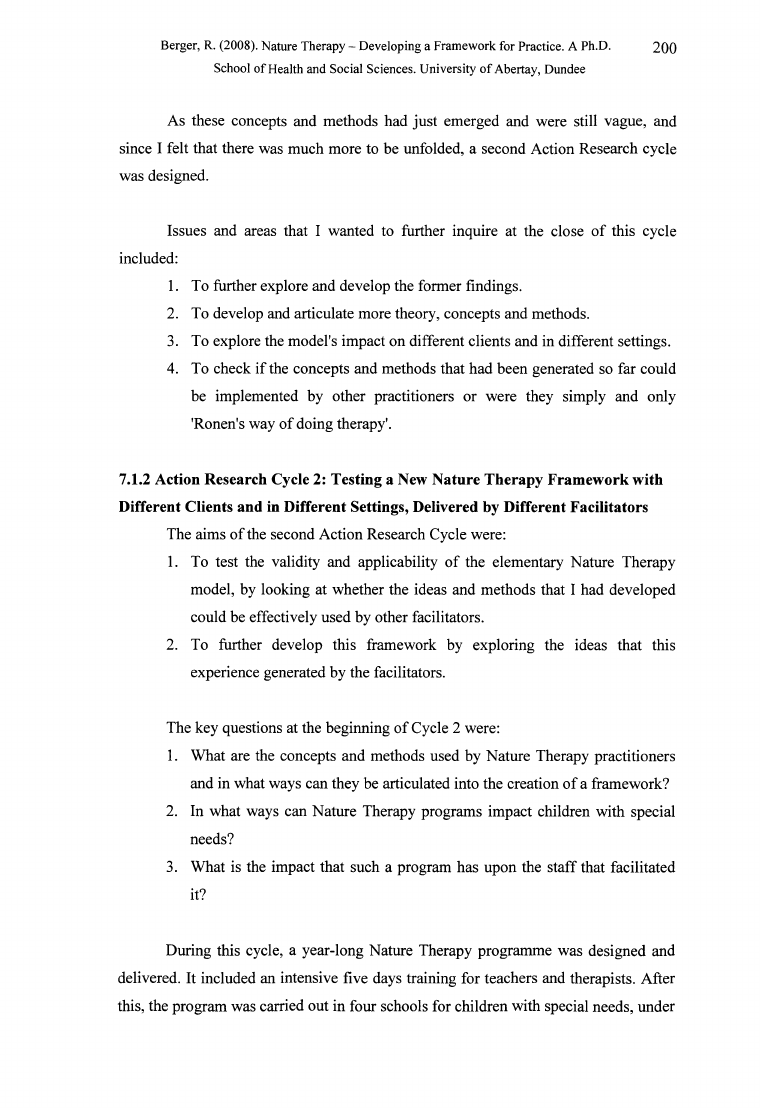
Berger, R. (2008). Nature Therapy - Developing a Framework for Practice. A Ph.D.
200
School of Health and Social Sciences. University of Abertay, Dundee
As these concepts and methods had just emerged and were still vague, and
since I felt that there was much more to be unfolded, a second Action Research cycle
was designed.
Issues and areas that I wanted to further inquire at the close of this cycle
included:
1. To further explore and develop the former findings.
2. To develop and articulate more theory, concepts and methods.
3. To explore the model's impact on different clients and in different settings.
4. To check if the concepts and methods that had been generated so far could
be implemented by other practitioners or were they simply and only
'Ronen's way o f doing therapy'.
7.1.2 Action Research Cycle 2: Testing a New Nature Therapy Framework with
Different Clients and in Different Settings, Delivered by Different Facilitators
The aims of the second Action Research Cycle were:
1. To test the validity and applicability o f the elementary Nature Therapy
model, by looking at whether the ideas and methods that I had developed
could be effectively used by other facilitators.
2. To further develop this framework by exploring the ideas that this
experience generated by the facilitators.
The key questions at the beginning of Cycle 2 were:
1. What are the concepts and methods used by Nature Therapy practitioners
and in what ways can they be articulated into the creation of a framework?
2. In what ways can Nature Therapy programs impact children with special
needs?
3. What is the impact that such a program has upon the staff that facilitated
it?
During this cycle, a year-long Nature Therapy programme was designed and
delivered. It included an intensive five days training for teachers and therapists. After
this, the program was carried out in four schools for children with special needs, under
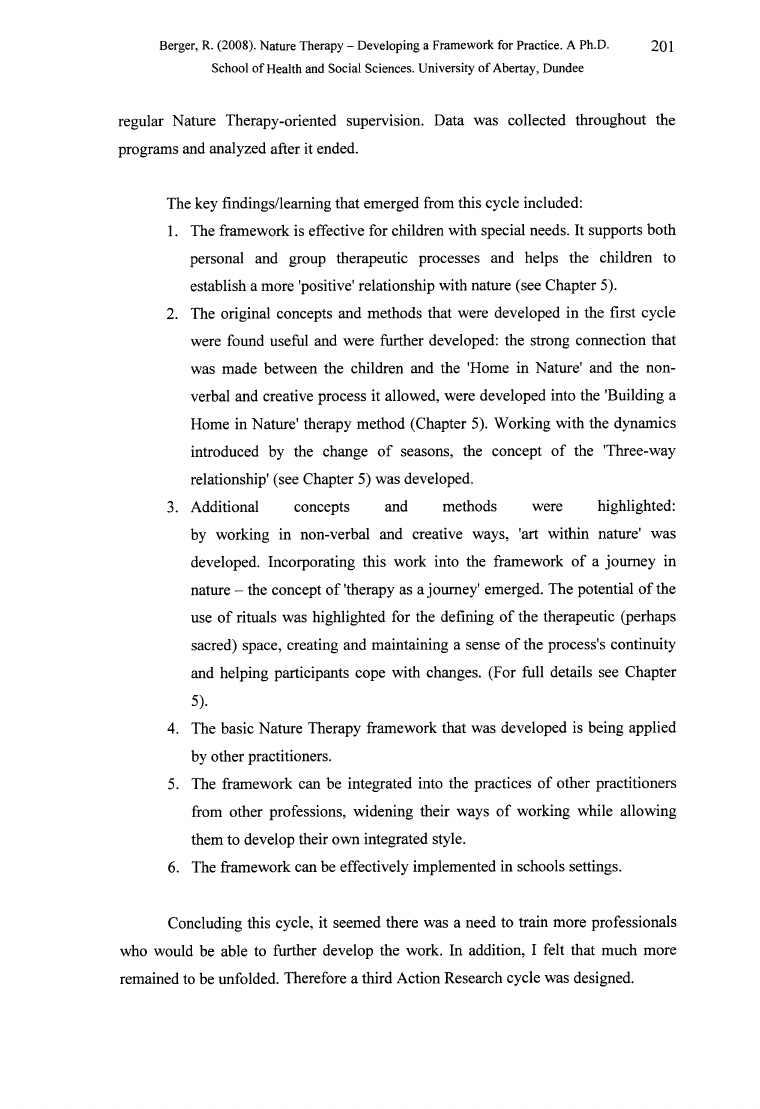
Berger, R. (2008). Nature Therapy - Developing a Framework for Practice. A Ph.D.
201
School of Health and Social Sciences. University of Abertay, Dundee
regular Nature Therapy-oriented supervision. Data was collected throughout the
programs and analyzed after it ended.
The key findings/leaming that emerged from this cycle included:
1. The framework is effective for children with special needs. It supports both
personal and group therapeutic processes and helps the children to
establish a more 'positive' relationship with nature (see Chapter 5).
2. The original concepts and methods that were developed in the first cycle
were found useful and were further developed: the strong connection that
was made between the children and the 'Home in Nature' and the non
verbal and creative process it allowed, were developed into the 'Building a
Home in Nature' therapy method (Chapter 5). Working with the dynamics
introduced by the change of seasons, the concept of the 'Three-way
relationship' (see Chapter 5) was developed.
3. Additional concepts and methods were highlighted:
by working in non-verbal and creative ways, 'art within nature' was
developed. Incorporating this work into the framework of a journey in
nature - the concept of'therapy as a journey' emerged. The potential o f the
use of rituals was highlighted for the defining of the therapeutic (perhaps
sacred) space, creating and maintaining a sense of the process's continuity
and helping participants cope with changes. (For full details see Chapter
5).
4. The basic Nature Therapy framework that was developed is being applied
by other practitioners.
5. The framework can be integrated into the practices o f other practitioners
from other professions, widening their ways of working while allowing
them to develop their own integrated style.
6. The framework can be effectively implemented in schools settings.
Concluding this cycle, it seemed there was a need to train more professionals
who would be able to further develop the work. In addition, I felt that much more
remained to be unfolded. Therefore a third Action Research cycle was designed.
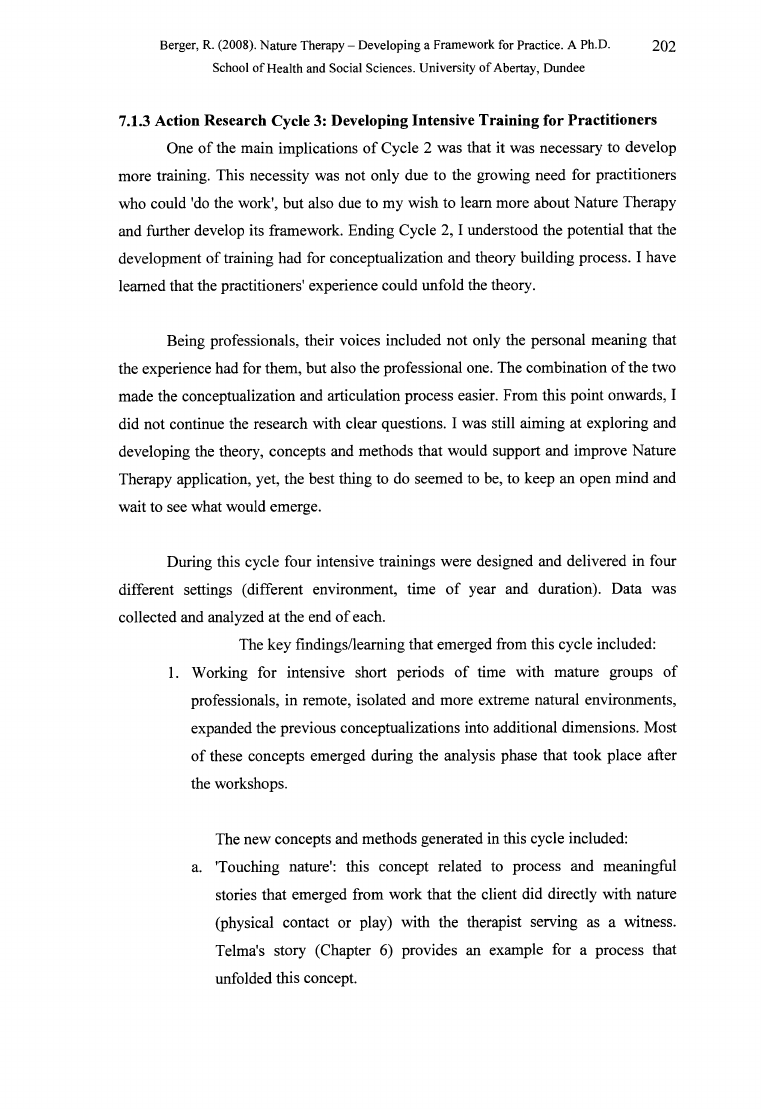
Berger, R. (2008). Nature Therapy - Developing a Framework for Practice. A Ph.D.
202
School of Health and Social Sciences. University of Abertay, Dundee
7.1.3 Action Research Cycle 3: Developing Intensive Training for Practitioners
One of the main implications of Cycle 2 was that it was necessary to develop
more training. This necessity was not only due to the growing need for practitioners
who could 'do the work', but also due to my wish to learn more about Nature Therapy
and further develop its framework. Ending Cycle 2 , 1 understood the potential that the
development of training had for conceptualization and theory building process. I have
learned that the practitioners' experience could unfold the theory.
Being professionals, their voices included not only the personal meaning that
the experience had for them, but also the professional one. The combination of the two
made the conceptualization and articulation process easier. From this point onwards, I
did not continue the research with clear questions. I was still aiming at exploring and
developing the theory, concepts and methods that would support and improve Nature
Therapy application, yet, the best thing to do seemed to be, to keep an open mind and
wait to see what would emerge.
During this cycle four intensive trainings were designed and delivered in four
different settings (different environment, time of year and duration). Data was
collected and analyzed at the end of each.
The key findings/leaming that emerged from this cycle included:
1. Working for intensive short periods o f time with mature groups of
professionals, in remote, isolated and more extreme natural environments,
expanded the previous conceptualizations into additional dimensions. Most
of these concepts emerged during the analysis phase that took place after
the workshops.
The new concepts and methods generated in this cycle included:
a. 'Touching nature': this concept related to process and meaningful
stories that emerged from work that the client did directly with nature
(physical contact or play) with the therapist serving as a witness.
Telma's story (Chapter 6) provides an example for a process that
unfolded this concept.
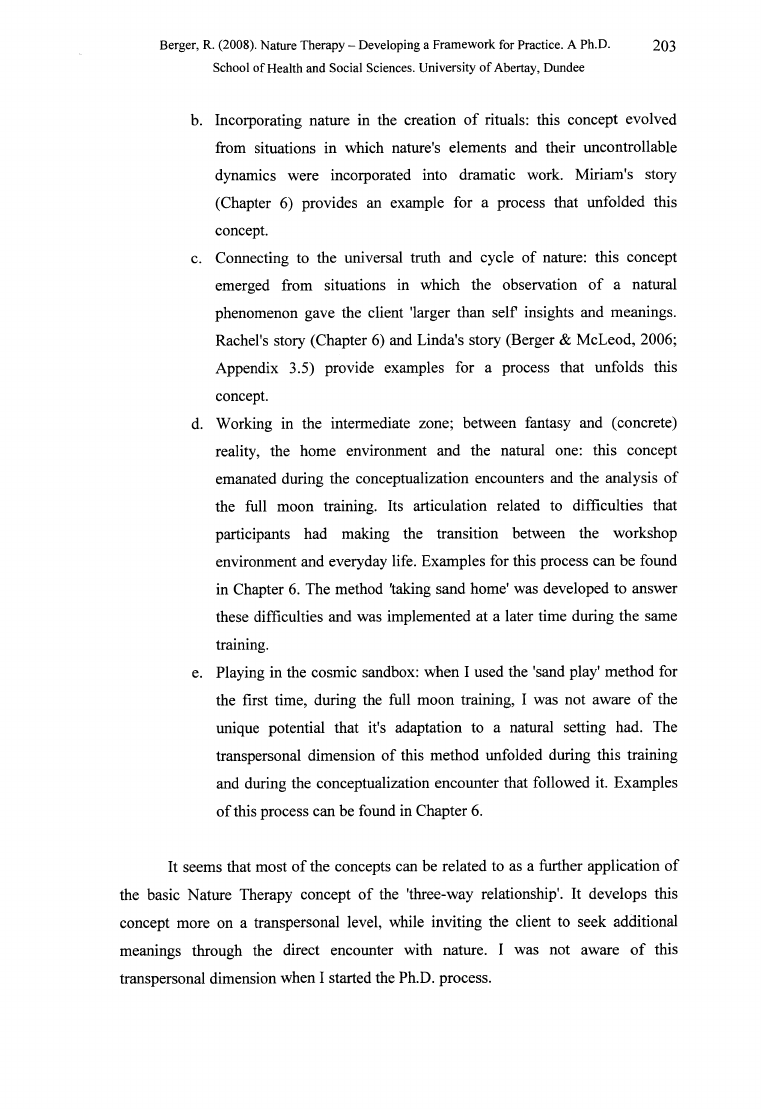
Berger, R. (2008). Nature Therapy - Developing a Framework for Practice. A Ph.D.
203
School of Health and Social Sciences. University of Abertay, Dundee
b. Incorporating nature in the creation of rituals: this concept evolved
from situations in which nature's elements and their uncontrollable
dynamics were incorporated into dramatic work. Miriam's story
(Chapter 6) provides an example for a process that unfolded this
concept.
c. Connecting to the universal truth and cycle o f nature: this concept
emerged from situations in which the observation o f a natural
phenomenon gave the client 'larger than self insights and meanings.
Rachel's story (Chapter 6) and Linda's story (Berger & McLeod, 2006;
Appendix 3.5) provide examples for a process that unfolds this
concept.
d. Working in the intermediate zone; between fantasy and (concrete)
reality, the home environment and the natural one: this concept
emanated during the conceptualization encounters and the analysis of
the full moon training. Its articulation related to difficulties that
participants had making the transition between the workshop
environment and everyday life. Examples for this process can be found
in Chapter 6. The method 'taking sand home' was developed to answer
these difficulties and was implemented at a later time during the same
training.
e. Playing in the cosmic sandbox: when I used the 'sand play' method for
the first time, during the full moon training, I was not aware o f the
unique potential that it's adaptation to a natural setting had. The
transpersonal dimension of this method unfolded during this training
and during the conceptualization encounter that followed it. Examples
o f this process can be found in Chapter 6.
It seems that most of the concepts can be related to as a further application of
the basic Nature Therapy concept of the 'three-way relationship'. It develops this
concept more on a transpersonal level, while inviting the client to seek additional
meanings through the direct encounter with nature. I was not aware o f this
transpersonal dimension when I started the Ph.D. process.
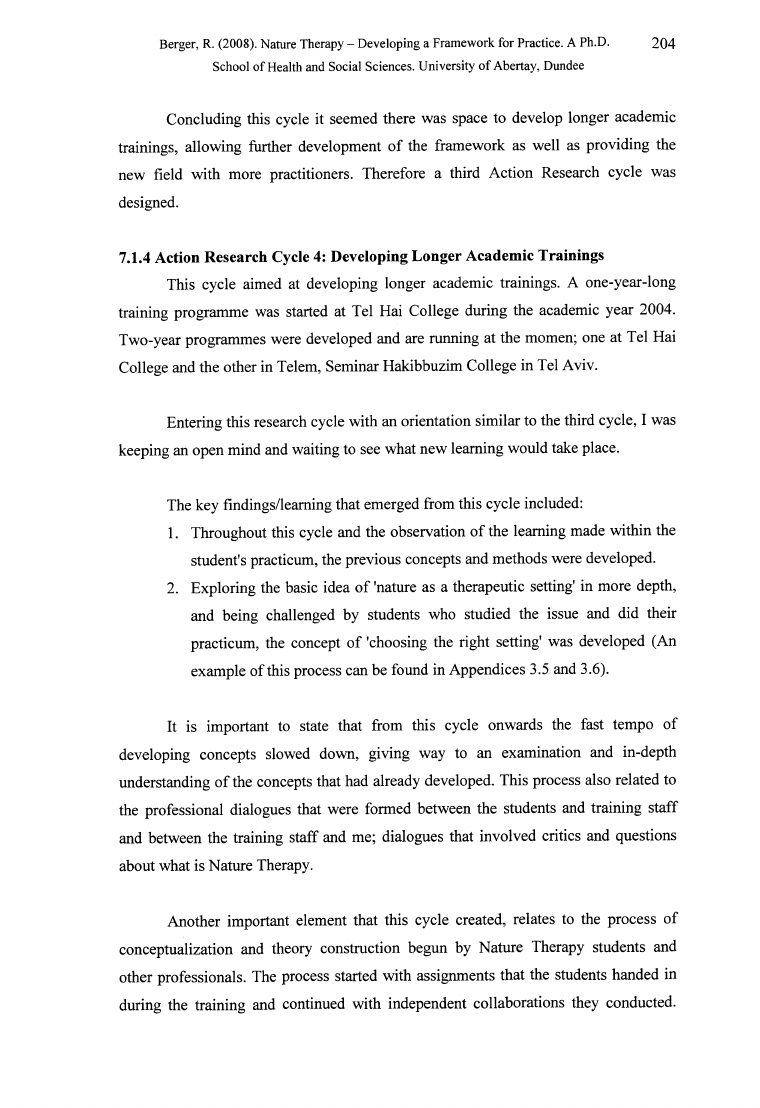
Berger, R. (2008). Nature Therapy - Developing a Framework for Practice. A Ph.D.
204
School of Health and Social Sciences. University of Abertay, Dundee
Concluding this cycle it seemed there was space to develop longer academic
trainings, allowing further development of the framework as well as providing the
new field with more practitioners. Therefore a third Action Research cycle was
designed.
7.1.4 Action Research Cycle 4: Developing Longer Academic Trainings
This cycle aimed at developing longer academic trainings. A one-year-long
training programme was started at Tel Hai College during the academic year 2004.
Two-year programmes were developed and are running at the momen; one at Tel Hai
College and the other in Telem, Seminar Hakibbuzim College in Tel Aviv.
Entering this research cycle with an orientation similar to the third cycle, I was
keeping an open mind and waiting to see what new learning would take place.
The key findings/leaming that emerged from this cycle included:
1. Throughout this cycle and the observation o f the learning made within the
student's practicum, the previous concepts and methods were developed.
2. Exploring the basic idea o f 'nature as a therapeutic setting' in more depth,
and being challenged by students who studied the issue and did their
practicum, the concept of 'choosing the right setting' was developed (An
example of this process can be found in Appendices 3.5 and 3.6).
It is important to state that from this cycle onwards the fast tempo of
developing concepts slowed down, giving way to an examination and in-depth
understanding of the concepts that had already developed. This process also related to
the professional dialogues that were formed between the students and training staff
and between the training staff and me; dialogues that involved critics and questions
about what is Nature Therapy.
Another important element that this cycle created, relates to the process of
conceptualization and theory construction begun by Nature Therapy students and
other professionals. The process started with assignments that the students handed in
during the training and continued with independent collaborations they conducted.
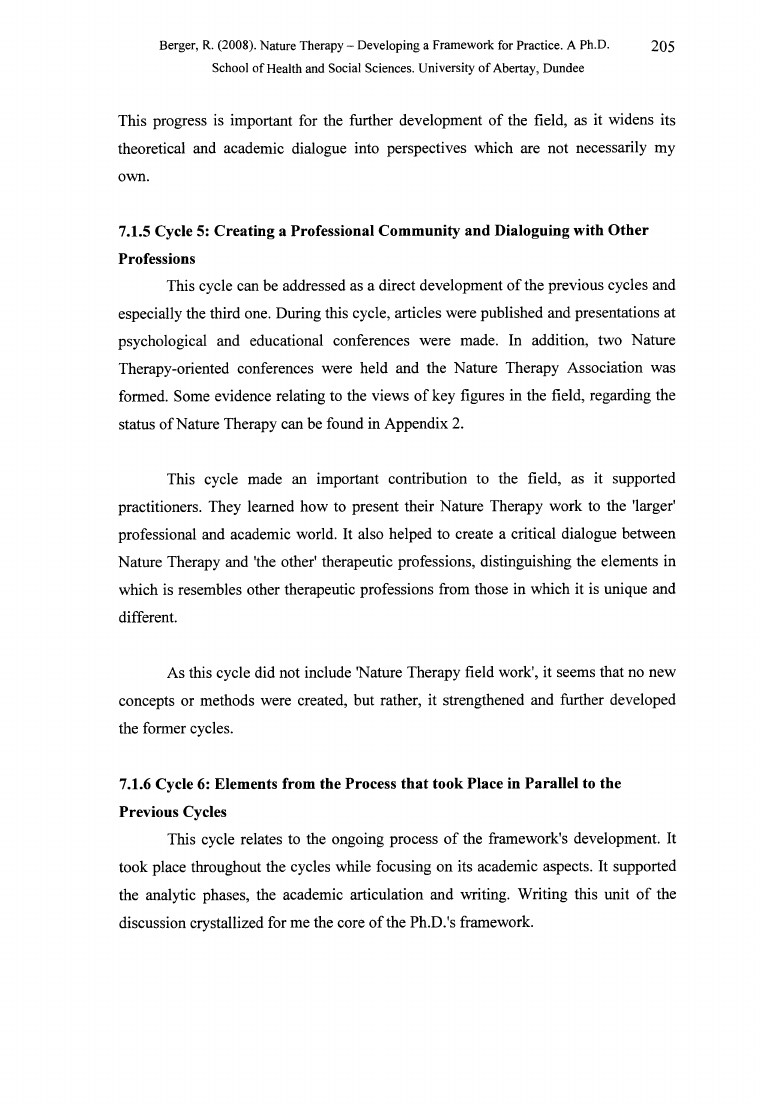
Berger, R. (2008). Nature Therapy - Developing a Framework for Practice. A Ph.D.
205
School of Health and Social Sciences. University of Abertay, Dundee
This progress is important for the further development o f the field, as it widens its
theoretical and academic dialogue into perspectives which are not necessarily my
own.
7.1.5 Cycle 5: Creating a Professional Community and Dialoguing with Other
Professions
This cycle can be addressed as a direct development of the previous cycles and
especially the third one. During this cycle, articles were published and presentations at
psychological and educational conferences were made. In addition, two Nature
Therapy-oriented conferences were held and the Nature Therapy Association was
formed. Some evidence relating to the views of key figures in the field, regarding the
status o f Nature Therapy can be found in Appendix 2.
This cycle made an important contribution to the field, as it supported
practitioners. They learned how to present their Nature Therapy work to the 'larger'
professional and academic world. It also helped to create a critical dialogue between
Nature Therapy and 'the other' therapeutic professions, distinguishing the elements in
which is resembles other therapeutic professions from those in which it is unique and
different.
As this cycle did not include Nature Therapy field work', it seems that no new
concepts or methods were created, but rather, it strengthened and further developed
the former cycles.
7.1.6 Cycle 6: Elements from the Process that took Place in Parallel to the
Previous Cycles
This cycle relates to the ongoing process o f the framework's development. It
took place throughout the cycles while focusing on its academic aspects. It supported
the analytic phases, the academic articulation and writing. Writing this unit of the
discussion crystallized for me the core o f the Ph.D.'s framework.
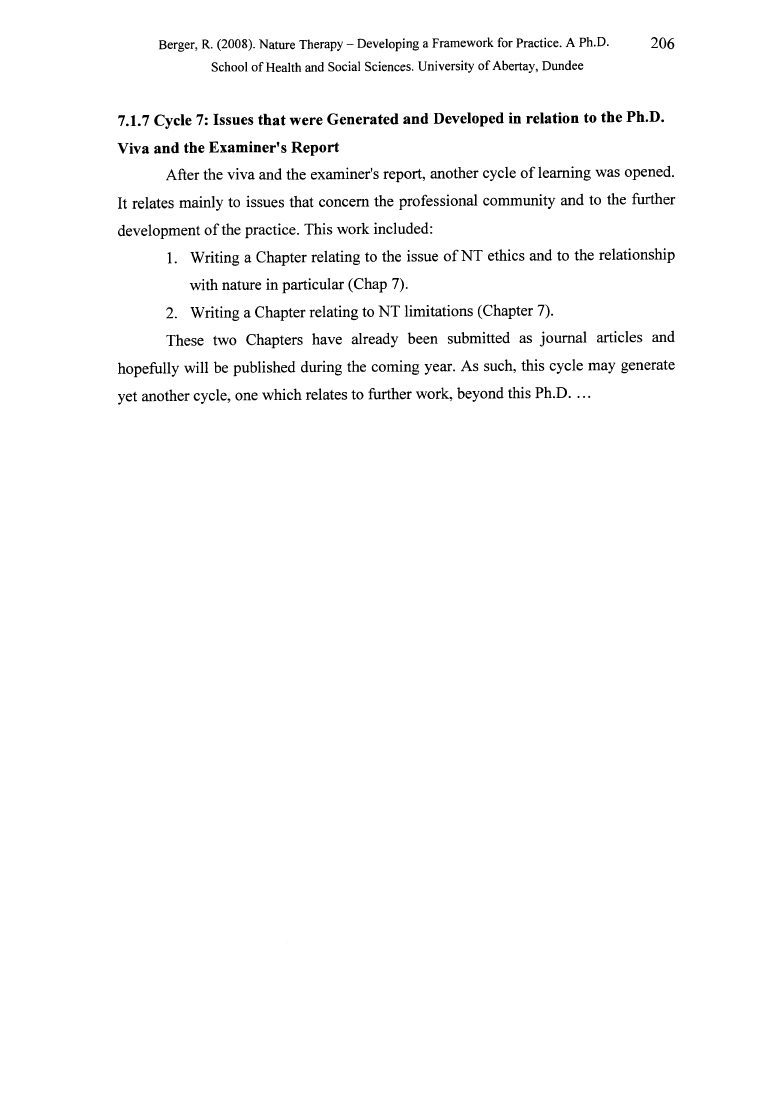
Berger, R. (2008). Nature Therapy - Developing a Framework for Practice. A Ph.D.
206
School of Health and Social Sciences. University of Abertay, Dundee
7.1.7 Cycle 7: Issues that were Generated and Developed in relation to the Ph.D.
Viva and the Examiner’s Report
After the viva and the examiner's report, another cycle of learning was opened.
It relates mainly to issues that concern the professional community and to the further
development of the practice. This work included:
1. Writing a Chapter relating to the issue o f NT ethics and to the relationship
with nature in particular (Chap 7).
2. Writing a Chapter relating to NT limitations (Chapter 7).
These two Chapters have already been submitted as journal articles and
hopefully will be published during the coming year. As such, this cycle may generate
yet another cycle, one which relates to further work, beyond this Ph.D. ...
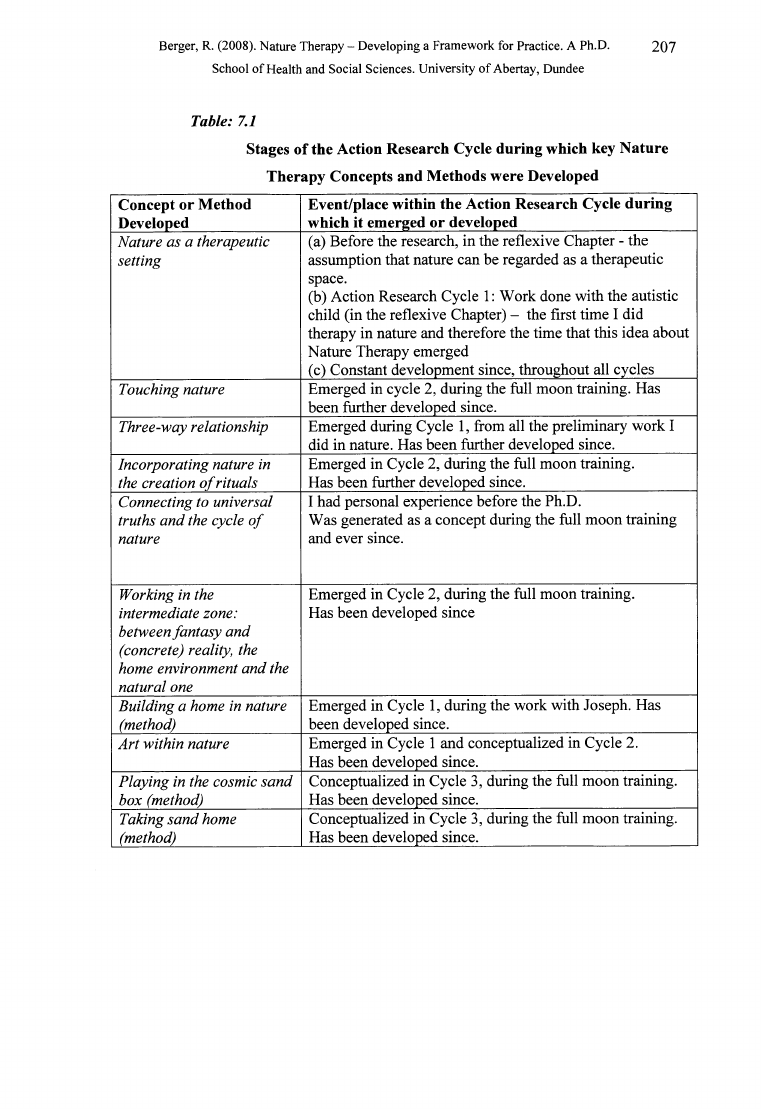
Berger, R. (2008). Nature Therapy - Developing a Framework for Practice. A Ph.D.
207
School of Health and Social Sciences. University of Abertay, Dundee
Table: 7.1
Stages of the Action Research Cycle during which key Nature
Therapy Concepts and Methods were Developed
Concept or Method
Developed
N ature as a therapeutic
se ttin g
Touching nature
Three-w ay relationship
In co rp o ra tin g natu re in
the creation o f ritu als
C onnecting to universal
truths an d the cycle o f
n a tu re
Event/place within the Action Research Cycle during
which it emerged or developed
(a) Before the research, in the reflexive Chapter - the
assumption that nature can be regarded as a therapeutic
space.
(b) Action Research Cycle 1: Work done with the autistic
child (in the reflexive Chapter) - the first time I did
therapy in nature and therefore the time that this idea about
Nature Therapy emerged
(c) Constant development since, throughout all cycles
Emerged in cycle 2, during the full moon training. Has
been further developed since.
Emerged during Cycle 1, from all the preliminary work I
did in nature. Has been further developed since.
Emerged in Cycle 2, during the full moon training.
Has been further developed since.
I had personal experience before the Ph.D.
Was generated as a concept during the full moon training
and ever since.
W orking in the
interm ediate zone:
betw een fa n ta sy and
(concrete) reality, the
hom e environm ent a n d the
natural one
B u ild in g a hom e in nature
(m ethod)
A rt w ithin nature
P la y in g in the cosm ic sa n d
box (m ethod)
Taking sa n d hom e
(m ethod)
Emerged in Cycle 2, during the full moon training.
Has been developed since
Emerged in Cycle 1, during the work with Joseph. Has
been developed since.
Emerged in Cycle 1 and conceptualized in Cycle 2.
Has been developed since.
Conceptualized in Cycle 3, during the full moon training.
Has been developed since.
Conceptualized in Cycle 3, during the full moon training.
Has been developed since.
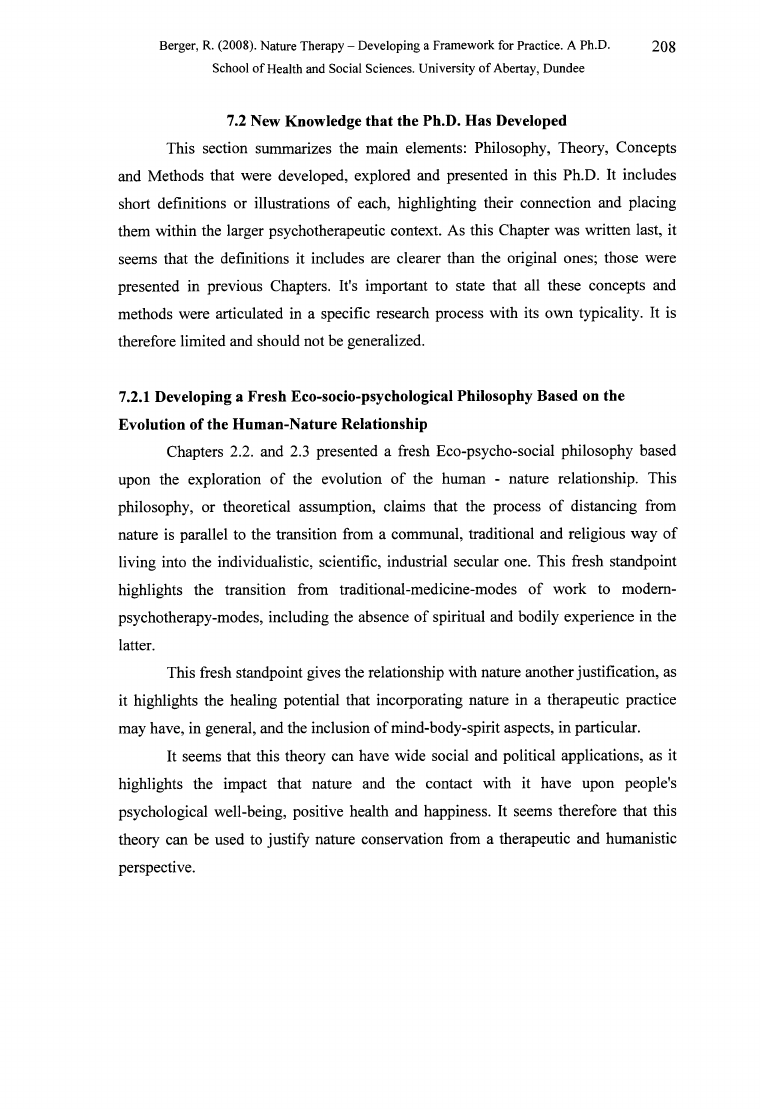
Berger, R. (2008). Nature Therapy - Developing a Framework for Practice. A Ph.D.
208
School of Health and Social Sciences. University of Abertay, Dundee
7.2 New Knowledge that the Ph.D. Has Developed
This section summarizes the main elements: Philosophy, Theory, Concepts
and Methods that were developed, explored and presented in this Ph.D. It includes
short definitions or illustrations of each, highlighting their connection and placing
them within the larger psychotherapeutic context. As this Chapter was written last, it
seems that the definitions it includes are clearer than the original ones; those were
presented in previous Chapters. It's important to state that all these concepts and
methods were articulated in a specific research process with its own typicality. It is
therefore limited and should not be generalized.
7.2.1 Developing a Fresh Eco-socio-psychological Philosophy Based on the
Evolution of the Human-Nature Relationship
Chapters 2.2. and 2.3 presented a fresh Eco-psycho-social philosophy based
upon the exploration of the evolution of the human - nature relationship. This
philosophy, or theoretical assumption, claims that the process of distancing from
nature is parallel to the transition from a communal, traditional and religious way of
living into the individualistic, scientific, industrial secular one. This fresh standpoint
highlights the transition from traditional-medicine-modes of work to modem-
psychotherapy-modes, including the absence of spiritual and bodily experience in the
latter.
This fresh standpoint gives the relationship with nature another justification, as
it highlights the healing potential that incorporating nature in a therapeutic practice
may have, in general, and the inclusion of mind-body-spirit aspects, in particular.
It seems that this theory can have wide social and political applications, as it
highlights the impact that nature and the contact with it have upon people's
psychological well-being, positive health and happiness. It seems therefore that this
theory can be used to justify nature conservation from a therapeutic and humanistic
perspective.
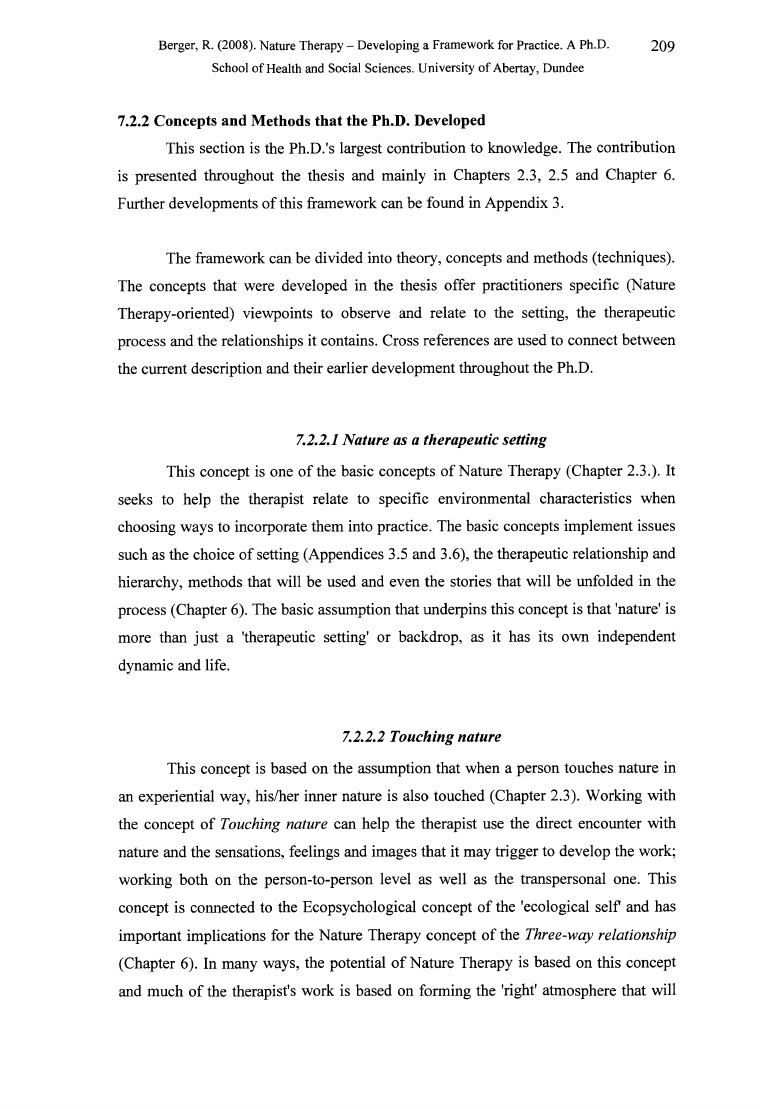
Berger, R. (2008). Nature Therapy - Developing a Framework for Practice. A Ph.D.
209
School of Health and Social Sciences. University of Abertay, Dundee
7.2.2 Concepts and Methods that the Ph.D. Developed
This section is the Ph.D.'s largest contribution to knowledge. The contribution
is presented throughout the thesis and mainly in Chapters 2.3, 2.5 and Chapter 6.
Further developments of this framework can be found in Appendix 3.
The framework can be divided into theory, concepts and methods (techniques).
The concepts that were developed in the thesis offer practitioners specific (Nature
Therapy-oriented) viewpoints to observe and relate to the setting, the therapeutic
process and the relationships it contains. Cross references are used to connect between
the current description and their earlier development throughout the Ph.D.
7.2.2A Nature as a therapeutic setting
This concept is one of the basic concepts of Nature Therapy (Chapter 2.3.). It
seeks to help the therapist relate to specific environmental characteristics when
choosing ways to incorporate them into practice. The basic concepts implement issues
such as the choice of setting (Appendices 3.5 and 3.6), the therapeutic relationship and
hierarchy, methods that will be used and even the stories that will be unfolded in the
process (Chapter 6). The basic assumption that underpins this concept is that 'nature' is
more than just a 'therapeutic setting' or backdrop, as it has its own independent
dynamic and life.
7.2.2.2 Touching nature
This concept is based on the assumption that when a person touches nature in
an experiential way, his/her inner nature is also touched (Chapter 2.3). Working with
the concept of Touching nature can help the therapist use the direct encounter with
nature and the sensations, feelings and images that it may trigger to develop the work;
working both on the person-to-person level as well as the transpersonal one. This
concept is connected to the Ecopsychological concept of the 'ecological self and has
important implications for the Nature Therapy concept of the Three-way relationship
(Chapter 6). In many ways, the potential of Nature Therapy is based on this concept
and much of the therapist's work is based on forming the 'right' atmosphere that will
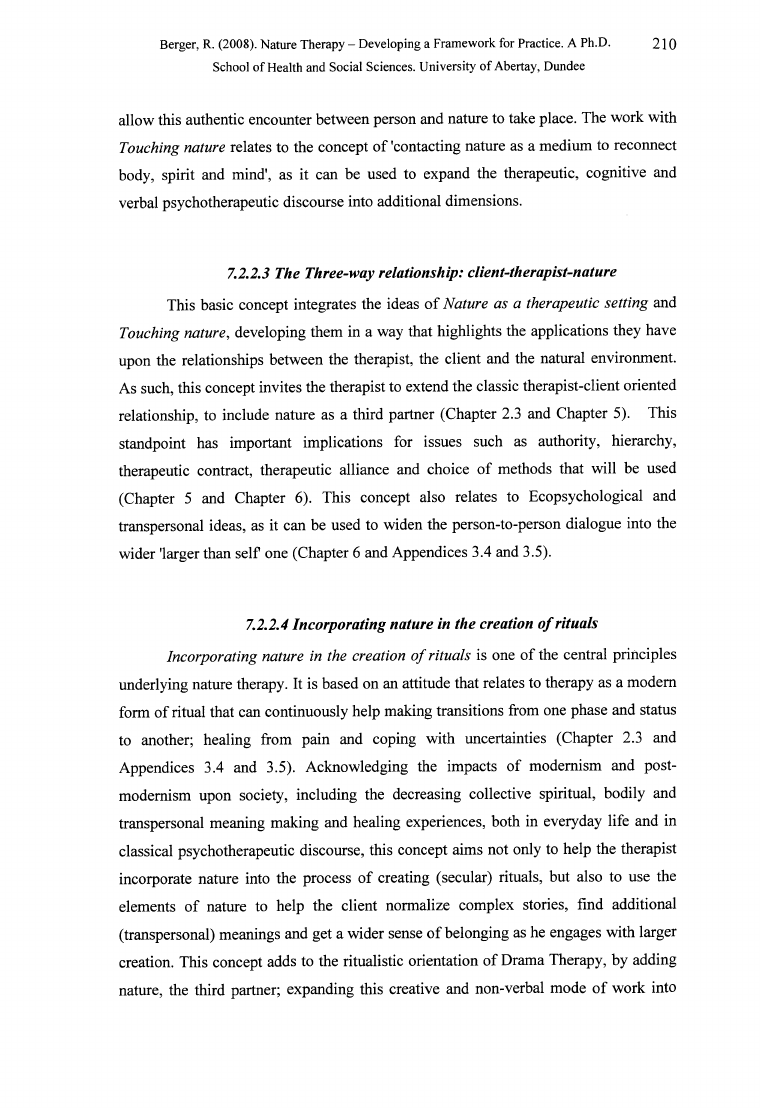
Berger, R. (2008). Nature Therapy - Developing a Framework for Practice. A Ph.D.
210
School of Health and Social Sciences. University of Abertay, Dundee
allow this authentic encounter between person and nature to take place. The work with
Touching nature relates to the concept of 'contacting nature as a medium to reconnect
body, spirit and mind', as it can be used to expand the therapeutic, cognitive and
verbal psychotherapeutic discourse into additional dimensions.
7.2.23 The Three-way relationship: client-therapist-nature
This basic concept integrates the ideas of Nature as a therapeutic setting and
Touching nature, developing them in a way that highlights the applications they have
upon the relationships between the therapist, the client and the natural environment.
As such, this concept invites the therapist to extend the classic therapist-client oriented
relationship, to include nature as a third partner (Chapter 2.3 and Chapter 5). This
standpoint has important implications for issues such as authority, hierarchy,
therapeutic contract, therapeutic alliance and choice of methods that will be used
(Chapter 5 and Chapter 6). This concept also relates to Ecopsychological and
transpersonal ideas, as it can be used to widen the person-to-person dialogue into the
wider 'larger than self one (Chapter 6 and Appendices 3.4 and 3.5).
1.2.2.4 Incorporating nature in the creation o f rituals
Incorporating nature in the creation o f rituals is one of the central principles
underlying nature therapy. It is based on an attitude that relates to therapy as a modem
form of ritual that can continuously help making transitions from one phase and status
to another; healing from pain and coping with uncertainties (Chapter 2.3 and
Appendices 3.4 and 3.5). Acknowledging the impacts of modernism and post
modernism upon society, including the decreasing collective spiritual, bodily and
transpersonal meaning making and healing experiences, both in everyday life and in
classical psychotherapeutic discourse, this concept aims not only to help the therapist
incorporate nature into the process of creating (secular) rituals, but also to use the
elements of nature to help the client normalize complex stories, find additional
(transpersonal) meanings and get a wider sense of belonging as he engages with larger
creation. This concept adds to the ritualistic orientation of Drama Therapy, by adding
nature, the third partner; expanding this creative and non-verbal mode of work into
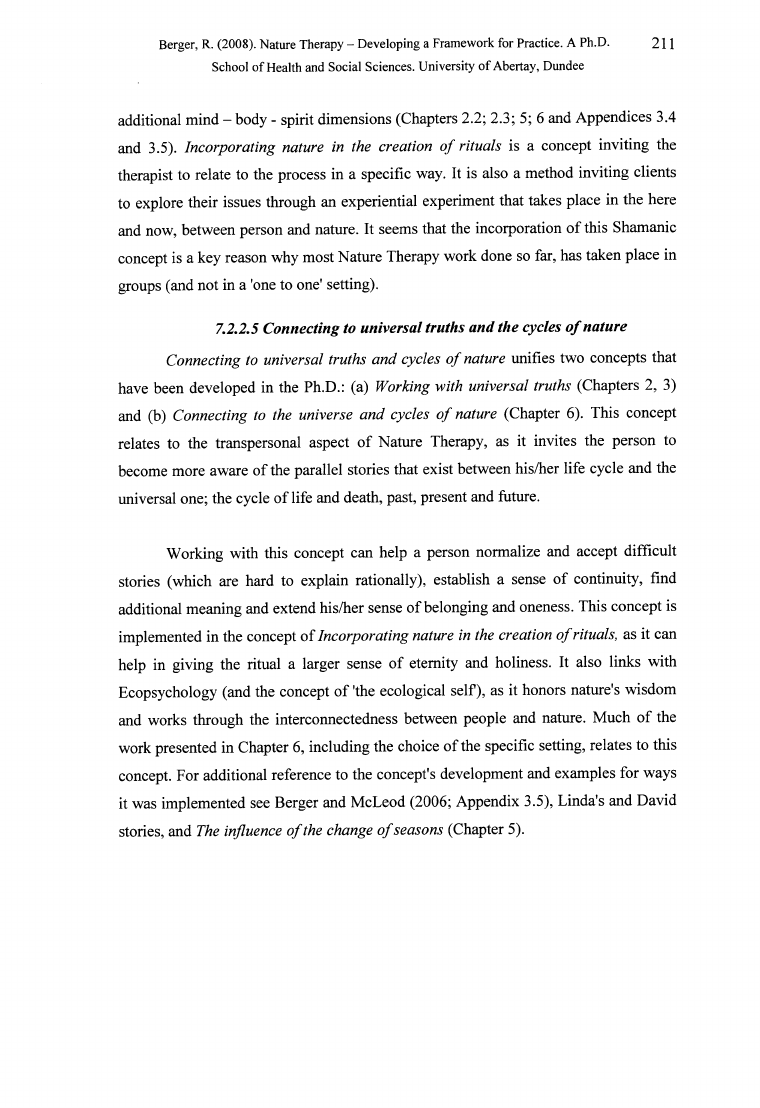
Berger, R. (2008). Nature Therapy - Developing a Framework for Practice. A Ph.D.
211
School of Health and Social Sciences. University of Abertay, Dundee
additional mind - body - spirit dimensions (Chapters 2.2; 2.3; 5; 6 and Appendices 3.4
and 3.5). Incorporating nature in the creation o f rituals is a concept inviting the
therapist to relate to the process in a specific way. It is also a method inviting clients
to explore their issues through an experiential experiment that takes place in the here
and now, between person and nature. It seems that the incorporation of this Shamanic
concept is a key reason why most Nature Therapy work done so far, has taken place in
groups (and not in a 'one to one' setting).
7.2.2.5 Connecting to universal truths and the cycles o f nature
Connecting to universal truths and cycles o f nature unifies two concepts that
have been developed in the Ph.D.: (a) Working with universal truths (Chapters 2, 3)
and (b) Connecting to the universe and cycles o f nature (Chapter 6). This concept
relates to the transpersonal aspect of Nature Therapy, as it invites the person to
become more aware of the parallel stories that exist between his/her life cycle and the
universal one; the cycle of life and death, past, present and future.
Working with this concept can help a person normalize and accept difficult
stories (which are hard to explain rationally), establish a sense of continuity, find
additional meaning and extend his/her sense of belonging and oneness. This concept is
implemented in the concept of Incorporating nature in the creation o f rituals, as it can
help in giving the ritual a larger sense of eternity and holiness. It also links with
Ecopsychology (and the concept of 'the ecological self), as it honors nature's wisdom
and works through the interconnectedness between people and nature. Much of the
work presented in Chapter 6, including the choice of the specific setting, relates to this
concept. For additional reference to the concept's development and examples for ways
it was implemented see Berger and McLeod (2006; Appendix 3.5), Linda's and David
stories, and The influence o f the change o f seasons (Chapter 5).
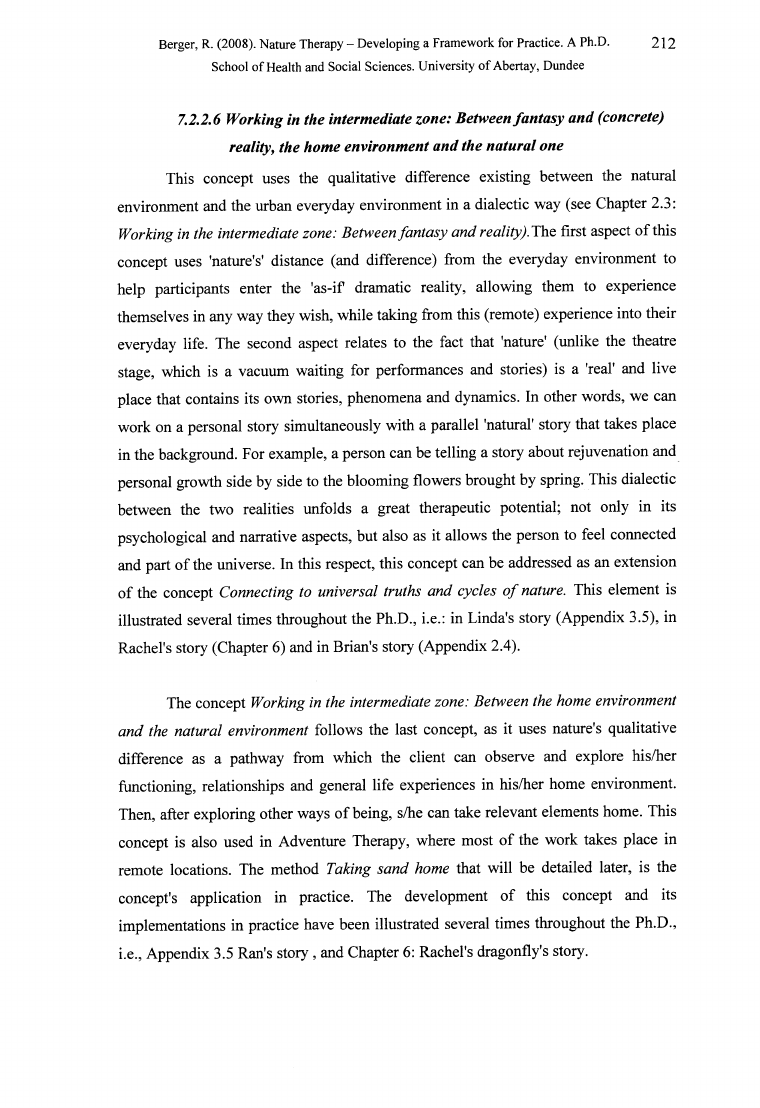
Berger, R. (2008). Nature Therapy - Developing a Framework for Practice. A Ph.D.
212
School of Health and Social Sciences. University of Abertay, Dundee
7.2.2.6 Working in the intermediate zone: Between fantasy and (concrete)
reality, the home environment and the natural one
This concept uses the qualitative difference existing between the natural
environment and the urban everyday environment in a dialectic way (see Chapter 2.3:
Working in the intermediate zone: Between fantasy and reality). The first aspect of this
concept uses 'nature's' distance (and difference) from the everyday environment to
help participants enter the 'as-if dramatic reality, allowing them to experience
themselves in any way they wish, while taking from this (remote) experience into their
everyday life. The second aspect relates to the fact that 'nature' (unlike the theatre
stage, which is a vacuum waiting for performances and stories) is a 'real' and live
place that contains its own stories, phenomena and dynamics. In other words, we can
work on a personal story simultaneously with a parallel 'natural' story that takes place
in the background. For example, a person can be telling a story about rejuvenation and
personal growth side by side to the blooming flowers brought by spring. This dialectic
between the two realities unfolds a great therapeutic potential; not only in its
psychological and narrative aspects, but also as it allows the person to feel connected
and part of the universe. In this respect, this concept can be addressed as an extension
of the concept Connecting to universal truths and cycles o f nature. This element is
illustrated several times throughout the Ph.D., i.e.: in Linda's story (Appendix 3.5), in
Rachel's story (Chapter 6) and in Brian's story (Appendix 2.4).
The concept Working in the intermediate zone: Between the home environment
and the natural environment follows the last concept, as it uses nature's qualitative
difference as a pathway from which the client can observe and explore his/her
functioning, relationships and general life experiences in his/her home environment.
Then, after exploring other ways of being, s/he can take relevant elements home. This
concept is also used in Adventure Therapy, where most of the work takes place in
remote locations. The method Taking sand home that will be detailed later, is the
concept's application in practice. The development of this concept and its
implementations in practice have been illustrated several times throughout the Ph.D.,
i.e., Appendix 3.5 Ran's story , and Chapter 6: Rachel's dragonfly's story.
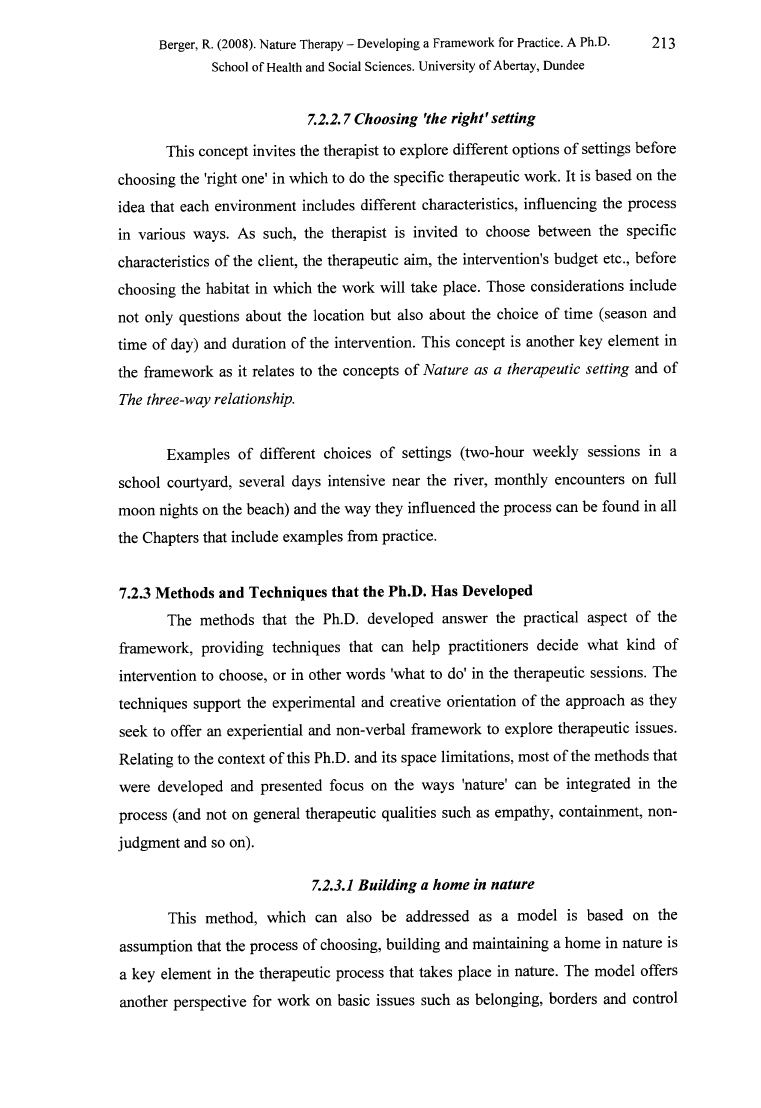
Berger, R. (2008). Nature Therapy - Developing a Framework for Practice. A Ph.D.
213
School of Health and Social Sciences. University of Abertay, Dundee
7.2.2.7 Choosing 'the right' setting
This concept invites the therapist to explore different options of settings before
choosing the 'right one' in which to do the specific therapeutic work. It is based on the
idea that each environment includes different characteristics, influencing the process
in various ways. As such, the therapist is invited to choose between the specific
characteristics of the client, the therapeutic aim, the intervention's budget etc., before
choosing the habitat in which the work will take place. Those considerations include
not only questions about the location but also about the choice of time (season and
time of day) and duration of the intervention. This concept is another key element in
the framework as it relates to the concepts of Nature as a therapeutic setting and of
The three-way relationship.
Examples of different choices of settings (two-hour weekly sessions in a
school courtyard, several days intensive near the river, monthly encounters on full
moon nights on the beach) and the way they influenced the process can be found in all
the Chapters that include examples from practice.
7.2.3 Methods and Techniques that the Ph.D. Has Developed
The methods that the Ph.D. developed answer the practical aspect of the
framework, providing techniques that can help practitioners decide what kind of
intervention to choose, or in other words 'what to do' in the therapeutic sessions. The
techniques support the experimental and creative orientation of the approach as they
seek to offer an experiential and non-verbal framework to explore therapeutic issues.
Relating to the context of this Ph.D. and its space limitations, most of the methods that
were developed and presented focus on the ways 'nature' can be integrated in the
process (and not on general therapeutic qualities such as empathy, containment, non
judgment and so on).
7.2.3.1 Building a home in nature
This method, which can also be addressed as a model is based on the
assumption that the process of choosing, building and maintaining a home in nature is
a key element in the therapeutic process that takes place in nature. The model offers
another perspective for work on basic issues such as belonging, borders and control
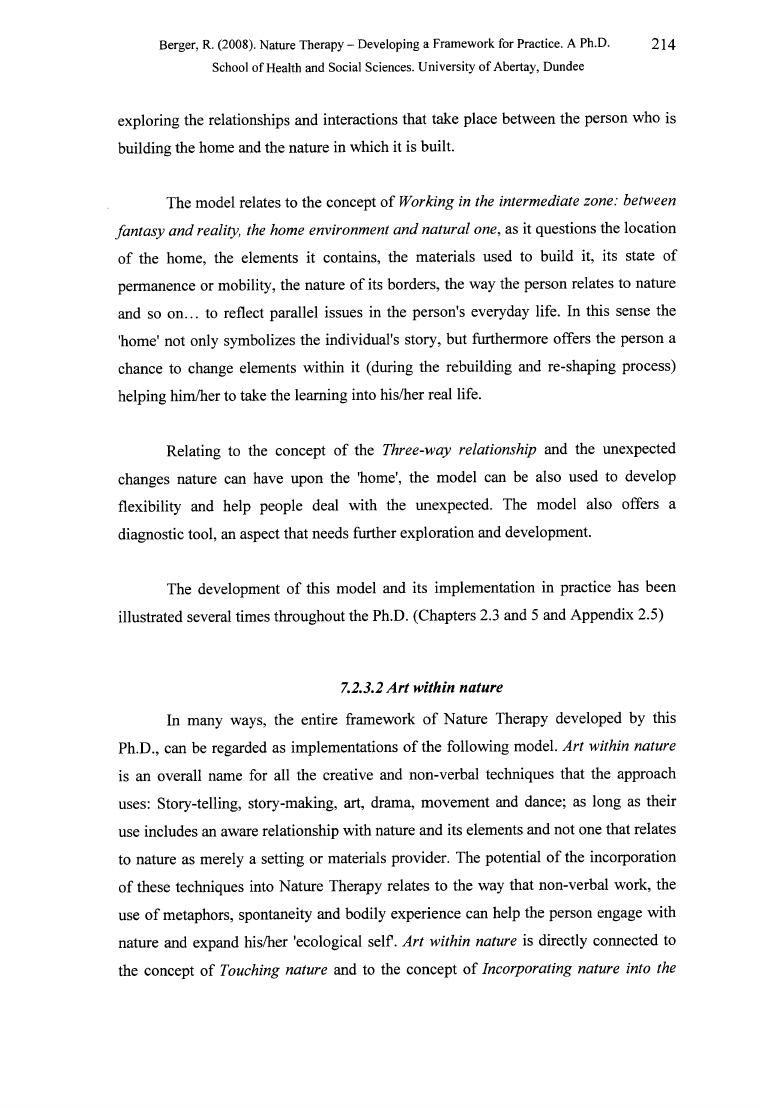
Berger, R. (2008). Nature Therapy - Developing a Framework for Practice. A Ph.D.
214
School of Health and Social Sciences. University of Abertay, Dundee
exploring the relationships and interactions that take place between the person who is
building the home and the nature in which it is built.
The model relates to the concept of Working in the intermediate zone: between
fantasy and reality, the home environment and natural one, as it questions the location
of the home, the elements it contains, the materials used to build it, its state of
permanence or mobility, the nature of its borders, the way the person relates to nature
and so on... to reflect parallel issues in the person's everyday life. In this sense the
'home' not only symbolizes the individual's story, but furthermore offers the person a
chance to change elements within it (during the rebuilding and re-shaping process)
helping him/her to take the learning into his/her real life.
Relating to the concept of the Three-way relationship and the unexpected
changes nature can have upon the 'home', the model can be also used to develop
flexibility and help people deal with the unexpected. The model also offers a
diagnostic tool, an aspect that needs further exploration and development.
The development of this model and its implementation in practice has been
illustrated several times throughout the Ph.D. (Chapters 2.3 and 5 and Appendix 2.5)
7.2.3.2 Art within nature
In many ways, the entire framework of Nature Therapy developed by this
Ph.D., can be regarded as implementations of the following model. Art within nature
is an overall name for all the creative and non-verbal techniques that the approach
uses: Story-telling, story-making, art, drama, movement and dance; as long as their
use includes an aware relationship with nature and its elements and not one that relates
to nature as merely a setting or materials provider. The potential of the incorporation
of these techniques into Nature Therapy relates to the way that non-verbal work, the
use of metaphors, spontaneity and bodily experience can help the person engage with
nature and expand his/her 'ecological self. Art within nature is directly connected to
the concept of Touching nature and to the concept of Incorporating nature into the
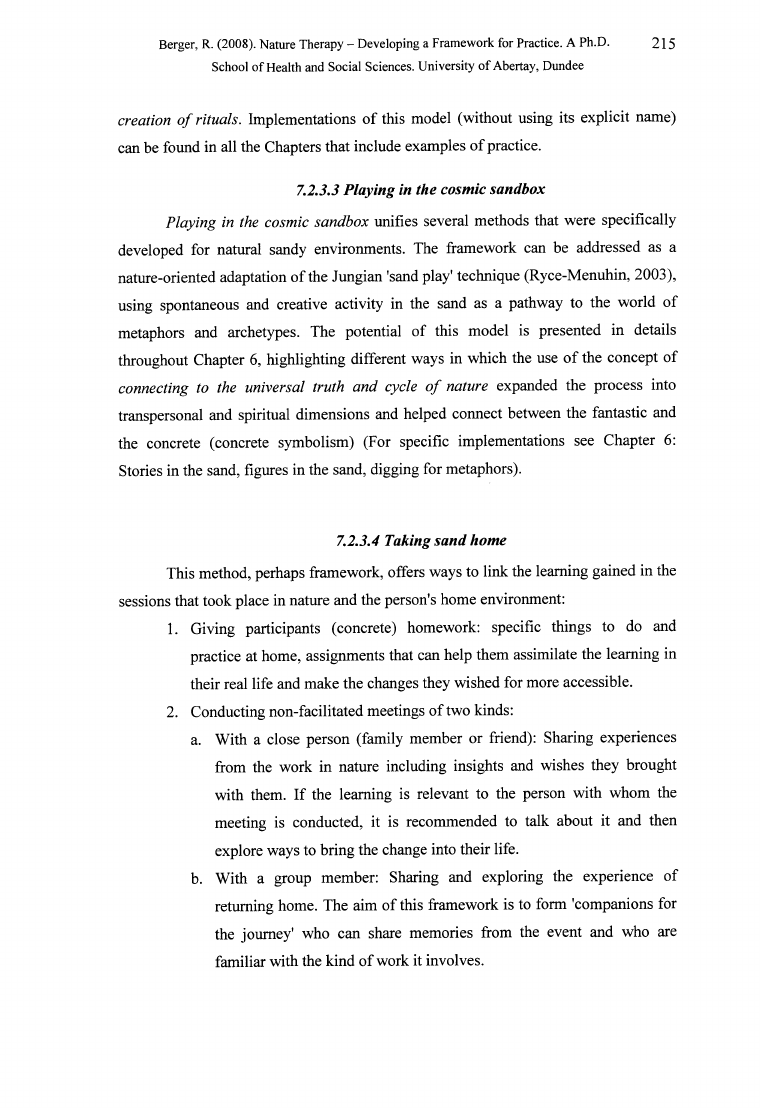
Berger, R. (2008). Nature Therapy - Developing a Framework for Practice. A Ph.D.
215
School of Health and Social Sciences. University of Abertay, Dundee
creation o f rituals. Implementations of this model (without using its explicit name)
can be found in all the Chapters that include examples of practice.
7.2.33 Playing in the cosmic sandbox
Playing in the cosmic sandbox unifies several methods that were specifically
developed for natural sandy environments. The framework can be addressed as a
nature-oriented adaptation of the Jungian 'sand play' technique (Ryce-Menuhin, 2003),
using spontaneous and creative activity in the sand as a pathway to the world of
metaphors and archetypes. The potential of this model is presented in details
throughout Chapter 6, highlighting different ways in which the use of the concept of
connecting to the universal truth and cycle o f nature expanded the process into
transpersonal and spiritual dimensions and helped connect between the fantastic and
the concrete (concrete symbolism) (For specific implementations see Chapter 6:
Stories in the sand, figures in the sand, digging for metaphors).
7.23.4 Taking sand home
This method, perhaps framework, offers ways to link the learning gained in the
sessions that took place in nature and the person's home environment:
1. Giving participants (concrete) homework: specific things to do and
practice at home, assignments that can help them assimilate the learning in
their real life and make the changes they wished for more accessible.
2. Conducting non-facilitated meetings of two kinds:
a. With a close person (family member or friend): Sharing experiences
from the work in nature including insights and wishes they brought
with them. If the learning is relevant to the person with whom the
meeting is conducted, it is recommended to talk about it and then
explore ways to bring the change into their life.
b. With a group member: Sharing and exploring the experience of
returning home. The aim of this framework is to form 'companions for
the journey' who can share memories from the event and who are
familiar with the kind of work it involves.
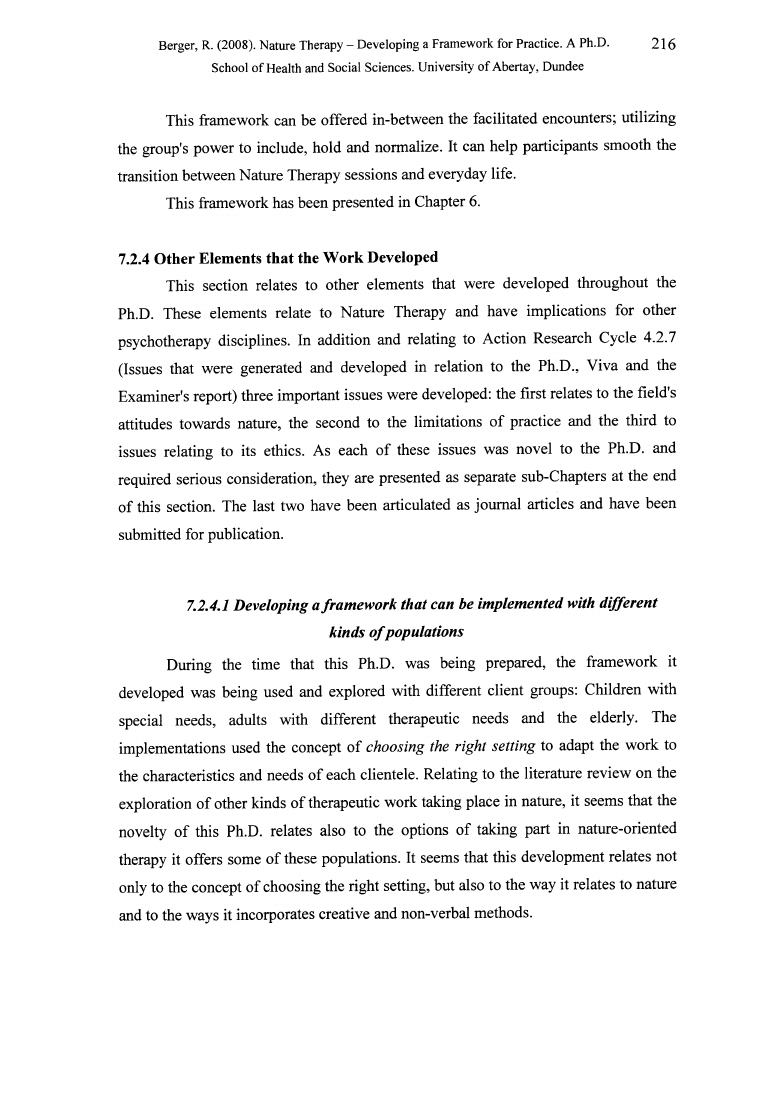
Berger, R. (2008). Nature Therapy - Developing a Framework for Practice. A Ph.D.
216
School of Health and Social Sciences. University of Abertay, Dundee
This framework can be offered in-between the facilitated encounters; utilizing
the group's power to include, hold and normalize. It can help participants smooth the
transition between Nature Therapy sessions and everyday life.
This framework has been presented in Chapter 6.
7.2.4 Other Elements that the Work Developed
This section relates to other elements that were developed throughout the
Ph.D. These elements relate to Nature Therapy and have implications for other
psychotherapy disciplines. In addition and relating to Action Research Cycle 4.2.7
(Issues that were generated and developed in relation to the Ph.D., Viva and the
Examiner's report) three important issues were developed: the first relates to the field's
attitudes towards nature, the second to the limitations of practice and the third to
issues relating to its ethics. As each of these issues was novel to the Ph.D. and
required serious consideration, they are presented as separate sub-Chapters at the end
of this section. The last two have been articulated as journal articles and have been
submitted for publication.
7.2.4.1 Developing aframework that can be implemented with different
kinds o fpopulations
During the time that this Ph.D. was being prepared, the framework it
developed was being used and explored with different client groups: Children with
special needs, adults with different therapeutic needs and the elderly. The
implementations used the concept of choosing the right setting to adapt the work to
the characteristics and needs of each clientele. Relating to the literature review on the
exploration of other kinds of therapeutic work taking place in nature, it seems that the
novelty of this Ph.D. relates also to the options of taking part in nature-oriented
therapy it offers some of these populations. It seems that this development relates not
only to the concept of choosing the right setting, but also to the way it relates to nature
and to the ways it incorporates creative and non-verbal methods.
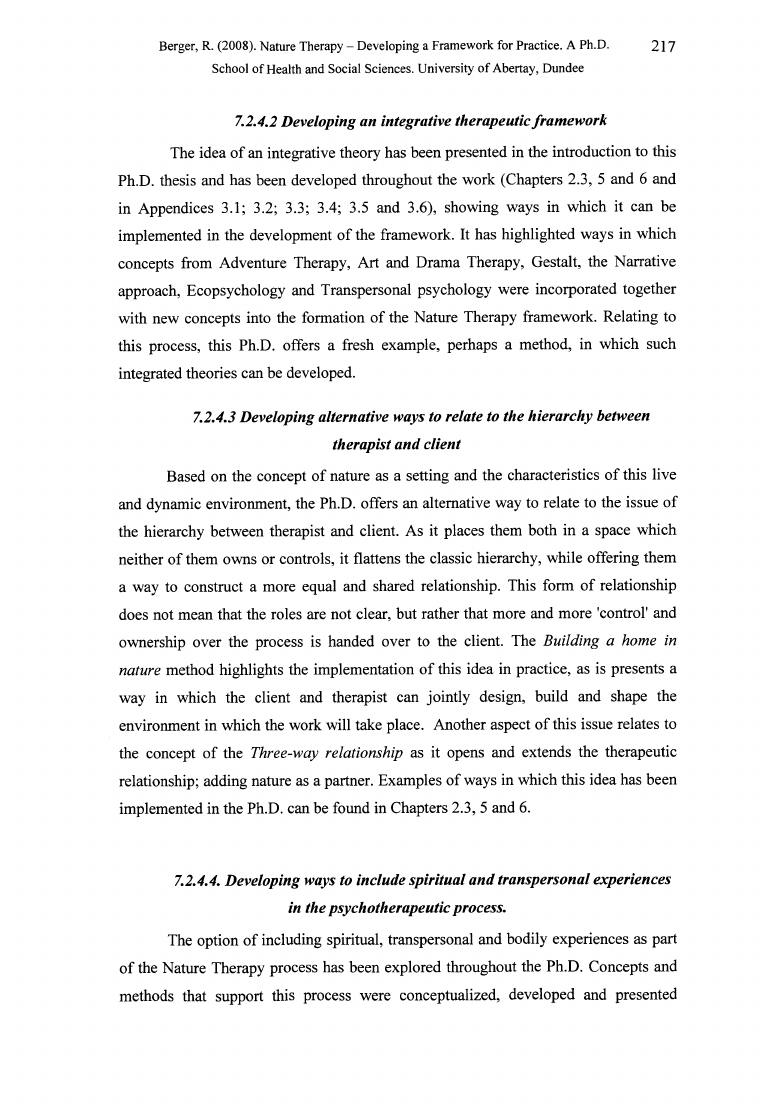
Berger, R. (2008). Nature Therapy - Developing a Framework for Practice. A Ph.D.
217
School of Health and Social Sciences. University of Abertay, Dundee
7.2.4.2 Developing an integrative therapeuticframework
The idea of an integrative theory has been presented in the introduction to this
Ph.D. thesis and has been developed throughout the work (Chapters 2.3, 5 and 6 and
in Appendices 3.1; 3.2; 3.3; 3.4; 3.5 and 3.6), showing ways in which it can be
implemented in the development of the framework. It has highlighted ways in which
concepts from Adventure Therapy, Art and Drama Therapy, Gestalt, the Narrative
approach, Ecopsychology and Transpersonal psychology were incorporated together
with new concepts into the formation of the Nature Therapy framework. Relating to
this process, this Ph.D. offers a fresh example, perhaps a method, in which such
integrated theories can be developed.
7.2.4.3 Developing alternative ways to relate to the hierarchy between
therapist and client
Based on the concept of nature as a setting and the characteristics of this live
and dynamic environment, the Ph.D. offers an alternative way to relate to the issue of
the hierarchy between therapist and client. As it places them both in a space which
neither of them owns or controls, it flattens the classic hierarchy, while offering them
a way to construct a more equal and shared relationship. This form of relationship
does not mean that the roles are not clear, but rather that more and more 'control' and
ownership over the process is handed over to the client. The Building a home in
nature method highlights the implementation of this idea in practice, as is presents a
way in which the client and therapist can jointly design, build and shape the
environment in which the work will take place. Another aspect of this issue relates to
the concept of the Three-way relationship as it opens and extends the therapeutic
relationship; adding nature as a partner. Examples of ways in which this idea has been
implemented in the Ph.D. can be found in Chapters 2.3, 5 and 6.
7.2.4.4. Developing ways to include spiritual and transpersonal experiences
in the psychotherapeutic process.
The option of including spiritual, transpersonal and bodily experiences as part
of the Nature Therapy process has been explored throughout the Ph.D. Concepts and
methods that support this process were conceptualized, developed and presented
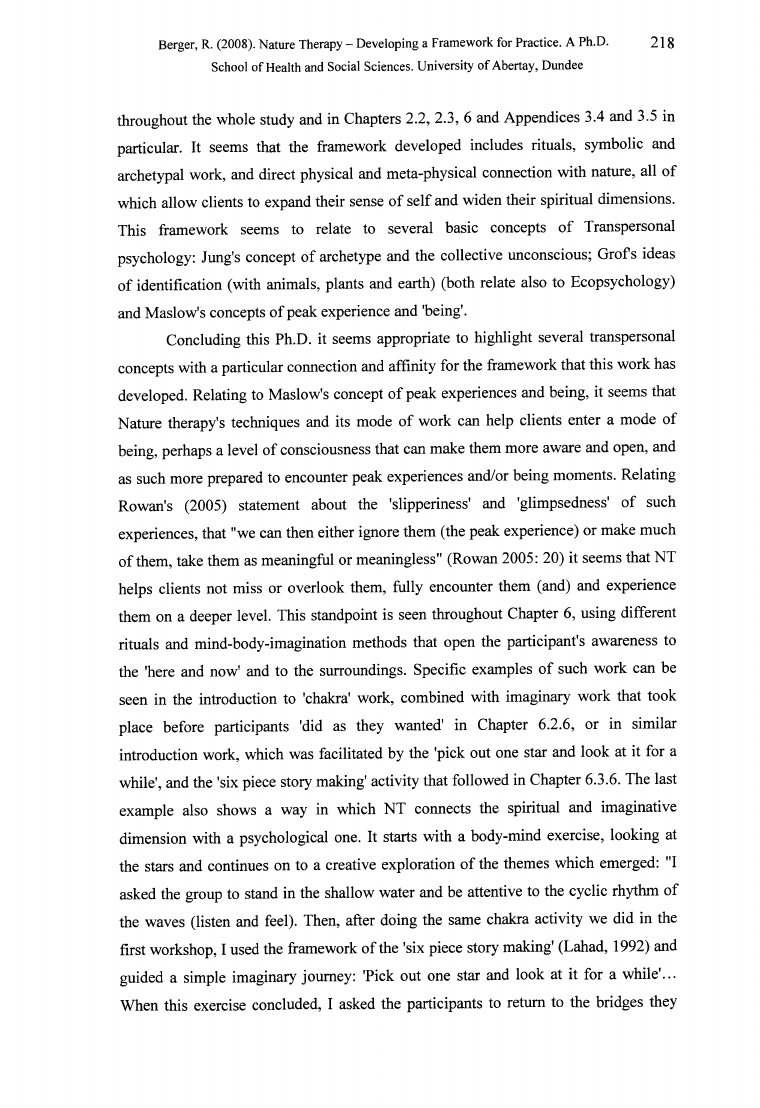
Berger, R. (2008). Nature Therapy - Developing a Framework for Practice. A Ph.D.
218
School of Health and Social Sciences. University of Abertay, Dundee
throughout the whole study and in Chapters 2.2, 2.3, 6 and Appendices 3.4 and 3.5 in
particular. It seems that the framework developed includes rituals, symbolic and
archetypal work, and direct physical and meta-physical connection with nature, all of
which allow clients to expand their sense of self and widen their spiritual dimensions.
This framework seems to relate to several basic concepts of Transpersonal
psychology: Jung's concept of archetype and the collective unconscious; Grofs ideas
of identification (with animals, plants and earth) (both relate also to Ecopsychology)
and Maslow's concepts of peak experience and 'being'.
Concluding this Ph.D. it seems appropriate to highlight several transpersonal
concepts with a particular connection and affinity for the framework that this work has
developed. Relating to Maslow's concept of peak experiences and being, it seems that
Nature therapy's techniques and its mode of work can help clients enter a mode of
being, perhaps a level of consciousness that can make them more aware and open, and
as such more prepared to encounter peak experiences and/or being moments. Relating
Rowan's (2005) statement about the 'slipperiness' and 'glimpsedness' of such
experiences, that "we can then either ignore them (the peak experience) or make much
of them, take them as meaningful or meaningless" (Rowan 2005: 20) it seems that NT
helps clients not miss or overlook them, fully encounter them (and) and experience
them on a deeper level. This standpoint is seen throughout Chapter 6, using different
rituals and mind-body-imagination methods that open the participant's awareness to
the 'here and now' and to the surroundings. Specific examples of such work can be
seen in the introduction to 'chakra' work, combined with imaginary work that took
place before participants 'did as they wanted' in Chapter 6.2.6, or in similar
introduction work, which was facilitated by the 'pick out one star and look at it for a
while', and the 'six piece story making' activity that followed in Chapter 6.3.6. The last
example also shows a way in which NT connects the spiritual and imaginative
dimension with a psychological one. It starts with a body-mind exercise, looking at
the stars and continues on to a creative exploration of the themes which emerged: "I
asked the group to stand in the shallow water and be attentive to the cyclic rhythm of
the waves (listen and feel). Then, after doing the same chakra activity we did in the
first workshop, I used the framework of the 'six piece story making' (Lahad, 1992) and
guided a simple imaginary journey: 'Pick out one star and look at it for a while'...
When this exercise concluded, I asked the participants to return to the bridges they

Berger, R. (2008). Nature Therapy - Developing a Framework for Practice. A Ph.D.
219
School of Health and Social Sciences. University of Abertay, Dundee
had built before and sit or stand next to them, imagine that the bridge on the sand is
symbolic of a bridge (or crossroads) which they have faced in their life (past, present
or future) and imagine themselves at this point. Then, they must use the elements
(sand and water) to create a three-dimensional representation relating to the six
questions I asked before. It seems that there is a strong therapeutic influence to this
transition between the spiritual-imaginative work with the stars to more personal-
psychological work - using story making to deal with personal and psychological
issues; moving from one dimension to another. It can be seen how the work (that was
presented before) contributed to Neil's psychological insights about his fresh
relationship: "During the night I tried very hard to build a bridge between the two
spaces (my space and my partner's space). Returning at sunrise opened the option o f
digging a tunnel as a way to connect the two spaces. The play in the sand opened this
new option as it helped me let go o f the previous plans". This element can be seen
also in Miriam's story (that followed Neil's work): "as I arrived in the morning I
realized that the work (the sculpture) was transformed. In the beginning I did not
understand it but then I realized that the tide has brought in sand that re-sculptured
my work. Now my work is to accept this change, from a slim girl to a pregnant
woman...". Miriam's story demonstrates the transpersonal potential that NT includes
in general, and the unique impact that the connection of the cycles of nature can have,
in particular. Neil and Miriam's stories also present ways in which creative, non
verbal work can support such a process, in general, and help people share experiences
which are difficult to express verbally. It seems important to say that it is not only the
methods and exercises NT uses but also the open mind and perhaps level of
consciousness of the therapist, as he not only acknowledges these experiences and
stories relating to them, but furthermore seeks to extend them and give them actuality.
This can be seen in Chapter 6.5.2, in the work that was developed around Rachel's
coincidental encounter with the dragonfly. This event demonstrates the way in which
the therapist held the magical event for the client and gave meaning to a potential peak
experience that the client might have overlooked and missed, due to her cynical
attitude towards spiritual and/or mystical experiences.
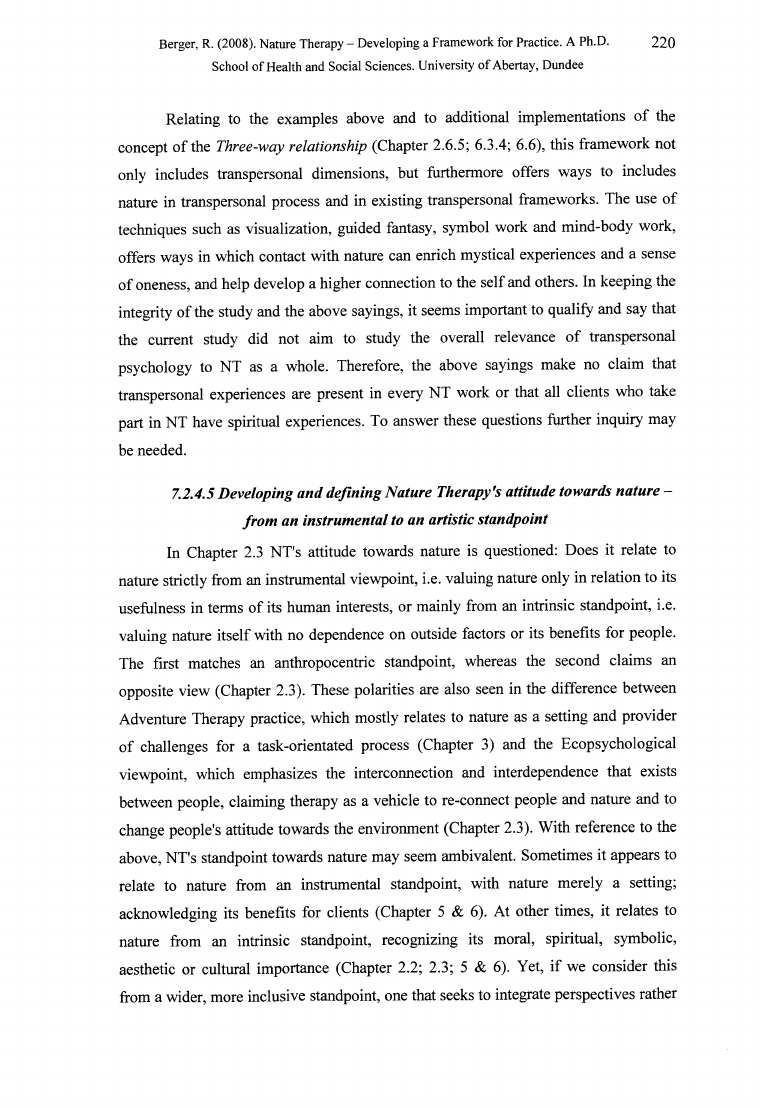
Berger, R. (2008). Nature Therapy - Developing a Framework for Practice. A Ph.D.
220
School of Health and Social Sciences. University of Abertay, Dundee
Relating to the examples above and to additional implementations of the
concept of the Three-way relationship (Chapter 2.6.5; 6.3.4; 6.6), this framework not
only includes transpersonal dimensions, but furthermore offers ways to includes
nature in transpersonal process and in existing transpersonal frameworks. The use of
techniques such as visualization, guided fantasy, symbol work and mind-body work,
offers ways in which contact with nature can enrich mystical experiences and a sense
of oneness, and help develop a higher connection to the self and others. In keeping the
integrity of the study and the above sayings, it seems important to qualify and say that
the current study did not aim to study the overall relevance of transpersonal
psychology to NT as a whole. Therefore, the above sayings make no claim that
transpersonal experiences are present in every NT work or that all clients who take
part in NT have spiritual experiences. To answer these questions further inquiry may
be needed.
7.2.4.5 Developing and defining Nature Therapy fs attitude towards nature -
front an instrumental to an artistic standpoint
In Chapter 2.3 NT's attitude towards nature is questioned: Does it relate to
nature strictly from an instrumental viewpoint, i.e. valuing nature only in relation to its
usefulness in terms of its human interests, or mainly from an intrinsic standpoint, i.e.
valuing nature itself with no dependence on outside factors or its benefits for people.
The first matches an anthropocentric standpoint, whereas the second claims an
opposite view (Chapter 2.3). These polarities are also seen in the difference between
Adventure Therapy practice, which mostly relates to nature as a setting and provider
of challenges for a task-orientated process (Chapter 3) and the Ecopsychological
viewpoint, which emphasizes the interconnection and interdependence that exists
between people, claiming therapy as a vehicle to re-connect people and nature and to
change people's attitude towards the environment (Chapter 2.3). With reference to the
above, NT's standpoint towards nature may seem ambivalent. Sometimes it appears to
relate to nature from an instrumental standpoint, with nature merely a setting;
acknowledging its benefits for clients (Chapter 5 & 6). At other times, it relates to
nature from an intrinsic standpoint, recognizing its moral, spiritual, symbolic,
aesthetic or cultural importance (Chapter 2.2; 2.3; 5 & 6). Yet, if we consider this
from a wider, more inclusive standpoint, one that seeks to integrate perspectives rather
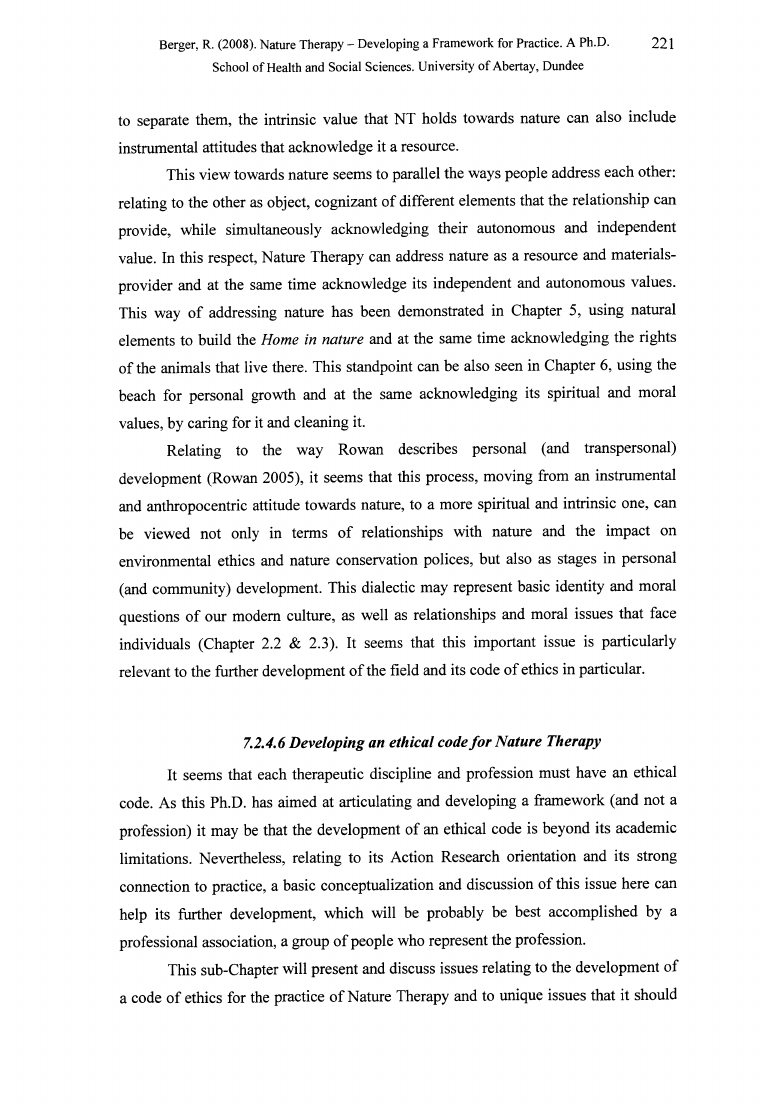
Berger, R. (2008). Nature Therapy - Developing a Framework for Practice. A Ph.D.
221
School of Health and Social Sciences. University of Abertay, Dundee
to separate them, the intrinsic value that NT holds towards nature can also include
instrumental attitudes that acknowledge it a resource.
This view towards nature seems to parallel the ways people address each other:
relating to the other as object, cognizant of different elements that the relationship can
provide, while simultaneously acknowledging their autonomous and independent
value. In this respect, Nature Therapy can address nature as a resource and materials-
provider and at the same time acknowledge its independent and autonomous values.
This way of addressing nature has been demonstrated in Chapter 5, using natural
elements to build the Home in nature and at the same time acknowledging the rights
of the animals that live there. This standpoint can be also seen in Chapter 6, using the
beach for personal growth and at the same acknowledging its spiritual and moral
values, by caring for it and cleaning it.
Relating to the way Rowan describes personal (and transpersonal)
development (Rowan 2005), it seems that this process, moving from an instrumental
and anthropocentric attitude towards nature, to a more spiritual and intrinsic one, can
be viewed not only in terms of relationships with nature and the impact on
environmental ethics and nature conservation polices, but also as stages in personal
(and community) development. This dialectic may represent basic identity and moral
questions of our modem culture, as well as relationships and moral issues that face
individuals (Chapter 2.2 & 2.3). It seems that this important issue is particularly
relevant to the further development of the field and its code of ethics in particular.
7.2.4.6 Developing an ethical codefo r Nature Therapy
It seems that each therapeutic discipline and profession must have an ethical
code. As this Ph.D. has aimed at articulating and developing a framework (and not a
profession) it may be that the development of an ethical code is beyond its academic
limitations. Nevertheless, relating to its Action Research orientation and its strong
connection to practice, a basic conceptualization and discussion of this issue here can
help its further development, which will be probably be best accomplished by a
professional association, a group of people who represent the profession.
This sub-Chapter will present and discuss issues relating to the development of
a code of ethics for the practice of Nature Therapy and to unique issues that it should
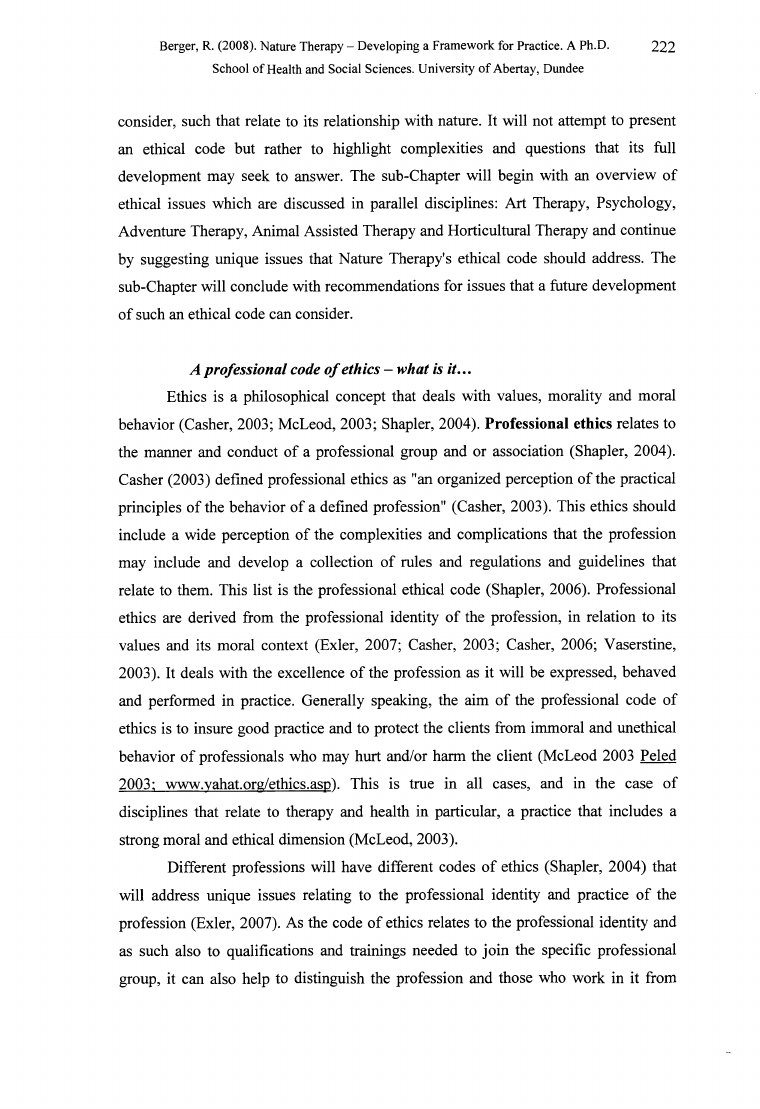
Berger, R. (2008). Nature Therapy - Developing a Framework for Practice. A Ph.D.
222
School of Health and Social Sciences. University of Abertay, Dundee
consider, such that relate to its relationship with nature. It will not attempt to present
an ethical code but rather to highlight complexities and questions that its full
development may seek to answer. The sub-Chapter will begin with an overview of
ethical issues which are discussed in parallel disciplines: Art Therapy, Psychology,
Adventure Therapy, Animal Assisted Therapy and Horticultural Therapy and continue
by suggesting unique issues that Nature Therapy's ethical code should address. The
sub-Chapter will conclude with recommendations for issues that a future development
of such an ethical code can consider.
A professional code o f ethics - what is it...
Ethics is a philosophical concept that deals with values, morality and moral
behavior (Casher, 2003; McLeod, 2003; Shapler, 2004). Professional ethics relates to
the manner and conduct of a professional group and or association (Shapler, 2004).
Casher (2003) defined professional ethics as "an organized perception of the practical
principles of the behavior of a defined profession" (Casher, 2003). This ethics should
include a wide perception of the complexities and complications that the profession
may include and develop a collection of rules and regulations and guidelines that
relate to them. This list is the professional ethical code (Shapler, 2006). Professional
ethics are derived from the professional identity of the profession, in relation to its
values and its moral context (Exler, 2007; Casher, 2003; Casher, 2006; Vaserstine,
2003). It deals with the excellence of the profession as it will be expressed, behaved
and performed in practice. Generally speaking, the aim of the professional code of
ethics is to insure good practice and to protect the clients from immoral and unethical
behavior of professionals who may hurt and/or harm the client (McLeod 2003 Peled
2003: www.vahat.org/ethics.asp). This is true in all cases, and in the case of
disciplines that relate to therapy and health in particular, a practice that includes a
strong moral and ethical dimension (McLeod, 2003).
Different professions will have different codes of ethics (Shapler, 2004) that
will address unique issues relating to the professional identity and practice of the
profession (Exler, 2007). As the code of ethics relates to the professional identity and
as such also to qualifications and trainings needed to join the specific professional
group, it can also help to distinguish the profession and those who work in it from
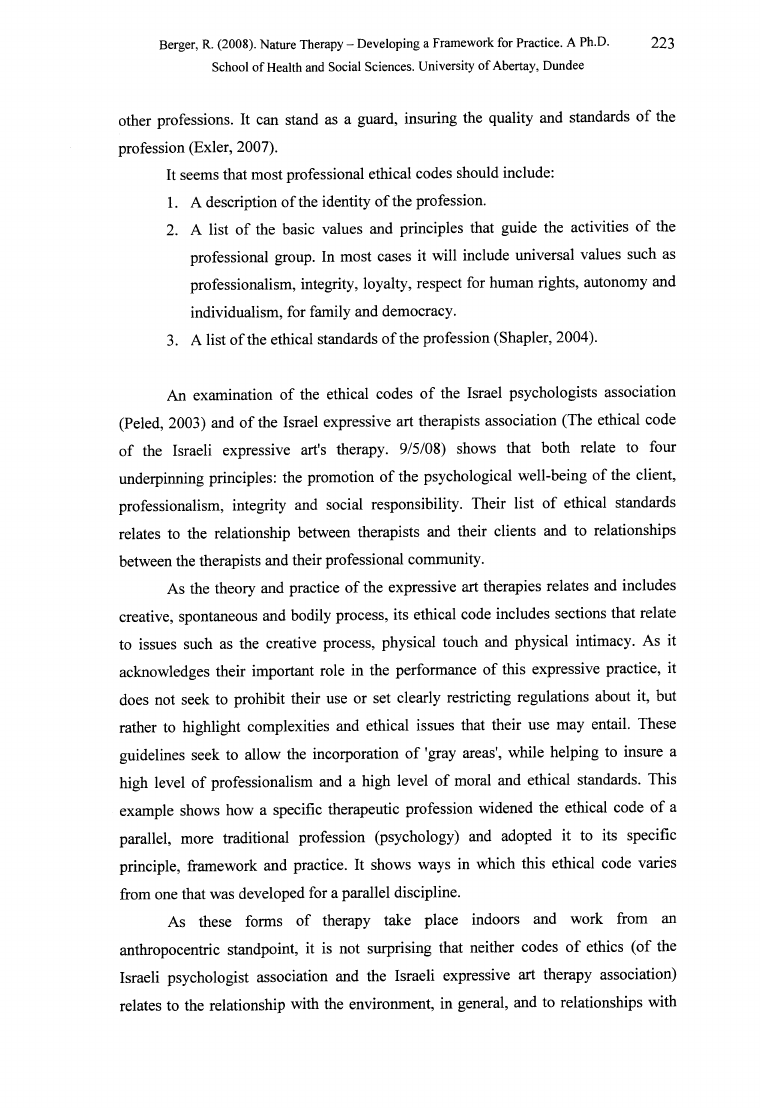
Berger, R. (2008). Nature Therapy - Developing a Framework for Practice. A Ph.D.
223
School of Health and Social Sciences. University of Abertay, Dundee
other professions. It can stand as a guard, insuring the quality and standards of the
profession (Exler, 2007).
It seems that most professional ethical codes should include:
1. A description of the identity of the profession.
2. A list of the basic values and principles that guide the activities of the
professional group. In most cases it will include universal values such as
professionalism, integrity, loyalty, respect for human rights, autonomy and
individualism, for family and democracy.
3. A list of the ethical standards of the profession (Shapler, 2004).
An examination of the ethical codes of the Israel psychologists association
(Peled, 2003) and of the Israel expressive art therapists association (The ethical code
of the Israeli expressive art's therapy. 9/5/08) shows that both relate to four
underpinning principles: the promotion of the psychological well-being of the client,
professionalism, integrity and social responsibility. Their list of ethical standards
relates to the relationship between therapists and their clients and to relationships
between the therapists and their professional community.
As the theory and practice of the expressive art therapies relates and includes
creative, spontaneous and bodily process, its ethical code includes sections that relate
to issues such as the creative process, physical touch and physical intimacy. As it
acknowledges their important role in the performance of this expressive practice, it
does not seek to prohibit their use or set clearly restricting regulations about it, but
rather to highlight complexities and ethical issues that their use may entail. These
guidelines seek to allow the incorporation of 'gray areas', while helping to insure a
high level of professionalism and a high level of moral and ethical standards. This
example shows how a specific therapeutic profession widened the ethical code of a
parallel, more traditional profession (psychology) and adopted it to its specific
principle, framework and practice. It shows ways in which this ethical code varies
from one that was developed for a parallel discipline.
As these forms of therapy take place indoors and work from an
anthropocentric standpoint, it is not surprising that neither codes of ethics (of the
Israeli psychologist association and the Israeli expressive art therapy association)
relates to the relationship with the environment, in general, and to relationships with
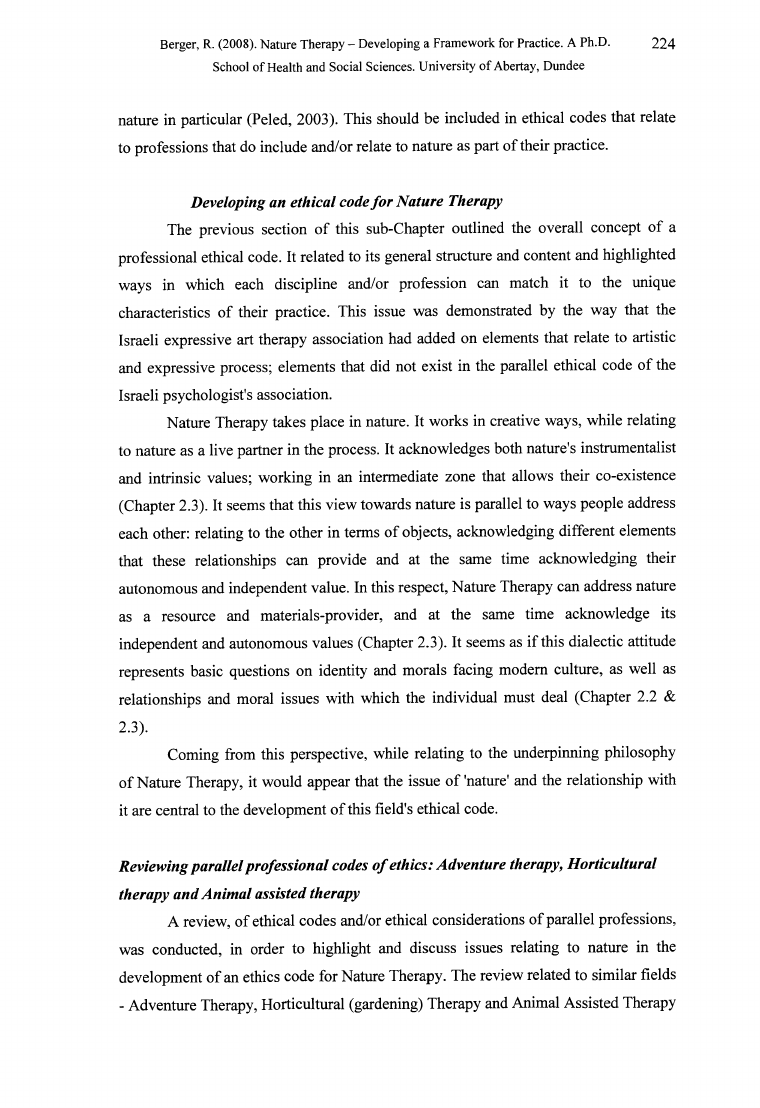
Berger, R. (2008). Nature Therapy - Developing a Framework for Practice. A Ph.D.
224
School of Health and Social Sciences. University of Abertay, Dundee
nature in particular (Peled, 2003). This should be included in ethical codes that relate
to professions that do include and/or relate to nature as part of their practice.
Developing an ethical codefo r Nature Therapy
The previous section of this sub-Chapter outlined the overall concept of a
professional ethical code. It related to its general structure and content and highlighted
ways in which each discipline and/or profession can match it to the unique
characteristics of their practice. This issue was demonstrated by the way that the
Israeli expressive art therapy association had added on elements that relate to artistic
and expressive process; elements that did not exist in the parallel ethical code of the
Israeli psychologist's association.
Nature Therapy takes place in nature. It works in creative ways, while relating
to nature as a live partner in the process. It acknowledges both nature's instrumentalist
and intrinsic values; working in an intermediate zone that allows their co-existence
(Chapter 2.3). It seems that this view towards nature is parallel to ways people address
each other: relating to the other in terms of objects, acknowledging different elements
that these relationships can provide and at the same time acknowledging their
autonomous and independent value. In this respect, Nature Therapy can address nature
as a resource and materials-provider, and at the same time acknowledge its
independent and autonomous values (Chapter 2.3). It seems as if this dialectic attitude
represents basic questions on identity and morals facing modem culture, as well as
relationships and moral issues with which the individual must deal (Chapter 2.2 &
2.3).
Coming from this perspective, while relating to the underpinning philosophy
of Nature Therapy, it would appear that the issue of 'nature' and the relationship with
it are central to the development of this field's ethical code.
Reviewing parallel professional codes o f ethics: Adventure therapy, Horticultural
therapy and Animal assisted therapy
A review, of ethical codes and/or ethical considerations of parallel professions,
was conducted, in order to highlight and discuss issues relating to nature in the
development of an ethics code for Nature Therapy. The review related to similar fields
- Adventure Therapy, Horticultural (gardening) Therapy and Animal Assisted Therapy
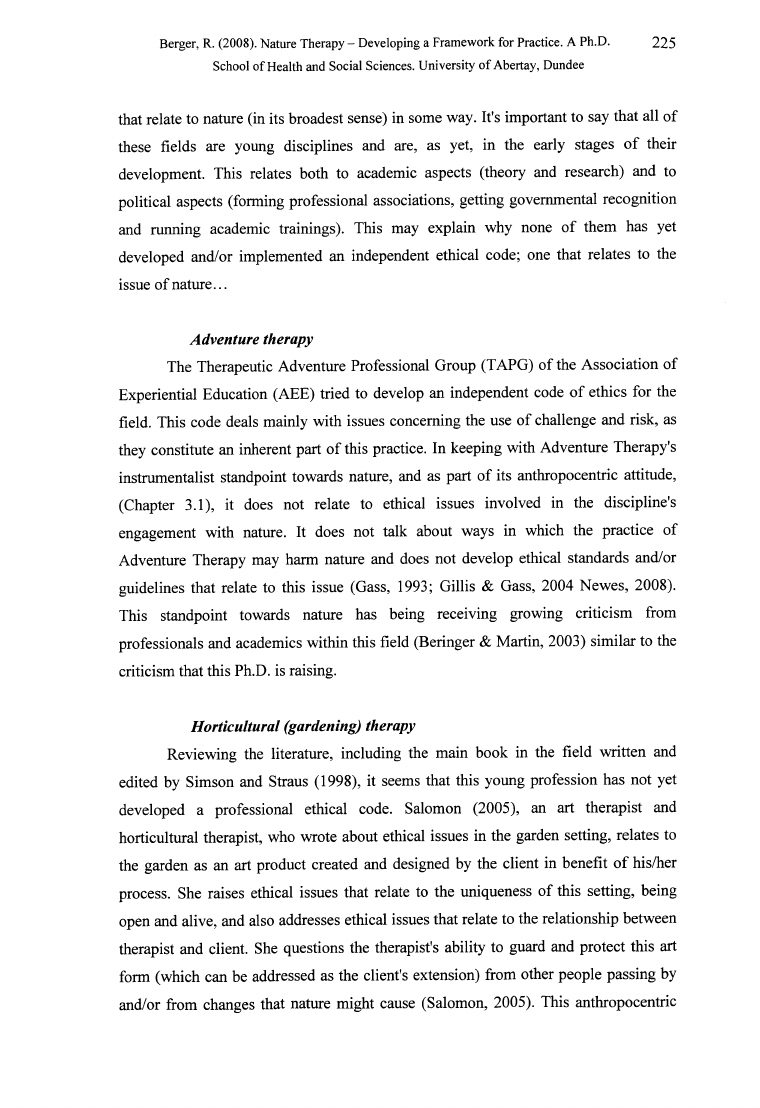
Berger, R. (2008). Nature Therapy - Developing a Framework for Practice. A Ph.D.
225
School of Health and Social Sciences. University of Abertay, Dundee
that relate to nature (in its broadest sense) in some way. It's important to say that all of
these fields are young disciplines and are, as yet, in the early stages of their
development. This relates both to academic aspects (theory and research) and to
political aspects (forming professional associations, getting governmental recognition
and running academic trainings). This may explain why none of them has yet
developed and/or implemented an independent ethical code; one that relates to the
issue of nature...
Adventure therapy
The Therapeutic Adventure Professional Group (TAPG) of the Association of
Experiential Education (AEE) tried to develop an independent code of ethics for the
field. This code deals mainly with issues concerning the use of challenge and risk, as
they constitute an inherent part of this practice. In keeping with Adventure Therapy's
instrumentalist standpoint towards nature, and as part of its anthropocentric attitude,
(Chapter 3.1), it does not relate to ethical issues involved in the discipline's
engagement with nature. It does not talk about ways in which the practice of
Adventure Therapy may harm nature and does not develop ethical standards and/or
guidelines that relate to this issue (Gass, 1993; Gillis & Gass, 2004 Newes, 2008).
This standpoint towards nature has being receiving growing criticism from
professionals and academics within this field (Beringer & Martin, 2003) similar to the
criticism that this Ph.D. is raising.
Horticultural (gardening) therapy
Reviewing the literature, including the main book in the field written and
edited by Simson and Straus (1998), it seems that this young profession has not yet
developed a professional ethical code. Salomon (2005), an art therapist and
horticultural therapist, who wrote about ethical issues in the garden setting, relates to
the garden as an art product created and designed by the client in benefit of his/her
process. She raises ethical issues that relate to the uniqueness of this setting, being
open and alive, and also addresses ethical issues that relate to the relationship between
therapist and client. She questions the therapist's ability to guard and protect this art
form (which can be addressed as the client's extension) from other people passing by
and/or from changes that nature might cause (Salomon, 2005). This anthropocentric
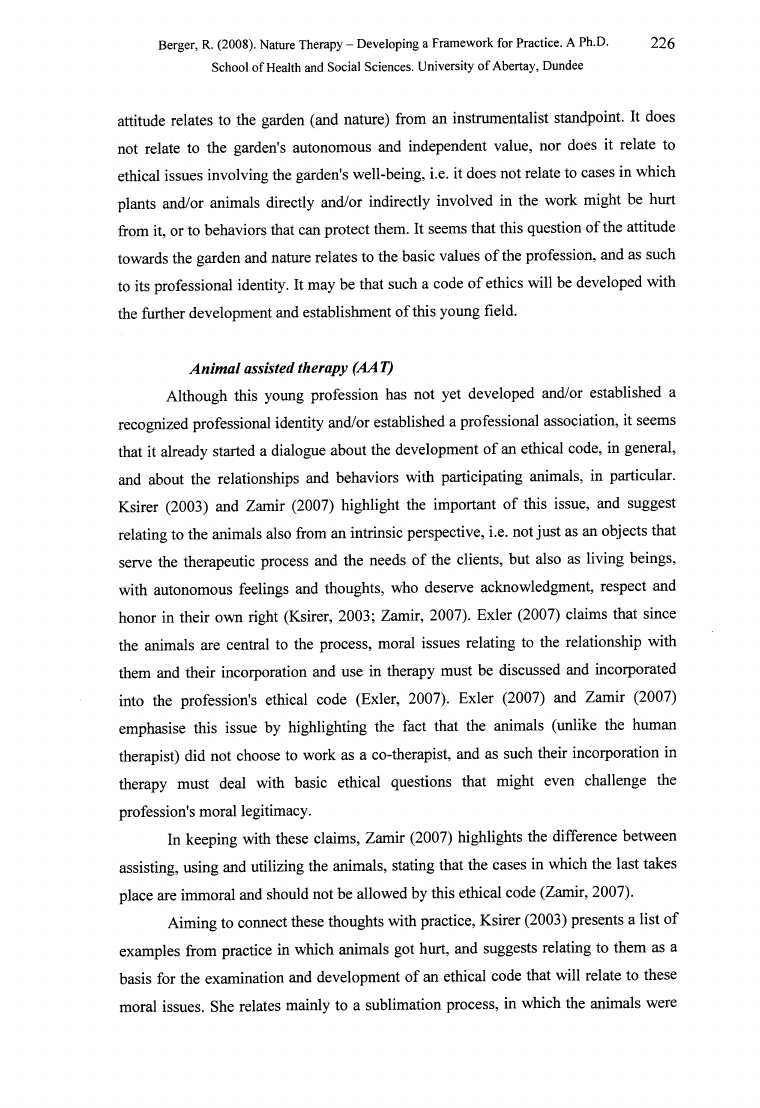
Berger, R. (2008). Nature Therapy - Developing a Framework for Practice. A Ph.D.
226
School of Health and Social Sciences. University of Abertay, Dundee
attitude relates to the garden (and nature) from an instrumentalist standpoint. It does
not relate to the garden's autonomous and independent value, nor does it relate to
ethical issues involving the garden's well-being, i.e. it does not relate to cases in which
plants and/or animals directly and/or indirectly involved in the work might be hurt
from it, or to behaviors that can protect them. It seems that this question of the attitude
towards the garden and nature relates to the basic values of the profession, and as such
to its professional identity. It may be that such a code of ethics will be developed with
the further development and establishment of this young field.
Animal assisted therapy (AAT)
Although this young profession has not yet developed and/or established a
recognized professional identity and/or established a professional association, it seems
that it already started a dialogue about the development of an ethical code, in general,
and about the relationships and behaviors with participating animals, in particular.
Ksirer (2003) and Zamir (2007) highlight the important of this issue, and suggest
relating to the animals also from an intrinsic perspective, i.e. not just as an objects that
serve the therapeutic process and the needs of the clients, but also as living beings,
with autonomous feelings and thoughts, who deserve acknowledgment, respect and
honor in their own right (Ksirer, 2003; Zamir, 2007). Exler (2007) claims that since
the animals are central to the process, moral issues relating to the relationship with
them and their incorporation and use in therapy must be discussed and incorporated
into the profession's ethical code (Exler, 2007). Exler (2007) and Zamir (2007)
emphasise this issue by highlighting the fact that the animals (unlike the human
therapist) did not choose to work as a co-therapist, and as such their incorporation in
therapy must deal with basic ethical questions that might even challenge the
profession's moral legitimacy.
In keeping with these claims, Zamir (2007) highlights the difference between
assisting, using and utilizing the animals, stating that the cases in which the last takes
place are immoral and should not be allowed by this ethical code (Zamir, 2007).
Aiming to connect these thoughts with practice, Ksirer (2003) presents a list of
examples from practice in which animals got hurt, and suggests relating to them as a
basis for the examination and development of an ethical code that will relate to these
moral issues. She relates mainly to a sublimation process, in which the animals were
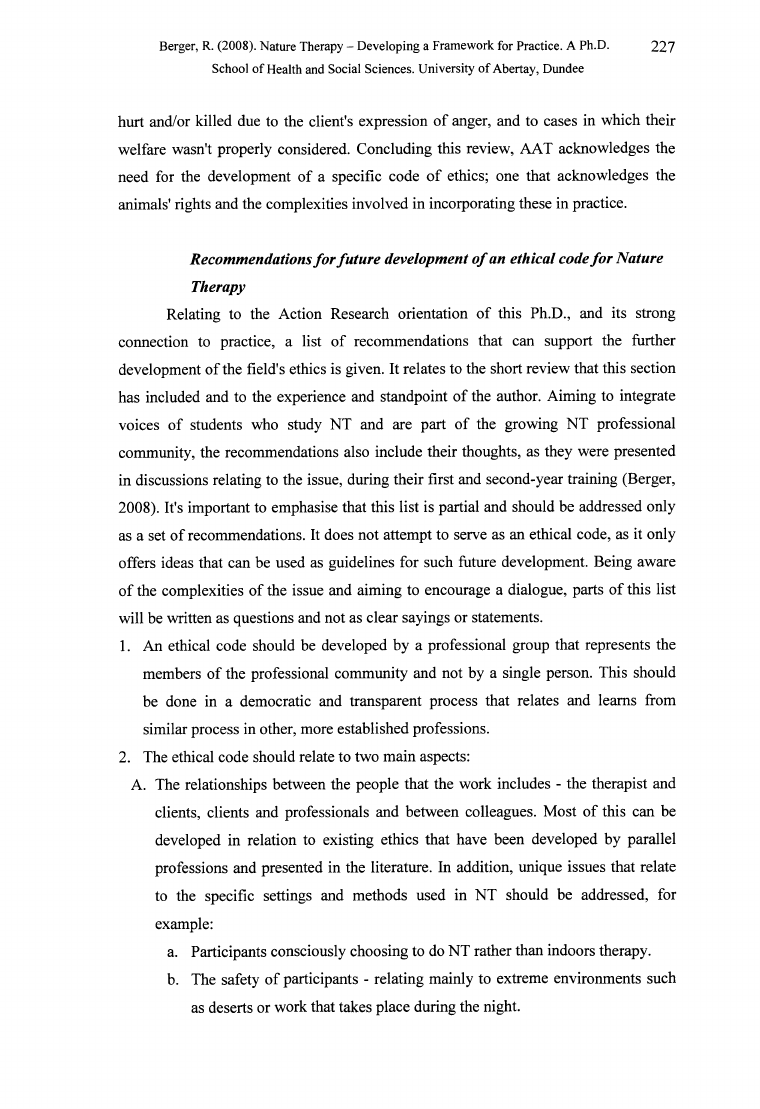
Berger, R. (2008). Nature Therapy - Developing a Framework for Practice. A Ph.D.
227
School of Health and Social Sciences. University of Abertay, Dundee
hurt and/or killed due to the client's expression of anger, and to cases in which their
welfare wasn't properly considered. Concluding this review, AAT acknowledges the
need for the development of a specific code of ethics; one that acknowledges the
animals' rights and the complexities involved in incorporating these in practice.
Recommendationsfo r future development o f an ethical codefo r Nature
Therapy
Relating to the Action Research orientation of this Ph.D., and its strong
connection to practice, a list of recommendations that can support the further
development of the field's ethics is given. It relates to the short review that this section
has included and to the experience and standpoint of the author. Aiming to integrate
voices of students who study NT and are part of the growing NT professional
community, the recommendations also include their thoughts, as they were presented
in discussions relating to the issue, during their first and second-year training (Berger,
2008). It's important to emphasise that this list is partial and should be addressed only
as a set of recommendations. It does not attempt to serve as an ethical code, as it only
offers ideas that can be used as guidelines for such future development. Being aware
of the complexities of the issue and aiming to encourage a dialogue, parts of this list
will be written as questions and not as clear sayings or statements.
1. An ethical code should be developed by a professional group that represents the
members of the professional community and not by a single person. This should
be done in a democratic and transparent process that relates and learns from
similar process in other, more established professions.
2. The ethical code should relate to two main aspects:
A. The relationships between the people that the work includes - the therapist and
clients, clients and professionals and between colleagues. Most of this can be
developed in relation to existing ethics that have been developed by parallel
professions and presented in the literature. In addition, unique issues that relate
to the specific settings and methods used in NT should be addressed, for
example:
a. Participants consciously choosing to do NT rather than indoors therapy.
b. The safety of participants - relating mainly to extreme environments such
as deserts or work that takes place during the night.
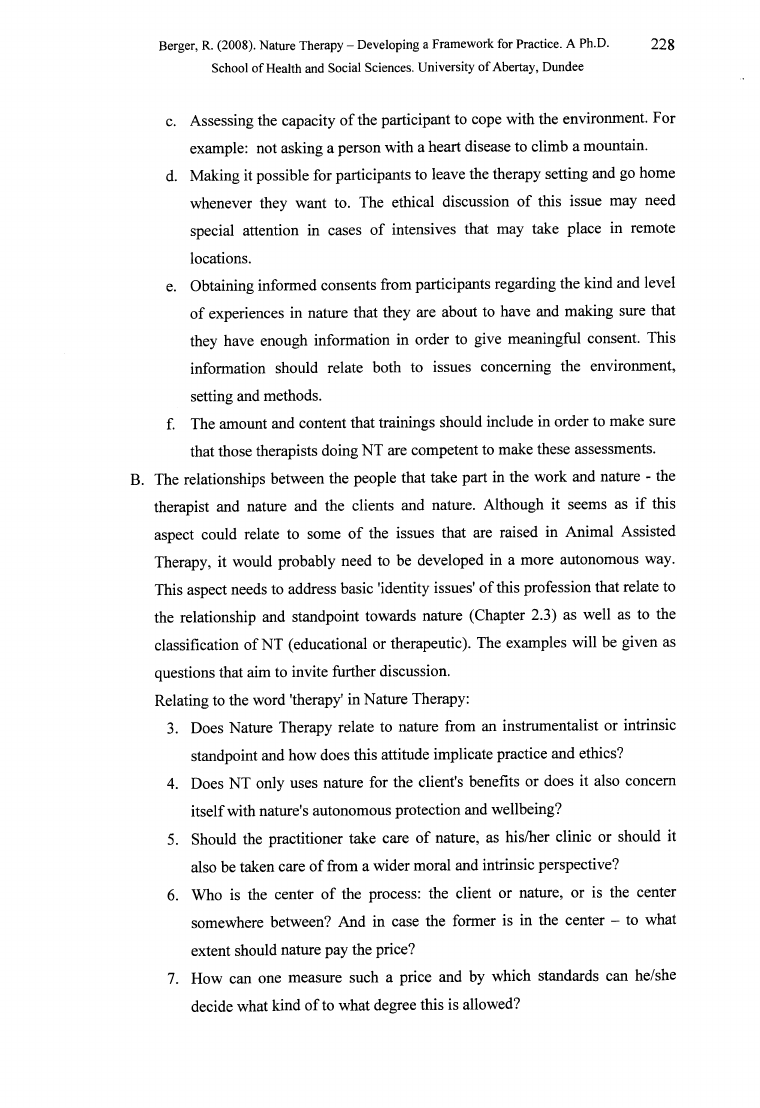
Berger, R. (2008). Nature Therapy - Developing a Framework for Practice. A Ph.D.
228
School of Health and Social Sciences. University of Abertay, Dundee
c. Assessing the capacity of the participant to cope with the environment. For
example: not asking a person with a heart disease to climb a mountain.
d. Making it possible for participants to leave the therapy setting and go home
whenever they want to. The ethical discussion of this issue may need
special attention in cases of intensives that may take place in remote
locations.
e. Obtaining informed consents from participants regarding the kind and level
of experiences in nature that they are about to have and making sure that
they have enough information in order to give meaningful consent. This
information should relate both to issues concerning the environment,
setting and methods.
f. The amount and content that trainings should include in order to make sure
that those therapists doing NT are competent to make these assessments.
B. The relationships between the people that take part in the work and nature - the
therapist and nature and the clients and nature. Although it seems as if this
aspect could relate to some of the issues that are raised in Animal Assisted
Therapy, it would probably need to be developed in a more autonomous way.
This aspect needs to address basic 'identity issues' of this profession that relate to
the relationship and standpoint towards nature (Chapter 2.3) as well as to the
classification of NT (educational or therapeutic). The examples will be given as
questions that aim to invite further discussion.
Relating to the word 'therapy' in Nature Therapy:
3. Does Nature Therapy relate to nature from an instrumentalist or intrinsic
standpoint and how does this attitude implicate practice and ethics?
4. Does NT only uses nature for the client's benefits or does it also concern
itself with nature's autonomous protection and wellbeing?
5. Should the practitioner take care of nature, as his/her clinic or should it
also be taken care of from a wider moral and intrinsic perspective?
6. Who is the center of the process: the client or nature, or is the center
somewhere between? And in case the former is in the center - to what
extent should nature pay the price?
7. How can one measure such a price and by which standards can he/she
decide what kind of to what degree this is allowed?
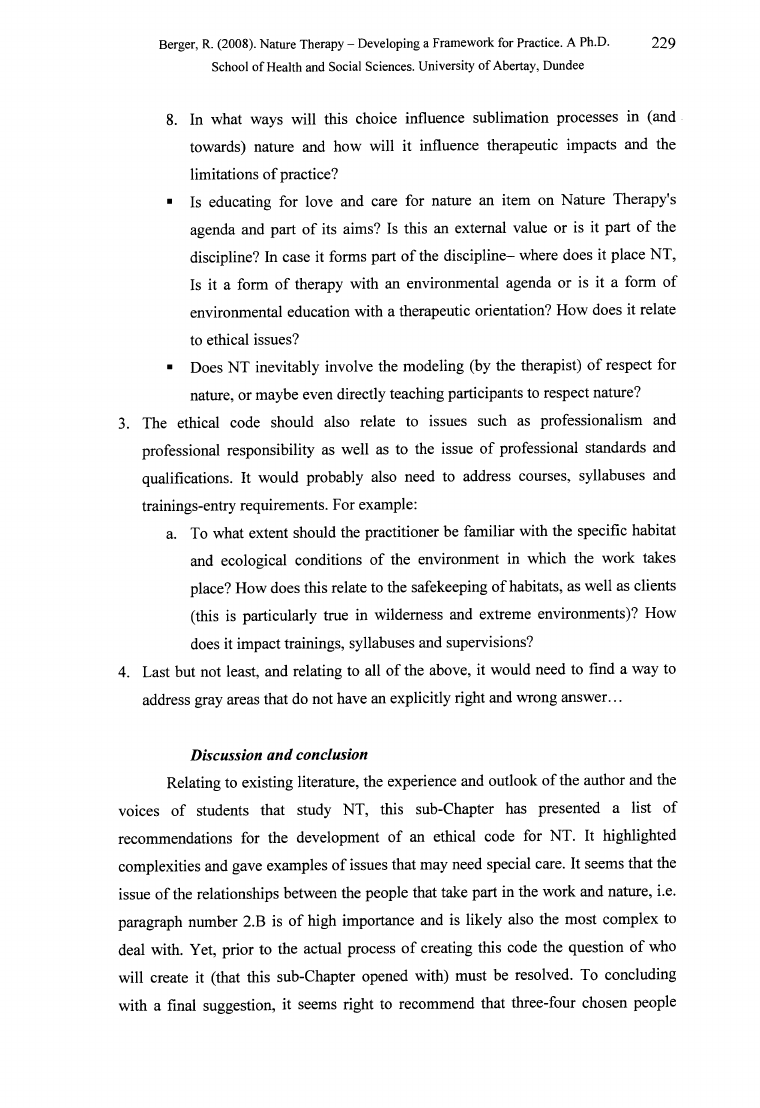
Berger, R. (2008). Nature Therapy - Developing a Framework for Practice. A Ph.D.
229
School of Health and Social Sciences. University of Abertay, Dundee
8. In what ways will this choice influence sublimation processes in (and
towards) nature and how will it influence therapeutic impacts and the
limitations of practice?
■ Is educating for love and care for nature an item on Nature Therapy's
agenda and part of its aims? Is this an external value or is it part of the
discipline? In case it forms part of the discipline- where does it place NT,
Is it a form of therapy with an environmental agenda or is it a form of
environmental education with a therapeutic orientation? How does it relate
to ethical issues?
■ Does NT inevitably involve the modeling (by the therapist) of respect for
nature, or maybe even directly teaching participants to respect nature?
3. The ethical code should also relate to issues such as professionalism and
professional responsibility as well as to the issue of professional standards and
qualifications. It would probably also need to address courses, syllabuses and
trainings-entry requirements. For example:
a. To what extent should the practitioner be familiar with the specific habitat
and ecological conditions of the environment in which the work takes
place? How does this relate to the safekeeping of habitats, as well as clients
(this is particularly true in wilderness and extreme environments)? How
does it impact trainings, syllabuses and supervisions?
4. Last but not least, and relating to all of the above, it would need to find a way to
address gray areas that do not have an explicitly right and wrong answer...
Discussion and conclusion
Relating to existing literature, the experience and outlook of the author and the
voices of students that study NT, this sub-Chapter has presented a list of
recommendations for the development of an ethical code for NT. It highlighted
complexities and gave examples of issues that may need special care. It seems that the
issue of the relationships between the people that take part in the work and nature, i.e.
paragraph number 2.B is of high importance and is likely also the most complex to
deal with. Yet, prior to the actual process of creating this code the question of who
will create it (that this sub-Chapter opened with) must be resolved. To concluding
with a final suggestion, it seems right to recommend that three-four chosen people
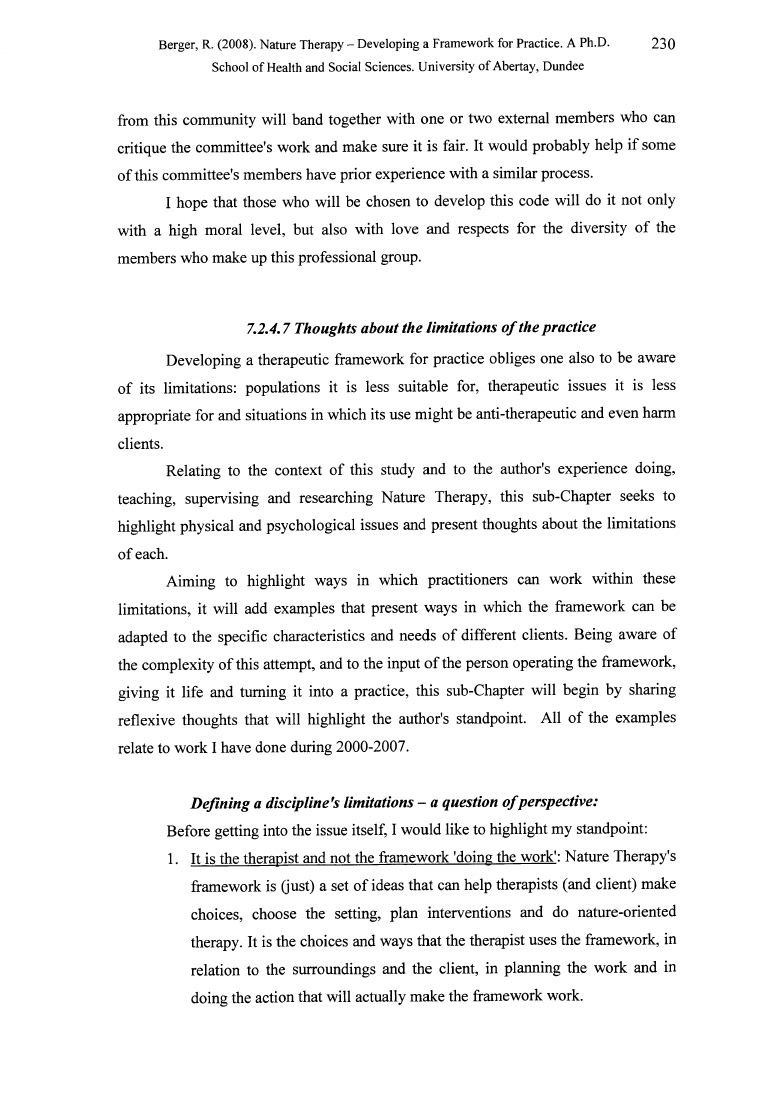
Berger, R. (2008). Nature Therapy - Developing a Framework for Practice. A Ph.D.
230
School of Health and Social Sciences. University of Abertay, Dundee
from this community will band together with one or two external members who can
critique the committee's work and make sure it is fair. It would probably help if some
of this committee's members have prior experience with a similar process.
I hope that those who will be chosen to develop this code will do it not only
with a high moral level, but also with love and respects for the diversity of the
members who make up this professional group.
7.2.4.7 Thoughts about the limitations o f the practice
Developing a therapeutic framework for practice obliges one also to be aware
of its limitations: populations it is less suitable for, therapeutic issues it is less
appropriate for and situations in which its use might be anti-therapeutic and even harm
clients.
Relating to the context of this study and to the author's experience doing,
teaching, supervising and researching Nature Therapy, this sub-Chapter seeks to
highlight physical and psychological issues and present thoughts about the limitations
of each.
Aiming to highlight ways in which practitioners can work within these
limitations, it will add examples that present ways in which the framework can be
adapted to the specific characteristics and needs of different clients. Being aware of
the complexity of this attempt, and to the input of the person operating the framework,
giving it life and turning it into a practice, this sub-Chapter will begin by sharing
reflexive thoughts that will highlight the author's standpoint. All of the examples
relate to work I have done during 2000-2007.
Defining a discipline's limitations - a question o fperspective:
Before getting into the issue itself, I would like to highlight my standpoint:
1. It is the therapist and not the framework 'doing the work': Nature Therapy's
framework is (just) a set of ideas that can help therapists (and client) make
choices, choose the setting, plan interventions and do nature-oriented
therapy. It is the choices and ways that the therapist uses the framework, in
relation to the surroundings and the client, in planning the work and in
doing the action that will actually make the framework work.
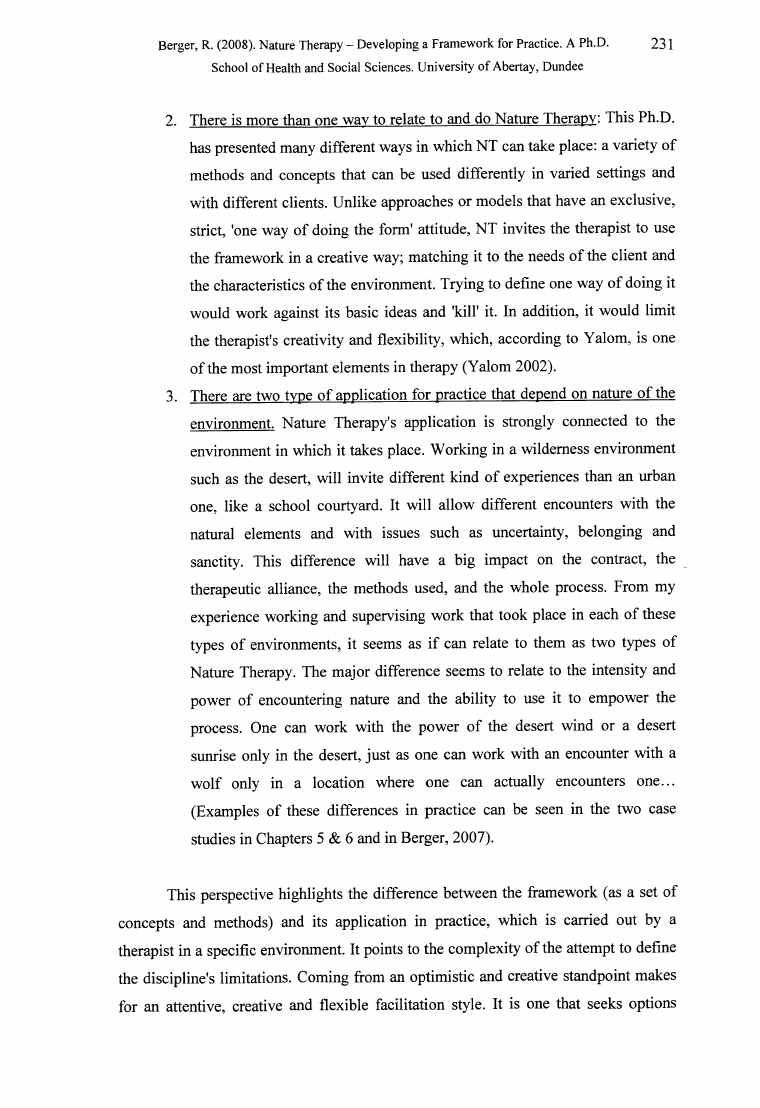
Berger, R. (2008). Nature Therapy - Developing a Framework for Practice. A Ph.D.
231
School of Health and Social Sciences. University of Abertay, Dundee
2. There is more than one wav to relate to and do Nature Therapy: This Ph.D.
has presented many different ways in which NT can take place: a variety of
methods and concepts that can be used differently in varied settings and
with different clients. Unlike approaches or models that have an exclusive,
strict, 'one way of doing the form' attitude, NT invites the therapist to use
the framework in a creative way; matching it to the needs of the client and
the characteristics of the environment. Trying to define one way of doing it
would work against its basic ideas and 'kill' it. In addition, it would limit
the therapist's creativity and flexibility, which, according to Yalom, is one
of the most important elements in therapy (Yalom 2002).
3. There are two type of application for practice that depend on nature of the
environment. Nature Therapy's application is strongly connected to the
environment in which it takes place. Working in a wilderness environment
such as the desert, will invite different kind of experiences than an urban
one, like a school courtyard. It will allow different encounters with the
natural elements and with issues such as uncertainty, belonging and
sanctity. This difference will have a big impact on the contract, the
therapeutic alliance, the methods used, and the whole process. From my
experience working and supervising work that took place in each of these
types of environments, it seems as if can relate to them as two types of
Nature Therapy. The major difference seems to relate to the intensity and
power of encountering nature and the ability to use it to empower the
process. One can work with the power of the desert wind or a desert
sunrise only in the desert, just as one can work with an encounter with a
wolf only in a location where one can actually encounters one...
(Examples of these differences in practice can be seen in the two case
studies in Chapters 5 & 6 and in Berger, 2007).
This perspective highlights the difference between the framework (as a set of
concepts and methods) and its application in practice, which is carried out by a
therapist in a specific environment. It points to the complexity of the attempt to define
the discipline's limitations. Coming from an optimistic and creative standpoint makes
for an attentive, creative and flexible facilitation style. It is one that seeks options
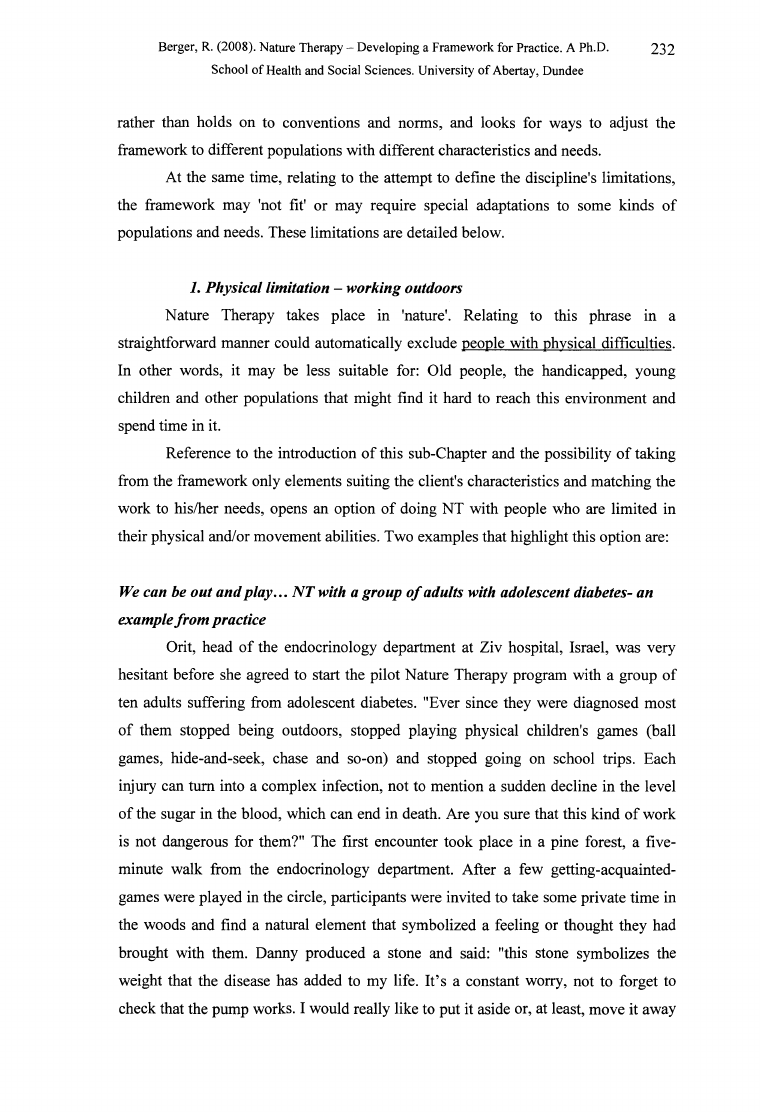
Berger, R. (2008). Nature Therapy - Developing a Framework for Practice. A Ph.D.
232
School of Health and Social Sciences. University of Abertay, Dundee
rather than holds on to conventions and norms, and looks for ways to adjust the
framework to different populations with different characteristics and needs.
At the same time, relating to the attempt to define the discipline's limitations,
the framework may 'not fit' or may require special adaptations to some kinds of
populations and needs. These limitations are detailed below.
1. Physical limitation - working outdoors
Nature Therapy takes place in 'nature'. Relating to this phrase in a
straightforward manner could automatically exclude people with physical difficulties.
In other words, it may be less suitable for: Old people, the handicapped, young
children and other populations that might find it hard to reach this environment and
spend time in it.
Reference to the introduction of this sub-Chapter and the possibility of taking
from the framework only elements suiting the client's characteristics and matching the
work to his/her needs, opens an option of doing NT with people who are limited in
their physical and/or movement abilities. Two examples that highlight this option are:
We can be out and play... N T with a group o f adults with adolescent diabetes- an
examplefrom practice
Orit, head of the endocrinology department at Ziv hospital, Israel, was very
hesitant before she agreed to start the pilot Nature Therapy program with a group of
ten adults suffering from adolescent diabetes. "Ever since they were diagnosed most
of them stopped being outdoors, stopped playing physical children's games (ball
games, hide-and-seek, chase and so-on) and stopped going on school trips. Each
injury can turn into a complex infection, not to mention a sudden decline in the level
of the sugar in the blood, which can end in death. Are you sure that this kind of work
is not dangerous for them?" The first encounter took place in a pine forest, a five-
minute walk from the endocrinology department. After a few getting-acquainted-
games were played in the circle, participants were invited to take some private time in
the woods and find a natural element that symbolized a feeling or thought they had
brought with them. Danny produced a stone and said: "this stone symbolizes the
weight that the disease has added to my life. It’s a constant worry, not to forget to
check that the pump works. I would really like to put it aside or, at least, move it away
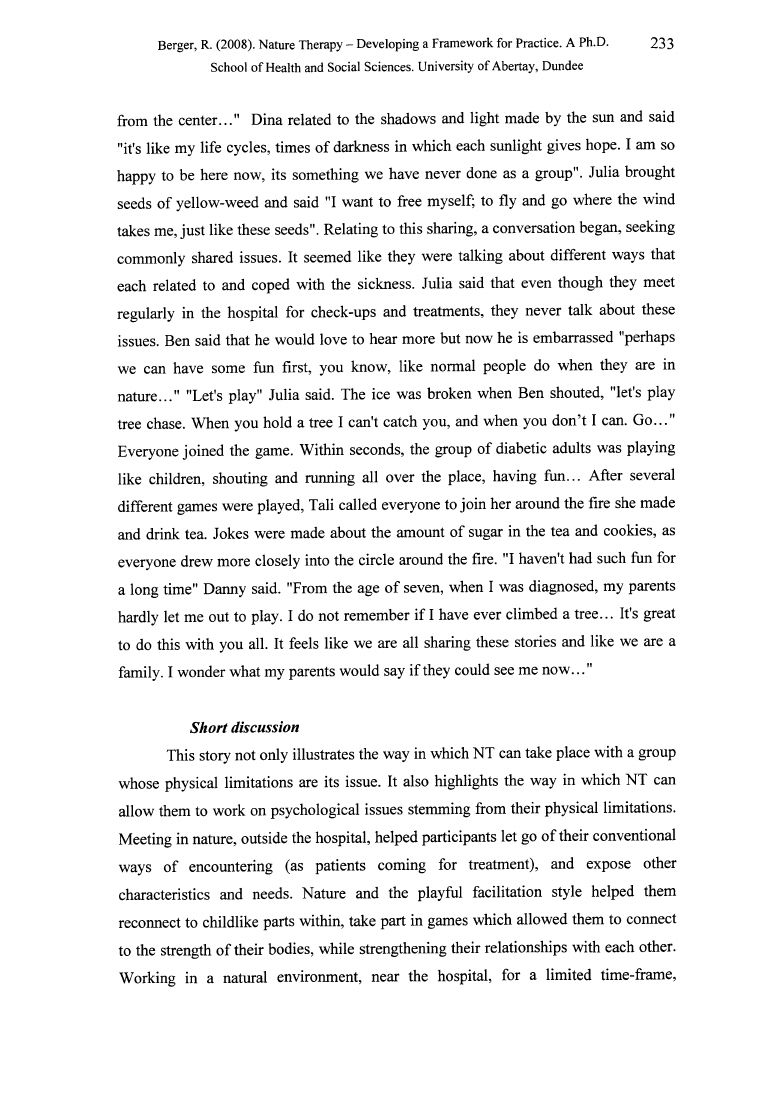
Berger, R. (2008). Nature Therapy - Developing a Framework for Practice. A Ph.D.
233
School of Health and Social Sciences. University of Abertay, Dundee
from the center..." Dina related to the shadows and light made by the sun and said
"it's like my life cycles, times of darkness in which each sunlight gives hope. I am so
happy to be here now, its something we have never done as a group". Julia brought
seeds of yellow-weed and said "I want to free myself; to fly and go where the wind
takes me, just like these seeds". Relating to this sharing, a conversation began, seeking
commonly shared issues. It seemed like they were talking about different ways that
each related to and coped with the sickness. Julia said that even though they meet
regularly in the hospital for check-ups and treatments, they never talk about these
issues. Ben said that he would love to hear more but now he is embarrassed "perhaps
we can have some fun first, you know, like normal people do when they are in
nature..." "Let’s play" Julia said. The ice was broken when Ben shouted, "let’s play
tree chase. When you hold a tree I can’t catch you, and when you don’t I can. Go..."
Everyone joined the game. Within seconds, the group of diabetic adults was playing
like children, shouting and running all over the place, having fun... After several
different games were played, Tali called everyone to join her around the fire she made
and drink tea. Jokes were made about the amount of sugar in the tea and cookies, as
everyone drew more closely into the circle around the fire. "I haven't had such fun for
a long time" Danny said. "From the age of seven, when I was diagnosed, my parents
hardly let me out to play. I do not remember if I have ever climbed a tree... It's great
to do this with you all. It feels like we are all sharing these stories and like we are a
family. I wonder what my parents would say if they could see me now..."
Short discussion
This story not only illustrates the way in which NT can take place with a group
whose physical limitations are its issue. It also highlights the way in which NT can
allow them to work on psychological issues stemming from their physical limitations.
Meeting in nature, outside the hospital, helped participants let go of their conventional
ways of encountering (as patients coming for treatment), and expose other
characteristics and needs. Nature and the playful facilitation style helped them
reconnect to childlike parts within, take part in games which allowed them to connect
to the strength of their bodies, while strengthening their relationships with each other.
Working in a natural environment, near the hospital, for a limited time-frame,
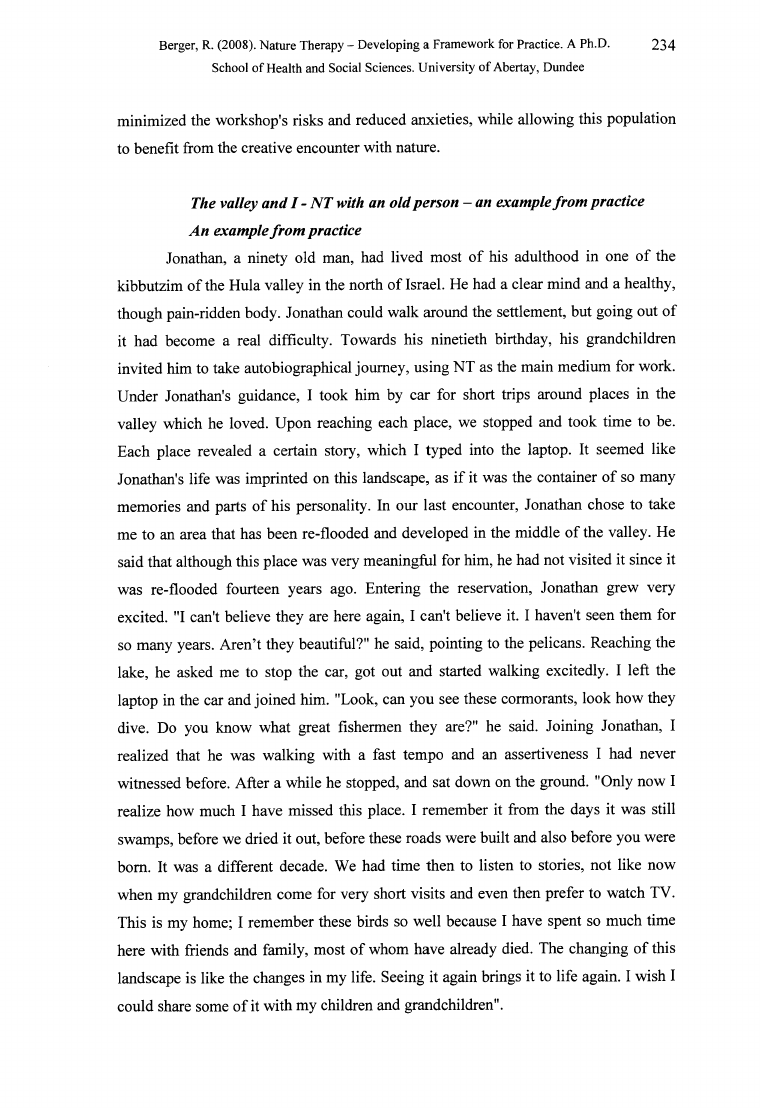
Berger, R. (2008). Nature Therapy - Developing a Framework for Practice. A Ph.D.
234
School of Health and Social Sciences. University of Abertay, Dundee
minimized the workshop's risks and reduced anxieties, while allowing this population
to benefit from the creative encounter with nature.
The valley and I - N T with an old person - an examplefrom practice
An examplefrom practice
Jonathan, a ninety old man, had lived most of his adulthood in one of the
kibbutzim of the Hula valley in the north of Israel. He had a clear mind and a healthy,
though pain-ridden body. Jonathan could walk around the settlement, but going out of
it had become a real difficulty. Towards his ninetieth birthday, his grandchildren
invited him to take autobiographical journey, using NT as the main medium for work.
Under Jonathan's guidance, I took him by car for short trips around places in the
valley which he loved. Upon reaching each place, we stopped and took time to be.
Each place revealed a certain story, which I typed into the laptop. It seemed like
Jonathan's life was imprinted on this landscape, as if it was the container of so many
memories and parts of his personality. In our last encounter, Jonathan chose to take
me to an area that has been re-flooded and developed in the middle of the valley. He
said that although this place was very meaningful for him, he had not visited it since it
was re-flooded fourteen years ago. Entering the reservation, Jonathan grew very
excited. "I can't believe they are here again, I can't believe it. I haven't seen them for
so many years. Aren’t they beautiful?" he said, pointing to the pelicans. Reaching the
lake, he asked me to stop the car, got out and started walking excitedly. I left the
laptop in the car and joined him. "Look, can you see these cormorants, look how they
dive. Do you know what great fishermen they are?" he said. Joining Jonathan, I
realized that he was walking with a fast tempo and an assertiveness I had never
witnessed before. After a while he stopped, and sat down on the ground. "Only now I
realize how much I have missed this place. I remember it from the days it was still
swamps, before we dried it out, before these roads were built and also before you were
bom. It was a different decade. We had time then to listen to stories, not like now
when my grandchildren come for very short visits and even then prefer to watch TV.
This is my home; I remember these birds so well because I have spent so much time
here with friends and family, most of whom have already died. The changing of this
landscape is like the changes in my life. Seeing it again brings it to life again. I wish I
could share some of it with my children and grandchildren".
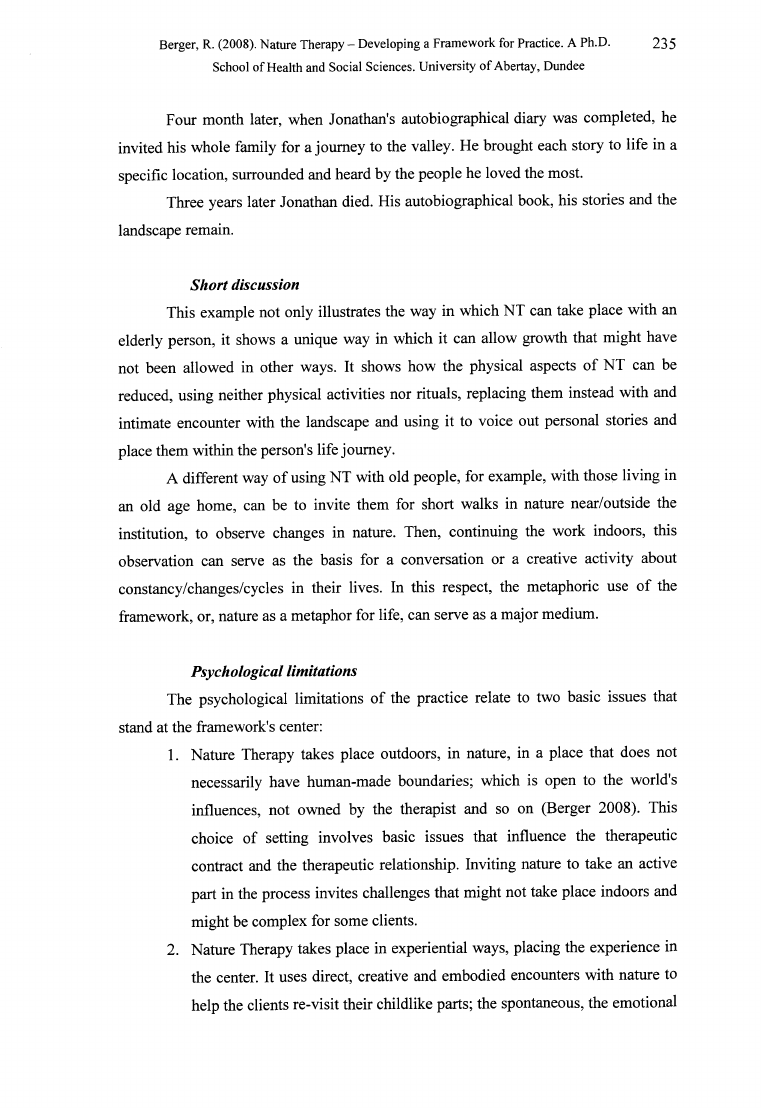
Berger, R. (2008). Nature Therapy - Developing a Framework for Practice. A Ph.D.
235
School of Health and Social Sciences. University of Abertay, Dundee
Four month later, when Jonathan's autobiographical diary was completed, he
invited his whole family for a journey to the valley. He brought each story to life in a
specific location, surrounded and heard by the people he loved the most.
Three years later Jonathan died. His autobiographical book, his stories and the
landscape remain.
Short discussion
This example not only illustrates the way in which NT can take place with an
elderly person, it shows a unique way in which it can allow growth that might have
not been allowed in other ways. It shows how the physical aspects of NT can be
reduced, using neither physical activities nor rituals, replacing them instead with and
intimate encounter with the landscape and using it to voice out personal stories and
place them within the person's life journey.
A different way of using NT with old people, for example, with those living in
an old age home, can be to invite them for short walks in nature near/outside the
institution, to observe changes in nature. Then, continuing the work indoors, this
observation can serve as the basis for a conversation or a creative activity about
constancy/changes/cycles in their lives. In this respect, the metaphoric use of the
framework, or, nature as a metaphor for life, can serve as a major medium.
Psychological limitations
The psychological limitations of the practice relate to two basic issues that
stand at the framework's center:
1. Nature Therapy takes place outdoors, in nature, in a place that does not
necessarily have human-made boundaries; which is open to the world's
influences, not owned by the therapist and so on (Berger 2008). This
choice of setting involves basic issues that influence the therapeutic
contract and the therapeutic relationship. Inviting nature to take an active
part in the process invites challenges that might not take place indoors and
might be complex for some clients.
2. Nature Therapy takes place in experiential ways, placing the experience in
the center. It uses direct, creative and embodied encounters with nature to
help the clients re-visit their childlike parts; the spontaneous, the emotional
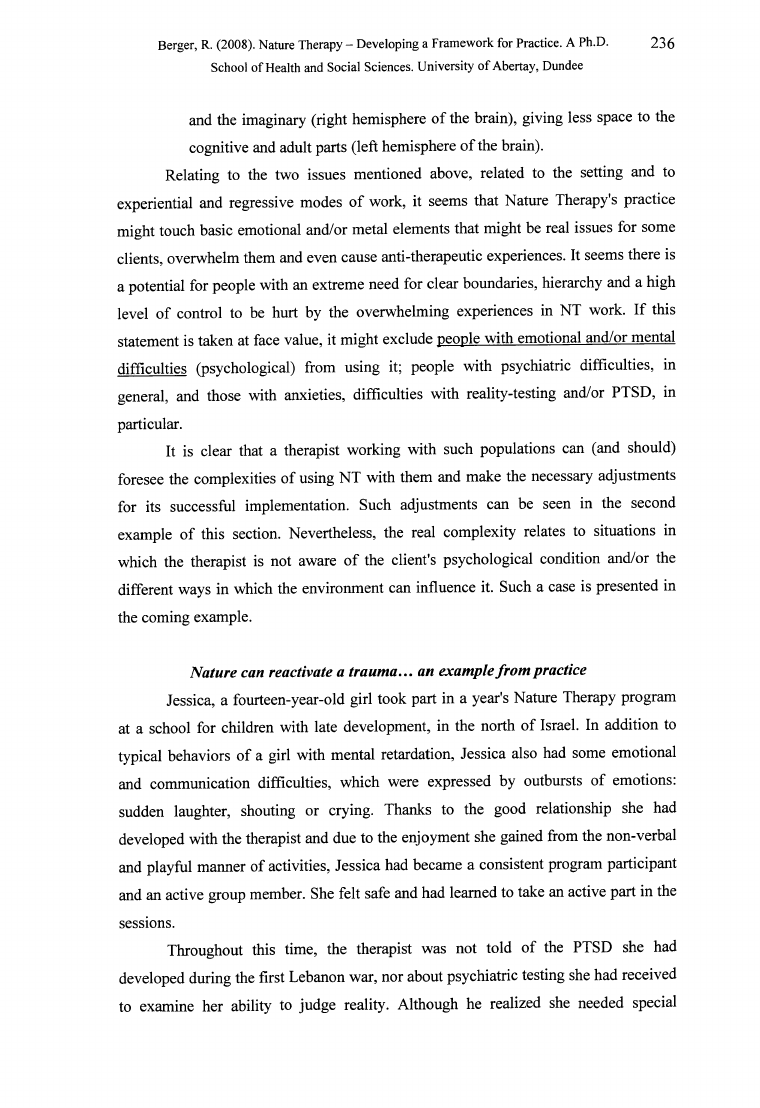
Berger, R. (2008). Nature Therapy - Developing a Framework for Practice. A Ph.D.
236
School of Health and Social Sciences. University of Abertay, Dundee
and the imaginary (right hemisphere of the brain), giving less space to the
cognitive and adult parts (left hemisphere of the brain).
Relating to the two issues mentioned above, related to the setting and to
experiential and regressive modes of work, it seems that Nature Therapy's practice
might touch basic emotional and/or metal elements that might be real issues for some
clients, overwhelm them and even cause anti-therapeutic experiences. It seems there is
a potential for people with an extreme need for clear boundaries, hierarchy and a high
level of control to be hurt by the overwhelming experiences in NT work. If this
statement is taken at face value, it might exclude people with emotional and/or mental
difficulties (psychological) from using it; people with psychiatric difficulties, in
general, and those with anxieties, difficulties with reality-testing and/or PTSD, in
particular.
It is clear that a therapist working with such populations can (and should)
foresee the complexities of using NT with them and make the necessary adjustments
for its successful implementation. Such adjustments can be seen in the second
example of this section. Nevertheless, the real complexity relates to situations in
which the therapist is not aware of the client's psychological condition and/or the
different ways in which the environment can influence it. Such a case is presented in
the coming example.
Nature can reactivate a trauma... an examplefrom practice
Jessica, a fourteen-year-old girl took part in a year's Nature Therapy program
at a school for children with late development, in the north of Israel. In addition to
typical behaviors of a girl with mental retardation, Jessica also had some emotional
and communication difficulties, which were expressed by outbursts of emotions:
sudden laughter, shouting or crying. Thanks to the good relationship she had
developed with the therapist and due to the enjoyment she gained from the non-verbal
and playful manner of activities, Jessica had became a consistent program participant
and an active group member. She felt safe and had learned to take an active part in the
sessions.
Throughout this time, the therapist was not told of the PTSD she had
developed during the first Lebanon war, nor about psychiatric testing she had received
to examine her ability to judge reality. Although he realized she needed special
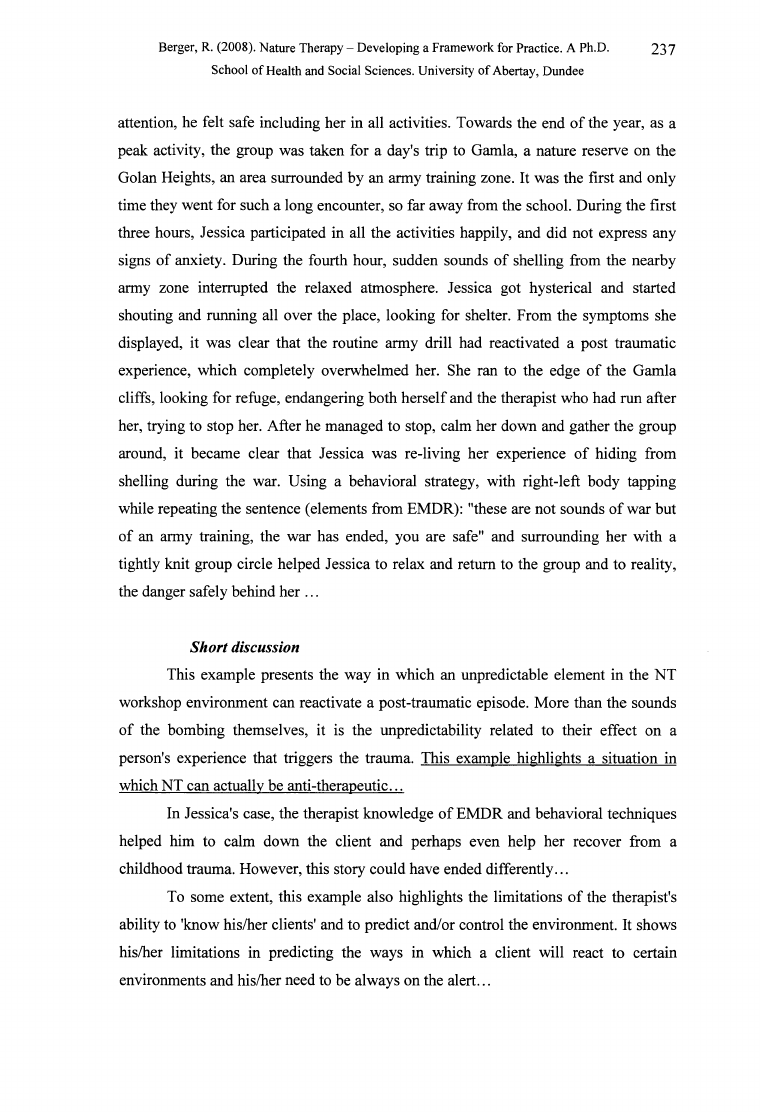
Berger, R. (2008). Nature Therapy - Developing a Framework for Practice. A Ph.D.
237
School of Health and Social Sciences. University of Abertay, Dundee
attention, he felt safe including her in all activities. Towards the end of the year, as a
peak activity, the group was taken for a day's trip to Gamla, a nature reserve on the
Golan Heights, an area surrounded by an army training zone. It was the first and only
time they went for such a long encounter, so far away from the school. During the first
three hours, Jessica participated in all the activities happily, and did not express any
signs of anxiety. During the fourth hour, sudden sounds of shelling from the nearby
army zone interrupted the relaxed atmosphere. Jessica got hysterical and started
shouting and running all over the place, looking for shelter. From the symptoms she
displayed, it was clear that the routine army drill had reactivated a post traumatic
experience, which completely overwhelmed her. She ran to the edge of the Gamla
cliffs, looking for refuge, endangering both herself and the therapist who had run after
her, trying to stop her. After he managed to stop, calm her down and gather the group
around, it became clear that Jessica was re-living her experience of hiding from
shelling during the war. Using a behavioral strategy, with right-left body tapping
while repeating the sentence (elements from EMDR): "these are not sounds of war but
of an army training, the war has ended, you are safe" and surrounding her with a
tightly knit group circle helped Jessica to relax and return to the group and to reality,
the danger safely behind her ...
Short discussion
This example presents the way in which an unpredictable element in the NT
workshop environment can reactivate a post-traumatic episode. More than the sounds
of the bombing themselves, it is the unpredictability related to their effect on a
person's experience that triggers the trauma. This example highlights a situation in
which NT can actually be anti-therapeutic...
In Jessica's case, the therapist knowledge of EMDR and behavioral techniques
helped him to calm down the client and perhaps even help her recover from a
childhood trauma. However, this story could have ended differently...
To some extent, this example also highlights the limitations of the therapist's
ability to 'know his/her clients' and to predict and/or control the environment. It shows
his/her limitations in predicting the ways in which a client will react to certain
environments and his/her need to be always on the alert...
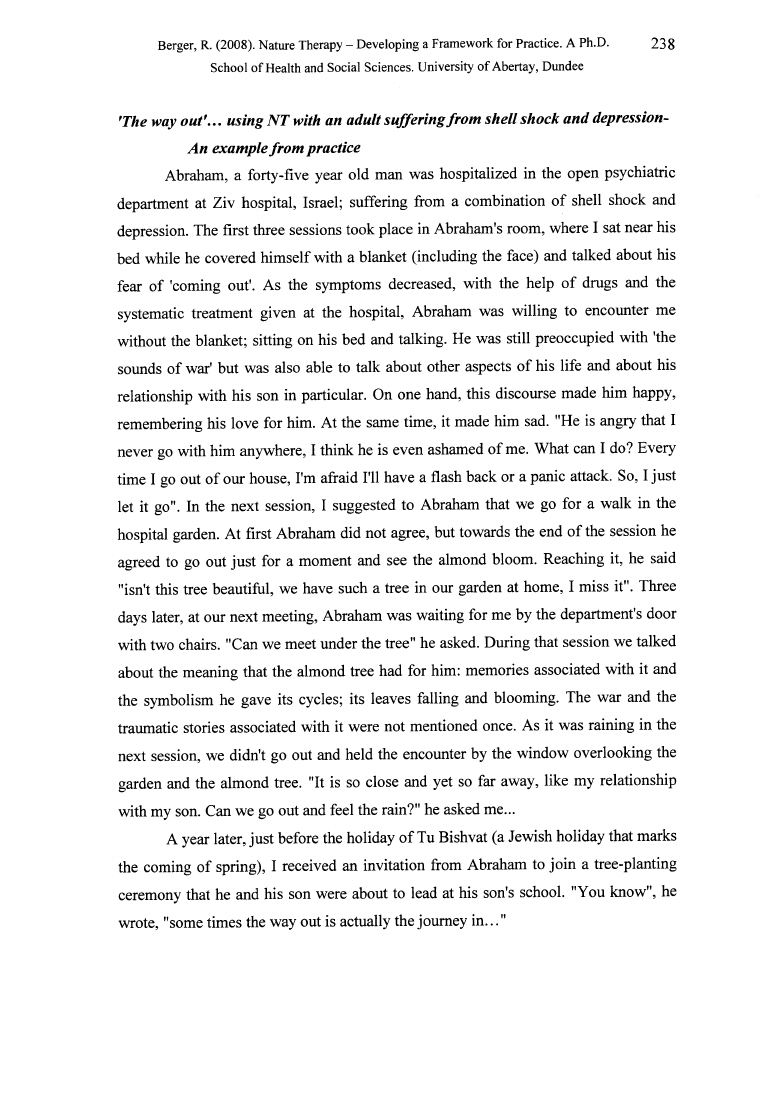
Berger, R. (2008). Nature Therapy - Developing a Framework for Practice. A Ph.D.
238
School of Health and Social Sciences. University of Abertay, Dundee
'The way o u t u s i n g N T with an adult sufferingfrom shell shock and depression-
An examplefrom practice
Abraham, a forty-five year old man was hospitalized in the open psychiatric
department at Ziv hospital, Israel; suffering from a combination of shell shock and
depression. The first three sessions took place in Abraham's room, where I sat near his
bed while he covered himself with a blanket (including the face) and talked about his
fear of 'coming out'. As the symptoms decreased, with the help of drugs and the
systematic treatment given at the hospital, Abraham was willing to encounter me
without the blanket; sitting on his bed and talking. He was still preoccupied with 'the
sounds of war' but was also able to talk about other aspects of his life and about his
relationship with his son in particular. On one hand, this discourse made him happy,
remembering his love for him. At the same time, it made him sad. "He is angry that I
never go with him anywhere, I think he is even ashamed of me. What can I do? Every
time I go out of our house, I'm afraid I'll have a flash back or a panic attack. So, I just
let it go". In the next session, I suggested to Abraham that we go for a walk in the
hospital garden. At first Abraham did not agree, but towards the end of the session he
agreed to go out just for a moment and see the almond bloom. Reaching it, he said
"isn't this tree beautiful, we have such a tree in our garden at home, I miss it". Three
days later, at our next meeting, Abraham was waiting for me by the department's door
with two chairs. "Can we meet under the tree" he asked. During that session we talked
about the meaning that the almond tree had for him: memories associated with it and
the symbolism he gave its cycles; its leaves falling and blooming. The war and the
traumatic stories associated with it were not mentioned once. As it was raining in the
next session, we didn't go out and held the encounter by the window overlooking the
garden and the almond tree. "It is so close and yet so far away, like my relationship
with my son. Can we go out and feel the rain?" he asked me...
A year later, just before the holiday of Tu Bishvat (a Jewish holiday that marks
the coming of spring), I received an invitation from Abraham to join a tree-planting
ceremony that he and his son were about to lead at his son's school. "You know", he
wrote, "some times the way out is actually the journey in..."
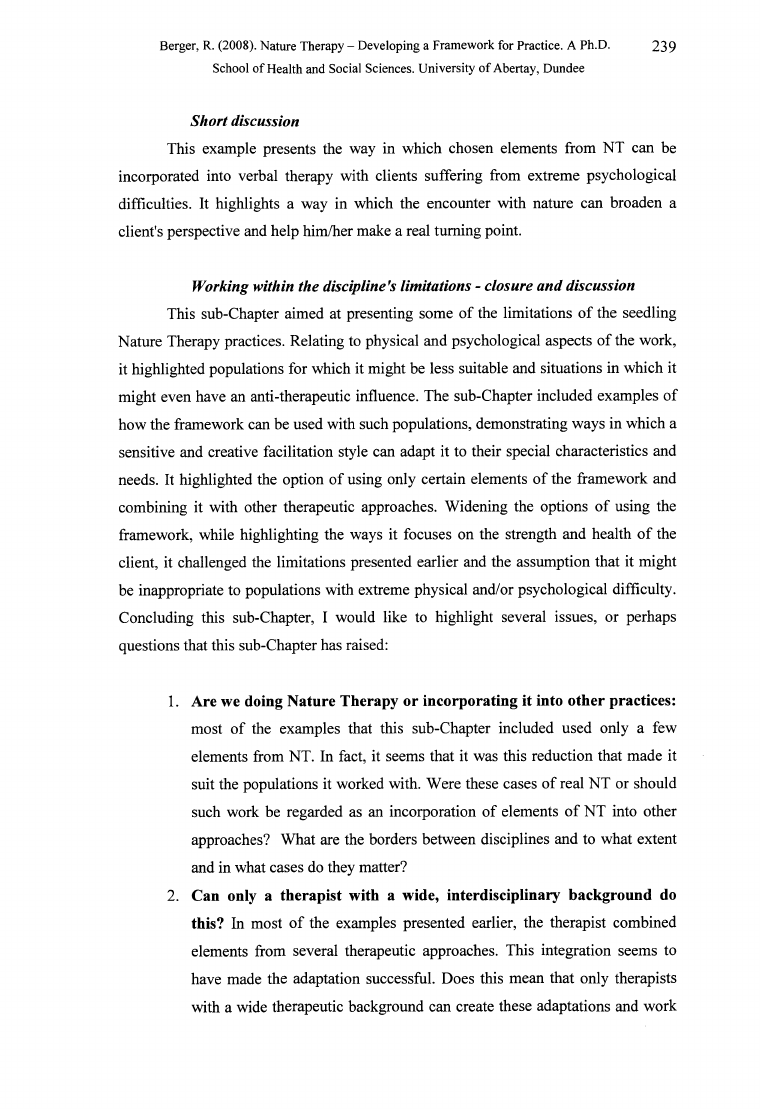
Berger, R. (2008). Nature Therapy - Developing a Framework for Practice. A Ph.D.
239
School of Health and Social Sciences. University of Abertay, Dundee
Short discussion
This example presents the way in which chosen elements from NT can be
incorporated into verbal therapy with clients suffering from extreme psychological
difficulties. It highlights a way in which the encounter with nature can broaden a
client's perspective and help him/her make a real turning point.
Working within the discipline's limitations - closure and discussion
This sub-Chapter aimed at presenting some of the limitations of the seedling
Nature Therapy practices. Relating to physical and psychological aspects of the work,
it highlighted populations for which it might be less suitable and situations in which it
might even have an anti-therapeutic influence. The sub-Chapter included examples of
how the framework can be used with such populations, demonstrating ways in which a
sensitive and creative facilitation style can adapt it to their special characteristics and
needs. It highlighted the option of using only certain elements of the framework and
combining it with other therapeutic approaches. Widening the options of using the
framework, while highlighting the ways it focuses on the strength and health of the
client, it challenged the limitations presented earlier and the assumption that it might
be inappropriate to populations with extreme physical and/or psychological difficulty.
Concluding this sub-Chapter, I would like to highlight several issues, or perhaps
questions that this sub-Chapter has raised:
1. Are we doing Nature Therapy or incorporating it into other practices:
most of the examples that this sub-Chapter included used only a few
elements from NT. In fact, it seems that it was this reduction that made it
suit the populations it worked with. Were these cases of real NT or should
such work be regarded as an incorporation of elements of NT into other
approaches? What are the borders between disciplines and to what extent
and in what cases do they matter?
2. Can only a therapist with a wide, interdisciplinary background do
this? In most of the examples presented earlier, the therapist combined
elements from several therapeutic approaches. This integration seems to
have made the adaptation successful. Does this mean that only therapists
with a wide therapeutic background can create these adaptations and work
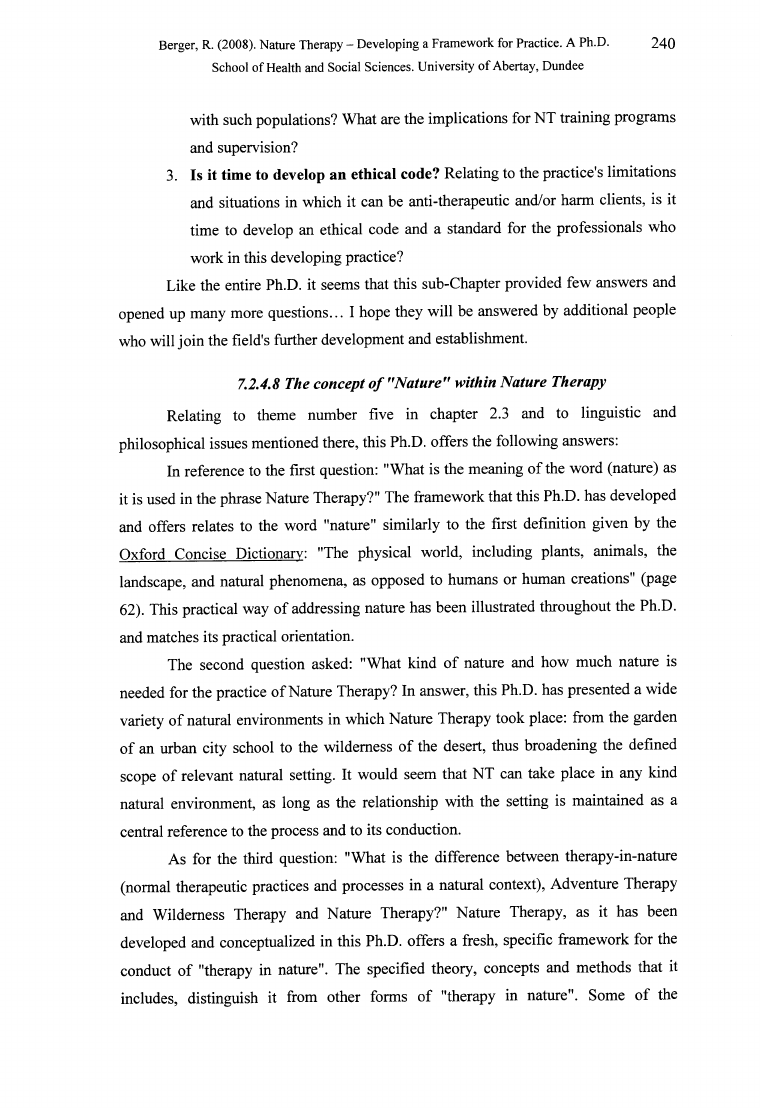
Berger, R. (2008). Nature Therapy - Developing a Framework for Practice. A Ph.D.
240
School of Health and Social Sciences. University of Abertay, Dundee
with such populations? What are the implications for NT training programs
and supervision?
3. Is it time to develop an ethical code? Relating to the practice's limitations
and situations in which it can be anti-therapeutic and/or harm clients, is it
time to develop an ethical code and a standard for the professionals who
work in this developing practice?
Like the entire Ph.D. it seems that this sub-Chapter provided few answers and
opened up many more questions... I hope they will be answered by additional people
who will join the field's further development and establishment.
7.2.4.8 The co n cep t o f "N a tu r e " w ithin N a tu re T h erapy
Relating to theme number five in chapter 2.3 and to linguistic and
philosophical issues mentioned there, this Ph.D. offers the following answers:
In reference to the first question: "What is the meaning o f the word (nature) as
it is used in the phrase Nature Therapy?" The framework that this Ph.D. has developed
and offers relates to the word "nature" similarly to the first definition given by the
Oxford Concise Dictionary: "The physical world, including plants, animals, the
landscape, and natural phenomena, as opposed to humans or human creations" (page
62). This practical way of addressing nature has been illustrated throughout the Ph.D.
and matches its practical orientation.
The second question asked: "What kind o f nature and how much nature is
needed for the practice of Nature Therapy? In answer, this Ph.D. has presented a wide
variety o f natural environments in which Nature Therapy took place: from the garden
of an urban city school to the wilderness of the desert, thus broadening the defined
scope of relevant natural setting. It would seem that NT can take place in any kind
natural environment, as long as the relationship with the setting is maintained as a
central reference to the process and to its conduction.
As for the third question: "What is the difference between therapy-in-nature
(normal therapeutic practices and processes in a natural context), Adventure Therapy
and Wilderness Therapy and Nature Therapy?" Nature Therapy, as it has been
developed and conceptualized in this Ph.D. offers a fresh, specific framework for the
conduct o f "therapy in nature". The specified theory, concepts and methods that it
includes, distinguish it from other forms of "therapy in nature". Some of the
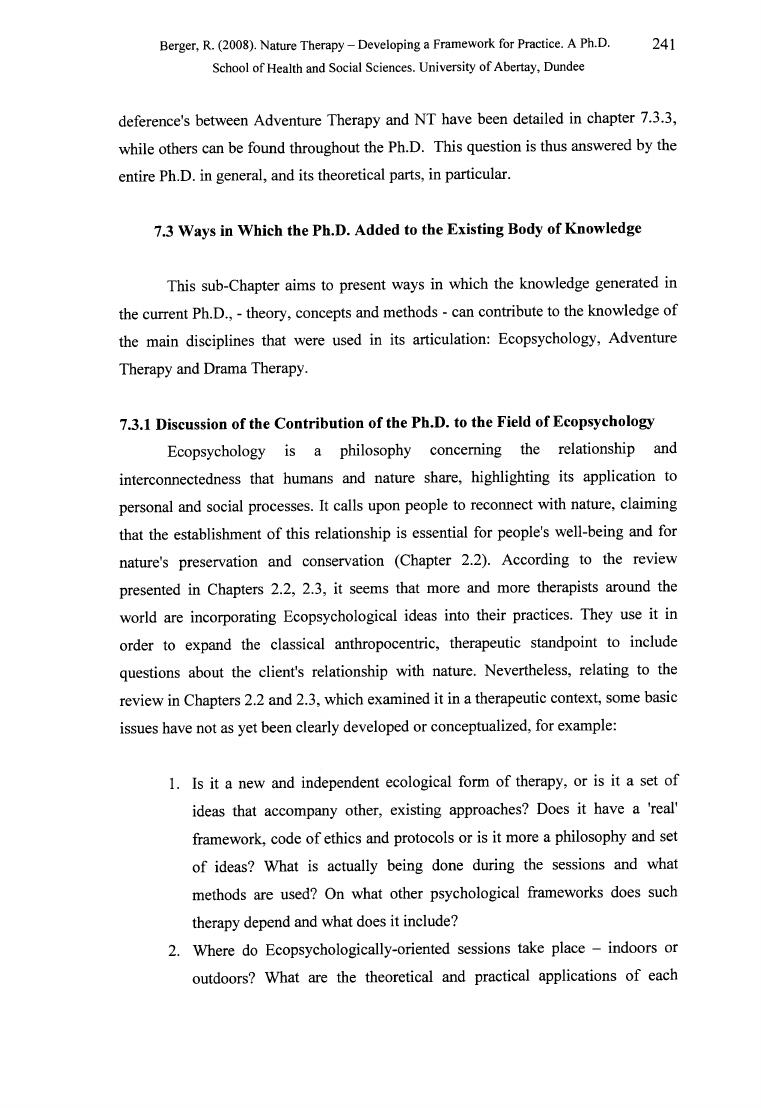
Berger, R. (2008). Nature Therapy - Developing a Framework for Practice. A Ph.D.
241
School of Health and Social Sciences. University of Abertay, Dundee
deference's between Adventure Therapy and NT have been detailed in chapter 7.3.3,
while others can be found throughout the Ph.D. This question is thus answered by the
entire Ph.D. in general, and its theoretical parts, in particular.
7.3 Ways in Which the Ph.D. Added to the Existing Body of Knowledge
This sub-Chapter aims to present ways in which the knowledge generated in
the current Ph.D., - theory, concepts and methods - can contribute to the knowledge of
the main disciplines that were used in its articulation: Ecopsychology, Adventure
Therapy and Drama Therapy.
7.3.1 Discussion of the Contribution of the Ph.D. to the Field of Ecopsychology
Ecopsychology is a philosophy concerning the relationship and
interconnectedness that humans and nature share, highlighting its application to
personal and social processes. It calls upon people to reconnect with nature, claiming
that the establishment o f this relationship is essential for people's well-being and for
nature's preservation and conservation (Chapter 2.2). According to the review
presented in Chapters 2.2, 2.3, it seems that more and more therapists around the
world are incorporating Ecopsychological ideas into their practices. They use it in
order to expand the classical anthropocentric, therapeutic standpoint to include
questions about the client's relationship with nature. Nevertheless, relating to the
review in Chapters 2.2 and 2.3, which examined it in a therapeutic context, some basic
issues have not as yet been clearly developed or conceptualized, for example:
1. Is it a new and independent ecological form o f therapy, or is it a set o f
ideas that accompany other, existing approaches? Does it have a 'real'
framework, code o f ethics and protocols or is it more a philosophy and set
of ideas? What is actually being done during the sessions and what
methods are used? On what other psychological frameworks does such
therapy depend and what does it include?
2. Where do Ecopsychologically-oriented sessions take place - indoors or
outdoors? What are the theoretical and practical applications o f each
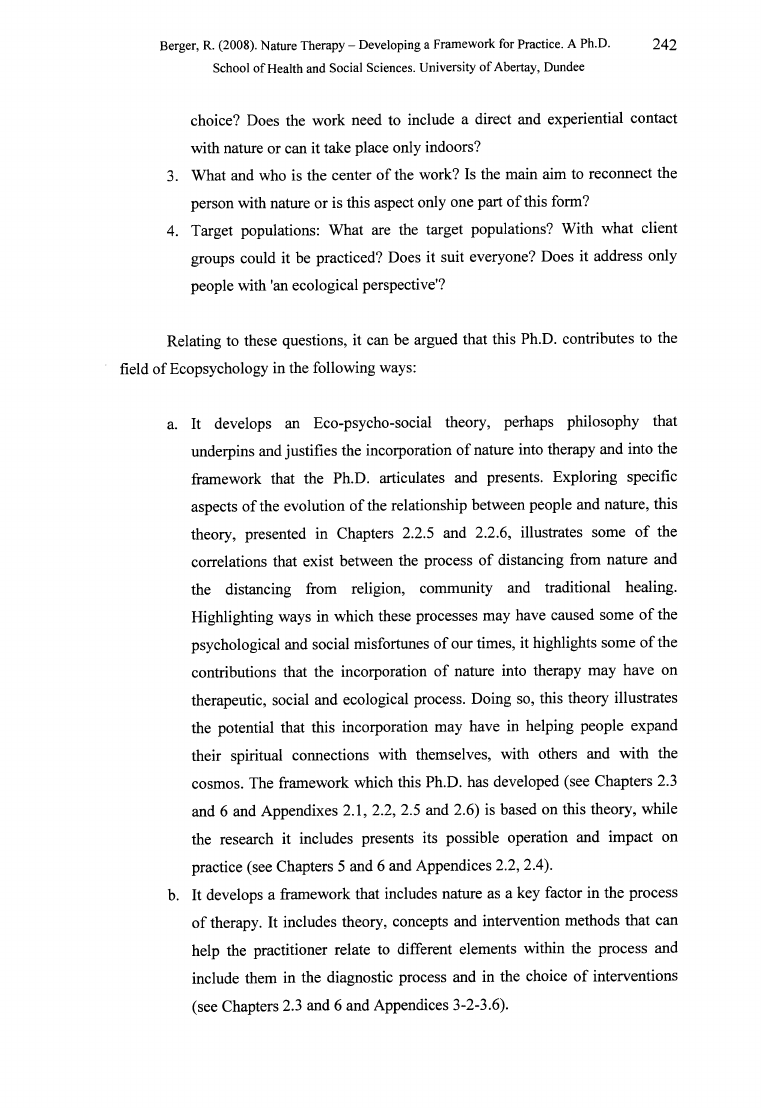
Berger, R. (2008). Nature Therapy - Developing a Framework for Practice. A Ph.D.
242
School of Health and Social Sciences. University of Abertay, Dundee
choice? Does the work need to include a direct and experiential contact
with nature or can it take place only indoors?
3. What and who is the center o f the work? Is the main aim to reconnect the
person with nature or is this aspect only one part o f this form?
4. Target populations: What are the target populations? With what client
groups could it be practiced? Does it suit everyone? Does it address only
people with 'an ecological perspective'?
Relating to these questions, it can be argued that this Ph.D. contributes to the
field of Ecopsychology in the following ways:
a. It develops an Eco-psycho-social theory, perhaps philosophy that
underpins and justifies the incorporation of nature into therapy and into the
framework that the Ph.D. articulates and presents. Exploring specific
aspects of the evolution of the relationship between people and nature, this
theory, presented in Chapters 2.2.5 and 2.2.6, illustrates some o f the
correlations that exist between the process of distancing from nature and
the distancing from religion, community and traditional healing.
Highlighting ways in which these processes may have caused some of the
psychological and social misfortunes of our times, it highlights some o f the
contributions that the incorporation of nature into therapy may have on
therapeutic, social and ecological process. Doing so, this theory illustrates
the potential that this incorporation may have in helping people expand
their spiritual connections with themselves, with others and with the
cosmos. The framework which this Ph.D. has developed (see Chapters 2.3
and 6 and Appendixes 2.1, 2.2, 2.5 and 2.6) is based on this theory, while
the research it includes presents its possible operation and impact on
practice (see Chapters 5 and 6 and Appendices 2.2, 2.4).
b. It develops a framework that includes nature as a key factor in the process
of therapy. It includes theory, concepts and intervention methods that can
help the practitioner relate to different elements within the process and
include them in the diagnostic process and in the choice o f interventions
(see Chapters 2.3 and 6 and Appendices 3-2-3.6).
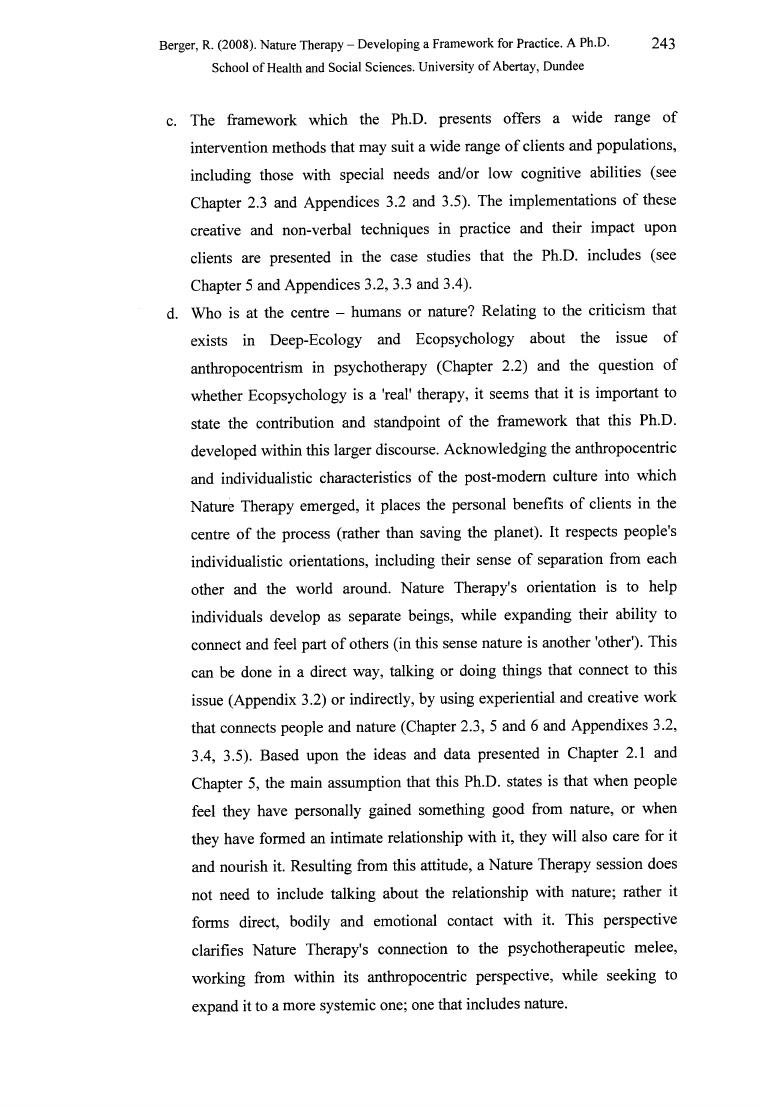
Berger, R. (2008). Nature Therapy - Developing a Framework for Practice. A Ph.D.
243
School of Health and Social Sciences. University of Abertay, Dundee
c. The framework which the Ph.D. presents offers a wide range o f
intervention methods that may suit a wide range o f clients and populations,
including those with special needs and/or low cognitive abilities (see
Chapter 2.3 and Appendices 3.2 and 3.5). The implementations o f these
creative and non-verbal techniques in practice and their impact upon
clients are presented in the case studies that the Ph.D. includes (see
Chapter 5 and Appendices 3.2, 3.3 and 3.4).
d. Who is at the centre - humans or nature? Relating to the criticism that
exists in Deep-Ecology and Ecopsychology about the issue of
anthropocentrism in psychotherapy (Chapter 2.2) and the question o f
whether Ecopsychology is a 'real' therapy, it seems that it is important to
state the contribution and standpoint of the framework that this Ph.D.
developed within this larger discourse. Acknowledging the anthropocentric
and individualistic characteristics of the post-modem culture into which
Nature Therapy emerged, it places the personal benefits of clients in the
centre o f the process (rather than saving the planet). It respects people's
individualistic orientations, including their sense o f separation from each
other and the world around. Nature Therapy's orientation is to help
individuals develop as separate beings, while expanding their ability to
connect and feel part o f others (in this sense nature is another 'other'). This
can be done in a direct way, talking or doing things that connect to this
issue (Appendix 3.2) or indirectly, by using experiential and creative work
that connects people and nature (Chapter 2.3, 5 and 6 and Appendixes 3.2,
3.4, 3.5). Based upon the ideas and data presented in Chapter 2.1 and
Chapter 5, the main assumption that this Ph.D. states is that when people
feel they have personally gained something good from nature, or when
they have formed an intimate relationship with it, they will also care for it
and nourish it. Resulting from this attitude, a Nature Therapy session does
not need to include talking about the relationship with nature; rather it
forms direct, bodily and emotional contact with it. This perspective
clarifies Nature Therapy's connection to the psychotherapeutic melee,
working from within its anthropocentric perspective, while seeking to
expand it to a more systemic one; one that includes nature.
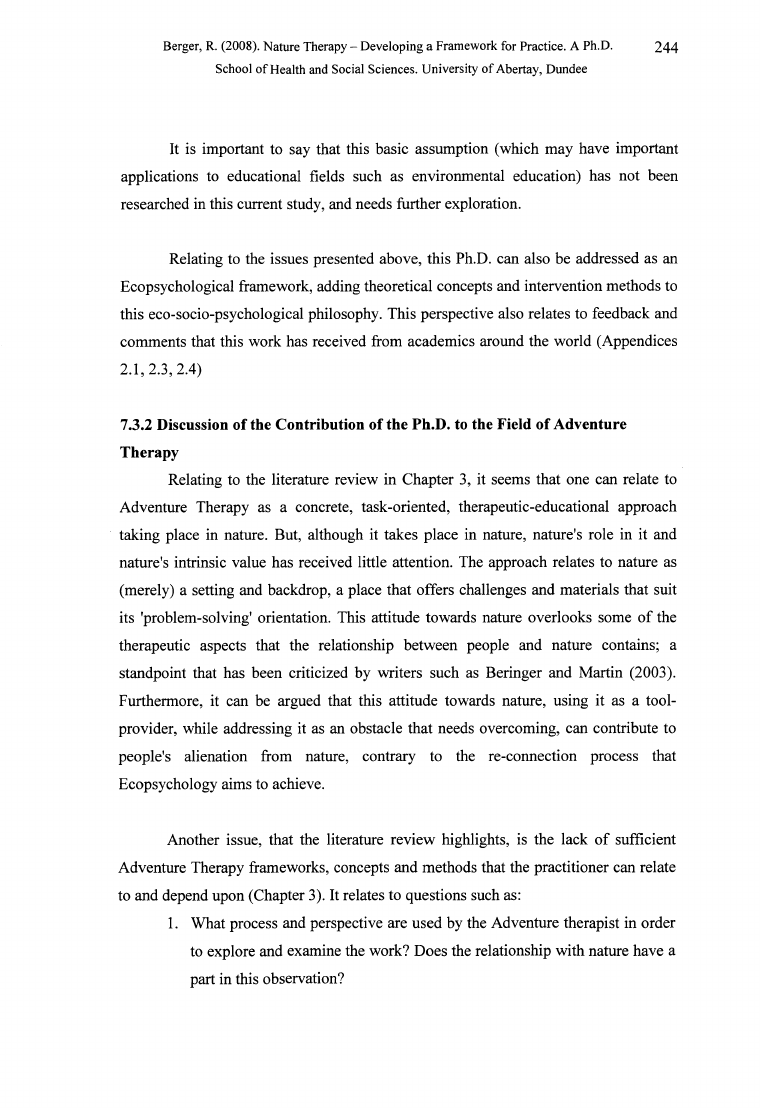
Berger, R. (2008). Nature Therapy - Developing a Framework for Practice. A Ph.D.
244
School of Health and Social Sciences. University of Abertay, Dundee
It is important to say that this basic assumption (which may have important
applications to educational fields such as environmental education) has not been
researched in this current study, and needs further exploration.
Relating to the issues presented above, this Ph.D. can also be addressed as an
Ecopsychological framework, adding theoretical concepts and intervention methods to
this eco-socio-psychological philosophy. This perspective also relates to feedback and
comments that this work has received from academics around the world (Appendices
2.1, 2.3, 2.4)
7.3.2 Discussion of the Contribution of the Ph.D. to the Field of Adventure
Therapy
Relating to the literature review in Chapter 3, it seems that one can relate to
Adventure Therapy as a concrete, task-oriented, therapeutic-educational approach
taking place in nature. But, although it takes place in nature, nature's role in it and
nature's intrinsic value has received little attention. The approach relates to nature as
(merely) a setting and backdrop, a place that offers challenges and materials that suit
its 'problem-solving' orientation. This attitude towards nature overlooks some o f the
therapeutic aspects that the relationship between people and nature contains; a
standpoint that has been criticized by writers such as Beringer and Martin (2003).
Furthermore, it can be argued that this attitude towards nature, using it as a tool-
provider, while addressing it as an obstacle that needs overcoming, can contribute to
people's alienation from nature, contrary to the re-connection process that
Ecopsychology aims to achieve.
Another issue, that the literature review highlights, is the lack o f sufficient
Adventure Therapy frameworks, concepts and methods that the practitioner can relate
to and depend upon (Chapter 3). It relates to questions such as:
1. What process and perspective are used by the Adventure therapist in order
to explore and examine the work? Does the relationship with nature have a
part in this observation?
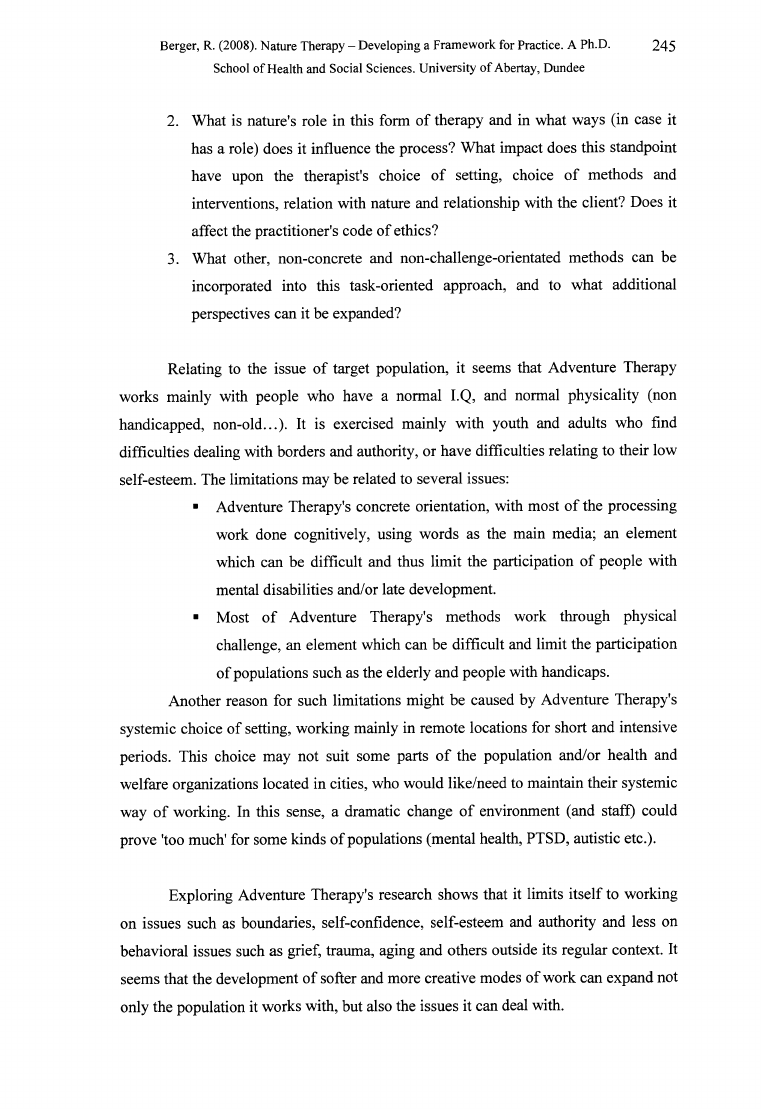
Berger, R. (2008). Nature Therapy - Developing a Framework for Practice. A Ph.D.
245
School of Health and Social Sciences. University of Abertay, Dundee
2. What is nature's role in this form o f therapy and in what ways (in case it
has a role) does it influence the process? What impact does this standpoint
have upon the therapist's choice of setting, choice o f methods and
interventions, relation with nature and relationship with the client? Does it
affect the practitioner's code of ethics?
3. What other, non-concrete and non-challenge-orientated methods can be
incorporated into this task-oriented approach, and to what additional
perspectives can it be expanded?
Relating to the issue o f target population, it seems that Adventure Therapy
works mainly with people who have a normal I.Q, and normal physicality (non
handicapped, non-old...). It is exercised mainly with youth and adults who find
difficulties dealing with borders and authority, or have difficulties relating to their low
self-esteem. The limitations may be related to several issues:
■ Adventure Therapy's concrete orientation, with most of the processing
work done cognitively, using words as the main media; an element
which can be difficult and thus limit the participation of people with
mental disabilities and/or late development.
■ Most o f Adventure Therapy's methods work through physical
challenge, an element which can be difficult and limit the participation
of populations such as the elderly and people with handicaps.
Another reason for such limitations might be caused by Adventure Therapy's
systemic choice of setting, working mainly in remote locations for short and intensive
periods. This choice may not suit some parts o f the population and/or health and
welfare organizations located in cities, who would like/need to maintain their systemic
way o f working. In this sense, a dramatic change o f environment (and staff) could
prove 'too much' for some kinds o f populations (mental health, PTSD, autistic etc.).
Exploring Adventure Therapy's research shows that it limits itself to working
on issues such as boundaries, self-confidence, self-esteem and authority and less on
behavioral issues such as grief, trauma, aging and others outside its regular context. It
seems that the development of softer and more creative modes of work can expand not
only the population it works with, but also the issues it can deal with.
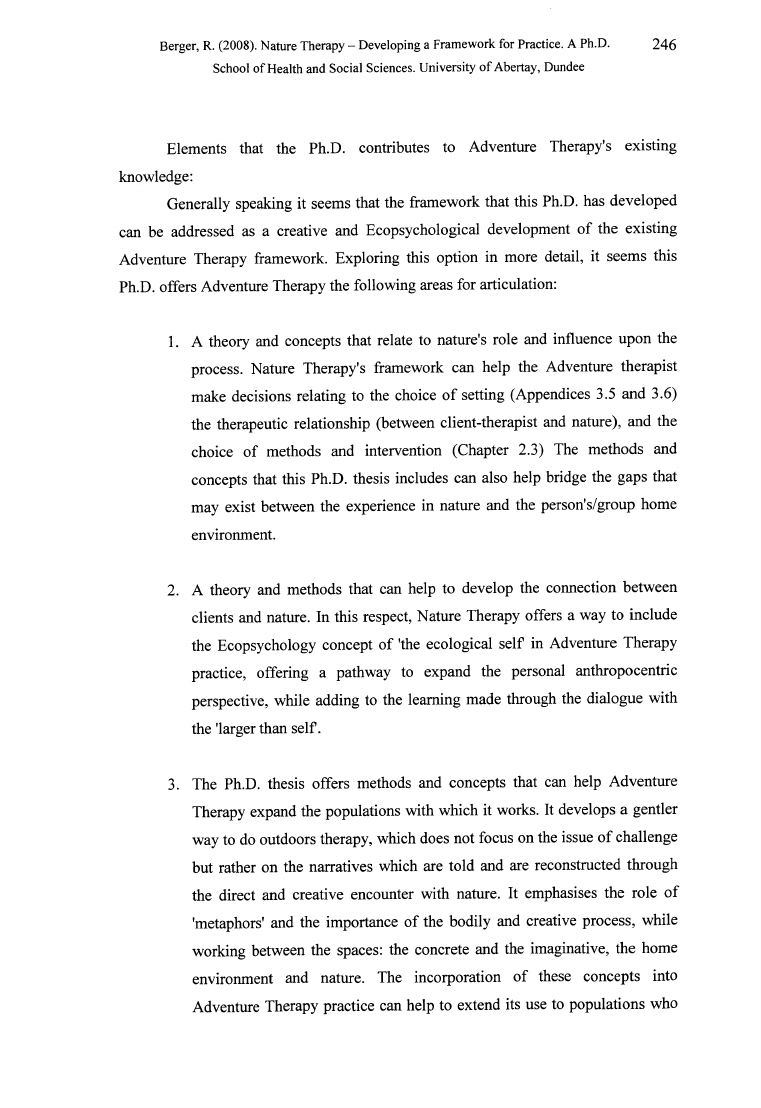
Berger, R. (2008). Nature Therapy - Developing a Framework for Practice. A Ph.D.
246
School of Health and Social Sciences. University of Abertay, Dundee
Elements that the Ph.D. contributes to Adventure Therapy's existing
knowledge:
Generally speaking it seems that the framework that this Ph.D. has developed
can be addressed as a creative and Ecopsychological development of the existing
Adventure Therapy framework. Exploring this option in more detail, it seems this
Ph.D. offers Adventure Therapy the following areas for articulation:
1. A theory and concepts that relate to nature's role and influence upon the
process. Nature Therapy's framework can help the Adventure therapist
make decisions relating to the choice o f setting (Appendices 3.5 and 3.6)
the therapeutic relationship (between client-therapist and nature), and the
choice of methods and intervention (Chapter 2.3) The methods and
concepts that this Ph.D. thesis includes can also help bridge the gaps that
may exist between the experience in nature and the person's/group home
environment.
2. A theory and methods that can help to develop the connection between
clients and nature. In this respect, Nature Therapy offers a way to include
the Ecopsychology concept o f 'the ecological self in Adventure Therapy
practice, offering a pathway to expand the personal anthropocentric
perspective, while adding to the learning made through the dialogue with
the 'larger than self.
3. The Ph.D. thesis offers methods and concepts that can help Adventure
Therapy expand the populations with which it works. It develops a gentler
way to do outdoors therapy, which does not focus on the issue o f challenge
but rather on the narratives which are told and are reconstructed through
the direct and creative encounter with nature. It emphasises the role of
'metaphors' and the importance of the bodily and creative process, while
working between the spaces: the concrete and the imaginative, the home
environment and nature. The incorporation of these concepts into
Adventure Therapy practice can help to extend its use to populations who
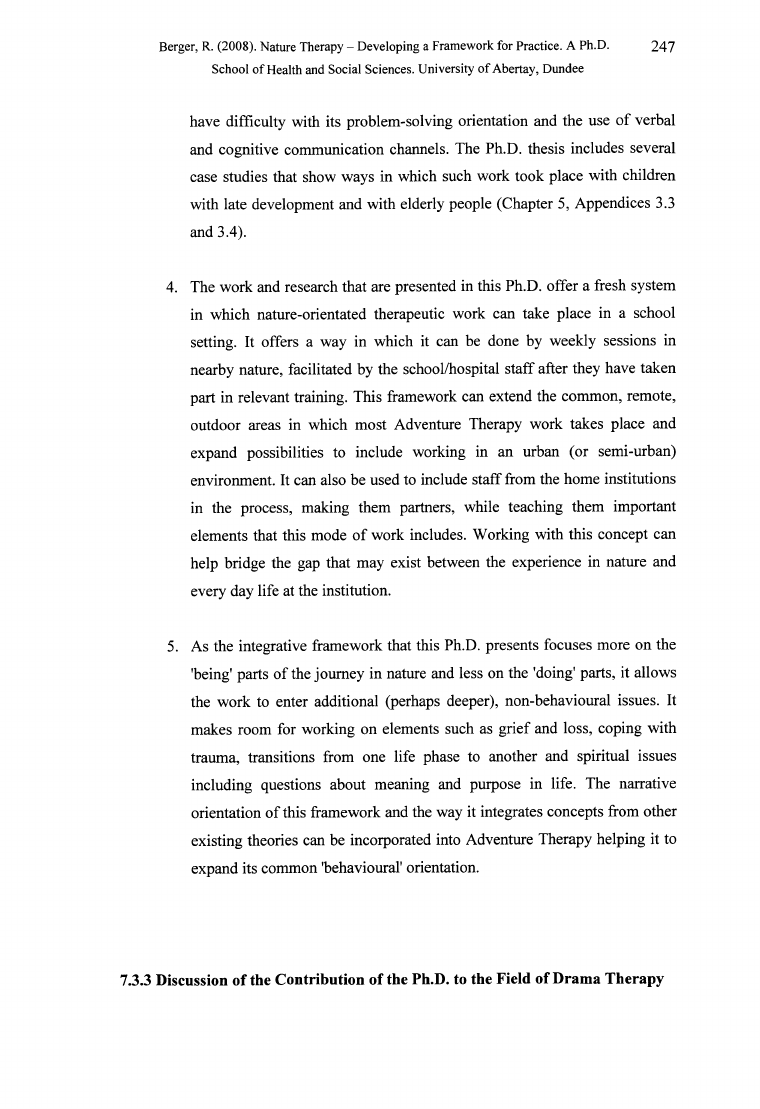
Berger, R. (2008). Nature Therapy - Developing a Framework for Practice. A Ph.D.
247
School of Health and Social Sciences. University of Abertay, Dundee
have difficulty with its problem-solving orientation and the use o f verbal
and cognitive communication channels. The Ph.D. thesis includes several
case studies that show ways in which such work took place with children
with late development and with elderly people (Chapter 5, Appendices 3.3
and 3.4).
4. The work and research that are presented in this Ph.D. offer a fresh system
in which nature-orientated therapeutic work can take place in a school
setting. It offers a way in which it can be done by weekly sessions in
nearby nature, facilitated by the school/hospital staff after they have taken
part in relevant training. This framework can extend the common, remote,
outdoor areas in which most Adventure Therapy work takes place and
expand possibilities to include working in an urban (or semi-urban)
environment. It can also be used to include staff from the home institutions
in the process, making them partners, while teaching them important
elements that this mode o f work includes. Working with this concept can
help bridge the gap that may exist between the experience in nature and
every day life at the institution.
5. As the integrative framework that this Ph.D. presents focuses more on the
'being' parts of the journey in nature and less on the 'doing' parts, it allows
the work to enter additional (perhaps deeper), non-behavioural issues. It
makes room for working on elements such as grief and loss, coping with
trauma, transitions from one life phase to another and spiritual issues
including questions about meaning and purpose in life. The narrative
orientation of this framework and the way it integrates concepts from other
existing theories can be incorporated into Adventure Therapy helping it to
expand its common 'behavioural' orientation.
7.3.3 Discussion of the Contribution of the Ph.D. to the Field of Drama Therapy
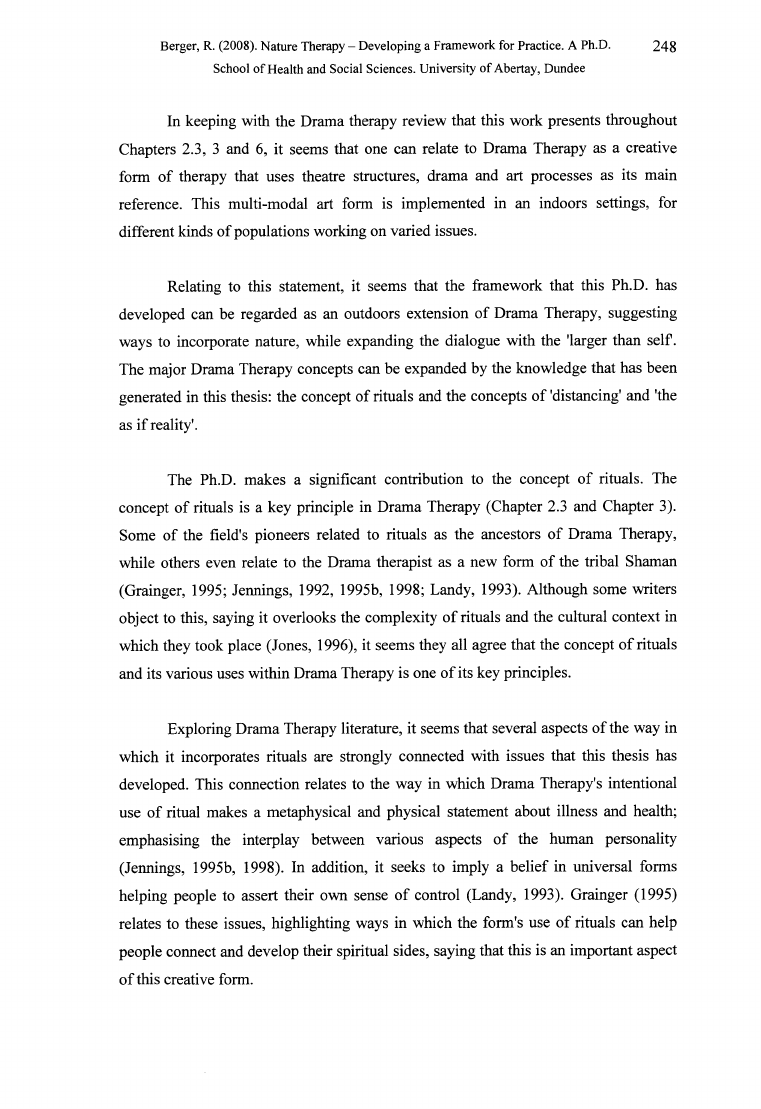
Berger, R. (2008). Nature Therapy - Developing a Framework for Practice. A Ph.D.
248
School of Health and Social Sciences. University of Abertay, Dundee
In keeping with the Drama therapy review that this work presents throughout
Chapters 2.3, 3 and 6, it seems that one can relate to Drama Therapy as a creative
form of therapy that uses theatre structures, drama and art processes as its main
reference. This multi-modal art form is implemented in an indoors settings, for
different kinds of populations working on varied issues.
Relating to this statement, it seems that the framework that this Ph.D. has
developed can be regarded as an outdoors extension of Drama Therapy, suggesting
ways to incorporate nature, while expanding the dialogue with the 'larger than self.
The major Drama Therapy concepts can be expanded by the knowledge that has been
generated in this thesis: the concept o f rituals and the concepts o f 'distancing' and 'the
as if reality'.
The Ph.D. makes a significant contribution to the concept o f rituals. The
concept o f rituals is a key principle in Drama Therapy (Chapter 2.3 and Chapter 3).
Some of the field's pioneers related to rituals as the ancestors of Drama Therapy,
while others even relate to the Drama therapist as a new form of the tribal Shaman
(Grainger, 1995; Jennings, 1992, 1995b, 1998; Landy, 1993). Although some writers
object to this, saying it overlooks the complexity o f rituals and the cultural context in
which they took place (Jones, 1996), it seems they all agree that the concept o f rituals
and its various uses within Drama Therapy is one of its key principles.
Exploring Drama Therapy literature, it seems that several aspects of the way in
which it incorporates rituals are strongly connected with issues that this thesis has
developed. This connection relates to the way in which Drama Therapy's intentional
use o f ritual makes a metaphysical and physical statement about illness and health;
emphasising the interplay between various aspects of the human personality
(Jennings, 1995b, 1998). In addition, it seeks to imply a belief in universal forms
helping people to assert their own sense o f control (Landy, 1993). Grainger (1995)
relates to these issues, highlighting ways in which the form's use o f rituals can help
people connect and develop their spiritual sides, saying that this is an important aspect
o f this creative form.
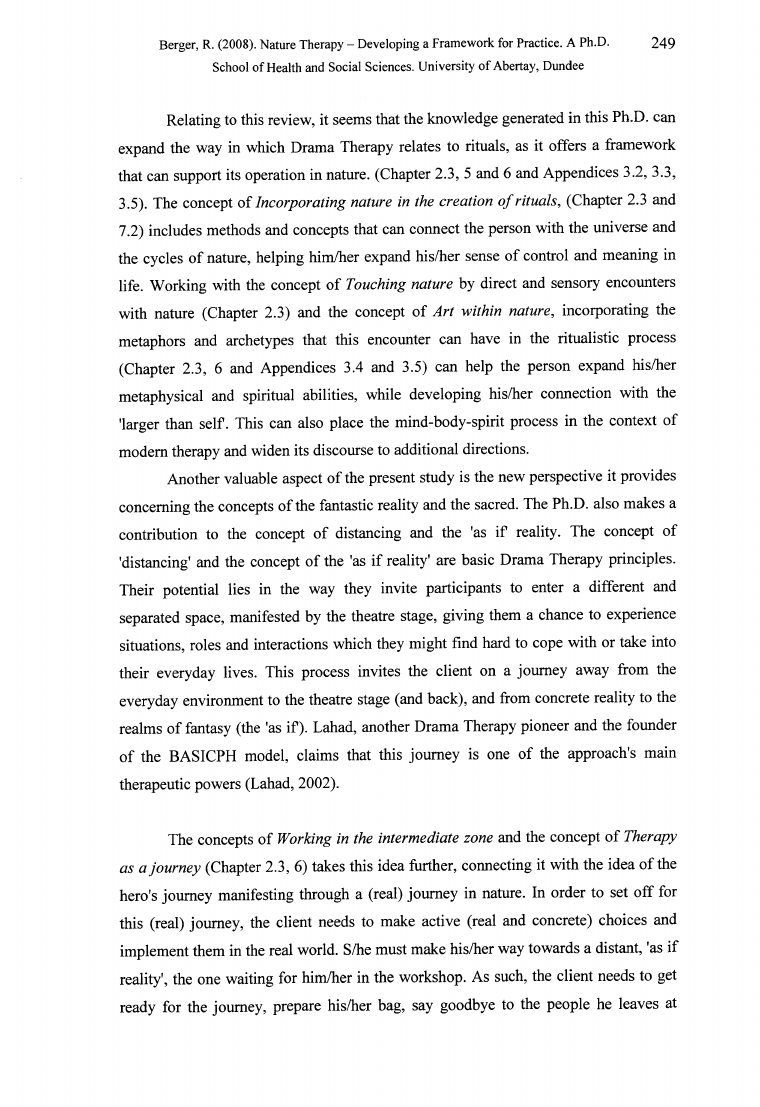
Berger, R. (2008). Nature Therapy - Developing a Framework for Practice. A Ph.D.
249
School of Health and Social Sciences. University of Abertay, Dundee
Relating to this review, it seems that the knowledge generated in this Ph.D. can
expand the way in which Drama Therapy relates to rituals, as it offers a framework
that can support its operation in nature. (Chapter 2.3, 5 and 6 and Appendices 3.2, 3.3,
3.5). The concept o f I n c o r p o r a tin g n a tu re in th e c r e a tio n o f r itu a ls , (Chapter 2.3 and
7.2) includes methods and concepts that can connect the person with the universe and
the cycles o f nature, helping him/her expand his/her sense o f control and meaning in
life. Working with the concept o f T o u ch in g n a tu re by direct and sensory encounters
with nature (Chapter 2.3) and the concept of A r t w ith in n a tu re, incorporating the
metaphors and archetypes that this encounter can have in the ritualistic process
(Chapter 2.3, 6 and Appendices 3.4 and 3.5) can help the person expand his/her
metaphysical and spiritual abilities, while developing his/her connection with the
'larger than self. This can also place the mind-body-spirit process in the context of
modem therapy and widen its discourse to additional directions.
Another valuable aspect o f the present study is the new perspective it provides
concerning the concepts of the fantastic reality and the sacred. The Ph.D. also makes a
contribution to the concept of distancing and the 'as if reality. The concept of
'distancing' and the concept of the 'as if reality' are basic Drama Therapy principles.
Their potential lies in the way they invite participants to enter a different and
separated space, manifested by the theatre stage, giving them a chance to experience
situations, roles and interactions which they might find hard to cope with or take into
their everyday lives. This process invites the client on a journey away from the
everyday environment to the theatre stage (and back), and from concrete reality to the
realms o f fantasy (the 'as if). Lahad, another Drama Therapy pioneer and the founder
o f the BASICPH model, claims that this journey is one of the approach's main
therapeutic powers (Lahad, 2002).
The concepts of W orkin g in the in term ed ia te zo n e and the concept of T h erapy
a s a jo u r n e y (Chapter 2.3, 6) takes this idea further, connecting it with the idea o f the
hero's journey manifesting through a (real) journey in nature. In order to set off for
this (real) journey, the client needs to make active (real and concrete) choices and
implement them in the real world. S/he must make his/her way towards a distant, 'as if
reality', the one waiting for him/her in the workshop. As such, the client needs to get
ready for the journey, prepare his/her bag, say goodbye to the people he leaves at
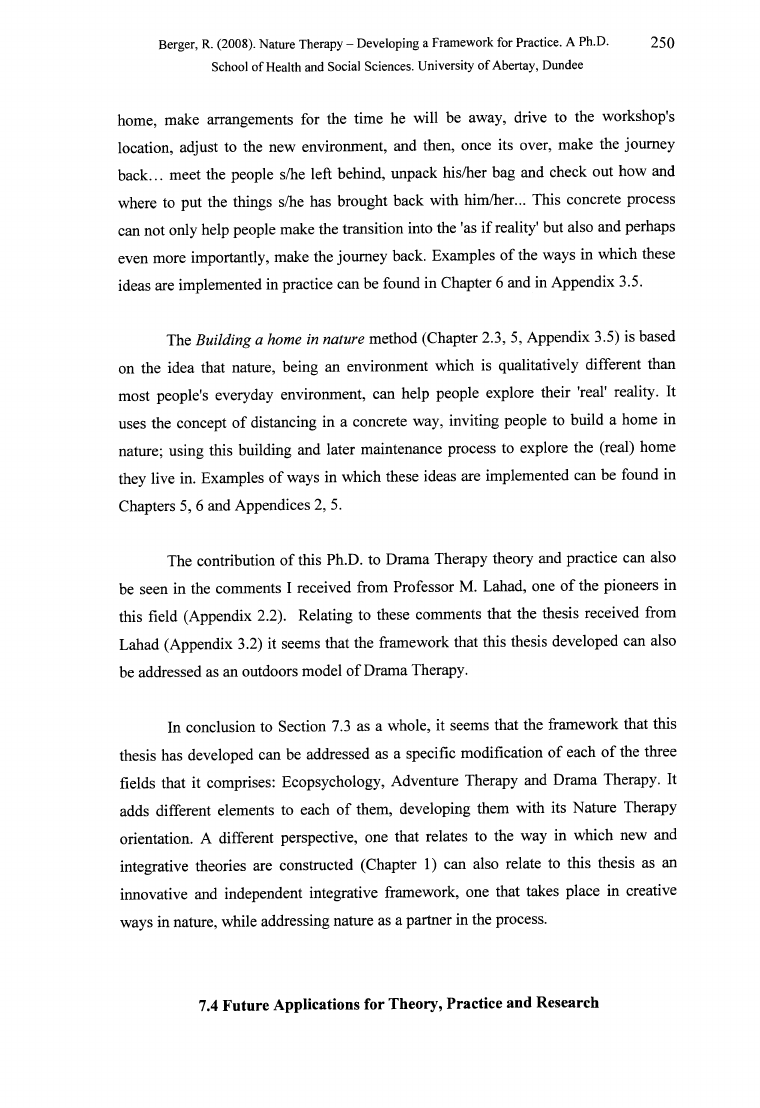
Berger, R. (2008). Nature Therapy - Developing a Framework for Practice. A Ph.D.
250
School of Health and Social Sciences. University of Abertay, Dundee
home, make arrangements for the time he will be away, drive to the workshop's
location, adjust to the new environment, and then, once its over, make the journey
back... meet the people s/he left behind, unpack his/her bag and check out how and
where to put the things s/he has brought back with him/her... This concrete process
can not only help people make the transition into the 'as if reality’ but also and perhaps
even more importantly, make the journey back. Examples of the ways in which these
ideas are implemented in practice can be found in Chapter 6 and in Appendix 3.5.
The Building a home in nature method (Chapter 2.3, 5, Appendix 3.5) is based
on the idea that nature, being an environment which is qualitatively different than
most people's everyday environment, can help people explore their 'real' reality. It
uses the concept of distancing in a concrete way, inviting people to build a home in
nature; using this building and later maintenance process to explore the (real) home
they live in. Examples o f ways in which these ideas are implemented can be found in
Chapters 5, 6 and Appendices 2, 5.
The contribution of this Ph.D. to Drama Therapy theory and practice can also
be seen in the comments I received from Professor M. Lahad, one o f the pioneers in
this field (Appendix 2.2). Relating to these comments that the thesis received from
Lahad (Appendix 3.2) it seems that the framework that this thesis developed can also
be addressed as an outdoors model o f Drama Therapy.
In conclusion to Section 7.3 as a whole, it seems that the framework that this
thesis has developed can be addressed as a specific modification of each of the three
fields that it comprises: Ecopsychology, Adventure Therapy and Drama Therapy. It
adds different elements to each of them, developing them with its Nature Therapy
orientation. A different perspective, one that relates to the way in which new and
integrative theories are constructed (Chapter 1) can also relate to this thesis as an
innovative and independent integrative framework, one that takes place in creative
ways in nature, while addressing nature as a partner in the process.
7.4 Future Applications for Theory, Practice and Research
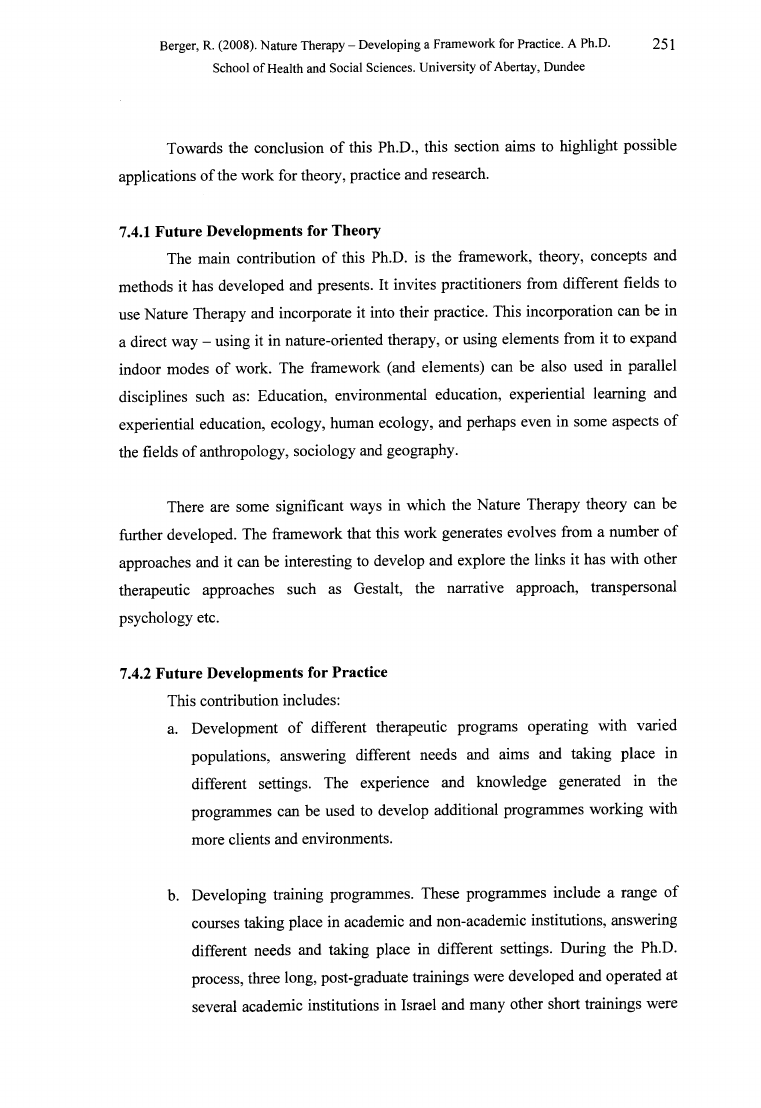
Berger, R. (2008). Nature Therapy - Developing a Framework for Practice. A Ph.D.
251
School of Health and Social Sciences. University of Abertay, Dundee
Towards the conclusion of this Ph.D., this section aims to highlight possible
applications of the work for theory, practice and research.
7.4.1 Future Developments for Theory
The main contribution o f this Ph.D. is the framework, theory, concepts and
methods it has developed and presents. It invites practitioners from different fields to
use Nature Therapy and incorporate it into their practice. This incorporation can be in
a direct way - using it in nature-oriented therapy, or using elements from it to expand
indoor modes o f work. The framework (and elements) can be also used in parallel
disciplines such as: Education, environmental education, experiential learning and
experiential education, ecology, human ecology, and perhaps even in some aspects of
the fields of anthropology, sociology and geography.
There are some significant ways in which the Nature Therapy theory can be
further developed. The framework that this work generates evolves from a number of
approaches and it can be interesting to develop and explore the links it has with other
therapeutic approaches such as Gestalt, the narrative approach, transpersonal
psychology etc.
7.4.2 Future Developments for Practice
This contribution includes:
a. Development o f different therapeutic programs operating with varied
populations, answering different needs and aims and taking place in
different settings. The experience and knowledge generated in the
programmes can be used to develop additional programmes working with
more clients and environments.
b. Developing training programmes. These programmes include a range of
courses taking place in academic and non-academic institutions, answering
different needs and taking place in different settings. During the Ph.D.
process, three long, post-graduate trainings were developed and operated at
several academic institutions in Israel and many other short trainings were
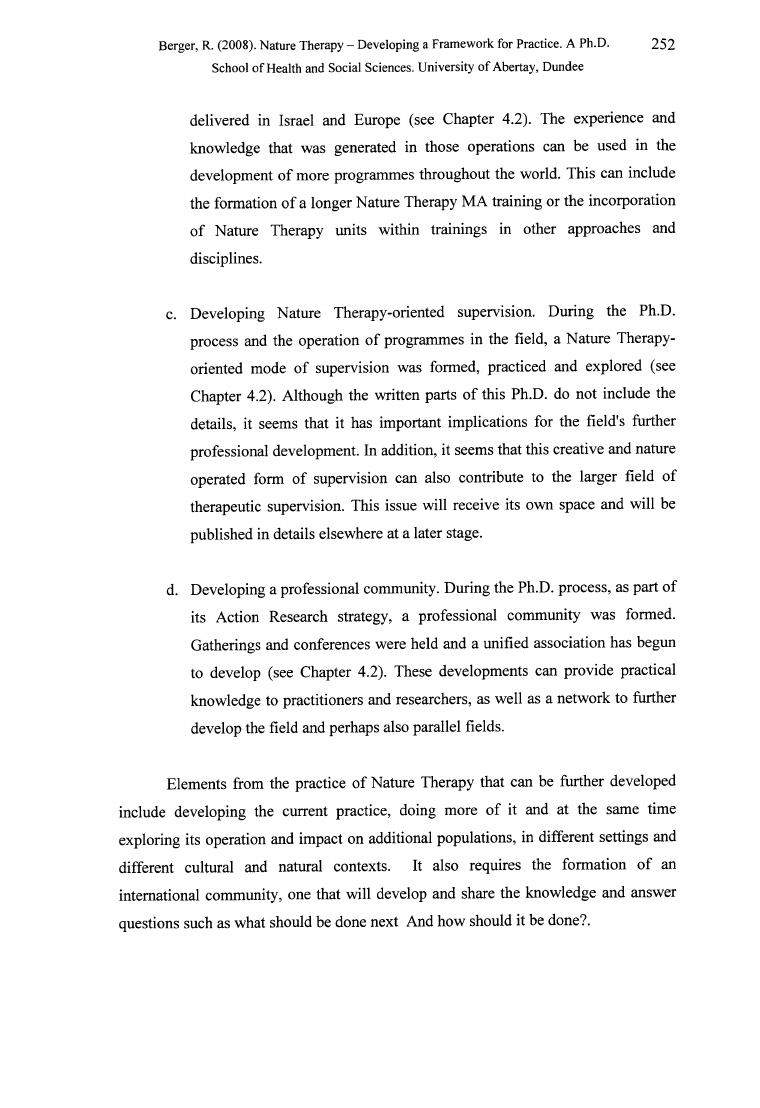
Berger, R. (2008). Nature Therapy - Developing a Framework for Practice. A Ph.D.
252
School of Health and Social Sciences. University of Abertay, Dundee
delivered in Israel and Europe (see Chapter 4.2). The experience and
knowledge that was generated in those operations can be used in the
development of more programmes throughout the world. This can include
the formation of a longer Nature Therapy MA training or the incorporation
of Nature Therapy units within trainings in other approaches and
disciplines.
c. Developing Nature Therapy-oriented supervision. During the Ph.D.
process and the operation of programmes in the field, a Nature Therapy-
oriented mode of supervision was formed, practiced and explored (see
Chapter 4.2). Although the written parts o f this Ph.D. do not include the
details, it seems that it has important implications for the field's further
professional development. In addition, it seems that this creative and nature
operated form of supervision can also contribute to the larger field of
therapeutic supervision. This issue will receive its own space and will be
published in details elsewhere at a later stage.
d. Developing a professional community. During the Ph.D. process, as part o f
its Action Research strategy, a professional community was formed.
Gatherings and conferences were held and a unified association has begun
to develop (see Chapter 4.2). These developments can provide practical
knowledge to practitioners and researchers, as well as a network to further
develop the field and perhaps also parallel fields.
Elements from the practice of Nature Therapy that can be further developed
include developing the current practice, doing more of it and at the same time
exploring its operation and impact on additional populations, in different settings and
different cultural and natural contexts. It also requires the formation o f an
international community, one that will develop and share the knowledge and answer
questions such as what should be done next And how should it be done?.
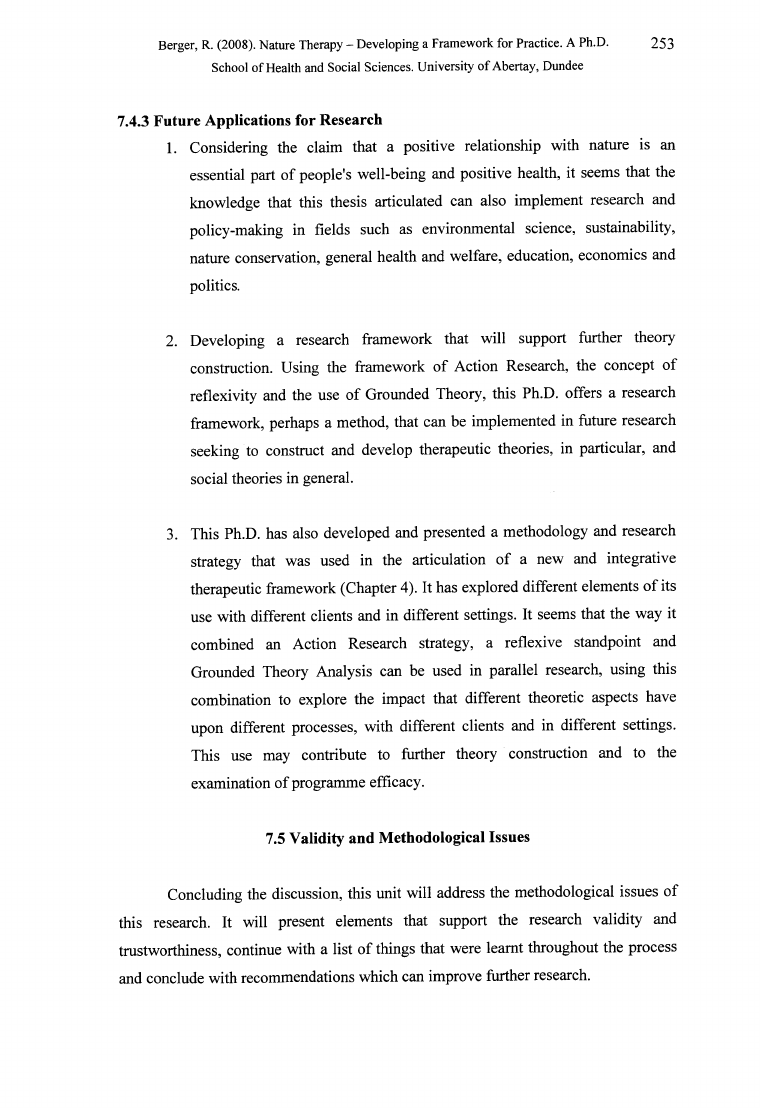
Berger, R. (2008). Nature Therapy - Developing a Framework for Practice. A Ph.D.
253
School of Health and Social Sciences. University of Abertay, Dundee
7.4.3 Future Applications for Research
1. Considering the claim that a positive relationship with nature is an
essential part of people's well-being and positive health, it seems that the
knowledge that this thesis articulated can also implement research and
policy-making in fields such as environmental science, sustainability,
nature conservation, general health and welfare, education, economics and
politics.
2. Developing a research framework that will support further theory
construction. Using the framework of Action Research, the concept of
reflexivity and the use of Grounded Theory, this Ph.D. offers a research
framework, perhaps a method, that can be implemented in future research
seeking to construct and develop therapeutic theories, in particular, and
social theories in general.
3. This Ph.D. has also developed and presented a methodology and research
strategy that was used in the articulation of a new and integrative
therapeutic framework (Chapter 4). It has explored different elements o f its
use with different clients and in different settings. It seems that the way it
combined an Action Research strategy, a reflexive standpoint and
Grounded Theory Analysis can be used in parallel research, using this
combination to explore the impact that different theoretic aspects have
upon different processes, with different clients and in different settings.
This use may contribute to further theory construction and to the
examination of programme efficacy.
7.5 Validity and Methodological Issues
Concluding the discussion, this unit will address the methodological issues of
this research. It will present elements that support the research validity and
trustworthiness, continue with a list of things that were learnt throughout the process
and conclude with recommendations which can improve further research.
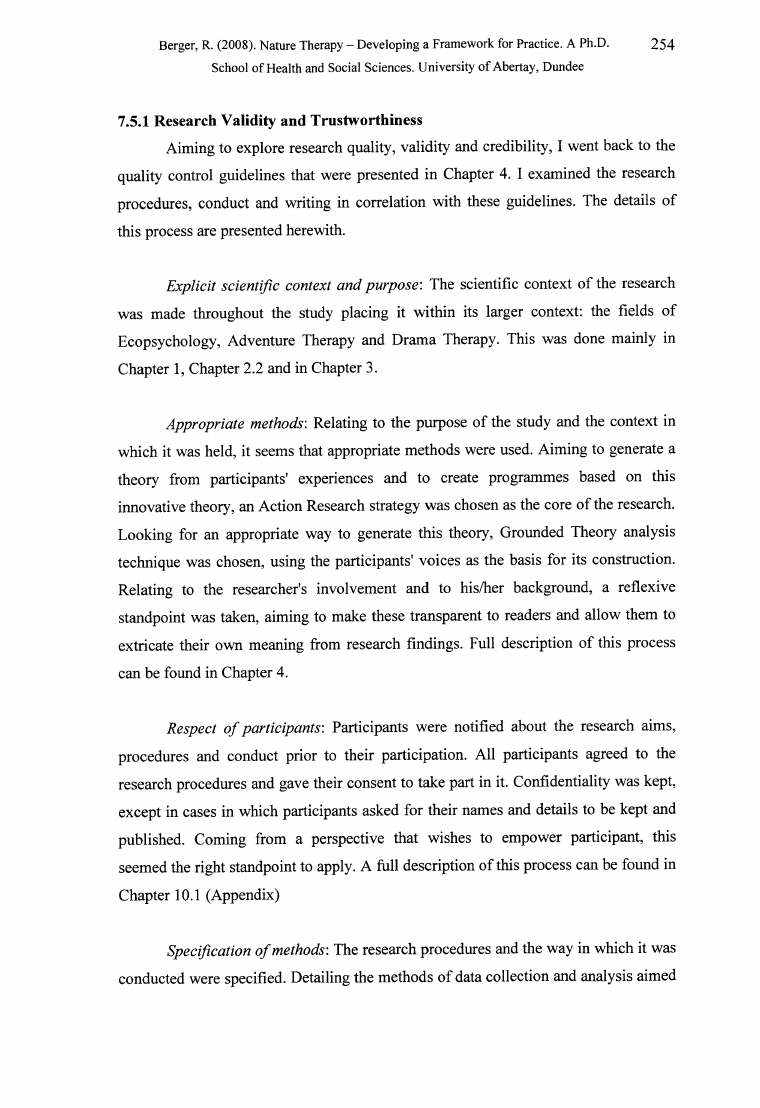
Berger, R. (2008). Nature Therapy - Developing a Framework for Practice. A Ph.D.
254
School of Health and Social Sciences. University of Abertay, Dundee
7.5.1 Research Validity and Trustworthiness
Aiming to explore research quality, validity and credibility, I went back to the
quality control guidelines that were presented in Chapter 4. I examined the research
procedures, conduct and writing in correlation with these guidelines. The details of
this process are presented herewith.
E x p licit sc ie n tific co n tex t a n d p u r p o s e : The scientific context o f the research
was made throughout the study placing it within its larger context: the fields o f
Ecopsychology, Adventure Therapy and Drama Therapy. This was done mainly in
Chapter 1, Chapter 2.2 and in Chapter 3.
A p p ro p ria te m eth o d s: Relating to the purpose of the study and the context in
which it was held, it seems that appropriate methods were used. Aiming to generate a
theory from participants' experiences and to create programmes based on this
innovative theory, an Action Research strategy was chosen as the core of the research.
Looking for an appropriate way to generate this theory, Grounded Theory analysis
technique was chosen, using the participants' voices as the basis for its construction.
Relating to the researcher's involvement and to his/her background, a reflexive
standpoint was taken, aiming to make these transparent to readers and allow them to
extricate their own meaning from research findings. Full description of this process
can be found in Chapter 4.
R e sp e c t o f p a r tic ip a n ts : Participants were notified about the research aims,
procedures and conduct prior to their participation. All participants agreed to the
research procedures and gave their consent to take part in it. Confidentiality was kept,
except in cases in which participants asked for their names and details to be kept and
published. Coming from a perspective that wishes to empower participant, this
seemed the right standpoint to apply. A full description of this process can be found in
Chapter 10.1 (Appendix)
S p ecifica tio n o f m eth o d s: The research procedures and the way in which it was
conducted were specified. Detailing the methods of data collection and analysis aimed
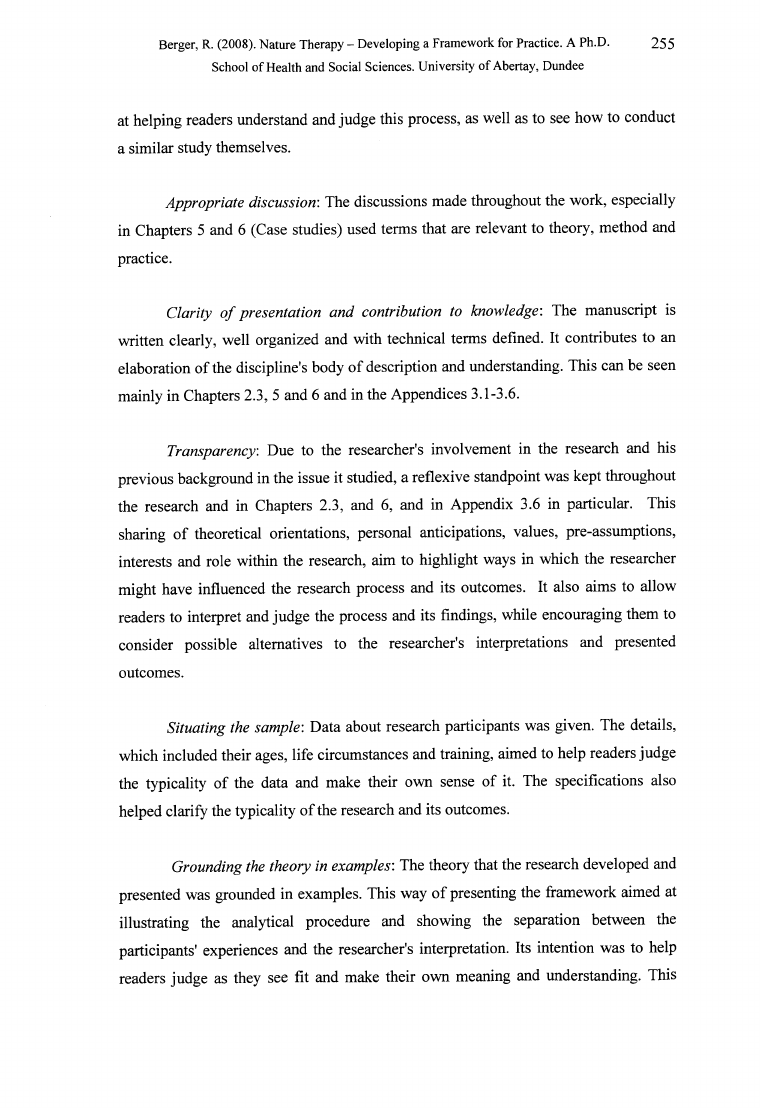
Berger, R. (2008). Nature Therapy - Developing a Framework for Practice. A Ph.D.
255
School of Health and Social Sciences. University of Abertay, Dundee
at helping readers understand and judge this process, as well as to see how to conduct
a similar study themselves.
A p p ro p ria te d isc u ssio n : The discussions made throughout the work, especially
in Chapters 5 and 6 (Case studies) used terms that are relevant to theory, method and
practice.
C la r ity o f p r e s e n ta tio n a n d c o n tr ib u tio n to k n o w le d g e : The manuscript is
written clearly, well organized and with technical terms defined. It contributes to an
elaboration of the discipline's body o f description and understanding. This can be seen
mainly in Chapters 2.3, 5 and 6 and in the Appendices 3.1-3.6.
T ra n sp a re n c y : Due to the researcher's involvement in the research and his
previous background in the issue it studied, a reflexive standpoint was kept throughout
the research and in Chapters 2.3, and 6, and in Appendix 3.6 in particular. This
sharing o f theoretical orientations, personal anticipations, values, pre-assumptions,
interests and role within the research, aim to highlight ways in which the researcher
might have influenced the research process and its outcomes. It also aims to allow
readers to interpret and judge the process and its findings, while encouraging them to
consider possible alternatives to the researcher's interpretations and presented
outcomes.
S itu a tin g the s a m p le : Data about research participants was given. The details,
which included their ages, life circumstances and training, aimed to help readers judge
the typicality of the data and make their own sense of it. The specifications also
helped clarify the typicality of the research and its outcomes.
G ro u n d in g the th e o ry in e x a m p les: The theory that the research developed and
presented was grounded in examples. This way o f presenting the framework aimed at
illustrating the analytical procedure and showing the separation between the
participants' experiences and the researcher's interpretation. Its intention was to help
readers judge as they see fit and make their own meaning and understanding. This
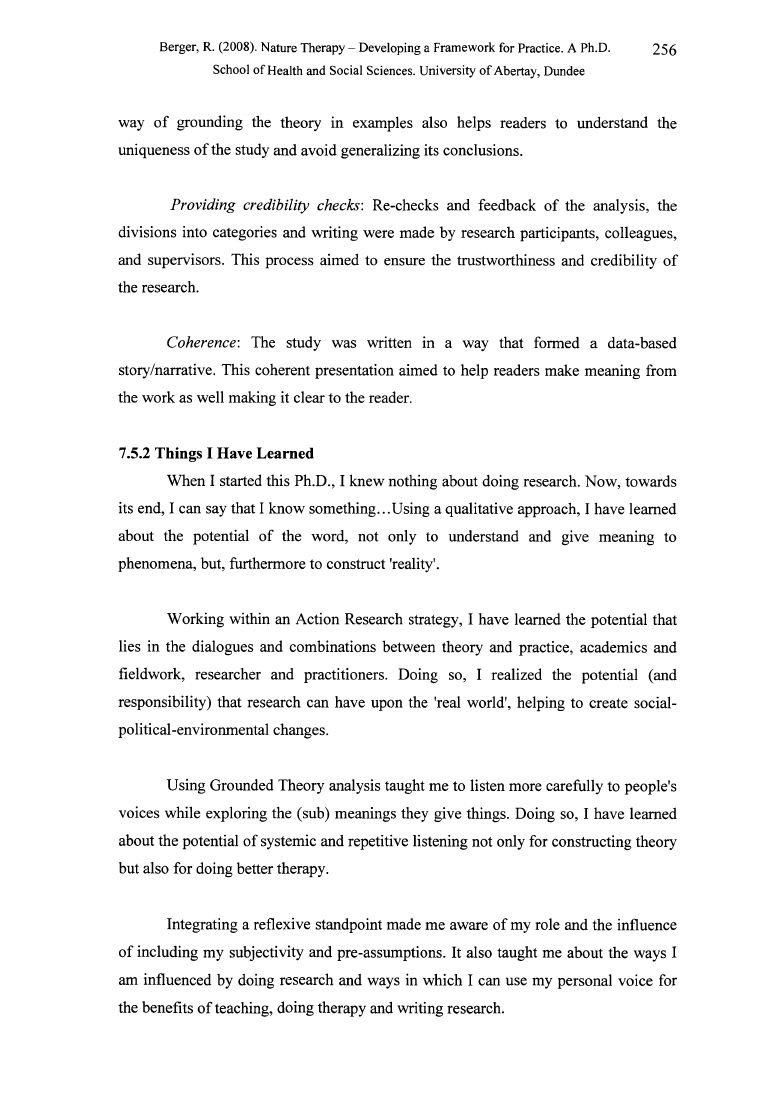
Berger, R. (2008). Nature Therapy - Developing a Framework for Practice. A Ph.D.
256
School of Health and Social Sciences. University of Abertay, Dundee
way o f grounding the theory in examples also helps readers to understand the
uniqueness o f the study and avoid generalizing its conclusions.
Providing credibility checks: Re-checks and feedback of the analysis, the
divisions into categories and writing were made by research participants, colleagues,
and supervisors. This process aimed to ensure the trustworthiness and credibility of
the research.
Coherence: The study was written in a way that formed a data-based
story/narrative. This coherent presentation aimed to help readers make meaning from
the work as well making it clear to the reader.
7.5.2 Things I Have Learned
When I started this Ph.D., I knew nothing about doing research. Now, towards
its end, I can say that I know something...Using a qualitative approach, I have learned
about the potential of the word, not only to understand and give meaning to
phenomena, but, furthermore to construct 'reality'.
Working within an Action Research strategy, I have learned the potential that
lies in the dialogues and combinations between theory and practice, academics and
fieldwork, researcher and practitioners. Doing so, I realized the potential (and
responsibility) that research can have upon the 'real world', helping to create social-
political-environmental changes.
Using Grounded Theory analysis taught me to listen more carefully to people's
voices while exploring the (sub) meanings they give things. Doing so, I have learned
about the potential of systemic and repetitive listening not only for constructing theory
but also for doing better therapy.
Integrating a reflexive standpoint made me aware of my role and the influence
of including my subjectivity and pre-assumptions. It also taught me about the ways I
am influenced by doing research and ways in which I can use my personal voice for
the benefits of teaching, doing therapy and writing research.
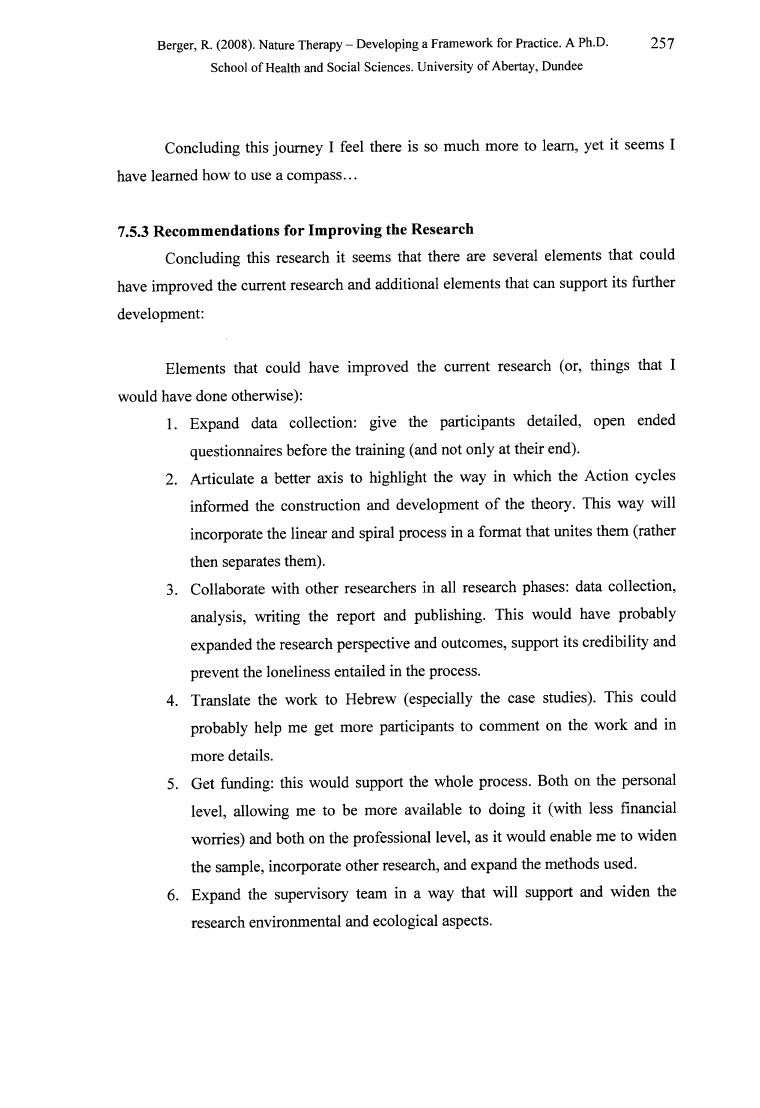
Berger, R. (2008). Nature Therapy - Developing a Framework for Practice. A Ph.D.
257
School of Health and Social Sciences. University of Abertay, Dundee
Concluding this journey I feel there is so much more to learn, yet it seems I
have learned how to use a com pass...
7.5.3 Recommendations for Improving the Research
Concluding this research it seems that there are several elements that could
have improved the current research and additional elements that can support its further
development:
Elements that could have improved the current research (or, things that I
would have done otherwise):
1. Expand data collection: give the participants detailed, open ended
questionnaires before the training (and not only at their end).
2. Articulate a better axis to highlight the way in which the Action cycles
informed the construction and development of the theory. This way will
incorporate the linear and spiral process in a format that unites them (rather
then separates them).
3. Collaborate with other researchers in all research phases: data collection,
analysis, writing the report and publishing. This would have probably
expanded the research perspective and outcomes, support its credibility and
prevent the loneliness entailed in the process.
4. Translate the work to Hebrew (especially the case studies). This could
probably help me get more participants to comment on the work and in
more details.
5. Get funding: this would support the whole process. Both on the personal
level, allowing me to be more available to doing it (with less financial
worries) and both on the professional level, as it would enable me to widen
the sample, incorporate other research, and expand the methods used.
6. Expand the supervisory team in a way that will support and widen the
research environmental and ecological aspects.
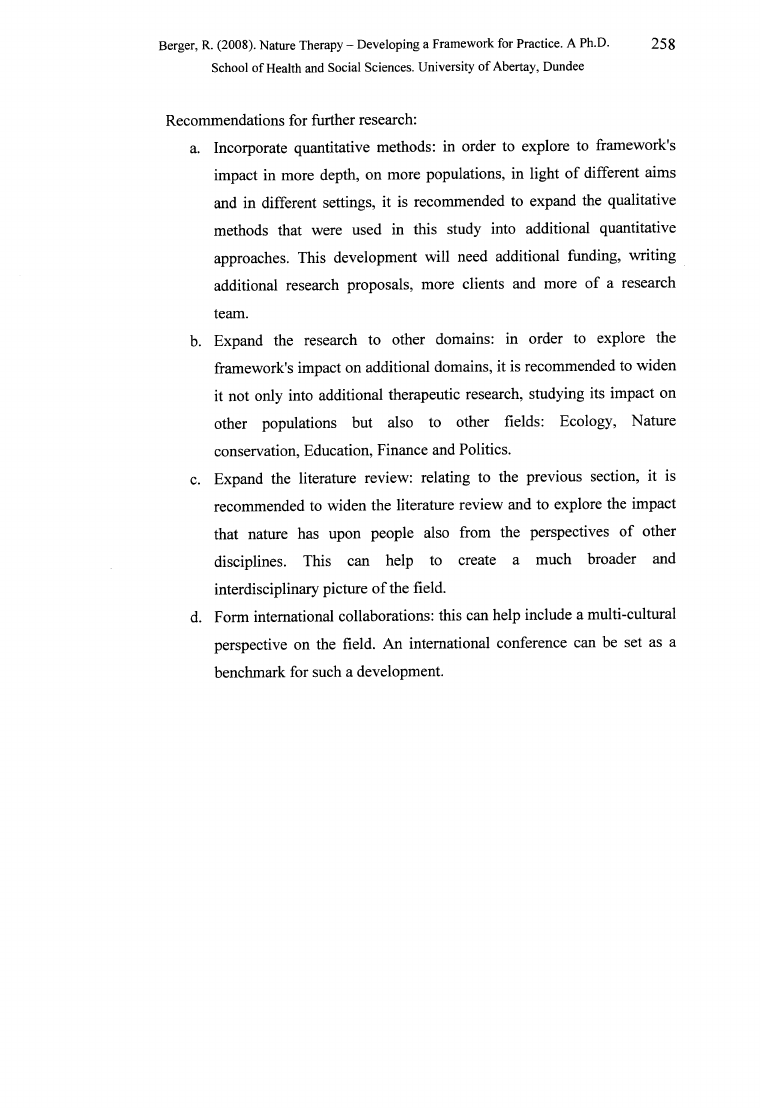
Berger, R. (2008). Nature Therapy - Developing a Framework for Practice. A Ph.D.
258
School of Health and Social Sciences. University of Abertay, Dundee
Recommendations for further research:
a. Incorporate quantitative methods: in order to explore to framework's
impact in more depth, on more populations, in light of different aims
and in different settings, it is recommended to expand the qualitative
methods that were used in this study into additional quantitative
approaches. This development will need additional funding, writing
additional research proposals, more clients and more of a research
team.
b. Expand the research to other domains: in order to explore the
framework's impact on additional domains, it is recommended to widen
it not only into additional therapeutic research, studying its impact on
other populations but also to other fields: Ecology, Nature
conservation, Education, Finance and Politics.
c. Expand the literature review: relating to the previous section, it is
recommended to widen the literature review and to explore the impact
that nature has upon people also from the perspectives of other
disciplines. This can help to create a much broader and
interdisciplinary picture of the field.
d. Form international collaborations: this can help include a multi-cultural
perspective on the field. An international conference can be set as a
benchmark for such a development.
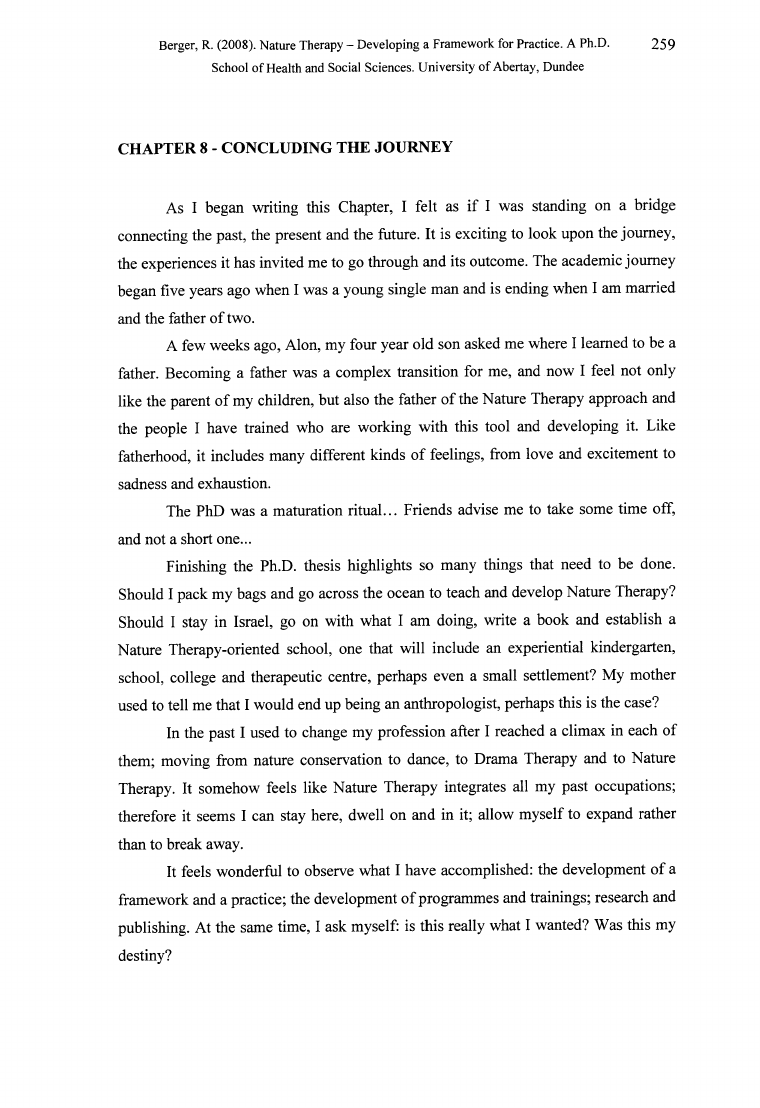
Berger, R. (2008). Nature Therapy - Developing a Framework for Practice. A Ph.D.
259
School of Health and Social Sciences. University of Abertay, Dundee
CHAPTER 8 - CONCLUDING THE JOURNEY
As I began writing this Chapter, I felt as if I was standing on a bridge
connecting the past, the present and the future. It is exciting to look upon the journey,
the experiences it has invited me to go through and its outcome. The academic journey
began five years ago when I was a young single man and is ending when I am married
and the father of two.
A few weeks ago, Alon, my four year old son asked me where I learned to be a
father. Becoming a father was a complex transition for me, and now I feel not only
like the parent o f my children, but also the father o f the Nature Therapy approach and
the people I have trained who are working with this tool and developing it. Like
fatherhood, it includes many different kinds of feelings, from love and excitement to
sadness and exhaustion.
The PhD was a maturation ritual... Friends advise me to take some time off,
and not a short one...
Finishing the Ph.D. thesis highlights so many things that need to be done.
Should I pack my bags and go across the ocean to teach and develop Nature Therapy?
Should I stay in Israel, go on with what I am doing, write a book and establish a
Nature Therapy-oriented school, one that will include an experiential kindergarten,
school, college and therapeutic centre, perhaps even a small settlement? My mother
used to tell me that I would end up being an anthropologist, perhaps this is the case?
In the past I used to change my profession after I reached a climax in each of
them; moving from nature conservation to dance, to Drama Therapy and to Nature
Therapy. It somehow feels like Nature Therapy integrates all my past occupations;
therefore it seems I can stay here, dwell on and in it; allow myself to expand rather
than to break away.
It feels wonderful to observe what I have accomplished: the development o f a
framework and a practice; the development of programmes and trainings; research and
publishing. At the same time, I ask myself: is this really what I wanted? Was this my
destiny?

Berger, R. (2008). Nature Therapy - Developing a Framework for Practice. A Ph.D.
260
School of Health and Social Sciences. University of Abertay, Dundee
Perhaps it has all just been part of the process; the journey of an artistic and
humanistic nature conservationist, who fears for the future of his children on a planet
that is in a constant process o f losing its nature.
Standing on the bridge I wonder, what is it that my soul truly seeks?
Ronen Berger
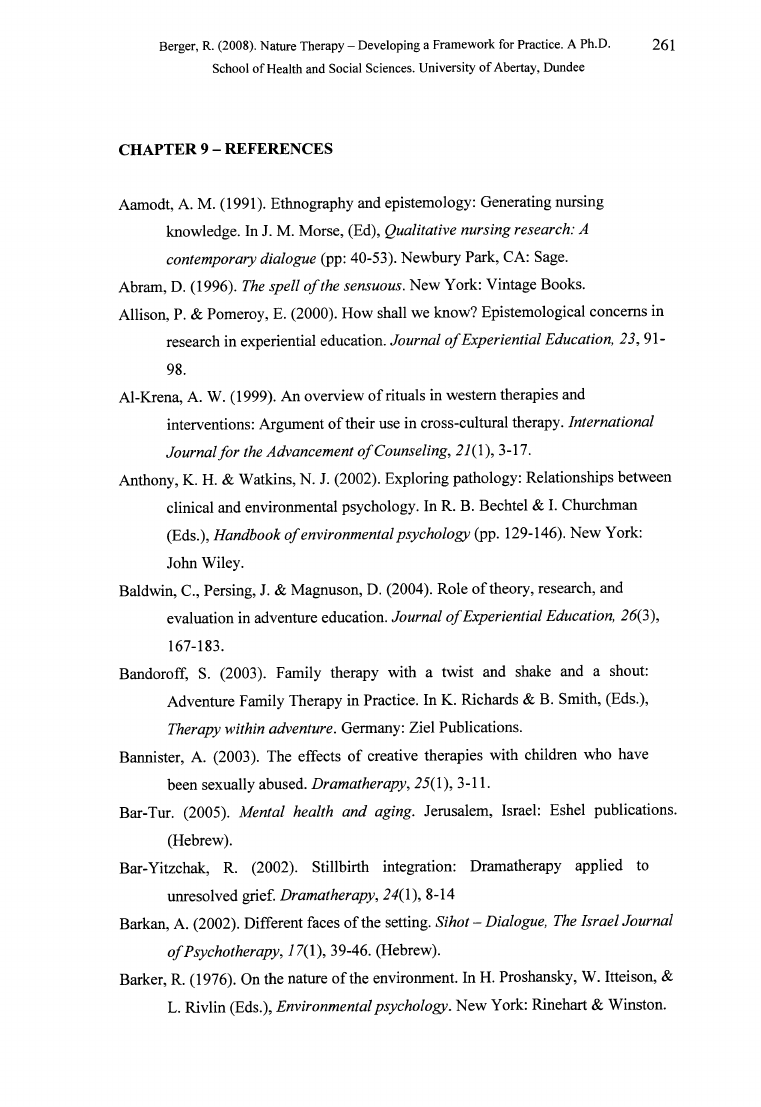
Berger, R. (2008). Nature Therapy - Developing a Framework for Practice. A Ph.D.
261
School of Health and Social Sciences. University of Abertay, Dundee
CHAPTER 9 - REFERENCES
Aamodt, A. M. (1991). Ethnography and epistemology: Generating nursing
knowledge. In J. M. Morse, (Ed), Q u a lita tiv e n u rsin g re se a rc h : A
c o n te m p o ra ry d ia lo g u e (pp: 40-53). Newbury Park, CA: Sage.
Abram, D. (1996). The s p e ll o f th e se n su o u s. New York: Vintage Books.
Allison, P. & Pomeroy, E. (2000). How shall we know? Epistemological concerns in
research in experiential education. J o u rn a l o f E x p e rien tia l E du cation , 2 3 , 91-
98.
Al-Krena, A. W. (1999). An overview o f rituals in western therapies and
interventions: Argument o f their use in cross-cultural therapy. In tern a tio n a l
J o u r n a l f o r the A d v a n c e m e n t o f C o u n se lin g , 2 1 (1 ), 3-17.
Anthony, K. H. & Watkins, N. J. (2002). Exploring pathology: Relationships between
clinical and environmental psychology. In R. B. Bechtel & I. Churchman
(Eds.), H a n d b o o k o f e n v iro n m e n ta l p s y c h o lo g y (pp. 129-146). New York:
John Wiley.
Baldwin, C., Persing, J. & Magnuson, D. (2004). Role o f theory, research, and
evaluation in adventure education. J o u rn a l o f E x p e rien tia l E du cation , 2 6 (3 ),
167-183.
Bandoroff, S. (2003). Family therapy with a twist and shake and a shout:
Adventure Family Therapy in Practice. In K. Richards & B. Smith, (Eds.),
T h era p y w ith in a d ven tu re. Germany: Ziel Publications.
Bannister, A. (2003). The effects of creative therapies with children who have
been sexually abused. D ra m a th era p y , 25(1), 3-11.
Bar-Tur. (2005). M e n ta l h e a lth a n d a g in g . Jerusalem, Israel: Eshel publications.
(Hebrew).
Bar-Yitzchak, R. (2002). Stillbirth integration: Dramatherapy applied to
unresolved grief. D r a m a th e ra p y , 24(1), 8-14
Barkan, A. (2002). Different faces o f the setting. S ih o t - D ia lo g u e, The I s ra e l J o u rn a l
o f P sy c h o th e ra p y , 77(1), 39-46. (Hebrew).
Barker, R. (1976). On the nature o f the environment. In H. Proshansky, W. Itteison, &
L. Rivlin (Eds.), E n v iro n m e n ta l p s y c h o lo g y . New York: Rinehart & Winston.
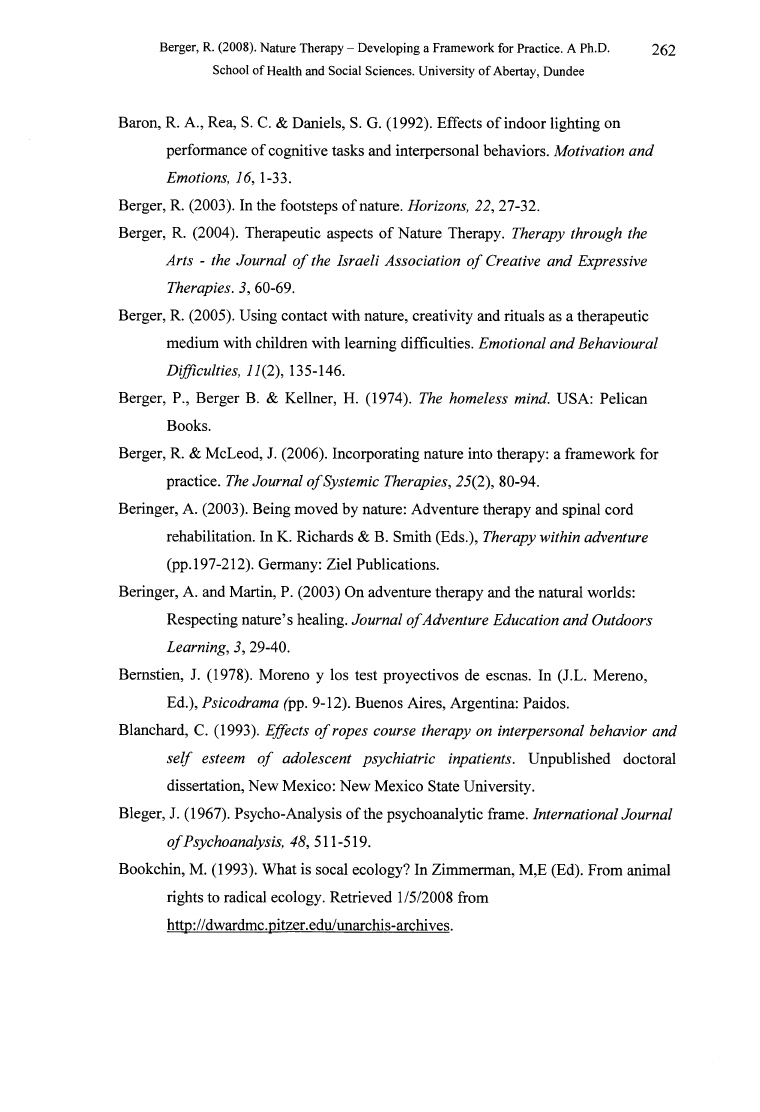
Berger, R. (2008). Nature Therapy - Developing a Framework for Practice. A Ph.D.
262
School of Health and Social Sciences. University of Abertay, Dundee
Baron, R. A., Rea, S. C. & Daniels, S. G. (1992). Effects o f indoor lighting on
performance of cognitive tasks and interpersonal behaviors. M o tiva tio n a n d
E m o tio n s, 16 , 1-33.
Berger, R. (2003). In the footsteps o f nature. H orizon s, 2 2 , 27-32.
Berger, R. (2004). Therapeutic aspects o f Nature Therapy. T h e ra p y th ro u g h th e
A rts - the Journal o f the Isra eli A sso cia tio n o f C rea tive a n d E xpressive
T h era p ies. 3, 60-69.
Berger, R. (2005). Using contact with nature, creativity and rituals as a therapeutic
medium with children with learning difficulties. E m o tio n a l a n d B eh a vio u ra l
D iffic u ltie s, 77(2), 135-146.
Berger, P., Berger B. & Kellner, H. (1974). The h o m e le ss m in d . USA: Pelican
Books.
Berger, R. & McLeod, J. (2006). Incorporating nature into therapy: a framework for
practice. The J o u rn a l o f S y ste m ic T h e ra p ies, 2 5 (2 ), 80-94.
Beringer, A. (2003). Being moved by nature: Adventure therapy and spinal cord
rehabilitation. In K. Richards & B. Smith (Eds.), T h era p y w ith in a d v e n tu re
(pp. 197-212). Germany: Ziel Publications.
Beringer, A. and Martin, P. (2003) On adventure therapy and the natural worlds:
Respecting nature’s healing. J o u rn a l o f A d v e n tu re E d u ca tio n a n d O u td o o rs
L e a rn in g , 3 , 29-40.
Bemstien, J. (1978). Moreno y los test proyectivos de escnas. In (J.L. Mereno,
Ed.), P s ic o d r a m a (pp. 9-12). Buenos Aires, Argentina: Paidos.
Blanchard, C. (1993). E ffe c ts o f r o p e s c o u r s e th e r a p y o n in te r p e r s o n a l b e h a v io r a n d
s e l f esteem o f a d o le sc e n t p s y c h ia tr ic in p a tien ts. Unpublished doctoral
dissertation, New Mexico: New Mexico State University.
Bleger, J. (1967). Psycho-Analysis o f the psychoanalytic frame. In tern a tio n a l J o u rn a l
o f P sy c h o a n a ly s is , 4 8 , 511-519.
Bookchin, M. (1993). What is socal ecology? In Zimmerman, M,E (Ed). From animal
rights to radical ecology. Retrieved 1/5/2008 from
http://dwardmc.pitzer.edu/unarchis-archives.
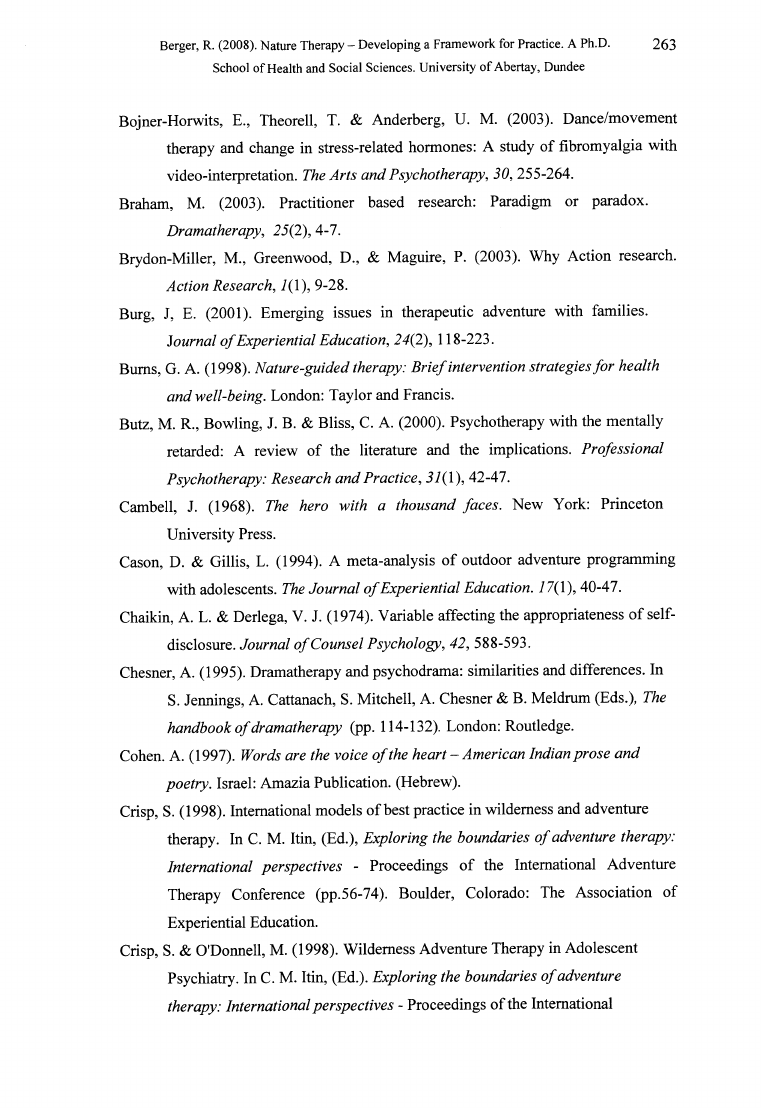
Berger, R. (2008). Nature Therapy - Developing a Framework for Practice. A Ph.D.
263
School of Health and Social Sciences. University of Abertay, Dundee
Bojner-Horwits, E., Theorell, T. & Anderberg, U. M. (2003). Dance/movement
therapy and change in stress-related hormones: A study of fibromyalgia with
video-interpretation. The A rts a n d P sy c h o th e ra p y , 30, 255-264.
Braham, M. (2003). Practitioner based research: Paradigm or paradox.
D ra m a th era p y , 2 5 (2 ), 4-7.
Brydon-Miller, M., Greenwood, D., & Maguire, P. (2003). Why Action research.
A c tio n R e se a rch , 7(1), 9-28.
Burg, J, E. (2001). Emerging issues in therapeutic adventure with families.
J o u rn a l o f E x p e rie n tia l E d u ca tio n , 2 4 (2 ), 118-223.
Bums, G. A. (1998). N a tu r e -g u id e d th e r a p y : B r i e f in te r v e n tio n s tr a te g ie s f o r h e a lth
a n d w ell-b ein g . London: Taylor and Francis.
Butz, M. R., Bowling, J. B. & Bliss, C. A. (2000). Psychotherapy with the mentally
retarded: A review of the literature and the implications. P ro fe ssio n a l
P sy c h o th era p y : R e se a rch a n d P r a c tic e , 37(1), 42-47.
Cambell, J. (1968). The h ero w ith a th o u sa n d f a c e s . New York: Princeton
University Press.
Cason, D. & Gillis, L. (1994). A meta-analysis o f outdoor adventure programming
with adolescents. The J o u rn a l o f E x p e rie n tia l E d u ca tio n . 77(1), 40-47.
Chaikin, A. L. & Derlega, V. J. (1974). Variable affecting the appropriateness o f self
disclosure. J o u rn a l o f C o u n sel P sy c h o lo g y , 4 2 , 588-593.
Chesner, A. (1995). Dramatherapy and psychodrama: similarities and differences. In
S. Jennings, A. Cattanach, S. Mitchell, A. Chesner & B. Meldrum (Eds.), The
h a n d b o o k o f d r a m a th e r a p y (pp. 114-132). London: Routledge.
Cohen. A. (1997). W o rd s a r e th e v o ic e o f th e h e a r t —A m e r ic a n In d ia n p r o s e a n d
p o e tr y . Israel: Amazia Publication. (Hebrew).
Crisp, S. (1998). International models o f best practice in wilderness and adventure
therapy. In C. M. Itin, (Ed.), E x p lo r in g th e b o u n d a r ie s o f a d v e n tu re th e r a p y :
In tern a tio n a l p e r s p e c tiv e s - Proceedings o f the International Adventure
Therapy Conference (pp.56-74). Boulder, Colorado: The Association of
Experiential Education.
Crisp, S. & O'Donnell, M. (1998). Wilderness Adventure Therapy in Adolescent
Psychiatry. In C. M. Itin, (Ed.). E x p lo rin g th e b o u n d a rie s o f a d v e n tu re
th era p y: In tern a tio n a l p e r s p e c tiv e s - Proceedings o f the International
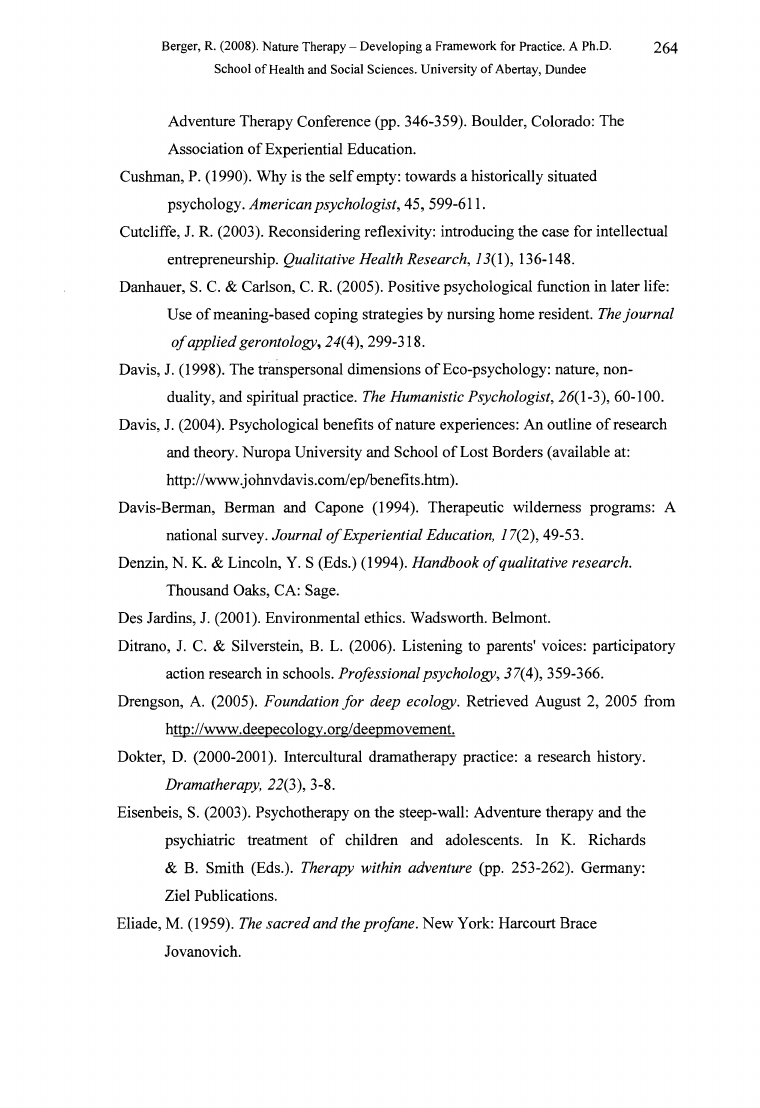
Berger, R. (2008). Nature Therapy - Developing a Framework for Practice. A Ph.D.
264
School of Health and Social Sciences. University of Abertay, Dundee
Adventure Therapy Conference (pp. 346-359). Boulder, Colorado: The
Association of Experiential Education.
Cushman, P. (1990). Why is the self empty: towards a historically situated
psychology. A m erica n p s y c h o lo g is t, 45, 599-611.
Cutcliffe, J. R. (2003). Reconsidering reflexivity: introducing the case for intellectual
entrepreneurship. Q u a lita tiv e H e a lth R e se a rch , 73(1), 136-148.
Danhauer, S. C. & Carlson, C. R. (2005). Positive psychological function in later life:
Use of meaning-based coping strategies by nursing home resident. The jo u r n a l
o f a p p lie d g e r o n to lo g y ,2 4 ( 4 ), 299-318.
Davis, J. (1998). The transpersonal dimensions o f Eco-psychology: nature, non
duality, and spiritual practice. The H u m a n istic P sy c h o lo g ist, 26(1-3), 60-100.
Davis, J. (2004). Psychological benefits o f nature experiences: An outline o f research
and theory. Nuropa University and School o f Lost Borders (available at:
http ://www.j ohnvdavis.com/ep/benefits .htm).
Davis-Berman, Berman and Capone (1994). Therapeutic wilderness programs: A
national survey. J o u r n a l o f E x p e r ie n tia l E d u ca tio n , 1 7(2), 49-53.
Denzin, N. K. & Lincoln, Y. S (Eds.) (1994). H a n d b o o k o f q u a lita tiv e r e se a r c h .
Thousand Oaks, CA: Sage.
Des Jardins, J. (2001). Environmental ethics. Wadsworth. Belmont.
Ditrano, J. C. & Silverstein, B. L. (2006). Listening to parents' voices: participatory
action research in schools. P ro fe ssio n a l p s y c h o lo g y , 37(4), 359-366.
Drengson, A. (2005). F o u n d a tio n f o r d e e p e c o lo g y . Retrieved August 2, 2005 from
http ://www.deepecolo gy.org/deepmovement.
Dokter, D. (2000-2001). Intercultural dramatherapy practice: a research history.
D r a m a th e r a p y , 22(3), 3-8.
Eisenbeis, S. (2003). Psychotherapy on the steep-wall: Adventure therapy and the
psychiatric treatment o f children and adolescents. In K. Richards
& B. Smith (Eds.). T h e ra p y w ith in a d v e n tu re (pp. 253-262). Germany:
Ziel Publications.
Eliade, M. (1959). The s a c r e d a n d th e p ro fa n e . New York: Harcourt Brace
Jovanovich.
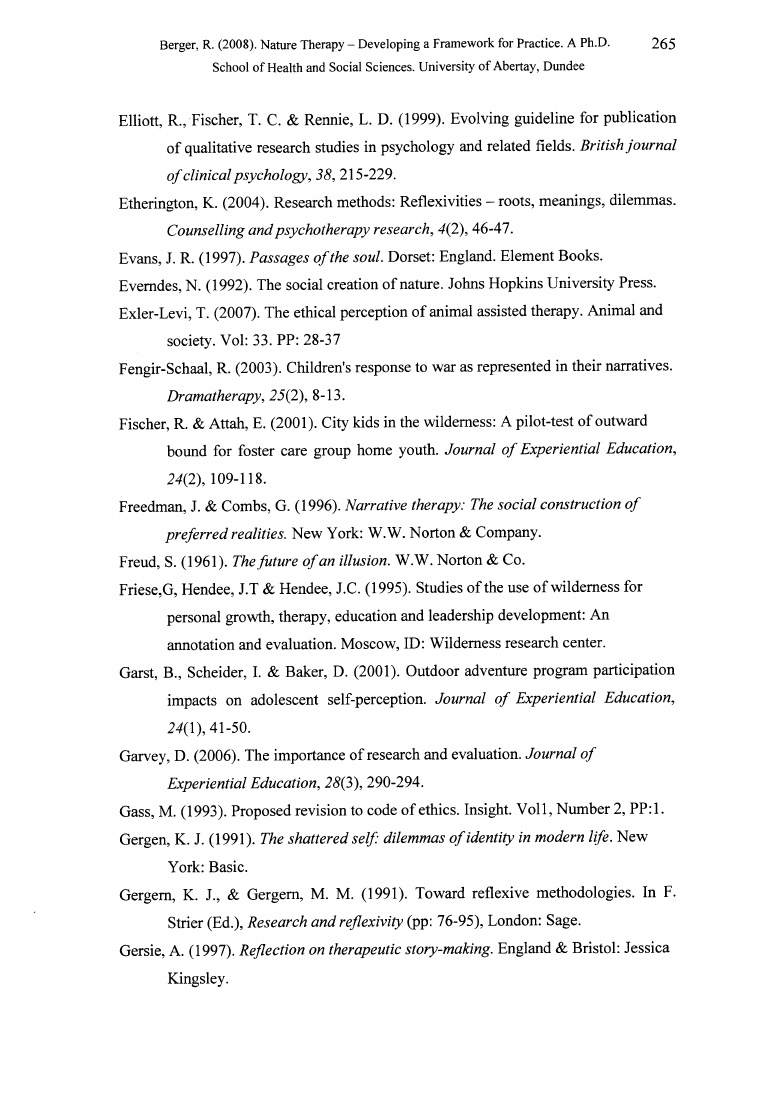
Berger, R. (2008). Nature Therapy - Developing a Framework for Practice. A Ph.D.
265
School of Health and Social Sciences. University of Abertay, Dundee
Elliott, R., Fischer, T. C. & Rennie, L. D. (1999). Evolving guideline for publication
of qualitative research studies in psychology and related fields. B ritish jo u r n a l
o f c lin ic a l p s y c h o lo g y , 3 8 , 215-229.
Etherington, K. (2004). Research methods: Reflexivities - roots, meanings, dilemmas.
C o u n sellin g a n d p s y c h o th e r a p y re se a rc h , 4 (2 ), 46-47.
Evans, J. R. (1997). P a s s a g e s o f the s o u l Dorset: England. Element Books.
Evemdes, N. (1992). The social creation of nature. Johns Hopkins University Press.
Exler-Levi, T. (2007). The ethical perception o f animal assisted therapy. Animal and
society. Vol: 33. PP: 28-37
Fengir-Schaal, R. (2003). Children's response to war as represented in their narratives.
D r a m a th e ra p y , 2 5 (2 ), 8-13.
Fischer, R. & Attah, E. (2001). City kids in the wilderness: A pilot-test o f outward
bound for foster care group home youth. J o u rn a l o f E x p e rien tia l E d u ca tio n ,
2 4 (2 ), 109-118.
Freedman, J. & Combs, G. (1996). N a r r a tiv e th e ra p y : The s o c ia l c o n s tr u c tio n o f
p r e fe r r e d re a litie s. New York: W.W. Norton & Company.
Freud, S. (1961). The fu tu r e o f a n illu sio n . W.W. Norton & Co.
Friese,G, Hendee, J.T & Hendee, J.C. (1995). Studies o f the use o f wilderness for
personal growth, therapy, education and leadership development: An
annotation and evaluation. Moscow, ID: Wilderness research center.
Garst, B., Scheider, I. & Baker, D. (2001). Outdoor adventure program participation
impacts on adolescent self-perception. J o u rn a l o f E x p e rien tia l E d u ca tio n ,
2 4 ( 1), 41-50.
Garvey, D. (2006). The importance o f research and evaluation. J o u r n a l o f
E x p e rien tia l E d u ca tio n , 2 8 (3 ), 290-294.
Gass, M. (1993). Proposed revision to code o f ethics. Insight. V o ll, Number 2, PP:1.
Gergen, K. J. (1991). T he s h a tte r e d se lf: d ile m m a s o f id e n tity in m o d e r n life. New
York: Basic.
Gergem, K. J., & Gergem, M. M. (1991). Toward reflexive methodologies. In F.
Strier (Ed.), R e se a rch a n d re fle x iv ity (pp: 76-95), London: Sage.
Gersie, A. (1997). R e fle c tio n o n th e ra p e u tic s to ry -m a k in g . England & Bristol: Jessica
Kingsley.
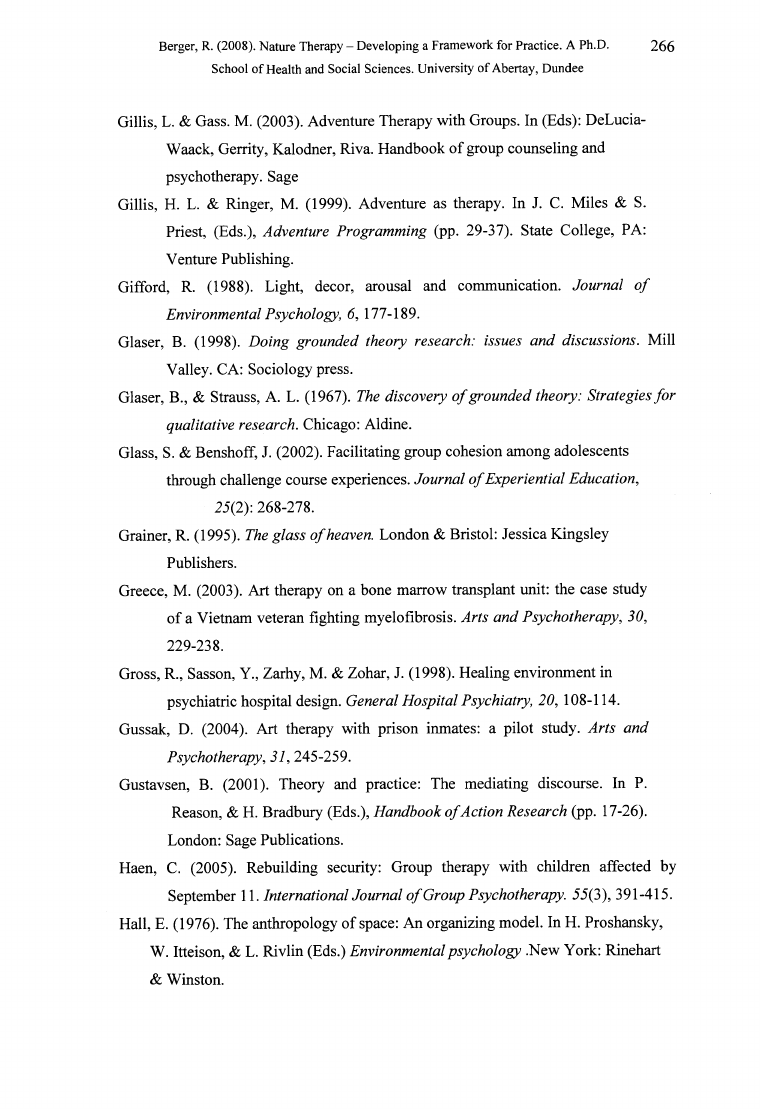
Berger, R. (2008). Nature Therapy - Developing a Framework for Practice. A Ph.D.
266
School of Health and Social Sciences. University of Abertay, Dundee
Gillis, L. & Gass. M. (2003). Adventure Therapy with Groups. In (Eds): DeLucia-
Waack, Gerrity, Kalodner, Riva. Handbook of group counseling and
psychotherapy. Sage
Gillis, H. L. & Ringer, M. (1999). Adventure as therapy. In J. C. Miles & S.
Priest, (Eds.), A d v e n tu r e P r o g r a m m in g (pp. 29-37). State College, PA:
Venture Publishing.
Gifford, R. (1988). Light, decor, arousal and communication. J o u rn a l o f
E n viro n m en ta l P sy c h o lo g y , 6, 177-189.
Glaser, B. (1998). D o in g g r o u n d e d th e o r y r e s e a r c h : iss u e s a n d d is c u s s io n s . Mill
Valley. CA: Sociology press.
Glaser, B., & Strauss, A. L. (1967). The d is c o v e r y o f g r o u n d e d th e o ry : S tr a te g ie s f o r
q u a lita tiv e re se a rc h . Chicago: Aldine.
Glass, S. & Benshoff, J. (2002). Facilitating group cohesion among adolescents
through challenge course experiences. J o u rn a l o f E x p e rien tia l E d u ca tio n ,
25(2): 268-278.
Grainer, R. (1995). The g la s s o f heaven. London & Bristol: Jessica Kingsley
Publishers.
Greece, M. (2003). Art therapy on a bone marrow transplant unit: the case study
o f a Vietnam veteran fighting myelofibrosis. A r ts a n d P s y c h o th e r a p y ,3 0 ,
229-238.
Gross, R., Sasson, Y., Zarhy, M. & Zohar, J. (1998). Healing environment in
psychiatric hospital design. G e n e ra l H o sp ita l P sych ia try, 2 0 , 108-114.
Gussak, D. (2004). Art therapy with prison inmates: a pilot study. A r ts a n d
P sych o th era p y, 3 1 , 245-259.
Gustavsen, B. (2001). Theory and practice: The mediating discourse. In P.
Reason, & H. Bradbury (Eds.), H a n d b o o k o f A c tio n R e s e a r c h (pp. 17-26).
London: Sage Publications.
Haen, C. (2005). Rebuilding security: Group therapy with children affected by
September 11. I n te r n a tio n a l J o u r n a l o f G r o u p P s y c h o th e r a p y . 55(3), 391-415.
Hall, E. (1976). The anthropology o f space: An organizing model. In H. Proshansky,
W. Itteison, & L. Rivlin (Eds.) E n v iro n m e n ta l p s y c h o lo g y .New York: Rinehart
& Winston.
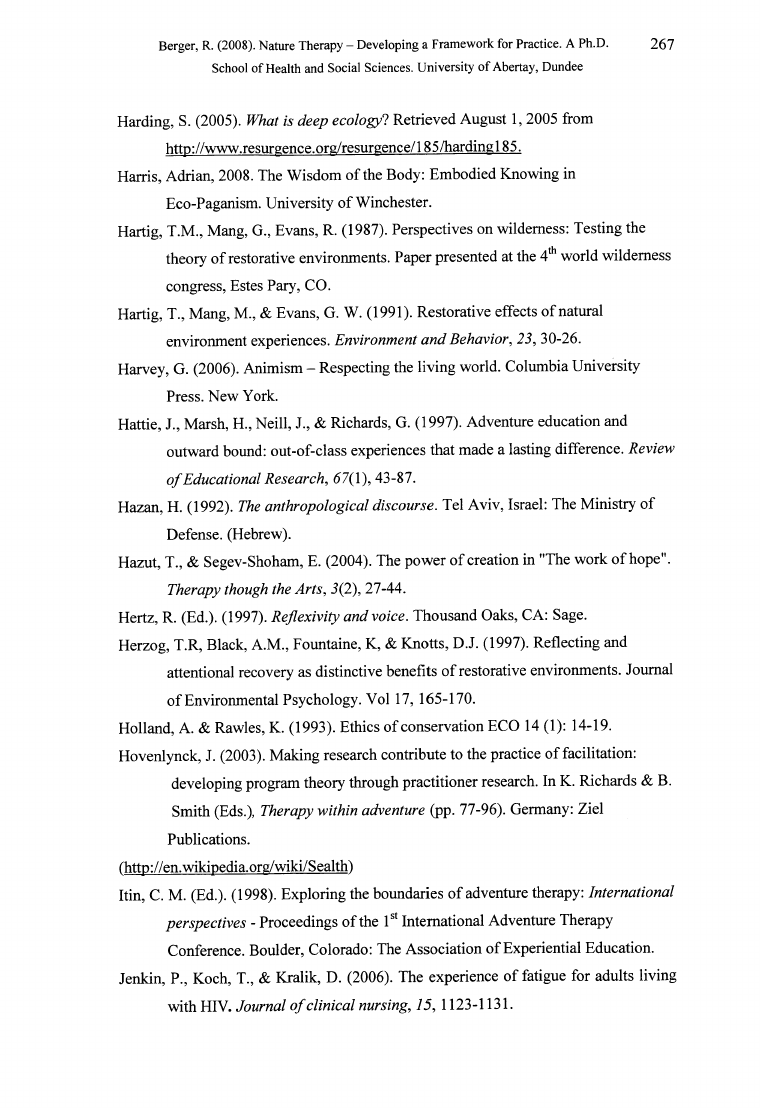
Berger, R. (2008). Nature Therapy - Developing a Framework for Practice. A Ph.D.
267
School of Health and Social Sciences. University of Abertay, Dundee
Harding, S. (2005). W hat is d e e p e c o lo g y ? Retrieved August 1, 2005 from
http://www.resurgence.Org/resurgence/l 85/hardingl 85.
Harris, Adrian, 2008. The Wisdom of the Body: Embodied Knowing in
Eco-Paganism. University of Winchester.
Hartig, T.M., Mang, G., Evans, R. (1987). Perspectives on wilderness: Testing the
theory o f restorative environments. Paper presented at the 4th world wilderness
congress, Estes Pary, CO.
Hartig, T., Mang, M., & Evans, G. W. (1991). Restorative effects o f natural
environment experiences. E n viro n m en t a n d B e h a v io r, 25, 30-26.
Harvey, G. (2006). Animism - Respecting the living world. Columbia University
Press. New York.
Hattie, J., Marsh, H., Neill, J., & Richards, G. (1997). Adventure education and
outward bound: out-of-class experiences that made a lasting difference. R eview
o f E d u ca tio n a l R e se a rc h , 67(1), 43-87.
Hazan, H. (1992). The a n th r o p o lo g ic a l d isc o u r s e . Tel Aviv, Israel: The Ministry o f
Defense. (Hebrew).
Hazut, T., & Segev-Shoham, E. (2004). The power o f creation in "The work o f hope".
T h era p y though th e A r ts , 3(2), 27-44.
Hertz, R. (Ed.). (1997). R e jle x iv ity a n d v o ic e . Thousand Oaks, CA: Sage.
Herzog, T.R, Black, A.M., Fountaine, K, & Knotts, D.J. (1997). Reflecting and
attentional recovery as distinctive benefits of restorative environments. Journal
o f Environmental Psychology. Vol 17, 165-170.
Holland, A. & Rawles, K. (1993). Ethics o f conservation ECO 14 (1): 14-19.
Hovenlynck, J. (2003). Making research contribute to the practice o f facilitation:
developing program theory through practitioner research. In K. Richards & B.
Smith (Eds.), T h e ra p y w ith in a d v e n tu re (pp. 77-96). Germany: Ziel
Publications.
(http://en.wikipedia.org/wiki/Sealth)
Itin, C. M. (Ed.). (1998). Exploring the boundaries o f adventure therapy: In te rn a tio n a l
p e r s p e c tiv e s - Proceedings o f the 1st International Adventure Therapy
Conference. Boulder, Colorado: The Association of Experiential Education.
Jenkin, P., Koch, T., & Kralik, D. (2006). The experience of fatigue for adults living
with HIV. J o u rn a l o f c lin ic a l n u rsin g , 75, 1123-1131.
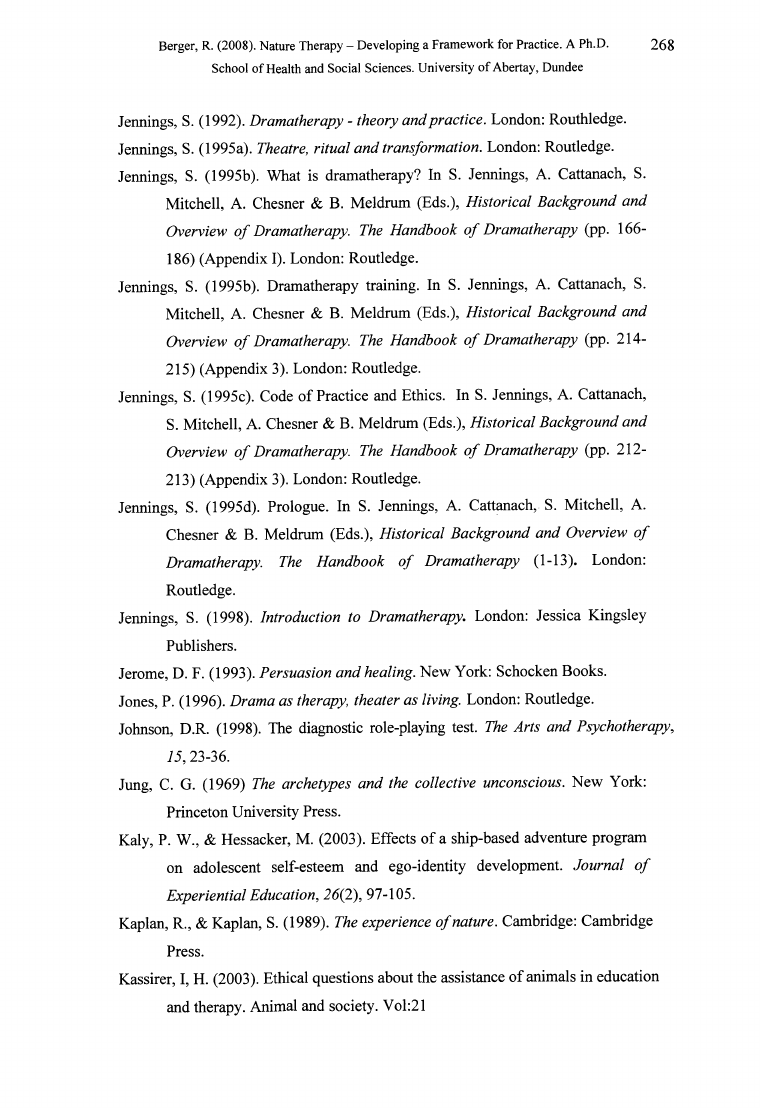
Berger, R. (2008). Nature Therapy - Developing a Framework for Practice. A Ph.D.
268
School of Health and Social Sciences. University of Abertay, Dundee
Jennings, S. (1992). D r a m a th e r a p y - th e o r y a n d p r a c tic e . London: Routhledge.
Jennings, S. (1995a). T h eatre, r itu a l a n d tra n sfo rm a tio n . London: Routledge.
Jennings, S. (1995b). What is dramatherapy? In S. Jennings, A. Cattanach, S.
Mitchell, A. Chesner & B. Meldrum (Eds.), H is to ric a l B a c k g ro u n d a n d
O v e r v ie w o f D ra m a th e ra p y . The H a n d b o o k o f D r a m a th e r a p y (pp. 166-
186) (Appendix I). London: Routledge.
Jennings, S. (1995b). Dramatherapy training. In S. Jennings, A. Cattanach, S.
Mitchell, A. Chesner & B. Meldrum (Eds.), H is to r ic a l B a c k g r o u n d a n d
O v e r v ie w o f D r a m a th e r a p y . T he H a n d b o o k o f D r a m a th e r a p y (pp. 214-
215) (Appendix 3). London: Routledge.
Jennings, S. (1995c). Code o f Practice and Ethics. In S. Jennings, A. Cattanach,
S. Mitchell, A. Chesner & B. Meldrum (Eds.), H is to r ic a l B a c k g r o u n d a n d
O v e r v ie w o f D ra m a th e ra p y . The H a n d b o o k o f D r a m a th e r a p y (pp. 212-
213) (Appendix 3). London: Routledge.
Jennings, S. (1995d). Prologue. In S. Jennings, A. Cattanach, S. Mitchell, A.
Chesner & B. Meldrum (Eds.), H is to r ic a l B a c k g r o u n d a n d O v e r v ie w o f
D ra m a th era p y . The H a n d b o o k o f D ra m a th e ra p y (1-13). London:
Routledge.
Jennings, S. (1998). I n tro d u c tio n to D r a m a th e r a p y . London: Jessica Kingsley
Publishers.
Jerome, D. F. (1993). P e r s u a s io n a n d h e a lin g . New York: Schocken Books.
Jones, P. (1996). D r a m a a s th e ra p y , th e a te r a s livin g . London: Routledge.
Johnson, D.R. (1998). The diagnostic role-playing test. The A r ts a n d P s y c h o th e r a p y ,
1 5 ,23-36.
Jung, C. G. (1969) The a r c h e ty p e s a n d th e c o lle c tiv e u n c o n sc io u s. New York:
Princeton University Press.
Kaly, P. W., & Hessacker, M. (2003). Effects o f a ship-based adventure program
on adolescent self-esteem and ego-identity development. J o u rn a l o f
E x p e rien tia l E d u ca tio n , 2 6 (2 ), 97-105.
Kaplan, R., & Kaplan, S. (1989). The e x p e rie n c e o f n a tu re . Cambridge: Cambridge
Press.
Kassirer, I, H. (2003). Ethical questions about the assistance o f animals in education
and therapy. Animal and society. Vol:21
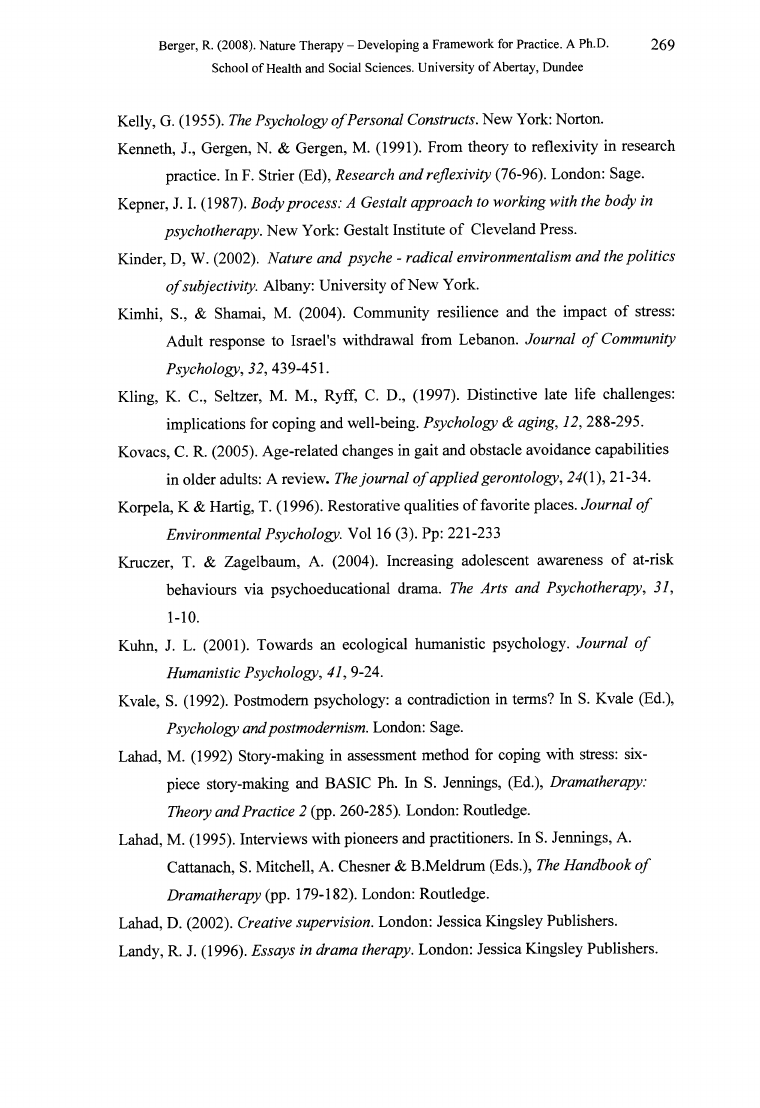
Berger, R. (2008). Nature Therapy - Developing a Framework for Practice. A Ph.D.
269
School of Health and Social Sciences. University of Abertay, Dundee
Kelly, G. (1955). The P s y c h o lo g y o f P e r s o n a l C o n stru c ts. New York: Norton.
Kenneth, J., Gergen, N. & Gergen, M. (1991). From theory to reflexivity in research
practice. In F. Strier (Ed), R e se a rc h a n d r e fle x iv ity (76-96). London: Sage.
Kepner, J. I. (1987). B o d y p r o c e s s : A G e s ta lt a p p r o a c h to w o r k in g w ith th e b o d y in
p sy ch o th e ra p y . New York: Gestalt Institute of Cleveland Press.
Kinder, D, W. (2002). N a tu re a n d p s y c h e - r a d ic a l en viro n m en ta lism a n d th e p o litic s
o f su b jectivity. Albany: University o f New York.
Kimhi, S., & Shamai, M. (2004). Community resilience and the impact o f stress:
Adult response to Israel's withdrawal from Lebanon. J o u rn a l o f C o m m u n ity
P sy c h o lo g y , 32, 439-451.
Kling, K. C., Seltzer, M. M., Ryff, C. D., (1997). Distinctive late life challenges:
implications for coping and well-being. P sy c h o lo g y & a g in g , 12, 288-295.
Kovacs, C. R. (2005). Age-related changes in gait and obstacle avoidance capabilities
in older adults: A review. The jo u r n a l o f a p p lie d g e r o n to lo g y , 2 4 (1 ), 21-34.
Korpela, K & Hartig, T. (1996). Restorative qualities o f favorite places. J o u r n a l o f
E n v ir o n m e n ta l P s y c h o lo g y . Vol 16 (3). Pp: 221-233
Kruczer, T. & Zagelbaum, A. (2004). Increasing adolescent awareness o f at-risk
behaviours via psychoeducational drama. The A rts a n d P sych o th era p y, 31,
1- 10.
Kuhn, J. L. (2001). Towards an ecological humanistic psychology. J o u r n a l o f
H u m a n is tic P s y c h o lo g y , 4 1 , 9-24.
Kvale, S. (1992). Postmodern psychology: a contradiction in terms? In S. Kvale (Ed.),
P s y c h o lo g y a n d p o s tm o d e r n is m . London: Sage.
Lahad, M. (1992) Story-making in assessment method for coping with stress: six-
piece story-making and BASIC Ph. In S. Jennings, (Ed.), D ra m a th era p y :
T h eo ry a n d P r a c tic e 2 (pp. 260-285). London: Routledge.
Lahad, M. (1995). Interviews with pioneers and practitioners. In S. Jennings, A.
Cattanach, S. Mitchell, A. Chesner & B.Meldrum (Eds.), The H a n d b o o k o f
D ra m a th e ra p y (pp. 179-182). London: Routledge.
Lahad, D. (2002). C re a tiv e su p ervisio n . London: Jessica Kingsley Publishers.
Landy, R. J. (1996). E s s a y s in d r a m a th e ra p y . London: Jessica Kingsley Publishers.
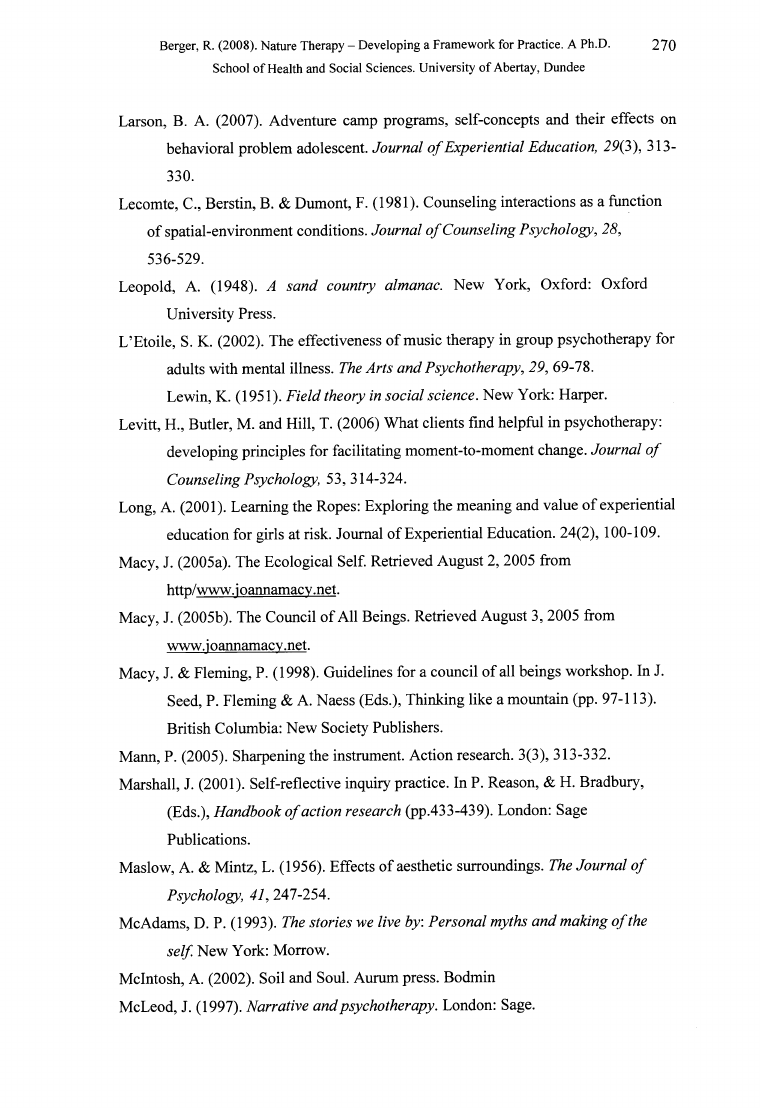
Berger, R. (2008). Nature Therapy - Developing a Framework for Practice. A Ph.D.
270
School of Health and Social Sciences. University of Abertay, Dundee
Larson, B. A. (2007). Adventure camp programs, self-concepts and their effects on
behavioral problem adolescent. Journal o f Experiential Education, 29(3), 313-
330.
Lecomte, C., Berstin, B. & Dumont, F. (1981). Counseling interactions as a function
o f spatial-environment conditions. Journal o f Counseling Psychology, 28,
536-529.
Leopold, A. (1948). A sand country almanac. New York, Oxford: Oxford
University Press.
L ’Etoile, S. K. (2002). The effectiveness o f music therapy in group psychotherapy for
adults with mental illness. The Arts and Psychotherapy, 29, 69-78.
Lewin, K. (1951). Field theory in social science. New York: Harper.
Levitt, H., Butler, M. and Hill, T. (2006) What clients find helpful in psychotherapy:
developing principles for facilitating moment-to-moment change. Journal o f
Counseling Psychology, 53, 314-324.
Long, A. (2001). Learning the Ropes: Exploring the meaning and value of experiential
education for girls at risk. Journal of Experiential Education. 24(2), 100-109.
Macy, J. (2005a). The Ecological Self. Retrieved August 2, 2005 from
http/www.i oannamacv.net.
Macy, J. (2005b). The Council o f All Beings. Retrieved August 3, 2005 from
www.ioannamacv.net.
Macy, J. & Fleming, P. (1998). Guidelines for a council o f all beings workshop. In J.
Seed, P. Fleming & A. Naess (Eds.), Thinking like a mountain (pp. 97-113).
British Columbia: New Society Publishers.
Mann, P. (2005). Sharpening the instrument. Action research. 3(3), 313-332.
Marshall, J. (2001). Self-reflective inquiry practice. In P. Reason, & H. Bradbury,
(Eds.), Handbook o f action research (pp.433-439). London: Sage
Publications.
Maslow, A. & Mintz, L. (1956). Effects o f aesthetic surroundings. The Journal o f
Psychology, 41, 247-254.
McAdams, D. P. (1993). The stories we live by: Personal myths and making o f the
self New York: Morrow.
McIntosh, A. (2002). Soil and Soul. Aurum press. Bodmin
McLeod, J. (1997). Narrative and psychotherapy. London: Sage.
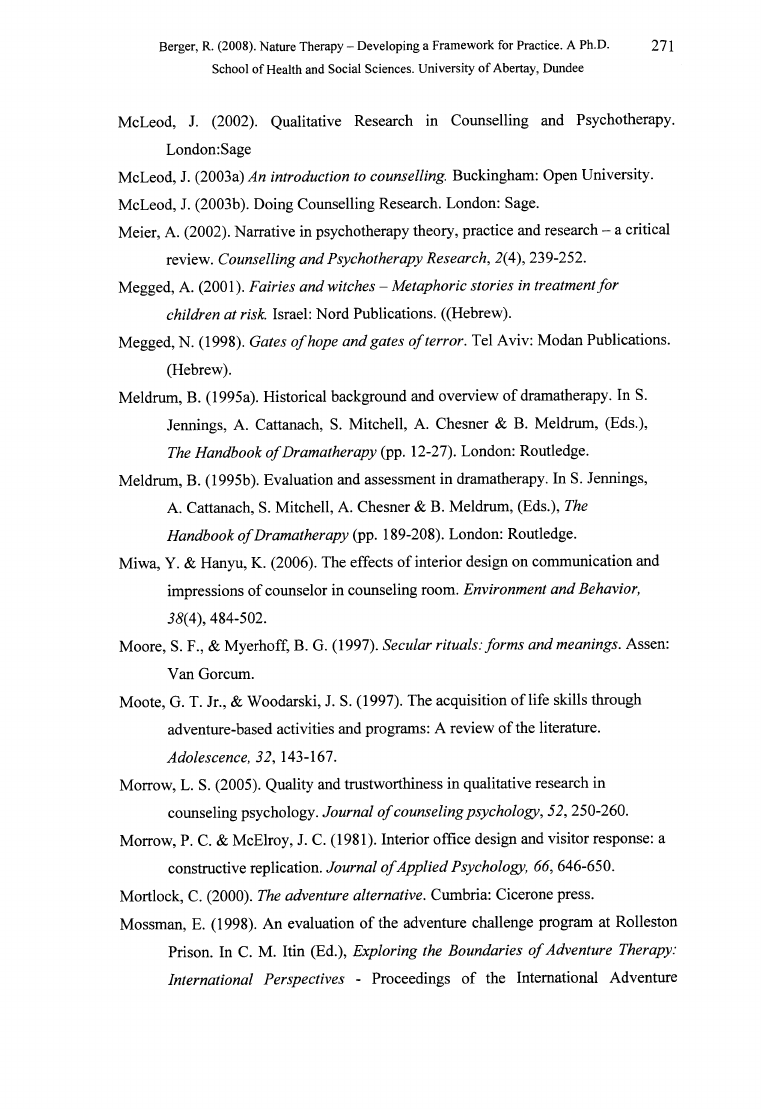
Berger, R. (2008). Nature Therapy - Developing a Framework for Practice. A Ph.D.
271
School of Health and Social Sciences. University of Abertay, Dundee
McLeod, J. (2002). Qualitative Research in Counselling and Psychotherapy.
London: Sage
McLeod, J. (2003a) A n in tro d u c tio n to co u n se llin g . Buckingham: Open University.
McLeod, J. (2003b). Doing Counselling Research. London: Sage.
Meier, A. (2002). Narrative in psychotherapy theory, practice and research - a critical
review. C o u n sellin g a n d P sy c h o th e ra p y R e se a rc h , 2(4), 239-252.
Megged, A. (2001). F a irie s a n d w itc h e s - M e ta p h o ric s to r ie s in tre a tm e n t f o r
ch ild ren a t risk. Israel: Nord Publications. ((Hebrew).
Megged, N. (1998). G a te s o f h o p e a n d g a te s o f te rro r. Tel Aviv: Modan Publications.
(Hebrew).
Meldrum, B. (1995a). Historical background and overview o f dramatherapy. In S.
Jennings, A. Cattanach, S. Mitchell, A. Chesner & B. Meldrum, (Eds.),
The H a n d b o o k o f D r a m a th e r a p y (pp. 12-27). London: Routledge.
Meldrum, B. (1995b). Evaluation and assessment in dramatherapy. In S. Jennings,
A. Cattanach, S. Mitchell, A. Chesner & B. Meldrum, (Eds.), The
H a n d b o o k o f D ra m a th e ra p y {pp. 189-208). London: Routledge.
Miwa, Y. & Hanyu, K. (2006). The effects o f interior design on communication and
impressions of counselor in counseling room. E n viro n m en t a n d B eh avior,
3 8 (4 ), 484-502.
Moore, S. F., & Myerhoff, B. G. (1997). S e c u la r r itu a ls : f o r m s a n d m ea n in g s. Assen:
Van Gorcum.
Moote, G. T. Jr., & Woodarski, J. S. (1997). The acquisition o f life skills through
adventure-based activities and programs: A review of the literature.
A d o le sc e n c e , 3 2 , 143-167.
Morrow, L. S. (2005). Quality and trustworthiness in qualitative research in
counseling psychology. J o u rn a l o f c o u n selin g p sy c h o lo g y , 5 2 , 250-260.
Morrow, P. C. & McElroy, J. C. (1981). Interior office design and visitor response: a
constructive replication. J o u rn a l o f A p p lie d P sych o lo g y, 66, 646-650.
Mortlock, C. (2000). The a d v e n tu re a lte r n a tiv e . Cumbria: Cicerone press.
Mossman, E. (1998). An evaluation o f the adventure challenge program at Rolleston
Prison. In C. M. Itin (Ed.), E x p lo r in g th e B o u n d a r ie s o f A d v e n tu r e T h e ra p y :
In tern a tio n a l P e rsp e c tiv e s - Proceedings of the International Adventure
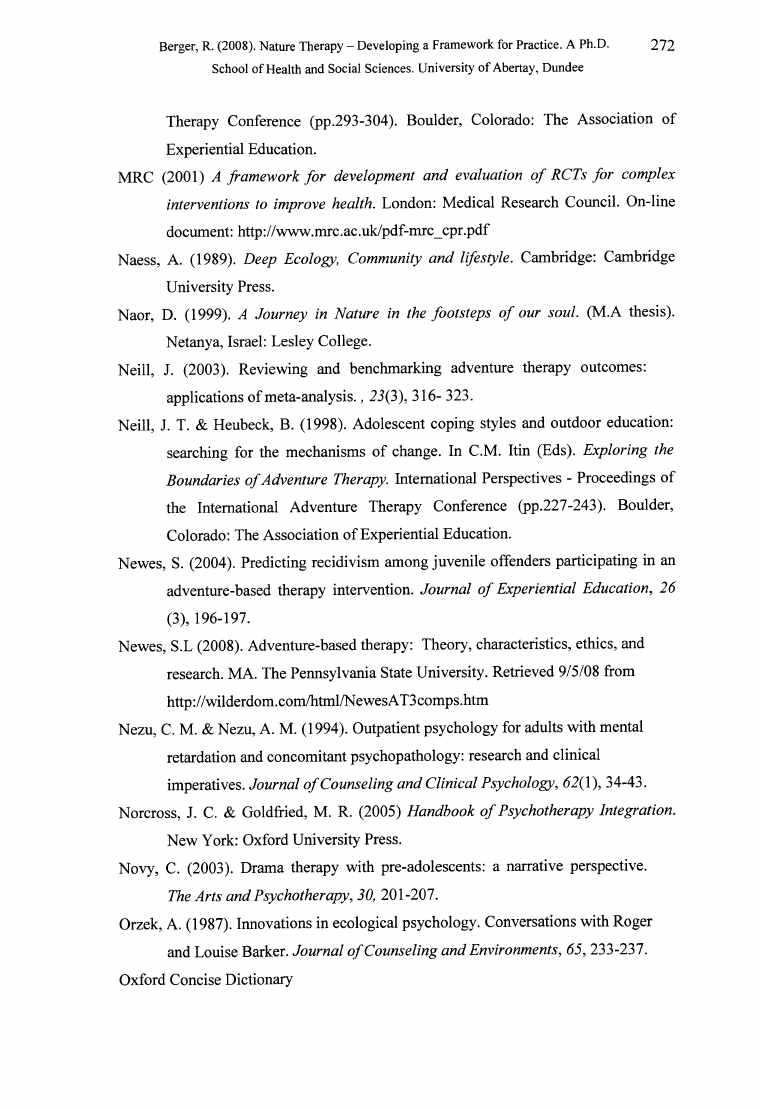
Berger, R. (2008). Nature Therapy - Developing a Framework for Practice. A Ph.D.
272
School of Health and Social Sciences. University of Abertay, Dundee
Therapy Conference (pp.293-304). Boulder, Colorado: The Association of
Experiential Education.
MRC (2001) A framework for development and evaluation o f RCTs for complex
interventions to improve health. London: Medical Research Council. On-line
document: http://www.mrc.ac.uk/pdf-mrc_cpr.pdf
Naess, A. (1989). Deep Ecology, Community and lifestyle. Cambridge: Cambridge
University Press.
Naor, D. (1999). A Journey in Nature in the footsteps o f our soul. (M.A thesis).
Netanya, Israel: Lesley College.
Neill, J. (2003). Reviewing and benchmarking adventure therapy outcomes:
applications of meta-analysis., 23(3), 316- 323.
Neill, J. T. & Heubeck, B. (1998). Adolescent coping styles and outdoor education:
searching for the mechanisms of change. In C.M. Itin (Eds). Exploring the
Boundaries o fAdventure Therapy. International Perspectives - Proceedings of
the International Adventure Therapy Conference (pp.227-243). Boulder,
Colorado: The Association of Experiential Education.
Newes, S. (2004). Predicting recidivism among juvenile offenders participating in an
adventure-based therapy intervention. Journal o f Experiential Education, 26
(3), 196-197.
Newes, S.L (2008). Adventure-based therapy: Theory, characteristics, ethics, and
research. MA. The Pennsylvania State University. Retrieved 9/5/08 from
http://wilderdom.com/html/NewesAT3comps.htm
Nezu, C. M. & Nezu, A. M. (1994). Outpatient psychology for adults with mental
retardation and concomitant psychopathology: research and clinical
imperatives. Journal o f Counseling and Clinical Psychology, 62(1), 34-43.
Norcross, J. C. & Goldfried, M. R. (2005) Handbook o f Psychotherapy Integration.
New York: Oxford University Press.
Novy, C. (2003). Drama therapy with pre-adolescents: a narrative perspective.
The Arts and Psychotherapy, 30, 201-207.
Orzek, A. (1987). Innovations in ecological psychology. Conversations with Roger
and Louise Barker. Journal o f Counseling and Environments, 65, 233-237.
Oxford Concise Dictionary
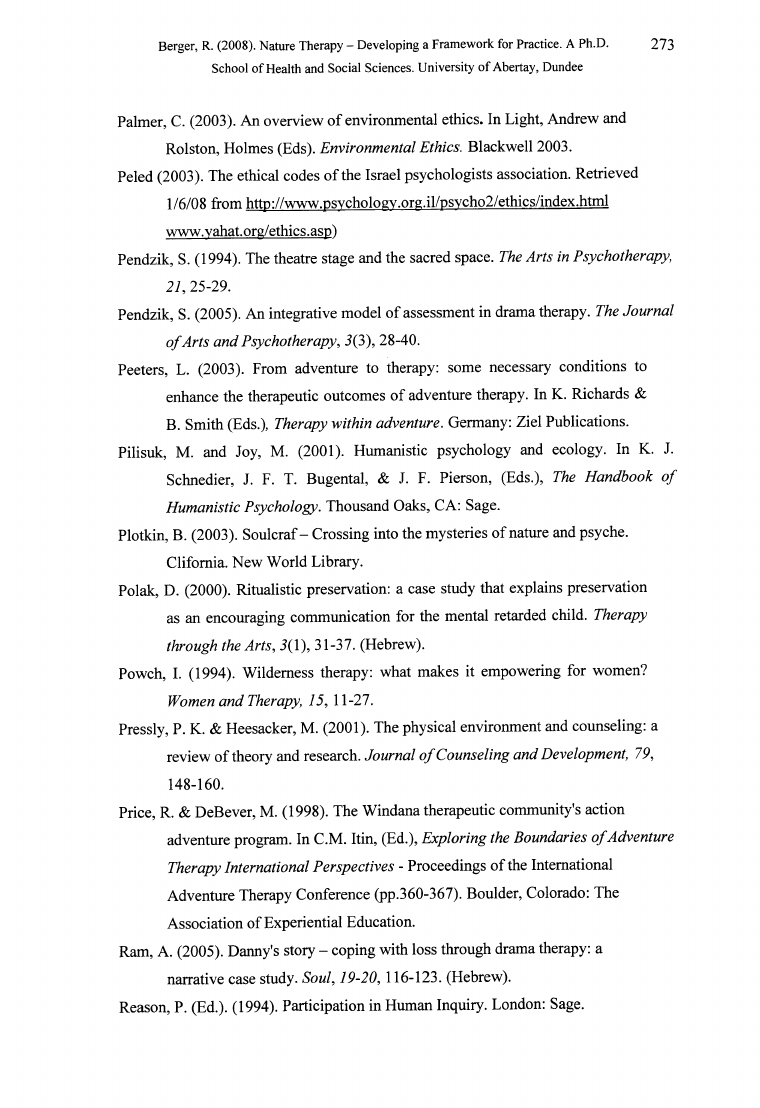
Berger, R. (2008). Nature Therapy - Developing a Framework for Practice. A Ph.D.
273
School of Health and Social Sciences. University of Abertay, Dundee
Palmer, C. (2003). An overview of environmental ethics. In Light, Andrew and
Rolston, Holmes (Eds). Environmental Ethics. Blackwell 2003.
Peled (2003). The ethical codes of the Israel psychologists association. Retrieved
1/6/08 from http://www.psvchology.org.il/psvcho2/ethics/index.html
www.vahat.org/ethics.asp)
Pendzik, S. (1994). The theatre stage and the sacred space. The Arts in Psychotherapy,
21, 25-29.
Pendzik, S. (2005). An integrative model of assessment in drama therapy. The Journal
o fArts and Psychotherapy, 3(3), 28-40.
Peeters, L. (2003). From adventure to therapy: some necessary conditions to
enhance the therapeutic outcomes of adventure therapy. In K. Richards &
B. Smith (Eds.), Therapy within adventure. Germany: Ziel Publications.
Pilisuk, M. and Joy, M. (2001). Humanistic psychology and ecology. In K. J.
Schnedier, J. F. T. Bugental, & J. F. Pierson, (Eds.), The Handbook o f
Humanistic Psychology. Thousand Oaks, CA: Sage.
Plotkin, B. (2003). Soulcraf- Crossing into the mysteries of nature and psyche.
Clifomia. New World Library.
Polak, D. (2000). Ritualistic preservation: a case study that explains preservation
as an encouraging communication for the mental retarded child. Therapy
through the Arts, 3(1), 31-37. (Hebrew).
Powch, I. (1994). Wilderness therapy: what makes it empowering for women?
Women and Therapy, 15, 11-27.
Pressly, P. K. & Heesacker, M. (2001). The physical environment and counseling: a
review of theory and research. Journal o f Counseling and Development, 79,
148-160.
Price, R. & DeBever, M. (1998). The Windana therapeutic community's action
adventure program. In C.M. Itin, (Ed.), Exploring the Boundaries o fAdventure
Therapy International Perspectives - Proceedings of the International
Adventure Therapy Conference (pp.360-367). Boulder, Colorado: The
Association of Experiential Education.
Ram, A. (2005). Danny's story - coping with loss through drama therapy: a
narrative case study. Soul, 19-20, 116-123. (Hebrew).
Reason, P. (Ed.). (1994). Participation in Human Inquiry. London: Sage.
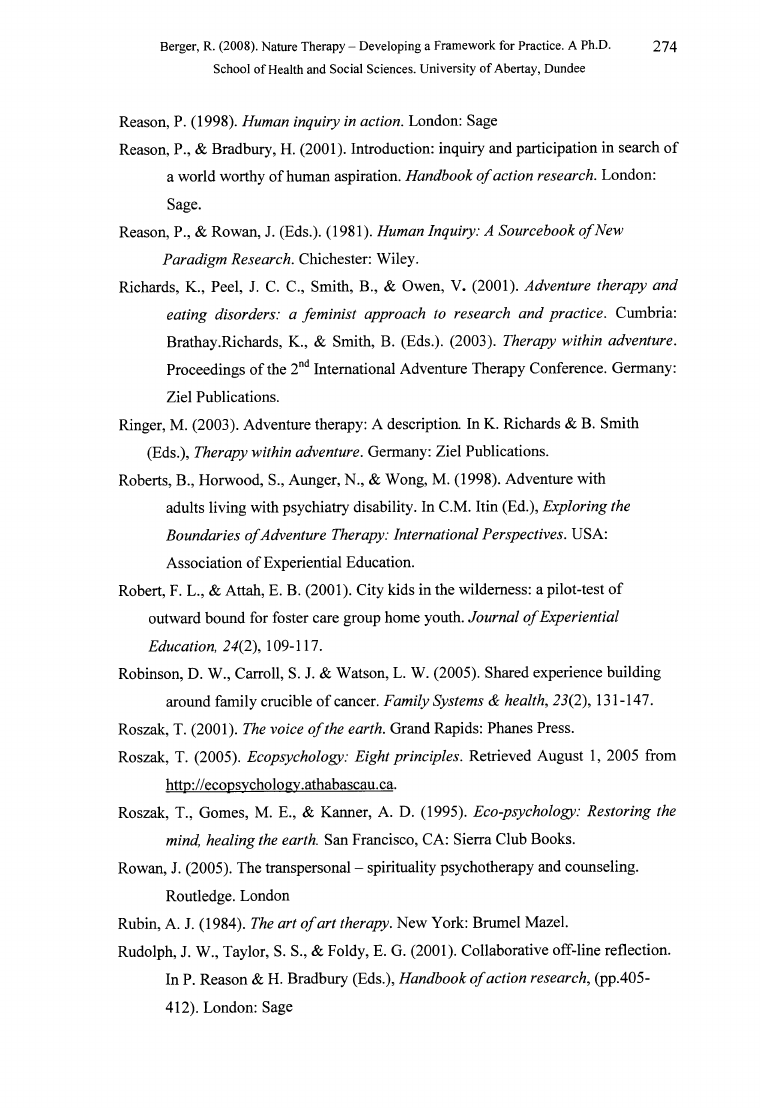
Berger, R. (2008). Nature Therapy - Developing a Framework for Practice. A Ph.D.
274
School of Health and Social Sciences. University of Abertay, Dundee
Reason, P. (1998). Human inquiry in action. London: Sage
Reason, P., & Bradbury, H. (2001). Introduction: inquiry and participation in search of
a world worthy of human aspiration. Handbook o f action research. London:
Sage.
Reason, P., & Rowan, J. (Eds.). (1981). Human Inquiry: A Sourcebook o fNew
Paradigm Research. Chichester: Wiley.
Richards, K., Peel, J. C. C., Smith, B., & Owen, V. (2001). Adventure therapy and
eating disorders: a feminist approach to research and practice. Cumbria:
Brathay.Richards, K., & Smith, B. (Eds.). (2003). Therapy within adventure.
Proceedings of the 2nd International Adventure Therapy Conference. Germany:
Ziel Publications.
Ringer, M. (2003). Adventure therapy: A description. In K. Richards & B. Smith
(Eds.), Therapy within adventure. Germany: Ziel Publications.
Roberts, B., Horwood, S., Aunger, N., & Wong, M. (1998). Adventure with
adults living with psychiatry disability. In C.M. Itin (Ed.), Exploring the
Boundaries o fAdventure Therapy: International Perspectives. USA:
Association of Experiential Education.
Robert, F. L., & Attah, E. B. (2001). City kids in the wilderness: a pilot-test of
outward bound for foster care group home youth. Journal o f Experiential
Education, 24(2), 109-117.
Robinson, D. W., Carroll, S. J. & Watson, L. W. (2005). Shared experience building
around family crucible of cancer. Family Systems & health, 23(2), 131-147.
Roszak, T. (2001). The voice o f the earth. Grand Rapids: Phanes Press.
Roszak, T. (2005). Ecopsychology: Eight principles. Retrieved August 1, 2005 from
http ://ecopsvcholo gy.athabascau. ca.
Roszak, T., Gomes, M. E., & Kanner, A. D. (1995). Eco-psychology: Restoring the
mind, healing the earth. San Francisco, CA: Sierra Club Books.
Rowan, J. (2005). The transpersonal - spirituality psychotherapy and counseling.
Routledge. London
Rubin, A. J. (1984). The art o f art therapy. New York: Brumel Mazel.
Rudolph, J. W., Taylor, S. S., & Foldy, E. G. (2001). Collaborative off-line reflection.
In P. Reason & H. Bradbury (Eds.), Handbook o f action research, (pp.405-
412). London: Sage
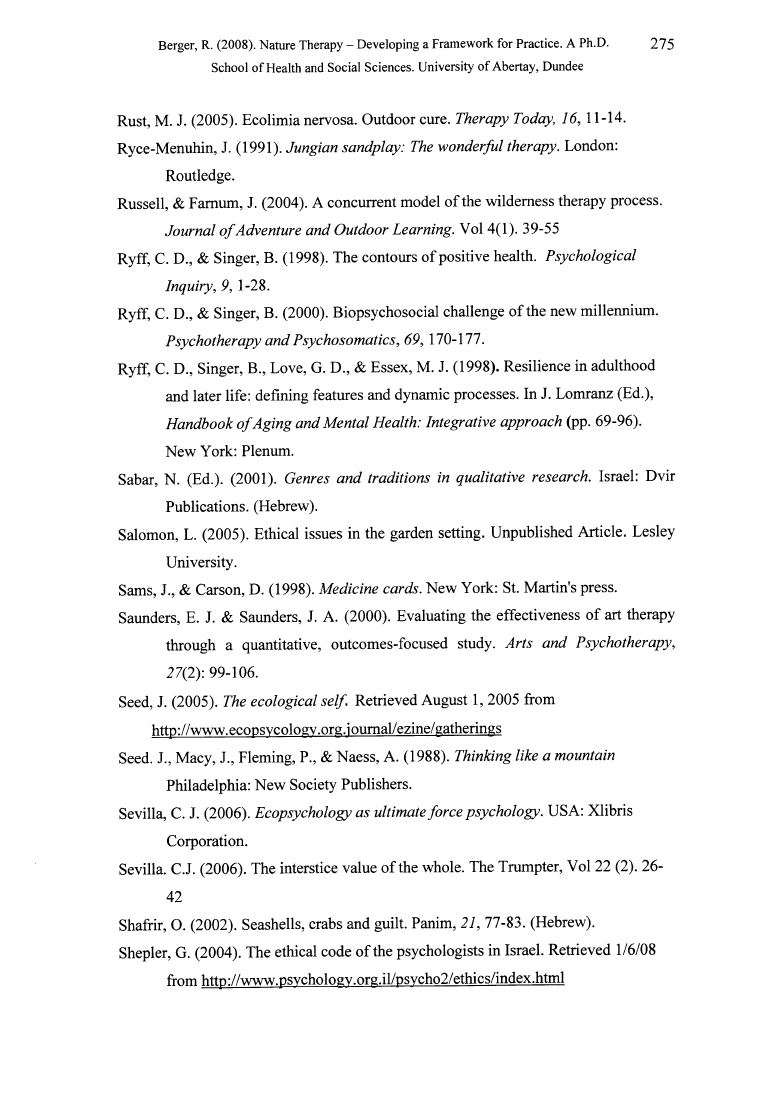
Berger, R. (2008). Nature Therapy - Developing a Framework for Practice. A Ph.D.
275
School of Health and Social Sciences. University of Abertay, Dundee
Rust, M. J. (2005). Ecolimia nervosa. Outdoor cure. Therapy Today, 16, 11-14.
Ryce-Menuhin, J. (1991). Jungian sandplay: The wonderful therapy. London:
Routledge.
Russell, & Famum, J. (2004). A concurrent model of the wilderness therapy process.
Journal o fAdventure and Outdoor Learning. Vol 4(1). 39-55
Ryff, C. D., & Singer, B. (1998). The contours of positive health. Psychological
Inquiry, 9, 1-28.
Ryff, C. D., & Singer, B. (2000). Biopsychosocial challenge of the new millennium.
Psychotherapy and Psychosomatics, 69, 170-177.
Ryff, C. D., Singer, B., Love, G. D., & Essex, M. J. (1998). Resilience in adulthood
and later life: defining features and dynamic processes. In J. Lomranz (Ed.),
Handbook o fAging and Mental Health: Integrative approach (pp. 69-96).
New York: Plenum.
Sabar, N. (Ed.). (2001). Genres and traditions in qualitative research. Israel: Dvir
Publications. (Hebrew).
Salomon, L. (2005). Ethical issues in the garden setting. Unpublished Article. Lesley
University.
Sams, J., & Carson, D. (1998). Medicine cards. New York: St. Martin's press.
Saunders, E. J. & Saunders, J. A. (2000). Evaluating the effectiveness of art therapy
through a quantitative, outcomes-focused study. Arts and Psychotherapy,
27(2): 99-106.
Seed, J. (2005). The ecological self Retrieved August 1, 2005 from
http://www.ecopsvcologv.org.iournal/ezine/gatherings
Seed. J., Macy, J., Fleming, P., & Naess, A. (1988). Thinking like a mountain
Philadelphia: New Society Publishers.
Sevilla, C. J. (2006). Ecopsychology as ultimateforce psychology. USA: Xlibris
Corporation.
Sevilla. C.J. (2006). The interstice value of the whole. The Trumpter, Vol 22 (2). 26-
42
Shafrir, O. (2002). Seashells, crabs and guilt. Panim, 27, 77-83. (Hebrew).
Shepler, G. (2004). The ethical code of the psychologists in Israel. Retrieved 1/6/08
from http://www.psvchologv.org.il/psvcho2/ethics/index.html
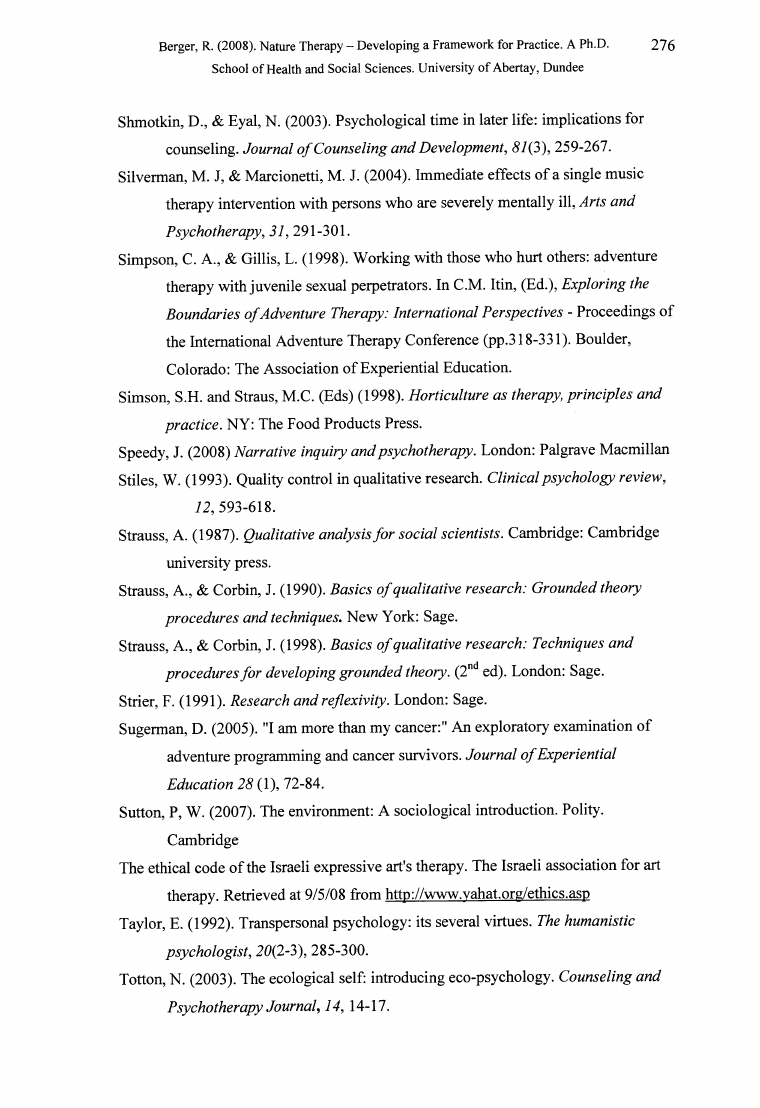
Berger, R. (2008). Nature Therapy - Developing a Framework for Practice. A Ph.D.
276
School of Health and Social Sciences. University of Abertay, Dundee
Shmotkin, D., & Eyal, N. (2003). Psychological time in later life: implications for
counseling. Journal o f Counseling and Development, 81(3), 259-267.
Silverman, M. J, & Marcionetti, M. J. (2004). Immediate effects of a single music
therapy intervention with persons who are severely mentally ill, Arts and
Psychotherapy, 31, 291-301.
Simpson, C. A., & Gillis, L. (1998). Working with those who hurt others: adventure
therapy with juvenile sexual perpetrators. In C.M. Itin, (Ed.), Exploring the
Boundaries o fAdventure Therapy: International Perspectives - Proceedings of
the International Adventure Therapy Conference (pp.318-331). Boulder,
Colorado: The Association of Experiential Education.
Simson, S.H. and Straus, M.C. (Eds) (1998). Horticulture as therapy, principles and
practice. NY: The Food Products Press.
Speedy, J. (2008) Narrative inquiry and psychotherapy. London: Palgrave Macmillan
Stiles, W. (1993). Quality control in qualitative research. Clinical psychology review,
12, 593-618.
Strauss, A. (1987). Qualitative analysisfor social scientists. Cambridge: Cambridge
university press.
Strauss, A., & Corbin, J. (1990). Basics o f qualitative research: Grounded theory
procedures and techniques. New York: Sage.
Strauss, A., & Corbin, J. (1998). Basics o f qualitative research: Techniques and
proceduresfor developing grounded theory. (2nd ed). London: Sage.
Strier, F. (1991). Research and reflexivity. London: Sage.
Sugerman, D. (2005). "I am more than my cancer:" An exploratory examination of
adventure programming and cancer survivors. Journal o fExperiential
Education 28 (1), 72-84.
Sutton, P, W. (2007). The environment: A sociological introduction. Polity.
Cambridge
The ethical code of the Israeli expressive art's therapy. The Israeli association for art
therapy. Retrieved at 9/5/08 from http://www.vahat.org/ethics.asp
Taylor, E. (1992). Transpersonal psychology: its several virtues. The humanistic
psychologist, 20(2-3), 285-300.
Totton, N. (2003). The ecological self: introducing eco-psychology. Counseling and
Psychotherapy Journal, 14, 14- 17.
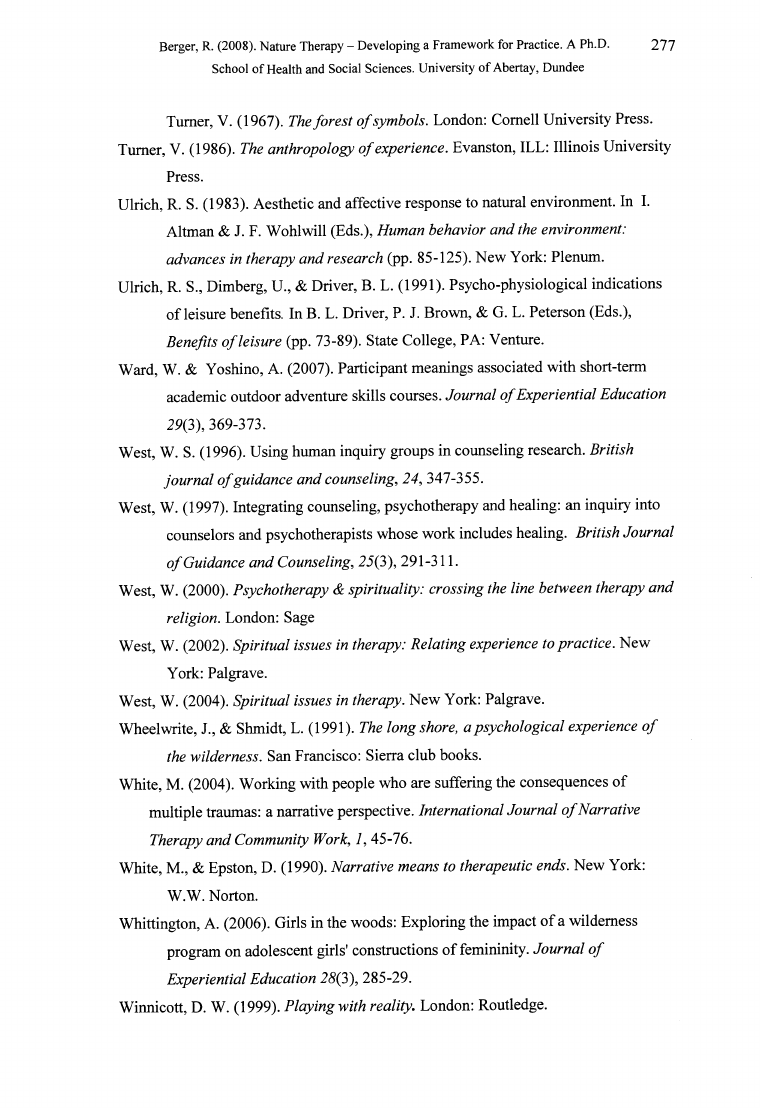
Berger, R. (2008). Nature Therapy - Developing a Framework for Practice. A Ph.D.
277
School of Health and Social Sciences. University of Abertay, Dundee
Turner, V. (1967). Theforest o f symbols. London: Cornell University Press.
Turner, V. (1986). The anthropology o f experience. Evanston, ILL: Illinois University
Press.
Ulrich, R. S. (1983). Aesthetic and affective response to natural environment. In I.
Altman & J. F. Wohlwill (Eds.), Human behavior and the environment:
advances in therapy and research (pp. 85-125). New York: Plenum.
Ulrich, R. S., Dimberg, U., & Driver, B. L. (1991). Psycho-physiological indications
of leisure benefits. In B. L. Driver, P. J. Brown, & G. L. Peterson (Eds.),
Benefits o f leisure (pp. 73-89). State College, PA: Venture.
Ward, W. & Yoshino, A. (2007). Participant meanings associated with short-term
academic outdoor adventure skills courses. Journal o fExperiential Education
29(3), 369-373.
West, W. S. (1996). Using human inquiry groups in counseling research. British
journal o fguidance and counseling, 24, 347-355.
West, W. (1997). Integrating counseling, psychotherapy and healing: an inquiry into
counselors and psychotherapists whose work includes healing. British Journal
o f Guidance and Counseling, 25(3), 291-311.
West, W. (2000). Psychotherapy & spirituality: crossing the line between therapy and
religion. London: Sage
West, W. (2002). Spiritual issues in therapy: Relating experience to practice. New
York: Palgrave.
West, W. (2004). Spiritual issues in therapy. New York: Palgrave.
Wheelwrite, J., & Shmidt, L. (1991). The longshore, a psychological experience o f
the wilderness. San Francisco: Sierra club books.
White, M. (2004). Working with people who are suffering the consequences of
multiple traumas: a narrative perspective. International Journal o fNarrative
Therapy and Community Work, 1, 45-76.
White, M., & Epston, D. (1990). Narrative means to therapeutic ends. New York:
W.W. Norton.
Whittington, A. (2006). Girls in the woods: Exploring the impact of a wilderness
program on adolescent girls' constructions of femininity. Journal o f
Experiential Education 28(3), 285-29.
Winnicott, D. W. (1999). Playing with reality. London: Routledge.
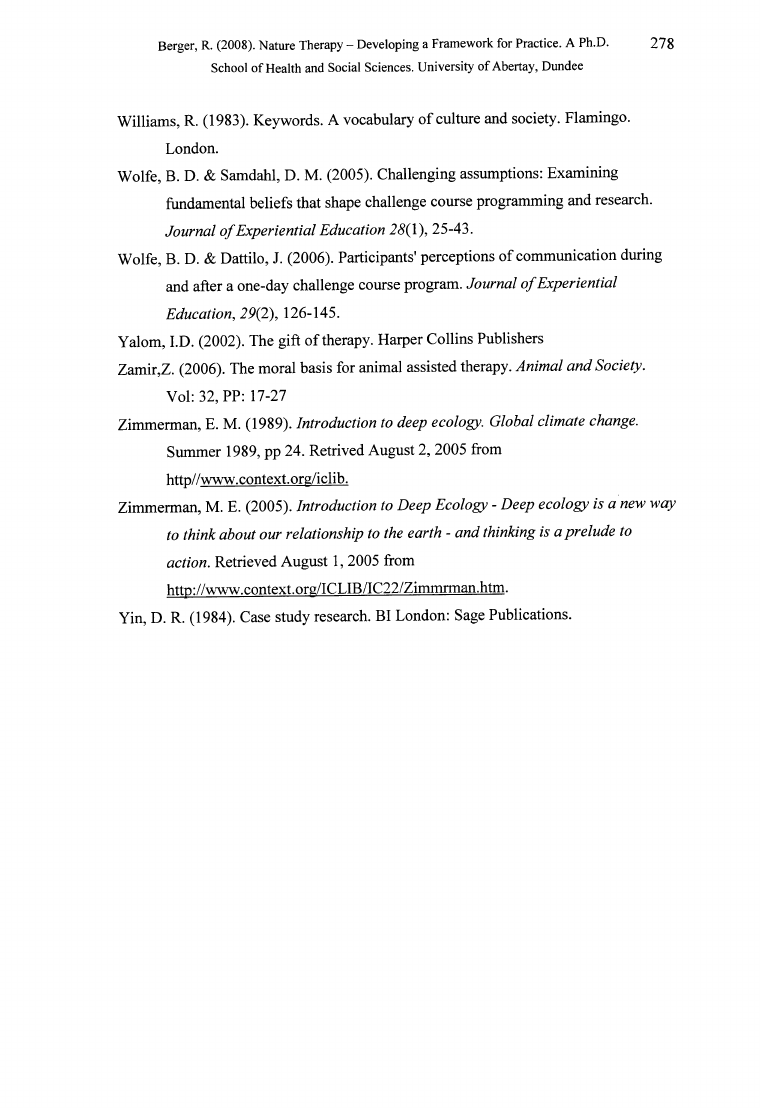
Berger, R. (2008). Nature Therapy - Developing a Framework for Practice. A Ph.D.
278
School of Health and Social Sciences. University of Abertay, Dundee
Williams, R. (1983). Keywords. A vocabulary of culture and society. Flamingo.
London.
Wolfe, B. D. & Samdahl, D. M. (2005). Challenging assumptions: Examining
fundamental beliefs that shape challenge course programming and research.
Journal o fExperiential Education 28(1), 25-43.
Wolfe, B. D. & Dattilo, J. (2006). Participants' perceptions of communication during
and after a one-day challenge course program. Journal o fExperiential
Education, 29(2), 126-145.
Yalom, I.D. (2002). The gift of therapy. Harper Collins Publishers
Zamir,Z. (2006). The moral basis for animal assisted therapy. Animal and Society.
Vol: 32, PP: 17-27
Zimmerman, E. M. (1989). Introduction to deep ecology. Global climate change.
Summer 1989, pp 24. Retrived August 2, 2005 from
http//www.context.org/iclib.
Zimmerman, M. E. (2005). Introduction to Deep Ecology - Deep ecology is a new way
to think about our relationship to the earth - and thinking is a prelude to
action. Retrieved August 1, 2005 from
http://www.context.org/ICLIB/IC22/Zimmrman.htm.
Yin, D. R. (1984). Case study research. BI London: Sage Publications.
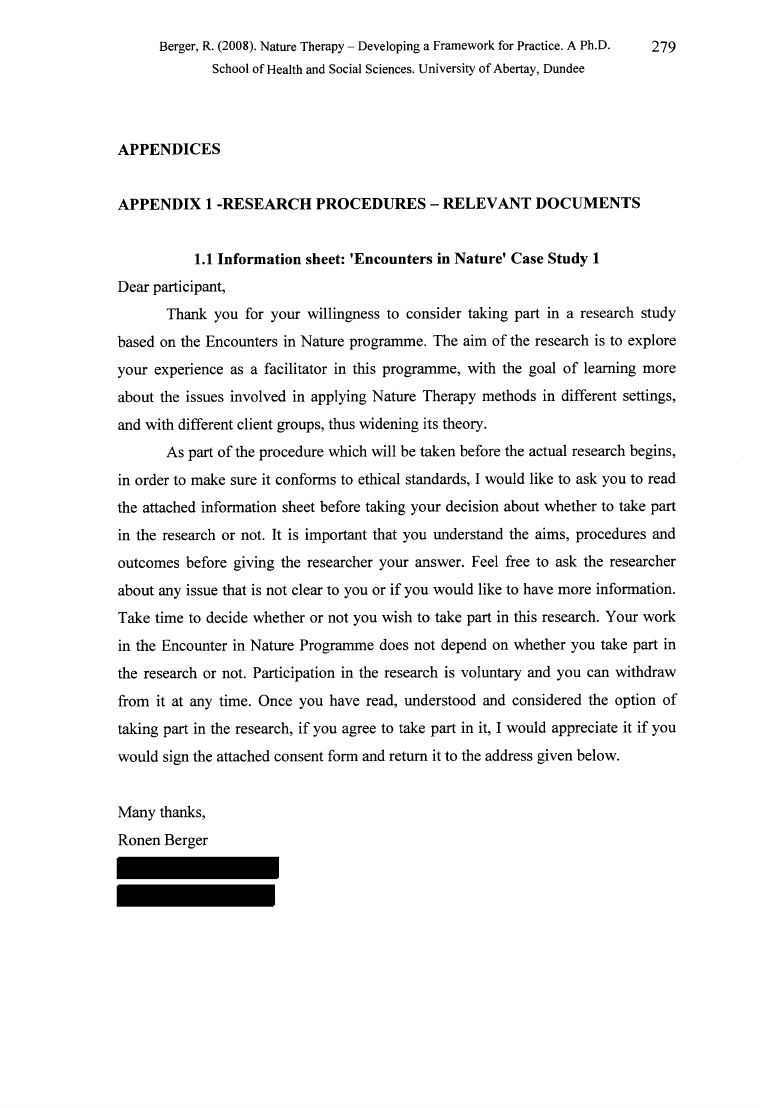
Berger, R. (2008). Nature Therapy - Developing a Framework for Practice. A Ph.D.
279
School of Health and Social Sciences. University of Abertay, Dundee
APPENDICES
APPENDIX 1 -RESEARCH PROCEDURES - RELEVANT DOCUMENTS
1.1 Information sheet: 'Encounters in Nature' Case Study 1
Dear participant,
Thank you for your willingness to consider taking part in a research study
based on the Encounters in Nature programme. The aim of the research is to explore
your experience as a facilitator in this programme, with the goal of learning more
about the issues involved in applying Nature Therapy methods in different settings,
and with different client groups, thus widening its theory.
As part of the procedure which will be taken before the actual research begins,
in order to make sure it conforms to ethical standards, I would like to ask you to read
the attached information sheet before taking your decision about whether to take part
in the research or not. It is important that you understand the aims, procedures and
outcomes before giving the researcher your answer. Feel free to ask the researcher
about any issue that is not clear to you or if you would like to have more information.
Take time to decide whether or not you wish to take part in this research. Your work
in the Encounter in Nature Programme does not depend on whether you take part in
the research or not. Participation in the research is voluntary and you can withdraw
from it at any time. Once you have read, understood and considered the option of
taking part in the research, if you agree to take part in it, I would appreciate it if you
would sign the attached consent form and return it to the address given below.
Many thanks,
Ronen Berger
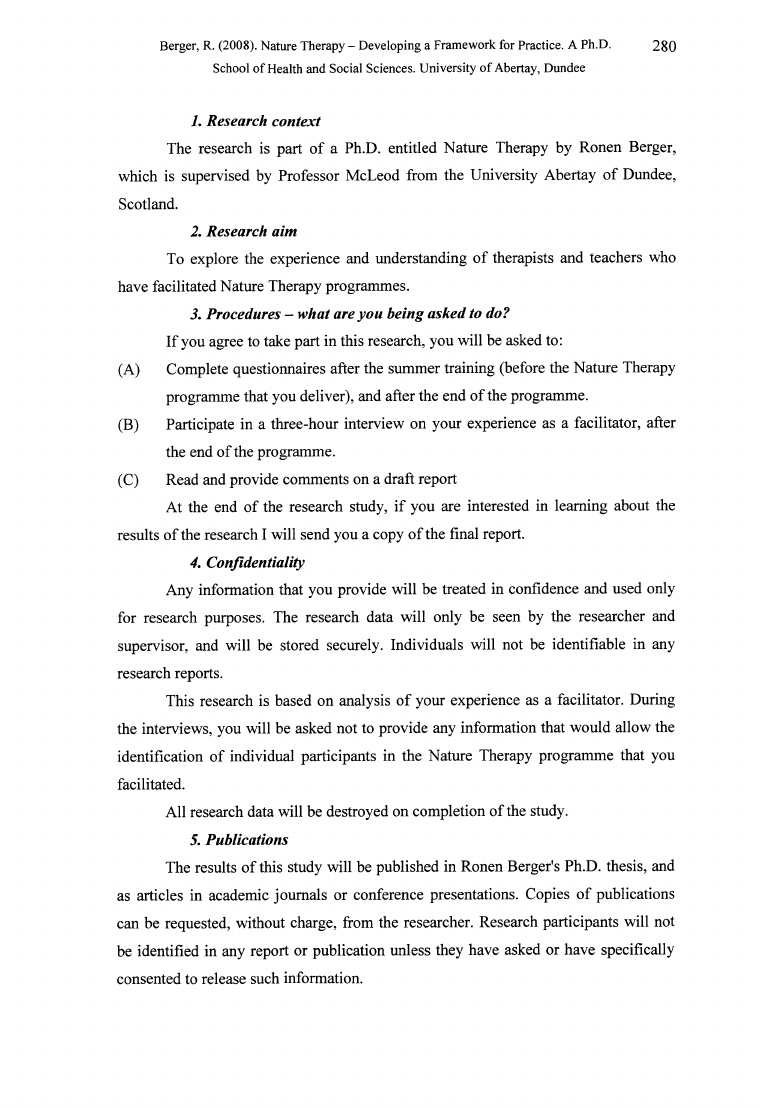
Berger, R. (2008). Nature Therapy - Developing a Framework for Practice. A Ph.D.
280
School of Health and Social Sciences. University of Abertay, Dundee
1. Research context
The research is part of a Ph.D. entitled Nature Therapy by Ronen Berger,
which is supervised by Professor McLeod from the University Abertay of Dundee,
Scotland.
2. Research aim
To explore the experience and understanding of therapists and teachers who
have facilitated Nature Therapy programmes.
3. Procedures - what are you being asked to do?
If you agree to take part in this research, you will be asked to:
(A) Complete questionnaires after the summer training (before the Nature Therapy
programme that you deliver), and after the end of the programme.
(B) Participate in a three-hour interview on your experience as a facilitator, after
the end of the programme.
(C) Read and provide comments on a draft report
At the end of the research study, if you are interested in learning about the
results of the research I will send you a copy of the final report.
4. Confidentiality
Any information that you provide will be treated in confidence and used only
for research purposes. The research data will only be seen by the researcher and
supervisor, and will be stored securely. Individuals will not be identifiable in any
research reports.
This research is based on analysis of your experience as a facilitator. During
the interviews, you will be asked not to provide any information that would allow the
identification of individual participants in the Nature Therapy programme that you
facilitated.
All research data will be destroyed on completion of the study.
5. Publications
The results of this study will be published in Ronen Berger's Ph.D. thesis, and
as articles in academic journals or conference presentations. Copies of publications
can be requested, without charge, from the researcher. Research participants will not
be identified in any report or publication unless they have asked or have specifically
consented to release such information.
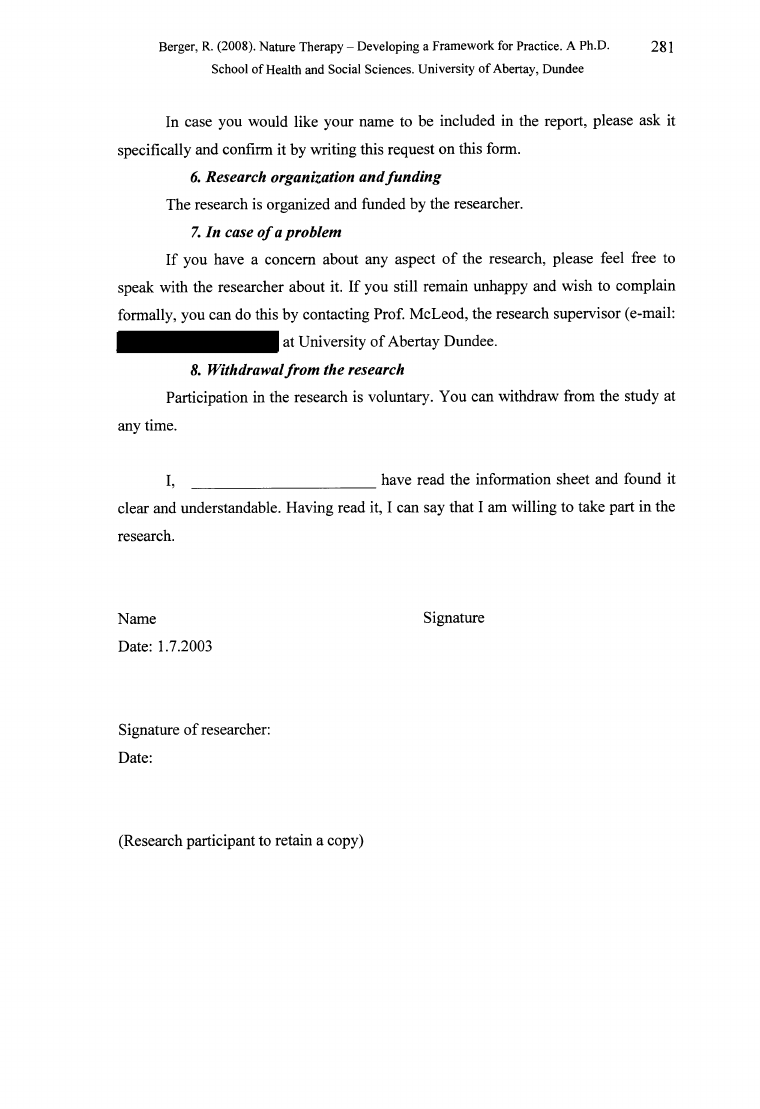
Berger, R. (2008). Nature Therapy - Developing a Framework for Practice. A Ph.D.
281
School of Health and Social Sciences. University of Abertay, Dundee
In case you would like your name to be included in the report, please ask it
specifically and confirm it by writing this request on this form.
6. R esearch organ ization a n d fu n d in g
The research is organized and funded by the researcher.
7. In case o f a p ro b le m
If you have a concern about any aspect of the research, please feel free to
speak with the researcher about it. If you still remain unhappy and wish to complain
formally, you can do this by contacting Prof. McLeod, the research supervisor (e-mail:
at University of Abertay Dundee.
8. W ith draw alf r o m th e research
Participation in the research is voluntary. You can withdraw from the study at
any time.
I, _______________________have read the information sheet and found it
clear and understandable. Having read it, I can say that I am willing to take part in the
research.
Name
Date: 1.7.2003
Signature
Signature of researcher:
Date:
(Research participant to retain a copy)
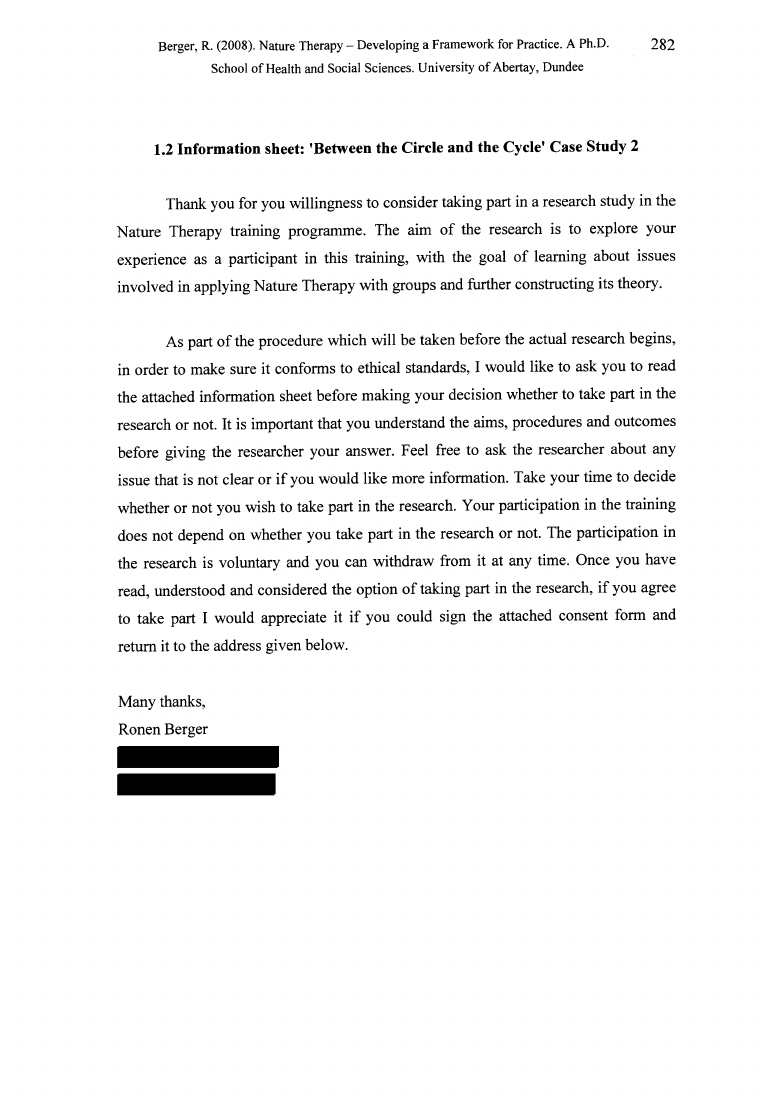
Berger, R. (2008). Nature Therapy - Developing a Framework for Practice. A Ph.D.
282
School of Health and Social Sciences. University of Abertay, Dundee
1.2 Information sheet: ’Between the Circle and the Cycle’ Case Study 2
Thank you for you willingness to consider taking part in a research study in the
Nature Therapy training programme. The aim of the research is to explore your
experience as a participant in this training, with the goal of learning about issues
involved in applying Nature Therapy with groups and further constructing its theory.
As part of the procedure which will be taken before the actual research begins,
in order to make sure it conforms to ethical standards, I would like to ask you to read
the attached information sheet before making your decision whether to take part in the
research or not. It is important that you understand the aims, procedures and outcomes
before giving the researcher your answer. Feel free to ask the researcher about any
issue that is not clear or if you would like more information. Take your time to decide
whether or not you wish to take part in the research. Your participation in the training
does not depend on whether you take part in the research or not. The participation in
the research is voluntary and you can withdraw from it at any time. Once you have
read, understood and considered the option of taking part in the research, if you agree
to take part I would appreciate it if you could sign the attached consent form and
return it to the address given below.
Many thanks,
Ronen Berger
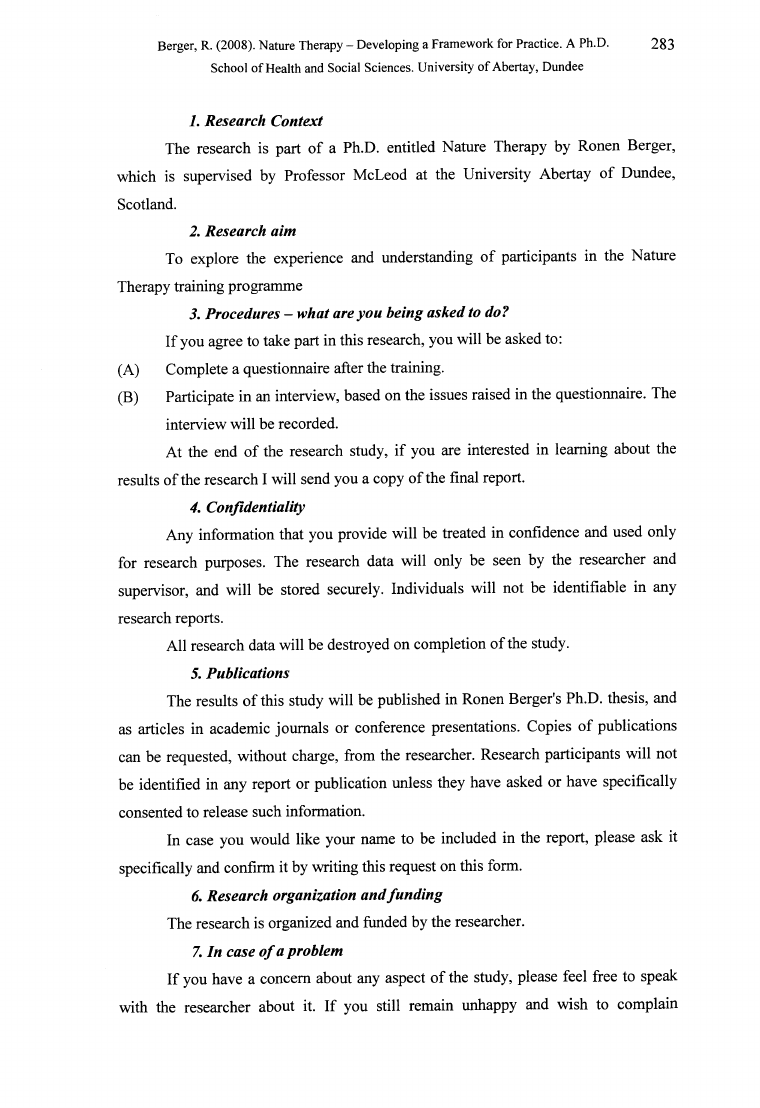
Berger, R. (2008). Nature Therapy - Developing a Framework for Practice. A Ph.D.
283
School of Health and Social Sciences. University of Abertay, Dundee
1. Research Context
The research is part of a Ph.D. entitled Nature Therapy by Ronen Berger,
which is supervised by Professor McLeod at the University Abertay of Dundee,
Scotland.
2. Research aim
To explore the experience and understanding of participants in the Nature
Therapy training programme
3. Procedures - what are you being asked to do?
If you agree to take part in this research, you will be asked to:
(A) Complete a questionnaire after the training.
(B) Participate in an interview, based on the issues raised in the questionnaire. The
interview will be recorded.
At the end of the research study, if you are interested in learning about the
results of the research I will send you a copy of the final report.
4. Confidentiality
Any information that you provide will be treated in confidence and used only
for research purposes. The research data will only be seen by the researcher and
supervisor, and will be stored securely. Individuals will not be identifiable in any
research reports.
All research data will be destroyed on completion of the study.
5. Publications
The results of this study will be published in Ronen Berger's Ph.D. thesis, and
as articles in academic journals or conference presentations. Copies of publications
can be requested, without charge, from the researcher. Research participants will not
be identified in any report or publication unless they have asked or have specifically
consented to release such information.
In case you would like your name to be included in the report, please ask it
specifically and confirm it by writing this request on this form.
6. Research organization andfunding
The research is organized and funded by the researcher.
7. In case o f a problem
If you have a concern about any aspect of the study, please feel free to speak
with the researcher about it. If you still remain unhappy and wish to complain
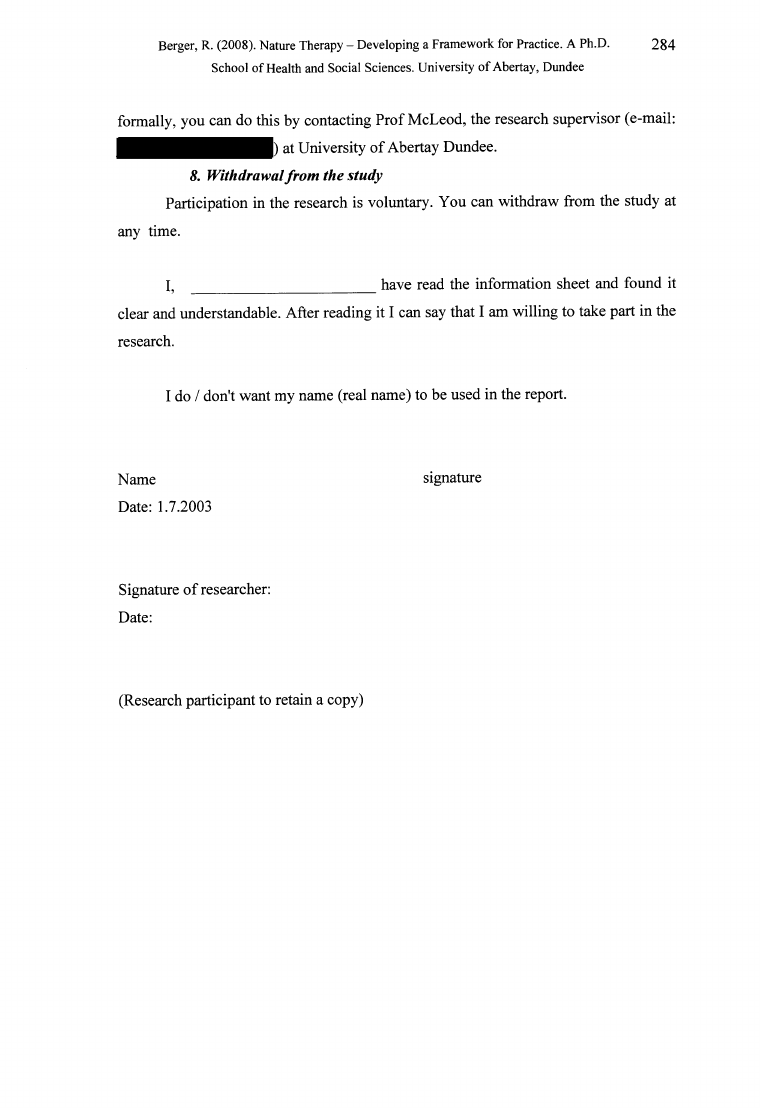
Berger, R. (2008). Nature Therapy - Developing a Framework for Practice. A Ph.D.
284
School of Health and Social Sciences. University of Abertay, Dundee
formally, you can do this by contacting Prof McLeod, the research supervisor (e-mail:
) at University of Abertay Dundee.
8. W ithdraw alfr o m th e stu d y
Participation in the research is voluntary. You can withdraw from the study at
any time.
I? _______________________have read the information sheet and found it
clear and understandable. After reading it I can say that I am willing to take part in the
research.
I do / don't want my name (real name) to be used in the report.
Name
Date: 1.7.2003
signature
Signature of researcher:
Date:
(Research participant to retain a copy)
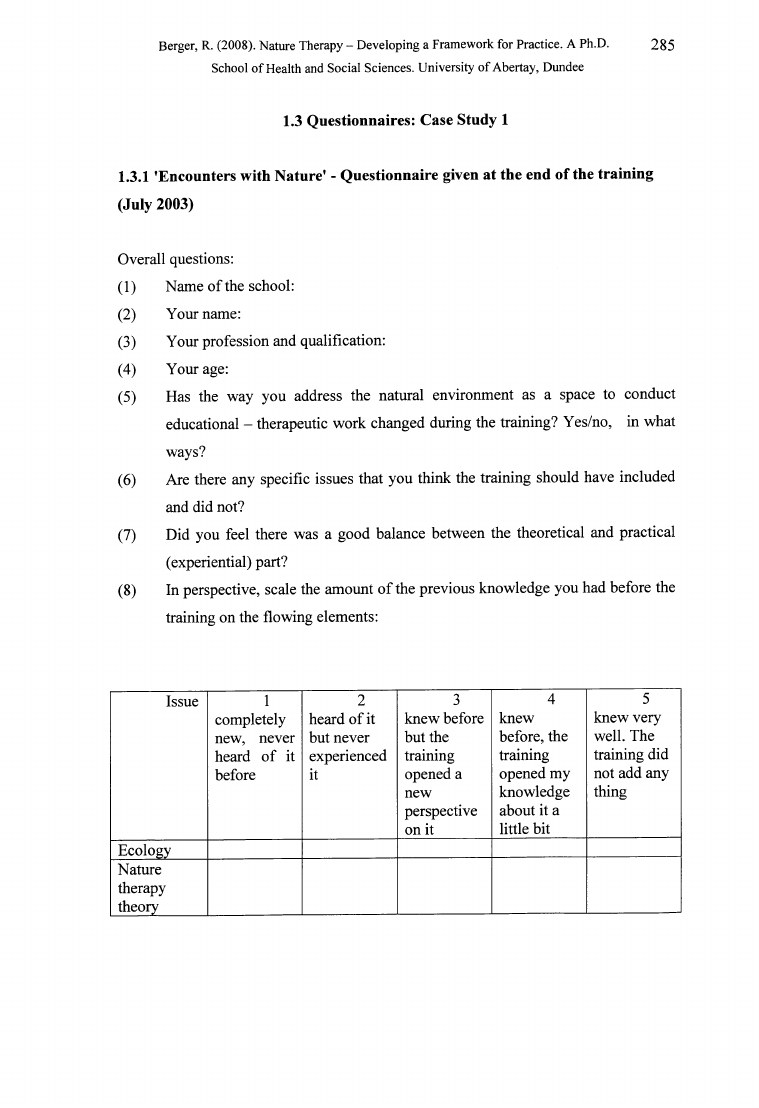
Berger, R. (2008). Nature Therapy - Developing a Framework for Practice. A Ph.D.
285
School of Health and Social Sciences. University of Abertay, Dundee
1.3 Questionnaires: Case Study 1
1.3.1 ’Encounters with Nature’ - Questionnaire given at the end of the training
(July 2003)
Overall questions:
(1) Name of the school:
(2) Your name:
(3) Your profession and qualification:
(4) Your age:
(5) Has the way you address the natural environment as a space to conduct
educational - therapeutic work changed during the training? Yes/no, in what
ways?
(6) Are there any specific issues that you think the training should have included
and did not?
(7) Did you feel there was a good balance between the theoretical and practical
(experiential) part?
(8) In perspective, scale the amount of the previous knowledge you had before the
training on the flowing elements:
Issue
Ecology
Nature
therapy
theory
1
completely
new, never
heard of it
before
2
heard of it
but never
experienced
it
3
knew before
but the
training
opened a
new
perspective
on it
4
knew
before, the
training
opened my
knowledge
about it a
little bit
5
knew very
well. The
training did
not add any
thing
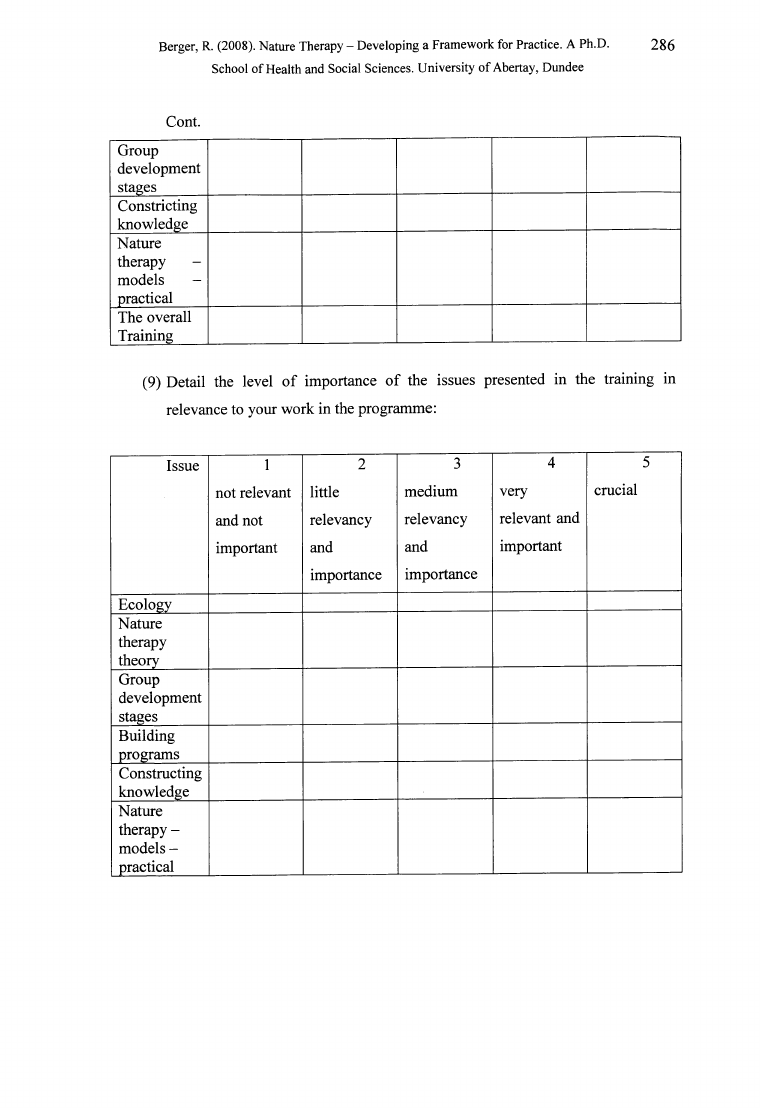
Berger, R. (2008). Nature Therapy - Developing a Framework for Practice. A Ph.D.
286
School of Health and Social Sciences. University of Abertay, Dundee
Cont.
Group
development
stages
Constricting
knowledge
Nature
therapy -
models -
practical
The overall
Training
(9) Detail the level of importance of the issues presented in the training in
relevance to your work in the programme:
Issue
1
not relevant
and not
important
2
little
relevancy
and
importance
Ecology
Nature
therapy
theory
Group
development
stages
Building
programs
Constructing
knowledge
Nature
therapy -
models -
practical
3
medium
relevancy
and
importance
4
5
very
crucial
relevant and
important
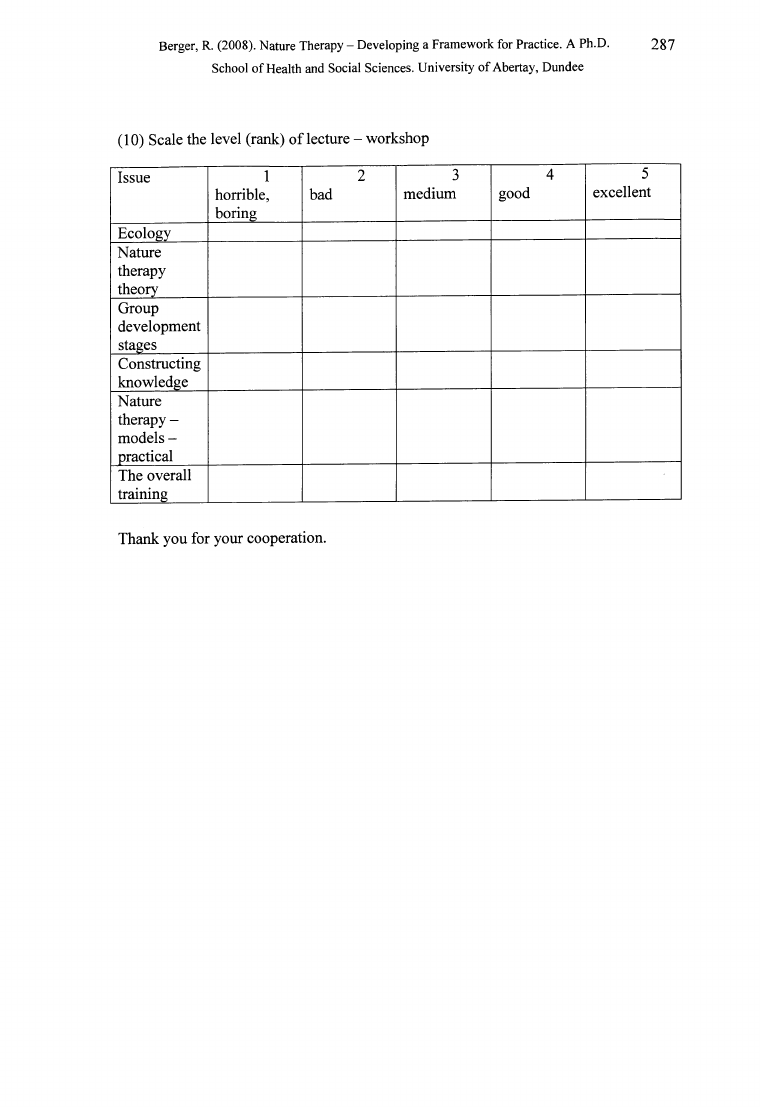
Berger, R. (2008). Nature Therapy - Developing a Framework for Practice. A Ph.D.
287
School of Health and Social Sciences. University of Abertay, Dundee
(10) Scale the level (rank) of lecture - workshop
Issue
Ecology
Nature
therapy
theory
Group
development
stages
Constructing
knowledge
Nature
therapy -
models -
practical
The overall
training
1
horrible,
boring
2
bad
3
medium
Thank you for your cooperation.
4
good
5
excellent
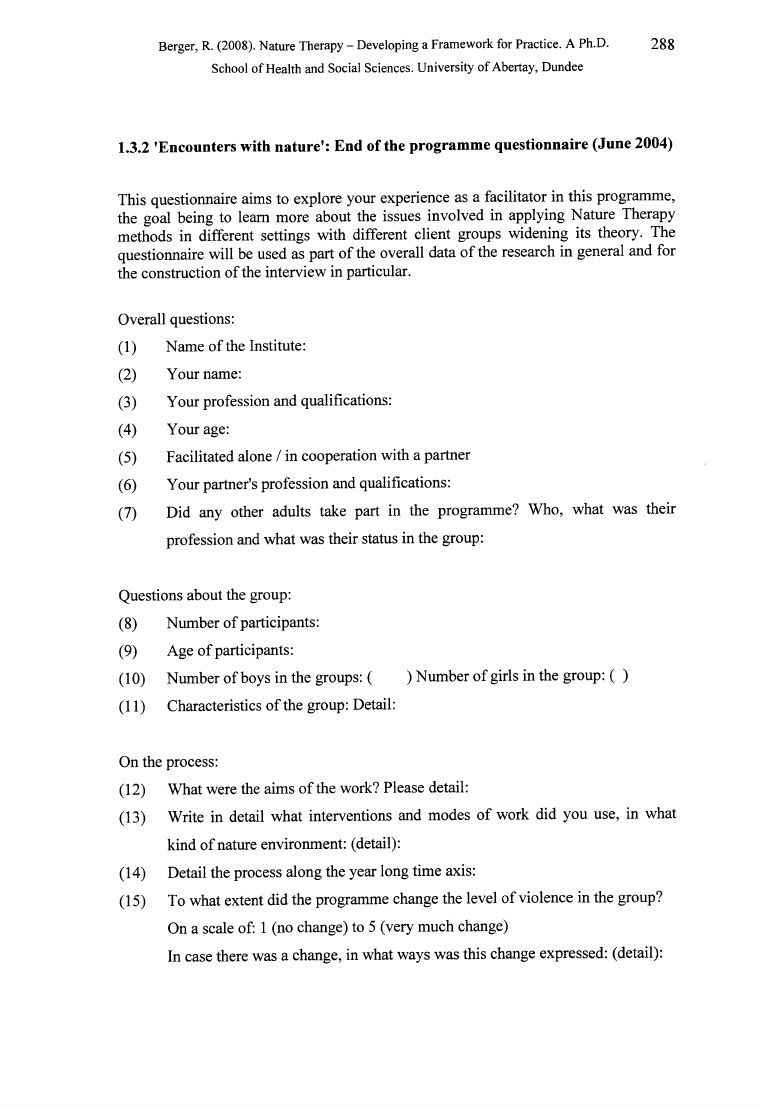
Berger, R. (2008). Nature Therapy - Developing a Framework for Practice. A Ph.D.
288
School of Health and Social Sciences. University of Abertay, Dundee
1.3.2 ’Encounters with nature’: End of the programme questionnaire (June 2004)
This questionnaire aims to explore your experience as a facilitator in this programme,
the goal being to learn more about the issues involved in applying Nature Therapy
methods in different settings with different client groups widening its theory. The
questionnaire will be used as part of the overall data of the research in general and for
the construction of the interview in particular.
Overall questions:
(1) Name of the Institute:
(2) Your name:
(3) Your profession and qualifications:
(4) Your age:
(5) Facilitated alone / in cooperation with a partner
(6) Your partner's profession and qualifications:
(7) Did any other adults take part in the programme? Who, what was their
profession and what was their status in the group:
Questions about the group:
(8) Number of participants:
(9) Age of participants:
(10) Number of boys in the groups: ( ) Number of girls in the group: ( )
(11) Characteristics of the group: Detail:
On the process:
(12) What were the aims of the work? Please detail:
(13) Write in detail what interventions and modes of work did you use, in what
kind of nature environment: (detail):
(14) Detail the process along the year long time axis:
(15) To what extent did the programme change the level of violence in the group?
On a scale of: 1 (no change) to 5 (very much change)
In case there was a change, in what ways was this change expressed: (detail):
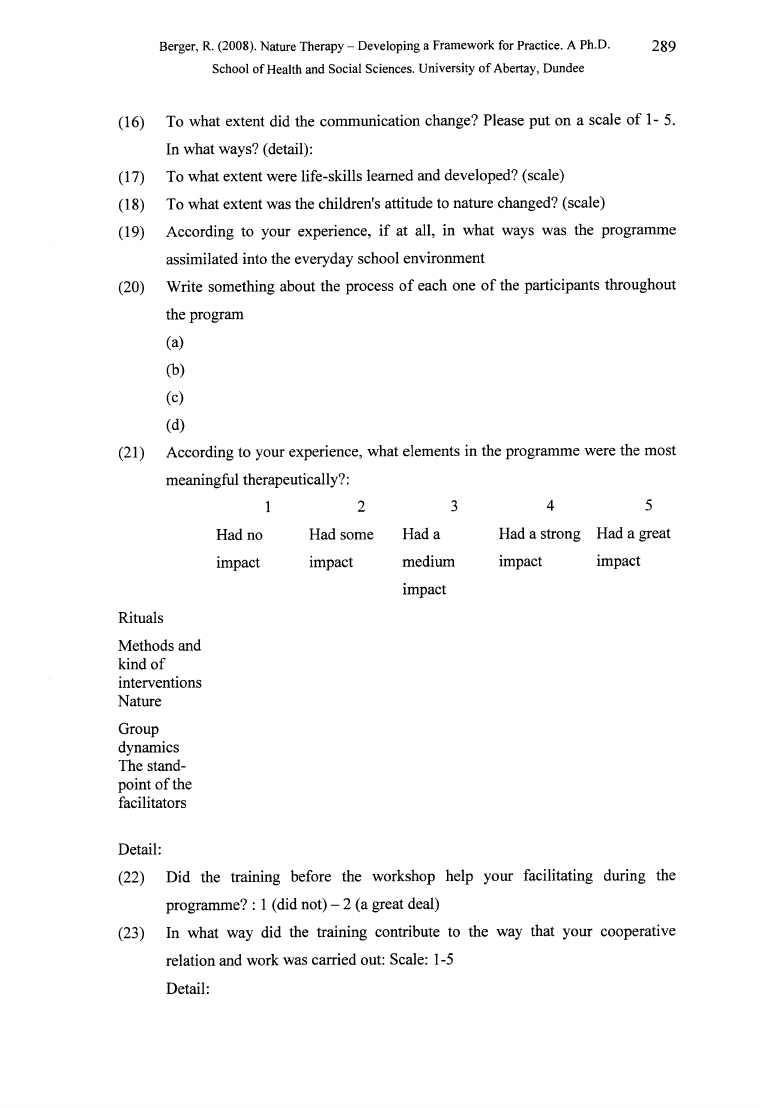
Berger, R. (2008). Nature Therapy - Developing a Framework for Practice. A Ph.D.
289
School of Health and Social Sciences. University of Abertay, Dundee
(16) To what extent did the communication change? Please put on a scale of 1- 5.
In what ways? (detail):
(17) To what extent were life-skills learned and developed? (scale)
(18) To what extent was the children's attitude to nature changed? (scale)
(19) According to your experience, if at all, in what ways was the programme
assimilated into the everyday school environment
(20) Write something about the process of each one of the participants throughout
the program
(a)
(b)
(c)
(d)
According to your experience, what elements in the programme were the most
meaningful therapeutically?:
1
2
Had no
Had some
impact
impact
3
Had a
medium
impact
4
5
Had a strong Had a great
impact
impact
Rituals
Methods and
kind of
interventions
Nature
Group
dynamics
The stand
point of the
facilitators
Detail:
(22) Did the training before the workshop help your facilitating during the
programme? : 1 (did not) —2 (a great deal)
(23) In what way did the training contribute to the way that your cooperative
relation and work was carried out: Scale: 1-5
Detail:
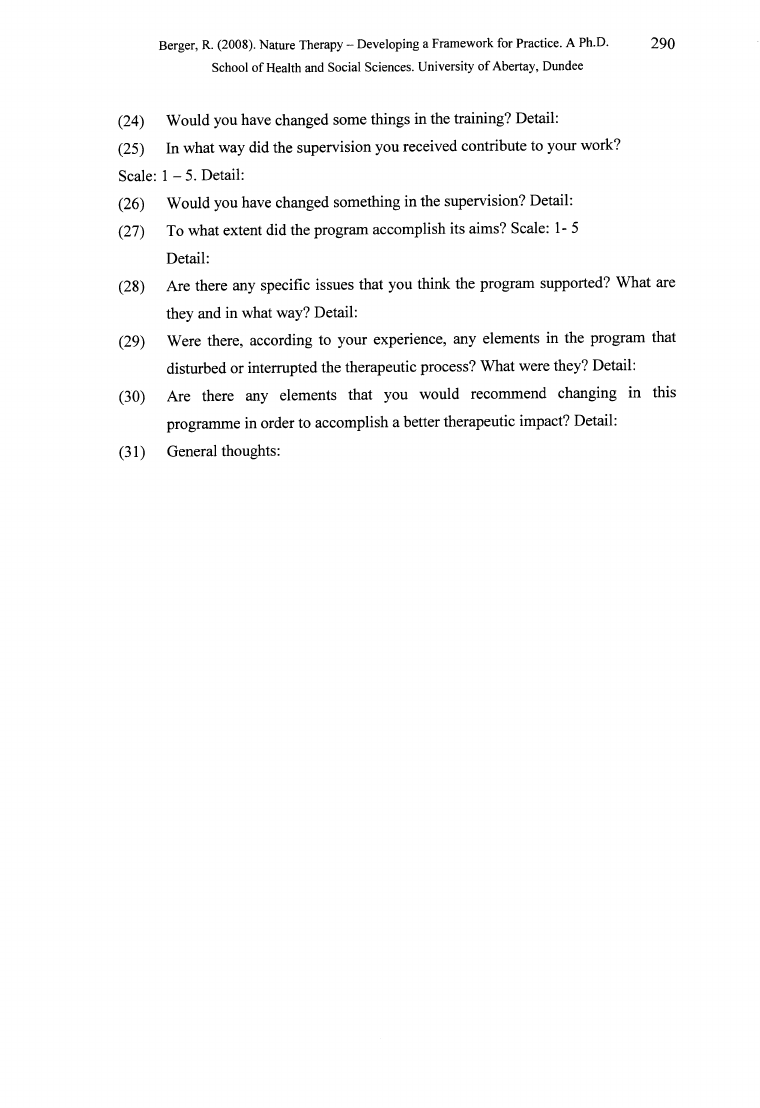
Berger, R. (2008). Nature Therapy - Developing a Framework for Practice. A Ph.D.
290
School of Health and Social Sciences. University of Abertay, Dundee
(24) Would you have changed some things in the training? Detail:
(25) In what way did the supervision you received contribute to your work?
Scale: 1 - 5 . Detail:
(26) Would you have changed something in the supervision? Detail:
(27) To what extent did the program accomplish its aims? Scale: 1-5
Detail:
(28) Are there any specific issues that you think the program supported? What are
they and in what way? Detail:
(29) Were there, according to your experience, any elements in the program that
disturbed or interrupted the therapeutic process? What were they? Detail:
(30) Are there any elements that you would recommend changing in this
programme in order to accomplish a better therapeutic impact? Detail:
(31) General thoughts:
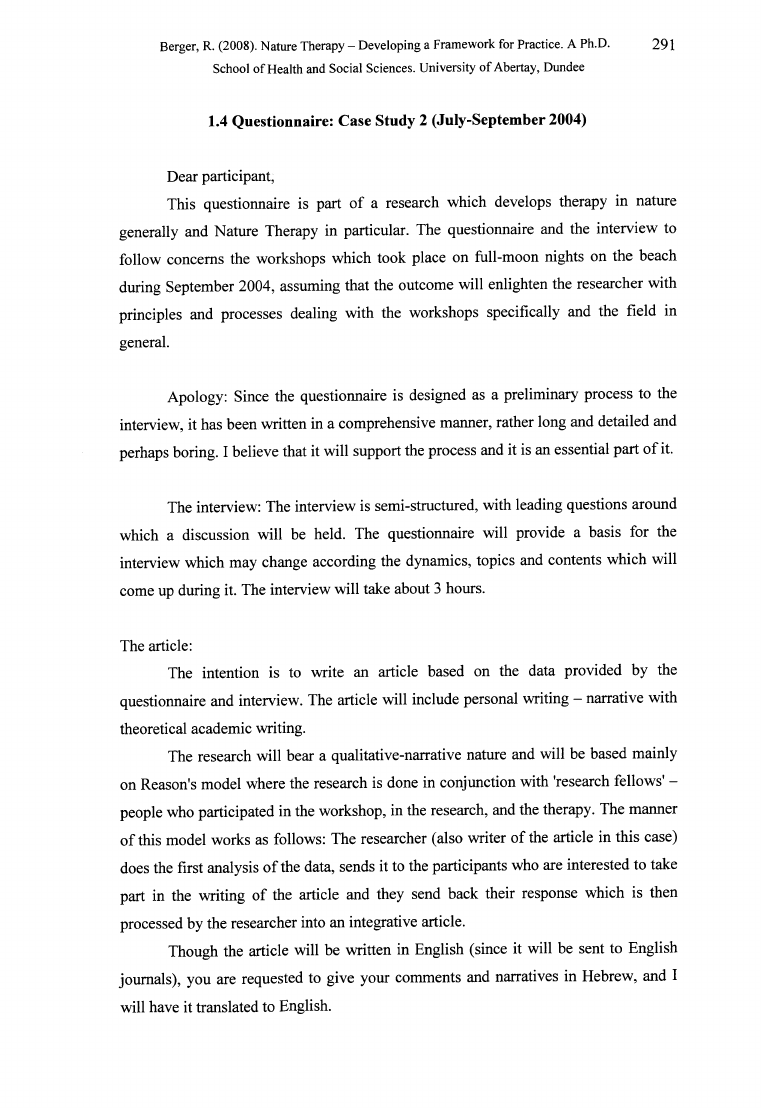
Berger, R. (2008). Nature Therapy - Developing a Framework for Practice. A Ph.D.
291
School of Health and Social Sciences. University of Abertay, Dundee
1.4 Questionnaire: Case Study 2 (July-September 2004)
Dear participant,
This questionnaire is part of a research which develops therapy in nature
generally and Nature Therapy in particular. The questionnaire and the interview to
follow concerns the workshops which took place on full-moon nights on the beach
during September 2004, assuming that the outcome will enlighten the researcher with
principles and processes dealing with the workshops specifically and the field in
general.
Apology: Since the questionnaire is designed as a preliminary process to the
interview, it has been written in a comprehensive manner, rather long and detailed and
perhaps boring. I believe that it will support the process and it is an essential part of it.
The interview: The interview is semi-structured, with leading questions around
which a discussion will be held. The questionnaire will provide a basis for the
interview which may change according the dynamics, topics and contents which will
come up during it. The interview will take about 3 hours.
The article:
The intention is to write an article based on the data provided by the
questionnaire and interview. The article will include personal writing —narrative with
theoretical academic writing.
The research will bear a qualitative-narrative nature and will be based mainly
on Reason's model where the research is done in conjunction with 'research fellows' -
people who participated in the workshop, in the research, and the therapy. The manner
of this model works as follows: The researcher (also writer of the article in this case)
does the first analysis of the data, sends it to the participants who are interested to take
part in the writing of the article and they send back their response which is then
processed by the researcher into an integrative article.
Though the article will be written in English (since it will be sent to English
journals), you are requested to give your comments and narratives in Hebrew, and I
will have it translated to English.
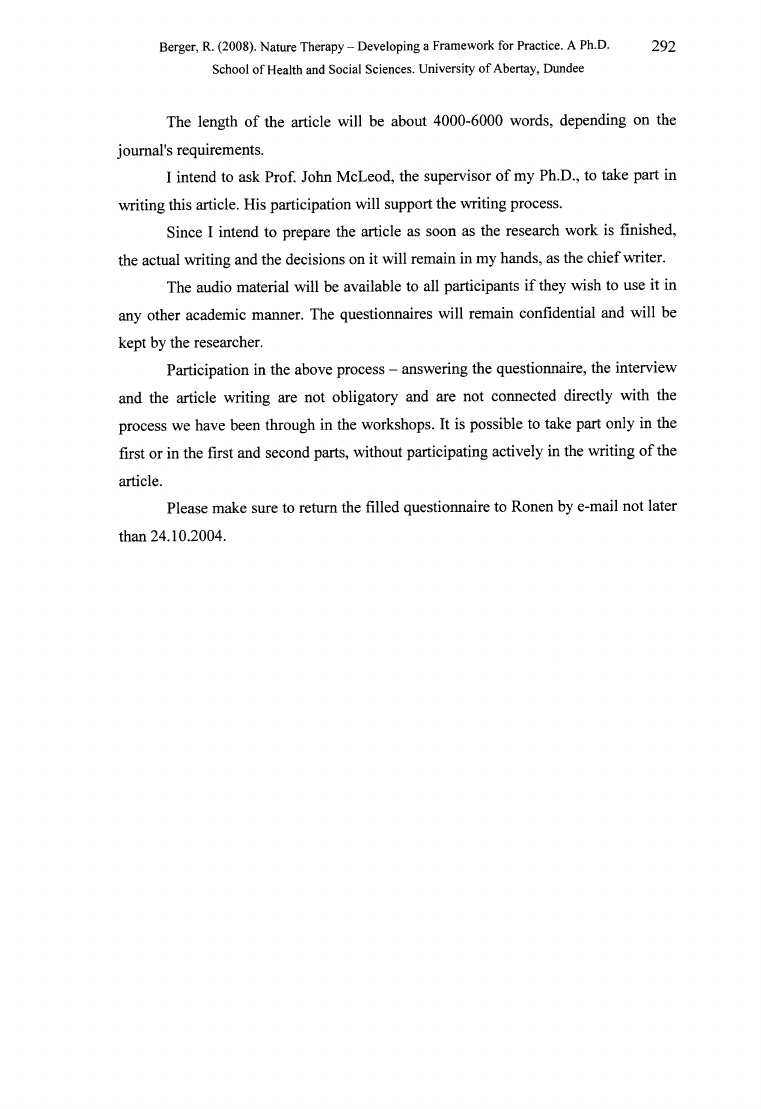
Berger, R. (2008). Nature Therapy - Developing a Framework for Practice. A Ph.D.
292
School of Health and Social Sciences. University of Abertay, Dundee
The length of the article will be about 4000-6000 words, depending on the
journal's requirements.
I intend to ask Prof. John McLeod, the supervisor of my Ph.D., to take part in
writing this article. His participation will support the writing process.
Since I intend to prepare the article as soon as the research work is finished,
the actual writing and the decisions on it will remain in my hands, as the chief writer.
The audio material will be available to all participants if they wish to use it in
any other academic manner. The questionnaires will remain confidential and will be
kept by the researcher.
Participation in the above process - answering the questionnaire, the interview
and the article writing are not obligatory and are not connected directly with the
process we have been through in the workshops. It is possible to take part only in the
first or in the first and second parts, without participating actively in the writing of the
article.
Please make sure to return the filled questionnaire to Ronen by e-mail not later
than 24.10.2004.
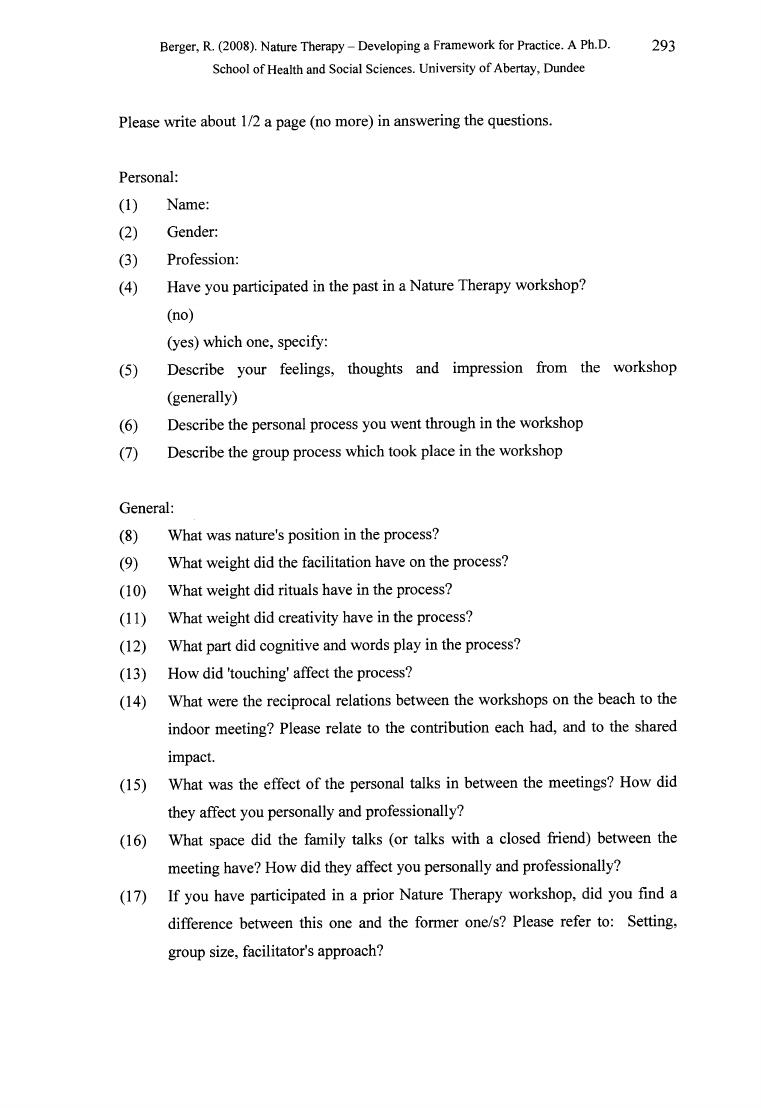
Berger, R. (2008). Nature Therapy - Developing a Framework for Practice. A Ph.D.
293
School of Health and Social Sciences. University of Abertay, Dundee
Please write about 1/2 a page (no more) in answering the questions.
Personal:
(1) Name:
(2) Gender:
(3) Profession:
(4) Have you participated in the past in a Nature Therapy workshop?
(no)
(yes) which one, specify:
(5) Describe your feelings, thoughts and impression from the workshop
(generally)
(6) Describe the personal process you went through in the workshop
(7) Describe the group process which took place in the workshop
General:
(8) What was nature's position in the process?
(9) What weight did the facilitation have on the process?
(10) What weight did rituals have in the process?
(11) What weight did creativity have in the process?
(12) What part did cognitive and words play in the process?
(13) How did 'touching' affect the process?
(14) What were the reciprocal relations between the workshops on the beach to the
indoor meeting? Please relate to the contribution each had, and to the shared
impact.
(15) What was the effect of the personal talks in between the meetings? How did
they affect you personally and professionally?
(16) What space did the family talks (or talks with a closed friend) between the
meeting have? How did they affect you personally and professionally?
(17) If you have participated in a prior Nature Therapy workshop, did you find a
difference between this one and the former one/s? Please refer to: Setting,
group size, facilitator's approach?
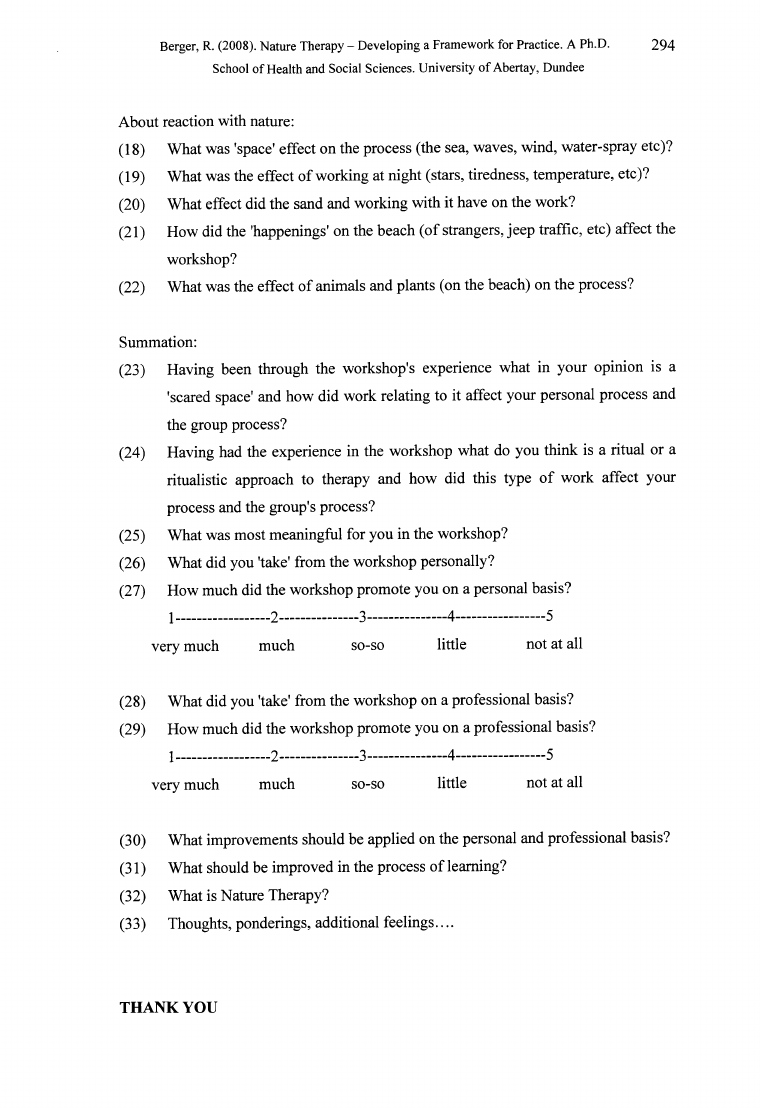
Berger, R. (2008). Nature Therapy - Developing a Framework for Practice. A Ph.D.
294
School of Health and Social Sciences. University of Abertay, Dundee
About reaction with nature:
(18) What was 'space' effect on the process (the sea, waves, wind, water-spray etc)?
(19) What was the effect of working at night (stars, tiredness, temperature, etc)?
(20) What effect did the sand and working with it have on the work?
(21) How did the 'happenings' on the beach (of strangers, jeep traffic, etc) affect the
workshop?
(22) What was the effect of animals and plants (on the beach) on the process?
Summation:
(23) Having been through the workshop's experience what in your opinion is a
'scared space' and how did work relating to it affect your personal process and
the group process?
(24) Having had the experience in the workshop what do you think is a ritual or a
ritualistic approach to therapy and how did this type of work affect your
process and the group's process?
(25) What was most meaningful for you in the workshop?
(26) What did you 'take' from the workshop personally?
(27) How much did the workshop promote you on a personal basis?
1----------------- 2---------------3---------------4-----------------5
very much much
so-so
little
not at all
(28) What did you 'take' from the workshop on a professional basis?
(29) How much did the workshop promote you on a professional basis?
1----------------- 2---------------3---------------4-----------------5
very much much
so-so
little
not at all
(30) What improvements should be applied on the personal and professional basis?
(31) What should be improved in the process of learning?
(32) What is Nature Therapy?
(33) Thoughts, ponderings, additional feelings....
THANK YOU
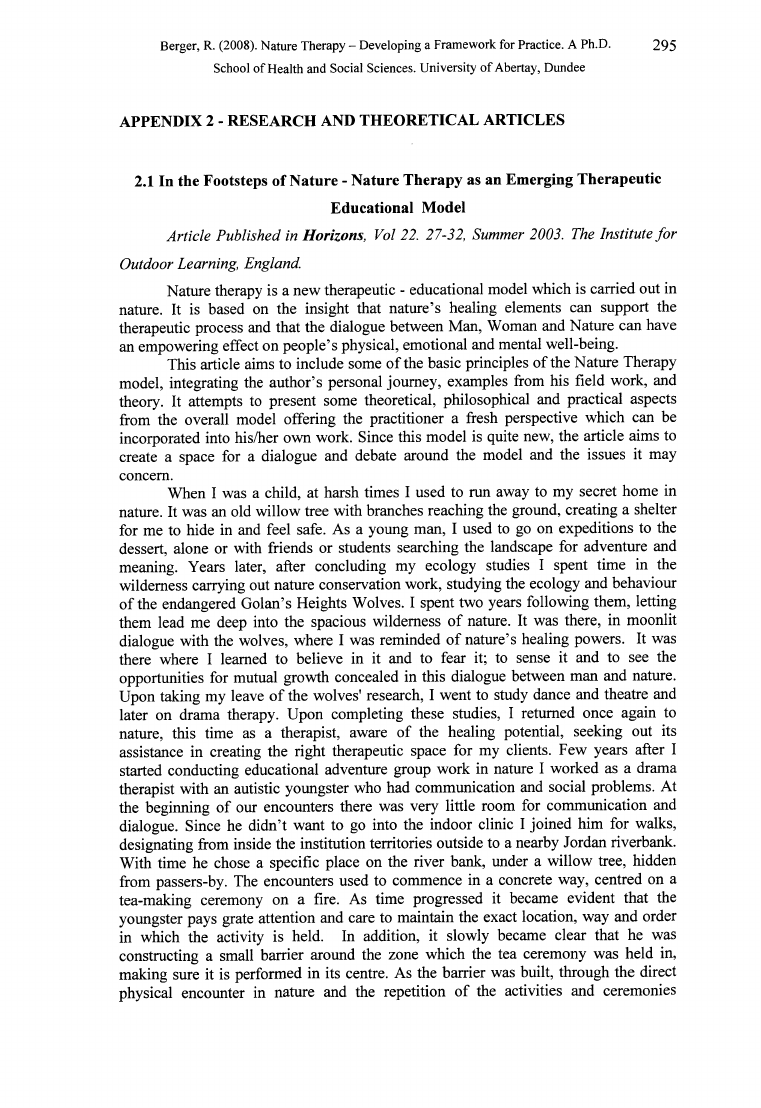
Berger, R. (2008). Nature Therapy - Developing a Framework for Practice. A Ph.D.
295
School of Health and Social Sciences. University of Abertay, Dundee
APPENDIX 2 - RESEARCH AND THEORETICAL ARTICLES
2.1 In the Footsteps of Nature - Nature Therapy as an Emerging Therapeutic
Educational Model
Article Published in H orizons, Vol 22. 27-32, Summer 2003. The Institute for
Outdoor Learning, England.
Nature therapy is a new therapeutic - educational model which is carried out in
nature. It is based on the insight that nature’s healing elements can support the
therapeutic process and that the dialogue between Man, Woman and Nature can have
an empowering effect on people’s physical, emotional and mental well-being.
This article aims to include some of the basic principles of the Nature Therapy
model, integrating the author’s personal journey, examples from his field work, and
theory. It attempts to present some theoretical, philosophical and practical aspects
from the overall model offering the practitioner a fresh perspective which can be
incorporated into his/her own work. Since this model is quite new, the article aims to
create a space for a dialogue and debate around the model and the issues it may
concern.
When I was a child, at harsh times I used to run away to my secret home in
nature. It was an old willow tree with branches reaching the ground, creating a shelter
for me to hide in and feel safe. As a young man, I used to go on expeditions to the
dessert, alone or with friends or students searching the landscape for adventure and
meaning. Years later, after concluding my ecology studies I spent time in the
wilderness carrying out nature conservation work, studying the ecology and behaviour
of the endangered Golan’s Heights Wolves. I spent two years following them, letting
them lead me deep into the spacious wilderness of nature. It was there, in moonlit
dialogue with the wolves, where I was reminded of nature’s healing powers. It was
there where I learned to believe in it and to fear it; to sense it and to see the
opportunities for mutual growth concealed in this dialogue between man and nature.
Upon taking my leave of the wolves' research, I went to study dance and theatre and
later on drama therapy. Upon completing these studies, I returned once again to
nature, this time as a therapist, aware of the healing potential, seeking out its
assistance in creating the right therapeutic space for my clients. Few years after I
started conducting educational adventure group work in nature I worked as a drama
therapist with an autistic youngster who had communication and social problems. At
the beginning of our encounters there was very little room for communication and
dialogue. Since he didn’t want to go into the indoor clinic I joined him for walks,
designating from inside the institution territories outside to a nearby Jordan riverbank.
With time he chose a specific place on the river bank, under a willow tree, hidden
from passers-by. The encounters used to commence in a concrete way, centred on a
tea-making ceremony on a fire. As time progressed it became evident that the
youngster pays grate attention and care to maintain the exact location, way and order
in which the activity is held. In addition, it slowly became clear that he was
constructing a small barrier around the zone which the tea ceremony was held in,
making sure it is performed in its centre. As the barrier was built, through the direct
physical encounter in nature and the repetition of the activities and ceremonies
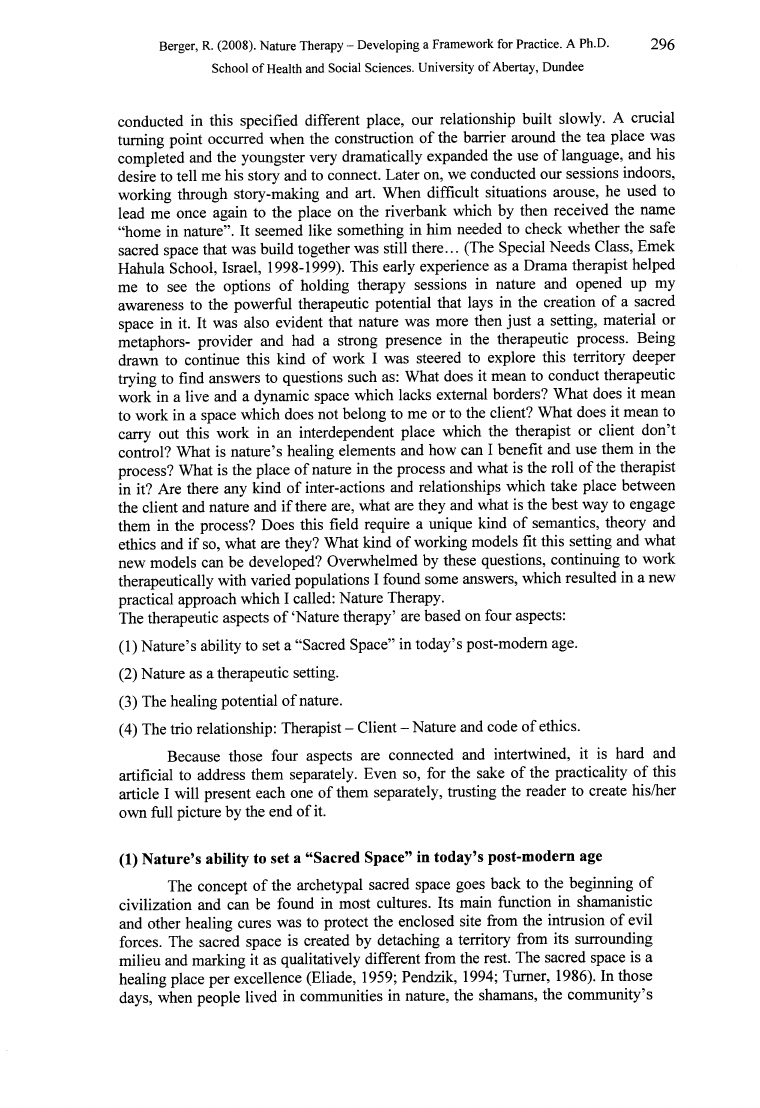
Berger, R. (2008). Nature Therapy - Developing a Framework for Practice. A Ph.D.
296
School of Health and Social Sciences. University of Abertay, Dundee
conducted in this specified different place, our relationship built slowly. A crucial
turning point occurred when the construction of the barrier around the tea place was
completed and the youngster very dramatically expanded the use of language, and his
desire to tell me his story and to connect. Later on, we conducted our sessions indoors,
working through story-making and art. When difficult situations arouse, he used to
lead me once again to the place on the riverbank which by then received the name
“home in nature”. It seemed like something in him needed to check whether the safe
sacred space that was build together was still there... (The Special Needs Class, Emek
Hahula School, Israel, 1998-1999). This early experience as a Drama therapist helped
me to see the options of holding therapy sessions in nature and opened up my
awareness to the powerful therapeutic potential that lays in the creation of a sacred
space in it. It was also evident that nature was more then just a setting, material or
metaphors- provider and had a strong presence in the therapeutic process. Being
drawn to continue this kind of work I was steered to explore this territory deeper
trying to find answers to questions such as: What does it mean to conduct therapeutic
work in a live and a dynamic space which lacks external borders? What does it mean
to work in a space which does not belong to me or to the client? What does it mean to
carry out this work in an interdependent place which the therapist or client don’t
control? What is nature’s healing elements and how can I benefit and use them in the
process? What is the place of nature in the process and what is the roll of the therapist
in it? Are there any kind of inter-actions and relationships which take place between
the client and nature and if there are, what are they and what is the best way to engage
them in the process? Does this field require a unique kind of semantics, theory and
ethics and if so, what are they? What kind of working models fit this setting and what
new models can be developed? Overwhelmed by these questions, continuing to work
therapeutically with varied populations I found some answers, which resulted in a new
practical approach which I called: Nature Therapy.
The therapeutic aspects of ‘Nature therapy’ are based on four aspects:
(1) Nature’s ability to set a “Sacred Space” in today’s post-modern age.
(2) Nature as a therapeutic setting.
(3) The healing potential of nature.
(4) The trio relationship: Therapist —Client —Nature and code of ethics.
Because those four aspects are connected and intertwined, it is hard and
artificial to address them separately. Even so, for the sake of the practicality of this
article I will present each one of them separately, trusting the reader to create his/her
own full picture by the end of it.
(1) Nature’s ability to set a “Sacred Space” in today’s post-modern age
The concept of the archetypal sacred space goes back to the beginning of
civilization and can be found in most cultures. Its main function in shamanistic
and other healing cures was to protect the enclosed site from the intrusion of evil
forces. The sacred space is created by detaching a territory from its surrounding
milieu and marking it as qualitatively different from the rest. The sacred space is a
healing place per excellence (Eliade, 1959; Pendzik, 1994; Turner, 1986). In those
days, when people lived in communities in nature, the shamans, the community’s
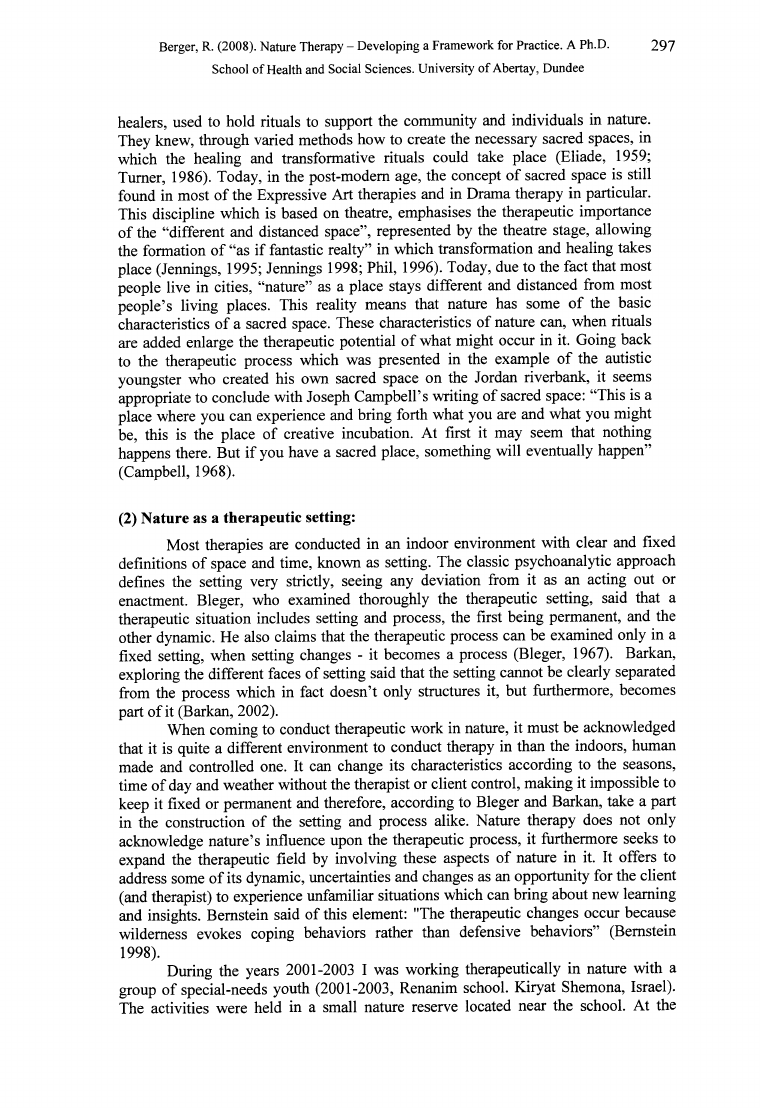
Berger, R. (2008). Nature Therapy - Developing a Framework for Practice. A Ph.D.
297
School of Health and Social Sciences. University of Abertay, Dundee
healers, used to hold rituals to support the community and individuals in nature.
They knew, through varied methods how to create the necessary sacred spaces, in
which the healing and transformative rituals could take place (Eliade, 1959;
Turner, 1986). Today, in the post-modern age, the concept of sacred space is still
found in most of the Expressive Art therapies and in Drama therapy in particular.
This discipline which is based on theatre, emphasises the therapeutic importance
of the “different and distanced space”, represented by the theatre stage, allowing
the formation of “as if fantastic realty” in which transformation and healing takes
place (Jennings, 1995; Jennings 1998; Phil, 1996). Today, due to the fact that most
people live in cities, “nature” as a place stays different and distanced from most
people’s living places. This reality means that nature has some of the basic
characteristics of a sacred space. These characteristics of nature can, when rituals
are added enlarge the therapeutic potential of what might occur in it. Going back
to the therapeutic process which was presented in the example of the autistic
youngster who created his own sacred space on the Jordan riverbank, it seems
appropriate to conclude with Joseph Campbell’s writing of sacred space: “This is a
place where you can experience and bring forth what you are and what you might
be, this is the place of creative incubation. At first it may seem that nothing
happens there. But if you have a sacred place, something will eventually happen”
(Campbell, 1968).
(2) Nature as a therapeutic setting:
Most therapies are conducted in an indoor environment with clear and fixed
definitions of space and time, known as setting. The classic psychoanalytic approach
defines the setting very strictly, seeing any deviation from it as an acting out or
enactment. Bleger, who examined thoroughly the therapeutic setting, said that a
therapeutic situation includes setting and process, the first being permanent, and the
other dynamic. He also claims that the therapeutic process can be examined only in a
fixed setting, when setting changes - it becomes a process (Bleger, 1967). Barkan,
exploring the different faces of setting said that the setting cannot be clearly separated
from the process which in fact doesn’t only structures it, but furthermore, becomes
part of it (Barkan, 2002).
When coming to conduct therapeutic work in nature, it must be acknowledged
that it is quite a different environment to conduct therapy in than the indoors, human
made and controlled one. It can change its characteristics according to the seasons,
time of day and weather without the therapist or client control, making it impossible to
keep it fixed or permanent and therefore, according to Bleger and Barkan, take a part
in the construction of the setting and process alike. Nature therapy does not only
acknowledge nature’s influence upon the therapeutic process, it furthermore seeks to
expand the therapeutic field by involving these aspects of nature in it. It offers to
address some of its dynamic, uncertainties and changes as an opportunity for the client
(and therapist) to experience unfamiliar situations which can bring about new learning
and insights. Bernstein said of this element: "The therapeutic changes occur because
wilderness evokes coping behaviors rather than defensive behaviors” (Bernstein
1998).
During the years 2001-2003 I was working therapeutically in nature with a
group of special-needs youth (2001-2003, Renanim school. Kiryat Shemona, Israel).
The activities were held in a small nature reserve located near the school. At the
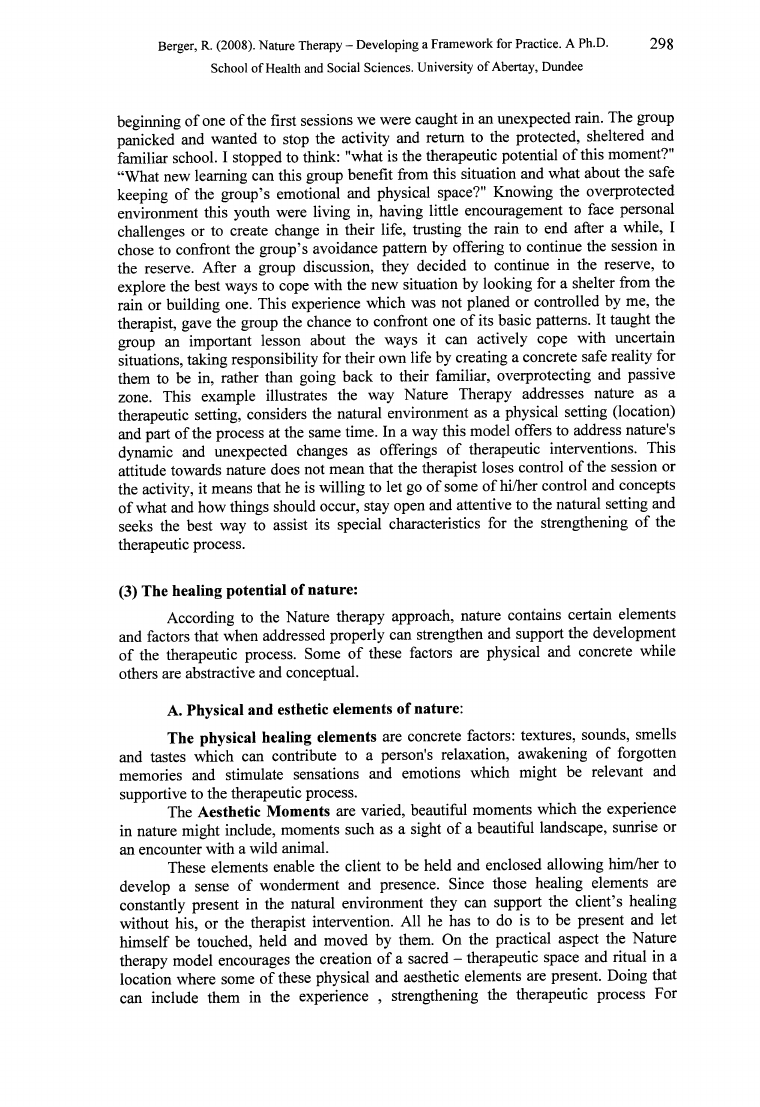
Berger, R. (2008). Nature Therapy - Developing a Framework for Practice. A Ph.D.
298
School of Health and Social Sciences. University of Abertay, Dundee
beginning of one of the first sessions we were caught in an unexpected rain. The group
panicked and wanted to stop the activity and return to the protected, sheltered and
familiar school. I stopped to think: "what is the therapeutic potential of this moment?"
“What new learning can this group benefit from this situation and what about the safe
keeping of the group’s emotional and physical space?" Knowing the overprotected
environment this youth were living in, having little encouragement to face personal
challenges or to create change in their life, trusting the rain to end after a while, I
chose to confront the group’s avoidance pattern by offering to continue the session in
the reserve. After a group discussion, they decided to continue in the reserve, to
explore the best ways to cope with the new situation by looking for a shelter from the
rain or building one. This experience which was not planed or controlled by me, the
therapist, gave the group the chance to confront one of its basic patterns. It taught the
group an important lesson about the ways it can actively cope with uncertain
situations, taking responsibility for their own life by creating a concrete safe reality for
them to be in, rather than going back to their familiar, overprotecting and passive
zone. This example illustrates the way Nature Therapy addresses nature as a
therapeutic setting, considers the natural environment as a physical setting (location)
and part of the process at the same time. In a way this model offers to address nature's
dynamic and unexpected changes as offerings of therapeutic interventions. This
attitude towards nature does not mean that the therapist loses control of the session or
the activity, it means that he is willing to let go of some of hi/her control and concepts
of what and how things should occur, stay open and attentive to the natural setting and
seeks the best way to assist its special characteristics for the strengthening of the
therapeutic process.
(3) The healing potential of nature:
According to the Nature therapy approach, nature contains certain elements
and factors that when addressed properly can strengthen and support the development
of the therapeutic process. Some of these factors are physical and concrete while
others are abstractive and conceptual.
A. Physical and esthetic elements of nature:
The physical healing elements are concrete factors: textures, sounds, smells
and tastes which can contribute to a person's relaxation, awakening of forgotten
memories and stimulate sensations and emotions which might be relevant and
supportive to the therapeutic process.
The Aesthetic Moments are varied, beautiful moments which the experience
in nature might include, moments such as a sight of a beautiful landscape, sunrise or
an encounter with a wild animal.
These elements enable the client to be held and enclosed allowing him/her to
develop a sense of wonderment and presence. Since those healing elements are
constantly present in the natural environment they can support the client’s healing
without his, or the therapist intervention. All he has to do is to be present and let
himself be touched, held and moved by them. On the practical aspect the Nature
therapy model encourages the creation of a sacred —therapeutic space and ritual in a
location where some of these physical and aesthetic elements are present. Doing that
can include them in the experience , strengthening the therapeutic process For
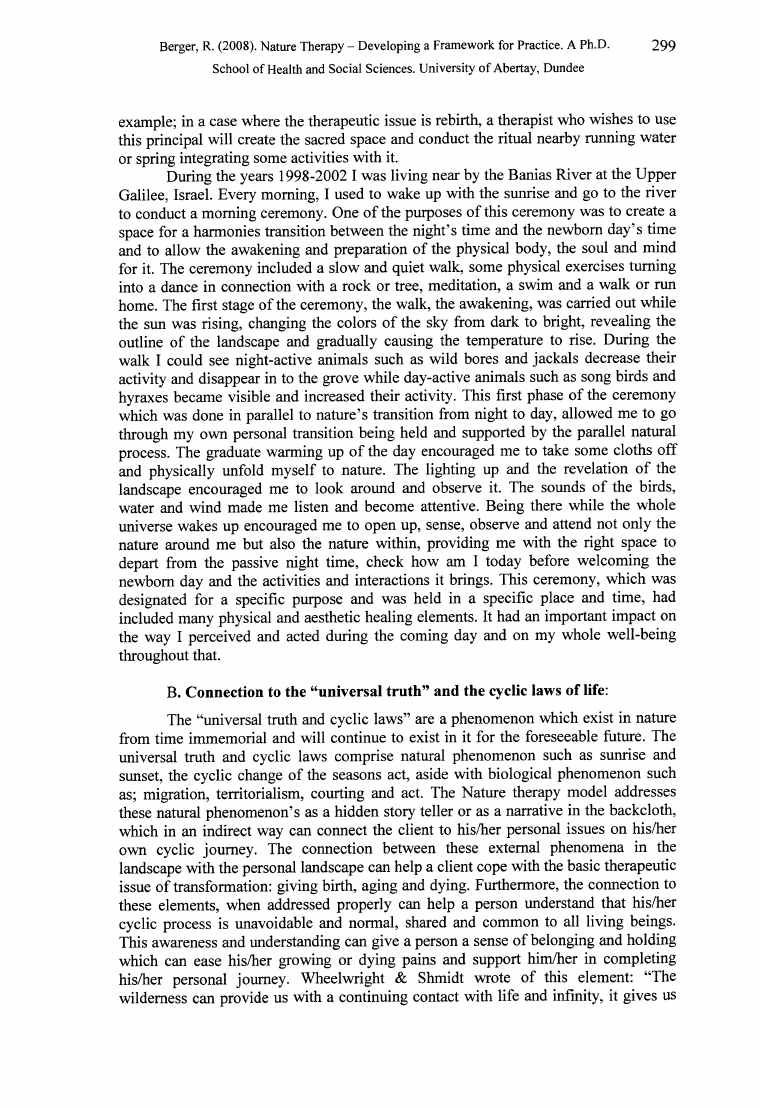
Berger, R. (2008). Nature Therapy - Developing a Framework for Practice. A Ph.D.
299
School of Health and Social Sciences. University of Abertay, Dundee
example; in a case where the therapeutic issue is rebirth, a therapist who wishes to use
this principal will create the sacred space and conduct the ritual nearby running water
or spring integrating some activities with it.
During the years 1998-2002 I was living near by the Banias River at the Upper
Galilee, Israel. Every morning, I used to wake up with the sunrise and go to the river
to conduct a morning ceremony. One of the purposes of this ceremony was to create a
space for a harmonies transition between the night’s time and the newborn day’s time
and to allow the awakening and preparation of the physical body, the soul and mind
for it. The ceremony included a slow and quiet walk, some physical exercises turning
into a dance in connection with a rock or tree, meditation, a swim and a walk or run
home. The first stage of the ceremony, the walk, the awakening, was carried out while
the sun was rising, changing the colors of the sky from dark to bright, revealing the
outline of the landscape and gradually causing the temperature to rise. During the
walk I could see night-active animals such as wild bores and jackals decrease their
activity and disappear in to the grove while day-active animals such as song birds and
hyraxes became visible and increased their activity. This first phase of the ceremony
which was done in parallel to nature’s transition from night to day, allowed me to go
through my own personal transition being held and supported by the parallel natural
process. The graduate warming up of the day encouraged me to take some cloths off
and physically unfold myself to nature. The lighting up and the revelation of the
landscape encouraged me to look around and observe it. The sounds of the birds,
water and wind made me listen and become attentive. Being there while the whole
universe wakes up encouraged me to open up, sense, observe and attend not only the
nature around me but also the nature within, providing me with the right space to
depart from the passive night time, check how am I today before welcoming the
newborn day and the activities and interactions it brings. This ceremony, which was
designated for a specific purpose and was held in a specific place and time, had
included many physical and aesthetic healing elements. It had an important impact on
the way I perceived and acted during the coming day and on my whole well-being
throughout that.
B. Connection to the “universal truth” and the cyclic laws of life:
The “universal truth and cyclic laws” are a phenomenon which exist in nature
from time immemorial and will continue to exist in it for the foreseeable future. The
universal truth and cyclic laws comprise natural phenomenon such as sunrise and
sunset, the cyclic change of the seasons act, aside with biological phenomenon such
as; migration, territorialism, courting and act. The Nature therapy model addresses
these natural phenomenon’s as a hidden story teller or as a narrative in the backcloth,
which in an indirect way can connect the client to his/her personal issues on his/her
own cyclic journey. The connection between these external phenomena in the
landscape with the personal landscape can help a client cope with the basic therapeutic
issue of transformation: giving birth, aging and dying. Furthermore, the connection to
these elements, when addressed properly can help a person understand that his/her
cyclic process is unavoidable and normal, shared and common to all living beings.
This awareness and understanding can give a person a sense of belonging and holding
which can ease his/her growing or dying pains and support him/her in completing
his/her personal journey. Wheelwright & Shmidt wrote of this element: “The
wilderness can provide us with a continuing contact with life and infinity, it gives us
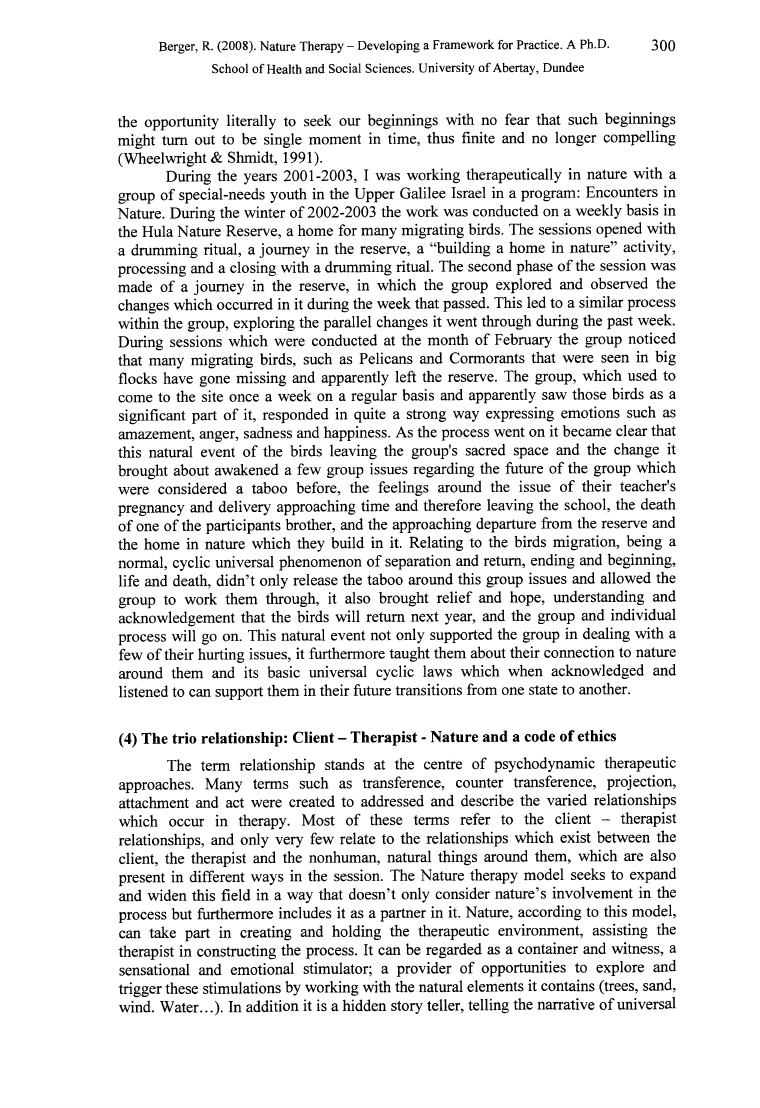
Berger, R. (2008). Nature Therapy - Developing a Framework for Practice. A Ph.D.
300
School of Health and Social Sciences. University of Abertay, Dundee
the opportunity literally to seek our beginnings with no fear that such beginnings
might turn out to be single moment in time, thus finite and no longer compelling
(Wheelwright & Shmidt, 1991).
During the years 2001-2003, I was working therapeutically in nature with a
group of special-needs youth in the Upper Galilee Israel in a program: Encounters in
Nature. During the winter of 2002-2003 the work was conducted on a weekly basis in
the Hula Nature Reserve, a home for many migrating birds. The sessions opened with
a drumming ritual, a journey in the reserve, a “building a home in nature” activity,
processing and a closing with a drumming ritual. The second phase of the session was
made of a journey in the reserve, in which the group explored and observed the
changes which occurred in it during the week that passed. This led to a similar process
within the group, exploring the parallel changes it went through during the past week.
During sessions which were conducted at the month of February the group noticed
that many migrating birds, such as Pelicans and Cormorants that were seen in big
flocks have gone missing and apparently left the reserve. The group, which used to
come to the site once a week on a regular basis and apparently saw those birds as a
significant part of it, responded in quite a strong way expressing emotions such as
amazement, anger, sadness and happiness. As the process went on it became clear that
this natural event of the birds leaving the group's sacred space and the change it
brought about awakened a few group issues regarding the future of the group which
were considered a taboo before, the feelings around the issue of their teacher's
pregnancy and delivery approaching time and therefore leaving the school, the death
of one of the participants brother, and the approaching departure from the reserve and
the home in nature which they build in it. Relating to the birds migration, being a
normal, cyclic universal phenomenon of separation and return, ending and beginning,
life and death, didn’t only release the taboo around this group issues and allowed the
group to work them through, it also brought relief and hope, understanding and
acknowledgement that the birds will return next year, and the group and individual
process will go on. This natural event not only supported the group in dealing with a
few of their hurting issues, it furthermore taught them about their connection to nature
around them and its basic universal cyclic laws which when acknowledged and
listened to can support them in their future transitions from one state to another.
(4) The trio relationship: Client - Therapist - Nature and a code of ethics
The term relationship stands at the centre of psychodynamic therapeutic
approaches. Many terms such as transference, counter transference, projection,
attachment and act were created to addressed and describe the varied relationships
which occur in therapy. Most of these terms refer to the client - therapist
relationships, and only very few relate to the relationships which exist between the
client, the therapist and the nonhuman, natural things around them, which are also
present in different ways in the session. The Nature therapy model seeks to expand
and widen this field in a way that doesn’t only consider nature’s involvement in the
process but furthermore includes it as a partner in it. Nature, according to this model,
can take part in creating and holding the therapeutic environment, assisting the
therapist in constructing the process. It can be regarded as a container and witness, a
sensational and emotional stimulator; a provider of opportunities to explore and
trigger these stimulations by working with the natural elements it contains (trees, sand,
wind. Water...). In addition it is a hidden story teller, telling the narrative of universal
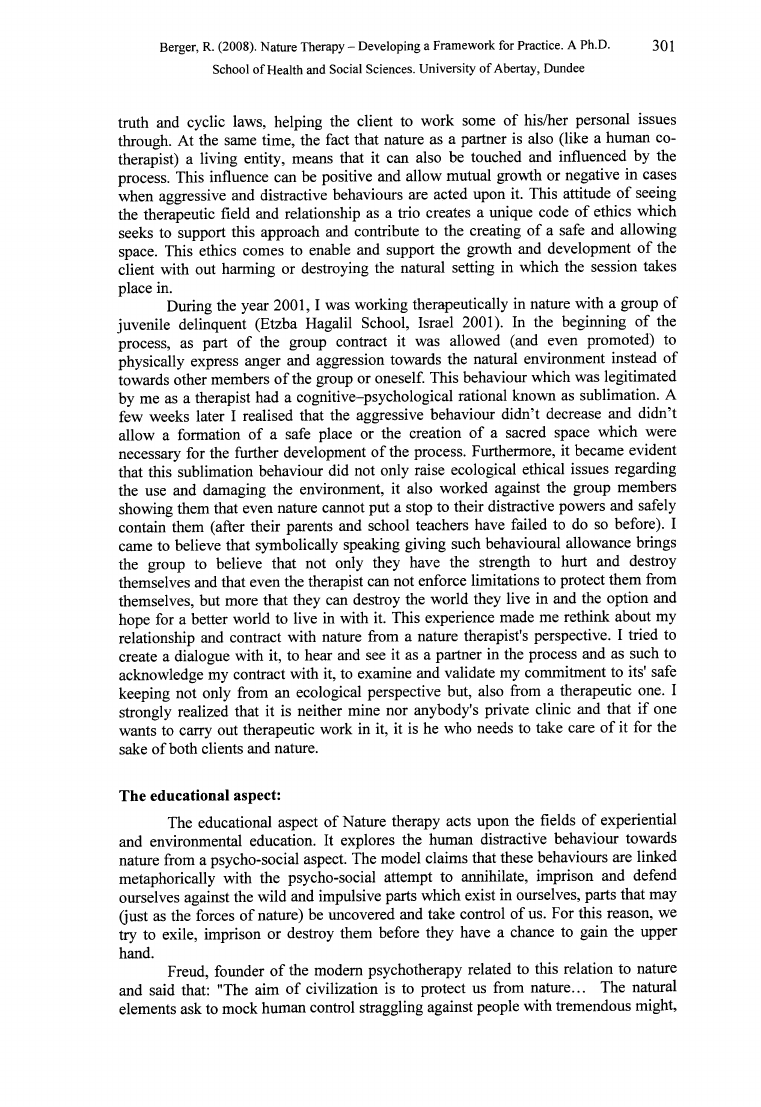
Berger, R. (2008). Nature Therapy - Developing a Framework for Practice. A Ph.D.
301
School of Health and Social Sciences. University of Abertay, Dundee
truth and cyclic laws, helping the client to work some of his/her personal issues
through. At the same time, the fact that nature as a partner is also (like a human co
therapist) a living entity, means that it can also be touched and influenced by the
process. This influence can be positive and allow mutual growth or negative in cases
when aggressive and distractive behaviours are acted upon it. This attitude of seeing
the therapeutic field and relationship as a trio creates a unique code of ethics which
seeks to support this approach and contribute to the creating of a safe and allowing
space. This ethics comes to enable and support the growth and development of the
client with out harming or destroying the natural setting in which the session takes
place in.
During the year 2001,1 was working therapeutically in nature with a group of
juvenile delinquent (Etzba Hagalil School, Israel 2001). In the beginning of the
process, as part of the group contract it was allowed (and even promoted) to
physically express anger and aggression towards the natural environment instead of
towards other members of the group or oneself. This behaviour which was legitimated
by me as a therapist had a cognitive-psychological rational known as sublimation. A
few weeks later I realised that the aggressive behaviour didn’t decrease and didn’t
allow a formation of a safe place or the creation of a sacred space which were
necessary for the further development of the process. Furthermore, it became evident
that this sublimation behaviour did not only raise ecological ethical issues regarding
the use and damaging the environment, it also worked against the group members
showing them that even nature cannot put a stop to their distractive powers and safely
contain them (after their parents and school teachers have failed to do so before). I
came to believe that symbolically speaking giving such behavioural allowance brings
the group to believe that not only they have the strength to hurt and destroy
themselves and that even the therapist can not enforce limitations to protect them from
themselves, but more that they can destroy the world they live in and the option and
hope for a better world to live in with it. This experience made me rethink about my
relationship and contract with nature from a nature therapist's perspective. I tried to
create a dialogue with it, to hear and see it as a partner in the process and as such to
acknowledge my contract with it, to examine and validate my commitment to its' safe
keeping not only from an ecological perspective but, also from a therapeutic one. I
strongly realized that it is neither mine nor anybody's private clinic and that if one
wants to carry out therapeutic work in it, it is he who needs to take care of it for the
sake of both clients and nature.
The educational aspect:
The educational aspect of Nature therapy acts upon the fields of experiential
and environmental education. It explores the human distractive behaviour towards
nature from a psycho-social aspect. The model claims that these behaviours are linked
metaphorically with the psycho-social attempt to annihilate, imprison and defend
ourselves against the wild and impulsive parts which exist in ourselves, parts that may
(just as the forces of nature) be uncovered and take control of us. For this reason, we
try to exile, imprison or destroy them before they have a chance to gain the upper
hand.
Freud, founder of the modem psychotherapy related to this relation to nature
and said that: "The aim of civilization is to protect us from nature... The natural
elements ask to mock human control straggling against people with tremendous might,
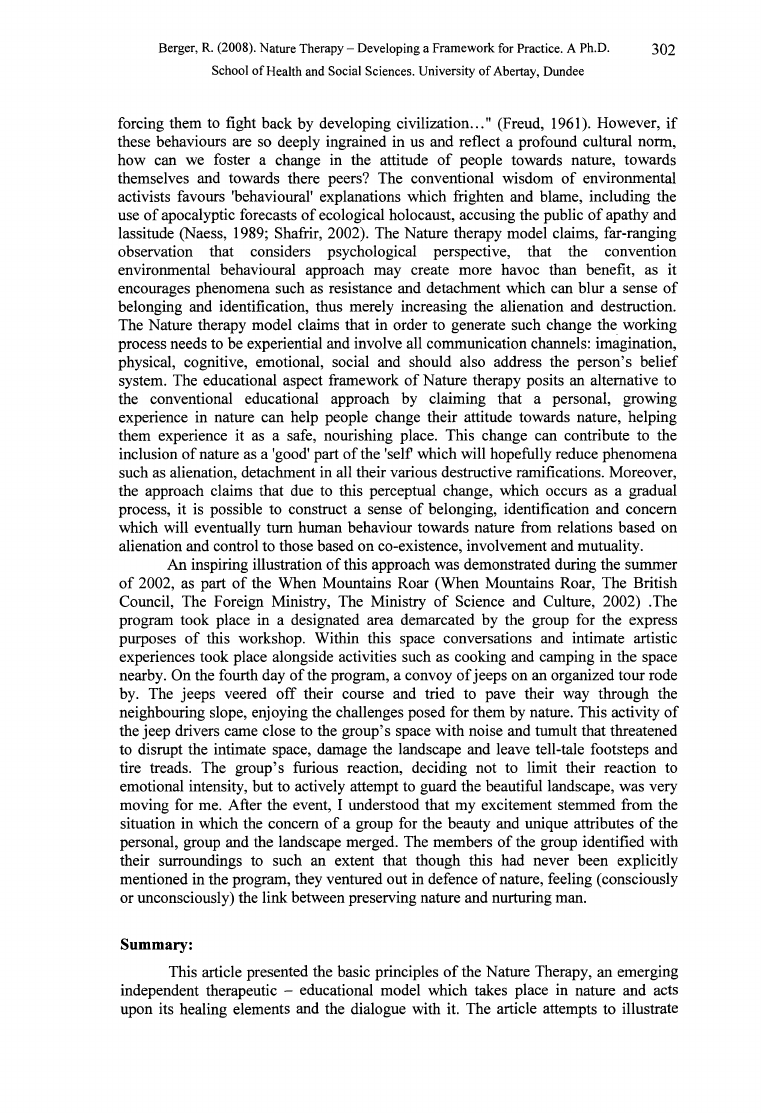
Berger, R. (2008). Nature Therapy - Developing a Framework for Practice. A Ph.D.
302
School of Health and Social Sciences. University of Abertay, Dundee
forcing them to fight back by developing civilization..." (Freud, 1961). However, if
these behaviours are so deeply ingrained in us and reflect a profound cultural norm,
how can we foster a change in the attitude of people towards nature, towards
themselves and towards there peers? The conventional wisdom of environmental
activists favours 'behavioural' explanations which frighten and blame, including the
use of apocalyptic forecasts of ecological holocaust, accusing the public of apathy and
lassitude (Naess, 1989; Shafrir, 2002). The Nature therapy model claims, far-ranging
observation that considers psychological perspective, that the convention
environmental behavioural approach may create more havoc than benefit, as it
encourages phenomena such as resistance and detachment which can blur a sense of
belonging and identification, thus merely increasing the alienation and destruction.
The Nature therapy model claims that in order to generate such change the working
process needs to be experiential and involve all communication channels: imagination,
physical, cognitive, emotional, social and should also address the person’s belief
system. The educational aspect framework of Nature therapy posits an alternative to
the conventional educational approach by claiming that a personal, growing
experience in nature can help people change their attitude towards nature, helping
them experience it as a safe, nourishing place. This change can contribute to the
inclusion of nature as a 'good' part of the 'self which will hopefully reduce phenomena
such as alienation, detachment in all their various destructive ramifications. Moreover,
the approach claims that due to this perceptual change, which occurs as a gradual
process, it is possible to construct a sense of belonging, identification and concern
which will eventually turn human behaviour towards nature from relations based on
alienation and control to those based on co-existence, involvement and mutuality.
An inspiring illustration of this approach was demonstrated during the summer
of 2002, as part of the When Mountains Roar (When Mountains Roar, The British
Council, The Foreign Ministry, The Ministry of Science and Culture, 2002) .The
program took place in a designated area demarcated by the group for the express
purposes of this workshop. Within this space conversations and intimate artistic
experiences took place alongside activities such as cooking and camping in the space
nearby. On the fourth day of the program, a convoy of jeeps on an organized tour rode
by. The jeeps veered off their course and tried to pave their way through the
neighbouring slope, enjoying the challenges posed for them by nature. This activity of
the jeep drivers came close to the group’s space with noise and tumult that threatened
to disrupt the intimate space, damage the landscape and leave tell-tale footsteps and
tire treads. The group’s furious reaction, deciding not to limit their reaction to
emotional intensity, but to actively attempt to guard the beautiful landscape, was very
moving for me. After the event, I understood that my excitement stemmed from the
situation in which the concern of a group for the beauty and unique attributes of the
personal, group and the landscape merged. The members of the group identified with
their surroundings to such an extent that though this had never been explicitly
mentioned in the program, they ventured out in defence of nature, feeling (consciously
or unconsciously) the link between preserving nature and nurturing man.
Summary:
This article presented the basic principles of the Nature Therapy, an emerging
independent therapeutic - educational model which takes place in nature and acts
upon its healing elements and the dialogue with it. The article attempts to illustrate
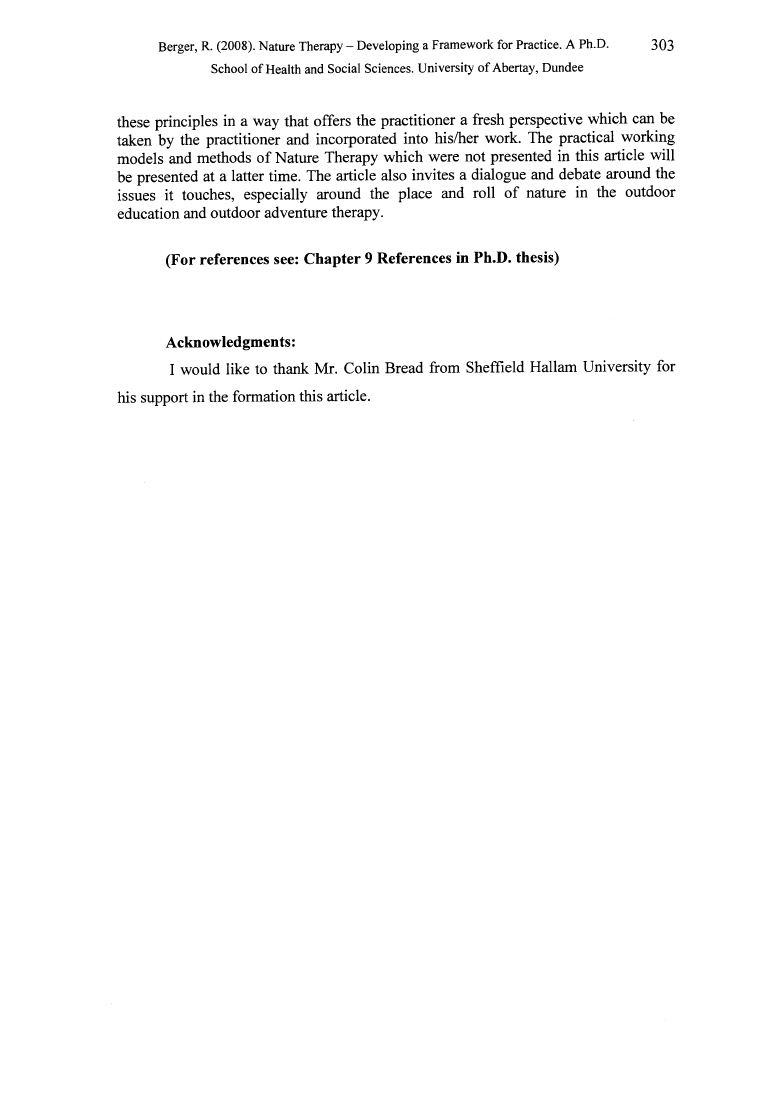
Berger, R. (2008). Nature Therapy - Developing a Framework for Practice. A Ph.D.
303
School of Health and Social Sciences. University of Abertay, Dundee
these principles in a way that offers the practitioner a fresh perspective which can be
taken by the practitioner and incorporated into his/her work. The practical working
models and methods of Nature Therapy which were not presented in this article will
be presented at a latter time. The article also invites a dialogue and debate around the
issues it touches, especially around the place and roll of nature in the outdoor
education and outdoor adventure therapy.
(For references see: Chapter 9 References in Ph.D. thesis)
Acknowledgments:
I would like to thank Mr. Colin Bread from Sheffield Hallam University for
his support in the formation this article.
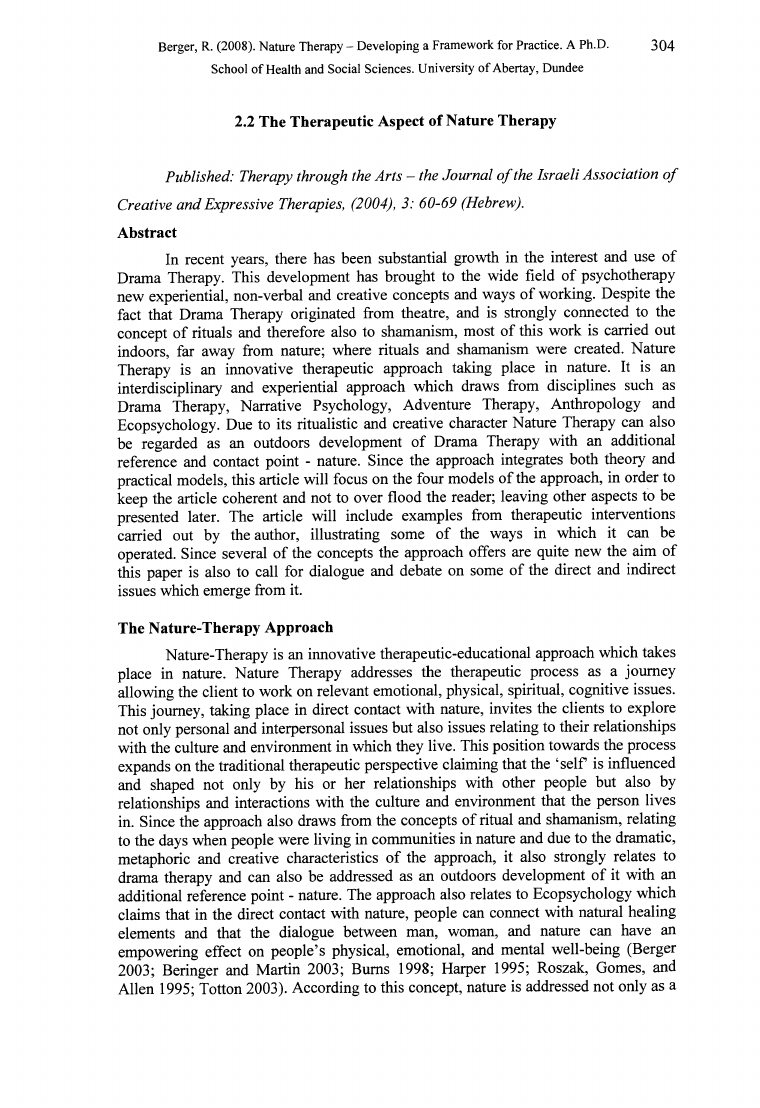
Berger, R. (2008). Nature Therapy - Developing a Framework for Practice. A Ph.D.
304
School of Health and Social Sciences. University of Abertay, Dundee
2.2 The Therapeutic Aspect of Nature Therapy
Published: Therapy through the Arts —the Journal o f the Israeli Association o f
Creative and Expressive Therapies, (2004), 3: 60-69 (Hebrew).
Abstract
In recent years, there has been substantial growth in the interest and use of
Drama Therapy. This development has brought to the wide field of psychotherapy
new experiential, non-verbal and creative concepts and ways of working. Despite the
fact that Drama Therapy originated from theatre, and is strongly connected to the
concept of rituals and therefore also to shamanism, most of this work is carried out
indoors, far away from nature; where rituals and shamanism were created. Nature
Therapy is an innovative therapeutic approach taking place in nature. It is an
interdisciplinary and experiential approach which draws from disciplines such as
Drama Therapy, Narrative Psychology, Adventure Therapy, Anthropology and
Ecopsychology. Due to its ritualistic and creative character Nature Therapy can also
be regarded as an outdoors development of Drama Therapy with an additional
reference and contact point - nature. Since the approach integrates both theory and
practical models, this article will focus on the four models of the approach, in order to
keep the article coherent and not to over flood the reader; leaving other aspects to be
presented later. The article will include examples from therapeutic interventions
carried out by the author, illustrating some of the ways in which it can be
operated. Since several of the concepts the approach offers are quite new the aim of
this paper is also to call for dialogue and debate on some of the direct and indirect
issues which emerge from it.
The Nature-Therapy Approach
Nature-Therapy is an innovative therapeutic-educational approach which takes
place in nature. Nature Therapy addresses the therapeutic process as a journey
allowing the client to work on relevant emotional, physical, spiritual, cognitive issues.
This journey, taking place in direct contact with nature, invites the clients to explore
not only personal and interpersonal issues but also issues relating to their relationships
with the culture and environment in which they live. This position towards the process
expands on the traditional therapeutic perspective claiming that the ‘self is influenced
and shaped not only by his or her relationships with other people but also by
relationships and interactions with the culture and environment that the person lives
in. Since the approach also draws from the concepts of ritual and shamanism, relating
to the days when people were living in communities in nature and due to the dramatic,
metaphoric and creative characteristics of the approach, it also strongly relates to
drama therapy and can also be addressed as an outdoors development of it with an
additional reference point - nature. The approach also relates to Ecopsychology which
claims that in the direct contact with nature, people can connect with natural healing
elements and that the dialogue between man, woman, and nature can have an
empowering effect on people’s physical, emotional, and mental well-being (Berger
2003; Beringer and Martin 2003; Bums 1998; Harper 1995; Roszak, Gomes, and
Allen 1995; Totton 2003). According to this concept, nature is addressed not only as a
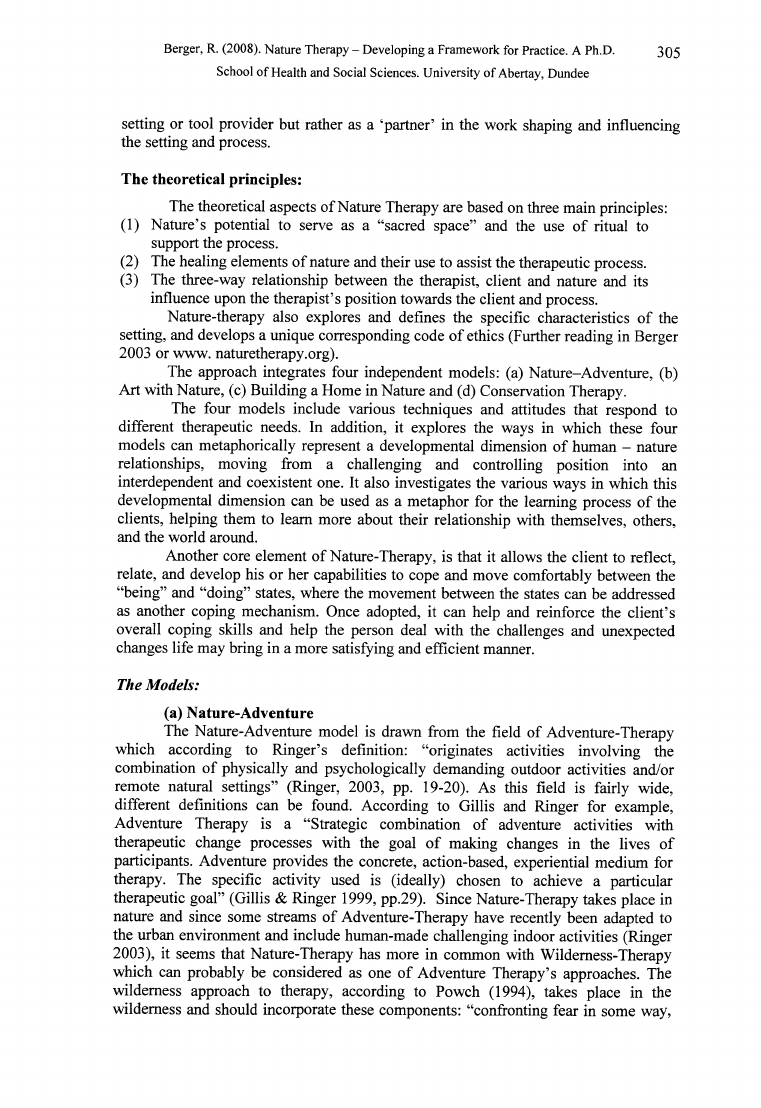
Berger, R. (2008). Nature Therapy - Developing a Framework for Practice. A Ph.D.
305
School of Health and Social Sciences. University of Abertay, Dundee
setting or tool provider but rather as a ‘partner’ in the work shaping and influencing
the setting and process.
The theoretical principles:
The theoretical aspects of Nature Therapy are based on three main principles:
(1) Nature’s potential to serve as a “sacred space” and the use of ritual to
support the process.
(2) The healing elements of nature and their use to assist the therapeutic process.
(3) The three-way relationship between the therapist, client and nature and its
influence upon the therapist’s position towards the client and process.
Nature-therapy also explores and defines the specific characteristics of the
setting, and develops a unique corresponding code of ethics (Further reading in Berger
2003 or www.naturetherapy.org).
The approach integrates four independent models: (a) Nature-Adventure, (b)
Art with Nature, (c) Building a Home in Nature and (d) Conservation Therapy.
The four models include various techniques and attitudes that respond to
different therapeutic needs. In addition, it explores the ways in which these four
models can metaphorically represent a developmental dimension of human - nature
relationships, moving from a challenging and controlling position into an
interdependent and coexistent one. It also investigates the various ways in which this
developmental dimension can be used as a metaphor for the learning process of the
clients, helping them to learn more about their relationship with themselves, others,
and the world around.
Another core element of Nature-Therapy, is that it allows the client to reflect,
relate, and develop his or her capabilities to cope and move comfortably between the
“being” and “doing” states, where the movement between the states can be addressed
as another coping mechanism. Once adopted, it can help and reinforce the client’s
overall coping skills and help the person deal with the challenges and unexpected
changes life may bring in a more satisfying and efficient manner.
The Models:
(a) Nature-Adventure
The Nature-Adventure model is drawn from the field of Adventure-Therapy
which according to Ringer’s definition: “originates activities involving the
combination of physically and psychologically demanding outdoor activities and/or
remote natural settings” (Ringer, 2003, pp. 19-20). As this field is fairly wide,
different definitions can be found. According to Gillis and Ringer for example,
Adventure Therapy is a “Strategic combination of adventure activities with
therapeutic change processes with the goal of making changes in the lives of
participants. Adventure provides the concrete, action-based, experiential medium for
therapy. The specific activity used is (ideally) chosen to achieve a particular
therapeutic goal” (Gillis & Ringer 1999, pp.29). Since Nature-Therapy takes place in
nature and since some streams of Adventure-Therapy have recently been adapted to
the urban environment and include human-made challenging indoor activities (Ringer
2003), it seems that Nature-Therapy has more in common with Wilderness-Therapy
which can probably be considered as one of Adventure Therapy’s approaches. The
wilderness approach to therapy, according to Powch (1994), takes place in the
wilderness and should incorporate these components: “confronting fear in some way,
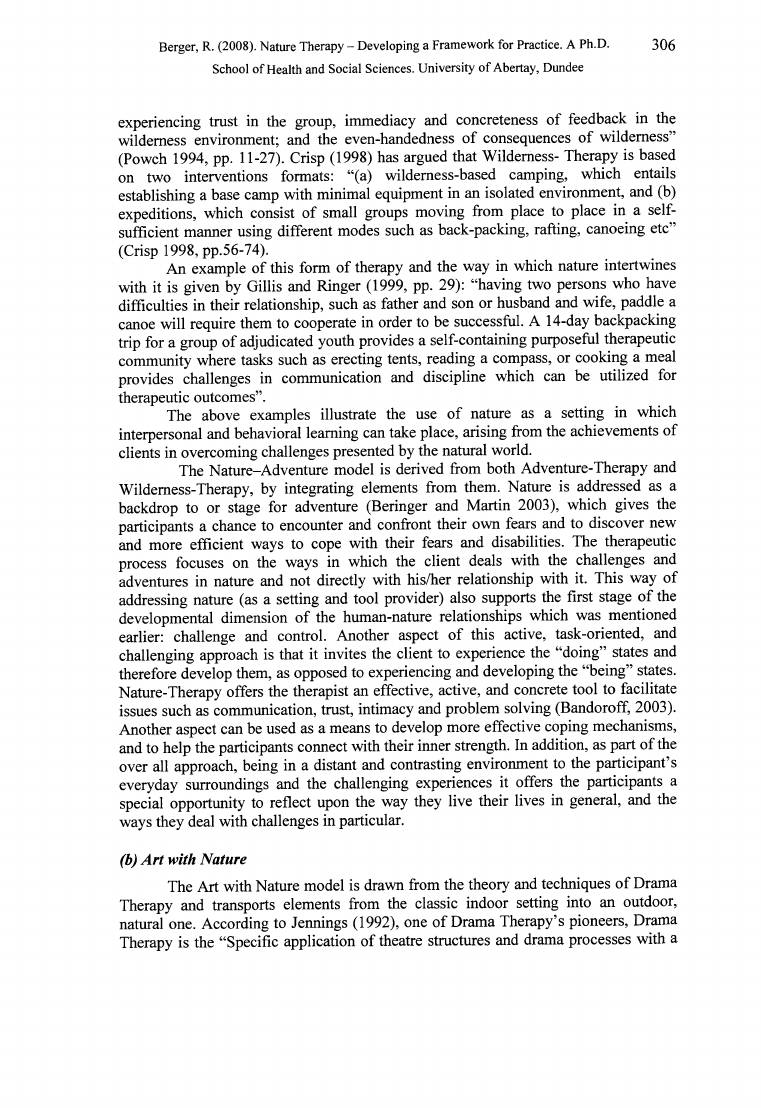
Berger, R. (2008). Nature Therapy - Developing a Framework for Practice. A Ph.D.
306
School of Health and Social Sciences. University of Abertay, Dundee
experiencing trust in the group, immediacy and concreteness of feedback in the
wilderness environment; and the even-handedness of consequences of wilderness”
(Powch 1994, pp. 11-27). Crisp (1998) has argued that Wilderness- Therapy is based
on two interventions formats: “(a) wilderness-based camping, which entails
establishing a base camp with minimal equipment in an isolated environment, and (b)
expeditions, which consist of small groups moving from place to place in a self-
sufficient manner using different modes such as back-packing, rafting, canoeing etc”
(Crisp 1998, pp.56-74).
An example of this form of therapy and the way in which nature intertwines
with it is given by Gillis and Ringer (1999, pp. 29): “having two persons who have
difficulties in their relationship, such as father and son or husband and wife, paddle a
canoe will require them to cooperate in order to be successful. A 14-day backpacking
trip for a group of adjudicated youth provides a self-containing purposeful therapeutic
community where tasks such as erecting tents, reading a compass, or cooking a meal
provides challenges in communication and discipline which can be utilized for
therapeutic outcomes”.
The above examples illustrate the use of nature as a setting in which
interpersonal and behavioral learning can take place, arising from the achievements of
clients in overcoming challenges presented by the natural world.
The Nature-Adventure model is derived from both Adventure-Therapy and
Wilderness-Therapy, by integrating elements from them. Nature is addressed as a
backdrop to or stage for adventure (Beringer and Martin 2003), which gives the
participants a chance to encounter and confront their own fears and to discover new
and more efficient ways to cope with their fears and disabilities. The therapeutic
process focuses on the ways in which the client deals with the challenges and
adventures in nature and not directly with his/her relationship with it. This way of
addressing nature (as a setting and tool provider) also supports the first stage of the
developmental dimension of the human-nature relationships which was mentioned
earlier: challenge and control. Another aspect of this active, task-oriented, and
challenging approach is that it invites the client to experience the “doing” states and
therefore develop them, as opposed to experiencing and developing the “being” states.
Nature-Therapy offers the therapist an effective, active, and concrete tool to facilitate
issues such as communication, trust, intimacy and problem solving (Bandoroff, 2003).
Another aspect can be used as a means to develop more effective coping mechanisms,
and to help the participants connect with their inner strength. In addition, as part of the
over all approach, being in a distant and contrasting environment to the participant’s
everyday surroundings and the challenging experiences it offers the participants a
special opportunity to reflect upon the way they live their lives in general, and the
ways they deal with challenges in particular.
(b) A rt with Nature
The Art with Nature model is drawn from the theory and techniques of Drama
Therapy and transports elements from the classic indoor setting into an outdoor,
natural one. According to Jennings (1992), one of Drama Therapy’s pioneers, Drama
Therapy is the “Specific application of theatre structures and drama processes with a
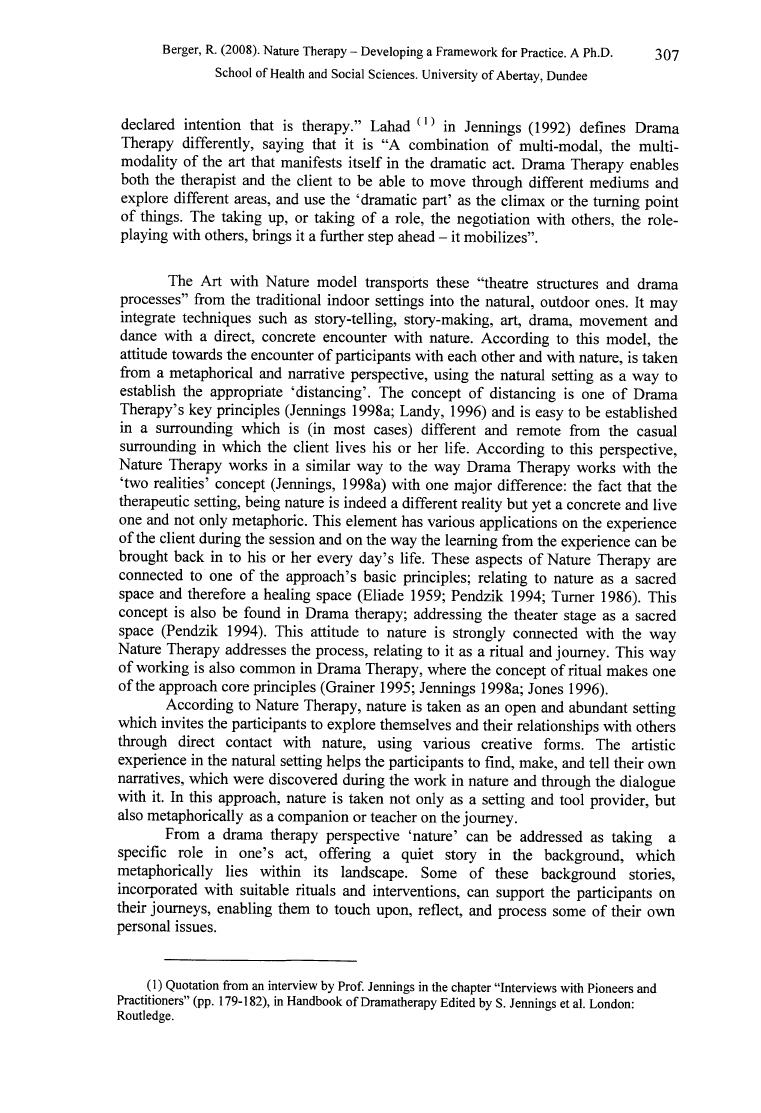
Berger, R. (2008). Nature Therapy - Developing a Framework for Practice. A Ph.D.
307
School of Health and Social Sciences. University of Abertay, Dundee
declared intention that is therapy.” Lahad (1) in Jennings (1992) defines Drama
Therapy differently, saying that it is “A combination of multi-modal, the multi
modality of the art that manifests itself in the dramatic act. Drama Therapy enables
both the therapist and the client to be able to move through different mediums and
explore different areas, and use the ‘dramatic part’ as the climax or the turning point
of things. The taking up, or taking of a role, the negotiation with others, the role-
playing with others, brings it a further step ahead - it mobilizes”.
The Art with Nature model transports these “theatre structures and drama
processes” from the traditional indoor settings into the natural, outdoor ones. It may
integrate techniques such as story-telling, story-making, art, drama, movement and
dance with a direct, concrete encounter with nature. According to this model, the
attitude towards the encounter of participants with each other and with nature, is taken
from a metaphorical and narrative perspective, using the natural setting as a way to
establish the appropriate ‘distancing’. The concept of distancing is one of Drama
Therapy’s key principles (Jennings 1998a; Landy, 1996) and is easy to be established
in a surrounding which is (in most cases) different and remote from the casual
surrounding in which the client lives his or her life. According to this perspective,
Nature Therapy works in a similar way to the way Drama Therapy works with the
‘two realities’ concept (Jennings, 1998a) with one major difference: the fact that the
therapeutic setting, being nature is indeed a different reality but yet a concrete and live
one and not only metaphoric. This element has various applications on the experience
of the client during the session and on the way the learning from the experience can be
brought back in to his or her every day’s life. These aspects of Nature Therapy are
connected to one of the approach’s basic principles; relating to nature as a sacred
space and therefore a healing space (Eliade 1959; Pendzik 1994; Turner 1986). This
concept is also be found in Drama therapy; addressing the theater stage as a sacred
space (Pendzik 1994). This attitude to nature is strongly connected with the way
Nature Therapy addresses the process, relating to it as a ritual and journey. This way
of working is also common in Drama Therapy, where the concept of ritual makes one
of the approach core principles (Grainer 1995; Jennings 1998a; Jones 1996).
According to Nature Therapy, nature is taken as an open and abundant setting
which invites the participants to explore themselves and their relationships with others
through direct contact with nature, using various creative forms. The artistic
experience in the natural setting helps the participants to find, make, and tell their own
narratives, which were discovered during the work in nature and through the dialogue
with it. In this approach, nature is taken not only as a setting and tool provider, but
also metaphorically as a companion or teacher on the journey.
From a drama therapy perspective ‘nature’ can be addressed as taking a
specific role in one’s act, offering a quiet story in the background, which
metaphorically lies within its landscape. Some of these background stories,
incorporated with suitable rituals and interventions, can support the participants on
their journeys, enabling them to touch upon, reflect, and process some of their own
personal issues.
(1)
Quotation from an interview by Prof. Jennings in the chapter “Interviews with Pioneers and
Practitioners” (pp. 179-182), in Handbook o f Dramatherapy Edited by S. Jennings et al. London:
Routledge.
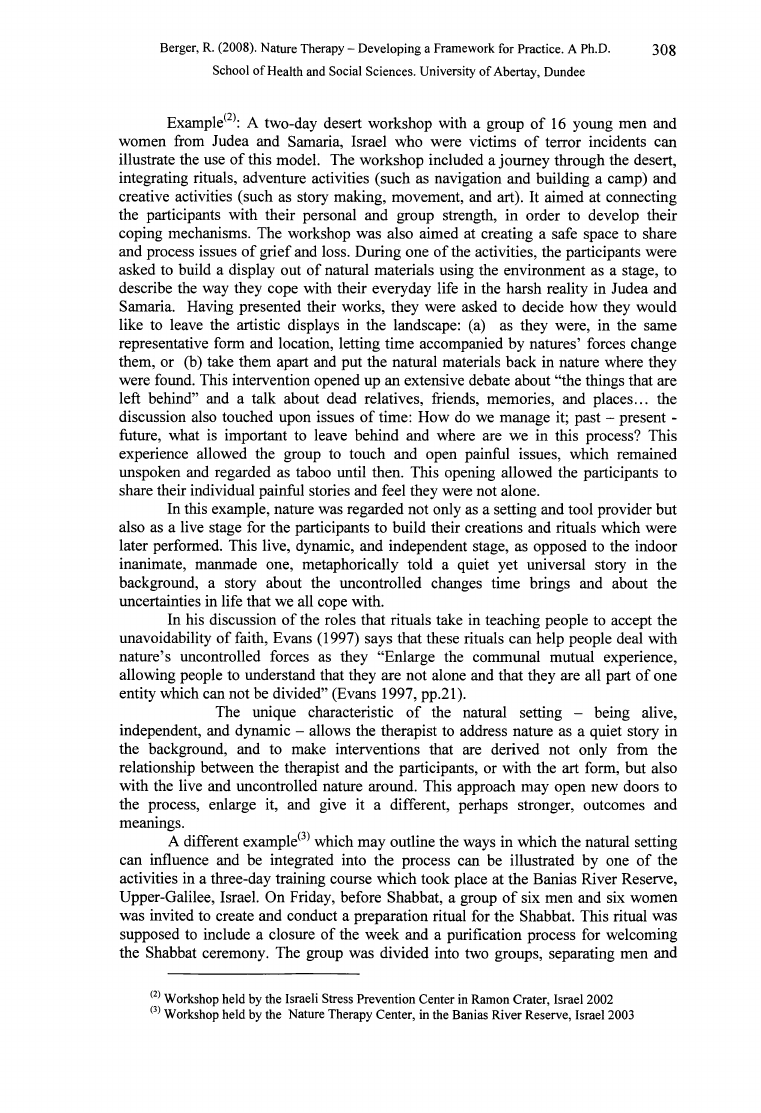
Berger, R. (2008). Nature Therapy - Developing a Framework for Practice. A Ph.D.
308
School of Health and Social Sciences. University of Abertay, Dundee
Example(2): A two-day desert workshop with a group of 16 young men and
women from Judea and Samaria, Israel who were victims of terror incidents can
illustrate the use of this model. The workshop included a journey through the desert,
integrating rituals, adventure activities (such as navigation and building a camp) and
creative activities (such as story making, movement, and art). It aimed at connecting
the participants with their personal and group strength, in order to develop their
coping mechanisms. The workshop was also aimed at creating a safe space to share
and process issues of grief and loss. During one of the activities, the participants were
asked to build a display out of natural materials using the environment as a stage, to
describe the way they cope with their everyday life in the harsh reality in Judea and
Samaria. Having presented their works, they were asked to decide how they would
like to leave the artistic displays in the landscape: (a) as they were, in the same
representative form and location, letting time accompanied by natures’ forces change
them, or (b) take them apart and put the natural materials back in nature where they
were found. This intervention opened up an extensive debate about “the things that are
left behind” and a talk about dead relatives, friends, memories, and places... the
discussion also touched upon issues of time: How do we manage it; past - present -
future, what is important to leave behind and where are we in this process? This
experience allowed the group to touch and open painful issues, which remained
unspoken and regarded as taboo until then. This opening allowed the participants to
share their individual painful stories and feel they were not alone.
In this example, nature was regarded not only as a setting and tool provider but
also as a live stage for the participants to build their creations and rituals which were
later performed. This live, dynamic, and independent stage, as opposed to the indoor
inanimate, manmade one, metaphorically told a quiet yet universal story in the
background, a story about the uncontrolled changes time brings and about the
uncertainties in life that we all cope with.
In his discussion of the roles that rituals take in teaching people to accept the
unavoidability of faith, Evans (1997) says that these rituals can help people deal with
nature’s uncontrolled forces as they “Enlarge the communal mutual experience,
allowing people to understand that they are not alone and that they are all part of one
entity which can not be divided” (Evans 1997, pp.21).
The unique characteristic of the natural setting - being alive,
independent, and dynamic - allows the therapist to address nature as a quiet story in
the background, and to make interventions that are derived not only from the
relationship between the therapist and the participants, or with the art form, but also
with the live and uncontrolled nature around. This approach may open new doors to
the process, enlarge it, and give it a different, perhaps stronger, outcomes and
meanings.
A different example(3) which may outline the ways in which the natural setting
can influence and be integrated into the process can be illustrated by one of the
activities in a three-day training course which took place at the Banias River Reserve,
Upper-Galilee, Israel. On Friday, before Shabbat, a group of six men and six women
was invited to create and conduct a preparation ritual for the Shabbat. This ritual was
supposed to include a closure of the week and a purification process for welcoming
the Shabbat ceremony. The group was divided into two groups, separating men and
(2) Workshop held by the Israeli Stress Prevention Center in Ramon Crater, Israel 2002
(3) Workshop held by the Nature Therapy Center, in the Banias River Reserve, Israel 2003
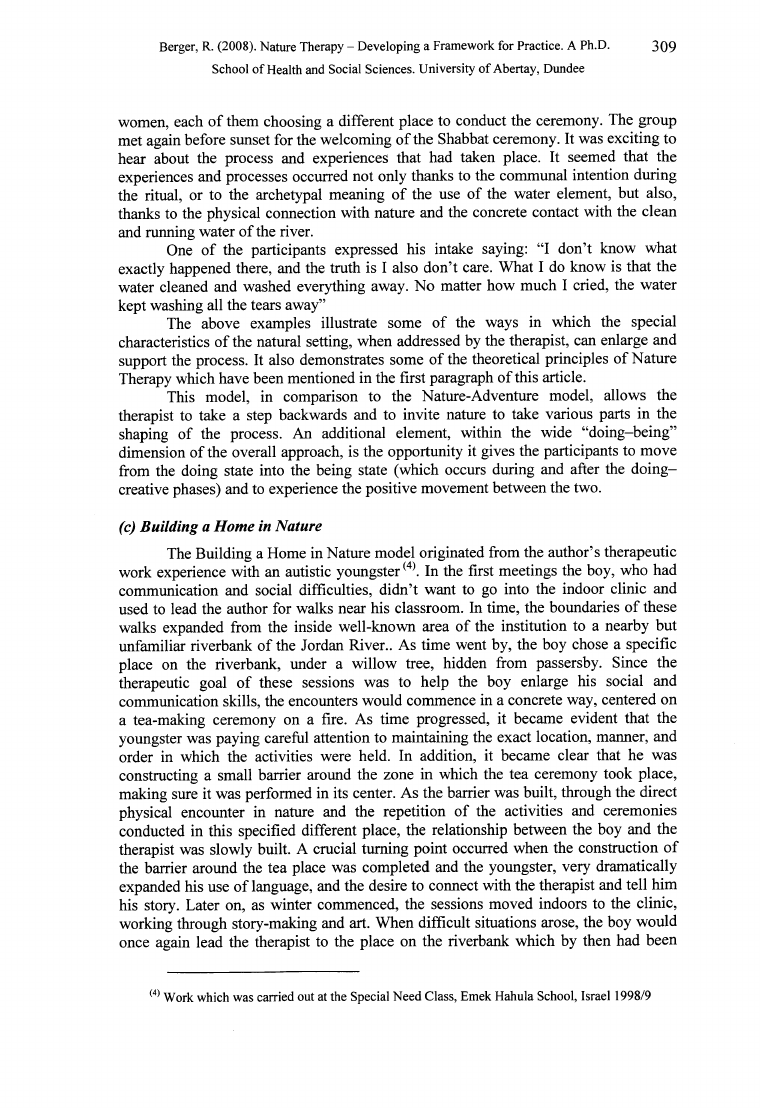
Berger, R. (2008). Nature Therapy - Developing a Framework for Practice. A Ph.D.
309
School of Health and Social Sciences. University of Abertay, Dundee
women, each of them choosing a different place to conduct the ceremony. The group
met again before sunset for the welcoming of the Shabbat ceremony. It was exciting to
hear about the process and experiences that had taken place. It seemed that the
experiences and processes occurred not only thanks to the communal intention during
the ritual, or to the archetypal meaning of the use of the water element, but also,
thanks to the physical connection with nature and the concrete contact with the clean
and running water of the river.
One of the participants expressed his intake saying: “I don’t know what
exactly happened there, and the truth is I also don’t care. What I do know is that the
water cleaned and washed everything away. No matter how much I cried, the water
kept washing all the tears away”
The above examples illustrate some of the ways in which the special
characteristics of the natural setting, when addressed by the therapist, can enlarge and
support the process. It also demonstrates some of the theoretical principles of Nature
Therapy which have been mentioned in the first paragraph of this article.
This model, in comparison to the Nature-Adventure model, allows the
therapist to take a step backwards and to invite nature to take various parts in the
shaping of the process. An additional element, within the wide “doing-being”
dimension of the overall approach, is the opportunity it gives the participants to move
from the doing state into the being state (which occurs during and after the doing-
creative phases) and to experience the positive movement between the two.
(c) Building a Home in Nature
The Building a Home in Nature model originated from the author’s therapeutic
work experience with an autistic youngster(4). In the first meetings the boy, who had
communication and social difficulties, didn’t want to go into the indoor clinic and
used to lead the author for walks near his classroom. In time, the boundaries of these
walks expanded from the inside well-known area of the institution to a nearby but
unfamiliar riverbank of the Jordan River.. As time went by, the boy chose a specific
place on the riverbank, under a willow tree, hidden from passersby. Since the
therapeutic goal of these sessions was to help the boy enlarge his social and
communication skills, the encounters would commence in a concrete way, centered on
a tea-making ceremony on a fire. As time progressed, it became evident that the
youngster was paying careful attention to maintaining the exact location, manner, and
order in which the activities were held. In addition, it became clear that he was
constructing a small barrier around the zone in which the tea ceremony took place,
making sure it was performed in its center. As the barrier was built, through the direct
physical encounter in nature and the repetition of the activities and ceremonies
conducted in this specified different place, the relationship between the boy and the
therapist was slowly built. A crucial turning point occurred when the construction of
the barrier around the tea place was completed and the youngster, very dramatically
expanded his use of language, and the desire to connect with the therapist and tell him
his story. Later on, as winter commenced, the sessions moved indoors to the clinic,
working through story-making and art. When difficult situations arose, the boy would
once again lead the therapist to the place on the riverbank which by then had been
(4) Work which was carried out at the Special Need Class, Emek Hahula School, Israel 1998/9
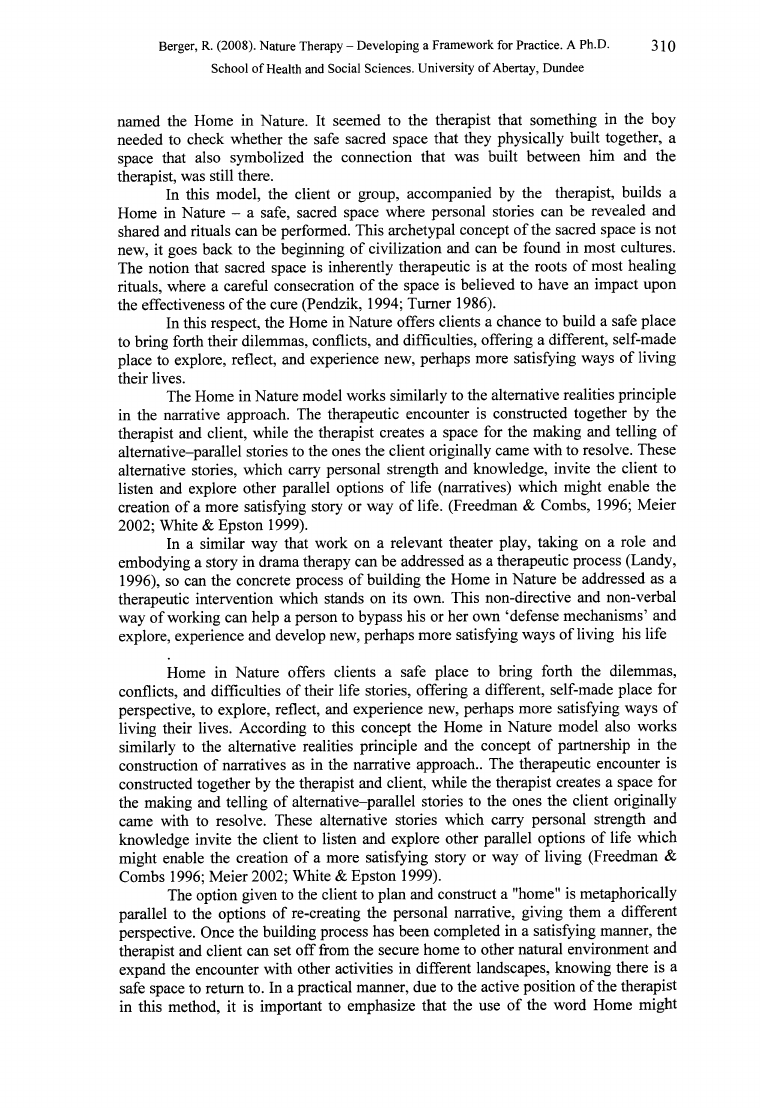
Berger, R. (2008). Nature Therapy - Developing a Framework for Practice. A Ph.D.
310
School of Health and Social Sciences. University of Abertay, Dundee
named the Home in Nature. It seemed to the therapist that something in the boy
needed to check whether the safe sacred space that they physically built together, a
space that also symbolized the connection that was built between him and the
therapist, was still there.
In this model, the client or group, accompanied by the therapist, builds a
Home in Nature - a safe, sacred space where personal stories can be revealed and
shared and rituals can be performed. This archetypal concept of the sacred space is not
new, it goes back to the beginning of civilization and can be found in most cultures.
The notion that sacred space is inherently therapeutic is at the roots of most healing
rituals, where a careful consecration of the space is believed to have an impact upon
the effectiveness of the cure (Pendzik, 1994; Turner 1986).
In this respect, the Home in Nature offers clients a chance to build a safe place
to bring forth their dilemmas, conflicts, and difficulties, offering a different, self-made
place to explore, reflect, and experience new, perhaps more satisfying ways of living
their lives.
The Home in Nature model works similarly to the alternative realities principle
in the narrative approach. The therapeutic encounter is constructed together by the
therapist and client, while the therapist creates a space for the making and telling of
alternative-parallel stories to the ones the client originally came with to resolve. These
alternative stories, which carry personal strength and knowledge, invite the client to
listen and explore other parallel options of life (narratives) which might enable the
creation of a more satisfying story or way of life. (Freedman & Combs, 1996; Meier
2002; White & Epston 1999).
In a similar way that work on a relevant theater play, taking on a role and
embodying a story in drama therapy can be addressed as a therapeutic process (Landy,
1996), so can the concrete process of building the Home in Nature be addressed as a
therapeutic intervention which stands on its own. This non-directive and non-verbal
way of working can help a person to bypass his or her own ‘defense mechanisms’ and
explore, experience and develop new, perhaps more satisfying ways of living his life
Home in Nature offers clients a safe place to bring forth the dilemmas,
conflicts, and difficulties of their life stories, offering a different, self-made place for
perspective, to explore, reflect, and experience new, perhaps more satisfying ways of
living their lives. According to this concept the Home in Nature model also works
similarly to the alternative realities principle and the concept of partnership in the
construction of narratives as in the narrative approach.. The therapeutic encounter is
constructed together by the therapist and client, while the therapist creates a space for
the making and telling of alternative-parallel stories to the ones the client originally
came with to resolve. These alternative stories which carry personal strength and
knowledge invite the client to listen and explore other parallel options of life which
might enable the creation of a more satisfying story or way of living (Freedman &
Combs 1996; Meier 2002; White & Epston 1999).
The option given to the client to plan and construct a "home" is metaphorically
parallel to the options of re-creating the personal narrative, giving them a different
perspective. Once the building process has been completed in a satisfying manner, the
therapist and client can set off from the secure home to other natural environment and
expand the encounter with other activities in different landscapes, knowing there is a
safe space to return to. In a practical manner, due to the active position of the therapist
in this method, it is important to emphasize that the use of the word Home might
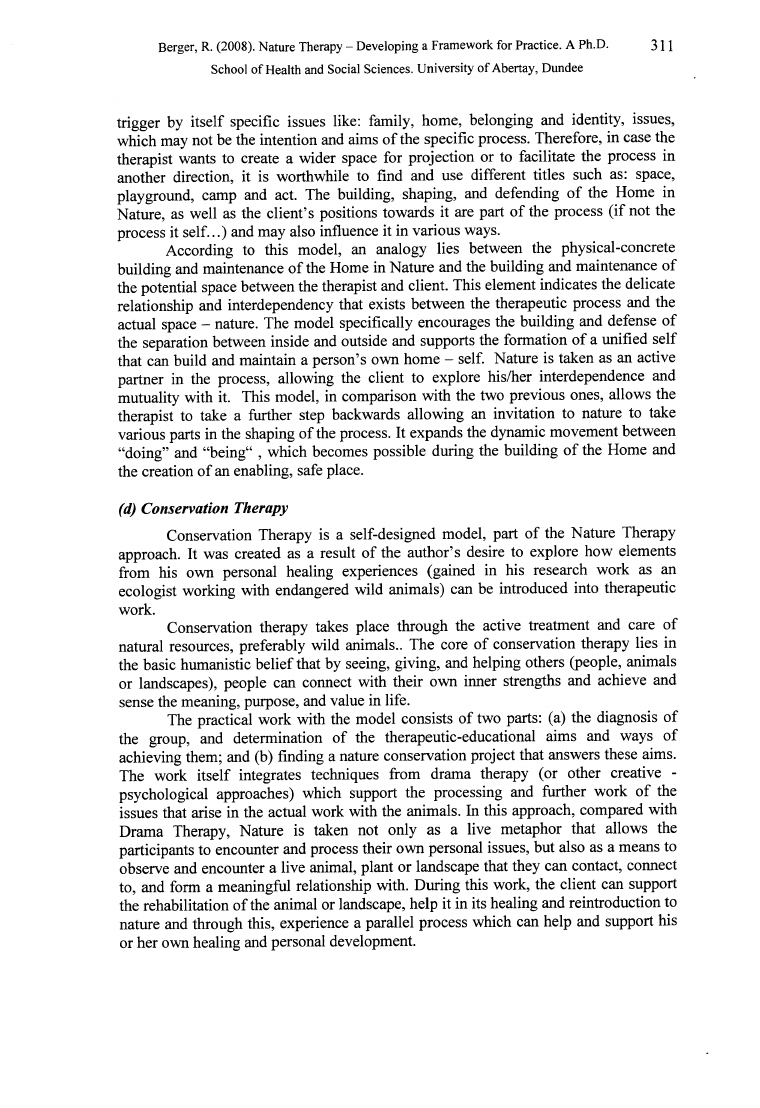
Berger, R. (2008). Nature Therapy - Developing a Framework for Practice. A Ph.D.
311
School of Health and Social Sciences. University of Abertay, Dundee
trigger by itself specific issues like: family, home, belonging and identity, issues,
which may not be the intention and aims of the specific process. Therefore, in case the
therapist wants to create a wider space for projection or to facilitate the process in
another direction, it is worthwhile to find and use different titles such as: space,
playground, camp and act. The building, shaping, and defending of the Home in
Nature, as well as the client’s positions towards it are part of the process (if not the
process it self...) and may also influence it in various ways.
According to this model, an analogy lies between the physical-concrete
building and maintenance of the Home in Nature and the building and maintenance of
the potential space between the therapist and client. This element indicates the delicate
relationship and interdependency that exists between the therapeutic process and the
actual space - nature. The model specifically encourages the building and defense of
the separation between inside and outside and supports the formation of a unified self
that can build and maintain a person’s own home - self. Nature is taken as an active
partner in the process, allowing the client to explore his/her interdependence and
mutuality with it. This model, in comparison with the two previous ones, allows the
therapist to take a further step backwards allowing an invitation to nature to take
various parts in the shaping of the process. It expands the dynamic movement between
“doing” and “being“ , which becomes possible during the building of the Home and
the creation of an enabling, safe place.
(d) Conservation Therapy
Conservation Therapy is a self-designed model, part of the Nature Therapy
approach. It was created as a result of the author’s desire to explore how elements
from his own personal healing experiences (gained in his research work as an
ecologist working with endangered wild animals) can be introduced into therapeutic
work.
Conservation therapy takes place through the active treatment and care of
natural resources, preferably wild animals.. The core of conservation therapy lies in
the basic humanistic belief that by seeing, giving, and helping others (people, animals
or landscapes), people can connect with their own inner strengths and achieve and
sense the meaning, purpose, and value in life.
The practical work with the model consists of two parts: (a) the diagnosis of
the group, and determination of the therapeutic-educational aims and ways of
achieving them; and (b) finding a nature conservation project that answers these aims.
The work itself integrates techniques from drama therapy (or other creative -
psychological approaches) which support the processing and further work of the
issues that arise in the actual work with the animals. In this approach, compared with
Drama Therapy, Nature is taken not only as a live metaphor that allows the
participants to encounter and process their own personal issues, but also as a means to
observe and encounter a live animal, plant or landscape that they can contact, connect
to, and form a meaningful relationship with. During this work, the client can support
the rehabilitation of the animal or landscape, help it in its healing and reintroduction to
nature and through this, experience a parallel process which can help and support his
or her own healing and personal development.
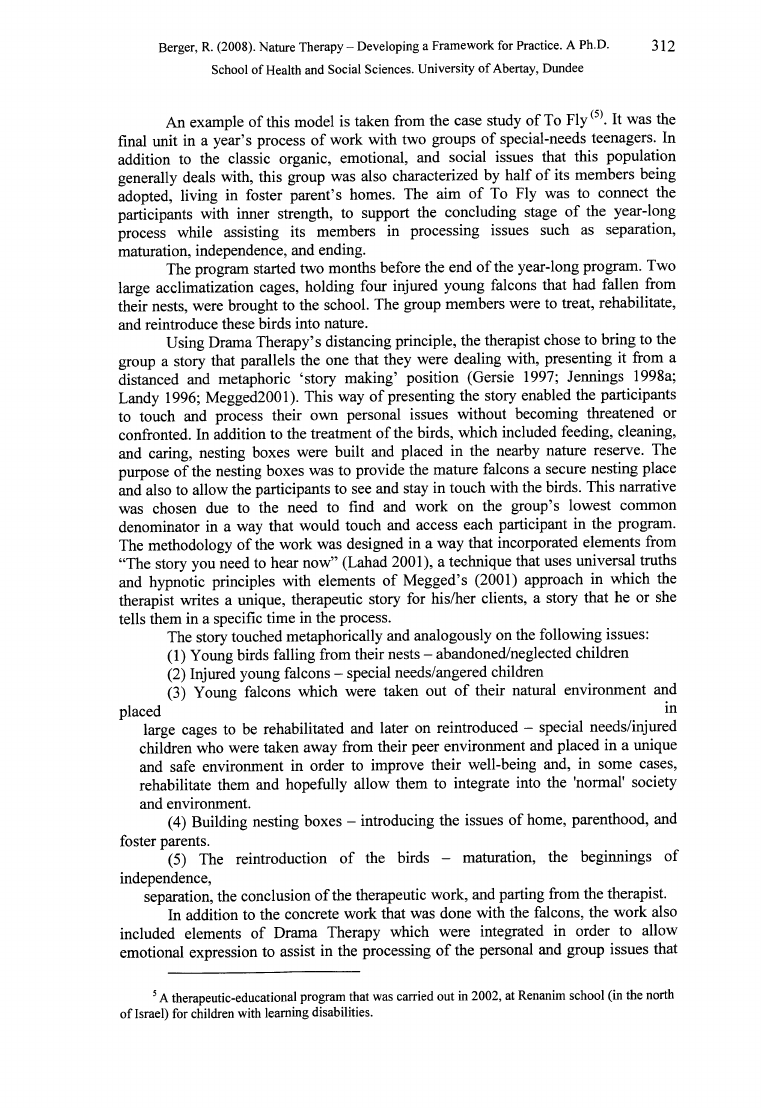
Berger, R. (2008). Nature Therapy - Developing a Framework for Practice. A Ph.D.
312
School of Health and Social Sciences. University of Abertay, Dundee
An example of this model is taken from the case study of To Fly ^5). It was the
final unit in a year’s process of work with two groups of special-needs teenagers. In
addition to the classic organic, emotional, and social issues that this population
generally deals with, this group was also characterized by half of its members being
adopted, living in foster parent’s homes. The aim of To Fly was to connect the
participants with inner strength, to support the concluding stage of the year-long
process while assisting its members in processing issues such as separation,
maturation, independence, and ending.
The program started two months before the end of the year-long program. Two
large acclimatization cages, holding four injured young falcons that had fallen from
their nests, were brought to the school. The group members were to treat, rehabilitate,
and reintroduce these birds into nature.
Using Drama Therapy’s distancing principle, the therapist chose to bring to the
group a story that parallels the one that they were dealing with, presenting it from a
distanced and metaphoric ‘story making’ position (Gersie 1997; Jennings 1998a;
Landy 1996; Megged2001). This way of presenting the story enabled the participants
to touch and process their own personal issues without becoming threatened or
confronted. In addition to the treatment of the birds, which included feeding, cleaning,
and caring, nesting boxes were built and placed in the nearby nature reserve. The
purpose of the nesting boxes was to provide the mature falcons a secure nesting place
and also to allow the participants to see and stay in touch with the birds. This narrative
was chosen due to the need to find and work on the group’s lowest common
denominator in a way that would touch and access each participant in the program.
The methodology of the work was designed in a way that incorporated elements from
“The story you need to hear now” (Lahad 2001), a technique that uses universal truths
and hypnotic principles with elements of Megged’s (2001) approach in which the
therapist writes a unique, therapeutic story for his/her clients, a story that he or she
tells them in a specific time in the process.
The story touched metaphorically and analogously on the following issues:
(1) Young birds falling from their nests - abandoned/neglected children
(2) Injured young falcons - special needs/angered children
(3) Young falcons which were taken out of their natural environment and
placed
in
large cages to be rehabilitated and later on reintroduced - special needs/injured
children who were taken away from their peer environment and placed in a unique
and safe environment in order to improve their well-being and, in some cases,
rehabilitate them and hopefully allow them to integrate into the 'normal' society
and environment.
(4) Building nesting boxes - introducing the issues of home, parenthood, and
foster parents.
(5) The reintroduction of the birds - maturation, the beginnings of
independence,
separation, the conclusion of the therapeutic work, and parting from the therapist.
In addition to the concrete work that was done with the falcons, the work also
included elements of Drama Therapy which were integrated in order to allow
emotional expression to assist in the processing of the personal and group issues that
5
A therapeutic-educational program that was carried out in 2002, at Renanim school (in the north
o f Israel) for children with learning disabilities.
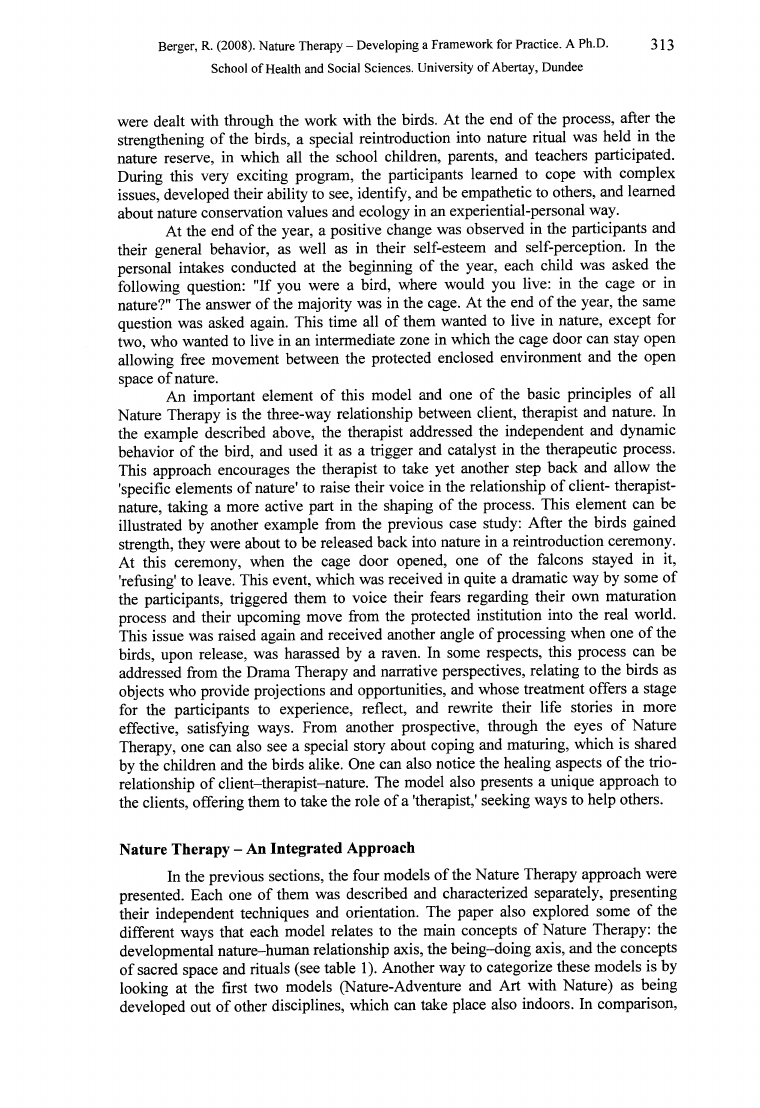
Berger, R. (2008). Nature Therapy - Developing a Framework for Practice. A Ph.D.
313
School of Health and Social Sciences. University of Abertay, Dundee
were dealt with through the work with the birds. At the end of the process, after the
strengthening of the birds, a special reintroduction into nature ritual was held in the
nature reserve, in which all the school children, parents, and teachers participated.
During this very exciting program, the participants learned to cope with complex
issues, developed their ability to see, identify, and be empathetic to others, and learned
about nature conservation values and ecology in an experiential-personal way.
At the end of the year, a positive change was observed in the participants and
their general behavior, as well as in their self-esteem and self-perception. In the
personal intakes conducted at the beginning of the year, each child was asked the
following question: "If you were a bird, where would you live: in the cage or in
nature?" The answer of the majority was in the cage. At the end of the year, the same
question was asked again. This time all of them wanted to live in nature, except for
two, who wanted to live in an intermediate zone in which the cage door can stay open
allowing free movement between the protected enclosed environment and the open
space of nature.
An important element of this model and one of the basic principles of all
Nature Therapy is the three-way relationship between client, therapist and nature. In
the example described above, the therapist addressed the independent and dynamic
behavior of the bird, and used it as a trigger and catalyst in the therapeutic process.
This approach encourages the therapist to take yet another step back and allow the
'specific elements of nature' to raise their voice in the relationship of client- therapist-
nature, taking a more active part in the shaping of the process. This element can be
illustrated by another example from the previous case study: After the birds gained
strength, they were about to be released back into nature in a reintroduction ceremony.
At this ceremony, when the cage door opened, one of the falcons stayed in it,
'refusing' to leave. This event, which was received in quite a dramatic way by some of
the participants, triggered them to voice their fears regarding their own maturation
process and their upcoming move from the protected institution into the real world.
This issue was raised again and received another angle of processing when one of the
birds, upon release, was harassed by a raven. In some respects, this process can be
addressed from the Drama Therapy and narrative perspectives, relating to the birds as
objects who provide projections and opportunities, and whose treatment offers a stage
for the participants to experience, reflect, and rewrite their life stories in more
effective, satisfying ways. From another prospective, through the eyes of Nature
Therapy, one can also see a special story about coping and maturing, which is shared
by the children and the birds alike. One can also notice the healing aspects of the trio-
relationship of client-therapist-nature. The model also presents a unique approach to
the clients, offering them to take the role of a 'therapist,' seeking ways to help others.
Nature Therapy - An Integrated Approach
In the previous sections, the four models of the Nature Therapy approach were
presented. Each one of them was described and characterized separately, presenting
their independent techniques and orientation. The paper also explored some of the
different ways that each model relates to the main concepts of Nature Therapy: the
developmental nature-human relationship axis, the being-doing axis, and the concepts
of sacred space and rituals (see table 1). Another way to categorize these models is by
looking at the first two models (Nature-Adventure and Art with Nature) as being
developed out of other disciplines, which can take place also indoors. In comparison,
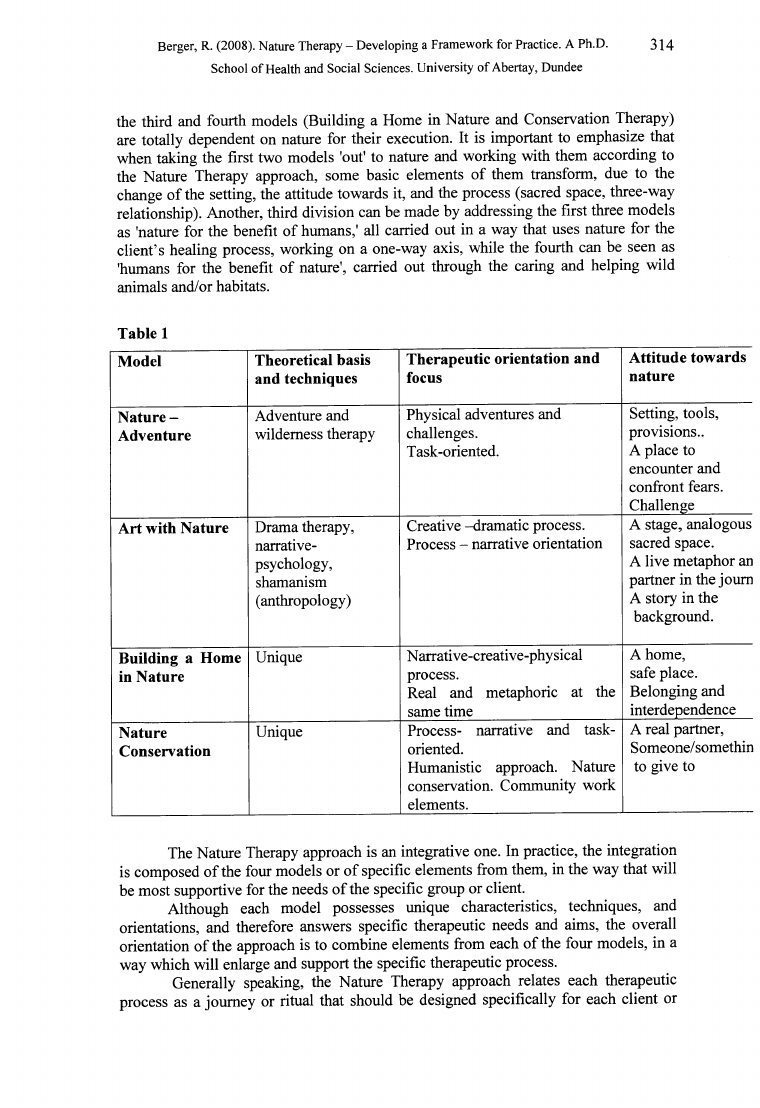
Berger, R. (2008). Nature Therapy - Developing a Framework for Practice. A Ph.D.
314
School of Health and Social Sciences. University of Abertay, Dundee
the third and fourth models (Building a Home in Nature and Conservation Therapy)
are totally dependent on nature for their execution. It is important to emphasize that
when taking the first two models 'out' to nature and working with them according to
the Nature Therapy approach, some basic elements of them transform, due to the
change of the setting, the attitude towards it, and the process (sacred space, three-way
relationship). Another, third division can be made by addressing the first three models
as 'nature for the benefit of humans,' all carried out in a way that uses nature for the
client’s healing process, working on a one-way axis, while the fourth can be seen as
'humans for the benefit of nature', carried out through the caring and helping wild
animals and/or habitats.
Table 1
Model
Nature -
Adventure
Theoretical basis
and techniques
Adventure and
wilderness therapy
Art with Nature
Drama therapy,
narrative-
psychology,
shamanism
(anthropology)
Building a Hom e Unique
in Nature
Nature
Conservation
Unique
Therapeutic orientation and
focus
Attitude towards
nature
Physical adventures and
challenges.
Task-oriented.
Creative -dramatic process.
Process - narrative orientation
Setting, tools,
provisions..
A place to
encounter and
confront fears.
Challenge
A stage, analogous
sacred space.
A live metaphor an
partner in the joum
A story in the
background.
N arrati ve-creative-phy sical
process.
Real and metaphoric at the
same time
Process- narrative and task-
oriented.
Humanistic approach. Nature
conservation. Community work
elements.
A home,
safe place.
Belonging and
interdependence
A real partner,
Someone/somethin
to give to
The Nature Therapy approach is an integrative one. In practice, the integration
is composed of the four models or of specific elements from them, in the way that will
be most supportive for the needs of the specific group or client.
Although each model possesses unique characteristics, techniques, and
orientations, and therefore answers specific therapeutic needs and aims, the overall
orientation of the approach is to combine elements from each of the four models, in a
way which will enlarge and support the specific therapeutic process.
Generally speaking, the Nature Therapy approach relates each therapeutic
process as a journey or ritual that should be designed specifically for each client or
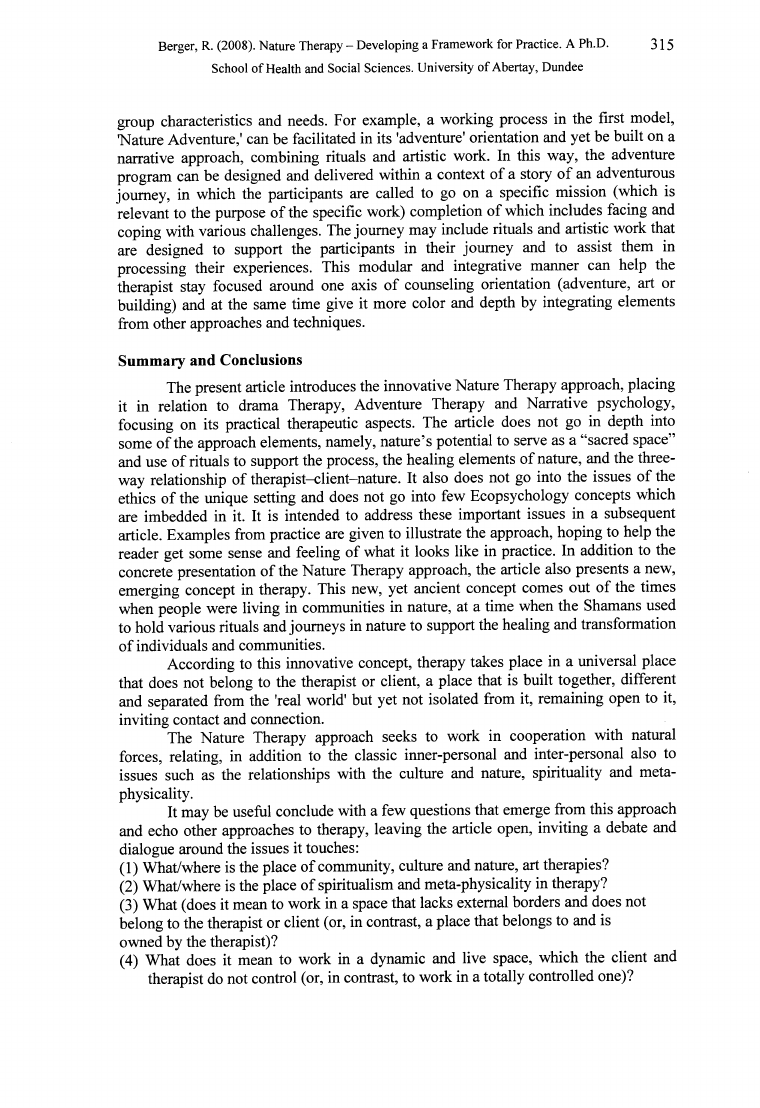
Berger, R. (2008). Nature Therapy - Developing a Framework for Practice. A Ph.D.
315
School of Health and Social Sciences. University of Abertay, Dundee
group characteristics and needs. For example, a working process in the first model,
'Nature Adventure,' can be facilitated in its 'adventure' orientation and yet be built on a
narrative approach, combining rituals and artistic work. In this way, the adventure
program can be designed and delivered within a context of a story of an adventurous
journey, in which the participants are called to go on a specific mission (which is
relevant to the purpose of the specific work) completion of which includes facing and
coping with various challenges. The journey may include rituals and artistic work that
are designed to support the participants in their journey and to assist them in
processing their experiences. This modular and integrative manner can help the
therapist stay focused around one axis of counseling orientation (adventure, art or
building) and at the same time give it more color and depth by integrating elements
from other approaches and techniques.
Summary and Conclusions
The present article introduces the innovative Nature Therapy approach, placing
it in relation to drama Therapy, Adventure Therapy and Narrative psychology,
focusing on its practical therapeutic aspects. The article does not go in depth into
some of the approach elements, namely, nature’s potential to serve as a “sacred space”
and use of rituals to support the process, the healing elements of nature, and the three-
way relationship of therapist-client-nature. It also does not go into the issues of the
ethics of the unique setting and does not go into few Ecopsychology concepts which
are imbedded in it. It is intended to address these important issues in a subsequent
article. Examples from practice are given to illustrate the approach, hoping to help the
reader get some sense and feeling of what it looks like in practice. In addition to the
concrete presentation of the Nature Therapy approach, the article also presents a new,
emerging concept in therapy. This new, yet ancient concept comes out of the times
when people were living in communities in nature, at a time when the Shamans used
to hold various rituals and journeys in nature to support the healing and transformation
of individuals and communities.
According to this innovative concept, therapy takes place in a universal place
that does not belong to the therapist or client, a place that is built together, different
and separated from the 'real world' but yet not isolated from it, remaining open to it,
inviting contact and connection.
The Nature Therapy approach seeks to work in cooperation with natural
forces, relating, in addition to the classic inner-personal and inter-personal also to
issues such as the relationships with the culture and nature, spirituality and meta
physically.
It may be useful conclude with a few questions that emerge from this approach
and echo other approaches to therapy, leaving the article open, inviting a debate and
dialogue around the issues it touches:
(1) What/where is the place of community, culture and nature, art therapies?
(2) What/where is the place of spiritualism and meta-physicality in therapy?
(3) What (does it mean to work in a space that lacks external borders and does not
belong to the therapist or client (or, in contrast, a place that belongs to and is
owned by the therapist)?
(4) What does it mean to work in a dynamic and live space, which the client and
therapist do not control (or, in contrast, to work in a totally controlled one)?
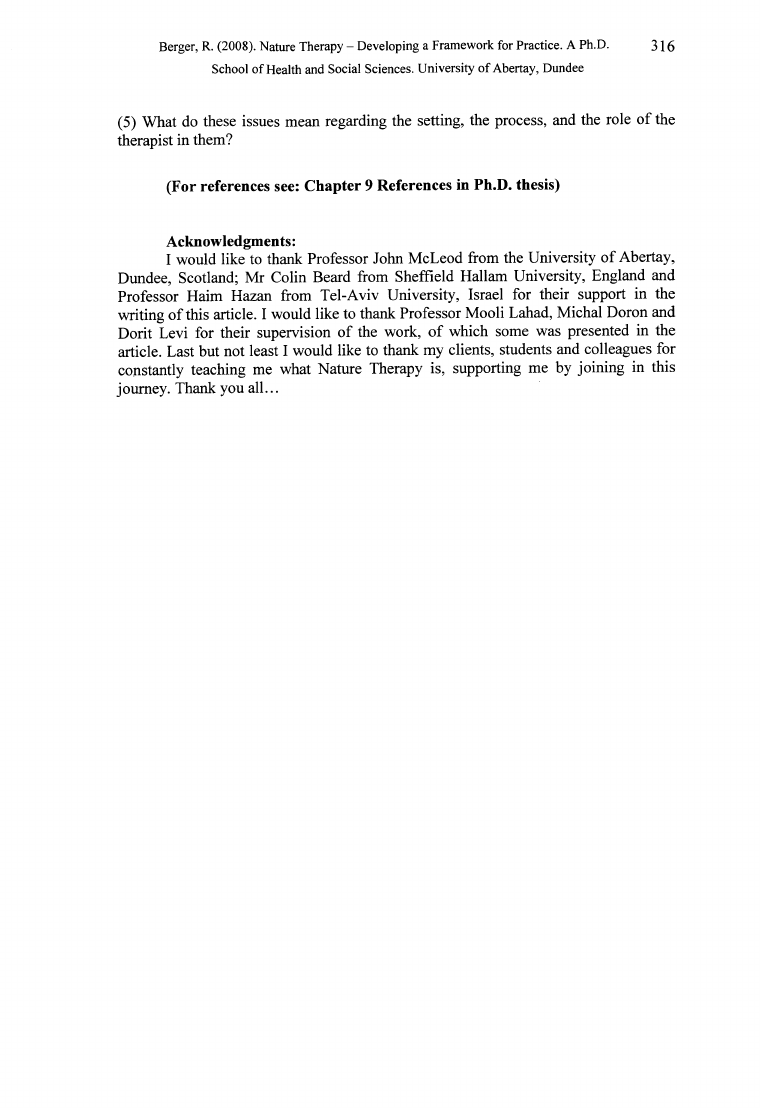
Berger, R. (2008). Nature Therapy - Developing a Framework for Practice. A Ph.D.
316
School of Health and Social Sciences. University of Abertay, Dundee
(5) What do these issues mean regarding the setting, the process, and the role of the
therapist in them?
(For references see: Chapter 9 References in Ph.D. thesis)
Acknowledgments:
I would like to thank Professor John McLeod from the University of Abertay,
Dundee, Scotland; Mr Colin Beard from Sheffield Hallam University, England and
Professor Haim Hazan from Tel-Aviv University, Israel for their support in the
writing of this article. I would like to thank Professor Mooli Lahad, Michal Doron and
Dorit Levi for their supervision of the work, of which some was presented in the
article. Last but not least I would like to thank my clients, students and colleagues for
constantly teaching me what Nature Therapy is, supporting me by joining in this
journey. Thank you all...
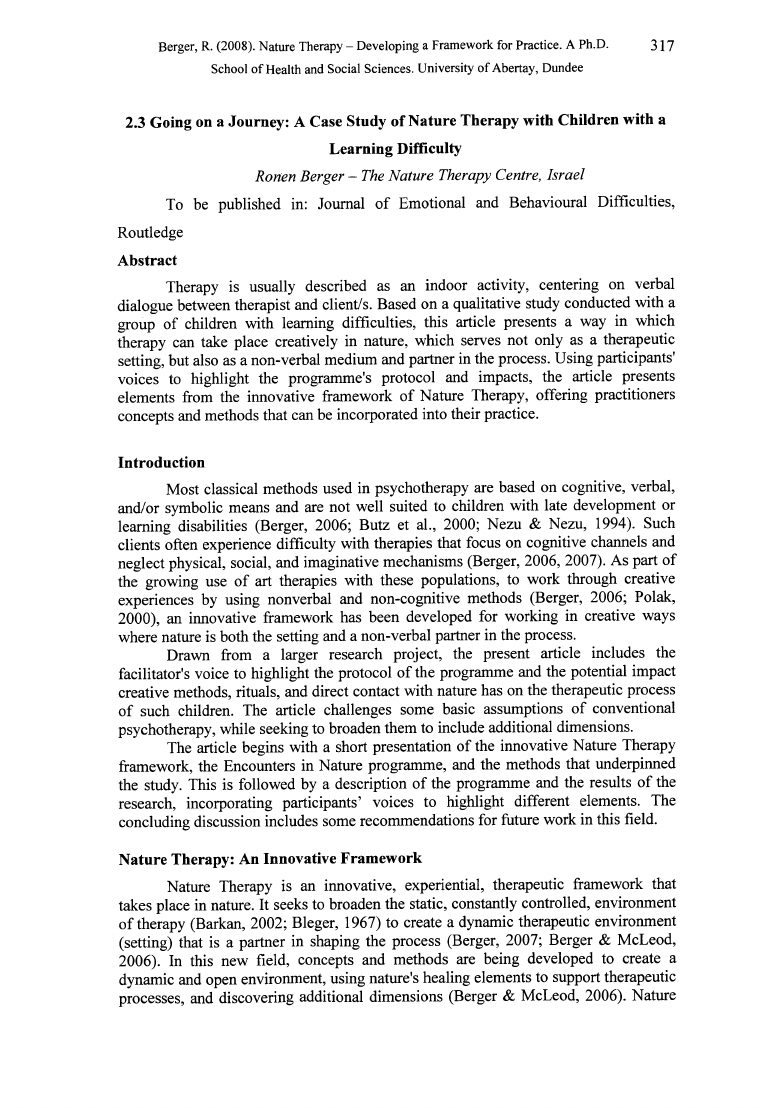
Berger, R. (2008). Nature Therapy - Developing a Framework for Practice. A Ph.D.
317
School of Health and Social Sciences. University of Abertay, Dundee
2.3 Going on a Journey: A Case Study of Nature Therapy with Children with a
Learning Difficulty
Rorien Berger - The Nature Therapy Centre, Israel
To be published in: Journal of Emotional and Behavioural Difficulties,
Routledge
Abstract
Therapy is usually described as an indoor activity, centering on verbal
dialogue between therapist and client/s. Based on a qualitative study conducted with a
group of children with learning difficulties, this article presents a way in which
therapy can take place creatively in nature, which serves not only as a therapeutic
setting, but also as a non-verbal medium and partner in the process. Using participants'
voices to highlight the programme's protocol and impacts, the article presents
elements from the innovative framework of Nature Therapy, offering practitioners
concepts and methods that can be incorporated into their practice.
Introduction
Most classical methods used in psychotherapy are based on cognitive, verbal,
and/or symbolic means and are not well suited to children with late development or
learning disabilities (Berger, 2006; Butz et al., 2000; Nezu & Nezu, 1994). Such
clients often experience difficulty with therapies that focus on cognitive channels and
neglect physical, social, and imaginative mechanisms (Berger, 2006, 2007). As part of
the growing use of art therapies with these populations, to work through creative
experiences by using nonverbal and non-cognitive methods (Berger, 2006; Polak,
2000), an innovative framework has been developed for working in creative ways
where nature is both the setting and a non-verbal partner in the process.
Drawn from a larger research project, the present article includes the
facilitator's voice to highlight the protocol of the programme and the potential impact
creative methods, rituals, and direct contact with nature has on the therapeutic process
of such children. The article challenges some basic assumptions of conventional
psychotherapy, while seeking to broaden them to include additional dimensions.
The article begins with a short presentation of the innovative Nature Therapy
framework, the Encounters in Nature programme, and the methods that underpinned
the study. This is followed by a description of the programme and the results of the
research, incorporating participants’ voices to highlight different elements. The
concluding discussion includes some recommendations for future work in this field.
Nature Therapy: An Innovative Framework
Nature Therapy is an innovative, experiential, therapeutic framework that
takes place in nature. It seeks to broaden the static, constantly controlled, environment
of therapy (Barkan, 2002; Bleger, 1967) to create a dynamic therapeutic environment
(setting) that is a partner in shaping the process (Berger, 2007; Berger & McLeod,
2006). In this new field, concepts and methods are being developed to create a
dynamic and open environment, using nature's healing elements to support therapeutic
processes, and discovering additional dimensions (Berger & McLeod, 2006). Nature
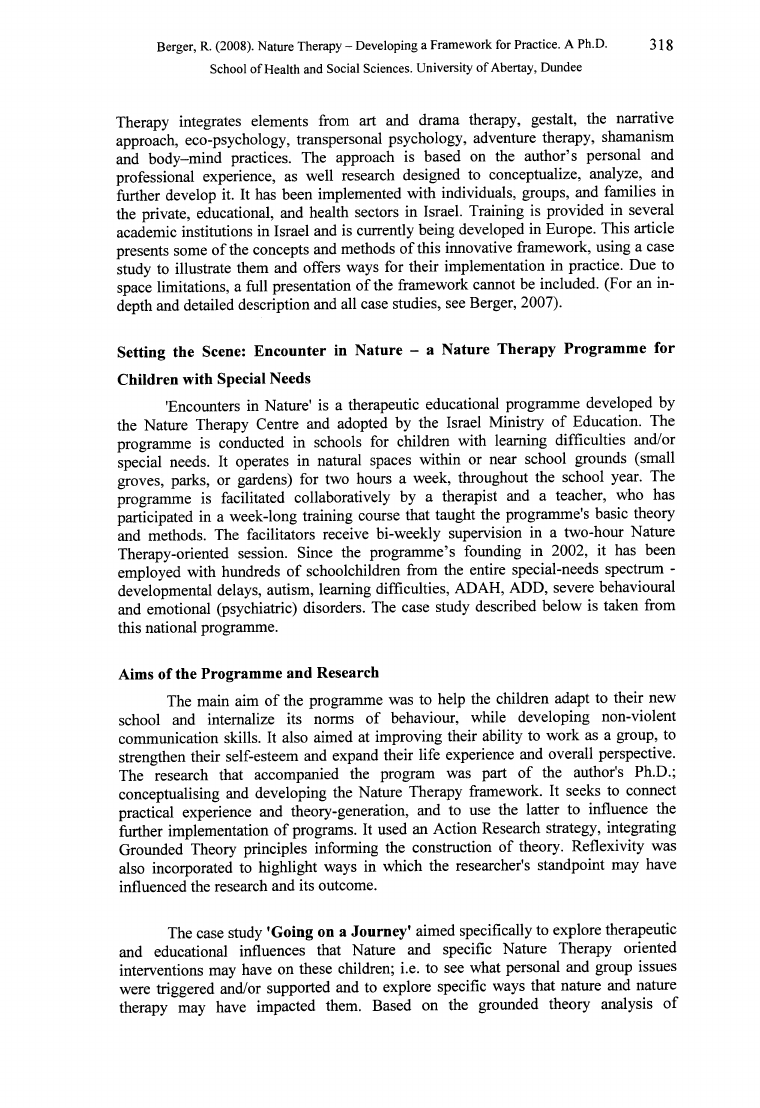
Berger, R. (2008). Nature Therapy - Developing a Framework for Practice. A Ph.D.
318
School of Health and Social Sciences. University of Abertay, Dundee
Therapy integrates elements from art and drama therapy, gestalt, the narrative
approach, eco-psychology, transpersonal psychology, adventure therapy, shamanism
and body—mind practices. The approach is based on the author’s personal and
professional experience, as well research designed to conceptualize, analyze, and
further develop it. It has been implemented with individuals, groups, and families in
the private, educational, and health sectors in Israel. Training is provided in several
academic institutions in Israel and is currently being developed in Europe. This article
presents some of the concepts and methods of this innovative framework, using a case
study to illustrate them and offers ways for their implementation in practice. Due to
space limitations, a full presentation of the framework cannot be included. (For an in-
depth and detailed description and all case studies, see Berger, 2007).
Setting the Scene: Encounter in Nature - a Nature Therapy Program m e for
Children with Special Needs
'Encounters in Nature' is a therapeutic educational programme developed by
the Nature Therapy Centre and adopted by the Israel Ministry of Education. The
programme is conducted in schools for children with learning difficulties and/or
special needs. It operates in natural spaces within or near school grounds (small
groves, parks, or gardens) for two hours a week, throughout the school year. The
programme is facilitated collaboratively by a therapist and a teacher, who has
participated in a week-long training course that taught the programme's basic theory
and methods. The facilitators receive bi-weekly supervision in a two-hour Nature
Therapy-oriented session. Since the programme’s founding in 2002, it has been
employed with hundreds of schoolchildren from the entire special-needs spectrum -
developmental delays, autism, learning difficulties, ADAH, ADD, severe behavioural
and emotional (psychiatric) disorders. The case study described below is taken from
this national programme.
Aims of the Programme and Research
The main aim of the programme was to help the children adapt to their new
school and internalize its norms of behaviour, while developing non-violent
communication skills. It also aimed at improving their ability to work as a group, to
strengthen their self-esteem and expand their life experience and overall perspective.
The research that accompanied the program was part of the author's Ph.D.;
conceptualising and developing the Nature Therapy framework. It seeks to connect
practical experience and theory-generation, and to use the latter to influence the
further implementation of programs. It used an Action Research strategy, integrating
Grounded Theory principles informing the construction of theory. Reflexivity was
also incorporated to highlight ways in which the researcher's standpoint may have
influenced the research and its outcome.
The case study ’Going on a Journey’ aimed specifically to explore therapeutic
and educational influences that Nature and specific Nature Therapy oriented
interventions may have on these children; i.e. to see what personal and group issues
were triggered and/or supported and to explore specific ways that nature and nature
therapy may have impacted them. Based on the grounded theory analysis of
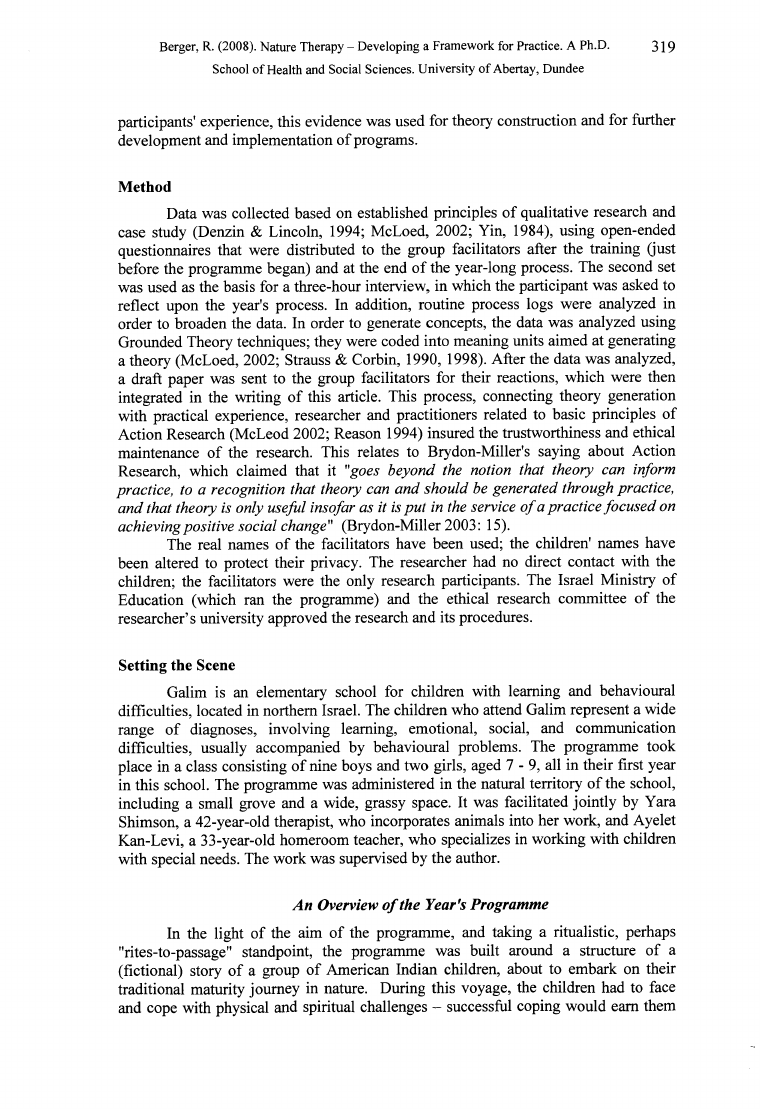
Berger, R. (2008). Nature Therapy - Developing a Framework for Practice. A Ph.D.
319
School of Health and Social Sciences. University of Abertay, Dundee
participants' experience, this evidence was used for theory construction and for further
development and implementation of programs.
M ethod
Data was collected based on established principles of qualitative research and
case study (Denzin & Lincoln, 1994; McLoed, 2002; Yin, 1984), using open-ended
questionnaires that were distributed to the group facilitators after the training (just
before the programme began) and at the end of the year-long process. The second set
was used as the basis for a three-hour interview, in which the participant was asked to
reflect upon the year's process. In addition, routine process logs were analyzed in
order to broaden the data. In order to generate concepts, the data was analyzed using
Grounded Theory techniques; they were coded into meaning units aimed at generating
a theory (McLoed, 2002; Strauss & Corbin, 1990, 1998). After the data was analyzed,
a draft paper was sent to the group facilitators for their reactions, which were then
integrated in the writing of this article. This process, connecting theory generation
with practical experience, researcher and practitioners related to basic principles of
Action Research (McLeod 2002; Reason 1994) insured the trustworthiness and ethical
maintenance of the research. This relates to Brydon-Miller's saying about Action
Research, which claimed that it "goes beyond the notion that theory can inform
practice, to a recognition that theory can and should be generated through practice,
and that theory is only useful insofar as it is put in the service o f a practice focused on
achieving positive social change" (Brydon-Miller 2003: 15).
The real names of the facilitators have been used; the children' names have
been altered to protect their privacy. The researcher had no direct contact with the
children; the facilitators were the only research participants. The Israel Ministry of
Education (which ran the programme) and the ethical research committee of the
researcher’s university approved the research and its procedures.
Setting the Scene
Galim is an elementary school for children with learning and behavioural
difficulties, located in northern Israel. The children who attend Galim represent a wide
range of diagnoses, involving learning, emotional, social, and communication
difficulties, usually accompanied by behavioural problems. The programme took
place in a class consisting of nine boys and two girls, aged 7 - 9 , all in their first year
in this school. The programme was administered in the natural territory of the school,
including a small grove and a wide, grassy space. It was facilitated jointly by Yara
Shimson, a 42-year-old therapist, who incorporates animals into her work, and Ayelet
Kan-Levi, a 33-year-old homeroom teacher, who specializes in working with children
with special needs. The work was supervised by the author.
An Overview o f the Year's Programme
In the light of the aim of the programme, and taking a ritualistic, perhaps
"rites-to-passage" standpoint, the programme was built around a structure of a
(fictional) story of a group of American Indian children, about to embark on their
traditional maturity journey in nature. During this voyage, the children had to face
and cope with physical and spiritual challenges - successful coping would earn them

Berger, R. (2008). Nature Therapy - Developing a Framework for Practice. A Ph.D.
320
School of Health and Social Sciences. University of Abertay, Dundee
the respect of the tribe and recognition of their transition from childhood to
adolescence.
This choice of theme was based on the approach of using a story as a narrative
and metaphoric framework for a therapeutic process (Berger, Doron & Berger-Glick
2006; Gersie, 1997; Lahad, 2002). In this case, the entire journey may be included,
placing the process in a larger context that not only defines and normalizes the
voyage, but also helps give it meaning. The incorporation of story-making techniques
and use of metaphors is consistent with drama therapy concepts of "distancing" and
"as if reality". It helps to convey a therapeutic-educational message in an indirect way,
without intimidating the group and building resistance (Jennings, 1998; Lahad, 2002;
Landy, 1996). Here, for instance, the narrative related the challenges the Indian
children met and not those that the participants experienced.
All sessions began inside the classroom. After the facilitators re-told the Indian
story and reminded the group of their contract, everyone was invited to go outside and
walk in a line (a custom in this school) to the nature room. The opening ceremony
took place in this room, which was reserved only for this programme. Using a talking
stick, participants shared their feelings and their expectations for the day. Then the
group was invited to leave the room and start different outdoor activities. The
structure of the opening ceremony was maintained throughout the year.
The purpose of using a ritual was to help the children cope with different
transitions within the programme and with vague and uncertain episodes during the
process. This is similar to Jennings’s (1998) use of rituals in drama therapy: "rituals
guide us through changes in a very specific way" (p. 103) and Hazan’s (1992) belief
that "the purpose of the ritual is to create order within the chaos" (p. 91). Based on
these quotes and other references highlighting the potential of incorporating rituals in
therapy (Al-Krena, 1999; Berger, 2006; 2007; Grainger, 1995; Jennings, 1995,1998;
Jerome, 1993; Jones, 1996; West, 2000, 2004), the ceremony was used as an
organizing element; the repetitions giving the participants a sense of control and
confidence.
Yara: "The opening and closing rituals drew a clear line between the
educational classroom environment and the programme's therapeutic one. It created
order and gave the time we shared a special meaning. The “talking stick” ritual
allowed us to keep order in the hectic group, using the known structure of the ritual as
an outline for boundaries and authority."
Ayelet: "The ritual created a safe structure in which the kids could express
themselves in any way they wished: talking, vocalizing, dancing... Having a clear,
well-known ritual freed me from the fear of losing control, of creativity turning into
anarchy."
According to the metaphor of the Indian maturation journey, the year-long
programme was built in phases. Each phase took place in a different location and used
a different mode of work. The idea was to form a cyclic, yearlong journey, beginning
and ending in the same place. Seeking to unite the group and help it develop non
violent communication skills, the first phase in the programme focused on challenges
and adventure games, using activities such as crossing a river (a winter puddle) or
going through a rope-course. These elements were borrowed from adventure therapy,
using challenging activities and a task-oriented process to develop communication
skills and improve group work (Ringer, 2003).
Yara: 'Crossing the river' (a large puddle made by the rain) was a difficult
assignment, as the children found it hard to keep in order and plan ahead. When Ben
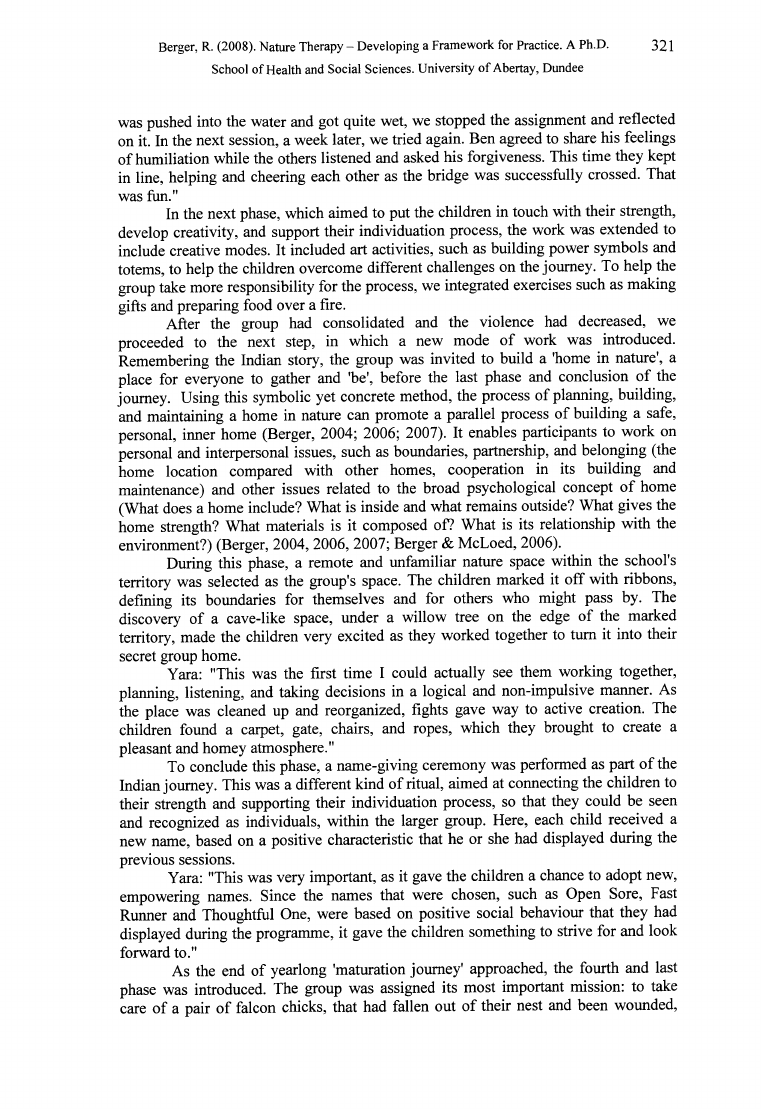
Berger, R. (2008). Nature Therapy - Developing a Framework for Practice. A Ph.D.
321
School of Health and Social Sciences. University of Abertay, Dundee
was pushed into the water and got quite wet, we stopped the assignment and reflected
on it. In the next session, a week later, we tried again. Ben agreed to share his feelings
of humiliation while the others listened and asked his forgiveness. This time they kept
in line, helping and cheering each other as the bridge was successfully crossed. That
was fun."
In the next phase, which aimed to put the children in touch with their strength,
develop creativity, and support their individuation process, the work was extended to
include creative modes. It included art activities, such as building power symbols and
totems, to help the children overcome different challenges on the journey. To help the
group take more responsibility for the process, we integrated exercises such as making
gifts and preparing food over a fire.
After the group had consolidated and the violence had decreased, we
proceeded to the next step, in which a new mode of work was introduced.
Remembering the Indian story, the group was invited to build a ’home in nature', a
place for everyone to gather and 'be', before the last phase and conclusion of the
journey. Using this symbolic yet concrete method, the process of planning, building,
and maintaining a home in nature can promote a parallel process of building a safe,
personal, inner home (Berger, 2004; 2006; 2007). It enables participants to work on
personal and interpersonal issues, such as boundaries, partnership, and belonging (the
home location compared with other homes, cooperation in its building and
maintenance) and other issues related to the broad psychological concept of home
(What does a home include? What is inside and what remains outside? What gives the
home strength? What materials is it composed of? What is its relationship with the
environment?) (Berger, 2004, 2006, 2007; Berger & McLoed, 2006).
During this phase, a remote and unfamiliar nature space within the school's
territory was selected as the group's space. The children marked it off with ribbons,
defining its boundaries for themselves and for others who might pass by. The
discovery of a cave-like space, under a willow tree on the edge of the marked
territory, made the children very excited as they worked together to turn it into their
secret group home.
Yarn: "This was the first time I could actually see them working together,
planning, listening, and taking decisions in a logical and non-impulsive manner. As
the place was cleaned up and reorganized, fights gave way to active creation. The
children found a carpet, gate, chairs, and ropes, which they brought to create a
pleasant and homey atmosphere."
To conclude this phase, a name-giving ceremony was performed as part of the
Indian journey. This was a different kind of ritual, aimed at connecting the children to
their strength and supporting their individuation process, so that they could be seen
and recognized as individuals, within the larger group. Here, each child received a
new name, based on a positive characteristic that he or she had displayed during the
previous sessions.
Yara: "This was very important, as it gave the children a chance to adopt new,
empowering names. Since the names that were chosen, such as Open Sore, Fast
Runner and Thoughtful One, were based on positive social behaviour that they had
displayed during the programme, it gave the children something to strive for and look
forward to."
As the end of yearlong 'maturation journey' approached, the fourth and last
phase was introduced. The group was assigned its most important mission: to take
care of a pair of falcon chicks, that had fallen out of their nest and been wounded,
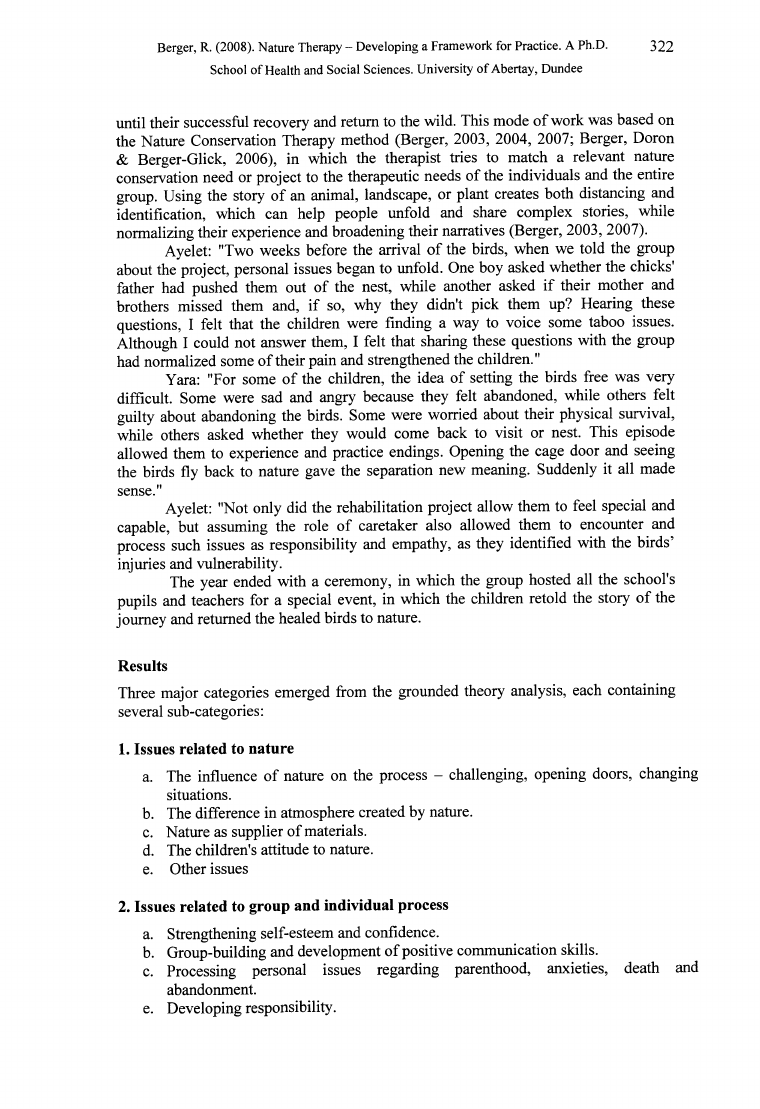
Berger, R. (2008). Nature Therapy - Developing a Framework for Practice. A Ph.D.
322
School of Health and Social Sciences. University of Abertay, Dundee
until their successful recovery and return to the wild. This mode of work was based on
the Nature Conservation Therapy method (Berger, 2003, 2004, 2007; Berger, Doron
& Berger-Glick, 2006), in which the therapist tries to match a relevant nature
conservation need or project to the therapeutic needs of the individuals and the entire
group. Using the story of an animal, landscape, or plant creates both distancing and
identification, which can help people unfold and share complex stories, while
normalizing their experience and broadening their narratives (Berger, 2003, 2007).
Ayelet: "Two weeks before the arrival of the birds, when we told the group
about the project, personal issues began to unfold. One boy asked whether the chicks'
father had pushed them out of the nest, while another asked if their mother and
brothers missed them and, if so, why they didn't pick them up? Hearing these
questions, I felt that the children were finding a way to voice some taboo issues.
Although I could not answer them, I felt that sharing these questions with the group
had normalized some of their pain and strengthened the children."
Yara: "For some of the children, the idea of setting the birds free was very
difficult. Some were sad and angry because they felt abandoned, while others felt
guilty about abandoning the birds. Some were worried about their physical survival,
while others asked whether they would come back to visit or nest. This episode
allowed them to experience and practice endings. Opening the cage door and seeing
the birds fly back to nature gave the separation new meaning. Suddenly it all made
sense."
Ayelet: "Not only did the rehabilitation project allow them to feel special and
capable, but assuming the role of caretaker also allowed them to encounter and
process such issues as responsibility and empathy, as they identified with the birds’
injuries and vulnerability.
The year ended with a ceremony, in which the group hosted all the school's
pupils and teachers for a special event, in which the children retold the story of the
journey and returned the healed birds to nature.
Results
Three major categories emerged from the grounded theory analysis, each containing
several sub-categories:
1. Issues related to nature
a. The influence of nature on the process - challenging, opening doors, changing
situations.
b. The difference in atmosphere created by nature.
c. Nature as supplier of materials.
d. The children's attitude to nature.
e. Other issues
2. Issues related to group and individual process
a. Strengthening self-esteem and confidence.
b. Group-building and development of positive communication skills.
c. Processing personal issues regarding parenthood, anxieties, death and
abandonment.
e. Developing responsibility.
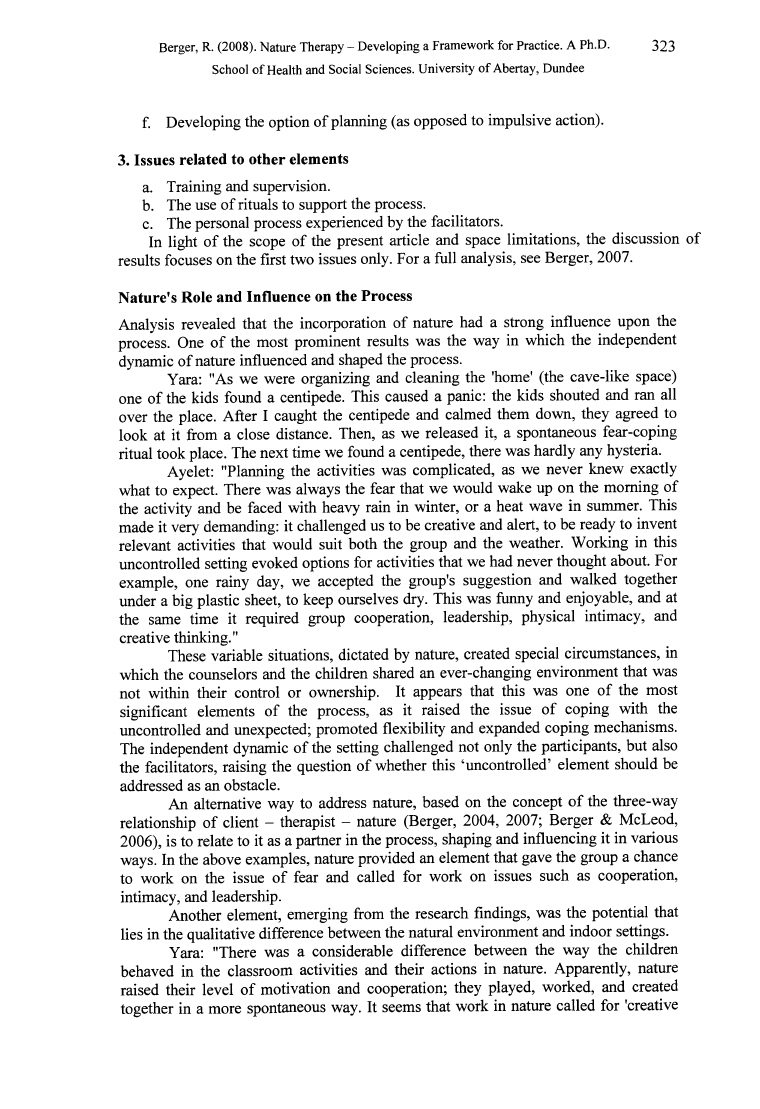
Berger, R. (2008). Nature Therapy - Developing a Framework for Practice. A Ph.D.
323
School of Health and Social Sciences. University of Abertay, Dundee
f. Developing the option of planning (as opposed to impulsive action).
3. Issues related to other elements
a. Training and supervision.
b. The use of rituals to support the process.
c. The personal process experienced by the facilitators.
In light of the scope of the present article and space limitations, the discussion of
results focuses on the first two issues only. For a full analysis, see Berger, 2007.
N ature’s Role and Influence on the Process
Analysis revealed that the incorporation of nature had a strong influence upon the
process. One of the most prominent results was the way in which the independent
dynamic of nature influenced and shaped the process.
Yara: "As we were organizing and cleaning the 'home' (the cave-like space)
one of the kids found a centipede. This caused a panic: the kids shouted and ran all
over the place. After I caught the centipede and calmed them down, they agreed to
look at it from a close distance. Then, as we released it, a spontaneous fear-coping
ritual took place. The next time we found a centipede, there was hardly any hysteria.
Ayelet: "Planning the activities was complicated, as we never knew exactly
what to expect. There was always the fear that we would wake up on the morning of
the activity and be faced with heavy rain in winter, or a heat wave in summer. This
made it very demanding: it challenged us to be creative and alert, to be ready to invent
relevant activities that would suit both the group and the weather. Working in this
uncontrolled setting evoked options for activities that we had never thought about. For
example, one rainy day, we accepted the group's suggestion and walked together
under a big plastic sheet, to keep ourselves dry. This was funny and enjoyable, and at
the same time it required group cooperation, leadership, physical intimacy, and
creative thinking."
These variable situations, dictated by nature, created special circumstances, in
which the counselors and the children shared an ever-changing environment that was
not within their control or ownership. It appears that this was one of the most
significant elements of the process, as it raised the issue of coping with the
uncontrolled and unexpected; promoted flexibility and expanded coping mechanisms.
The independent dynamic of the setting challenged not only the participants, but also
the facilitators, raising the question of whether this ‘uncontrolled’ element should be
addressed as an obstacle.
An alternative way to address nature, based on the concept of the three-way
relationship of client - therapist - nature (Berger, 2004, 2007; Berger & McLeod,
2006), is to relate to it as a partner in the process, shaping and influencing it in various
ways. In the above examples, nature provided an element that gave the group a chance
to work on the issue of fear and called for work on issues such as cooperation,
intimacy, and leadership.
Another element, emerging from the research findings, was the potential that
lies in the qualitative difference between the natural environment and indoor settings.
Yara: "There was a considerable difference between the way the children
behaved in the classroom activities and their actions in nature. Apparently, nature
raised their level of motivation and cooperation; they played, worked, and created
together in a more spontaneous way. It seems that work in nature called for 'creative
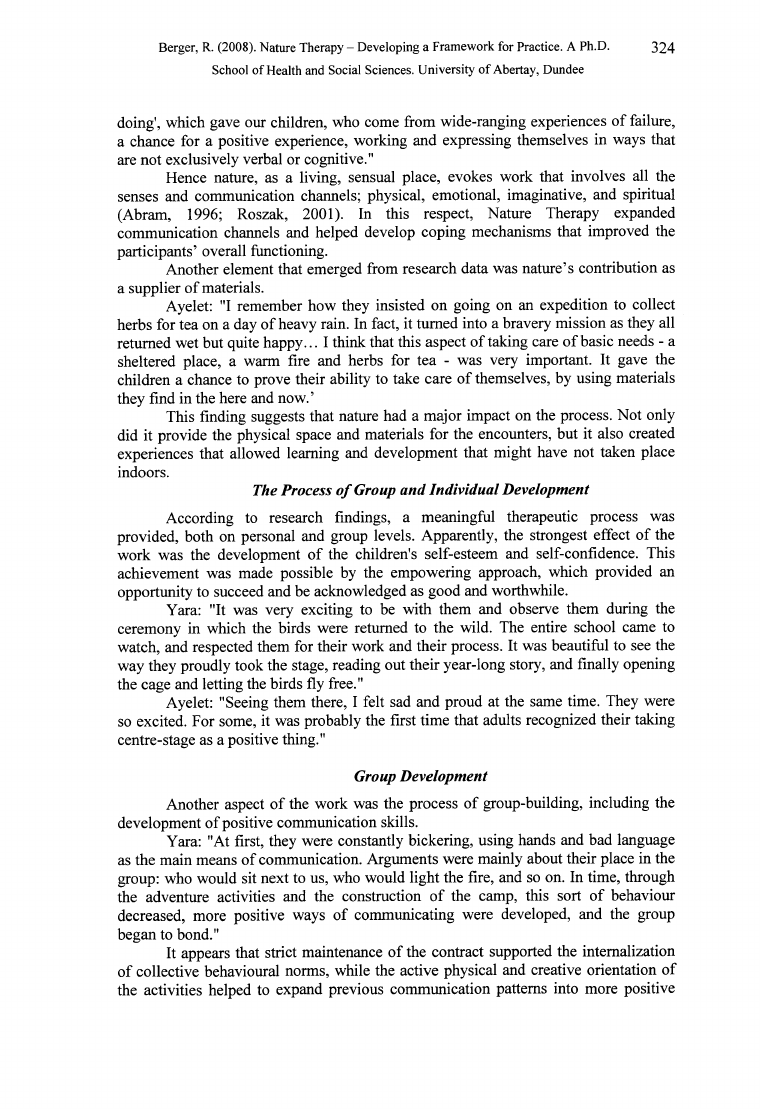
Berger, R. (2008). Nature Therapy - Developing a Framework for Practice. A Ph.D.
324
School of Health and Social Sciences. University of Abertay, Dundee
doing', which gave our children, who come from wide-ranging experiences of failure,
a chance for a positive experience, working and expressing themselves in ways that
are not exclusively verbal or cognitive."
Hence nature, as a living, sensual place, evokes work that involves all the
senses and communication channels; physical, emotional, imaginative, and spiritual
(Abram, 1996; Roszak, 2001). In this respect, Nature Therapy expanded
communication channels and helped develop coping mechanisms that improved the
participants’ overall functioning.
Another element that emerged from research data was nature’s contribution as
a supplier of materials.
Ayelet: "I remember how they insisted on going on an expedition to collect
herbs for tea on a day of heavy rain. In fact, it turned into a bravery mission as they all
returned wet but quite happy... I think that this aspect of taking care of basic needs - a
sheltered place, a warm fire and herbs for tea - was very important. It gave the
children a chance to prove their ability to take care of themselves, by using materials
they find in the here and now.’
This finding suggests that nature had a major impact on the process. Not only
did it provide the physical space and materials for the encounters, but it also created
experiences that allowed learning and development that might have not taken place
indoors.
The Process o f Group and Individual Development
According to research findings, a meaningful therapeutic process was
provided, both on personal and group levels. Apparently, the strongest effect of the
work was the development of the children's self-esteem and self-confidence. This
achievement was made possible by the empowering approach, which provided an
opportunity to succeed and be acknowledged as good and worthwhile.
Yara: "It was very exciting to be with them and observe them during the
ceremony in which the birds were returned to the wild. The entire school came to
watch, and respected them for their work and their process. It was beautiful to see the
way they proudly took the stage, reading out their year-long story, and finally opening
the cage and letting the birds fly free."
Ayelet: "Seeing them there, I felt sad and proud at the same time. They were
so excited. For some, it was probably the first time that adults recognized their taking
centre-stage as a positive thing."
Group Development
Another aspect of the work was the process of group-building, including the
development of positive communication skills.
Yara: "At first, they were constantly bickering, using hands and bad language
as the main means of communication. Arguments were mainly about their place in the
group: who would sit next to us, who would light the fire, and so on. In time, through
the adventure activities and the construction of the camp, this sort of behaviour
decreased, more positive ways of communicating were developed, and the group
began to bond."
It appears that strict maintenance of the contract supported the internalization
of collective behavioural norms, while the active physical and creative orientation of
the activities helped to expand previous communication patterns into more positive
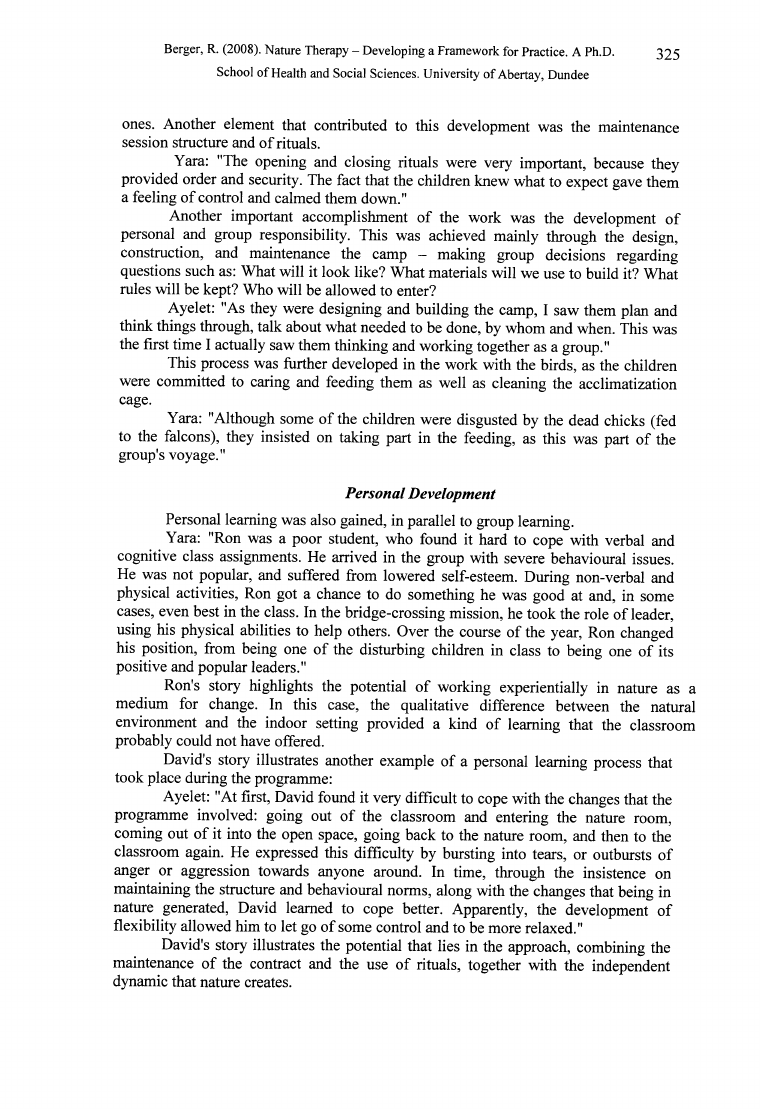
Berger, R. (2008). Nature Therapy - Developing a Framework for Practice. A Ph.D.
325
School of Health and Social Sciences. University of Abertay, Dundee
ones. Another element that contributed to this development was the maintenance
session structure and of rituals.
Yara: "The opening and closing rituals were very important, because they
provided order and security. The fact that the children knew what to expect gave them
a feeling of control and calmed them down."
Another important accomplishment of the work was the development of
personal and group responsibility. This was achieved mainly through the design,
construction, and maintenance the camp — making group decisions regarding
questions such as: What will it look like? What materials will we use to build it? What
rules will be kept? Who will be allowed to enter?
Ayelet: "As they were designing and building the camp, I saw them plan and
think things through, talk about what needed to be done, by whom and when. This was
the first time I actually saw them thinking and working together as a group."
This process was further developed in the work with the birds, as the children
were committed to caring and feeding them as well as cleaning the acclimatization
cage.
Yara: "Although some of the children were disgusted by the dead chicks (fed
to the falcons), they insisted on taking part in the feeding, as this was part of the
group's voyage."
Personal Development
Personal learning was also gained, in parallel to group learning.
Yara: "Ron was a poor student, who found it hard to cope with verbal and
cognitive class assignments. He arrived in the group with severe behavioural issues.
He was not popular, and suffered from lowered self-esteem. During non-verbal and
physical activities, Ron got a chance to do something he was good at and, in some
cases, even best in the class. In the bridge-crossing mission, he took the role of leader,
using his physical abilities to help others. Over the course of the year, Ron changed
his position, from being one of the disturbing children in class to being one of its
positive and popular leaders."
Ron's story highlights the potential of working experientially in nature as a
medium for change. In this case, the qualitative difference between the natural
environment and the indoor setting provided a kind of learning that the classroom
probably could not have offered.
David's story illustrates another example of a personal learning process that
took place during the programme:
Ayelet: "At first, David found it very difficult to cope with the changes that the
programme involved: going out of the classroom and entering the nature room,
coming out of it into the open space, going back to the nature room, and then to the
classroom again. He expressed this difficulty by bursting into tears, or outbursts of
anger or aggression towards anyone around. In time, through the insistence on
maintaining the structure and behavioural norms, along with the changes that being in
nature generated, David learned to cope better. Apparently, the development of
flexibility allowed him to let go of some control and to be more relaxed."
David's story illustrates the potential that lies in the approach, combining the
maintenance of the contract and the use of rituals, together with the independent
dynamic that nature creates.
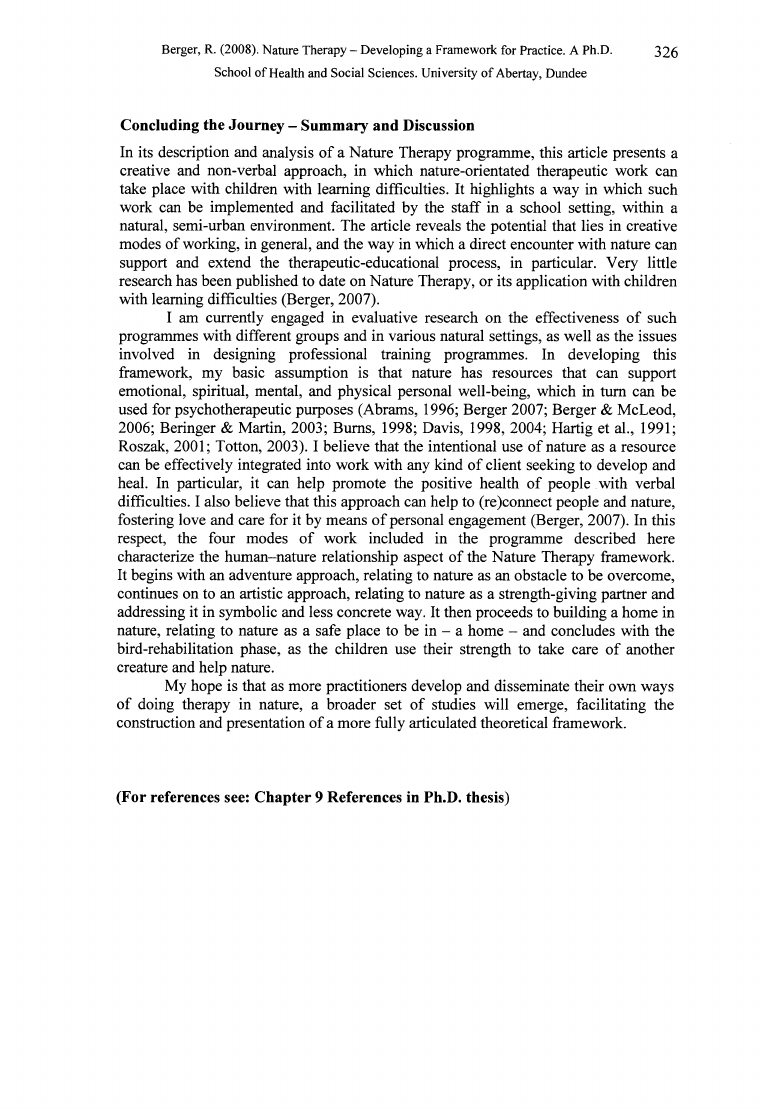
Berger, R. (2008). Nature Therapy - Developing a Framework for Practice. A Ph.D.
326
School of Health and Social Sciences. University of Abertay, Dundee
Concluding the Journey - Summary and Discussion
In its description and analysis of a Nature Therapy programme, this article presents a
creative and non-verbal approach, in which nature-orientated therapeutic work can
take place with children with learning difficulties. It highlights a way in which such
work can be implemented and facilitated by the staff in a school setting, within a
natural, semi-urban environment. The article reveals the potential that lies in creative
modes of working, in general, and the way in which a direct encounter with nature can
support and extend the therapeutic-educational process, in particular. Very little
research has been published to date on Nature Therapy, or its application with children
with learning difficulties (Berger, 2007).
I am currently engaged in evaluative research on the effectiveness of such
programmes with different groups and in various natural settings, as well as the issues
involved in designing professional training programmes. In developing this
framework, my basic assumption is that nature has resources that can support
emotional, spiritual, mental, and physical personal well-being, which in turn can be
used for psychotherapeutic purposes (Abrams, 1996; Berger 2007; Berger & McLeod,
2006; Beringer & Martin, 2003; Bums, 1998; Davis, 1998, 2004; Hartig et al., 1991;
Roszak, 2001; Totton, 2003). I believe that the intentional use of nature as a resource
can be effectively integrated into work with any kind of client seeking to develop and
heal. In particular, it can help promote the positive health of people with verbal
difficulties. I also believe that this approach can help to (re)connect people and nature,
fostering love and care for it by means of personal engagement (Berger, 2007). In this
respect, the four modes of work included in the programme described here
characterize the human-nature relationship aspect of the Nature Therapy framework.
It begins with an adventure approach, relating to nature as an obstacle to be overcome,
continues on to an artistic approach, relating to nature as a strength-giving partner and
addressing it in symbolic and less concrete way. It then proceeds to building a home in
nature, relating to nature as a safe place to be in - a home - and concludes with the
bird-rehabilitation phase, as the children use their strength to take care of another
creature and help nature.
My hope is that as more practitioners develop and disseminate their own ways
of doing therapy in nature, a broader set of studies will emerge, facilitating the
construction and presentation of a more fully articulated theoretical framework.
(For references see: Chapter 9 References in Ph.D. thesis)
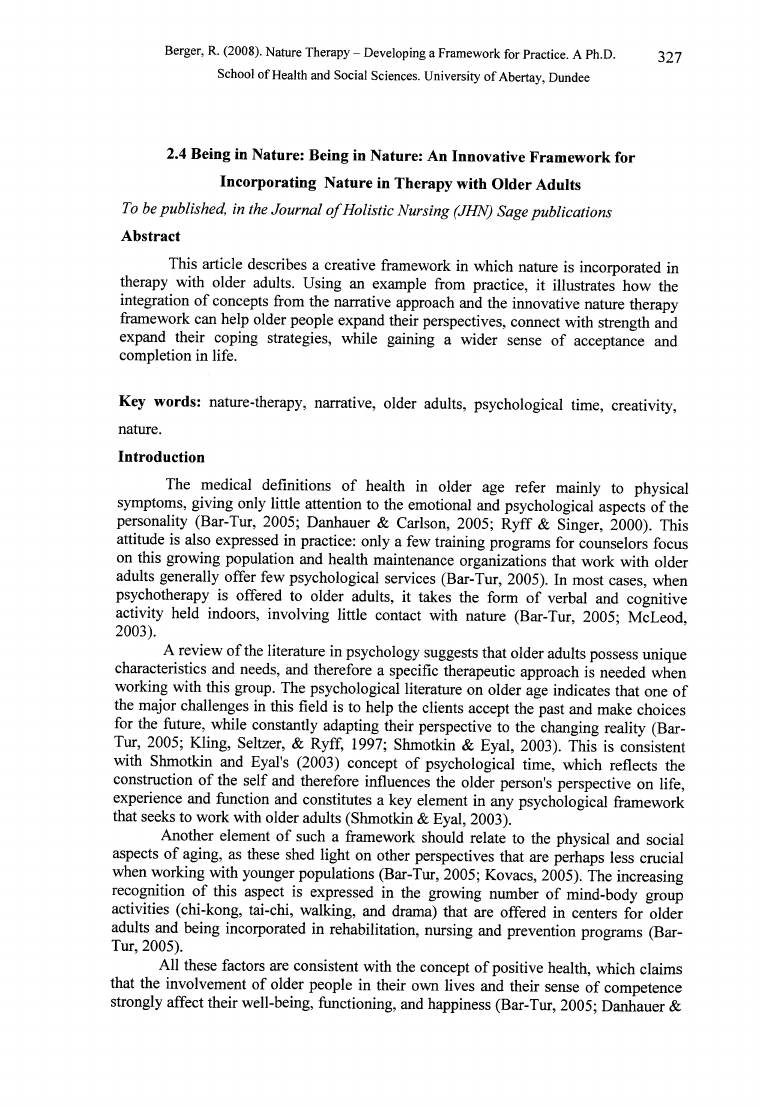
Berger, R. (2008). Nature Therapy - Developing a Framework for Practice. A Ph.D.
327
School of Health and Social Sciences. University of Abertay, Dundee
2.4 Being in Nature: Being in Nature: An Innovative Framework for
Incorporating Nature in Therapy with Older Adults
To be published, in the Journal o fHolistic Nursing (JHN) Sage publications
Abstract
This article describes a creative framework in which nature is incorporated in
therapy with older adults. Using an example from practice, it illustrates how the
integration of concepts from the narrative approach and the innovative nature therapy
framework can help older people expand their perspectives, connect with strength and
expand their coping strategies, while gaining a wider sense of acceptance and
completion in life.
Key words: nature-therapy, narrative, older adults, psychological time, creativity,
nature.
Introduction
The medical definitions of health in older age refer mainly to physical
symptoms, giving only little attention to the emotional and psychological aspects of the
personality (Bar-Tur, 2005; Danhauer & Carlson, 2005; Ryff & Singer, 2000). This
attitude is also expressed in practice: only a few training programs for counselors focus
on this growing population and health maintenance organizations that work with older
adults generally offer few psychological services (Bar-Tur, 2005). In most cases, when
psychotherapy is offered to older adults, it takes the form of verbal and cognitive
activity held indoors, involving little contact with nature (Bar-Tur, 2005; McLeod
2003).
A review of the literature in psychology suggests that older adults possess unique
characteristics and needs, and therefore a specific therapeutic approach is needed when
working with this group. The psychological literature on older age indicates that one of
the major challenges in this field is to help the clients accept the past and make choices
for the future, while constantly adapting their perspective to the changing reality (Bar-
Tur, 2005; Kling, Seltzer, & Ryff, 1997; Shmotkin & Eyal, 2003). This is consistent
with Shmotkin and Eyal's (2003) concept of psychological time, which reflects the
construction of the self and therefore influences the older person's perspective on life,
experience and function and constitutes a key element in any psychological framework
that seeks to work with older adults (Shmotkin & Eyal, 2003).
Another element of such a framework should relate to the physical and social
aspects of aging, as these shed light on other perspectives that are perhaps less crucial
when working with younger populations (Bar-Tur, 2005; Kovacs, 2005). The increasing
recognition of this aspect is expressed in the growing number of mind-body group
activities (chi-kong, tai-chi, walking, and drama) that are offered in centers for older
adults and being incorporated in rehabilitation, nursing and prevention programs (Bar-
Tur, 2005).
All these factors are consistent with the concept of positive health, which claims
that the involvement of older people in their own lives and their sense of competence
strongly affect their well-being, functioning, and happiness (Bar-Tur, 2005; Danhauer &
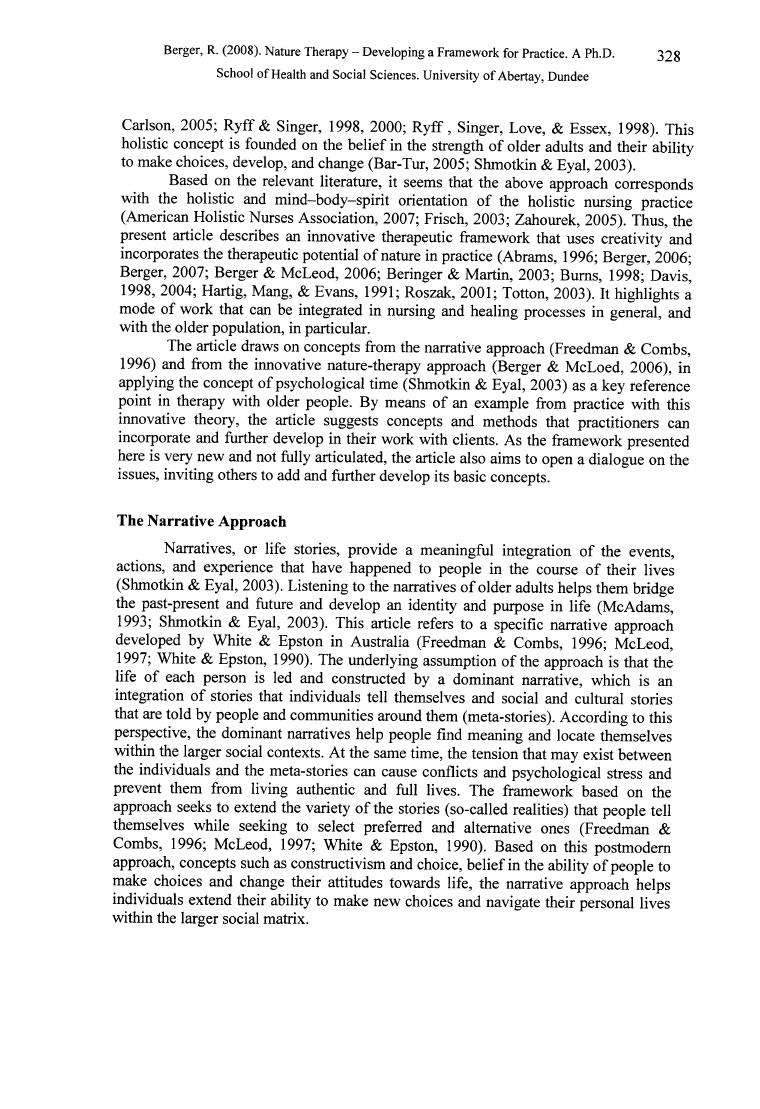
Berger, R. (2008). Nature Therapy - Developing a Framework for Practice. A Ph.D.
328
School of Health and Social Sciences. University of Abertay, Dundee
Carlson, 2005; Ryff & Singer, 1998, 2000; R y ff, Singer, Love, & Essex, 1998). This
holistic concept is founded on the belief in the strength of older adults and their ability
to make choices, develop, and change (Bar-Tur, 2005; Shmotkin & Eyal, 2003).
Based on the relevant literature, it seems that the above approach corresponds
with the holistic and mind—body—spirit orientation of the holistic nursing practice
(American Holistic Nurses Association, 2007; Frisch, 2003; Zahourek, 2005). Thus, the
present article describes an innovative therapeutic framework that uses creativity and
incorporates the therapeutic potential of nature in practice (Abrams, 1996; Berger, 2006;
Berger, 2007; Berger & McLeod, 2006; Beringer & Martin, 2003; Bums, 1998; Davis’
1998, 2004; Hartig, Mang, & Evans, 1991; Roszak, 2001; Totton, 2003). It highlights a
mode of work that can be integrated in nursing and healing processes in general, and
with the older population, in particular.
The article draws on concepts from the narrative approach (Freedman & Combs,
1996) and from the innovative nature-therapy approach (Berger & McLoed, 2006), in
applying the concept of psychological time (Shmotkin & Eyal, 2003) as a key reference
point in therapy with older people. By means of an example from practice with this
innovative theory, the article suggests concepts and methods that practitioners can
incorporate and further develop in their work with clients. As the framework presented
here is very new and not fully articulated, the article also aims to open a dialogue on the
issues, inviting others to add and further develop its basic concepts.
The Narrative Approach
Narratives, or life stories, provide a meaningful integration of the events,
actions, and experience that have happened to people in the course of their lives
(Shmotkin & Eyal, 2003). Listening to the narratives of older adults helps them bridge
the past-present and future and develop an identity and purpose in life (McAdams,
1993; Shmotkin & Eyal, 2003). This article refers to a specific narrative approach
developed by White & Epston in Australia (Freedman & Combs, 1996; McLeod,
1997; White & Epston, 1990). The underlying assumption of the approach is that the
life of each person is led and constructed by a dominant narrative, which is an
integration of stories that individuals tell themselves and social and cultural stories
that are told by people and communities around them (meta-stories). According to this
perspective, the dominant narratives help people find meaning and locate themselves
within the larger social contexts. At the same time, the tension that may exist between
the individuals and the meta-stories can cause conflicts and psychological stress and
prevent them from living authentic and full lives. The framework based on the
approach seeks to extend the variety of the stories (so-called realities) that people tell
themselves while seeking to select preferred and alternative ones (Freedman &
Combs, 1996; McLeod, 1997; White & Epston, 1990). Based on this postmodern
approach, concepts such as constructivism and choice, belief in the ability of people to
make choices and change their attitudes towards life, the narrative approach helps
individuals extend their ability to make new choices and navigate their personal lives
within the larger social matrix.
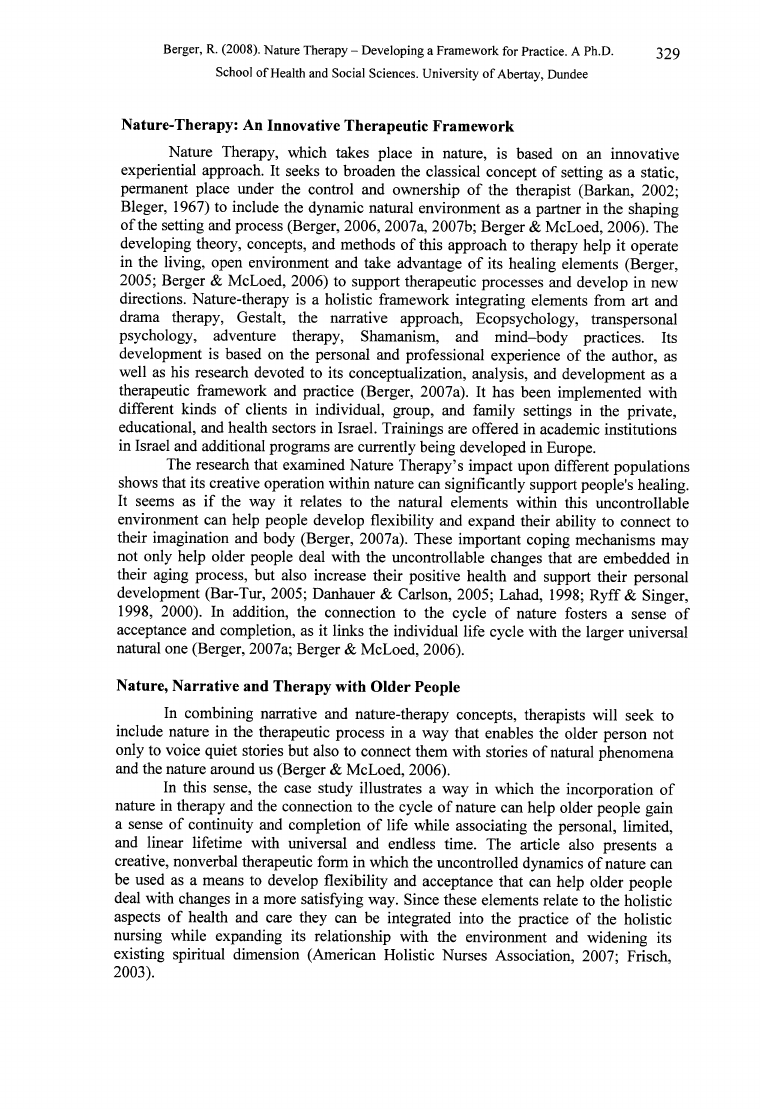
Berger, R. (2008). Nature Therapy - Developing a Framework for Practice. A Ph.D.
329
School of Health and Social Sciences. University of Abertay, Dundee
Nature-Therapy: An Innovative Therapeutic Framework
Nature Therapy, which takes place in nature, is based on an innovative
experiential approach. It seeks to broaden the classical concept of setting as a static,
permanent place under the control and ownership of the therapist (Barkan, 2002;
Bleger, 1967) to include the dynamic natural environment as a partner in the shaping
of the setting and process (Berger, 2006, 2007a, 2007b; Berger & McLoed, 2006). The
developing theory, concepts, and methods of this approach to therapy help it operate
in the living, open environment and take advantage of its healing elements (Berger,
2005; Berger & McLoed, 2006) to support therapeutic processes and develop in new
directions. Nature-therapy is a holistic framework integrating elements from art and
drama therapy, Gestalt, the narrative approach, Ecopsychology, transpersonal
psychology, adventure therapy, Shamanism, and mind-body practices. Its
development is based on the personal and professional experience of the author, as
well as his research devoted to its conceptualization, analysis, and development as a
therapeutic framework and practice (Berger, 2007a). It has been implemented with
different kinds of clients in individual, group, and family settings in the private,
educational, and health sectors in Israel. Trainings are offered in academic institutions
in Israel and additional programs are currently being developed in Europe.
The research that examined Nature Therapy’s impact upon different populations
shows that its creative operation within nature can significantly support people's healing.
It seems as if the way it relates to the natural elements within this uncontrollable
environment can help people develop flexibility and expand their ability to connect to
their imagination and body (Berger, 2007a). These important coping mechanisms may
not only help older people deal with the uncontrollable changes that are embedded in
their aging process, but also increase their positive health and support their personal
development (Bar-Tur, 2005; Danhauer & Carlson, 2005; Lahad, 1998; Ryff & Singer,
1998, 2000). In addition, the connection to the cycle of nature fosters a sense of
acceptance and completion, as it links the individual life cycle with the larger universal
natural one (Berger, 2007a; Berger & McLoed, 2006).
Nature, Narrative and Therapy with Older People
In combining narrative and nature-therapy concepts, therapists will seek to
include nature in the therapeutic process in a way that enables the older person not
only to voice quiet stories but also to connect them with stories of natural phenomena
and the nature around us (Berger & McLoed, 2006).
In this sense, the case study illustrates a way in which the incorporation of
nature in therapy and the connection to the cycle of nature can help older people gain
a sense of continuity and completion of life while associating the personal, limited,
and linear lifetime with universal and endless time. The article also presents a
creative, nonverbal therapeutic form in which the uncontrolled dynamics of nature can
be used as a means to develop flexibility and acceptance that can help older people
deal with changes in a more satisfying way. Since these elements relate to the holistic
aspects of health and care they can be integrated into the practice of the holistic
nursing while expanding its relationship with the environment and widening its
existing spiritual dimension (American Holistic Nurses Association, 2007; Frisch,
2003).
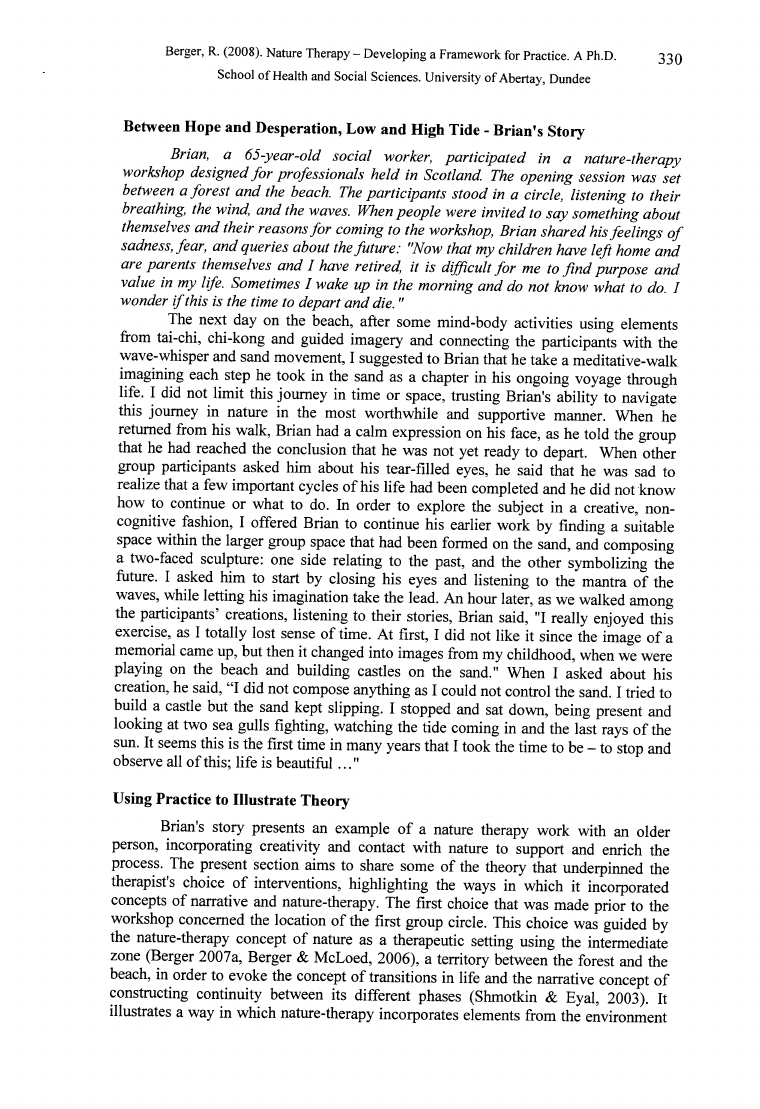
Berger, R. (2008). Nature Therapy - Developing a Framework for Practice. A Ph.D.
330
School of Health and Social Sciences. University of Abertay, Dundee
Between H ope and D esperation, Low and High Tide - B rian’s Story
Brian, a 65-year-old social worker, participated in a nature-therapy
workshop designed for professionals held in Scotland. The opening session was set
between a forest and the beach. The participants stood in a circle, listening to their
breathing, the wind, and the waves. When people were invited to say something about
themselves and their reasons for coming to the workshop, Brian shared hisfeelings o f
sadness, fear, and queries about thefuture: "Now that my children have left home and
are parents themselves and I have retired, it is difficult for me to fin d purpose and
value in my life. Sometimes I wake up in the morning and do not know what to do. I
wonder if this is the time to depart and die. "
The next day on the beach, after some mind-body activities using elements
from tai-chi, chi-kong and guided imagery and connecting the participants with the
wave-whisper and sand movement, I suggested to Brian that he take a meditative-walk
imagining each step he took in the sand as a chapter in his ongoing voyage through
life. I did not limit this journey in time or space, trusting Brian's ability to navigate
this journey in nature in the most worthwhile and supportive manner. When he
returned from his walk, Brian had a calm expression on his face, as he told the group
that he had reached the conclusion that he was not yet ready to depart. When other
group participants asked him about his tear-filled eyes, he said that he was sad to
realize that a few important cycles of his life had been completed and he did not know
how to continue or what to do. In order to explore the subject in a creative, non-
cognitive fashion, I offered Brian to continue his earlier work by finding a suitable
space within the larger group space that had been formed on the sand, and composing
a two-faced sculpture: one side relating to the past, and the other symbolizing the
future. I asked him to start by closing his eyes and listening to the mantra of the
waves, while letting his imagination take the lead. An hour later, as we walked among
the participants’ creations, listening to their stories, Brian said, "I really enjoyed this
exercise, as I totally lost sense of time. At first, I did not like it since the image of a
memorial came up, but then it changed into images from my childhood, when we were
playing on the beach and building castles on the sand." When I asked about his
creation, he said, “I did not compose anything as I could not control the sand. I tried to
build a castle but the sand kept slipping. I stopped and sat down, being present and
looking at two sea gulls fighting, watching the tide coming in and the last rays of the
sun. It seems this is the first time in many years that I took the time to be - to stop and
observe all of this; life is beautiful ..."
Using Practice to Illustrate Theory
Brian's story presents an example of a nature therapy work with an older
person, incorporating creativity and contact with nature to support and enrich the
process. The present section aims to share some of the theory that underpinned the
therapist's choice of interventions, highlighting the ways in which it incorporated
concepts of narrative and nature-therapy. The first choice that was made prior to the
workshop concerned the location of the first group circle. This choice was guided by
the nature-therapy concept of nature as a therapeutic setting using the intermediate
zone (Berger 2007a, Berger & McLoed, 2006), a territory between the forest and the
beach, in order to evoke the concept of transitions in life and the narrative concept of
constructing continuity between its different phases (Shmotkin & Eyal, 2003). It
illustrates a way in which nature-therapy incorporates elements from the environment
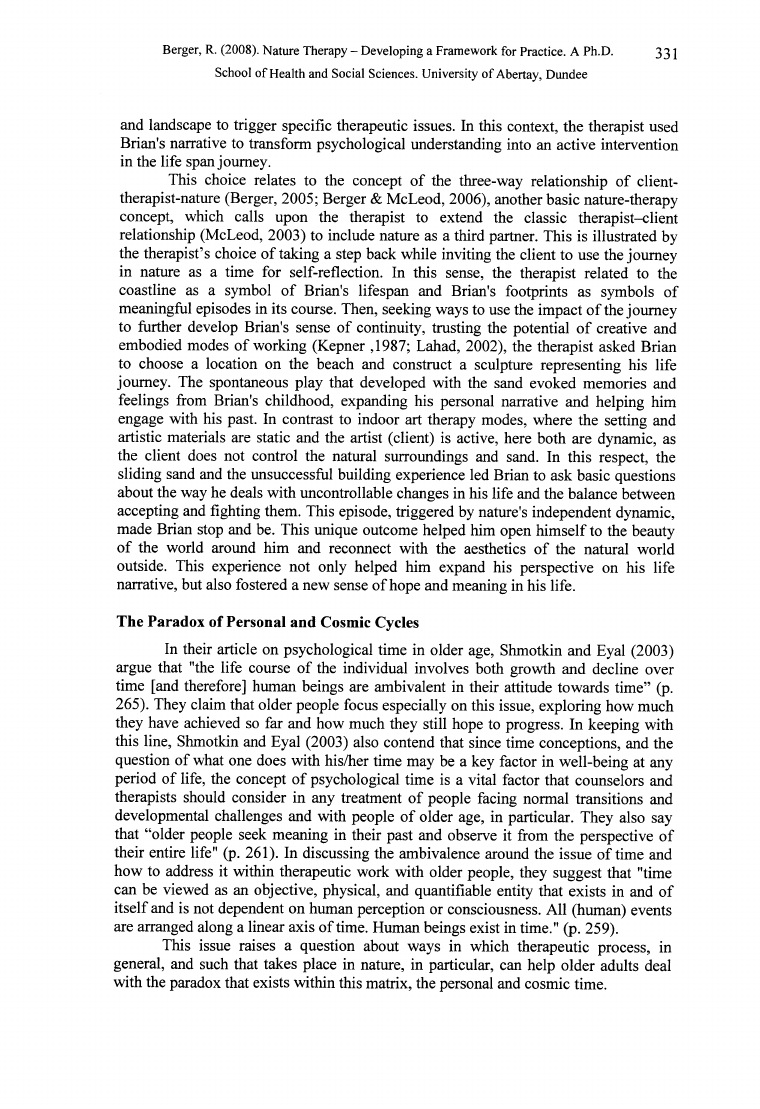
Berger, R. (2008). Nature Therapy - Developing a Framework for Practice. A Ph.D.
331
School of Health and Social Sciences. University of Abertay, Dundee
and landscape to trigger specific therapeutic issues. In this context, the therapist used
Brian's narrative to transform psychological understanding into an active intervention
in the life span journey.
This choice relates to the concept of the three-way relationship of client-
therapist-nature (Berger, 2005; Berger & McLeod, 2006), another basic nature-therapy
concept, which calls upon the therapist to extend the classic therapist-client
relationship (McLeod, 2003) to include nature as a third partner. This is illustrated by
the therapist’s choice of taking a step back while inviting the client to use the journey
in nature as a time for self-reflection. In this sense, the therapist related to the
coastline as a symbol of Brian's lifespan and Brian's footprints as symbols of
meaningful episodes in its course. Then, seeking ways to use the impact o f the journey
to further develop Brian's sense of continuity, trusting the potential of creative and
embodied modes of working (Kepner ,1987; Lahad, 2002), the therapist asked Brian
to choose a location on the beach and construct a sculpture representing his life
journey. The spontaneous play that developed with the sand evoked memories and
feelings from Brian's childhood, expanding his personal narrative and helping him
engage with his past. In contrast to indoor art therapy modes, where the setting and
artistic materials are static and the artist (client) is active, here both are dynamic, as
the client does not control the natural surroundings and sand. In this respect, the
sliding sand and the unsuccessful building experience led Brian to ask basic questions
about the way he deals with uncontrollable changes in his life and the balance between
accepting and fighting them. This episode, triggered by nature's independent dynamic,
made Brian stop and be. This unique outcome helped him open himself to the beauty
of the world around him and reconnect with the aesthetics of the natural world
outside. This experience not only helped him expand his perspective on his life
narrative, but also fostered a new sense of hope and meaning in his life.
The Paradox of Personal and Cosmic Cycles
In their article on psychological time in older age, Shmotkin and Eyal (2003)
argue that "the life course of the individual involves both growth and decline over
time [and therefore] human beings are ambivalent in their attitude towards time” (p.
265). They claim that older people focus especially on this issue, exploring how much
they have achieved so far and how much they still hope to progress. In keeping with
this line, Shmotkin and Eyal (2003) also contend that since time conceptions, and the
question of what one does with his/her time may be a key factor in well-being at any
period of life, the concept of psychological time is a vital factor that counselors and
therapists should consider in any treatment of people facing normal transitions and
developmental challenges and with people of older age, in particular. They also say
that “older people seek meaning in their past and observe it from the perspective of
their entire life" (p. 261). In discussing the ambivalence around the issue of time and
how to address it within therapeutic work with older people, they suggest that "time
can be viewed as an objective, physical, and quantifiable entity that exists in and of
itself and is not dependent on human perception or consciousness. All (human) events
are arranged along a linear axis of time. Human beings exist in time." (p. 259).
This issue raises a question about ways in which therapeutic process, in
general, and such that takes place in nature, in particular, can help older adults deal
with the paradox that exists within this matrix, the personal and cosmic time.
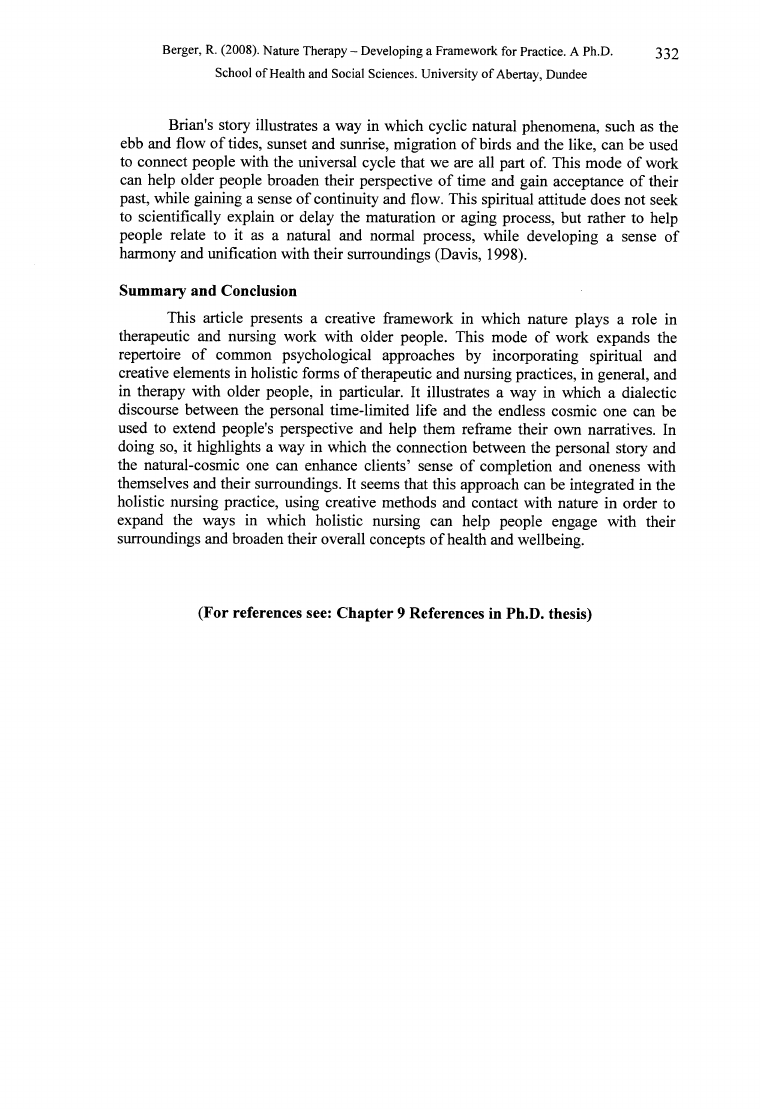
Berger, R. (2008). Nature Therapy - Developing a Framework for Practice. A Ph.D.
332
School of Health and Social Sciences. University of Abertay, Dundee
Brian's story illustrates a way in which cyclic natural phenomena, such as the
ebb and flow of tides, sunset and sunrise, migration of birds and the like, can be used
to connect people with the universal cycle that we are all part of. This mode of work
can help older people broaden their perspective of time and gain acceptance of their
past, while gaining a sense of continuity and flow. This spiritual attitude does not seek
to scientifically explain or delay the maturation or aging process, but rather to help
people relate to it as a natural and normal process, while developing a sense of
harmony and unification with their surroundings (Davis, 1998).
Summary and Conclusion
This article presents a creative framework in which nature plays a role in
therapeutic and nursing work with older people. This mode of work expands the
repertoire of common psychological approaches by incorporating spiritual and
creative elements in holistic forms of therapeutic and nursing practices, in general, and
in therapy with older people, in particular. It illustrates a way in which a dialectic
discourse between the personal time-limited life and the endless cosmic one can be
used to extend people's perspective and help them reframe their own narratives. In
doing so, it highlights a way in which the connection between the personal story and
the natural-cosmic one can enhance clients’ sense of completion and oneness with
themselves and their surroundings. It seems that this approach can be integrated in the
holistic nursing practice, using creative methods and contact with nature in order to
expand the ways in which holistic nursing can help people engage with their
surroundings and broaden their overall concepts of health and wellbeing.
(For references see: Chapter 9 References in Ph.D. thesis)
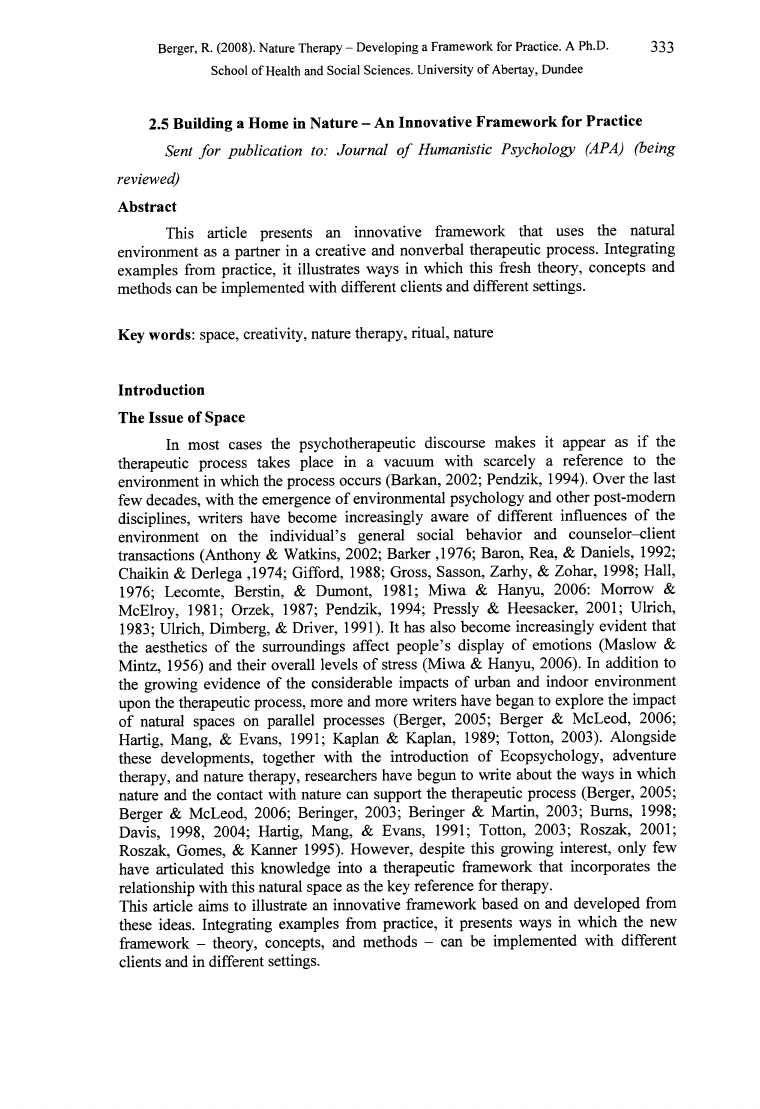
Berger, R. (2008). Nature Therapy - Developing a Framework for Practice. A Ph.D.
333
School of Health and Social Sciences. University of Abertay, Dundee
2.5 Building a Home in Nature - An Innovative Fram ework for Practice
Sent for publication to: Journal o f Humanistic Psychology (APA) (being
reviewed)
Abstract
This article presents an innovative framework that uses the natural
environment as a partner in a creative and nonverbal therapeutic process. Integrating
examples from practice, it illustrates ways in which this fresh theory, concepts and
methods can be implemented with different clients and different settings.
Key words: space, creativity, nature therapy, ritual, nature
Introduction
The Issue of Space
In most cases the psychotherapeutic discourse makes it appear as if the
therapeutic process takes place in a vacuum with scarcely a reference to the
environment in which the process occurs (Barkan, 2002; Pendzik, 1994). Over the last
few decades, with the emergence of environmental psychology and other post-modern
disciplines, writers have become increasingly aware of different influences of the
environment on the individual’s general social behavior and counselor-client
transactions (Anthony & Watkins, 2002; Barker ,1976; Baron, Rea, & Daniels, 1992;
Chaikin & Derlega ,1974; Gifford, 1988; Gross, Sasson, Zarhy, & Zohar, 1998; Hall,
1976; Lecomte, Berstin, & Dumont, 1981; Miwa & Hanyu, 2006: Morrow &
McElroy, 1981; Orzek, 1987; Pendzik, 1994; Pressly & Heesacker, 2001; Ulrich,
1983; Ulrich, Dimberg, & Driver, 1991). It has also become increasingly evident that
the aesthetics of the surroundings affect people’s display of emotions (Maslow &
Mintz, 1956) and their overall levels of stress (Miwa & Hanyu, 2006). In addition to
the growing evidence of the considerable impacts of urban and indoor environment
upon the therapeutic process, more and more writers have began to explore the impact
of natural spaces on parallel processes (Berger, 2005; Berger & McLeod, 2006;
Hartig, Mang, & Evans, 1991; Kaplan & Kaplan, 1989; Totton, 2003). Alongside
these developments, together with the introduction of Ecopsychology, adventure
therapy, and nature therapy, researchers have begun to write about the ways in which
nature and the contact with nature can support the therapeutic process (Berger, 2005;
Berger & McLeod, 2006; Beringer, 2003; Beringer & Martin, 2003; Bums, 1998;
Davis, 1998, 2004; Hartig, Mang, & Evans, 1991; Totton, 2003; Roszak, 2001;
Roszak, Gomes, & Kanner 1995). However, despite this growing interest, only few
have articulated this knowledge into a therapeutic framework that incorporates the
relationship with this natural space as the key reference for therapy.
This article aims to illustrate an innovative framework based on and developed from
these ideas. Integrating examples from practice, it presents ways in which the new
framework - theory, concepts, and methods - can be implemented with different
clients and in different settings.
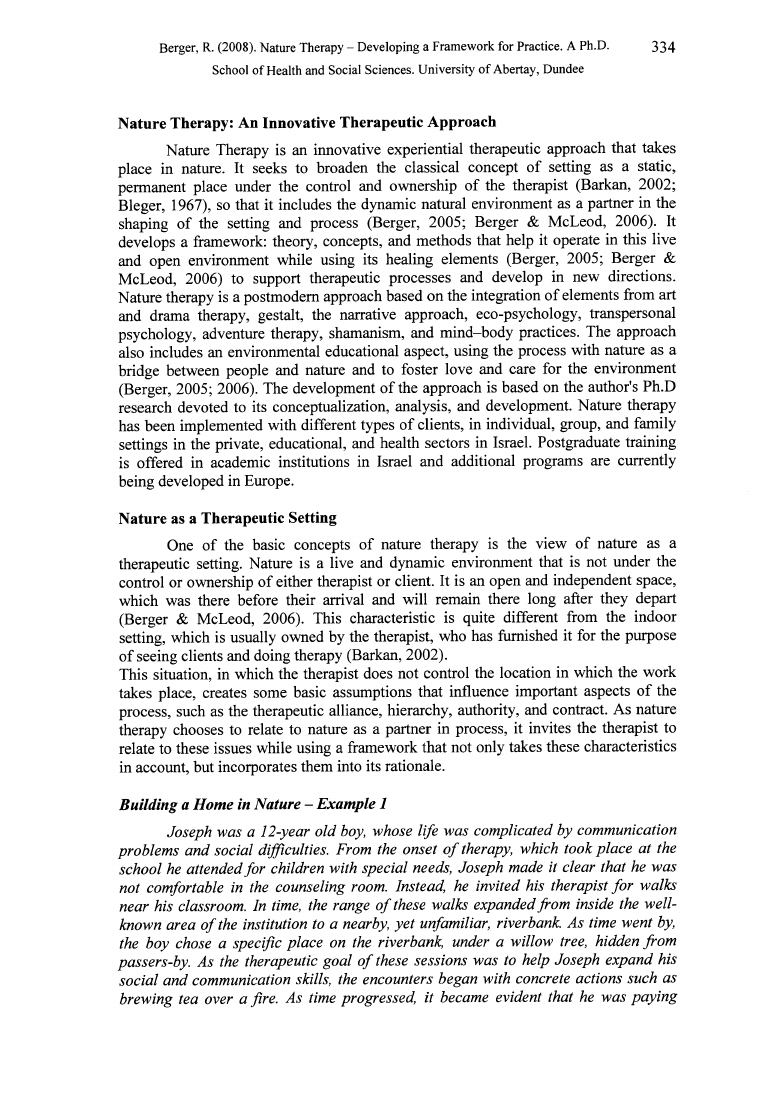
Berger, R. (2008). Nature Therapy - Developing a Framework for Practice. A Ph.D.
334
School of Health and Social Sciences. University of Abertay, Dundee
Nature Therapy: An Innovative Therapeutic Approach
Nature Therapy is an innovative experiential therapeutic approach that takes
place in nature. It seeks to broaden the classical concept of setting as a static,
permanent place under the control and ownership of the therapist (Barkan, 2002;
Bleger, 1967), so that it includes the dynamic natural environment as a partner in the
shaping of the setting and process (Berger, 2005; Berger & McLeod, 2006). It
develops a framework: theory, concepts, and methods that help it operate in this live
and open environment while using its healing elements (Berger, 2005; Berger &
McLeod, 2006) to support therapeutic processes and develop in new directions.
Nature therapy is a postmodern approach based on the integration of elements from art
and drama therapy, gestalt, the narrative approach, eco-psychology, transpersonal
psychology, adventure therapy, shamanism, and mind-body practices. The approach
also includes an environmental educational aspect, using the process with nature as a
bridge between people and nature and to foster love and care for the environment
(Berger, 2005; 2006). The development of the approach is based on the author's Ph.D
research devoted to its conceptualization, analysis, and development. Nature therapy
has been implemented with different types of clients, in individual, group, and family
settings in the private, educational, and health sectors in Israel. Postgraduate training
is offered in academic institutions in Israel and additional programs are currently
being developed in Europe.
Nature as a Therapeutic Setting
One of the basic concepts of nature therapy is the view of nature as a
therapeutic setting. Nature is a live and dynamic environment that is not under the
control or ownership of either therapist or client. It is an open and independent space,
which was there before their arrival and will remain there long after they depart
(Berger & McLeod, 2006). This characteristic is quite different from the indoor
setting, which is usually owned by the therapist, who has furnished it for the purpose
of seeing clients and doing therapy (Barkan, 2002).
This situation, in which the therapist does not control the location in which the work
takes place, creates some basic assumptions that influence important aspects of the
process, such as the therapeutic alliance, hierarchy, authority, and contract. As nature
therapy chooses to relate to nature as a partner in process, it invites the therapist to
relate to these issues while using a framework that not only takes these characteristics
in account, but incorporates them into its rationale.
Building a Home in Nature - Example 1
Joseph was a 12-year old boy, whose life was complicated by communication
problems and social difficulties. From the onset o f therapy, which took place at the
school he attendedfor children with special needs, Joseph made it clear that he was
not comfortable in the counseling room. Instead, he invited his therapist for walks
near his classroom. In time, the range o f these walks expandedfrom inside the well-
known area o f the institution to a nearby, yet unfamiliar, riverbank. As time went by,
the boy chose a specific place on the riverbank, under a willow tree, hidden from
passers-by. As the therapeutic goal o f these sessions was to help Joseph expand his
social and communication skills, the encounters began with concrete actions such as
brewing tea over a fire. As time progressed, it became evident that he was paying
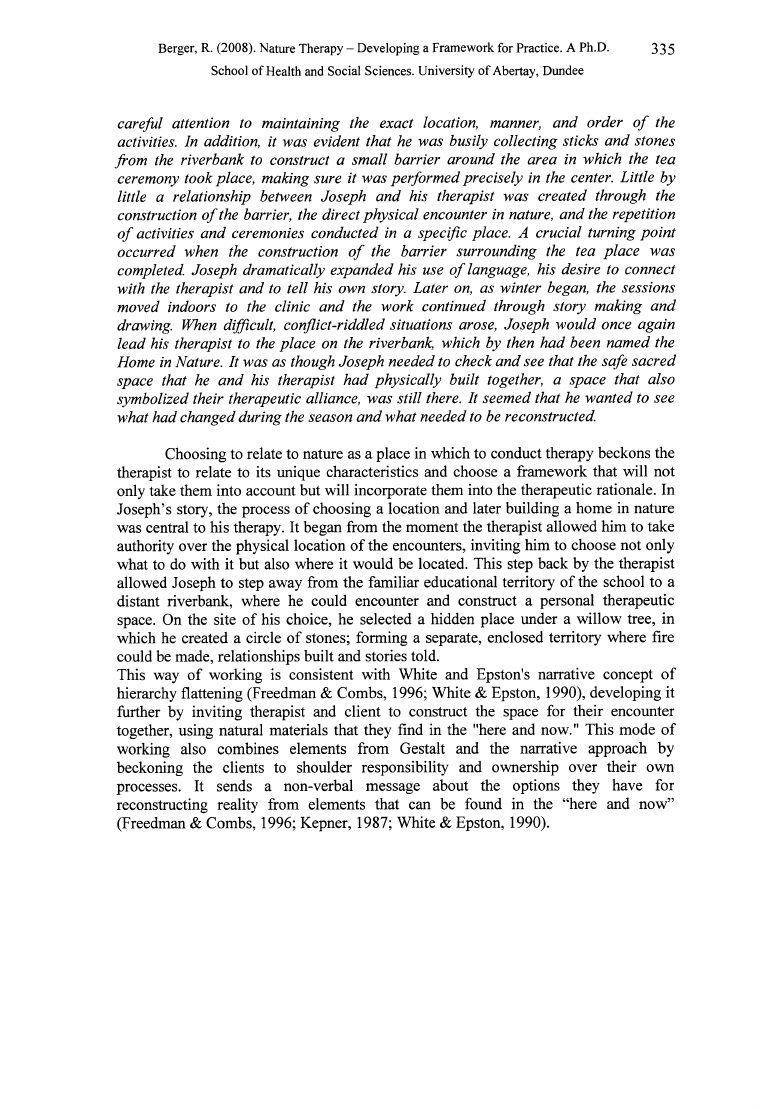
Berger, R. (2008). Nature Therapy - Developing a Framework for Practice. A Ph.D.
335
School of Health and Social Sciences. University of Abertay, Dundee
careful attention to maintaining the exact location, manner, and order o f the
activities. In addition, it was evident that he was busily collecting sticks and stones
from the riverbank to construct a small barrier around the area in which the tea
ceremony took place, making sure it was performed precisely in the center. Little by
little a relationship between Joseph and his therapist was created through the
construction o f the barrier, the direct physical encounter in nature, and the repetition
o f activities and ceremonies conducted in a specific place. A crucial turning point
occurred when the construction o f the barrier surrounding the tea place was
completed. Joseph dramatically expanded his use o f language, his desire to connect
with the therapist and to tell his own story. Later on, as winter began, the sessions
moved indoors to the clinic and the work continued through story making and
drawing. When difficult, conflict-riddled situations arose, Joseph would once again
lead his therapist to the place on the riverbank, which by then had been named the
Home in Nature. It was as though Joseph needed to check and see that the safe sacred
space that he and his therapist had physically built together, a space that also
symbolized their therapeutic alliance, was still there. It seemed that he wanted to see
what had changed during the season and what needed to be reconstructed.
Choosing to relate to nature as a place in which to conduct therapy beckons the
therapist to relate to its unique characteristics and choose a framework that will not
only take them into account but will incorporate them into the therapeutic rationale. In
Joseph’s story, the process of choosing a location and later building a home in nature
was central to his therapy. It began from the moment the therapist allowed him to take
authority over the physical location of the encounters, inviting him to choose not only
what to do with it but also where it would be located. This step back by the therapist
allowed Joseph to step away from the familiar educational territory of the school to a
distant riverbank, where he could encounter and construct a personal therapeutic
space. On the site of his choice, he selected a hidden place under a willow tree, in
which he created a circle of stones; forming a separate, enclosed territory where fire
could be made, relationships built and stories told.
This way of working is consistent with White and Epston's narrative concept of
hierarchy flattening (Freedman & Combs, 1996; White & Epston, 1990), developing it
further by inviting therapist and client to construct the space for their encounter
together, using natural materials that they find in the "here and now." This mode of
working also combines elements from Gestalt and the narrative approach by
beckoning the clients to shoulder responsibility and ownership over their own
processes. It sends a non-verbal message about the options they have for
reconstructing reality from elements that can be found in the “here and now”
(Freedman & Combs, 1996; Kepner, 1987; White & Epston, 1990).
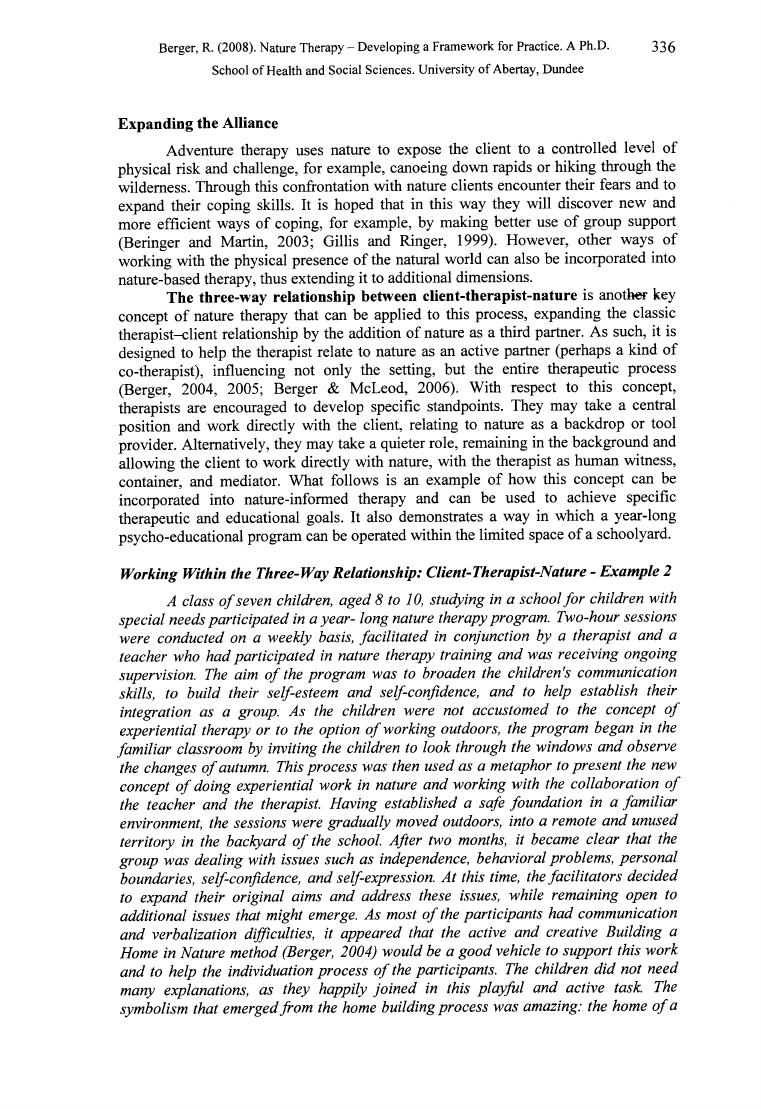
Berger, R. (2008). Nature Therapy - Developing a Framework for Practice. A Ph.D.
336
School of Health and Social Sciences. University of Abertay, Dundee
Expanding the Alliance
Adventure therapy uses nature to expose the client to a controlled level of
physical risk and challenge, for example, canoeing down rapids or hiking through the
wilderness. Through this confrontation with nature clients encounter their fears and to
expand their coping skills. It is hoped that in this way they will discover new and
more efficient ways of coping, for example, by making better use of group support
(Beringer and Martin, 2003; Gillis and Ringer, 1999). However, other ways of
working with the physical presence of the natural world can also be incorporated into
nature-based therapy, thus extending it to additional dimensions.
The three-way relationship between client-therapist-nature is another key
concept of nature therapy that can be applied to this process, expanding the classic
therapist-client relationship by the addition of nature as a third partner. As such, it is
designed to help the therapist relate to nature as an active partner (perhaps a kind of
co-therapist), influencing not only the setting, but the entire therapeutic process
(Berger, 2004, 2005; Berger & McLeod, 2006). With respect to this concept,
therapists are encouraged to develop specific standpoints. They may take a central
position and work directly with the client, relating to nature as a backdrop or tool
provider. Alternatively, they may take a quieter role, remaining in the background and
allowing the client to work directly with nature, with the therapist as human witness,
container, and mediator. What follows is an example of how this concept can be
incorporated into nature-informed therapy and can be used to achieve specific
therapeutic and educational goals. It also demonstrates a way in which a year-long
psycho-educational program can be operated within the limited space of a schoolyard.
W o rk in g W ith in th e T h re e -W a y R e la tio n sh ip : C lie n t-T h e ra p ist-N a tu re - E x a m p le 2
A cla ss o f seven children, a g e d 8 to 10, stu d yin g in a sch o o l f o r ch ild ren w ith
sp e c ia l n eed s p a r tic ip a te d in a y e a r- lo n g n ature th era p y p ro g ra m . T w o-h ou r sessio n s
w ere co n d u cted on a w eek ly basis, fa c ilita te d in con ju n ction by a th e ra p ist a n d a
tea ch er w h o h a d p a r tic ip a te d in n ature th era p y tra in in g a n d w a s re c e iv in g o n g o in g
supervision . The aim o f the p ro g ra m w a s to broaden the children's com m unication
skills, to bu ild their self-esteem a n d self-confidence, a n d to help establish their
integration as a group. A s the children w ere n ot accu stom ed to the con cept o f
ex p erien tia l th era p y o r to the option o f w o rk in g ou tdoors, the p ro g ra m began in the
fa m ilia r classroom by in vitin g the children to lo o k through the w in dow s a n d observe
the chan ges o f autum n. This p ro c e ss w a s then u sed a s a m etaph or to p re se n t the new
co n cep t o f d o in g ex p erien tia l w o rk in nature a n d w o rk in g w ith the c o lla b o ra tio n o f
the tea ch er a n d the th erapist. H a vin g e sta b lish ed a safe fo u n d a tio n in a fa m ilia r
environm ent, the session s w ere gra d u a lly m o ved outdoors, into a rem ote a n d unused
territo ry in the b a c k y a rd o f the school. A fter tw o m onths, it becam e c le a r th a t the
grou p w a s dealin g w ith issues such as independence, beh avioral problem s, p erso n a l
boundaries, self-confiden ce, a n d self-expression. A t this tim e, the fa c ilita to rs d e c id e d
to expan d th eir origin al aim s a n d a d d ress these issues, w h ile rem ain in g open to
a d d itio n a l issues that m ight em erge. A s m ost o f the p a rticip a n ts h a d com m unication
a n d verb a liza tio n difficulties, it a p p ea red th at the a ctive a n d crea tive B u ildin g a
H om e in N atu re m eth od (B erger, 2004) w o u ld be a g o o d veh icle to su p p o rt this w o rk
a n d to help the individuation p ro c e ss o f the p a rticipan ts. The children d id n ot n eed
m any explan ation s, a s th ey h a p p ily jo in e d in th is p la y fu l a n d a c tiv e task. The
sym bolism th at em erged fro m the hom e building p ro c ess w a s am azing: the hom e o f a
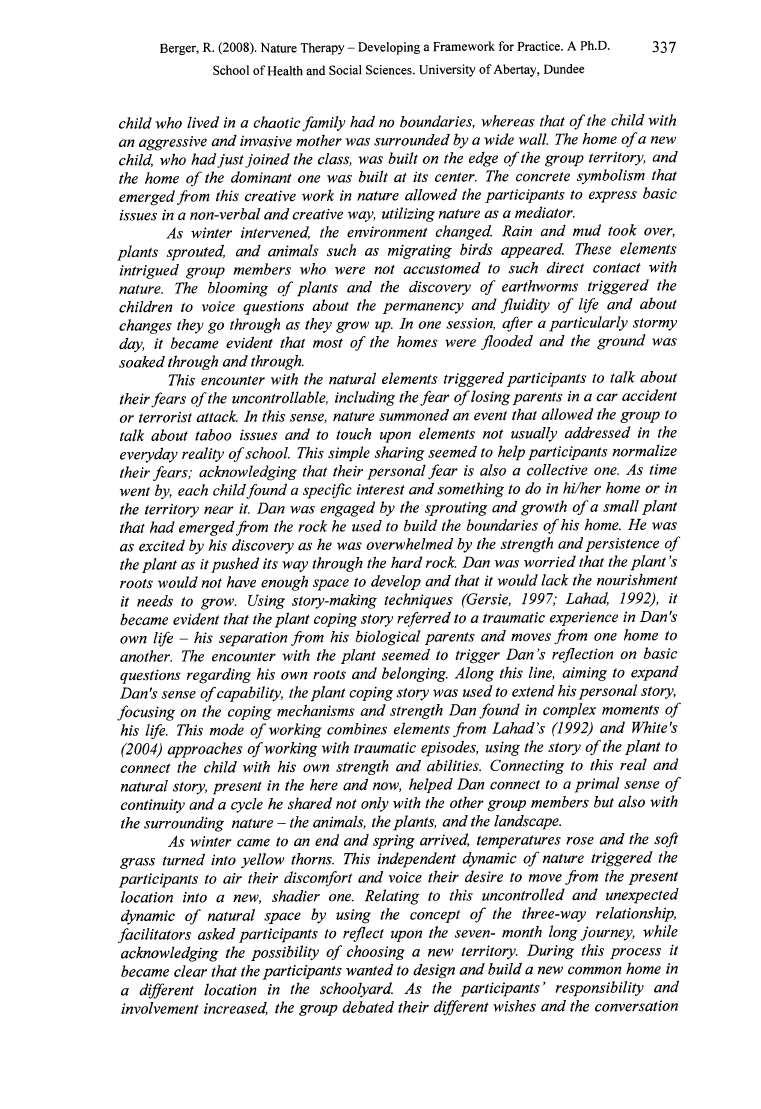
Berger, R. (2008). Nature Therapy - Developing a Framework for Practice. A Ph.D.
337
School of Health and Social Sciences. University of Abertay, Dundee
c h ild w h o liv e d in a ch a o tic fa m ily h a d no bou n daries, w h erea s th a t o f the c h ild w ith
an aggressive an d invasive m other w as su rrou n ded by a w ide w all. The hom e o f a new
child, w ho h a d ju s t jo in e d the class, w a s b u ilt on the edge o f the g ro u p territory, a n d
the hom e o f the dom in an t one w a s bu ilt a t its center. The con crete sym bolism th at
e m e rg e d fro m th is crea tive w o rk in nature a llo w e d the p a rtic ip a n ts to ex p ress b a sic
issu es in a n o n -verb a l a n d crea tive w ay, u tilizin g n atu re a s a m ediator.
A s w in ter intervened, the environm ent changed. R ain a n d m u d to o k over,
p la n ts sprouted, an d anim als such as m igratin g birds appeared. These elem en ts
in trigu ed grou p m em bers w ho w ere not accu sto m ed to such d irect co n ta ct w ith
nature. The bloom in g o f p la n ts a n d the d isco very o f earth w orm s trig g e red the
children to vo ice qu estion s abou t the p erm a n en cy a n d flu id ity o f life a n d ab o u t
changes they g o through as they g ro w up. In one session, after a p a rtic u la rly sto rm y
day, it becam e eviden t that m ost o f the hom es w ere flo o d e d a n d the g ro u n d w as
so a k ed through a n d through.
This encounter w ith the n atu ral elem en ts trig g e re d p a rtic ip a n ts to ta lk a b o u t
th eir fe a r s o f the uncontrollable, in clu din g the f e a r o f lo sin g p a re n ts in a ca r a ccid en t
o r terro rist attack. In this sense, nature su m m on ed an even t th at a llo w ed the g ro u p to
ta lk a b o u t ta b o o issu es a n d to touch upon elem en ts n o t u su ally a d d re sse d in the
everyd a y rea lity o f school. This sim ple sh arin g seem ed to help p a rticip a n ts n orm alize
their fea rs; ackn ow ledgin g that their p erso n a l fe a r is also a collective one. A s tim e
w en t by, each c h ild fo u n d a sp ecific in terest a n d so m eth in g to do in h i/h er hom e o r in
th e te r r ito r y n e a r it. D a n w a s e n g a g e d b y th e s p r o u tin g a n d g r o w th o f a s m a ll p la n t
that h ad em erg ed fro m the ro ck he u sed to b u ild the bou n daries o f his home. H e w a s
a s ex cited by his d isco very as he w a s o verw h elm ed by the stren gth a n d p e rsiste n c e o f
th e p l a n t a s it p u s h e d its w a y th r o u g h th e h a r d ro ck . D a n w a s w o r r i e d th a t th e p l a n t ’s
ro o ts w o u ld not have enough space to d evelop a n d th at it w o u ld lack the nourishm ent
it needs to grow . U sing story-m aking techniques (G ersie, 1997; Lahad, 1992), it
becam e eviden t th a t the p la n t copin g sto ry re fe rred to a trau m atic experience in D an's
ow n life - his separation fro m his b io lo g ica l p a ren ts a n d m oves fro m one hom e to
a n o th e r. T he e n c o u n te r w ith th e p l a n t s e e m e d to tr ig g e r D a n ’s r e fle c tio n o n b a s ic
qu estion s re g a rd in g his ow n ro o ts a n d belon ging. A lo n g th is line, aim in g to ex p a n d
D a n ’s s e n s e o f c a p a b ility , th e p l a n t c o p in g s to r y w a s u s e d to e x te n d h is p e r s o n a l s to r y ,
fo c u sin g on the c o p in g m echan ism s a n d stren gth D a n fo u n d in com plex m om en ts o f
h is life. T h is m o d e o f w o r k in g c o m b in e s e le m e n ts f r o m L a h a d ’s (1 9 9 2 ) a n d W h ite ’s
(2004) ap p ro a ch es o f w orkin g w ith trau m atic episodes, using the sto ry o f the p la n t to
connect the ch ild w ith his ow n strength a n d abilities. C on necting to this rea l a n d
n atu ral story, p re se n t in the here a n d now, h e lp ed D an con n ect to a p rim a l sen se o f
continu ity a n d a cycle he sh a red not only w ith the other grou p m em bers but a lso w ith
the surrounding nature — the anim als, the plan ts, a n d the landscape.
A s w inter cam e to an en d an d sprin g arrived, tem peratures rose an d the soft
g ra ss tu rn ed into y e llo w thorns. This in depen den t dynam ic o f nature trig g e re d the
p a rticip a n ts to a ir their discom fort a n d voice th eir desire to m ove fro m the p re se n t
location into a new, sh adier one. R elatin g to this u n con trolled a n d u n expected
dynam ic o f natural space by using the con cept o f the th ree-w ay relation sh ip,
fa c ilita to rs a sk ed p a rticip a n ts to reflect upon the seven - m onth lon g jo u rn ey, w h ile
acknow ledgin g the p o ssib ility o f choosin g a new territory. D u rin g this p ro c e ss it
b eca m e c le a r th a t the p a r tic ip a n ts w a n te d to d esig n a n d b u ild a n ew com m on hom e in
a differen t location in the sch oolyard. A s the p a rtic ip a n ts ’ resp o n sib ility a n d
involvem ent increased, the grou p d eb a ted their different w ish es a n d the con versation
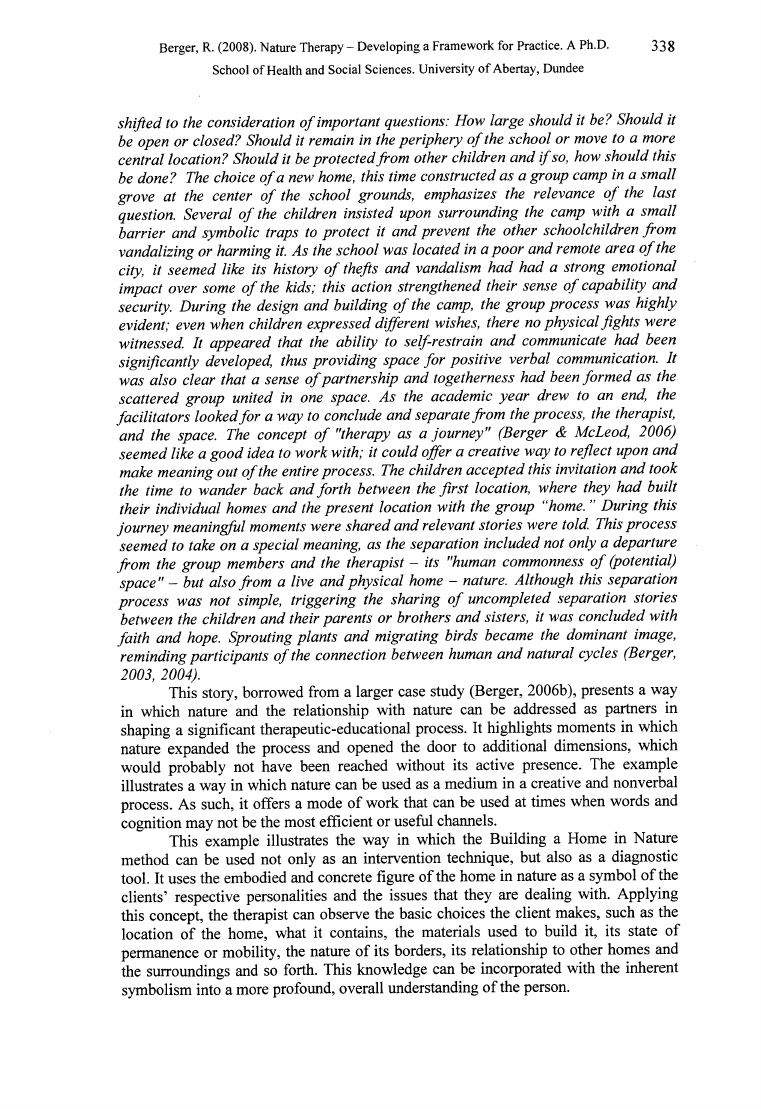
Berger, R. (2008). Nature Therapy - Developing a Framework for Practice. A Ph.D.
338
School of Health and Social Sciences. University of Abertay, Dundee
sh ifted to the consideration o f im portant questions: H ow la rg e sh ou ld it be? S h ou ld it
be open o r clo sed ? S h ou ld it rem ain in the p e rip h e ry o f the sch o o l o r m ove to a m ore
central location? Should it be p ro te c te d fro m other children an d if so, how sh ou ld this
be don e? The ch oice o f a new hom e, th is tim e co n stru cted a s a g ro u p cam p in a sm a ll
g ro ve a t the cen ter o f the sch o o l grounds, em ph asizes the relevan ce o f the la st
question. S evera l o f the children in sisted upon su rrou n din g the cam p w ith a sm a ll
b a rrier a n d sym bolic tra p s to p r o te c t it a n d p reven t the oth er sch oolch ildren fro m
v a n d a liz in g o r h a rm in g it. A s th e s c h o o l w a s lo c a te d in a p o o r a n d r e m o te a r e a o f th e
city, it seem ed like its h istory o f thefts a n d vandalism h a d h a d a stro n g em otion al
im pact o ver som e o f the kids; this action stren gth en ed th eir sense o f ca p a b ility a n d
secu rity. D u rin g the design a n d bu ildin g o f the cam p, the g ro u p p ro c ess w a s h igh ly
evident; even w hen children expressed different wishes, there no p h ysica l fig h ts w ere
w itnessed. It a p p ea red that the a b ility to self-restrain a n d com m unicate h a d been
sign ifican tly developed, thus p ro v id in g sp a ce f o r p o sitiv e verb a l com m unication. It
w as also clear th at a sense o f p a rtn ersh ip a n d togeth ern ess h a d been fo rm e d a s the
sc a tte re d g ro u p u n ited in one sp a ce. A s the a c a d em ic y e a r d rew to an end, the
fa cilita to rs lo o k ed fo r a w a y to conclude a n d separate fro m the process, the therapist,
a n d the space. The con cept o f "therapy a s a jo u rn ey" (B erger & M cLeod, 2006)
seem ed like a g o o d idea to w ork w ith; it co u ld offer a crea tive w a y to reflect upon a n d
m ake m ean in g out o f the entire p ro cess. The children a c c e p te d this invitation a n d took
the tim e to w an der back a n d fo rth betw een the fir s t location , w h ere they h a d bu ilt
th e ir in d iv id u a l h o m es a n d th e p r e s e n t lo c a tio n w ith th e g r o u p “hom e. ” D u rin g th is
jo u rn e y m eaningful m om ents w ere sh a re d a n d releva n t sto rie s w ere told. This p ro c e ss
seem ed to take on a sp ecia l m eaning, a s the separation in clu d ed n ot only a d ep artu re
fro m the g ro u p m em bers a n d the th era p ist - its "human com m onness o f (poten tial)
space" - but also fro m a live a n d p h y sic a l hom e - nature. A lthough this separation
p ro c ess w a s not sim ple, triggerin g the sh arin g o f u n com pleted separation sto ries
betw een the children a n d their p a re n ts o r broth ers a n d sisters, it w as con clu ded w ith
fa ith a n d hope. S prou tin g p la n ts a n d m igratin g b irds becam e the dom in an t im age,
rem indin g p a rticip a n ts o f the connection betw een hum an a n d natural cycles (B erger,
2003, 2004).
This story, borrowed from a larger case study (Berger, 2006b), presents a way
in which nature and the relationship with nature can be addressed as partners in
shaping a significant therapeutic-educational process. It highlights moments in which
nature expanded the process and opened the door to additional dimensions, which
would probably not have been reached without its active presence. The example
illustrates a way in which nature can be used as a medium in a creative and nonverbal
process. As such, it offers a mode of work that can be used at times when words and
cognition may not be the most efficient or useful channels.
This example illustrates the way in which the Building a Home in Nature
method can be used not only as an intervention technique, but also as a diagnostic
tool. It uses the embodied and concrete figure of the home in nature as a symbol of the
clients’ respective personalities and the issues that they are dealing with. Applying
this concept, the therapist can observe the basic choices the client makes, such as the
location of the home, what it contains, the materials used to build it, its state of
permanence or mobility, the nature of its borders, its relationship to other homes and
the surroundings and so forth. This knowledge can be incorporated with the inherent
symbolism into a more profound, overall understanding of the person.
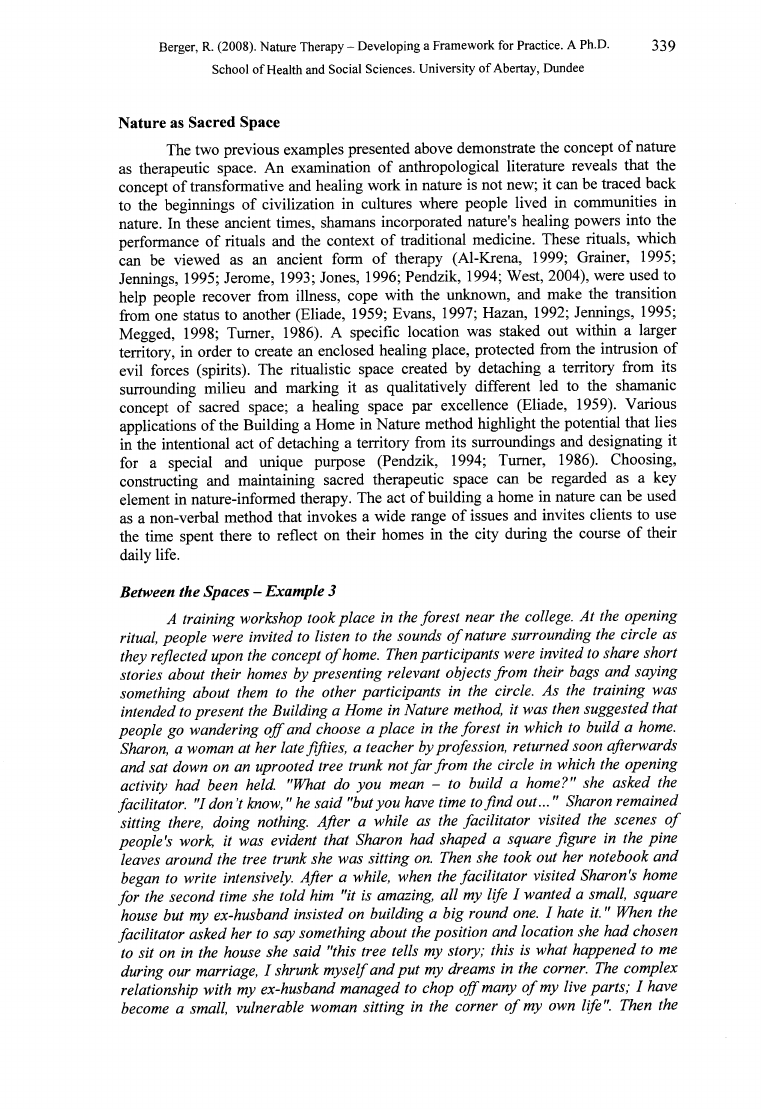
Berger, R. (2008). Nature Therapy - Developing a Framework for Practice. A Ph.D.
339
School of Health and Social Sciences. University of Abertay, Dundee
Nature as Sacred Space
The two previous examples presented above demonstrate the concept of nature
as therapeutic space. An examination of anthropological literature reveals that the
concept of transformative and healing work in nature is not new; it can be traced back
to the beginnings of civilization in cultures where people lived in communities in
nature. In these ancient times, shamans incorporated nature's healing powers into the
performance of rituals and the context of traditional medicine. These rituals, which
can be viewed as an ancient form of therapy (Al-Krena, 1999; Grainer, 1995;
Jennings, 1995; Jerome, 1993; Jones, 1996; Pendzik, 1994; West, 2004), were used to
help people recover from illness, cope with the unknown, and make the transition
from one status to another (Eliade, 1959; Evans, 1997; Hazan, 1992; Jennings, 1995;
Megged, 1998; Turner, 1986). A specific location was staked out within a larger
territory, in order to create an enclosed healing place, protected from the intrusion of
evil forces (spirits). The ritualistic space created by detaching a territory from its
surrounding milieu and marking it as qualitatively different led to the shamanic
concept of sacred space; a healing space par excellence (Eliade, 1959). Various
applications of the Building a Home in Nature method highlight the potential that lies
in the intentional act of detaching a territory from its surroundings and designating it
for a special and unique purpose (Pendzik, 1994; Turner, 1986). Choosing,
constructing and maintaining sacred therapeutic space can be regarded as a key
element in nature-informed therapy. The act of building a home in nature can be used
as a non-verbal method that invokes a wide range of issues and invites clients to use
the time spent there to reflect on their homes in the city during the course of their
daily life.
B e tw e e n th e S p a c e s - E x a m p le 3
A tra in in g w ork sh o p to o k p la c e in the fo r e s t n ear the college. A t the o p en in g
ritual, p e o p le w ere in vited to listen to the sounds o f nature su rrou n din g the circle as
they reflected upon the con cept o f hom e. Then p a rticip a n ts w ere in vited to sh are sh o rt
stories about their hom es by presen tin g relevant objects fro m their bags an d sayin g
som eth in g a b o u t them to the o th er p a rtic ip a n ts in the circle. A s the tra in in g w a s
in ten ded to p re se n t the B u ildin g a H om e in N atu re m ethod, it w a s then su g g e ste d th a t
p e o p le g o w a n d erin g o f f a n d ch oose a p la c e in the fo r e s t in w h ich to b u ild a hom e.
Sharon, a w om an a t her late fifties, a teacher by profession , retu rn ed soon afterw ards
a n d sa t do w n on an u p ro o ted tree tru nk n ot f a r fro m the c ircle in w h ich the o p en in g
activity h a d been held. "What do y o u m ean - to b u ild a hom e?" she a sk ed the
f a c ilita to r . "I d o n ’t k n o w ," h e s a i d "but y o u h a v e tim e to f i n d o u t . . . " S h a ro n r e m a in e d
sittin g there, d o in g nothing. A fter a w h ile a s the fa c ilita to r v isite d the scen es o f
p e o p l e ’s w o rk , it w a s e v id e n t th a t S h a r o n h a d s h a p e d a s q u a r e f ig u r e in th e p in e
leaves a rou n d the tree trunk she w a s sittin g on. Then she to o k ou t her n o teb o o k a n d
b e g a n to w r ite in te n s iv e ly . A f te r a w h ile , w h e n th e f a c i l i t a t o r v is ite d S h a r o n ’s h o m e
f o r the s e c o n d tim e sh e to ld h im "it is a m a zin g , a ll m y life I w a n te d a sm a ll, s q u a re
house but m y ex-h usband in sisted on building a b ig rou n d one. I hate it." W hen the
fa cilita to r a sk ed her to sa y som eth in g abou t the p o sitio n a n d location she h a d chosen
to s it on in the house sh e s a id "this tree tells m y sto ry; th is is w h a t h a p p e n e d to m e
during our m arriage, I shrunk m y se lf a n d p u t m y drea m s in the corner. The com plex
relationship w ith m y ex-husband m anaged to chop o ff m any o f m y live p a rts; I have
b ecom e a sm all, vu ln era b le w o m a n sittin g in the c o rn e r o f m y ow n life". Then the
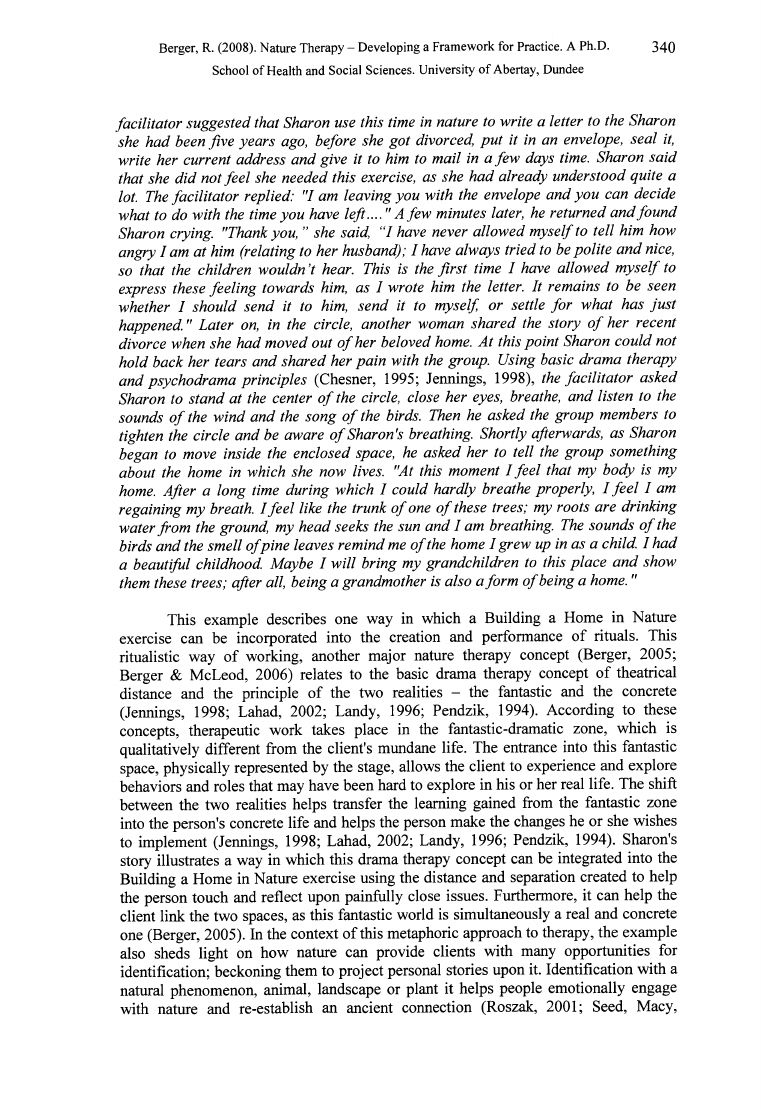
Berger, R. (2008). Nature Therapy - Developing a Framework for Practice. A Ph.D.
340
School of Health and Social Sciences. University of Abertay, Dundee
fa c ilita to r s u g g e ste d th a t Sh aron use th is tim e in n atu re to w rite a lette r to the Sh aron
sh e h a d b e e n f i v e y e a r s ago, b e fo r e sh e g o t d iv o rc e d , p u t it in an e n v e lo p e , s e a l it,
w rite h er cu rren t a d d re ss a n d g iv e it to him to m a il in a f e w d a ys tim e. S h aron s a id
that she d id n ot fe e l she n eeded this exercise, as she h ad already understood quite a
lot. The f a c ilita to r r e p lie d : "I a m le a v in g y o u w ith th e e n v e lo p e a n d y o u c a n d e c id e
w h at to do w ith the tim e yo u have left.... "A fe w m inutes later, he retu rn ed a n d fo u n d
S h a r o n c r y in g . "Thank y o u , ” s h e sa id , “I h a v e n e v e r a l lo w e d m y s e l f to t e ll h im h o w
an gry I am a t him (relatin g to h er husband); I have a lw a ys trie d to be p o lite a n d nice,
s o th a t th e c h ild r e n w o u l d n ’t h e a r. T h is is th e f i r s t tim e I h a v e a l lo w e d m y s e l f to
express th ese fe e lin g to w a rd s him, a s I w ro te him the letter. It rem ain s to be seen
w h eth er I sh o u ld se n d it to him, se n d it to m yself, o r settle f o r w h a t h as ju s t
h a p p en ed ." L a ter on, in the circle, an oth er w om an sh a re d the sto ry o f h er recen t
divorce when she had m oved out o f her beloved home. A t this p o in t Sharon co u ld not
h o ld back her tea rs a n d sh a red her p a in w ith the group. U sing basic d ra m a th era p y
a n d p s y c h o d r a m a p r in c ip le s (Chesner, 1995; Jennings, 1998), th e f a c i l it a to r a s k e d
Sharon to sta n d a t the cen ter o f the circle, close h er eyes, breathe, a n d listen to the
sou n ds o f the w in d a n d the so n g o f the birds. Then he a sk e d the g ro u p m em b ers to
tighten the circle a n d be aw are o f Sharon's breathing. S h ortly afterw ards, as Sharon
began to m ove inside the en clo sed space, he a sk ed her to tell the gro u p som eth in g
a b o u t the h om e in w h ich sh e n o w lives. "At this m o m en t I f e e l th a t m y b o d y is m y
home. A fter a long tim e du rin g w hich I cou ld h ardly breathe p roperly, I f e e l I am
regain in g m y breath. I f e e l like the trunk o f one o f these trees; m y ro o ts are drin kin g
w a ter fro m the ground, m y h ea d seeks the sun a n d I am breathing. The sou n ds o f the
b ird s a n d the sm ell o fp in e lea ves rem in d m e o f the hom e I g re w up in a s a child. I h a d
a beautiful childhood. M aybe I w ill brin g m y gran dch ildren to this p la c e a n d sh ow
them these trees; after all, bein g a gran dm oth er is a lso a fo rm o f bein g a hom e. "
This example describes one way in which a Building a Home in Nature
exercise can be incorporated into the creation and performance of rituals. This
ritualistic way of working, another major nature therapy concept (Berger, 2005;
Berger & McLeod, 2006) relates to the basic drama therapy concept of theatrical
distance and the principle of the two realities - the fantastic and the concrete
(Jennings, 1998; Lahad, 2002; Landy, 1996; Pendzik, 1994). According to these
concepts, therapeutic work takes place in the fantastic-dramatic zone, which is
qualitatively different from the client's mundane life. The entrance into this fantastic
space, physically represented by the stage, allows the client to experience and explore
behaviors and roles that may have been hard to explore in his or her real life. The shift
between the two realities helps transfer the learning gained from the fantastic zone
into the person's concrete life and helps the person make the changes he or she wishes
to implement (Jennings, 1998; Lahad, 2002; Landy, 1996; Pendzik, 1994). Sharon's
story illustrates a way in which this drama therapy concept can be integrated into the
Building a Home in Nature exercise using the distance and separation created to help
the person touch and reflect upon painfully close issues. Furthermore, it can help the
client link the two spaces, as this fantastic world is simultaneously a real and concrete
one (Berger, 2005). In the context of this metaphoric approach to therapy, the example
also sheds light on how nature can provide clients with many opportunities for
identification; beckoning them to project personal stories upon it. Identification with a
natural phenomenon, animal, landscape or plant it helps people emotionally engage
with nature and re-establish an ancient connection (Roszak, 2001; Seed, Macy,
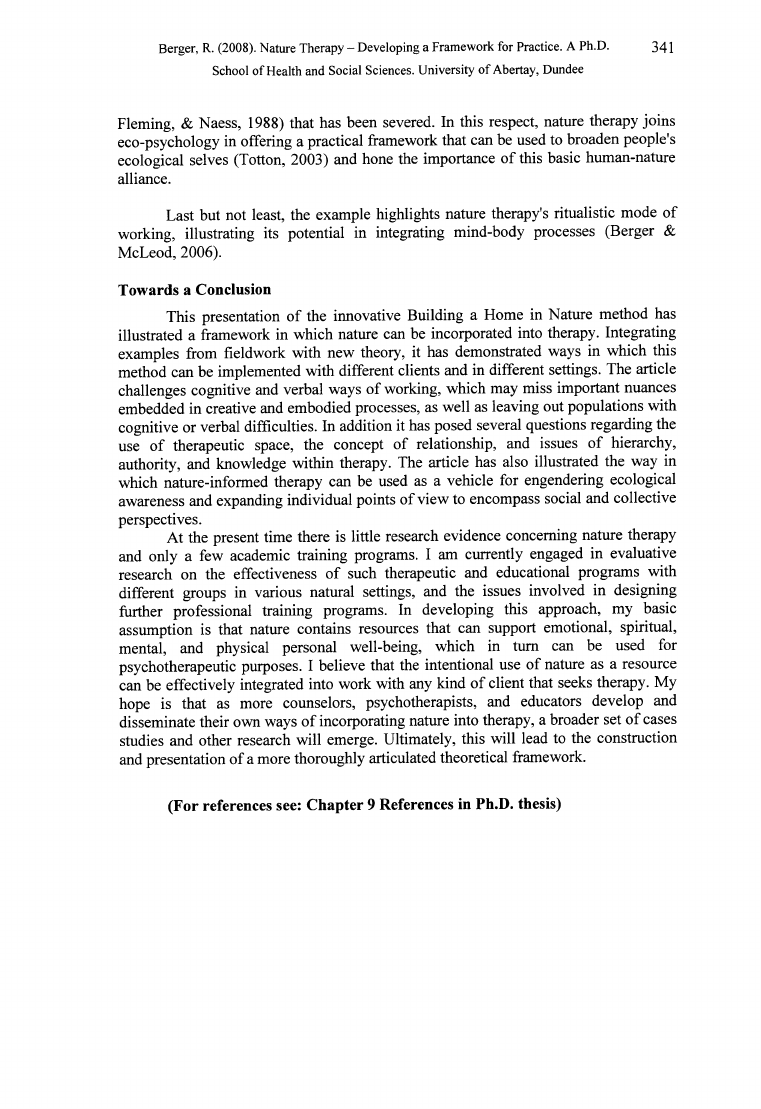
Berger, R. (2008). Nature Therapy - Developing a Framework for Practice. A Ph.D.
341
School of Health and Social Sciences. University of Abertay, Dundee
Fleming, & Naess, 1988) that has been severed. In this respect, nature therapy joins
eco-psychology in offering a practical framework that can be used to broaden people's
ecological selves (Totton, 2003) and hone the importance of this basic human-nature
alliance.
Last but not least, the example highlights nature therapy's ritualistic mode of
working, illustrating its potential in integrating mind-body processes (Berger &
McLeod, 2006).
Towards a Conclusion
This presentation of the innovative Building a Home in Nature method has
illustrated a framework in which nature can be incorporated into therapy. Integrating
examples from fieldwork with new theory, it has demonstrated ways in which this
method can be implemented with different clients and in different settings. The article
challenges cognitive and verbal ways of working, which may miss important nuances
embedded in creative and embodied processes, as well as leaving out populations with
cognitive or verbal difficulties. In addition it has posed several questions regarding the
use of therapeutic space, the concept of relationship, and issues of hierarchy,
authority, and knowledge within therapy. The article has also illustrated the way in
which nature-informed therapy can be used as a vehicle for engendering ecological
awareness and expanding individual points of view to encompass social and collective
perspectives.
At the present time there is little research evidence concerning nature therapy
and only a few academic training programs. I am currently engaged in evaluative
research on the effectiveness of such therapeutic and educational programs with
different groups in various natural settings, and the issues involved in designing
further professional training programs. In developing this approach, my basic
assumption is that nature contains resources that can support emotional, spiritual,
mental, and physical personal well-being, which in turn can be used for
psychotherapeutic purposes. I believe that the intentional use of nature as a resource
can be effectively integrated into work with any kind of client that seeks therapy. My
hope is that as more counselors, psychotherapists, and educators develop and
disseminate their own ways of incorporating nature into therapy, a broader set of cases
studies and other research will emerge. Ultimately, this will lead to the construction
and presentation of a more thoroughly articulated theoretical framework.
(For references see: Chapter 9 References in Ph.D. thesis)
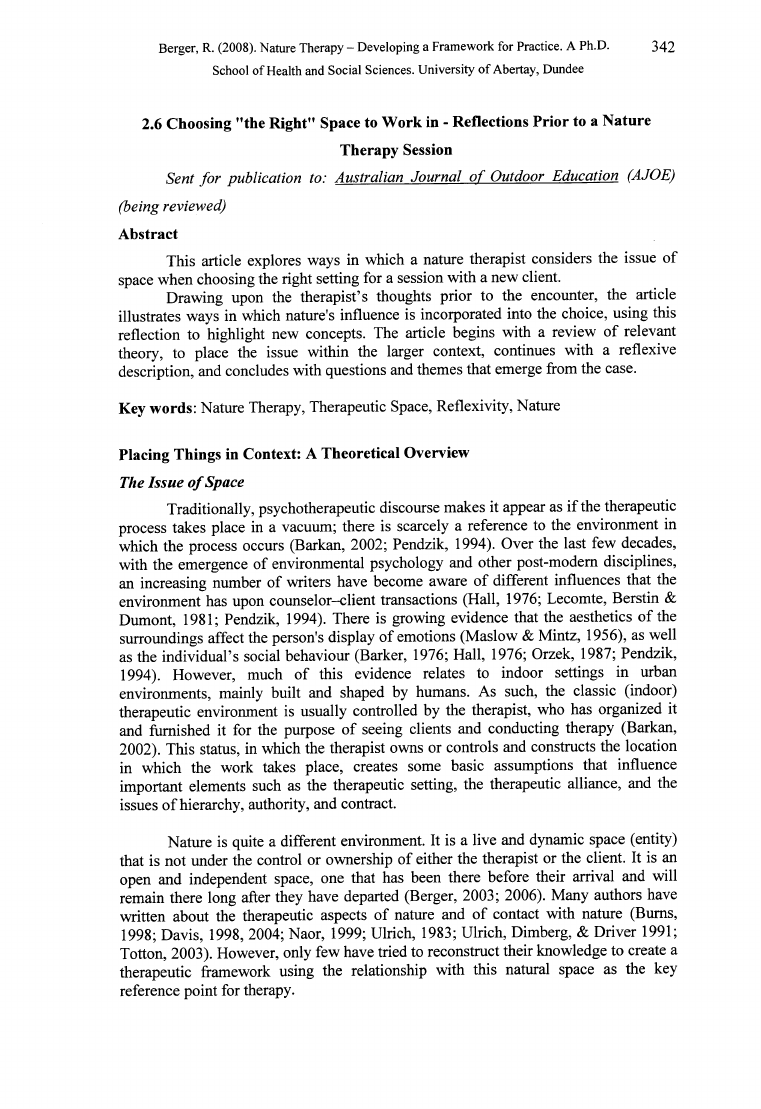
Berger, R. (2008). Nature Therapy - Developing a Framework for Practice. A Ph.D.
342
School of Health and Social Sciences. University of Abertay, Dundee
2.6 Choosing "the Right" Space to Work in - Reflections Prior to a Nature
Therapy Session
S en t f o r pu blication to: A u stralian Journal o f O u tdoor E du cation (AJOE)
(being review ed)
Abstract
This article explores ways in which a nature therapist considers the issue of
space when choosing the right setting for a session with a new client.
Drawing upon the therapist’s thoughts prior to the encounter, the article
illustrates ways in which nature's influence is incorporated into the choice, using this
reflection to highlight new concepts. The article begins with a review of relevant
theory, to place the issue within the larger context, continues with a reflexive
description, and concludes with questions and themes that emerge from the case.
Key words: Nature Therapy, Therapeutic Space, Reflexivity, Nature
Placing Things in Context: A Theoretical Overview
The Issu e o f Space
Traditionally, psychotherapeutic discourse makes it appear as if the therapeutic
process takes place in a vacuum; there is scarcely a reference to the environment in
which the process occurs (Barkan, 2002; Pendzik, 1994). Over the last few decades,
with the emergence of environmental psychology and other post-modern disciplines,
an increasing number of writers have become aware of different influences that the
environment has upon counselor-client transactions (Hall, 1976; Lecomte, Berstin &
Dumont, 1981; Pendzik, 1994). There is growing evidence that the aesthetics of the
surroundings affect the person's display of emotions (Maslow & Mintz, 1956), as well
as the individual’s social behaviour (Barker, 1976; Hall, 1976; Orzek, 1987; Pendzik,
1994). However, much of this evidence relates to indoor settings in urban
environments, mainly built and shaped by humans. As such, the classic (indoor)
therapeutic environment is usually controlled by the therapist, who has organized it
and furnished it for the purpose of seeing clients and conducting therapy (Barkan,
2002). This status, in which the therapist owns or controls and constructs the location
in which the work takes place, creates some basic assumptions that influence
important elements such as the therapeutic setting, the therapeutic alliance, and the
issues of hierarchy, authority, and contract.
Nature is quite a different environment. It is a live and dynamic space (entity)
that is not under the control or ownership of either the therapist or the client. It is an
open and independent space, one that has been there before their arrival and will
remain there long after they have departed (Berger, 2003; 2006). Many authors have
written about the therapeutic aspects of nature and of contact with nature (Bums,
1998; Davis, 1998, 2004; Naor, 1999; Ulrich, 1983; Ulrich, Dimberg, & Driver 1991;
Totton, 2003). However, only few have tried to reconstruct their knowledge to create a
therapeutic framework using the relationship with this natural space as the key
reference point for therapy.
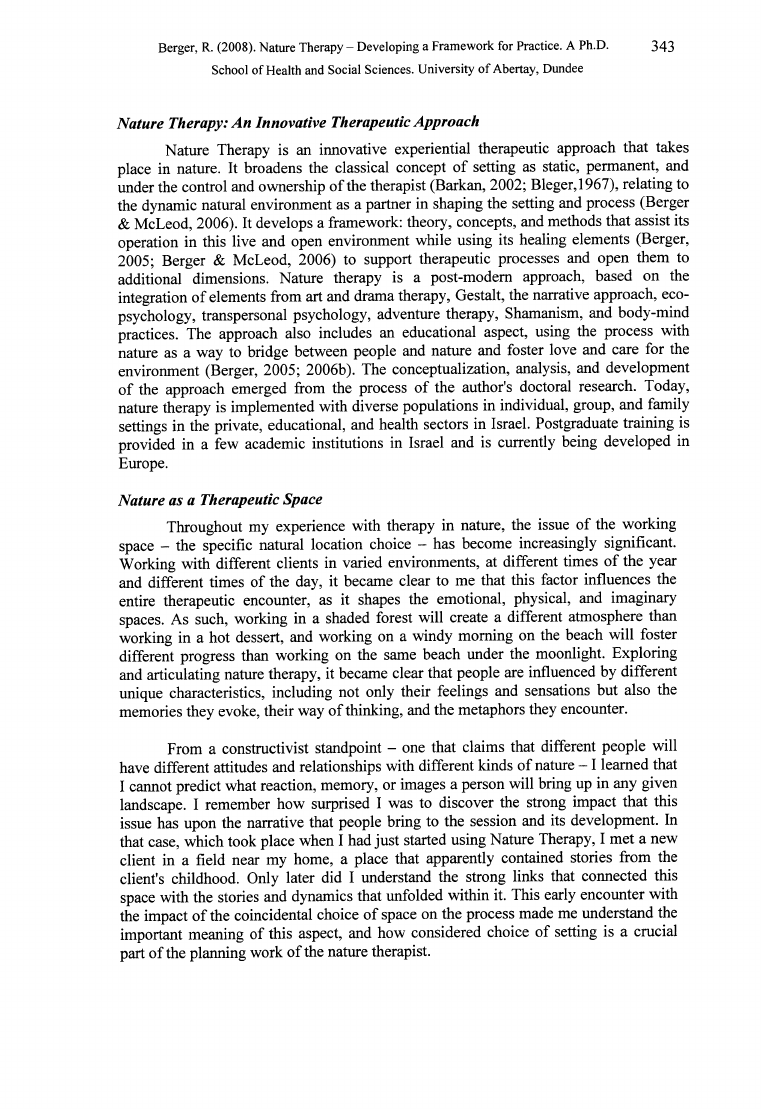
Berger, R. (2008). Nature Therapy - Developing a Framework for Practice. A Ph.D.
343
School of Health and Social Sciences. University of Abertay, Dundee
N a tu re T h e ra p y : A n In n o v a tiv e T h e ra p e u tic A p p ro a c h
Nature Therapy is an innovative experiential therapeutic approach that takes
place in nature. It broadens the classical concept of setting as static, permanent, and
under the control and ownership of the therapist (Barkan, 2002; Bleger,1967), relating to
the dynamic natural environment as a partner in shaping the setting and process (Berger
& McLeod, 2006). It develops a framework: theory, concepts, and methods that assist its
operation in this live and open environment while using its healing elements (Berger,
2005; Berger & McLeod, 2006) to support therapeutic processes and open them to
additional dimensions. Nature therapy is a post-modern approach, based on the
integration of elements from art and drama therapy, Gestalt, the narrative approach, eco-
psychology, transpersonal psychology, adventure therapy, Shamanism, and body-mind
practices. The approach also includes an educational aspect, using the process with
nature as a way to bridge between people and nature and foster love and care for the
environment (Berger, 2005; 2006b). The conceptualization, analysis, and development
of the approach emerged from the process of the author's doctoral research. Today,
nature therapy is implemented with diverse populations in individual, group, and family
settings in the private, educational, and health sectors in Israel. Postgraduate training is
provided in a few academic institutions in Israel and is currently being developed in
Europe.
N a tu re a s a T h e ra p e u tic S p a c e
Throughout my experience with therapy in nature, the issue of the working
space - the specific natural location choice - has become increasingly significant.
Working with different clients in varied environments, at different times of the year
and different times of the day, it became clear to me that this factor influences the
entire therapeutic encounter, as it shapes the emotional, physical, and imaginary
spaces. As such, working in a shaded forest will create a different atmosphere than
working in a hot dessert, and working on a windy morning on the beach will foster
different progress than working on the same beach under the moonlight. Exploring
and articulating nature therapy, it became clear that people are influenced by different
unique characteristics, including not only their feelings and sensations but also the
memories they evoke, their way of thinking, and the metaphors they encounter.
From a constructivist standpoint —one that claims that different people will
have different attitudes and relationships with different kinds of nature - 1learned that
I cannot predict what reaction, memory, or images a person will bring up in any given
landscape. I remember how surprised I was to discover the strong impact that this
issue has upon the narrative that people bring to the session and its development. In
that case, which took place when I had just started using Nature Therapy, I met a new
client in a field near my home, a place that apparently contained stories from the
client’s childhood. Only later did I understand the strong links that connected this
space with the stories and dynamics that unfolded within it. This early encounter with
the impact of the coincidental choice of space on the process made me understand the
important meaning of this aspect, and how considered choice of setting is a crucial
part of the planning work of the nature therapist.
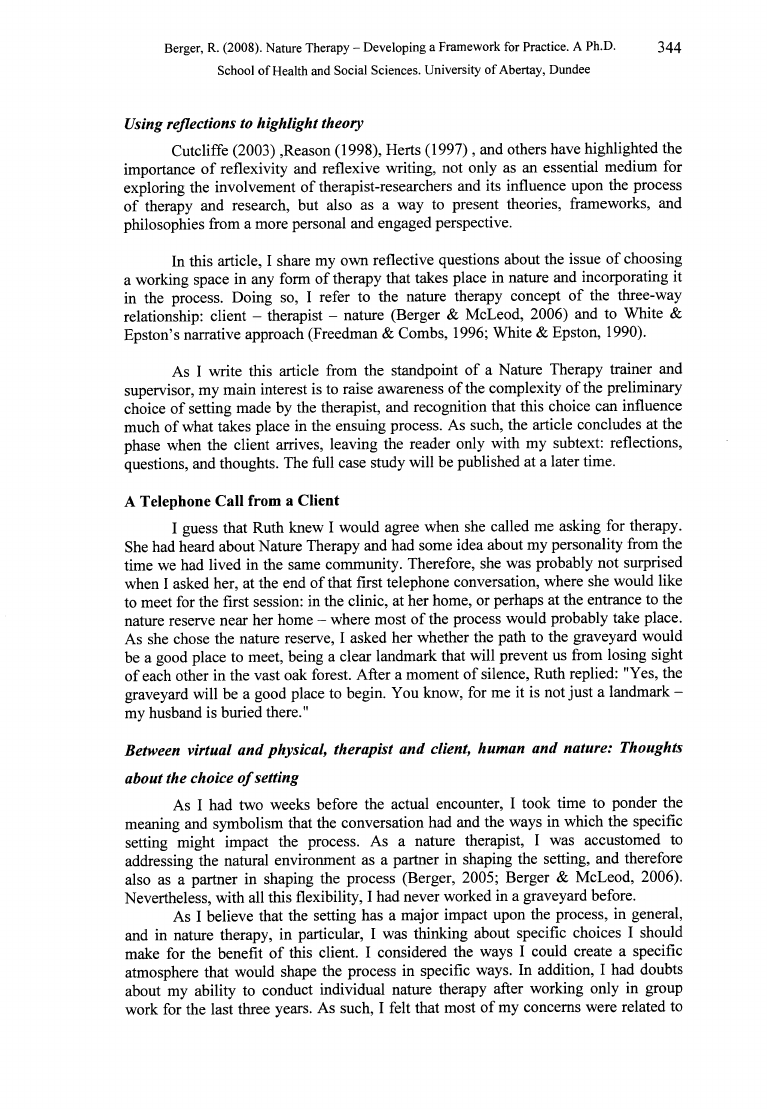
Berger, R. (2008). Nature Therapy - Developing a Framework for Practice. A Ph.D.
344
School of Health and Social Sciences. University of Abertay, Dundee
U sin g re fle c tio n s to h ig h lig h t th e o ry
Cutcliffe (2003),Reason (1998), Herts (1997), and others have highlighted the
importance of reflexivity and reflexive writing, not only as an essential medium for
exploring the involvement of therapist-researchers and its influence upon the process
of therapy and research, but also as a way to present theories, frameworks, and
philosophies from a more personal and engaged perspective.
In this article, I share my own reflective questions about the issue of choosing
a working space in any form of therapy that takes place in nature and incorporating it
in the process. Doing so, I refer to the nature therapy concept of the three-way
relationship: client - therapist - nature (Berger & McLeod, 2006) and to White &
Epston’s narrative approach (Freedman & Combs, 1996; White & Epston, 1990).
As I write this article from the standpoint of a Nature Therapy trainer and
supervisor, my main interest is to raise awareness of the complexity of the preliminary
choice of setting made by the therapist, and recognition that this choice can influence
much of what takes place in the ensuing process. As such, the article concludes at the
phase when the client arrives, leaving the reader only with my subtext: reflections,
questions, and thoughts. The full case study will be published at a later time.
A Telephone Call from a Client
I guess that Ruth knew I would agree when she called me asking for therapy.
She had heard about Nature Therapy and had some idea about my personality from the
time we had lived in the same community. Therefore, she was probably not surprised
when I asked her, at the end of that first telephone conversation, where she would like
to meet for the first session: in the clinic, at her home, or perhaps at the entrance to the
nature reserve near her home - where most of the process would probably take place.
As she chose the nature reserve, I asked her whether the path to the graveyard would
be a good place to meet, being a clear landmark that will prevent us from losing sight
of each other in the vast oak forest. After a moment of silence, Ruth replied: "Yes, the
graveyard will be a good place to begin. You know, for me it is not just a landmark -
my husband is buried there."
B e tw e e n v irtu a l a n d p h y sic a l, th e ra p ist a n d c lie n t, h u m a n a n d n a tu re: T h o u g h ts
a b o u t th e c h o ic e o f se ttin g
As I had two weeks before the actual encounter, I took time to ponder the
meaning and symbolism that the conversation had and the ways in which the specific
setting might impact the process. As a nature therapist, I was accustomed to
addressing the natural environment as a partner in shaping the setting, and therefore
also as a partner in shaping the process (Berger, 2005; Berger & McLeod, 2006).
Nevertheless, with all this flexibility, I had never worked in a graveyard before.
As I believe that the setting has a major impact upon the process, in general,
and in nature therapy, in particular, I was thinking about specific choices I should
make for the benefit of this client. I considered the ways I could create a specific
atmosphere that would shape the process in specific ways. In addition, I had doubts
about my ability to conduct individual nature therapy after working only in group
work for the last three years. As such, I felt that most of my concerns were related to
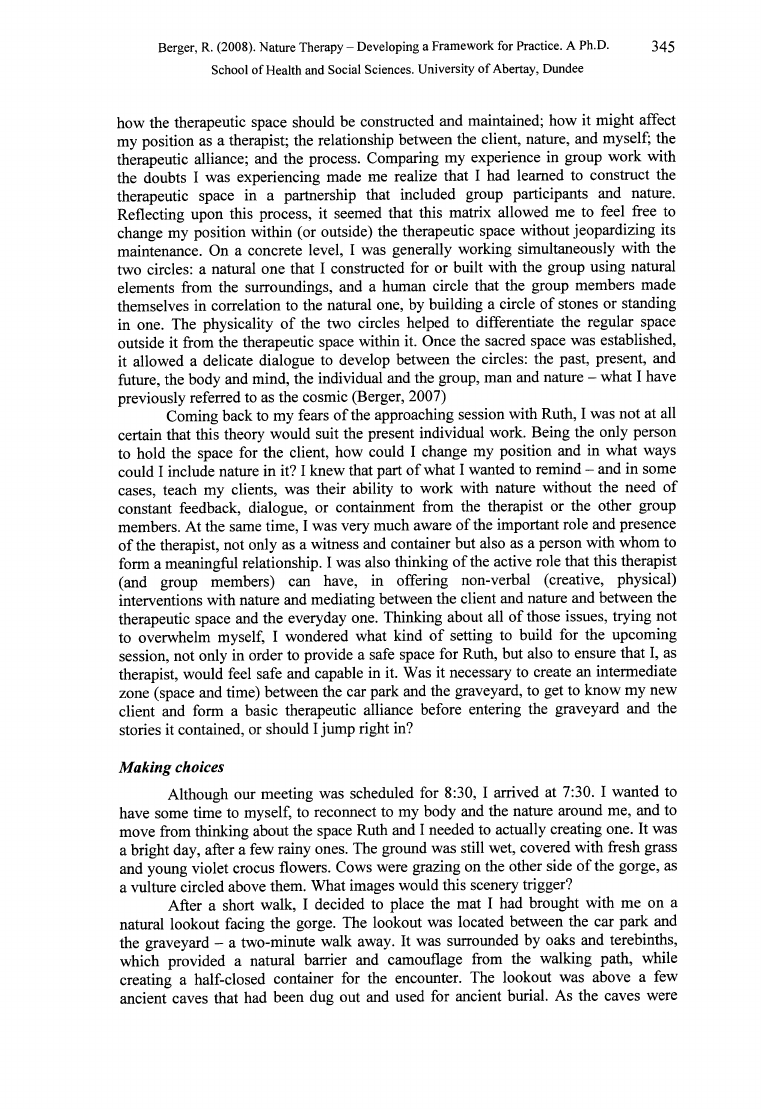
Berger, R. (2008). Nature Therapy - Developing a Framework for Practice. A Ph.D.
345
School of Health and Social Sciences. University of Abertay, Dundee
how the therapeutic space should be constructed and maintained; how it might affect
my position as a therapist; the relationship between the client, nature, and myself; the
therapeutic alliance; and the process. Comparing my experience in group work with
the doubts I was experiencing made me realize that I had learned to construct the
therapeutic space in a partnership that included group participants and nature.
Reflecting upon this process, it seemed that this matrix allowed me to feel free to
change my position within (or outside) the therapeutic space without jeopardizing its
maintenance. On a concrete level, I was generally working simultaneously with the
two circles: a natural one that I constructed for or built with the group using natural
elements from the surroundings, and a human circle that the group members made
themselves in correlation to the natural one, by building a circle of stones or standing
in one. The physicality of the two circles helped to differentiate the regular space
outside it from the therapeutic space within it. Once the sacred space was established,
it allowed a delicate dialogue to develop between the circles: the past, present, and
future, the body and mind, the individual and the group, man and nature - what I have
previously referred to as the cosmic (Berger, 2007)
Coming back to my fears of the approaching session with Ruth, I was not at all
certain that this theory would suit the present individual work. Being the only person
to hold the space for the client, how could I change my position and in what ways
could I include nature in it? I knew that part of what I wanted to remind - and in some
cases, teach my clients, was their ability to work with nature without the need of
constant feedback, dialogue, or containment from the therapist or the other group
members. At the same time, I was very much aware of the important role and presence
of the therapist, not only as a witness and container but also as a person with whom to
form a meaningful relationship. I was also thinking of the active role that this therapist
(and group members) can have, in offering non-verbal (creative, physical)
interventions with nature and mediating between the client and nature and between the
therapeutic space and the everyday one. Thinking about all of those issues, trying not
to overwhelm myself, I wondered what kind of setting to build for the upcoming
session, not only in order to provide a safe space for Ruth, but also to ensure that I, as
therapist, would feel safe and capable in it. Was it necessary to create an intermediate
zone (space and time) between the car park and the graveyard, to get to know my new
client and form a basic therapeutic alliance before entering the graveyard and the
stories it contained, or should I jump right in?
M a k in g ch o ices
Although our meeting was scheduled for 8:30, I arrived at 7:30. I wanted to
have some time to myself, to reconnect to my body and the nature around me, and to
move from thinking about the space Ruth and I needed to actually creating one. It was
a bright day, after a few rainy ones. The ground was still wet, covered with fresh grass
and young violet crocus flowers. Cows were grazing on the other side of the gorge, as
a vulture circled above them. What images would this scenery trigger?
After a short walk, I decided to place the mat I had brought with me on a
natural lookout facing the gorge. The lookout was located between the car park and
the graveyard - a two-minute walk away. It was surrounded by oaks and terebinths,
which provided a natural barrier and camouflage from the walking path, while
creating a half-closed container for the encounter. The lookout was above a few
ancient caves that had been dug out and used for ancient burial. As the caves were
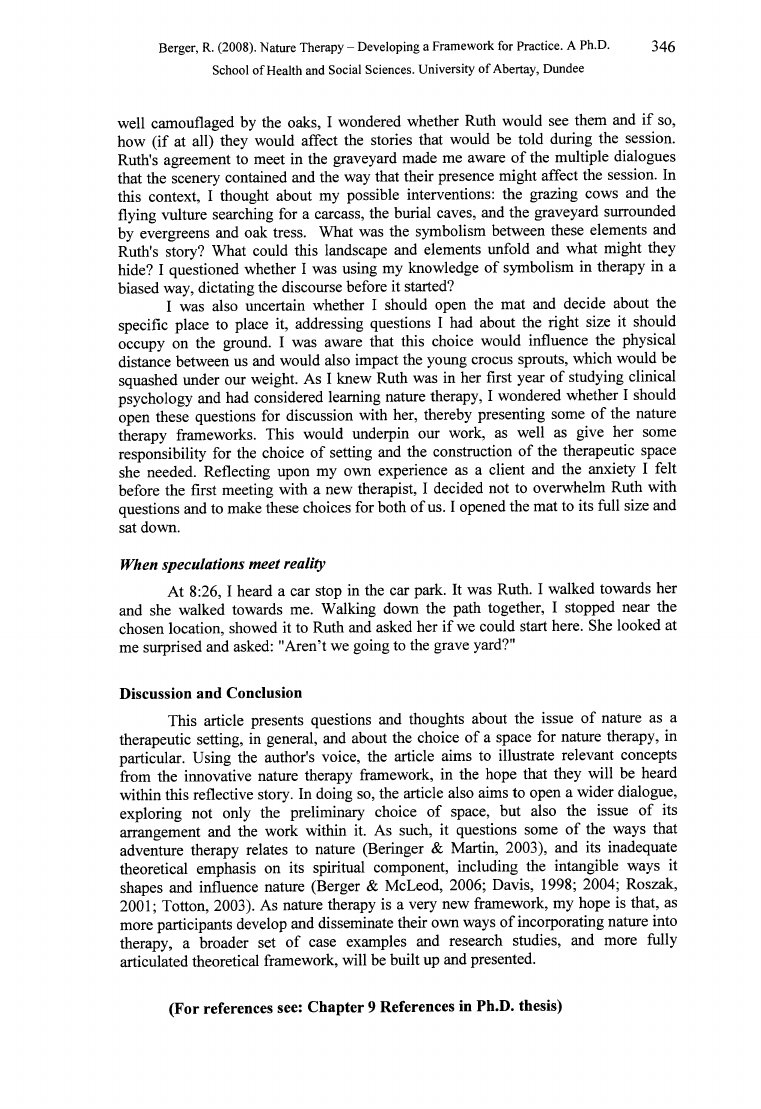
Berger, R. (2008). Nature Therapy - Developing a Framework for Practice. A Ph.D.
346
School of Health and Social Sciences. University of Abertay, Dundee
well camouflaged by the oaks, I wondered whether Ruth would see them and if so,
how (if at all) they would affect the stories that would be told during the session.
Ruth's agreement to meet in the graveyard made me aware of the multiple dialogues
that the scenery contained and the way that their presence might affect the session. In
this context, I thought about my possible interventions: the grazing cows and the
flying vulture searching for a carcass, the burial caves, and the graveyard surrounded
by evergreens and oak tress. What was the symbolism between these elements and
Ruth's story? What could this landscape and elements unfold and what might they
hide? I questioned whether I was using my knowledge of symbolism in therapy in a
biased way, dictating the discourse before it started?
I was also uncertain whether I should open the mat and decide about the
specific place to place it, addressing questions I had about the right size it should
occupy on the ground. I was aware that this choice would influence the physical
distance between us and would also impact the young crocus sprouts, which would be
squashed under our weight. As I knew Ruth was in her first year of studying clinical
psychology and had considered learning nature therapy, I wondered whether I should
open these questions for discussion with her, thereby presenting some of the nature
therapy frameworks. This would underpin our work, as well as give her some
responsibility for the choice of setting and the construction of the therapeutic space
she needed. Reflecting upon my own experience as a client and the anxiety I felt
before the first meeting with a new therapist, I decided not to overwhelm Ruth with
questions and to make these choices for both of us. I opened the mat to its full size and
sat down.
W h en sp e c u la tio n s m e e t re a lity
At 8:26, I heard a car stop in the car park. It was Ruth. I walked towards her
and she walked towards me. Walking down the path together, I stopped near the
chosen location, showed it to Ruth and asked her if we could start here. She looked at
me surprised and asked: "Aren’t we going to the grave yard?"
Discussion and Conclusion
This article presents questions and thoughts about the issue of nature as a
therapeutic setting, in general, and about the choice of a space for nature therapy, in
particular. Using the author's voice, the article aims to illustrate relevant concepts
from the innovative nature therapy framework, in the hope that they will be heard
within this reflective story. In doing so, the article also aims to open a wider dialogue,
exploring not only the preliminary choice of space, but also the issue of its
arrangement and the work within it. As such, it questions some of the ways that
adventure therapy relates to nature (Beringer & Martin, 2003), and its inadequate
theoretical emphasis on its spiritual component, including the intangible ways it
shapes and influence nature (Berger & McLeod, 2006; Davis, 1998; 2004; Roszak,
2001; Totton, 2003). As nature therapy is a very new framework, my hope is that, as
more participants develop and disseminate their own ways of incorporating nature into
therapy, a broader set of case examples and research studies, and more fully
articulated theoretical framework, will be built up and presented.
(For references see: Chapter 9 References in Ph.D. thesis)
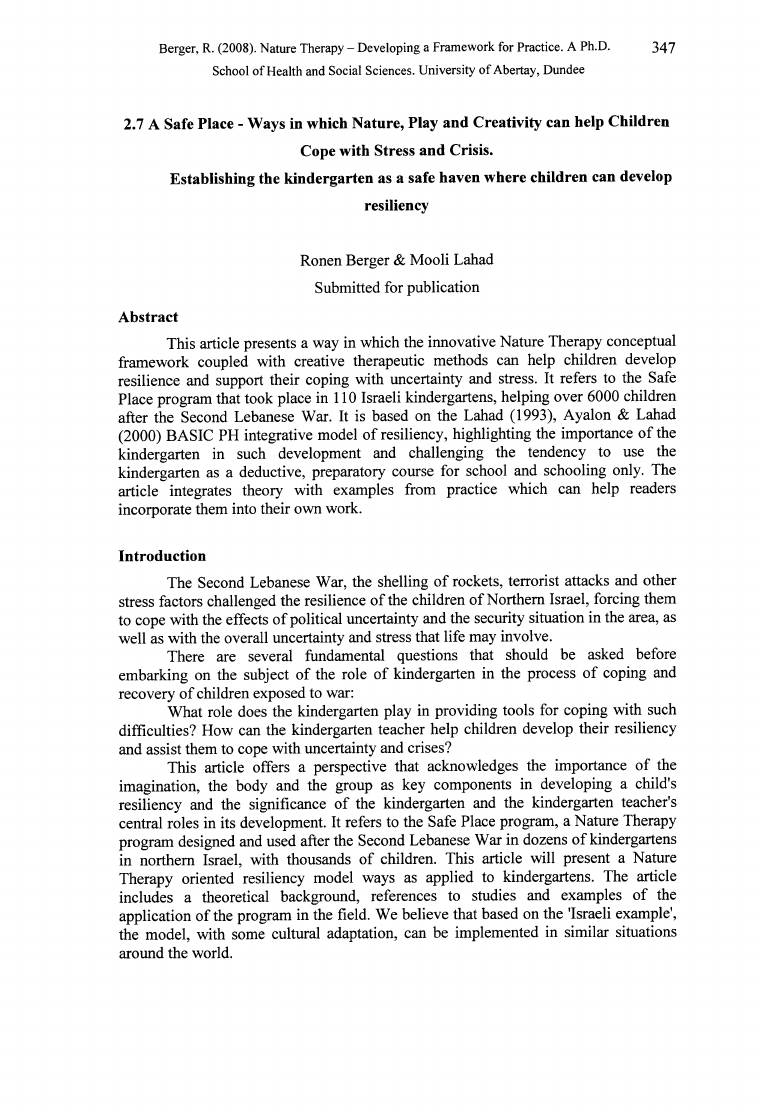
Berger, R. (2008). Nature Therapy - Developing a Framework for Practice. A Ph.D.
347
School of Health and Social Sciences. University of Abertay, Dundee
2.7 A Safe Place - Ways in which Nature, Play and Creativity can help Children
Cope with Stress and Crisis.
Establishing the kindergarten as a safe haven where children can develop
resiliency
Ronen Berger & Mooli Lahad
Submitted for publication
Abstract
This article presents a way in which the innovative Nature Therapy conceptual
framework coupled with creative therapeutic methods can help children develop
resilience and support their coping with uncertainty and stress. It refers to the Safe
Place program that took place in 110 Israeli kindergartens, helping over 6000 children
after the Second Lebanese War. It is based on the Lahad (1993), Ayalon & Lahad
(2000) BASIC PH integrative model of resiliency, highlighting the importance of the
kindergarten in such development and challenging the tendency to use the
kindergarten as a deductive, preparatory course for school and schooling only. The
article integrates theory with examples from practice which can help readers
incorporate them into their own work.
Introduction
The Second Lebanese War, the shelling of rockets, terrorist attacks and other
stress factors challenged the resilience of the children of Northern Israel, forcing them
to cope with the effects of political uncertainty and the security situation in the area, as
well as with the overall uncertainty and stress that life may involve.
There are several fundamental questions that should be asked before
embarking on the subject of the role of kindergarten in the process of coping and
recovery of children exposed to war:
What role does the kindergarten play in providing tools for coping with such
difficulties? How can the kindergarten teacher help children develop their resiliency
and assist them to cope with uncertainty and crises?
This article offers a perspective that acknowledges the importance of the
imagination, the body and the group as key components in developing a child's
resiliency and the significance of the kindergarten and the kindergarten teacher's
central roles in its development. It refers to the Safe Place program, a Nature Therapy
program designed and used after the Second Lebanese War in dozens of kindergartens
in northern Israel, with thousands of children. This article will present a Nature
Therapy oriented resiliency model ways as applied to kindergartens. The article
includes a theoretical background, references to studies and examples of the
application of the program in the field. We believe that based on the 'Israeli example',
the model, with some cultural adaptation, can be implemented in similar situations
around the world.
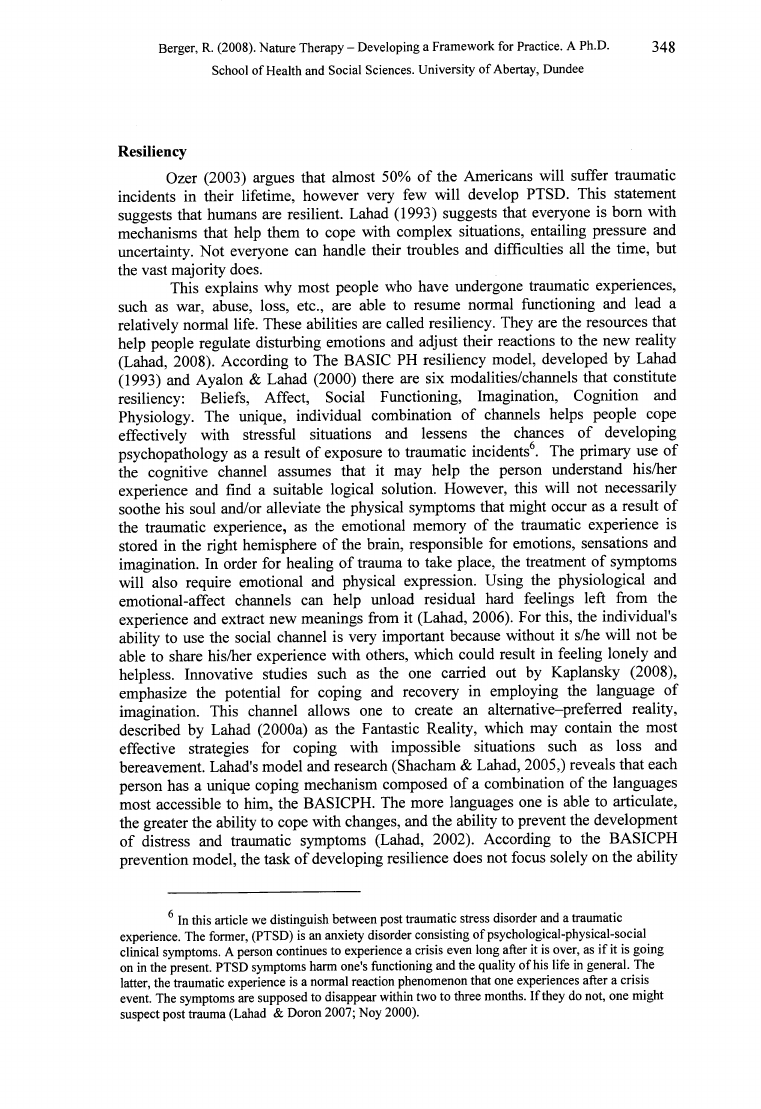
Berger, R. (2008). Nature Therapy - Developing a Framework for Practice. A Ph.D.
348
School of Health and Social Sciences. University of Abertay, Dundee
Resiliency
Ozer (2003) argues that almost 50% of the Americans will suffer traumatic
incidents in their lifetime, however very few will develop PTSD. This statement
suggests that humans are resilient. Lahad (1993) suggests that everyone is bom with
mechanisms that help them to cope with complex situations, entailing pressure and
uncertainty. Not everyone can handle their troubles and difficulties all the time, but
the vast majority does.
This explains why most people who have undergone traumatic experiences,
such as war, abuse, loss, etc., are able to resume normal functioning and lead a
relatively normal life. These abilities are called resiliency. They are the resources that
help people regulate disturbing emotions and adjust their reactions to the new reality
(Lahad, 2008). According to The BASIC PH resiliency model, developed by Lahad
(1993) and Ayalon & Lahad (2000) there are six modalities/channels that constitute
resiliency: Beliefs, Affect, Social Functioning, Imagination, Cognition and
Physiology. The unique, individual combination of channels helps people cope
effectively with stressful situations and lessens the chances of developing
psychopathology as a result of exposure to traumatic incidents6. The primary use of
the cognitive channel assumes that it may help the person understand his/her
experience and find a suitable logical solution. However, this will not necessarily
soothe his soul and/or alleviate the physical symptoms that might occur as a result of
the traumatic experience, as the emotional memory of the traumatic experience is
stored in the right hemisphere of the brain, responsible for emotions, sensations and
imagination. In order for healing of trauma to take place, the treatment of symptoms
will also require emotional and physical expression. Using the physiological and
emotional-affect channels can help unload residual hard feelings left from the
experience and extract new meanings from it (Lahad, 2006). For this, the individual's
ability to use the social channel is very important because without it s/he will not be
able to share his/her experience with others, which could result in feeling lonely and
helpless. Innovative studies such as the one carried out by Kaplansky (2008),
emphasize the potential for coping and recovery in employing the language of
imagination. This channel allows one to create an alternative-preferred reality,
described by Lahad (2000a) as the Fantastic Reality, which may contain the most
effective strategies for coping with impossible situations such as loss and
bereavement. Lahad's model and research (Shacham & Lahad, 2005,) reveals that each
person has a unique coping mechanism composed of a combination of the languages
most accessible to him, the BASICPH. The more languages one is able to articulate,
the greater the ability to cope with changes, and the ability to prevent the development
of distress and traumatic symptoms (Lahad, 2002). According to the BASICPH
prevention model, the task of developing resilience does not focus solely on the ability
6
In this article we distinguish between post traumatic stress disorder and a traumatic
experience. The former, (PTSD) is an anxiety disorder consisting of psychological-physical-social
clinical symptoms. A person continues to experience a crisis even long after it is over, as if it is going
on in the present. PTSD symptoms harm one's functioning and the quality of his life in general. The
latter, the traumatic experience is a normal reaction phenomenon that one experiences after a crisis
event. The symptoms are supposed to disappear within two to three months. If they do not, one might
suspect post trauma (Lahad & Doron 2007; Noy 2000).
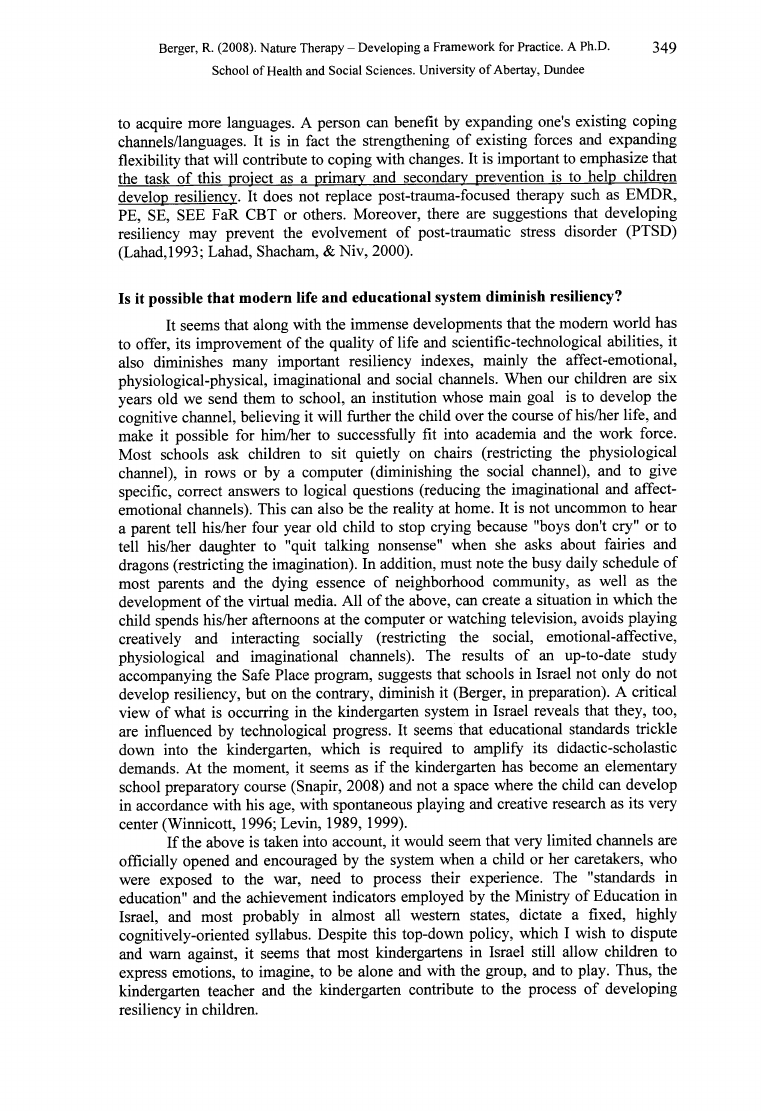
Berger, R. (2008). Nature Therapy - Developing a Framework for Practice. A Ph.D.
349
School of Health and Social Sciences. University of Abertay, Dundee
to acquire more languages. A person can benefit by expanding one's existing coping
channels/languages. It is in fact the strengthening of existing forces and expanding
flexibility that will contribute to coping with changes. It is important to emphasize that
the task of this project as a primary and secondary prevention is to help children
develop resiliency. It does not replace post-trauma-focused therapy such as EMDR,
PE, SE, SEE FaR CBT or others. Moreover, there are suggestions that developing
resiliency may prevent the evolvement of post-traumatic stress disorder (PTSD)
(Lahad,1993; Lahad, Shacham, & Niv, 2000).
Is it possible that modern life and educational system diminish resiliency?
It seems that along with the immense developments that the modem world has
to offer, its improvement of the quality of life and scientific-technological abilities, it
also diminishes many important resiliency indexes, mainly the affect-emotional,
physiological-physical, imaginational and social channels. When our children are six
years old we send them to school, an institution whose main goal is to develop the
cognitive channel, believing it will further the child over the course of his/her life, and
make it possible for him/her to successfully fit into academia and the work force.
Most schools ask children to sit quietly on chairs (restricting the physiological
channel), in rows or by a computer (diminishing the social channel), and to give
specific, correct answers to logical questions (reducing the imaginational and affect-
emotional channels). This can also be the reality at home. It is not uncommon to hear
a parent tell his/her four year old child to stop crying because "boys don't cry" or to
tell his/her daughter to "quit talking nonsense" when she asks about fairies and
dragons (restricting the imagination). In addition, must note the busy daily schedule of
most parents and the dying essence of neighborhood community, as well as the
development of the virtual media. All of the above, can create a situation in which the
child spends his/her afternoons at the computer or watching television, avoids playing
creatively and interacting socially (restricting the social, emotional-affective,
physiological and imaginational channels). The results of an up-to-date study
accompanying the Safe Place program, suggests that schools in Israel not only do not
develop resiliency, but on the contrary, diminish it (Berger, in preparation). A critical
view of what is occurring in the kindergarten system in Israel reveals that they, too,
are influenced by technological progress. It seems that educational standards trickle
down into the kindergarten, which is required to amplify its didactic-scholastic
demands. At the moment, it seems as if the kindergarten has become an elementary
school preparatory course (Snapir, 2008) and not a space where the child can develop
in accordance with his age, with spontaneous playing and creative research as its very
center (Winnicott, 1996; Levin, 1989, 1999).
If the above is taken into account, it would seem that very limited channels are
officially opened and encouraged by the system when a child or her caretakers, who
were exposed to the war, need to process their experience. The "standards in
education" and the achievement indicators employed by the Ministry of Education in
Israel, and most probably in almost all western states, dictate a fixed, highly
cognitively-oriented syllabus. Despite this top-down policy, which I wish to dispute
and warn against, it seems that most kindergartens in Israel still allow children to
express emotions, to imagine, to be alone and with the group, and to play. Thus, the
kindergarten teacher and the kindergarten contribute to the process of developing
resiliency in children.
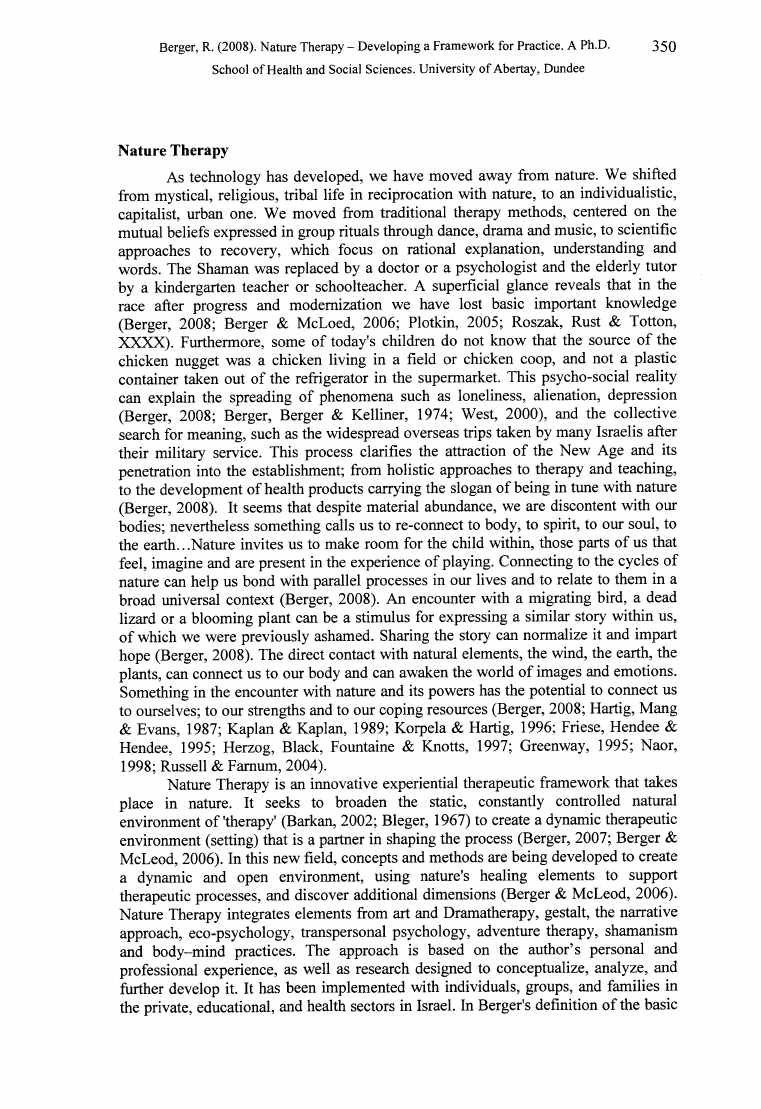
Berger, R. (2008). Nature Therapy - Developing a Framework for Practice. A Ph.D.
350
School of Health and Social Sciences. University of Abertay, Dundee
Nature Therapy
As technology has developed, we have moved away from nature. We shifted
from mystical, religious, tribal life in reciprocation with nature, to an individualistic,
capitalist, urban one. We moved from traditional therapy methods, centered on the
mutual beliefs expressed in group rituals through dance, drama and music, to scientific
approaches to recovery, which focus on rational explanation, understanding and
words. The Shaman was replaced by a doctor or a psychologist and the elderly tutor
by a kindergarten teacher or schoolteacher. A superficial glance reveals that in the
race after progress and modernization we have lost basic important knowledge
(Berger, 2008; Berger & McLoed, 2006; Plotkin, 2005; Roszak, Rust & Totton,
XXXX). Furthermore, some of today's children do not know that the source of the
chicken nugget was a chicken living in a field or chicken coop, and not a plastic
container taken out of the refrigerator in the supermarket. This psycho-social reality
can explain the spreading of phenomena such as loneliness, alienation, depression
(Berger, 2008; Berger, Berger & Kelliner, 1974; West, 2000), and the collective
search for meaning, such as the widespread overseas trips taken by many Israelis after
their military service. This process clarifies the attraction of the New Age and its
penetration into the establishment; from holistic approaches to therapy and teaching,
to the development of health products carrying the slogan of being in tune with nature
(Berger, 2008). It seems that despite material abundance, we are discontent with our
bodies; nevertheless something calls us to re-connect to body, to spirit, to our soul, to
the earth...Nature invites us to make room for the child within, those parts of us that
feel, imagine and are present in the experience of playing. Connecting to the cycles of
nature can help us bond with parallel processes in our lives and to relate to them in a
broad universal context (Berger, 2008). An encounter with a migrating bird, a dead
lizard or a blooming plant can be a stimulus for expressing a similar story within us,
of which we were previously ashamed. Sharing the story can normalize it and impart
hope (Berger, 2008). The direct contact with natural elements, the wind, the earth, the
plants, can connect us to our body and can awaken the world of images and emotions.
Something in the encounter with nature and its powers has the potential to connect us
to ourselves; to our strengths and to our coping resources (Berger, 2008; Hartig, Mang
& Evans, 1987; Kaplan & Kaplan, 1989; Korpela & Hartig, 1996; Friese, Hendee &
Hendee, 1995; Herzog, Black, Fountaine & Knotts, 1997; Greenway, 1995; Naor,
1998; Russell & Famum, 2004).
Nature Therapy is an innovative experiential therapeutic framework that takes
place in nature. It seeks to broaden the static, constantly controlled natural
environment of'therapy' (Barkan, 2002; Bleger, 1967) to create a dynamic therapeutic
environment (setting) that is a partner in shaping the process (Berger, 2007; Berger &
McLeod, 2006). In this new field, concepts and methods are being developed to create
a dynamic and open environment, using nature's healing elements to support
therapeutic processes, and discover additional dimensions (Berger & McLeod, 2006).
Nature Therapy integrates elements from art and Dramatherapy, gestalt, the narrative
approach, eco-psychology, transpersonal psychology, adventure therapy, shamanism
and body—mind practices. The approach is based on the author’s personal and
professional experience, as well as research designed to conceptualize, analyze, and
further develop it. It has been implemented with individuals, groups, and families in
the private, educational, and health sectors in Israel. In Berger's definition of the basic
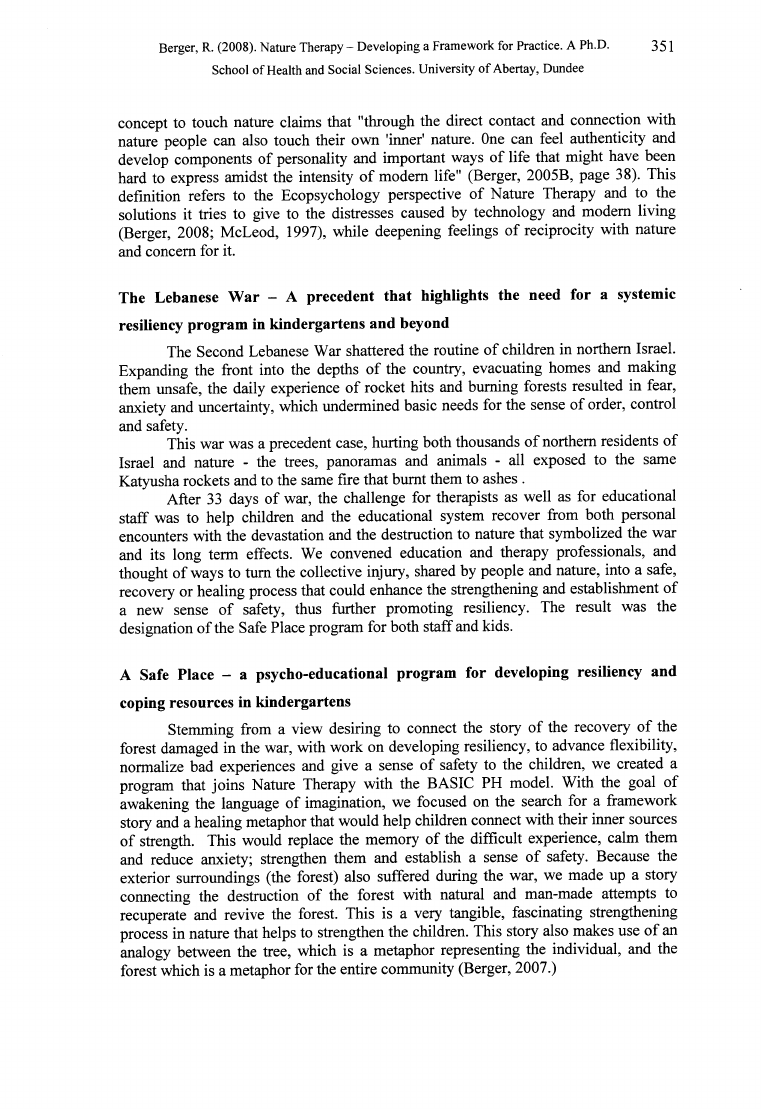
Berger, R. (2008). Nature Therapy - Developing a Framework for Practice. A Ph.D.
351
School of Health and Social Sciences. University of Abertay, Dundee
concept to touch nature claims that "through the direct contact and connection with
nature people can also touch their own 'inner' nature. One can feel authenticity and
develop components of personality and important ways of life that might have been
hard to express amidst the intensity of modem life" (Berger, 2005B, page 38). This
definition refers to the Ecopsychology perspective of Nature Therapy and to the
solutions it tries to give to the distresses caused by technology and modem living
(Berger, 2008; McLeod, 1997), while deepening feelings of reciprocity with nature
and concern for it.
The Lebanese War - A precedent that highlights the need for a systemic
resiliency program in kindergartens and beyond
The Second Lebanese War shattered the routine of children in northern Israel.
Expanding the front into the depths of the country, evacuating homes and making
them unsafe, the daily experience of rocket hits and burning forests resulted in fear,
anxiety and uncertainty, which undermined basic needs for the sense of order, control
and safety.
This war was a precedent case, hurting both thousands of northern residents of
Israel and nature - the trees, panoramas and animals - all exposed to the same
Katyusha rockets and to the same fire that burnt them to ashes .
After 33 days of war, the challenge for therapists as well as for educational
staff was to help children and the educational system recover from both personal
encounters with the devastation and the destruction to nature that symbolized the war
and its long term effects. We convened education and therapy professionals, and
thought of ways to turn the collective injury, shared by people and nature, into a safe,
recovery or healing process that could enhance the strengthening and establishment of
a new sense of safety, thus further promoting resiliency. The result was the
designation of the Safe Place program for both staff and kids.
A Safe Place - a psycho-educational program for developing resiliency and
coping resources in kindergartens
Stemming from a view desiring to connect the story of the recovery of the
forest damaged in the war, with work on developing resiliency, to advance flexibility,
normalize bad experiences and give a sense of safety to the children, we created a
program that joins Nature Therapy with the BASIC PH model. With the goal of
awakening the language of imagination, we focused on the search for a framework
story and a healing metaphor that would help children connect with their inner sources
of strength. This would replace the memory of the difficult experience, calm them
and reduce anxiety; strengthen them and establish a sense of safety. Because the
exterior surroundings (the forest) also suffered during the war, we made up a story
connecting the destruction of the forest with natural and man-made attempts to
recuperate and revive the forest. This is a very tangible, fascinating strengthening
process in nature that helps to strengthen the children. This story also makes use of an
analogy between the tree, which is a metaphor representing the individual, and the
forest which is a metaphor for the entire community (Berger, 2007.)
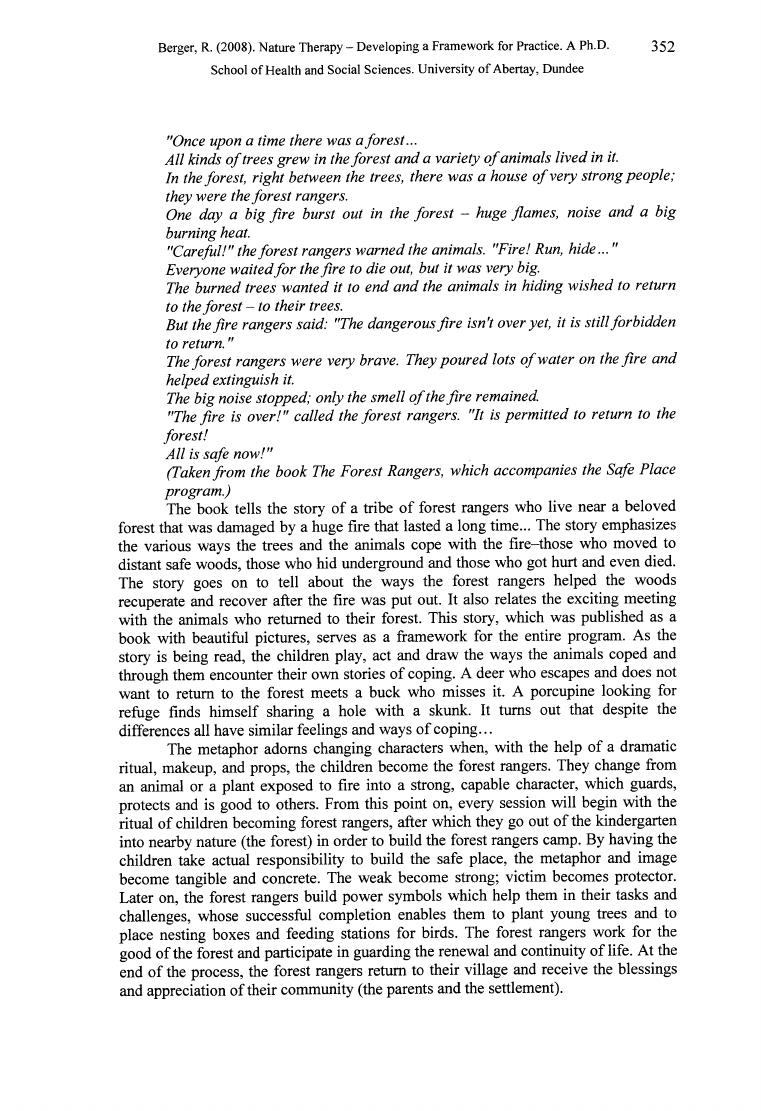
Berger, R. (2008). Nature Therapy - Developing a Framework for Practice. A Ph.D.
352
School of Health and Social Sciences. University of Abertay, Dundee
"Once upon a tim e there w as a fo re st...
A ll k in d s o f tr e e s g r e w in th e f o r e s t a n d a v a r ie ty o f a n im a ls l iv e d in it.
In the fo rest, rig h t betw een the trees, there w a s a house o f very stro n g p e o p le ;
they w ere the fo r e s t rangers.
One d a y a b ig f ir e bu rst ou t in the fo r e s t — huge fla m es, noise a n d a b ig
burning heat.
"Careful!" the f o r e s t ra n g ers w a rn e d the anim als. "Fire! Run, h id e... "
E veryon e w a ite d f o r the fir e to d ie out, bu t it w a s very big.
The b u rn ed trees w a n te d it to e n d a n d the a n im a ls in h idin g w ish e d to return
to the fo re s t - to their trees.
B u t th e f i r e r a n g e r s s a id : "The d a n g e r o u s f i r e i s n ’t o v e r y e t, it is s till f o r b id d e n
to retu rn ."
The fo re s t ran gers w ere very brave. They p o u re d lots o f w a ter on the fir e a n d
h e lp e d e x tin g u is h it.
The b ig noise sto p p ed ; on ly the sm ell o f the fir e rem ained.
"The f i r e is o v e r ! " c a ll e d th e f o r e s t r a n g e r s . "It is p e r m i tt e d to r e tu r n to th e
fo re st!
A ll is safe now!"
(Taken fro m the bo o k The F o rest R angers, w h ich accom pan ies the Safe P la ce
program .)
The book tells the story of a tribe of forest rangers who live near a beloved
forest that was damaged by a huge fire that lasted a long time... The story emphasizes
the various ways the trees and the animals cope with the fire—those who moved to
distant safe woods, those who hid underground and those who got hurt and even died.
The story goes on to tell about the ways the forest rangers helped the woods
recuperate and recover after the fire was put out. It also relates the exciting meeting
with the animals who returned to their forest. This story, which was published as a
book with beautiful pictures, serves as a framework for the entire program. As the
story is being read, the children play, act and draw the ways the animals coped and
through them encounter their own stories of coping. A deer who escapes and does not
want to return to the forest meets a buck who misses it. A porcupine looking for
refuge finds himself sharing a hole with a skunk. It turns out that despite the
differences all have similar feelings and ways of coping...
The metaphor adorns changing characters when, with the help of a dramatic
ritual, makeup, and props, the children become the forest rangers. They change from
an animal or a plant exposed to fire into a strong, capable character, which guards,
protects and is good to others. From this point on, every session will begin with the
ritual of children becoming forest rangers, after which they go out of the kindergarten
into nearby nature (the forest) in order to build the forest rangers camp. By having the
children take actual responsibility to build the safe place, the metaphor and image
become tangible and concrete. The weak become strong; victim becomes protector.
Later on, the forest rangers build power symbols which help them in their tasks and
challenges, whose successful completion enables them to plant young trees and to
place nesting boxes and feeding stations for birds. The forest rangers work for the
good of the forest and participate in guarding the renewal and continuity of life. At the
end of the process, the forest rangers return to their village and receive the blessings
and appreciation of their community (the parents and the settlement).
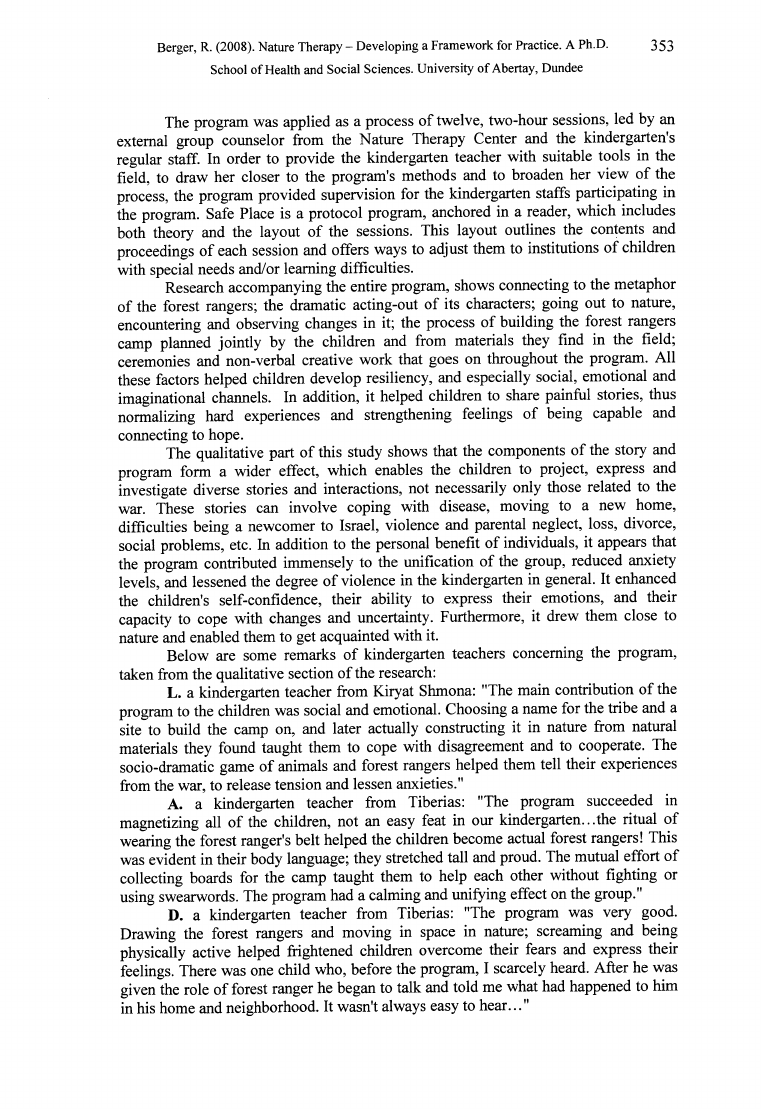
Berger, R. (2008). Nature Therapy - Developing a Framework for Practice. A Ph.D.
353
School of Health and Social Sciences. University of Abertay, Dundee
The program was applied as a process of twelve, two-hour sessions, led by an
external group counselor from the Nature Therapy Center and the kindergarten's
regular staff. In order to provide the kindergarten teacher with suitable tools in the
field, to draw her closer to the program's methods and to broaden her view of the
process, the program provided supervision for the kindergarten staffs participating in
the program. Safe Place is a protocol program, anchored in a reader, which includes
both theory and the layout of the sessions. This layout outlines the contents and
proceedings of each session and offers ways to adjust them to institutions of children
with special needs and/or learning difficulties.
Research accompanying the entire program, shows connecting to the metaphor
of the forest rangers; the dramatic acting-out of its characters; going out to nature,
encountering and observing changes in it; the process of building the forest rangers
camp planned jointly by the children and from materials they find in the field;
ceremonies and non-verbal creative work that goes on throughout the program. All
these factors helped children develop resiliency, and especially social, emotional and
imaginational channels. In addition, it helped children to share painful stories, thus
normalizing hard experiences and strengthening feelings of being capable and
connecting to hope.
The qualitative part of this study shows that the components of the story and
program form a wider effect, which enables the children to project, express and
investigate diverse stories and interactions, not necessarily only those related to the
war. These stories can involve coping with disease, moving to a new home,
difficulties being a newcomer to Israel, violence and parental neglect, loss, divorce,
social problems, etc. In addition to the personal benefit of individuals, it appears that
the program contributed immensely to the unification of the group, reduced anxiety
levels, and lessened the degree of violence in the kindergarten in general. It enhanced
the children's self-confidence, their ability to express their emotions, and their
capacity to cope with changes and uncertainty. Furthermore, it drew them close to
nature and enabled them to get acquainted with it.
Below are some remarks of kindergarten teachers concerning the program,
taken from the qualitative section of the research:
L. a kindergarten teacher from Kiryat Shmona: "The main contribution of the
program to the children was social and emotional. Choosing a name for the tribe and a
site to build the camp on, and later actually constructing it in nature from natural
materials they found taught them to cope with disagreement and to cooperate. The
socio-dramatic game of animals and forest rangers helped them tell their experiences
from the war, to release tension and lessen anxieties."
A. a kindergarten teacher from Tiberias: "The program succeeded in
magnetizing all of the children, not an easy feat in our kindergarten...the ritual of
wearing the forest ranger's belt helped the children become actual forest rangers! This
was evident in their body language; they stretched tall and proud. The mutual effort of
collecting boards for the camp taught them to help each other without fighting or
using swearwords. The program had a calming and unifying effect on the group."
D. a kindergarten teacher from Tiberias: "The program was very good.
Drawing the forest rangers and moving in space in nature; screaming and being
physically active helped frightened children overcome their fears and express their
feelings. There was one child who, before the program, I scarcely heard. After he was
given the role of forest ranger he began to talk and told me what had happened to him
in his home and neighborhood. It wasn't always easy to hear..."
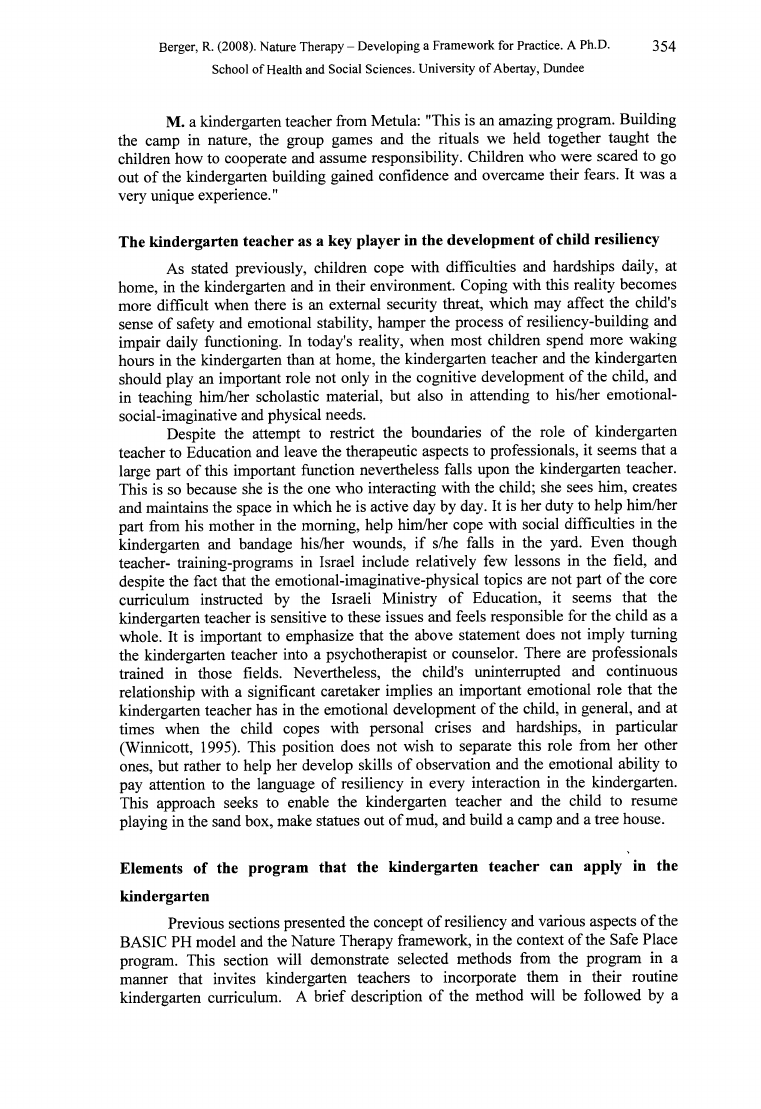
Berger, R. (2008). Nature Therapy - Developing a Framework for Practice. A Ph.D.
354
School of Health and Social Sciences. University of Abertay, Dundee
M. a kindergarten teacher from Metula: "This is an amazing program. Building
the camp in nature, the group games and the rituals we held together taught the
children how to cooperate and assume responsibility. Children who were scared to go
out of the kindergarten building gained confidence and overcame their fears. It was a
very unique experience."
The kindergarten teacher as a key player in the development of child resiliency
As stated previously, children cope with difficulties and hardships daily, at
home, in the kindergarten and in their environment. Coping with this reality becomes
more difficult when there is an external security threat, which may affect the child's
sense of safety and emotional stability, hamper the process of resiliency-building and
impair daily functioning. In today's reality, when most children spend more waking
hours in the kindergarten than at home, the kindergarten teacher and the kindergarten
should play an important role not only in the cognitive development of the child, and
in teaching him/her scholastic material, but also in attending to his/her emotional-
social-imaginative and physical needs.
Despite the attempt to restrict the boundaries of the role of kindergarten
teacher to Education and leave the therapeutic aspects to professionals, it seems that a
large part of this important function nevertheless falls upon the kindergarten teacher.
This is so because she is the one who interacting with the child; she sees him, creates
and maintains the space in which he is active day by day. It is her duty to help him/her
part from his mother in the morning, help him/her cope with social difficulties in the
kindergarten and bandage his/her wounds, if s/he falls in the yard. Even though
teacher- training-programs in Israel include relatively few lessons in the field, and
despite the fact that the emotional-imaginative-physical topics are not part of the core
curriculum instructed by the Israeli Ministry of Education, it seems that the
kindergarten teacher is sensitive to these issues and feels responsible for the child as a
whole. It is important to emphasize that the above statement does not imply turning
the kindergarten teacher into a psychotherapist or counselor. There are professionals
trained in those fields. Nevertheless, the child's uninterrupted and continuous
relationship with a significant caretaker implies an important emotional role that the
kindergarten teacher has in the emotional development of the child, in general, and at
times when the child copes with personal crises and hardships, in particular
(Winnicott, 1995). This position does not wish to separate this role from her other
ones, but rather to help her develop skills of observation and the emotional ability to
pay attention to the language of resiliency in every interaction in the kindergarten.
This approach seeks to enable the kindergarten teacher and the child to resume
playing in the sand box, make statues out of mud, and build a camp and a tree house.
Elements of the program that the kindergarten teacher can apply in the
kindergarten
Previous sections presented the concept of resiliency and various aspects of the
BASIC PH model and the Nature Therapy framework, in the context of the Safe Place
program. This section will demonstrate selected methods from the program in a
manner that invites kindergarten teachers to incorporate them in their routine
kindergarten curriculum. A brief description of the method will be followed by a
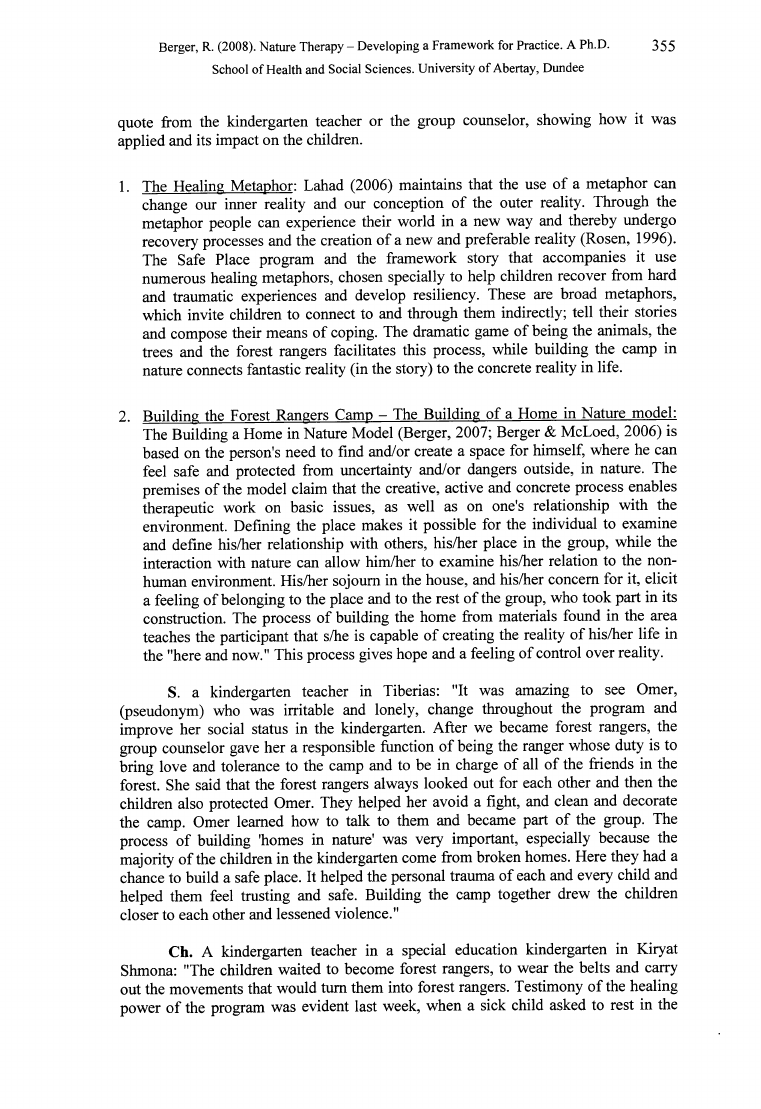
Berger, R. (2008). Nature Therapy - Developing a Framework for Practice. A Ph.D.
355
School of Health and Social Sciences. University of Abertay, Dundee
quote from the kindergarten teacher or the group counselor, showing how it was
applied and its impact on the children.
1. The Healing Metaphor: Lahad (2006) maintains that the use of a metaphor can
change our inner reality and our conception of the outer reality. Through the
metaphor people can experience their world in a new way and thereby undergo
recovery processes and the creation of a new and preferable reality (Rosen, 1996).
The Safe Place program and the framework story that accompanies it use
numerous healing metaphors, chosen specially to help children recover from hard
and traumatic experiences and develop resiliency. These are broad metaphors,
which invite children to connect to and through them indirectly; tell their stories
and compose their means of coping. The dramatic game of being the animals, the
trees and the forest rangers facilitates this process, while building the camp in
nature connects fantastic reality (in the story) to the concrete reality in life.
2. Building the Forest Rangers Camp - The Building of a Home in Nature model:
The Building a Home in Nature Model (Berger, 2007; Berger & McLoed, 2006) is
based on the person's need to find and/or create a space for himself, where he can
feel safe and protected from uncertainty and/or dangers outside, in nature. The
premises of the model claim that the creative, active and concrete process enables
therapeutic work on basic issues, as well as on one's relationship with the
environment. Defining the place makes it possible for the individual to examine
and define his/her relationship with others, his/her place in the group, while the
interaction with nature can allow him/her to examine his/her relation to the non
human environment. His/her sojourn in the house, and his/her concern for it, elicit
a feeling of belonging to the place and to the rest of the group, who took part in its
construction. The process of building the home from materials found in the area
teaches the participant that s/he is capable of creating the reality of his/her life in
the "here and now." This process gives hope and a feeling of control over reality.
S.
a kindergarten teacher in Tiberias: "It was amazing to see Omer,
(pseudonym) who was irritable and lonely, change throughout the program and
improve her social status in the kindergarten. After we became forest rangers, the
group counselor gave her a responsible function of being the ranger whose duty is to
bring love and tolerance to the camp and to be in charge of all of the friends in the
forest. She said that the forest rangers always looked out for each other and then the
children also protected Omer. They helped her avoid a fight, and clean and decorate
the camp. Omer learned how to talk to them and became part of the group. The
process of building 'homes in nature' was very important, especially because the
majority of the children in the kindergarten come from broken homes. Here they had a
chance to build a safe place. It helped the personal trauma of each and every child and
helped them feel trusting and safe. Building the camp together drew the children
closer to each other and lessened violence."
Ch. A kindergarten teacher in a special education kindergarten in Kiryat
Shmona: "The children waited to become forest rangers, to wear the belts and carry
out the movements that would turn them into forest rangers. Testimony of the healing
power of the program was evident last week, when a sick child asked to rest in the
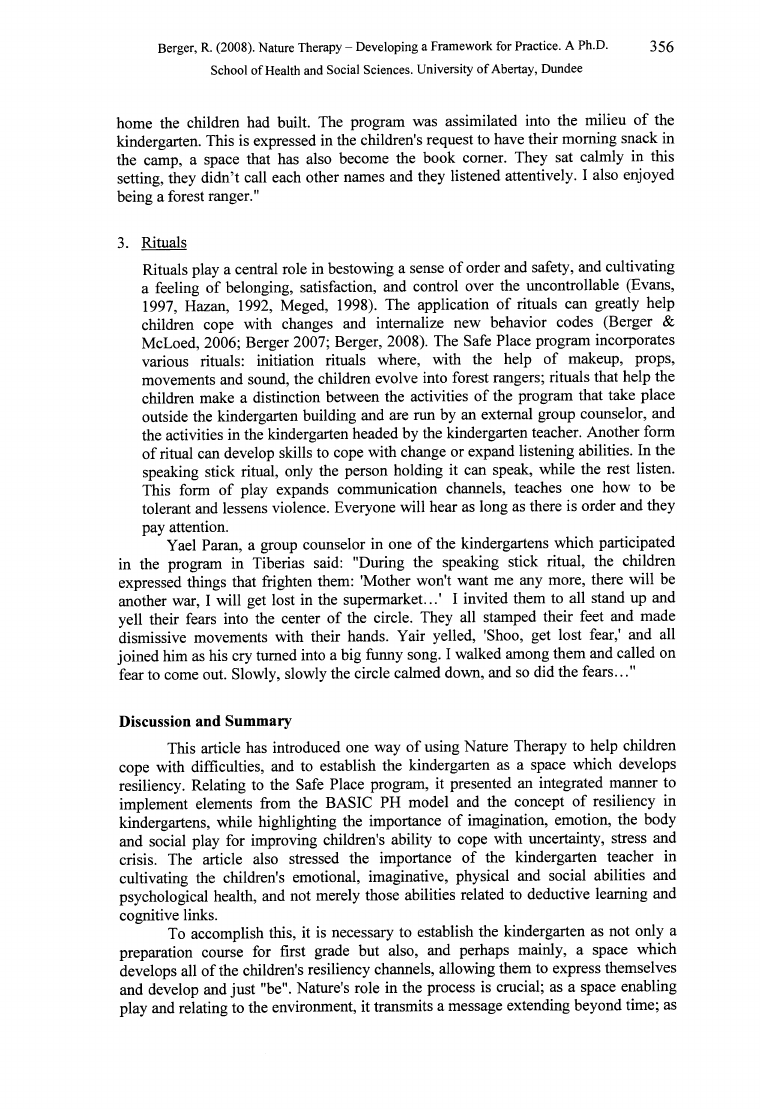
Berger, R. (2008). Nature Therapy - Developing a Framework for Practice. A Ph.D.
356
School of Health and Social Sciences. University of Abertay, Dundee
home the children had built. The program was assimilated into the milieu of the
kindergarten. This is expressed in the children's request to have their morning snack in
the camp, a space that has also become the book comer. They sat calmly in this
setting, they didn’t call each other names and they listened attentively. I also enjoyed
being a forest ranger."
3. Rituals
Rituals play a central role in bestowing a sense of order and safety, and cultivating
a feeling of belonging, satisfaction, and control over the uncontrollable (Evans,
1997, Hazan, 1992, Meged, 1998). The application of rituals can greatly help
children cope with changes and internalize new behavior codes (Berger &
McLoed, 2006; Berger 2007; Berger, 2008). The Safe Place program incorporates
various rituals: initiation rituals where, with the help of makeup, props,
movements and sound, the children evolve into forest rangers; rituals that help the
children make a distinction between the activities of the program that take place
outside the kindergarten building and are run by an external group counselor, and
the activities in the kindergarten headed by the kindergarten teacher. Another form
of ritual can develop skills to cope with change or expand listening abilities. In the
speaking stick ritual, only the person holding it can speak, while the rest listen.
This form of play expands communication channels, teaches one how to be
tolerant and lessens violence. Everyone will hear as long as there is order and they
pay attention.
Yael Paran, a group counselor in one of the kindergartens which participated
in the program in Tiberias said: "During the speaking stick ritual, the children
expressed things that frighten them: 'Mother won't want me any more, there will be
another war, I will get lost in the supermarket...' I invited them to all stand up and
yell their fears into the center of the circle. They all stamped their feet and made
dismissive movements with their hands. Yair yelled, 'Shoo, get lost fear,' and all
joined him as his cry turned into a big funny song. I walked among them and called on
fear to come out. Slowly, slowly the circle calmed down, and so did the fears.
Discussion and Summary
This article has introduced one way of using Nature Therapy to help children
cope with difficulties, and to establish the kindergarten as a space which develops
resiliency. Relating to the Safe Place program, it presented an integrated manner to
implement elements from the BASIC PH model and the concept of resiliency in
kindergartens, while highlighting the importance of imagination, emotion, the body
and social play for improving children's ability to cope with uncertainty, stress and
crisis. The article also stressed the importance of the kindergarten teacher in
cultivating the children's emotional, imaginative, physical and social abilities and
psychological health, and not merely those abilities related to deductive learning and
cognitive links.
To accomplish this, it is necessary to establish the kindergarten as not only a
preparation course for first grade but also, and perhaps mainly, a space which
develops all of the children's resiliency channels, allowing them to express themselves
and develop and just "be". Nature's role in the process is crucial; as a space enabling
play and relating to the environment, it transmits a message extending beyond time; as
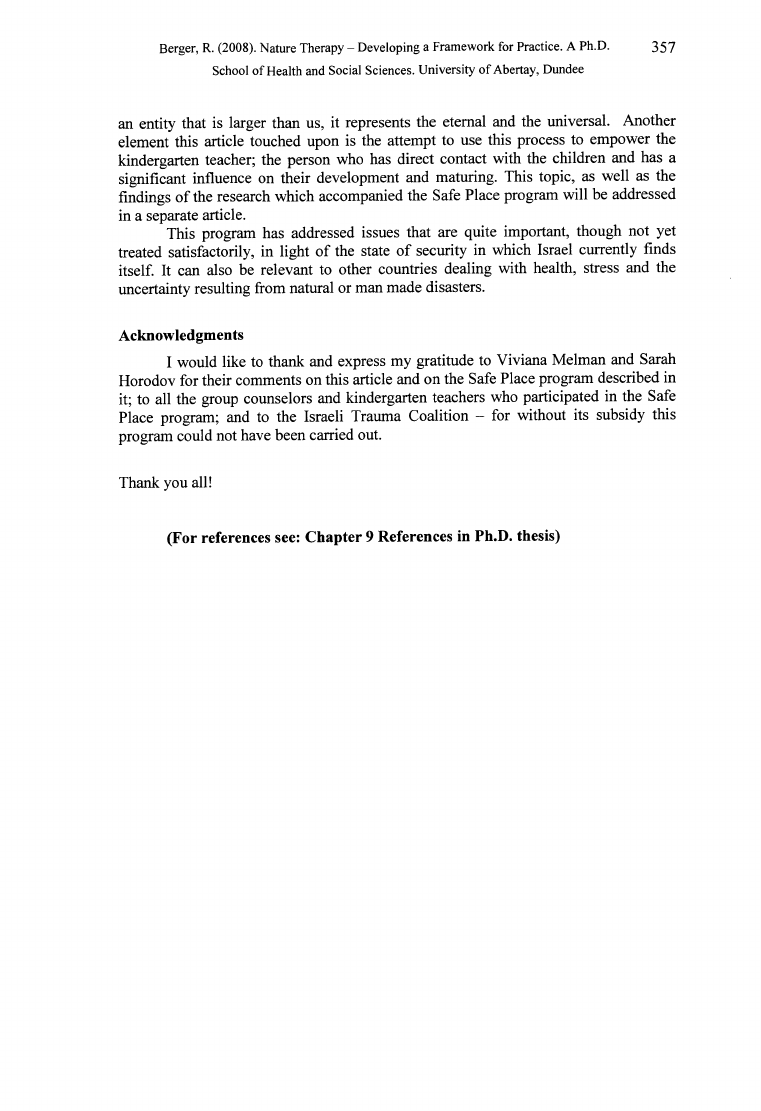
Berger, R. (2008). Nature Therapy - Developing a Framework for Practice. A Ph.D.
357
School of Health and Social Sciences. University of Abertay, Dundee
an entity that is larger than us, it represents the eternal and the universal. Another
element this article touched upon is the attempt to use this process to empower the
kindergarten teacher; the person who has direct contact with the children and has a
significant influence on their development and maturing. This topic, as well as the
findings of the research which accompanied the Safe Place program will be addressed
in a separate article.
This program has addressed issues that are quite important, though not yet
treated satisfactorily, in light of the state of security in which Israel currently finds
itself. It can also be relevant to other countries dealing with health, stress and the
uncertainty resulting from natural or man made disasters.
Acknowledgments
I would like to thank and express my gratitude to Viviana Melman and Sarah
Horodov for their comments on this article and on the Safe Place program described in
it; to all the group counselors and kindergarten teachers who participated in the Safe
Place program; and to the Israeli Trauma Coalition —for without its subsidy this
program could not have been carried out.
Thank you all!
(For references see: Chapter 9 References in Ph.D. thesis)
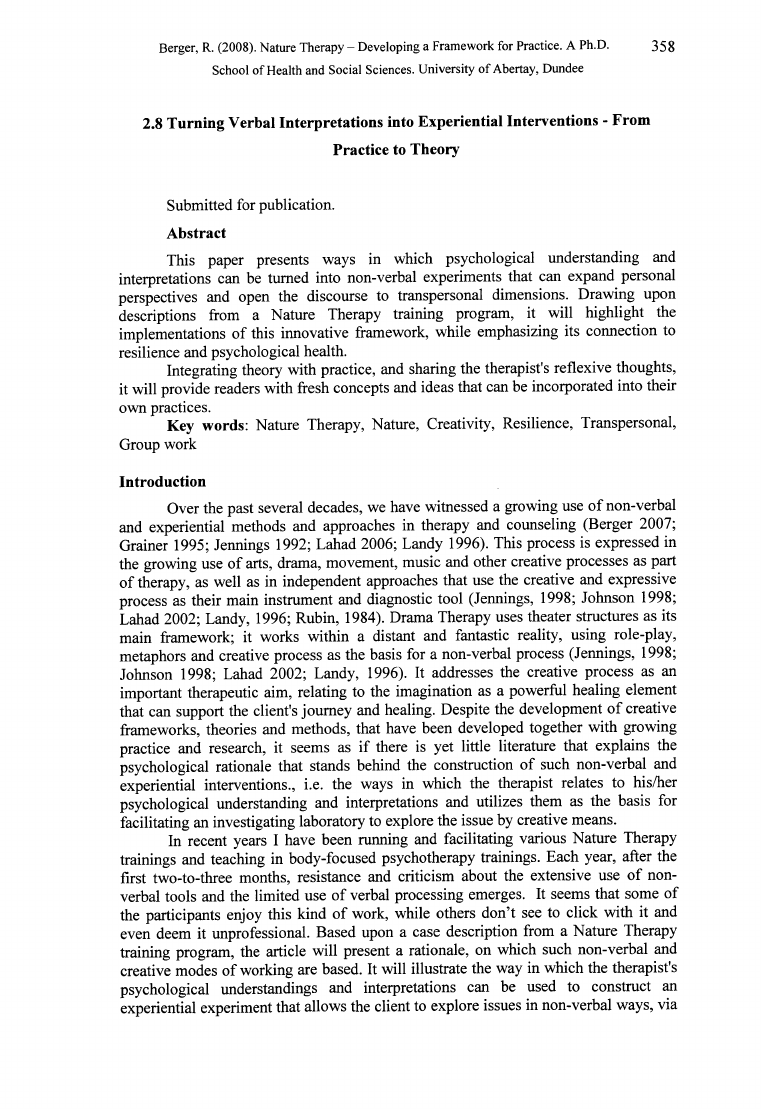
Berger, R. (2008). Nature Therapy - Developing a Framework for Practice. A Ph.D.
358
School of Health and Social Sciences. University of Abertay, Dundee
2.8 Turning Verbal Interpretations into Experiential Interventions - From
Practice to Theory
Submitted for publication.
Abstract
This paper presents ways in which psychological understanding and
interpretations can be turned into non-verbal experiments that can expand personal
perspectives and open the discourse to transpersonal dimensions. Drawing upon
descriptions from a Nature Therapy training program, it will highlight the
implementations of this innovative framework, while emphasizing its connection to
resilience and psychological health.
Integrating theory with practice, and sharing the therapist's reflexive thoughts,
it will provide readers with fresh concepts and ideas that can be incorporated into their
own practices.
Key words: Nature Therapy, Nature, Creativity, Resilience, Transpersonal,
Group work
Introduction
Over the past several decades, we have witnessed a growing use of non-verbal
and experiential methods and approaches in therapy and counseling (Berger 2007;
Grainer 1995; Jennings 1992; Lahad 2006; Landy 1996). This process is expressed in
the growing use of arts, drama, movement, music and other creative processes as part
of therapy, as well as in independent approaches that use the creative and expressive
process as their main instrument and diagnostic tool (Jennings, 1998; Johnson 1998;
Lahad 2002; Landy, 1996; Rubin, 1984). Drama Therapy uses theater structures as its
main framework; it works within a distant and fantastic reality, using role-play,
metaphors and creative process as the basis for a non-verbal process (Jennings, 1998;
Johnson 1998; Lahad 2002; Landy, 1996). It addresses the creative process as an
important therapeutic aim, relating to the imagination as a powerful healing element
that can support the client's journey and healing. Despite the development of creative
frameworks, theories and methods, that have been developed together with growing
practice and research, it seems as if there is yet little literature that explains the
psychological rationale that stands behind the construction of such non-verbal and
experiential interventions., i.e. the ways in which the therapist relates to his/her
psychological understanding and interpretations and utilizes them as the basis for
facilitating an investigating laboratory to explore the issue by creative means.
In recent years I have been running and facilitating various Nature Therapy
trainings and teaching in body-focused psychotherapy trainings. Each year, after the
first two-to-three months, resistance and criticism about the extensive use of non
verbal tools and the limited use of verbal processing emerges. It seems that some of
the participants enjoy this kind of work, while others don’t see to click with it and
even deem it unprofessional. Based upon a case description from a Nature Therapy
training program, the article will present a rationale, on which such non-verbal and
creative modes of working are based. It will illustrate the way in which the therapist's
psychological understandings and interpretations can be used to construct an
experiential experiment that allows the client to explore issues in non-verbal ways, via
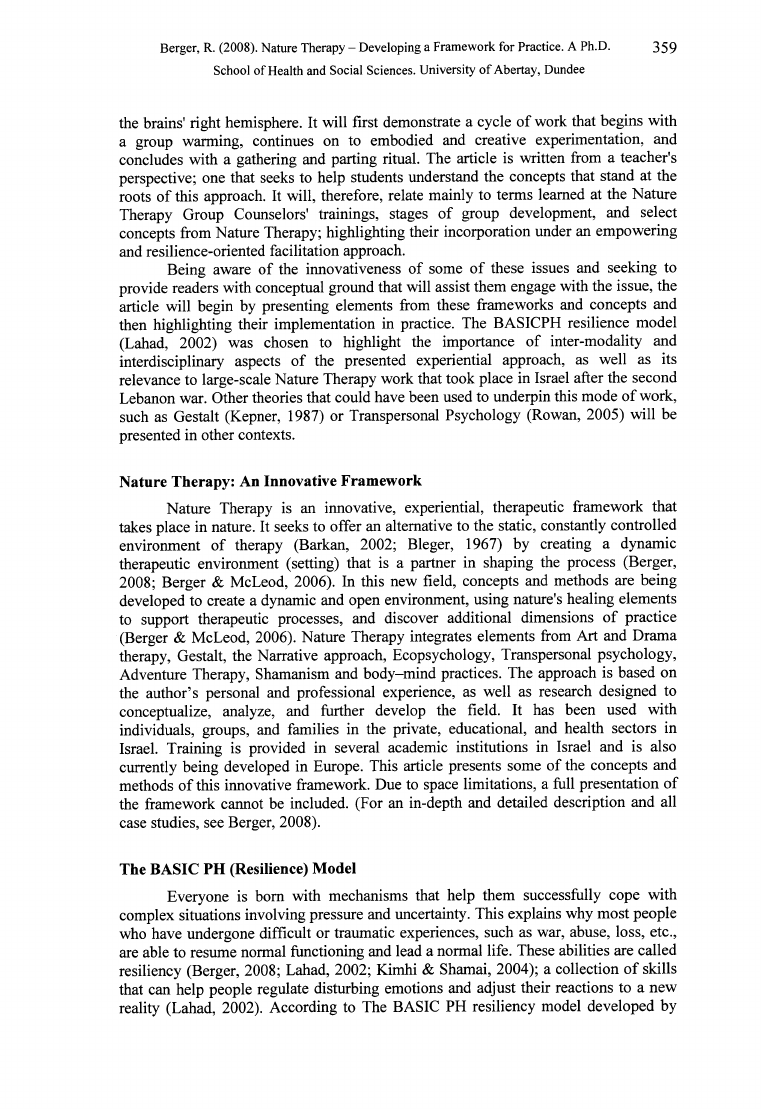
Berger, R. (2008). Nature Therapy - Developing a Framework for Practice. A Ph.D.
359
School of Health and Social Sciences. University of Abertay, Dundee
the brains' right hemisphere. It will first demonstrate a cycle of work that begins with
a group warming, continues on to embodied and creative experimentation, and
concludes with a gathering and parting ritual. The article is written from a teacher's
perspective; one that seeks to help students understand the concepts that stand at the
roots of this approach. It will, therefore, relate mainly to terms learned at the Nature
Therapy Group Counselors' trainings, stages of group development, and select
concepts from Nature Therapy; highlighting their incorporation under an empowering
and resilience-oriented facilitation approach.
Being aware of the innovativeness of some of these issues and seeking to
provide readers with conceptual ground that will assist them engage with the issue, the
article will begin by presenting elements from these frameworks and concepts and
then highlighting their implementation in practice. The BASICPH resilience model
(Lahad, 2002) was chosen to highlight the importance of inter-modality and
interdisciplinary aspects of the presented experiential approach, as well as its
relevance to large-scale Nature Therapy work that took place in Israel after the second
Lebanon war. Other theories that could have been used to underpin this mode of work,
such as Gestalt (Kepner, 1987) or Transpersonal Psychology (Rowan, 2005) will be
presented in other contexts.
Nature Therapy: An Innovative Framework
Nature Therapy is an innovative, experiential, therapeutic framework that
takes place in nature. It seeks to offer an alternative to the static, constantly controlled
environment of therapy (Barkan, 2002; Bleger, 1967) by creating a dynamic
therapeutic environment (setting) that is a partner in shaping the process (Berger,
2008; Berger & McLeod, 2006). In this new field, concepts and methods are being
developed to create a dynamic and open environment, using nature's healing elements
to support therapeutic processes, and discover additional dimensions of practice
(Berger & McLeod, 2006). Nature Therapy integrates elements from Art and Drama
therapy, Gestalt, the Narrative approach, Ecopsychology, Transpersonal psychology,
Adventure Therapy, Shamanism and body-mind practices. The approach is based on
the author’s personal and professional experience, as well as research designed to
conceptualize, analyze, and further develop the field. It has been used with
individuals, groups, and families in the private, educational, and health sectors in
Israel. Training is provided in several academic institutions in Israel and is also
currently being developed in Europe. This article presents some of the concepts and
methods of this innovative framework. Due to space limitations, a full presentation of
the framework cannot be included. (For an in-depth and detailed description and all
case studies, see Berger, 2008).
The BASIC PH (Resilience) Model
Everyone is bom with mechanisms that help them successfully cope with
complex situations involving pressure and uncertainty. This explains why most people
who have undergone difficult or traumatic experiences, such as war, abuse, loss, etc.,
are able to resume normal functioning and lead a normal life. These abilities are called
resiliency (Berger, 2008; Lahad, 2002; Kimhi & Shamai, 2004); a collection of skills
that can help people regulate disturbing emotions and adjust their reactions to a new
reality (Lahad, 2002). According to The BASIC PH resiliency model developed by
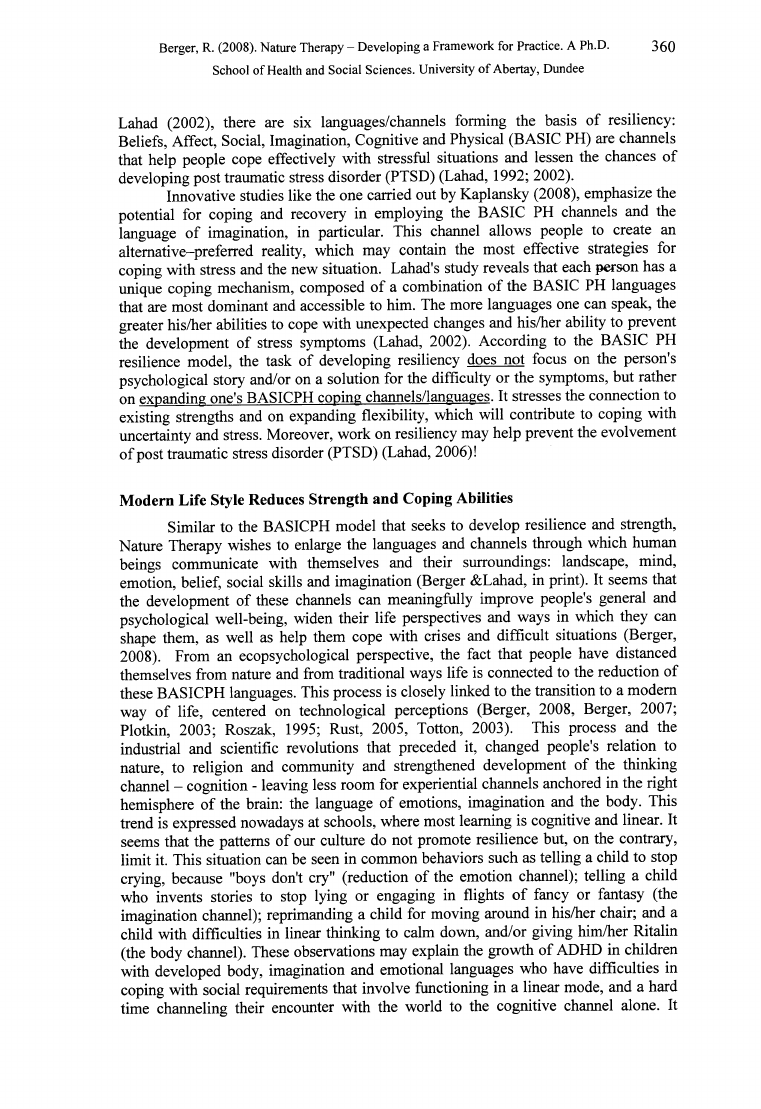
Berger, R. (2008). Nature Therapy - Developing a Framework for Practice. A Ph.D.
360
School of Health and Social Sciences. University of Abertay, Dundee
Lahad (2002), there are six languages/channels forming the basis of resiliency:
Beliefs, Affect, Social, Imagination, Cognitive and Physical (BASIC PH) are channels
that help people cope effectively with stressful situations and lessen the chances of
developing post traumatic stress disorder (PTSD) (Lahad, 1992; 2002).
Innovative studies like the one carried out by Kaplansky (2008), emphasize the
potential for coping and recovery in employing the BASIC PH channels and the
language of imagination, in particular. This channel allows people to create an
alternative-preferred reality, which may contain the most effective strategies for
coping with stress and the new situation. Lahad's study reveals that each person has a
unique coping mechanism, composed of a combination of the BASIC PH languages
that are most dominant and accessible to him. The more languages one can speak, the
greater his/her abilities to cope with unexpected changes and his/her ability to prevent
the development of stress symptoms (Lahad, 2002). According to the BASIC PH
resilience model, the task of developing resiliency does not focus on the person's
psychological story and/or on a solution for the difficulty or the symptoms, but rather
on expanding one's BASICPH coning channels/languages. It stresses the connection to
existing strengths and on expanding flexibility, which will contribute to coping with
uncertainty and stress. Moreover, work on resiliency may help prevent the evolvement
of post traumatic stress disorder (PTSD) (Lahad, 2006)!
Modern Life Style Reduces Strength and Coping Abilities
Similar to the BASICPH model that seeks to develop resilience and strength,
Nature Therapy wishes to enlarge the languages and channels through which human
beings communicate with themselves and their surroundings: landscape, mind,
emotion, belief, social skills and imagination (Berger &Lahad, in print). It seems that
the development of these channels can meaningfully improve people's general and
psychological well-being, widen their life perspectives and ways in which they can
shape them, as well as help them cope with crises and difficult situations (Berger,
2008). From an ecopsychological perspective, the fact that people have distanced
themselves from nature and from traditional ways life is connected to the reduction of
these BASICPH languages. This process is closely linked to the transition to a modem
way of life, centered on technological perceptions (Berger, 2008, Berger, 2007;
Plotkin, 2003; Roszak, 1995; Rust, 2005, Totton, 2003). This process and the
industrial and scientific revolutions that preceded it, changed people's relation to
nature, to religion and community and strengthened development of the thinking
channel - cognition - leaving less room for experiential channels anchored in the right
hemisphere of the brain: the language of emotions, imagination and the body. This
trend is expressed nowadays at schools, where most learning is cognitive and linear. It
seems that the patterns of our culture do not promote resilience but, on the contrary,
limit it. This situation can be seen in common behaviors such as telling a child to stop
crying, because "boys don't cry" (reduction of the emotion channel); telling a child
who invents stories to stop lying or engaging in flights of fancy or fantasy (the
imagination channel); reprimanding a child for moving around in his/her chair; and a
child with difficulties in linear thinking to calm down, and/or giving him/her Ritalin
(the body channel). These observations may explain the growth of ADHD in children
with developed body, imagination and emotional languages who have difficulties in
coping with social requirements that involve functioning in a linear mode, and a hard
time channeling their encounter with the world to the cognitive channel alone. It
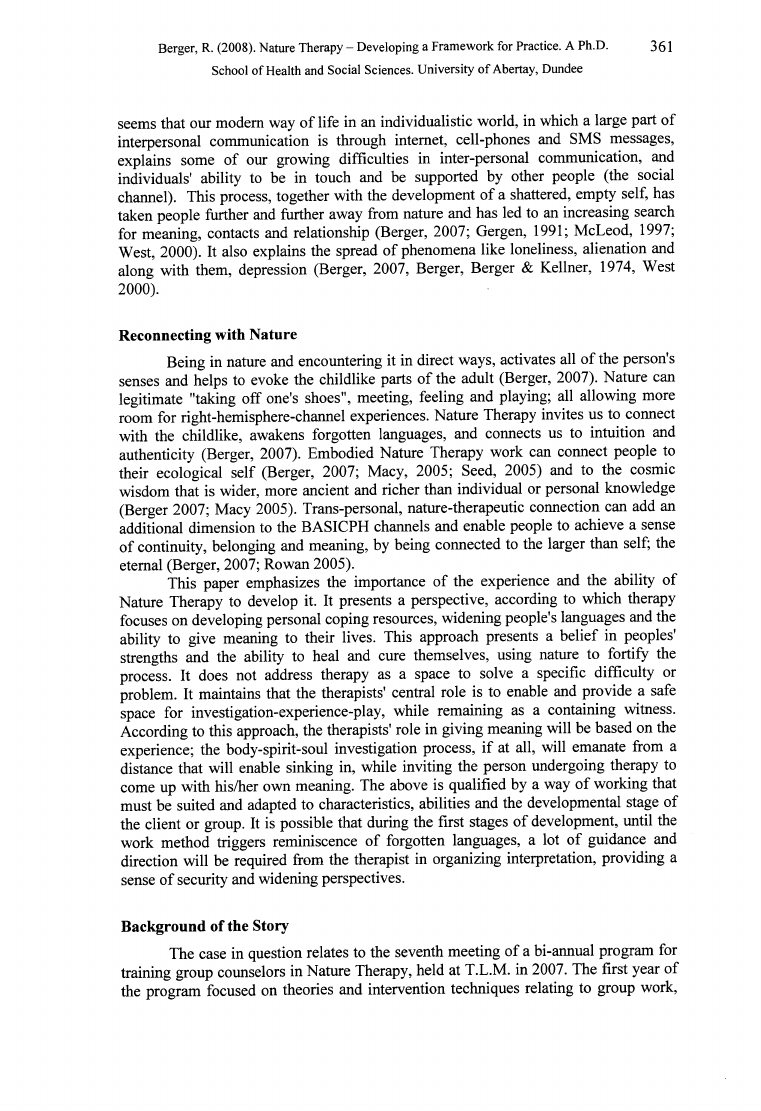
Berger, R. (2008). Nature Therapy - Developing a Framework for Practice. A Ph.D.
361
School of Health and Social Sciences. University of Abertay, Dundee
seems that our modem way of life in an individualistic world, in which a large part of
interpersonal communication is through internet, cell-phones and SMS messages,
explains some of our growing difficulties in inter-personal communication, and
individuals' ability to be in touch and be supported by other people (the social
channel). This process, together with the development of a shattered, empty self, has
taken people further and further away from nature and has led to an increasing search
for meaning, contacts and relationship (Berger, 2007; Gergen, 1991; McLeod, 1997;
West, 2000). It also explains the spread of phenomena like loneliness, alienation and
along with them, depression (Berger, 2007, Berger, Berger & Kellner, 1974, West
2000).
Reconnecting with Nature
Being in nature and encountering it in direct ways, activates all of the person's
senses and helps to evoke the childlike parts of the adult (Berger, 2007). Nature can
legitimate "taking off one's shoes", meeting, feeling and playing; all allowing more
room for right-hemisphere-channel experiences. Nature Therapy invites us to connect
with the childlike, awakens forgotten languages, and connects us to intuition and
authenticity (Berger, 2007). Embodied Nature Therapy work can connect people to
their ecological self (Berger, 2007; Macy, 2005; Seed, 2005) and to the cosmic
wisdom that is wider, more ancient and richer than individual or personal knowledge
(Berger 2007; Macy 2005). Trans-personal, nature-therapeutic connection can add an
additional dimension to the BASICPH channels and enable people to achieve a sense
of continuity, belonging and meaning, by being connected to the larger than self; the
eternal (Berger, 2007; Rowan 2005).
This paper emphasizes the importance of the experience and the ability of
Nature Therapy to develop it. It presents a perspective, according to which therapy
focuses on developing personal coping resources, widening people's languages and the
ability to give meaning to their lives. This approach presents a belief in peoples'
strengths and the ability to heal and cure themselves, using nature to fortify the
process. It does not address therapy as a space to solve a specific difficulty or
problem. It maintains that the therapists' central role is to enable and provide a safe
space for investigation-experience-play, while remaining as a containing witness.
According to this approach, the therapists' role in giving meaning will be based on the
experience; the body-spirit-soul investigation process, if at all, will emanate from a
distance that will enable sinking in, while inviting the person undergoing therapy to
come up with his/her own meaning. The above is qualified by a way of working that
must be suited and adapted to characteristics, abilities and the developmental stage of
the client or group. It is possible that during the first stages of development, until the
work method triggers reminiscence of forgotten languages, a lot of guidance and
direction will be required from the therapist in organizing interpretation, providing a
sense of security and widening perspectives.
Background of the Story
The case in question relates to the seventh meeting of a bi-annual program for
training group counselors in Nature Therapy, held at T.L.M. in 2007. The first year of
the program focused on theories and intervention techniques relating to group work,
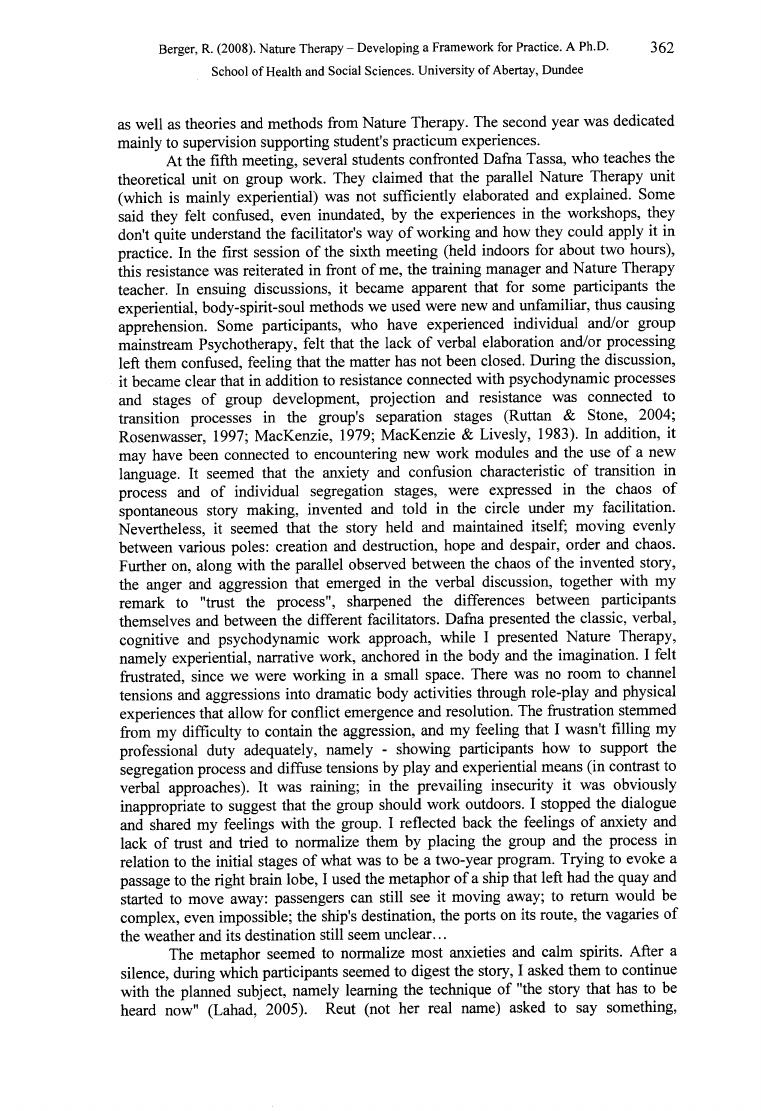
Berger, R. (2008). Nature Therapy - Developing a Framework for Practice. A Ph.D.
362
School of Health and Social Sciences. University of Abertay, Dundee
as well as theories and methods from Nature Therapy. The second year was dedicated
mainly to supervision supporting student's practicum experiences.
At the fifth meeting, several students confronted Dafna Tassa, who teaches the
theoretical unit on group work. They claimed that the parallel Nature Therapy unit
(which is mainly experiential) was not sufficiently elaborated and explained. Some
said they felt confused, even inundated, by the experiences in the workshops, they
don't quite understand the facilitator's way of working and how they could apply it in
practice. In the first session of the sixth meeting (held indoors for about two hours),
this resistance was reiterated in front of me, the training manager and Nature Therapy
teacher. In ensuing discussions, it became apparent that for some participants the
experiential, body-spirit-soul methods we used were new and unfamiliar, thus causing
apprehension. Some participants, who have experienced individual and/or group
mainstream Psychotherapy, felt that the lack of verbal elaboration and/or processing
left them confused, feeling that the matter has not been closed. During the discussion,
it became clear that in addition to resistance connected with psychodynamic processes
and stages of group development, projection and resistance was connected to
transition processes in the group's separation stages (Ruttan & Stone, 2004;
Rosenwasser, 1997; MacKenzie, 1979; MacKenzie & Livesly, 1983). In addition, it
may have been connected to encountering new work modules and the use of a new
language. It seemed that the anxiety and confusion characteristic of transition in
process and of individual segregation stages, were expressed in the chaos of
spontaneous story making, invented and told in the circle under my facilitation.
Nevertheless, it seemed that the story held and maintained itself; moving evenly
between various poles: creation and destruction, hope and despair, order and chaos.
Further on, along with the parallel observed between the chaos of the invented story,
the anger and aggression that emerged in the verbal discussion, together with my
remark to "trust the process", sharpened the differences between participants
themselves and between the different facilitators. Dafna presented the classic, verbal,
cognitive and psychodynamic work approach, while I presented Nature Therapy,
namely experiential, narrative work, anchored in the body and the imagination. I felt
frustrated, since we were working in a small space. There was no room to channel
tensions and aggressions into dramatic body activities through role-play and physical
experiences that allow for conflict emergence and resolution. The frustration stemmed
from my difficulty to contain the aggression, and my feeling that I wasn't filling my
professional duty adequately, namely - showing participants how to support the
segregation process and diffuse tensions by play and experiential means (in contrast to
verbal approaches). It was raining; in the prevailing insecurity it was obviously
inappropriate to suggest that the group should work outdoors. I stopped the dialogue
and shared my feelings with the group. I reflected back the feelings of anxiety and
lack of trust and tried to normalize them by placing the group and the process in
relation to the initial stages of what was to be a two-year program. Trying to evoke a
passage to the right brain lobe, I used the metaphor of a ship that left had the quay and
started to move away: passengers can still see it moving away; to return would be
complex, even impossible; the ship's destination, the ports on its route, the vagaries of
the weather and its destination still seem unclear...
The metaphor seemed to normalize most anxieties and calm spirits. After a
silence, during which participants seemed to digest the story, I asked them to continue
with the planned subject, namely learning the technique of "the story that has to be
heard now" (Lahad, 2005). Reut (not her real name) asked to say something,
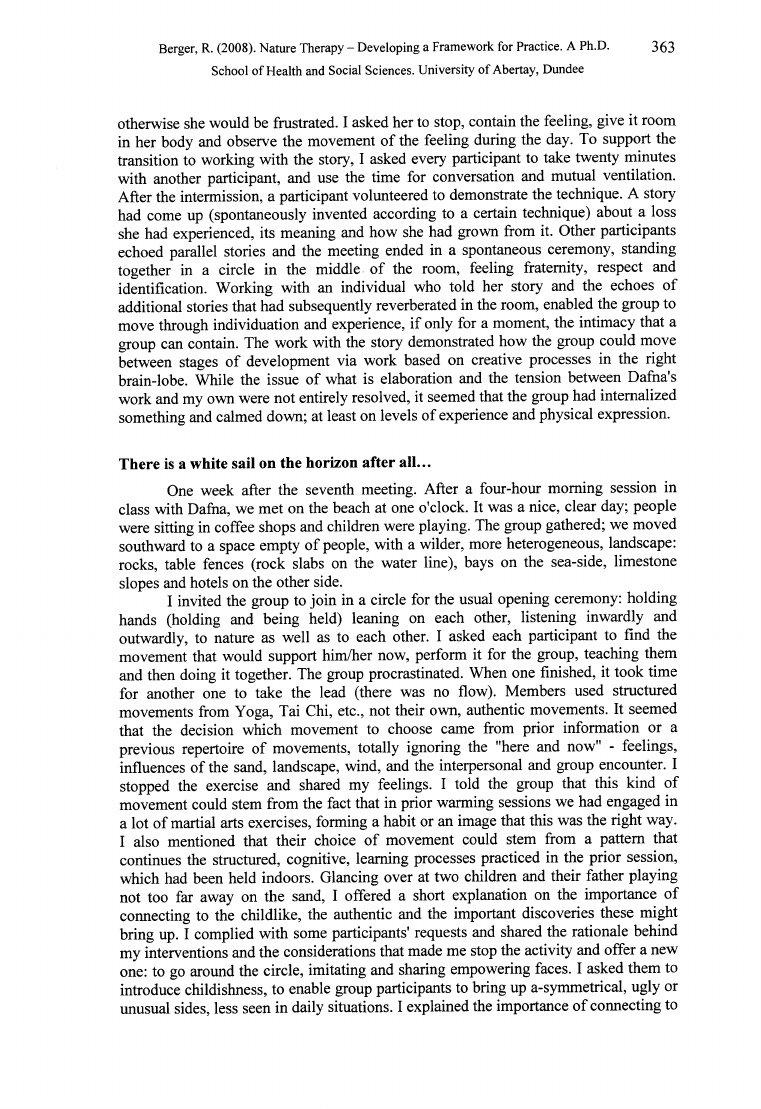
Berger, R. (2008). Nature Therapy - Developing a Framework for Practice. A Ph.D.
363
School of Health and Social Sciences. University of Abertay, Dundee
otherwise she would be frustrated. I asked her to stop, contain the feeling, give it room
in her body and observe the movement of the feeling during the day. To support the
transition to working with the story, I asked every participant to take twenty minutes
with another participant, and use the time for conversation and mutual ventilation.
After the intermission, a participant volunteered to demonstrate the technique. A story
had come up (spontaneously invented according to a certain technique) about a loss
she had experienced, its meaning and how she had grown from it. Other participants
echoed parallel stories and the meeting ended in a spontaneous ceremony, standing
together in a circle in the middle of the room, feeling fraternity, respect and
identification. Working with an individual who told her story and the echoes of
additional stories that had subsequently reverberated in the room, enabled the group to
move through individuation and experience, if only for a moment, the intimacy that a
group can contain. The work with the story demonstrated how the group could move
between stages of development via work based on creative processes in the right
brain-lobe. While the issue of what is elaboration and the tension between Dafna's
work and my own were not entirely resolved, it seemed that the group had internalized
something and calmed down; at least on levels of experience and physical expression.
There is a white sail on the horizon after all...
One week after the seventh meeting. After a four-hour morning session in
class with Dafna, we met on the beach at one o'clock. It was a nice, clear day; people
were sitting in coffee shops and children were playing. The group gathered; we moved
southward to a space empty of people, with a wilder, more heterogeneous, landscape:
rocks, table fences (rock slabs on the water line), bays on the sea-side, limestone
slopes and hotels on the other side.
I invited the group to join in a circle for the usual opening ceremony: holding
hands (holding and being held) leaning on each other, listening inwardly and
outwardly, to nature as well as to each other. I asked each participant to find the
movement that would support him/her now, perform it for the group, teaching them
and then doing it together. The group procrastinated. When one finished, it took time
for another one to take the lead (there was no flow). Members used structured
movements from Yoga, Tai Chi, etc., not their own, authentic movements. It seemed
that the decision which movement to choose came from prior information or a
previous repertoire of movements, totally ignoring the "here and now" - feelings,
influences of the sand, landscape, wind, and the interpersonal and group encounter. I
stopped the exercise and shared my feelings. I told the group that this kind of
movement could stem from the fact that in prior warming sessions we had engaged in
a lot of martial arts exercises, forming a habit or an image that this was the right way.
I also mentioned that their choice of movement could stem from a pattern that
continues the structured, cognitive, learning processes practiced in the prior session,
which had been held indoors. Glancing over at two children and their father playing
not too far away on the sand, I offered a short explanation on the importance of
connecting to the childlike, the authentic and the important discoveries these might
bring up. I complied with some participants' requests and shared the rationale behind
my interventions and the considerations that made me stop the activity and offer a new
one: to go around the circle, imitating and sharing empowering faces. I asked them to
introduce childishness, to enable group participants to bring up a-symmetrical, ugly or
unusual sides, less seen in daily situations. I explained the importance of connecting to
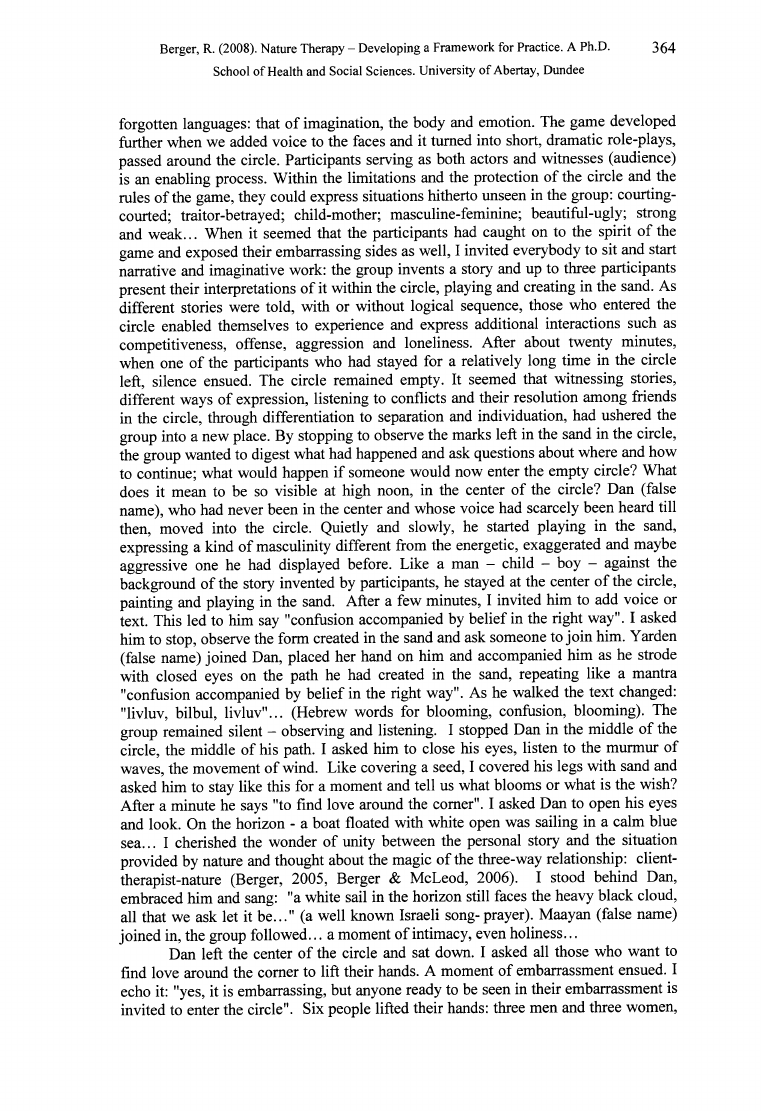
Berger, R. (2008). Nature Therapy - Developing a Framework for Practice. A Ph.D.
364
School of Health and Social Sciences. University of Abertay, Dundee
forgotten languages: that of imagination, the body and emotion. The game developed
further when we added voice to the faces and it turned into short, dramatic role-plays,
passed around the circle. Participants serving as both actors and witnesses (audience)
is an enabling process. Within the limitations and the protection of the circle and the
rules of the game, they could express situations hitherto unseen in the group: courting-
courted; traitor-betrayed; child-mother; masculine-feminine; beautiful-ugly; strong
and weak... When it seemed that the participants had caught on to the spirit of the
game and exposed their embarrassing sides as well, I invited everybody to sit and start
narrative and imaginative work: the group invents a story and up to three participants
present their interpretations of it within the circle, playing and creating in the sand. As
different stories were told, with or without logical sequence, those who entered the
circle enabled themselves to experience and express additional interactions such as
competitiveness, offense, aggression and loneliness. After about twenty minutes,
when one of the participants who had stayed for a relatively long time in the circle
left, silence ensued. The circle remained empty. It seemed that witnessing stories,
different ways of expression, listening to conflicts and their resolution among friends
in the circle, through differentiation to separation and individuation, had ushered the
group into a new place. By stopping to observe the marks left in the sand in the circle,
the group wanted to digest what had happened and ask questions about where and how
to continue; what would happen if someone would now enter the empty circle? What
does it mean to be so visible at high noon, in the center of the circle? Dan (false
name), who had never been in the center and whose voice had scarcely been heard till
then, moved into the circle. Quietly and slowly, he started playing in the sand,
expressing a kind of masculinity different from the energetic, exaggerated and maybe
aggressive one he had displayed before. Like a man —child —boy —against the
background of the story invented by participants, he stayed at the center of the circle,
painting and playing in the sand. After a few minutes, I invited him to add voice or
text. This led to him say "confusion accompanied by belief in the right way". I asked
him to stop, observe the form created in the sand and ask someone to join him. Yarden
(false name) joined Dan, placed her hand on him and accompanied him as he strode
with closed eyes on the path he had created in the sand, repeating like a mantra
"confusion accompanied by belief in the right way". As he walked the text changed:
"livluv, bilbul, livluv"... (Hebrew words for blooming, confusion, blooming). The
group remained silent - observing and listening. I stopped Dan in the middle of the
circle, the middle of his path. I asked him to close his eyes, listen to the murmur of
waves, the movement of wind. Like covering a seed, I covered his legs with sand and
asked him to stay like this for a moment and tell us what blooms or what is the wish?
After a minute he says "to find love around the comer". I asked Dan to open his eyes
and look. On the horizon - a boat floated with white open was sailing in a calm blue
sea... I cherished the wonder of unity between the personal story and the situation
provided by nature and thought about the magic of the three-way relationship: client-
therapist-nature (Berger, 2005, Berger & McLeod, 2006). I stood behind Dan,
embraced him and sang: "a white sail in the horizon still faces the heavy black cloud,
all that we ask let it be..." (a well known Israeli song-prayer). Maayan (false name)
joined in, the group followed... a moment of intimacy, even holiness...
Dan left the center of the circle and sat down. I asked all those who want to
find love around the comer to lift their hands. A moment of embarrassment ensued. I
echo it: "yes, it is embarrassing, but anyone ready to be seen in their embarrassment is
invited to enter the circle". Six people lifted their hands: three men and three women,
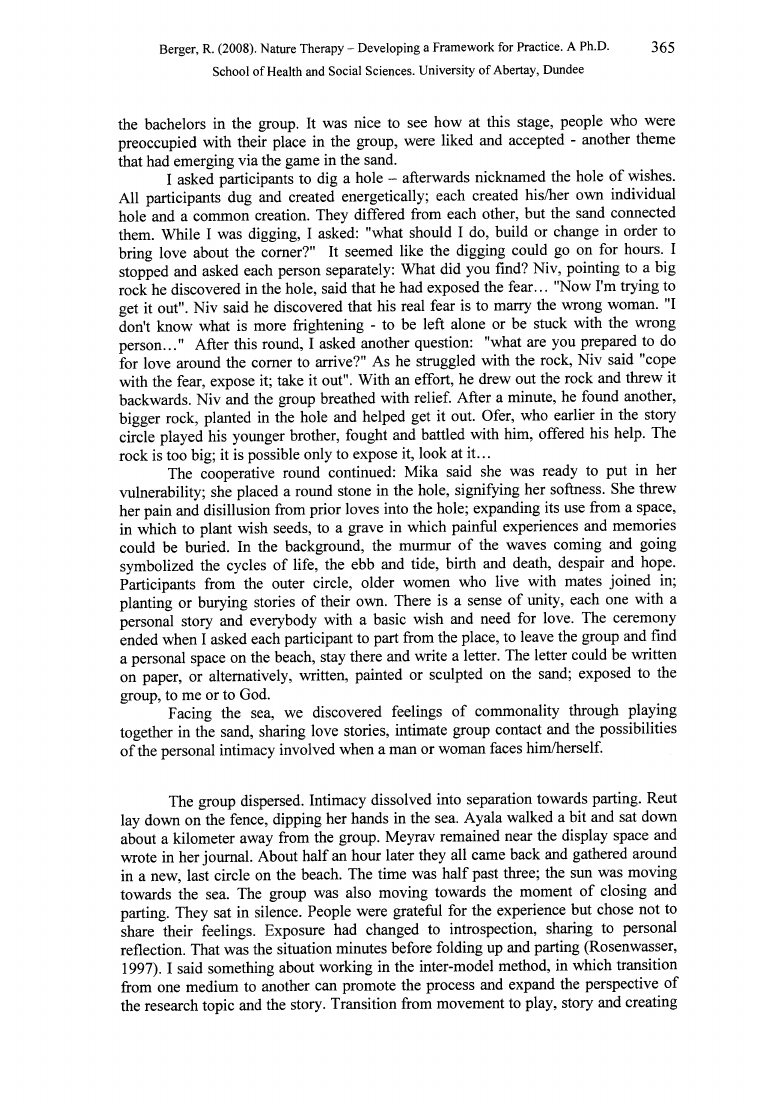
Berger, R. (2008). Nature Therapy - Developing a Framework for Practice. A Ph.D.
365
School of Health and Social Sciences. University of Abertay, Dundee
the bachelors in the group. It was nice to see how at this stage, people who were
preoccupied with their place in the group, were liked and accepted - another theme
that had emerging via the game in the sand.
I asked participants to dig a hole —afterwards nicknamed the hole of wishes.
All participants dug and created energetically; each created his/her own individual
hole and a common creation. They differed from each other, but the sand connected
them. While I was digging, I asked: "what should I do, build or change in order to
bring love about the comer?" It seemed like the digging could go on for hours. I
stopped and asked each person separately: What did you find? Niv, pointing to a big
rock he discovered in the hole, said that he had exposed the fear... "Now I'm trying to
get it out". Niv said he discovered that his real fear is to marry the wrong woman. "I
don't know what is more frightening - to be left alone or be stuck with the wrong
person..." After this round, I asked another question: "what are you prepared to do
for love around the comer to arrive?" As he struggled with the rock, Niv said "cope
with the fear, expose it; take it out". With an effort, he drew out the rock and threw it
backwards. Niv and the group breathed with relief. After a minute, he found another,
bigger rock, planted in the hole and helped get it out. Ofer, who earlier in the story
circle played his younger brother, fought and battled with him, offered his help. The
rock is too big; it is possible only to expose it, look at it...
The cooperative round continued: Mika said she was ready to put in her
vulnerability; she placed a round stone in the hole, signifying her softness. She threw
her pain and disillusion from prior loves into the hole; expanding its use from a space,
in which to plant wish seeds, to a grave in which painful experiences and memories
could be buried. In the background, the murmur of the waves coming and going
symbolized the cycles of life, the ebb and tide, birth and death, despair and hope.
Participants from the outer circle, older women who live with mates joined in;
planting or burying stories of their own. There is a sense of unity, each one with a
personal story and everybody with a basic wish and need for love. The ceremony
ended when I asked each participant to part from the place, to leave the group and find
a personal space on the beach, stay there and write a letter. The letter could be written
on paper, or alternatively, written, painted or sculpted on the sand; exposed to the
group, to me or to God.
Facing the sea, we discovered feelings of commonality through playing
together in the sand, sharing love stories, intimate group contact and the possibilities
of the personal intimacy involved when a man or woman faces him/herself.
The group dispersed. Intimacy dissolved into separation towards parting. Reut
lay down on the fence, dipping her hands in the sea. Ayala walked a bit and sat down
about a kilometer away from the group. Meyrav remained near the display space and
wrote in her journal. About half an hour later they all came back and gathered around
in a new, last circle on the beach. The time was half past three; the sun was moving
towards the sea. The group was also moving towards the moment of closing and
parting. They sat in silence. People were grateful for the experience but chose not to
share their feelings. Exposure had changed to introspection, sharing to personal
reflection. That was the situation minutes before folding up and parting (Rosenwasser,
1997). I said something about working in the inter-model method, in which transition
from one medium to another can promote the process and expand the perspective of
the research topic and the story. Transition from movement to play, story and creating
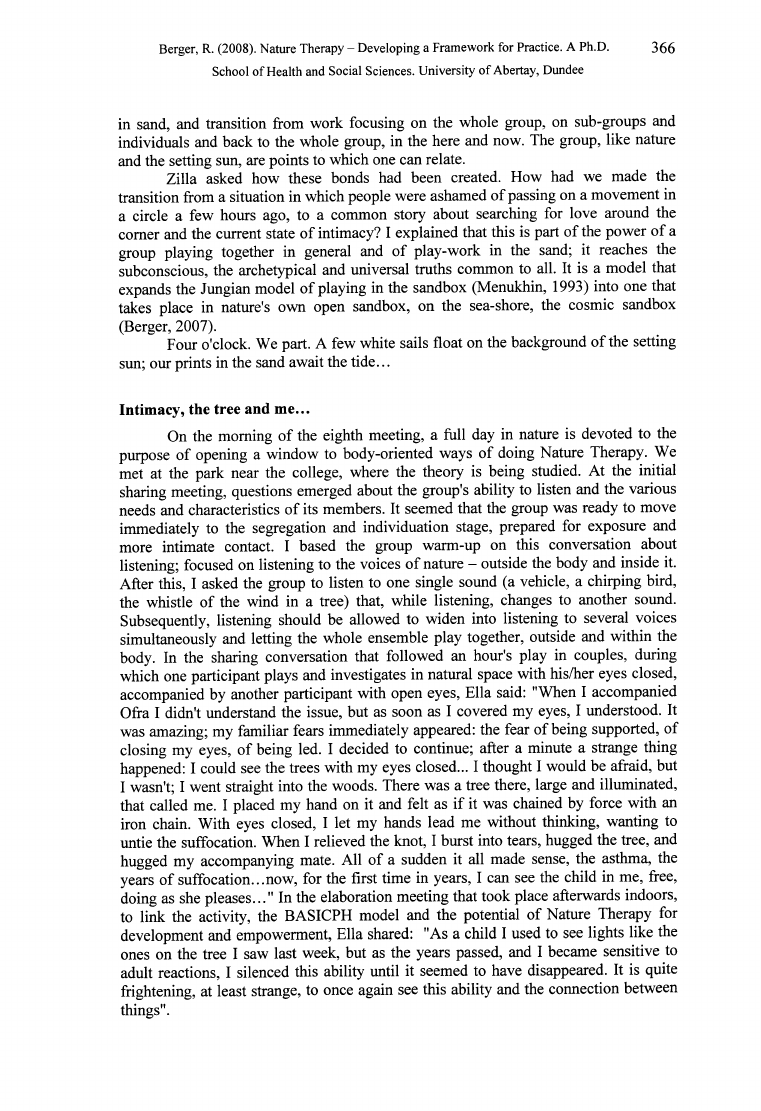
Berger, R. (2008). Nature Therapy - Developing a Framework for Practice. A Ph.D.
366
School of Health and Social Sciences. University of Abertay, Dundee
in sand, and transition from work focusing on the whole group, on sub-groups and
individuals and back to the whole group, in the here and now. The group, like nature
and the setting sun, are points to which one can relate.
Zilla asked how these bonds had been created. How had we made the
transition from a situation in which people were ashamed of passing on a movement in
a circle a few hours ago, to a common story about searching for love around the
comer and the current state of intimacy? I explained that this is part of the power of a
group playing together in general and of play-work in the sand; it reaches the
subconscious, the archetypical and universal tmths common to all. It is a model that
expands the Jungian model of playing in the sandbox (Menukhin, 1993) into one that
takes place in nature's own open sandbox, on the sea-shore, the cosmic sandbox
(Berger, 2007).
Four o'clock. We part. A few white sails float on the background of the setting
sun; our prints in the sand await the tide...
Intimacy, the tree and me...
On the morning of the eighth meeting, a full day in nature is devoted to the
purpose of opening a window to body-oriented ways of doing Nature Therapy. We
met at the park near the college, where the theory is being studied. At the initial
sharing meeting, questions emerged about the group's ability to listen and the various
needs and characteristics of its members. It seemed that the group was ready to move
immediately to the segregation and individuation stage, prepared for exposure and
more intimate contact. I based the group warm-up on this conversation about
listening; focused on listening to the voices of nature - outside the body and inside it.
After this, I asked the group to listen to one single sound (a vehicle, a chirping bird,
the whistle of the wind in a tree) that, while listening, changes to another sound.
Subsequently, listening should be allowed to widen into listening to several voices
simultaneously and letting the whole ensemble play together, outside and within the
body. In the sharing conversation that followed an hour's play in couples, during
which one participant plays and investigates in natural space with his/her eyes closed,
accompanied by another participant with open eyes, Ella said: "When I accompanied
Ofra I didn't understand the issue, but as soon as I covered my eyes, I understood. It
was amazing; my familiar fears immediately appeared: the fear of being supported, of
closing my eyes, of being led. I decided to continue; after a minute a strange thing
happened: I could see the trees with my eyes closed... I thought I would be afraid, but
I wasn't; I went straight into the woods. There was a tree there, large and illuminated,
that called me. I placed my hand on it and felt as if it was chained by force with an
iron chain. With eyes closed, I let my hands lead me without thinking, wanting to
untie the suffocation. When I relieved the knot, I burst into tears, hugged the tree, and
hugged my accompanying mate. All of a sudden it all made sense, the asthma, the
years of suffocation...now, for the first time in years, I can see the child in me, free,
doing as she pleases..." In the elaboration meeting that took place afterwards indoors,
to link the activity, the BASICPH model and the potential of Nature Therapy for
development and empowerment, Ella shared: "As a child I used to see lights like the
ones on the tree I saw last week, but as the years passed, and I became sensitive to
adult reactions, I silenced this ability until it seemed to have disappeared. It is quite
frightening, at least strange, to once again see this ability and the connection between
things".
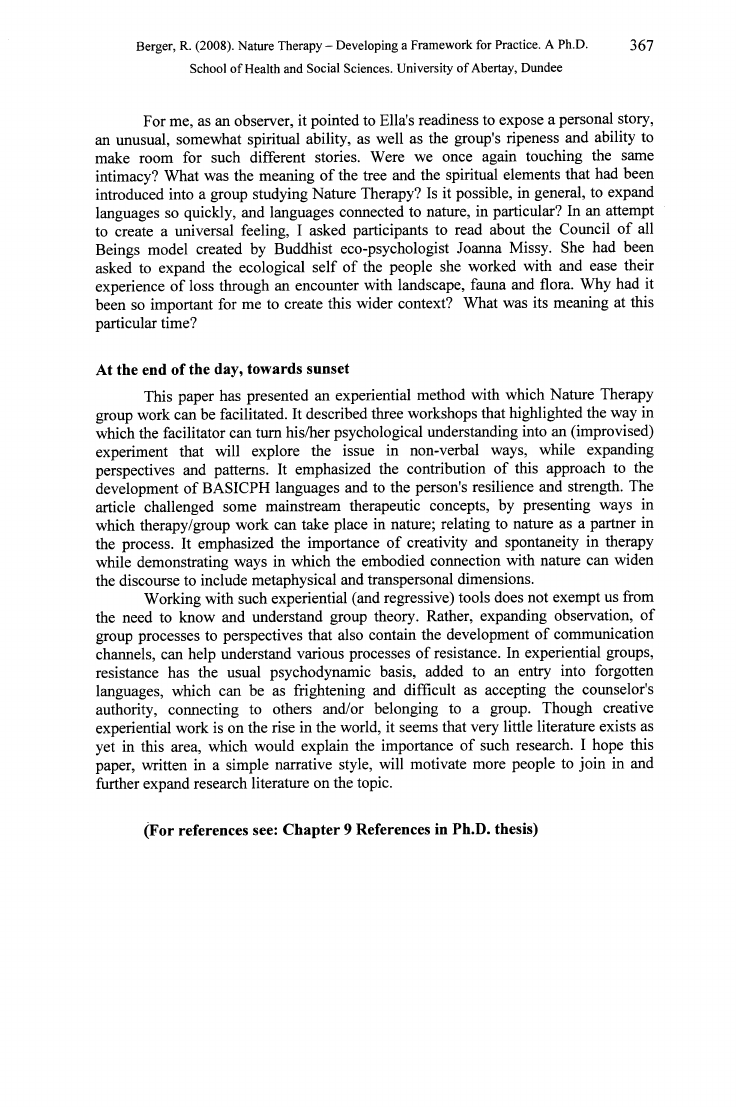
Berger, R. (2008). Nature Therapy - Developing a Framework for Practice. A Ph.D.
367
School of Health and Social Sciences. University of Abertay, Dundee
For me, as an observer, it pointed to Ella's readiness to expose a personal story,
an unusual, somewhat spiritual ability, as well as the group's ripeness and ability to
make room for such different stories. Were we once again touching the same
intimacy? What was the meaning of the tree and the spiritual elements that had been
introduced into a group studying Nature Therapy? Is it possible, in general, to expand
languages so quickly, and languages connected to nature, in particular? In an attempt
to create a universal feeling, I asked participants to read about the Council of all
Beings model created by Buddhist eco-psychologist Joanna Missy. She had been
asked to expand the ecological self of the people she worked with and ease their
experience of loss through an encounter with landscape, fauna and flora. Why had it
been so important for me to create this wider context? What was its meaning at this
particular time?
At the end of the day, towards sunset
This paper has presented an experiential method with which Nature Therapy
group work can be facilitated. It described three workshops that highlighted the way in
which the facilitator can turn his/her psychological understanding into an (improvised)
experiment that will explore the issue in non-verbal ways, while expanding
perspectives and patterns. It emphasized the contribution of this approach to the
development of BASICPH languages and to the person's resilience and strength. The
article challenged some mainstream therapeutic concepts, by presenting ways in
which therapy/group work can take place in nature; relating to nature as a partner in
the process. It emphasized the importance of creativity and spontaneity in therapy
while demonstrating ways in which the embodied connection with nature can widen
the discourse to include metaphysical and transpersonal dimensions.
Working with such experiential (and regressive) tools does not exempt us from
the need to know and understand group theory. Rather, expanding observation, of
group processes to perspectives that also contain the development of communication
channels, can help understand various processes of resistance. In experiential groups,
resistance has the usual psychodynamic basis, added to an entry into forgotten
languages, which can be as frightening and difficult as accepting the counselor's
authority, connecting to others and/or belonging to a group. Though creative
experiential work is on the rise in the world, it seems that very little literature exists as
yet in this area, which would explain the importance of such research. I hope this
paper, written in a simple narrative style, will motivate more people to join in and
further expand research literature on the topic.
(For references see: Chapter 9 References in Ph.D. thesis)
